Stellaria angustifolia
Stellaria flaccida
Stellaria pungens
Stenocarpus davallioides
Stenocarpus salignus
Stenocarpus sinuatis
Stephania japonica subsp. discolor
Stephania japonica subsp. japonicum
Stephania japonica subsp. timorensis
Sterculia quadrifida
Sticherus flabellatus
Sticherus lobatus
Sticherus urceolatus
Streblus brunonianus
Streptothamnus moorei
Strychnos arborea
Stuckenia pectinata
Stylidium debile
Stylidium graminifolium
Stylidium laricifolium
Stylidium paniculatum
Styphelia triflora
Styphelia viridis subsp. breviflora
Styphelia viridis subsp. viridis
Suaeda australis
Swainsona brachycarpa
Swainsona canescens
Swainsona formosa
Swainsona galegifolia
Swainsona greyana
Swainsona maccullochiana
Swainsona pterostylis
Swainsona queenslandica
Swainsona villosa
Swainsona procumben
Sylvipoa queenslandica
Symplocos stawellii
Symplocos thwaitesii
Syncarpia glomulifera subsp. glabra
Syncarpia glomulifera subsp. glomulifera
Synoum glandulosum subsp. glandulosum
Synoum glandulosum subsp. paniculosum
Syzygium alliiligneum
Syzygium aqueum
Syzygium australe
Syzygium buettnerianum
Syzygium cormiflorum
Syzygium corynanthum
Syzygium crebrinerve
Syzygium cryptophlebium
Syzygium erythrocalyx
Syzygium erythrodoxum
Syzygium fibrosum
Syzygium forte subsp. forte
Syzygium forte subsp. potamophilum
Syzygium francisii
Syzygium hemilampra
Syzygium hodgkinsoniae
Syzigium ingens
Syzygium luehmannii
Syzygium malaccense
Syzygium moorei
Syzygium oleosum
Syzygium paniculatum
Syzygium papyraceum
Syzygium tierneyanum
Syzygium wilsonii
Stellaria angustifolia
Classification:
Unranked: Eudicots
Order: Caryophyllales
Family: Caryophyllaceae
Genus: From Ast?r, which is Ancient Greek or Stell?ris/Stell?tus, which is Latin for a star or star shape. It refers to flowers, which have a star shape or appear like stars in the field.
Specie: From Angusta, which is Latin for narrow and Folium, which is Latin for foliage. It usually refers to leaves or at times the calyx lobes or petals, which are narrower than other species in the genus.
Sub specie: Stellaria angustifolia subsp. angustifolia. From Angusta, which is Latin for narrow and Folium, which is Latin for foliage. It usually refers to leaves or at times the calyx lobes or petals, which are narrower than other species in the genus.
Sub specie: Stellaria angustifolia subsp. rotundisepala. From Rotund?tus, which is Latin for rounded or obtuse and Skép?, which is Ancient Greek or Sepalum, which is Latin for a roof or covering. It refers to sepals or the calyx lobes, which have an obtuse apex.
Sub specie: Stellaria angustifolia subsp. tenella. From Tenella, which is Latin for small, delicate and tender. It refers plants, which are dainty or petite in size
Common Name: Swamp Starwort.
Distribution:
Sub specie: Stellaria angustifolia subsp. angustifolia is found east and south of a line from the Byfield National Park near Rockhampton in south east Queensland to Kangaroo Island in southern South Australia.
Stellaria angustifolia subsp. rotundisepala is found in two isolated populations, one in the Dillundoo Valley near Mount Kosiosko in New South Wales and the other in Bryan Swamp in the Victoria Valley in south western Victoria.
Stellaria angustifolia subsp. tenella is found in several disjunct populations in far southern New South Wales to south eastern South Australia and Tasmania.
https://avh.ala.org.au/occurrences/search?taxa=Stellaria+angustifolia#tab_mapView
Habitat Aspect Climate:
Stellaria angustifolia prefer light dappled shade to full sun. It usually grows in swamps, heaths or wallums in seasonally flooded sites. The altitude ranges from 5 meters ASL to 1380 meters ASL.
The temperatures range from minus 4 degrees in August to 40 degrees in January.
The rainfalls range from lows of 300mm to 2000mm average per annum.
Soil Requirements:
Stellaria angustifolia prefers better quality sands, sandy loams to light-medium clays. The soils are usually derived from decomposed granites, sandstone or accumulated sands however most base rocks are acceptable. The soils pH ranges from 4.5pH to 7.5pH. It does not tolerate water logged soils. Non saline soils to moderately saline soils are tolerated as are salt laden winds.
Height & Spread:
Wild Plants: 0.4m to 0.7m by 0.3m to 0.5m
Characteristics:
Stellaria angustifolia grows as a small straggly or erect shrub, climbing over and through larger plants. The 4 angulated stems are mainly glabrous except for a few minute hirsute hairs on the basal half.
The opposite, linear to narrow-lanceolate leaves of Stellaria angustifolia measure 10mm to 40mm in length by 1mm to 2mm in width. The bases are clasping while the apexes are narrow acute. The concolourous laminas are grass-green to deep green and are mainly glabrous except for a few minute hirsute hairs near the base. The laminas recurve upwards strongly from the mid vein to the margins and are straight or irregularly decurve downwards from the base to the apex. The margins are entire or finely toothed. The mid vein is slightly prominent on the lower lamina.
The inflorescences are born singularly or on small 3 flowered cymes from the leaf axils. The pedicels measure 6mm to 45mm in length. The 5 long, narrow lanceolate, green sepals measure 3mm to 8mm in length by 1mm to 2.5mm in width with scarious margins. The 5 oblong, white petals are bifid and appear as 10 lobes. The lobes measure 8mm to 10mm in length by 2mm to 2.5mm in width.
The 10 dimorphic white filiform anthers measure 4mm to 10mm in length while the dorsifixed anthers are deep brown to deep purple-brown.
The pastel green style and stigma are glabrous. The lime-green ovary is glabrous. The pistils measure 1.5mm to 2mm in length. The flowers appear from September to December.
The fruits are ovoidal capsules. The glabrous capsules measure 2mm to 6mm in length and are as long as the sepals.
Confusing Subspecie Varieties:
Stellaria angustifolia subsp. angustifolius sepals measure 3mm to 9mmin length. The apexes are acute to acuminate. The petals measure 3.5mm to 9mm in length and are equal to sepals. The fertile stamens measure 3mm in length.
Stellaria angustifolia subsp. rotundisepala sepals measure 1.5mm to 2.5mm in length. The apex is hooded. The petals measure 3.2mm to 3.9mm in length. The sepals are orbicular to broad elliptic while the apexes are obtuse, hooded or at times thickened. The pedicels measure 10mm to 20mm in length. The seeds are covered in slender, pointed but prominent tubercles. The fertile stamens measure 3mm in length.
Stellaria angustifolia subsp. tenella sepals measure 1.5mm to 2.5mm in length. The apexes are hooded. The petals measure 3.2mm to 3.9mm in length. The sepals are narrow ovate to elliptic while the apexes are obtuse to acute. The hood is never thickened. The pedicel usually measure 15mm to 20mm in length. The seeds are covered in semi inflated ridges.
Wildlife:
Stellaria angustifolia support native colony bees like Tetragonula carbonaria and wasps when in flower.
Cultivation:
Stellaria angustifolia is a small scrambling sub shrub that can be grown in association with other heath loving specie in small to medium gardens. In cultivation it grows from 0.4 meters to 0.5 meters in height by 0.2 meters to 0.3 meters in diameter when grown in the open or adjacent to other heath plants.
It grows exceptionally well on lighter clay soils where deep leaf litter keeps the soil cool and moisture at an even level. If these requirements are met they can cope with temperatures as low as minus 3 degrees and up to 38 degrees. It is moderately drought resistant once established however growth is slowed and flowering is set back.
However if it is given an adequate supply of water and a little native fertilizer on a regular basis the plants should respond with good flowering over a long period.
It does well in medium to large rockeries as the fill in plant. Here it can be planted in small groups of 3 to 5 to create a bushier look. Plant them at 200mm to 300mm centers. If it is surrounded by shorter plants with finer or larger foliages and red or orange flowers then a strong contrast can be created from September to December when it is in flower.
Propagation:
Seeds: The seeds can be removed easily from mature fruits.
Sow fresh seeds directly into a seed raising mix, keeping them moist not wet. Do not over water as the seeds will rot off before germination takes place. Place the trays in a cool shaded area with 50mm shade cloth in the bush house. When the seedlings are 20mm to 25mm tall, prick them out and plant them into 50mm native tubes using a good organic mix.
As the seedlings roots reach the bottom of the tubes plant them out into their permanent position. Do not delay.
Fertilize using Seaweed, fish emulsion or organic chicken pellets soaked in water and apply the liquid on an alternate basis. Fertilize every 2 months until the plants are well established then on an annual basis in September or March to maintain health, vitality and better flowering.
Further Comments from Readers:
“Hi reader, it seems you use The Bible of Botany a lot. That’s great as we have great pleasure in bringing it to you! It’s a little awkward for us to ask, but our first aim is to purchase land approximately 1,600 hectares to link several parcels of N.P. into one at The Pinnacles NSW Australia, but we need your help. We’re not salespeople. We’re amateur botanists who have dedicated over 30 years to saving the environment in a practical way. We depend on donations to reach our goal. If you donate just $5, the price of your coffee this Sunday, We can help to keep the planet alive in a real way and continue to bring you regular updates and features on Australian plants all in one Botanical Bible. Any support is greatly appreciated. Thank you.”
In the spirit of reconciliation we acknowledge the Bundjalung, Gumbaynggirr and Yaegl and all aboriginal nations throughout Australia and their connections to land, sea and community. We pay our respect to their Elders past, present and future for the pleasures we have gained.
Stellaria flaccida
Classification:
Unranked: Eudicots
Order: Caryophyllales
Family: Caryophyllaceae
Genus: From Ast?r, which is Ancient Greek or Stell?ris/Stell?tus, which is Latin for a star or star shape. It refers to flowers, which have a star shape or appear like stars in the field.
Specie: From Flaccidus, which is Latin for limp or flabby. It refers to the leaves semi arching to arching.
Sub specie:
Common Name:
Distribution:
Stellaria flaccida is found south from Mount Merino in far south east Queensland to the Otway Range in southern Victoria. It grows on and east of the Great Dividing Range especially the coastal ranges.
In South Australia it is found from Waterfall Gully near Adelaide.
In Tasmania it is found on the eastern two thirds of the Island except the high lands.
https://avh.ala.org.au/occurrences/search?taxa=Stellaria+flaccida#tab_mapView
Habitat Aspect Climate:
Stellaria flaccida prefers light dappled shade to medium shade. It usually grows in moist places within gullies in sclerophyll forests, gallery forests or on the margins of rainforest. The altitude ranges from 50 meters ASL to 1380 meters ASL.
The temperatures range from minus 4 degrees in August to 40 degrees in January.
The rainfalls range from lows of 500mm to 2100mm average per annum.
Soil Requirements:
Stellaria flaccida prefers to grow on better quality sandy loams to medium clays. The soils are usually derived from decomposed granites, sandstone, black basalts or brown basalts. The soils pH ranges from 5pH to 6pH. It does not tolerate water logged soils. Non saline soils to moderately saline soils are tolerated as are salt laden winds.
Height & Spread:
Wild Plants: 0.4m to 0.7m by 0.3m to 0.5m
Characteristics:
Stellaria flaccida grows as a small procumbent or ascending perennial herb with glabrous stems. The new growth stems are sparsely covered in white, caducous, hirsute hairs which are persistent at the nodes.
The opposite, ovate to lanceolate leaves measure 7mm to 20mm in length by 2mm to 8mm in width. The petioles are very sparsely covered in off white hirsute hairs and measure2mm to 6mm in length. The bases are rounded, cuneate or are attenuate while the apexes are broad acute to acute. The concolourous laminas are deep green to blue-green, dull and glabrous to scabrous. The laminas are flat to slightly recurve upwards from the mid vein to the margins and recurve upwards or decurve downwards near the apex. The margins are entire, undulate and are sparsely covered in coarse white ciliate hairs on the lower two thirds. The mid vein is slightly prominent on the lower lamina while the lateral pinnate veins are slightly prominent on the upper lamina.
The inflorescences are born singularly from the leaf axils. The pedicels measure 20mm to 40mm in length. The 5 long, narrow lanceolate, green sepals have recurved margins and are covered in white multicellular hairs. The sepals measure 4mm to 7mm in length by 1mm to 2.5mm in width with scarious margins. The 5 oblong, white petals are deeply bifid and appear as 10 lobes. The lobes measure 6mm to 10mm in length by 2mm to 2.5mm in width.
The 10 dimorphic white filiform anthers measure 4mm to 7mm in length while the dorsifixed anthers are deep brown to deep purple-brown.
The white style and stigma and lime-green ovary is glabrous. The pistils measure 1.5mm to 2mm in length. The flowers appear from September to January.
The fruits are ovoidal capsules. The glabrous capsules measure 2mm to 6mm in length. The few seeds in each capsule are tuberculate.
Wildlife:
Stellaria flaccida support native colony bees like Tetragonula carbonaria along the coast.
The follicles are often eaten out internally by unknown weevils.
Cultivation:
Stellaria flaccida is a small dense scrambling perennial that can be grown in association with other moist heath loving specie in small to medium gardens. In cultivation it grows from 0.4 meters to 0.5 meters in height by 0.2 meters to 0.3 meters in diameter when grown in the open or adjacent to other heath plants.
It grows exceptionally well on lighter clay soils where deep leaf litter keeps the soil cool and moisture at an even level. If these requirements are met they can cope with temperatures as low as minus 3 degrees and up to 38 degrees. It is moderately drought resistant once established however growth is slowed and flowering is set back.
However if it is given an adequate supply of water and a little native fertilizer on a regular basis the plants should respond with good flowering over a long period.
It does well in medium to large rockeries as the fill in plant. Here it can be planted in small groups of 3 to 5 to create a bushier look. Plant them at 200mm to 300mm centers. If it is surrounded by shorter plants with finer or larger foliages and red or orange flowers then a strong contrast can be created from September to December when it is in flower.
Propagation:
Seeds: The seeds can be removed easily from mature fruits.
Sow fresh seeds directly into a seed raising mix, keeping them moist not wet. Do not over water as the seeds will rot off before germination takes place. Place the trays in a cool shaded area with 50mm shade cloth in the bush house. When the seedlings are 20mm to 25mm tall, prick them out and plant them into 50mm native tubes using a good organic mix.
As the seedlings roots reach the bottom of the tubes plant them out into their permanent position. Do not delay.
Fertilize using Seaweed, fish emulsion or organic chicken pellets soaked in water and apply the liquid on an alternate basis. Fertilize every 2 months until the plants are well established then on an annual basis in September or March to maintain health, vitality and better flowering.
Cuttings: Stellaria flaccida cuttings maybe difficult to strike so be prepared for some loses. Use 100mm to 200mm long tip cuttings or lateral shoots from the present season’s growth. Take them in warmer months of the year. Remove half the leaves from the bottom section being careful not to tear the bark.
1 Prepare the cutting mix by adding two thirds sharp clean river sand, one third peat or one third perlite. These ingredients must be sterilized,
2 Select good material from non diseased plants,
3 Select semi green stems for cuttings. Look for a stem with two or three nodes,
4 Place the cutting on a flat, hard surface, and make a clean cut down one side of the cutting at the base for 10mm with a sharp sterile knife or razor blade. – This scarification of the node will increase the chances of roots emerging from this spot. Now remove all but one or two the leaves, leaving the apex leaves in tact. If the leaves are very large in proportion to the stem, cut off the apical halves.
5 Fill a saucer with water, and place a little medium strength rooting hormone into another container like a milk bottle top. Dip the node end of the cutting into the water and then into the rooting hormone. Tap off any excess hormone,
6 Use a small dipple stick or old pencil to poke a hole into the soilless potting mix. Ensure the hole is slightly larger than the stem diameter and be careful not to wipe the rooting hormone off the cuttings base. Place 2 to 4 cuttings in each of the 50mm native tubes,
7 I like to place the tubes in bucket with holes drilled in the bottom to allow excess water to drain out. A plastic bag that fits over the bucket is ideal to help maintain temperature and moisture. Place in a semi shaded, warm position like under 50mm shade cloth.
8 When the cuttings have struck, open the bag to allow air circulation for a few days to a week,
9 Once hardened off remove the cuttings from the bag and allow to further hardening for a few more days to a week,
10 Transplant into a good potting mix to grow on.
Fertilize using seaweed, fish emulsion or organic chicken pellets soaked in water on an alternate basis. Fertilize every two months until the plants are established then twice annually in early September or March to maintain health, vitality and better flowering.
Further Comments from Readers:
“Hi reader, it seems you use The Bible of Botany a lot. That’s great as we have great pleasure in bringing it to you! It’s a little awkward for us to ask, but our first aim is to purchase land approximately 1,600 hectares to link several parcels of N.P. into one at The Pinnacles NSW Australia, but we need your help. We’re not salespeople. We’re amateur botanists who have dedicated over 30 years to saving the environment in a practical way. We depend on donations to reach our goal. If you donate just $5, the price of your coffee this Sunday, We can help to keep the planet alive in a real way and continue to bring you regular updates and features on Australian plants all in one Botanical Bible. Any support is greatly appreciated. Thank you.”
In the spirit of reconciliation we acknowledge the Bundjalung, Gumbaynggirr and Yaegl and all aboriginal nations throughout Australia and their connections to land, sea and community. We pay our respect to their Elders past, present and future for the pleasures we have gained.

Ebor NSW
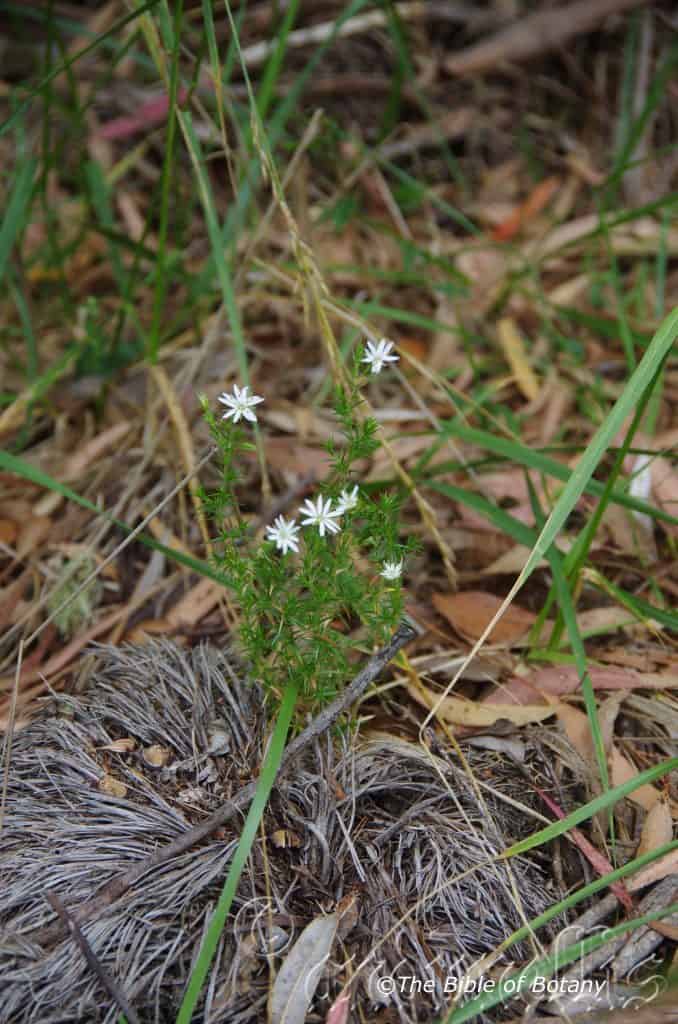
Ebor NSW
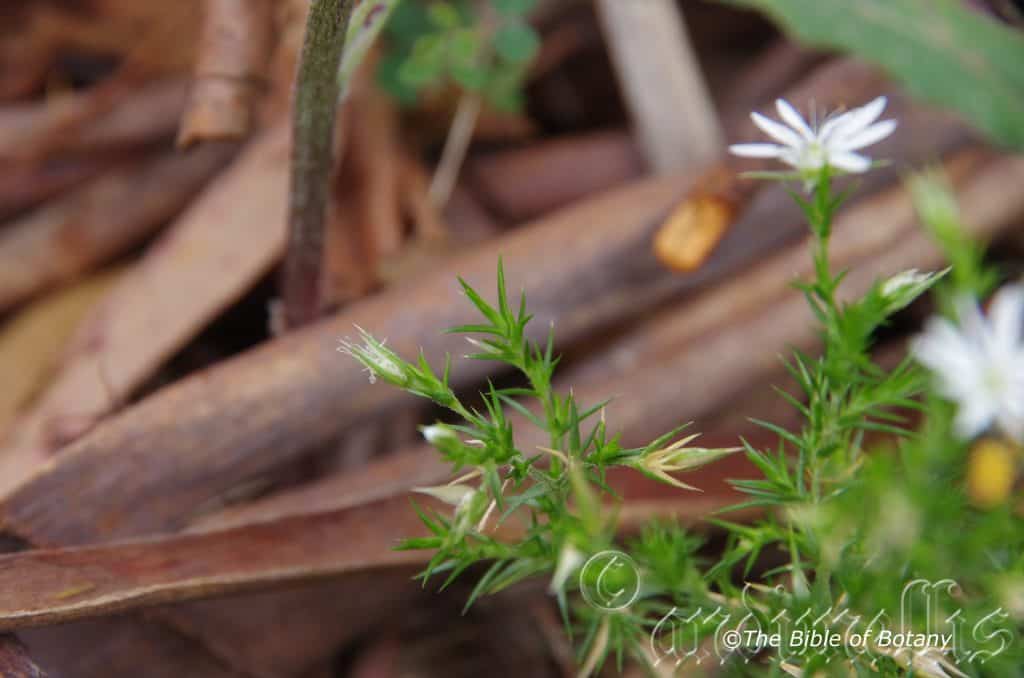
Ebor NSW
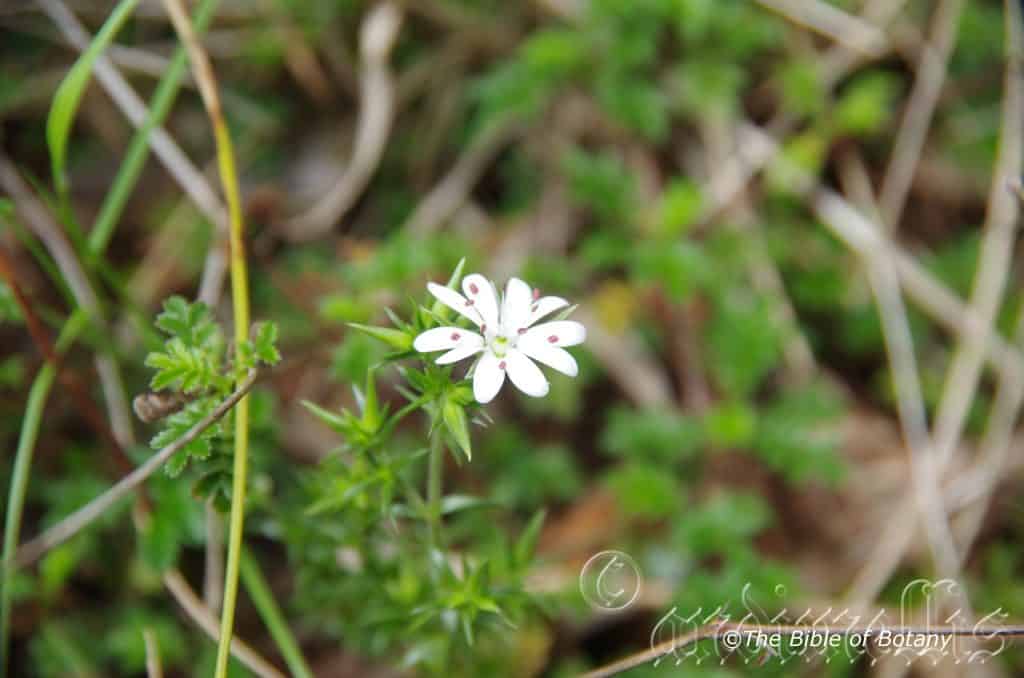
Ebor NSW
Stellaria pungens
Classification:
Unranked: Eudicots
Order: Caryophyllales
Family: Caryophyllaceae
Genus: From Ast?r, which is Ancient Greek or Stell?ris/Stell?tus, which is Latin for a star or star shape. It refers to flowers, which have a star shape or appear like stars in the field.
Specie: From Flaccidus, which is Latin for limp or flabby. It refers to the leaves semi arching to arching.
Sub specie:
Common Name: Pungent Stellaria.
Distribution:
Stellaria pungens is found south from Sundown National Park in far north eastern New South Wales to Mount Burr Forest in south eastern South Australia.
In Tasmania it is found on the northern third of the Island and down through the centre except the high lands. It is also found on the Bass Straight Islands.
https://avh.ala.org.au/occurrences/search?taxa=Stellaria+pungens#tab_mapView
Habitat Aspect Climate:
Stellaria pungens prefers light dappled shade to medium shade. It usually grows in moist places within gullies in sclerophyll forests, gallery forests or on the margins of rainforest. The altitude ranges from 5 meters ASL to 1700 meters ASL.
The temperatures range from minus 7 degrees in August to 40 degrees in January.
The rainfalls range from lows of 600mm to 2100mm average per annum.
Soil Requirements:
Stellaria pungens prefers to grow on better quality sandy loams to medium clays. The soils are usually derived from decomposed granites and sandstone or at times black basalts or brown basalts. The soils pH ranges from 5pH to 6pH. It does not tolerate water logged soils. Non saline soils to moderately saline soils are tolerated as are salt laden winds.
Height & Spread:
Wild Plants: 0.4m to 0.7m by 0.3m to 0.5m
Characteristics:
Stellaria pungens grows as a small prostrate or ascending perennial, which often roots at the nodes where they touch the ground. The angular stems are sparsely to moderately covered in short white, hirsute hairs, at times are appressed or at times are glabrous.
The opposite or whirled sessile, usually recurved, narrow lanceolate leaves measure 5mm to 10mm in length by 1.5mm to 2.5mm in width near the base. The bases are semi clasping, while the apexes taper to a rigid pungent tip. The concolourous laminas are mid green, dull and glabrous to scabrous. The laminas are recurve upwards from the mid vein to the margins and decurve downwards variably from the base or near the apex to the apex. The margins are entire and are sparsely covered in fine white ciliate hairs. The mid vein and lateral veins are not visible on either lamina
The inflorescences are born singularly from the terminals or in the upper axils. The terete pedicels measure 5mm to 30mm in length. The narrow lanceolate sepals curve strongly from the middle to the hyline, scarious margins and measure 5mm to 9mm in length by 1mm to 2.5mm in width. The white, deeply bifid petals measure 4.5mm to 10mm in length by 3.5mm to 7.5mm in width
The 10 dimorphic, white filaments measure measure 4mm to 7mm in length, while the dorsifixed anthers are deep pink to pinkish-mauve dehisce longitudinally.
The white, filaform trilobed stigma arises from lime-green apex, white glabrous ovary. The pistils measure 2mm to 3.5mm in length. The flowers appear from August to early February.
The fruits are ovoidal capsules. The glabrous capsules measure 5mm to 9mm in length by 3mm to 4mm in diameter. The valves are straight or slightly recurved at the apex. The 5 to 18 circular, flattened seeds are mustard to pale brown or at times ruby-red in colour. The seeds are sparsely to moderately tuberculate and measure 1mm to 1.8mm in length.
Wildlife:
Stellaria pungens support native colony bees like Tetragonula carbonaria along the coast.
The follicles are often eaten out internally by unknown weevils.
Cultivation:
Stellaria pungens is a small dense scrambling perennial that can be grown in association with other moist heath loving specie in small to medium gardens. In cultivation it grows from 0.4 meters to 0.5 meters in height by 0.2 meters to 0.3 meters in diameter when grown in the open or adjacent to other heath plants.
It grows exceptionally well on lighter clay soils where deep leaf litter keeps the soil cool and moisture at an even level. If these requirements are met they can cope with temperatures as low as minus 3 degrees and up to 38 degrees. It is moderately drought resistant once established however growth is slowed and flowering is set back.
However if it is given an adequate supply of water and a little native fertilizer on a regular basis the plants should respond with good flowering over a long period.
It does well in medium to large rockeries as the fill in plant. Here it can be planted in small groups of 5 or more will create a bushier look. Plant them at 200mm to 300mm centers. If they are surrounded by other short plants with finer or larger foliages with red or orange flowers like Lechenaultia formosa, yellow flowers like Hibbertia obtusifolia or Hibbertia linearis or blue flowers like Lechenaultia biloba then a strong contrast can be created from August to early February when it is in flower. Such a scene can be further enhanced with the judicial placement of rocks and logs.
Propagation:
Seeds: The seeds can be removed easily from mature fruits.
Sow fresh seeds directly into a seed raising mix, keeping them moist not wet. Do not over water as the seeds will rot off before germination takes place. Place the trays in a cool shaded area with 50mm shade cloth in the bush house. When the seedlings are 20mm to 25mm tall, prick them out and plant them into 50mm native tubes using a good organic mix.
As the seedlings roots reach the bottom of the tubes plant them out into their permanent position. Do not delay.
Fertilize using Seaweed, fish emulsion or organic chicken pellets soaked in water and apply the liquid on an alternate basis. Fertilize every 2 months until the plants are well established then on an annual basis in September or March to maintain health, vitality and better flowering.
Further Comments from Readers:
“Hi reader, it seems you use The Bible of Botany a lot. That’s great as we have great pleasure in bringing it to you! It’s a little awkward for us to ask, but our first aim is to purchase land approximately 1,600 hectares to link several parcels of N.P. into one at The Pinnacles NSW Australia, but we need your help. We’re not salespeople. We’re amateur botanists who have dedicated over 30 years to saving the environment in a practical way. We depend on donations to reach our goal. If you donate just $5, the price of your coffee this Sunday, We can help to keep the planet alive in a real way and continue to bring you regular updates and features on Australian plants all in one Botanical Bible. Any support is greatly appreciated. Thank you.”
In the spirit of reconciliation we acknowledge the Bundjalung, Gumbaynggirr and Yaegl and all aboriginal nations throughout Australia and their connections to land, sea and community. We pay our respect to their Elders past, present and future for the pleasures we have gained.
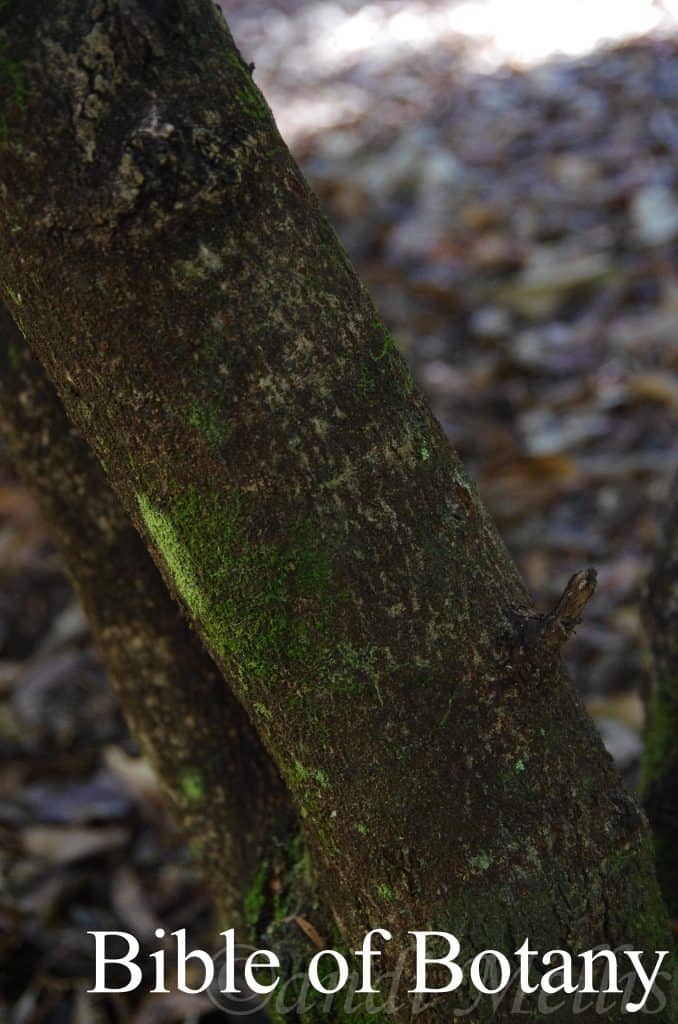
Stenocarpus angustifolius
Classification:
Unranked: Eudicots
Order: Proteales
Family: Proteaceae
Subfamily: Grevilleoideaae
Genus: From Stenos, which is Ancient Greek for narrow and Karpós, which is Ancient Greek for a fruit. It refers to the fruits, which are rather slender.
Specie: Angustifolius: [an-gus-ti-foh-li-us] From Angusta, which is Latin for narrow and Folium, which is Latin for foliage. It refers to leaves, which are rather narrow but not linear.
Sub specie:
Common Name: Narrow leaf Stenocarpus.
Distribution:
Stenocarpus angustifolius is found in far north eastern Queensland in two distinct disjunct populations. West of Cairnes it is located between the Atherton Tablelands south east to wild River. Around Townsville it is found from the Harvey Range to Reid river Gorge.
https://avh.ala.org.au/occurrences/search?taxa=Stenocarpus+angustifolius#tab_mapView
Habitat Aspect Climate:
Stenocarpus angustifolius prefer full shade to bright filtered sunlight. It grows in moist, warm tropical rainforest, warm subtropical rainforests on adjacent ranges to the coast. The altitude ranges from 80 meters ASL to 900 meters ASL.
The temperatures range from 3 degrees in August to 39 degrees in January.
The rainfalls range from lows of 900mm to 1400mm average per annum.
Soil Requirements:
Stenocarpus angustifolius prefer to grow on better quality sandy loams to medium clays at the edge of dry rainforests or moist, open woodlands. The soils are usually derived from decomposed black basalt. The soils pH ranges from 5pH to 6pH. It does not tolerate water logged soils however the soils have good moisture retentive characteristics. Non saline soils to slightly saline soils are tolerated.
Height & Spread:
Wild Plants: 4m to 5m by 4m to 5m
Characteristics:
Stenocarpus angustifolius grows as a large shrub with deep brown to almost black, smooth bark. Old trees may be slightly buttressed right at the base. The mid green stems are sparsely covered in fine white hirsute hairs soon becoming glabrous.
Young trees and those with coppice regrowth have finely divided trifoliate leaves. The leaves measure 45mm to 60mm in length by 5mm to 8mm in width. The petioles measure 30mm to 60mm in length.
While immature plants have trifoliate leaves, mature plants will have both trifoliate and simple leaves on the same plant. The simple, alternate, lanceolate leaves of Stenocarpus angustifolius measure 50mm to 185mm in length by 8mm to 12mm in width. The glabrous, terete petiole measures 70mm to 100mm in length. The bases taper to the petiole while the apexes areacute. The concolourous laminas are mid to pale grass-green, semi glossy and glabrous on the upper lamina while the lower lamina is slightly duller. The margins are entire on both immature and mature leaves. The mid vein is slightly prominent on the lower lamina and near the base. The lateral veins are very fine.
The pale yellow, cream or at times white conflorescences of Stenocarpus angustifolius are born from the upper leaf axils. The 12 to 20 individual flowers are born from the the upper leaf axils. The finely pubescent peduncle measures 22mm to 40mm in length while the pedicels measure 10mm to 30mm in length. The individual flowers measure 8mm to 10mm in length. The hypogynous gland is semicircular, glossy and pale yellowish-green.
The 4 pale yellow, cream or at times white filaments are sparsely covered in white pilose hairs and rectangular in cross section. The strongly revolute filaments measure 10mm to 20mm in length. The lateral anthers are yellowish-brown while the pollen is pale yellow. The anthers measure 1mm to 1.2mm in diameter.
The pale green style turns deep-green and back to pale green at the lateral glabrous stigma. The oblique pollen presenter is creamy–yellow to pale yellow. The pistils are glabrous and measure 12mm to 20mm in length. The stigmas are oblique and measure 2mm to 2.2mm in diameter. The flowers appear from late August to December.
Stenocarpus angustifolius fruits are narrow cylindrical follicles. The follicles are glabrous and measure 60mm to 100mm in length by 7mm to 11mm in diameter. The green capsules turn pale brown externally and fawnish-tan internally when ripe. The style is persistent on the ripe follicles. There are up to 8 mid brown to pale brown, flattened seeds in each follicle. The seeds measure 15mm to 20mm in length by 12mm to 15mm in width including the wing. The fruit ripens from January to March.
Wildlife:
Stenocarpus angustifolius supports many native bees including Tetragonula carbonaria and ants when in flower.
Cultivation:
Stenocarpus angustifolius is a large shrub or small tree that can be grown in association with other small dry rainforest specie in medium to larger gardens. In cultivation it grows from 5 meters to 8 meters in height by 5 meters to 8 meters in diameter when grown in the open . Most trees will not commence spreading until they reach a semi mature height. The first flowers usually appear after 7 or 8 years from seed. Cutting grown trees usually flower from the second year.
It grows exceptionally well on lighter clay soils where deep leaf litter keeps the soil cool and moisture at an even level. If these requirements are met it can cope with temperatures as low as 2 degrees and up to 40 degrees. It is moderately drought resistant once established however growth is slowed dramatically when other than ideal conditions are supplied.
If it is given an adequate supply of water and a little native fertilizer on a regular basis the plants will respond with better flowering and fruit over a long period.
Stenocarpus angustifolius make very good accent trees in front of low set and 2 story commercial buildings, industrial sheds or school classrooms where it will break up hard rigid architectural lines and give warmth and breadth to a building. In front of high rise buildings they give balance especially where they could be grown in curves standing as sentries to the entry doors. It will help maintain cooler temperatures in summer and warmer conditions in the winter.
Try using one in a court yard where the only other feature is a large rock, stump or formal or informal frog or fish pond. Next to such features their large glossy leaves and beautiful flowers are never overpowering but strong enough to be noticed. I am surprised that they have never been used in commercial entrances and foyers to break the ice and give a feeling of business as usual but somehow make the business more relaxing.
It looks great when used in medium to large rockeries as the feature plant. Here it can be planted in small groups of 2 or 3 or as a standalone plant to create the center of attention. If it is surrounded by shorter plants with finer or larger foliages, that are yellow-green or pale green then year round contrast can be created with a strong accent in the center of the bed. A more formal look can be achieved by radiating the smaller plants in a pattern of gold and purple. Use plants with deep red to red-orange flowers that are much shorter will also create that dominate affect at the center giving height and strength to the bed.
The trees are ideal for the growing epiphytic ferns and orchids on especially when grown on the edge of a rainforest garden.
Propagation:
Seeds: The seeds of Stenocarpus angustifolius can be removed easily from the follicles.
Sow fresh seeds directly into a seed raising mix, keeping them moist not wet. Cover the seeds with 1mm to 3mm of mix. Do not over water as the seeds will rot off before germination takes place. Place the trays in a cool shaded area with 30mm to 50mm shade cloth in the bush house. When the seedlings are 20mm to 25mm tall, prick them out and plant them into 50mm native tubes using a good organic mix.
As the seedlings roots reach the bottom of the tubes plant them out into their permanent position. Do not delay.
Fertilize using Seaweed, fish emulsion or organic chicken pellets soaked in water and apply the liquid on an alternate basis. Fertilize every 2 months until the plants are well established then on an annual basis in September or March to maintain health, vitality and better flowering.
Cuttings:
Stenocarpus angustifolius can be grown from cuttings, which strike relatively easy. Use 200mm to 350mm long semi hardwood to hardwood cuttings from the present season’s growth. Take them in warmer months of the year. Remove half the leaves from the bottom section being careful not to tear the bark.
1 Prepare the cutting mix by adding two thirds sharp clean river sand, one third peat or one third perlite. These ingredients must be sterilized,
2 Select good material from non diseased plants,
3 Select semi green stems for cuttings. Look for a stem with two or three nodes,
4 Place the cutting on a flat, hard surface, and make a clean cut down one side of the cutting at the base for 10mm with a sharp sterile knife or razor blade. – This scarification of the node will increase the chances of roots emerging from this spot. Now remove all but one or two the leaves, leaving the apex leaves in tact. If the leaves are very large in proportion to the stem, cut off the apical halves.
5 Fill a saucer with water, and place a little medium strength rooting hormone into another container like a milk bottle top. Dip the node end of the cutting into the water and then into the rooting hormone. Tap off any excess hormone,
6 Use a small dipple stick or old pencil to poke a hole into the soilless potting mix. Ensure the hole is slightly larger than the stem diameter and be careful not to wipe the rooting hormone off the cuttings base. Place 2 to 4 cuttings in each of the 50mm native tubes,
7 I like to place the tubes in bucket with holes drilled in the bottom to allow excess water to drain out. A plastic bag that fits over the bucket is ideal to help maintain temperature and moisture. Place in a semi shaded, warm position like under 50mm shade cloth.
8 When the cuttings have struck, open the bag to allow air circulation for a few days to a week,
9 Once hardened off remove the cuttings from the bag and allow to further hardening for a few more days to a week,
10 Transplant into a good potting mix to grow on.
Fertilize using seaweed, fish emulsion or organic chicken pellets soaked in water on an alternate basis. Fertilize every two months until the plants are established then twice annually in early September or March to maintain health, vitality and better flowering.
Further Comments from Readers:
“Hi reader, it seems you use The Bible of Botany a lot. That’s great as we have great pleasure in bringing it to you! It’s a little awkward for us to ask, but our first aim is to purchase land approximately 1,600 hectares to link several parcels of N.P. into one at The Pinnacles NSW Australia, but we need your help. We’re not salespeople. We’re amateur botanists who have dedicated over 30 years to saving the environment in a practical way. We depend on donations to reach our goal. If you donate just $5, the price of your coffee this Sunday, We can help to keep the planet alive in a real way and continue to bring you regular updates and features on Australian plants all in one Botanical Bible. Any support is greatly appreciated. Thank you.”
In the spirit of reconciliation we acknowledge the Bundjalung, Gumbaynggirr and Yaegl and all aboriginal nations throughout Australia and their connections to land, sea and community. We pay our respect to their Elders past, present and future for the pleasures we have gained.
Stenocarpus davallioides
Classification:
Unranked: Eudicots
Order: Proteales
Family: Proteaceae
Subfamily: Grevilleoideaae
Genus: From Stenos, which is Ancient Greek for narrow and Karpós, which is Ancient Greek for a fruit. It refers to the fruits, which are rather slender.
Specie: Davallia is named in Honour of Edmund Davall; 1763-1798, who was a Swiss botanist and –eid?s or -oid, which are Ancient Greek or later –o?des, which is Latin for alike or similar to. It refers to plants, which have leaves that resemble the fern genus Davallia.
Sub specie:
Common Name: Fern leaf Stenocarpus.
Distribution:
Stenocarpus davallioides is found in far north eastern Queensland between Thornton Peak and Mount Lewis National Park. It is found on and east of the Great Dividing Range.
https://avh.ala.org.au/occurrences/search?taxa=Stenocarpus+davallioides#tab_mapView
Habitat Aspect Climate:
Stenocarpus davallioides prefer full shade to full sun. It grows in moist monsoonal forests, warm tropical rainforest, warm subtropical rainforests and warm temperate rainforest on the coast and adjacent ranges. The altitude ranges from 600 meters ASL to 1260 meters ASL.
The temperatures range from 3 degrees in August to 39 degrees in January.
The rainfalls range from lows of 1400mm to 2000mm average per annum.
Soil Requirements:
Stenocarpus davallioides prefer to grow on better quality sandy loams to medium clays. The soils are usually derived from decomposed brown basalt, black basalts, metamorphic rocks, sandstone, granite or podsolics. The soils pH ranges from 4.5pH to 6pH. It does not tolerate water logged soils. Non saline soils to moderately saline soils are tolerated.
Height & Spread:
Wild Plants: 18m to 40m by 7m to 12m
Characteristics:
Stenocarpus davallioides grows as a large tree with deep brown, finely to coarsely, vertically fissured bark. Old trees are moderately buttressed at the base. The stems are maroon to reddish-purple and glabrous.
Young trees and those with coppice regrowth have finely divided, fern-like leaves. The leaves measure 300mm to 420mm in length by 200mm to 300mm in width. The petioles measure 60mm to 100mm in length.
The simple, alternate, lanceolate mature leaves of Stenocarpus davallioides are often a mixture of juvenile and mature leaves. The leaves measure 50mm to 135mm in length by 10mm to 40mm in width. The glabrous petiole measures 10mm to 20mm in length. The bases are oblique cuneate while the apexes are obtuse. The asymmetrical, coriaceous, discolourous laminas are grass-green to deep green, semi glossy to glossy and glabrous on the upper lamina while the lower lamina is paler and duller. The margins are entire on the true mature leaves. The mid vein is slightly prominent on the lower lamina and is more prominent closer to the base. The lateral veins are very finely prominent on the lower lamina.
The conflorescences of Stenocarpus davallioides are born from the upper leaf axils. There are 8 to 16 individual flowers on a simple spike. The glabrous to finely pubescent peduncle measures 15mm to 40mm in length while the pedicels measure 6mm to 12mm in length. The flowers measure 8mm to 20mm in length. The hypogynous gland is semicircular, glossy and pale yellowish-green.
The 4 pale yellowish to pale greenish filaments are glabrous to sparsely covered in white pilose hairs and rectangular in cross section. The strongly revolute filaments measure 10mm to 20mm in length. The lateral anthers are yellowish-brown while the pollen is pale yellow. The anthers measure 1mm to 1.2mm in diameter.
The pale greenish to pale orange style turns pale lime-green at the lateral glabrous stigma. The oblique pollen presenter is creamy–yellow to pale yellow. The pistils are glabrous and measure 7mm to 14mm in length. The stigmas are oblique and measure 2mm to 2.2mm in diameter. The flowers appear during November.
Stenocarpus davallioides fruits are narrow oblong follicles. The follicles are glabrous and measure 35mm to 65mm in length by 7mm to 11mm in diameter. The green capsules turn deep brown externally and fawnish-tan internally when ripe. The style is persistent on the ripe fruit. There are up to 8 mid brown to pale brown, flattened seeds in each follicle. The seeds measure 8mm to 12mm in length by 3mm to 4mm in width including the wing. The fruit ripen from January to March.
Wildlife:
Stenocarpus davallioides supports many native bees including Tetragonula carbonaria, pollen flies including the Blue banded bee Amegilla cingulata many butterflies and small honeyeaters when in flower.
Cultivation:
Stenocarpus davallioides is a tall tree that can be grown in association with other rainforest specie in medium to larger gardens. It is ideal at the edge of a rain forest or deep in the center of the rainforest though at the center the beautiful foliage will not be seen once the trees gain some height. It also makes a great park tree offering rather quick growth, and good dense shade. In cultivation it grows from 15 meters to 25 meters in height by 6 meters to 12 meters in diameter when grown in the open or taller and narrower if grown closer together as a rainforest tree. Most trees will not commence spreading until they reach a semi mature height. The first flowers usually appear after 7 or 8 years from seed. Cutting grown trees usually flower from the second year.
It grows exceptionally well on lighter clay soils where deep leaf litter keeps the soil cool and moisture at an even level. If these requirements are met they can cope with temperatures as low as minus 5 degrees and up to 40 degrees. It is moderately drought resistant once established however growth is slowed dramatically when other than ideal conditions are supplied.
If it is given an adequate supply of water and a little native fertilizer on a regular basis the plants will respond with exceptional flowering and fruit over a long period.
Stenocarpus davallioides make very good accent trees in front of low set and 2 story commercial buildings, industrial sheds or school classrooms where they will break up hard rigid architectural lines and give warmth and breadth to a building. In front of high rise buildings they give balance especially where they could be grown in curves standing as sentries to the entry doors. It will help maintain cooler temperatures in summer and warmer conditions in the winter.
Try using one in a court yard where the only other feature is a large rock, stump or formal or informal frog or fish pond. Next to such features their large glossy leaves and beautiful flowers are never overpowering but strong enough to be noticed. I am surprised that they have never been used in commercial entrances and foyers to break the ice and give a feeling of business as usual but somehow make the business more relaxing.
It looks great when used in medium to large rockeries as the feature plant. Here it can be planted in small groups of 2 or 3 or as a standalone plant to create the center of attention. If it is surrounded by shorter plants with finer or larger foliages, that are yellow-green or pale green then year round contrast can be created with a strong accent in the center of the bed. A more formal look can be achieved by radiating the smaller plants in a pattern of gold and purple. Use plants with deep red to red-orange flowers that are much shorter will also create that dominate affect at the center giving height and strength to the bed.
The trees are ideal for the growing epiphytic ferns and orchids on especially when grown on the edge of a rainforest garden.
Propagation:
Seeds: The seeds of Stenocarpus davallioides can be removed easily from the follicles.
Sow fresh seeds directly into a seed raising mix, keeping them moist not wet. Cover the seeds with 1mm to 3mm of mix. Do not over water as the seeds will rot off before germination takes place. Place the trays in a cool shaded area with 30mm to 50mm shade cloth in the bush house. When the seedlings are 20mm to 25mm tall, prick them out and plant them into 50mm native tubes using a good organic mix.
As the seedlings roots reach the bottom of the tubes plant them out into their permanent position. Do not delay.
Fertilize using Seaweed, fish emulsion or organic chicken pellets soaked in water and apply the liquid on an alternate basis. Fertilize every 2 months until the plants are well established then on an annual basis in September or March to maintain health, vitality and better flowering.
Cuttings:
Stenocarpus davallioides can be grown from cuttings, which strike relatively easy. Use 200mm to 350mm long semi hardwood to hardwood cuttings from the present season’s growth. Take them in warmer months of the year. Remove half the leaves from the bottom section being careful not to tear the bark.
1 Prepare the cutting mix by adding two thirds sharp clean river sand, one third peat or one third perlite. These ingredients must be sterilized,
2 Select good material from non diseased plants,
3 Select semi green stems for cuttings. Look for a stem with two or three nodes,
4 Place the cutting on a flat, hard surface, and make a clean cut down one side of the cutting at the base for 10mm with a sharp sterile knife or razor blade. – This scarification of the node will increase the chances of roots emerging from this spot. Now remove all but one or two the leaves, leaving the apex leaves in tact. If the leaves are very large in proportion to the stem, cut off the apical halves.
5 Fill a saucer with water, and place a little medium strength rooting hormone into another container like a milk bottle top. Dip the node end of the cutting into the water and then into the rooting hormone. Tap off any excess hormone,
6 Use a small dipple stick or old pencil to poke a hole into the soilless potting mix. Ensure the hole is slightly larger than the stem diameter and be careful not to wipe the rooting hormone off the cuttings base. Place 2 to 4 cuttings in each of the 50mm native tubes,
7 I like to place the tubes in bucket with holes drilled in the bottom to allow excess water to drain out. A plastic bag that fits over the bucket is ideal to help maintain temperature and moisture. Place in a semi shaded, warm position like under 50mm shade cloth.
8 When the cuttings have struck, open the bag to allow air circulation for a few days to a week,
9 Once hardened off remove the cuttings from the bag and allow to further hardening for a few more days to a week,
10 Transplant into a good potting mix to grow on.
Fertilize using seaweed, fish emulsion or organic chicken pellets soaked in water on an alternate basis. Fertilize every two months until the plants are established then twice annually in early September or March to maintain health, vitality and better flowering.
Further Comments from Readers:
“Hi reader, it seems you use The Bible of Botany a lot. That’s great as we have great pleasure in bringing it to you! It’s a little awkward for us to ask, but our first aim is to purchase land approximately 1,600 hectares to link several parcels of N.P. into one at The Pinnacles NSW Australia, but we need your help. We’re not salespeople. We’re amateur botanists who have dedicated over 30 years to saving the environment in a practical way. We depend on donations to reach our goal. If you donate just $5, the price of your coffee this Sunday, We can help to keep the planet alive in a real way and continue to bring you regular updates and features on Australian plants all in one Botanical Bible. Any support is greatly appreciated. Thank you.”
In the spirit of reconciliation we acknowledge the Bundjalung, Gumbaynggirr and Yaegl and all aboriginal nations throughout Australia and their connections to land, sea and community. We pay our respect to their Elders past, present and future for the pleasures we have gained.

NCBG Coffs Harbour NSW
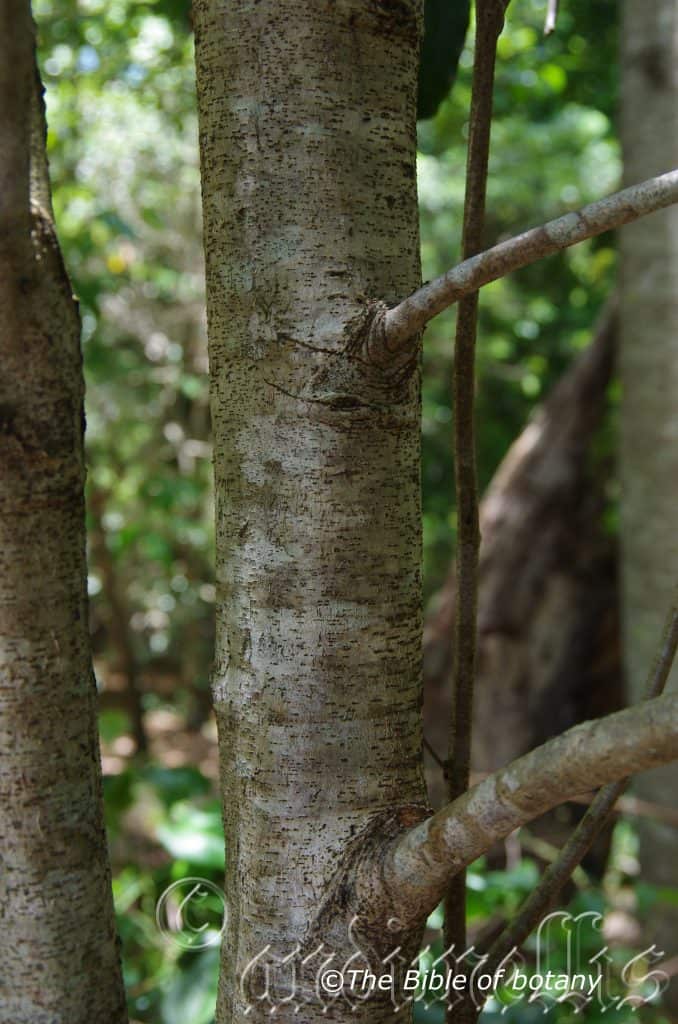
NCBG Coffs Harbour NSW
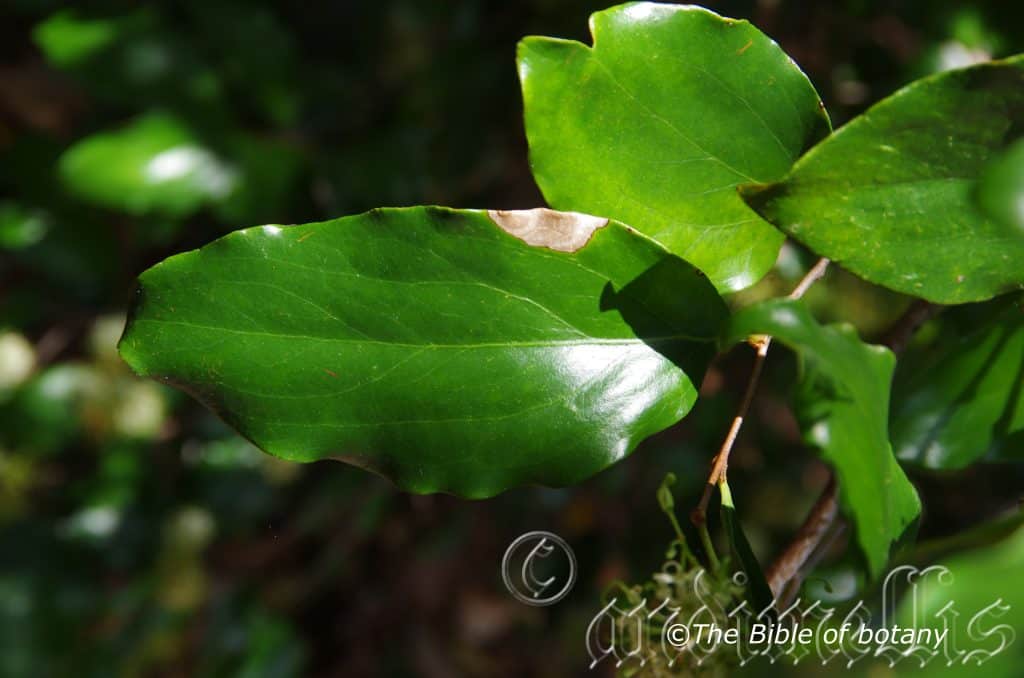
NCBG Coffs Harbour NSW
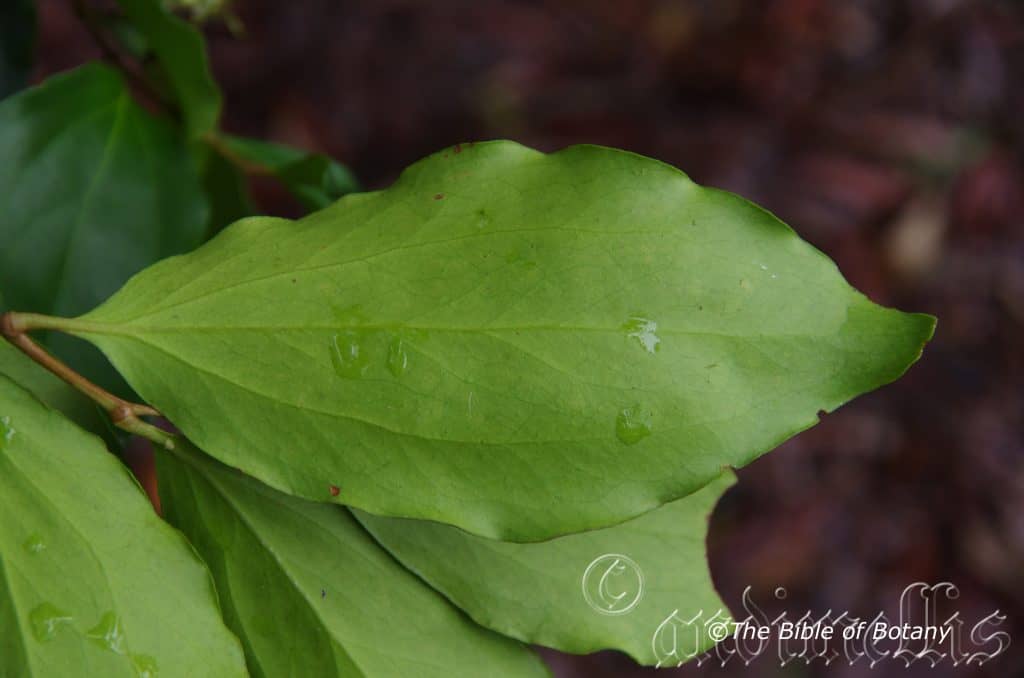
NCBG Coffs Harbour NSW
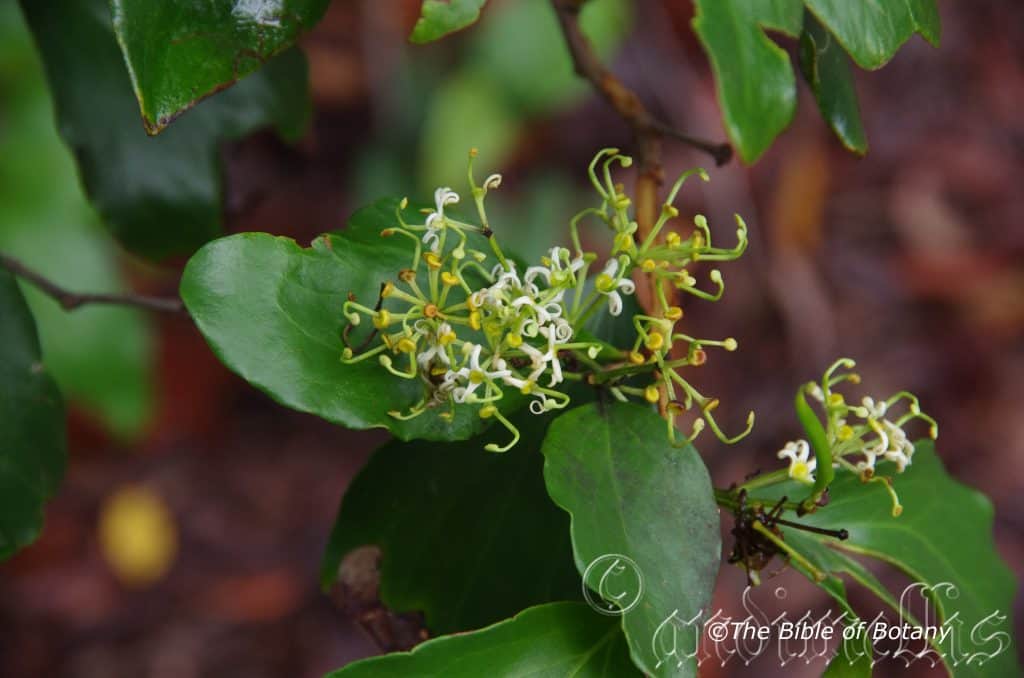
NCBG Coffs Harbour NSW
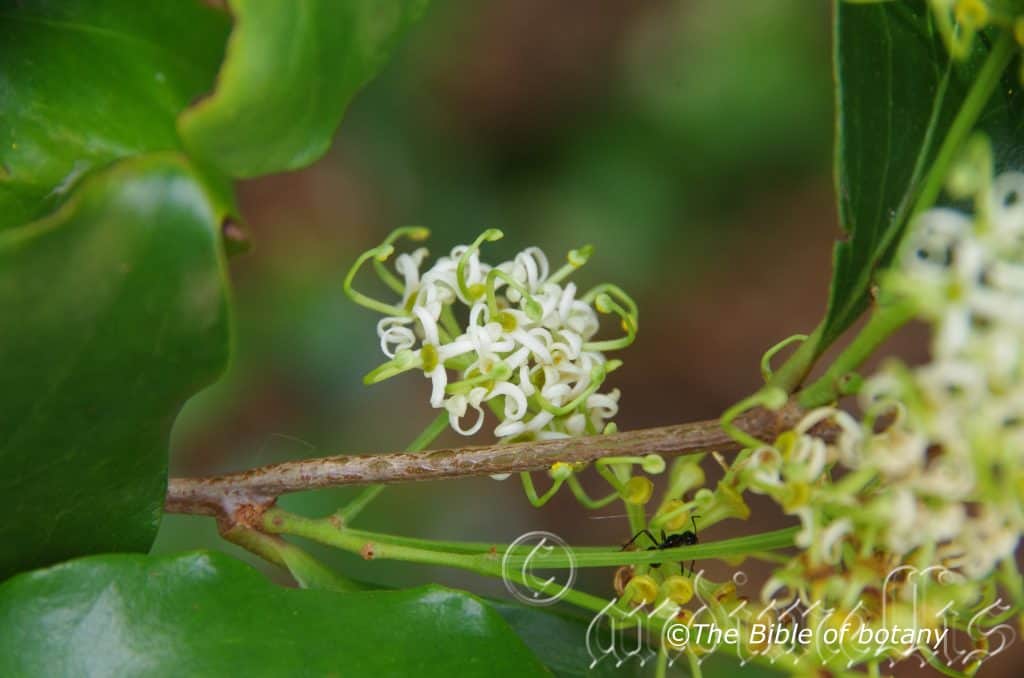
NCBG Coffs Harbour NSW
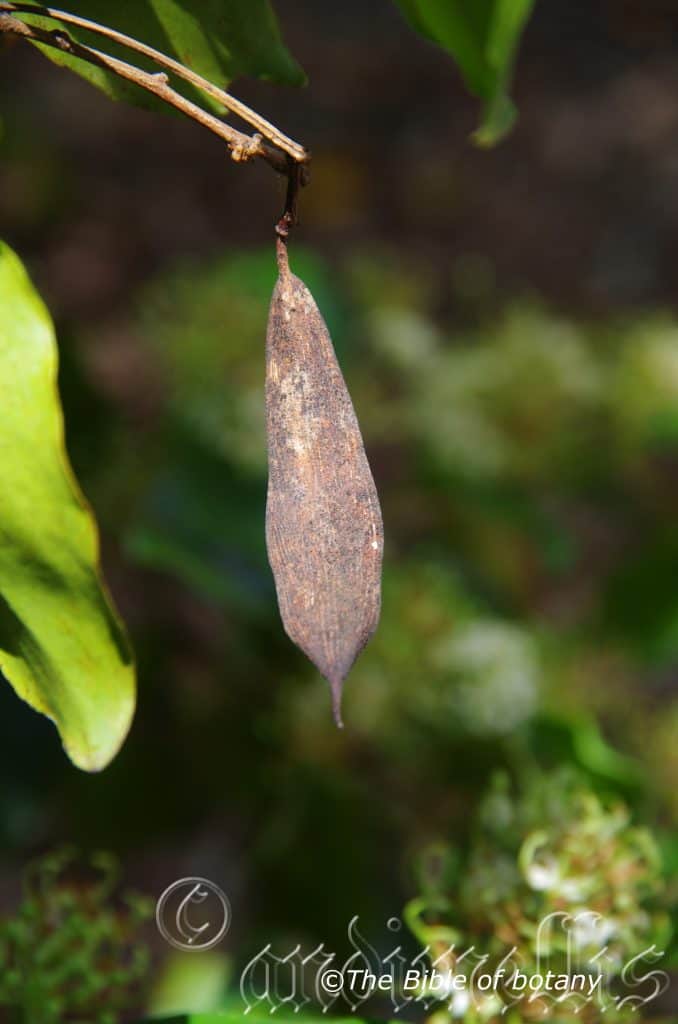
NCBG Coffs Harbour NSW
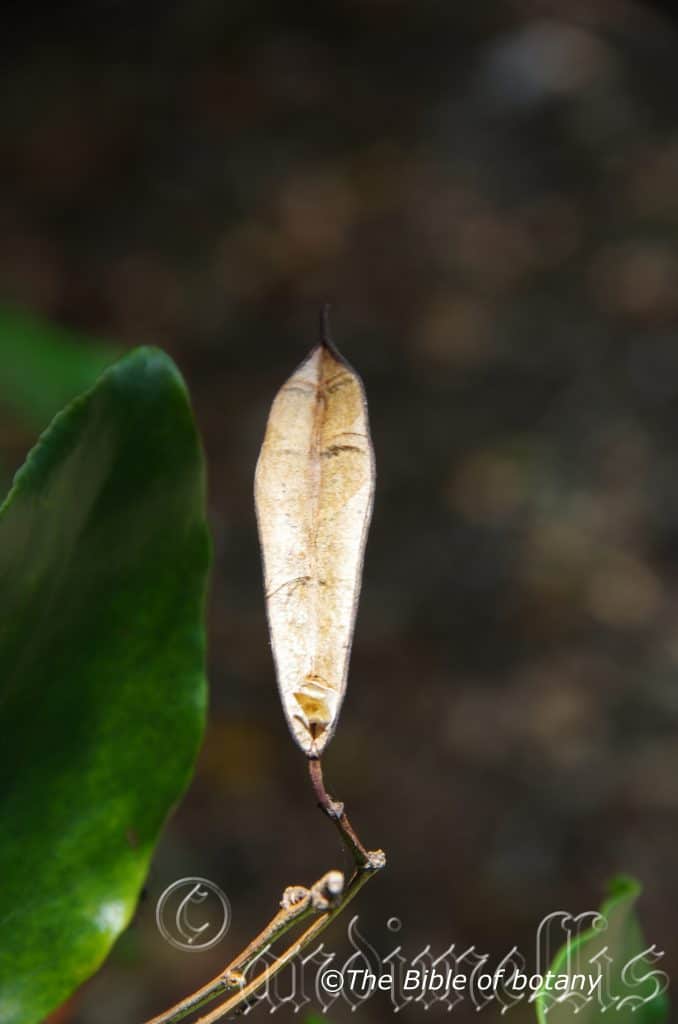
NCBG Coffs Harbour NSW
Stenocarpus salignus
Classification:
Unranked: Eudicots
Order: Proteales
Family: Proteaceae
Subfamily: Grevilleoideaae
Genus: From Stenos, which is Ancient Greek for narrow and Karpós, which is Ancient Greek for a fruit. It refers to the fruits, which are rather slender.
Specie: From Salix, which is Latin for the weeping willow. It refers to plants, which resemble the weeping willow in having branches or stems that weep.
Sub specie:
Common Name: Scrub Beefwood or Red Silky Oak.
Distribution:
Stenocarpus salignus is found in the Northern Territory from Point Murganella to the east Alligator Creek.
In the east it is found south from Prince of Wales Island in the Torres Straight Islands to Batemans Bay in central coastal New South Wales. It is mainly found on and east of the Great Dividing Range to the coast except where it extends to the Blackdown Tablelands, Enniskillen and the Carnarvon Ranges in central Queensland.
There are 2 isolated populations further south and west at Mount Martha on Mornington Peninsular in southern Victoria and at Scott Creek Conservation Park outside Adelaide in South Australia.
https://avh.ala.org.au/occurrences/search?taxa=Stenocarpus+salignus#tab_mapView
Habitat Aspect Climate:
Stenocarpus salignus prefer full shade to full sun. It grows in moist monsoonal forests, warm tropical rainforest, warm subtropical rainforests and warm temperate rainforest on the coast and adjacent ranges. The altitude ranges from 60 meters ASL to 1200 meters ASL.
The temperatures range from minus 3 degrees in August to 40 degrees in January.
The rainfalls range from lows of 300mm to 3000mm average per annum.
Soil Requirements:
Stenocarpus salignus prefer to grow on better quality sandy loams to medium clays. The soils are usually derived from decomposed brown basalt, black basalts, metamorphic rocks, sandstone, granite or podsolics. The soils pH ranges from 4.5pH to 6pH. It does not tolerate water logged soils. Non saline soils to moderately saline soils are tolerated.
Height & Spread:
Wild Plants: 18m to 30m by 7m to 12m
Characteristics:
Stenocarpus salignus grows as a very large shrub or tree with deep brown, finely to coarsely fissured and finely scaly bark. The stems are maroon to reddish-purple and glabrous.
The alternate, ovate, lanceolate or elliptic leaves of Stenocarpus salignus measure 50mm to 105mm in length by 10mm to 45mm in width when entire. The glabrous petiole measures 8mm to 20mm in length. The bases are oblique cuneate while the apexes are acute to obtuse. The asymmetrical, coriaceous, discolourous laminas are deep grass-green to deep green, semi glossy to glossy and glabrous on the upper lamina while the lower lamina is paler and dull. There are numerous minute translucent oil dots present which are barely visible with the human eye. The laminas recurve upwards from the mid vein to the margins and decurve on the apical half. The margins are entire. The mid vein and main vein on the lobes are prominent on the upper laminas. The usually 3 or at times 5 longitudinal veins arising near base and are not prominent on either surface. The reticulated veins are very fine.
The juvenile leaves are very variable from being shallowly lobed to being very deeply lobed.
The conflorescences of Stenocarpus salignus are usually born from the terminals or at times from the upper leaf axils. The 1 to 3 or rarely 4 simple umbels have 10 to 30 individual flowers. The greenish peduncle and reddish-brown to orange-brown pedicels are glabrous to sparsely covered in white pilose hairs and irregularly crowded. The peduncles measure 25mm to 60mm in length while the pedicels measure 8mm to 20mm in length. The flowers measure 8mm to 20mm in length. The hypogynous gland is semicircular, glossy and pale yellowish-green.
The 4 pale yellowish to pale greenish filaments are glabrous to sparsely covered in white pilose hairs and rectangular in cross section. The strongly revolute filaments measure 10mm to 20mm in length. The lateral anthers are yellowish-brown while the pollen is pale yellow. The anthers measure 1mm to 1.6mm in diameter.
The pale reddish-brown to orange-brown style turns pale lime-green at the lateral stigma are glabrous. The oblique pollen presenter is creamy–yellow to pale yellow. The pistils are glabrous to sparsely covered in white pilose hairs and measure 10mm to 20mm in length. The stigmas are oblique and measure 2.2mm to 3mm in diameter. The flowers appear October to January.
Stenocarpus salignus fruits are ellipsoidal to oblanceolate follicles. The follicles are glabrous and measure 40mm to 70mm in length by 9mm to 13mm in diameter. The green capsules turn deep brown externally and fawnish-tan internally when ripe. The style is persistent on the ripe fruit. The mid brown to pale brown seeds are flattened, oblong woody to coriaceous seeds. The seeds measure 10mm to 15mm in length by 3mm to 4mm in width including the wing. The fruit ripen from September to November.
Wildlife:
Stenocarpus salignus supports many native bees including Tetragonula carbonaria, pollen flies including the Blue banded bee Amegilla cingulata many butterflies and small honeyeaters when in flower.
Cultivation:
Stenocarpus salignus is a magnificent small tree that can be grown in association with other rainforest specie in medium to larger gardens. It is ideal at the edge of a rain forest or deep in the center of the rainforest though at the center the beautiful foliage will not be seen once the trees gain some height. It also makes great park tree offering rather quick growth, and good dense shade. In cultivation it grows from 8 meters to 15 meters in height by 6 meters to 12 meters in diameter when grown in the open or taller and narrower if grown closer together as a rainforest tree. Most trees will not commence spreading until they reach a semi mature height. The first flowers usually appear after 7 or 8 years from seed. Cutting grown trees usually flower from the second year.
It grows exceptionally well on lighter clay soils where deep leaf litter keeps the soil cool and moisture at an even level. If these requirements are met they can cope with temperatures as low as minus 5 degrees and up to 40 degrees. It is moderately drought resistant once established however growth is slowed dramatically when other than ideal conditions are supplied.
If it is given an adequate supply of water and a little native fertilizer on a regular basis the plants will respond with exceptional flowering and fruit over a long period.
Stenocarpus salignus make very good accent trees in front of low set and 2 story commercial buildings, industrial sheds or school classrooms where they will break up hard rigid architectural lines and give warmth and breadth to a building. In front of high rise buildings they give balance especially where they could be grown in curves standing as sentries to the entry doors. It will help maintain cooler temperatures in summer and warmer conditions in the winter.
Try using one in a court yard where the only other feature is a large rock, stump or formal or informal frog or fish pond. Next to such features their large glossy leaves and beautiful flowers are never overpowering but strong enough to be noticed. I am surprised that they have never been used in commercial entrances and foyers to break the ice and give a feeling of business as usual but somehow make the business more relaxing.
It looks great when used in medium to large rockeries as the feature plant. Here it can be planted in small groups of 2 or 3 or as a standalone plant to create the center of attention. If it is surrounded by shorter plants with finer or larger foliages, that are yellow-green or pale green then year round contrast can be created with a strong accent in the center of the bed. A more formal look can be achieved by radiating the smaller plants in a pattern of gold and purple. Use plants with deep red to red-orange flowers that are much shorter will also create that dominate affect at the center giving height and strength to the bed.
The trees are ideal for the growing epiphytic ferns and orchids on especially when grown on the edge of a rainforest garden.
Propagation:
Seeds: The seeds of Stenocarpus salignus can be removed easily from the follicles.
Sow fresh seeds directly into a seed raising mix, keeping them moist not wet. Cover the seeds with 1mm to 3mm of mix. Do not over water as the seeds will rot off before germination takes place. Place the trays in a cool shaded area with 30mm to 50mm shade cloth in the bush house. When the seedlings are 20mm to 25mm tall, prick them out and plant them into 50mm native tubes using a good organic mix.
As the seedlings roots reach the bottom of the tubes plant them out into their permanent position. Do not delay.
Fertilize using Seaweed, fish emulsion or organic chicken pellets soaked in water and apply the liquid on an alternate basis. Fertilize every 2 months until the plants are well established then on an annual basis in September or March to maintain health, vitality and better flowering.
Cuttings:
Stenocarpus salignus can be grown from cuttings, which strike relatively easy. Use 200mm to 350mm long semi hardwood to hardwood cuttings from the present season’s growth. Take them in warmer months of the year. Remove half the leaves from the bottom section being careful not to tear the bark.
1 Prepare the cutting mix by adding two thirds sharp clean river sand, one third peat or one third perlite. These ingredients must be sterilized,
2 Select good material from non diseased plants,
3 Select semi green stems for cuttings. Look for a stem with two or three nodes,
4 Place the cutting on a flat, hard surface, and make a clean cut down one side of the cutting at the base for 10mm with a sharp sterile knife or razor blade. – This scarification of the node will increase the chances of roots emerging from this spot. Now remove all but one or two the leaves, leaving the apex leaves in tact. If the leaves are very large in proportion to the stem, cut off the apical halves.
5 Fill a saucer with water, and place a little medium strength rooting hormone into another container like a milk bottle top. Dip the node end of the cutting into the water and then into the rooting hormone. Tap off any excess hormone,
6 Use a small dipple stick or old pencil to poke a hole into the soilless potting mix. Ensure the hole is slightly larger than the stem diameter and be careful not to wipe the rooting hormone off the cuttings base. Place 2 to 4 cuttings in each of the 50mm native tubes,
7 I like to place the tubes in bucket with holes drilled in the bottom to allow excess water to drain out. A plastic bag that fits over the bucket is ideal to help maintain temperature and moisture. Place in a semi shaded, warm position like under 50mm shade cloth.
8 When the cuttings have struck, open the bag to allow air circulation for a few days to a week,
9 Once hardened off remove the cuttings from the bag and allow to further hardening for a few more days to a week,
10 Transplant into a good potting mix to grow on.
Fertilize using seaweed, fish emulsion or organic chicken pellets soaked in water on an alternate basis. Fertilize every two months until the plants are established then twice annually in early September or March to maintain health, vitality and better flowering.
Further Comments from Readers:
“Hi reader, it seems you use The Bible of Botany a lot. That’s great as we have great pleasure in bringing it to you! It’s a little awkward for us to ask, but our first aim is to purchase land approximately 1,600 hectares to link several parcels of N.P. into one at The Pinnacles NSW Australia, but we need your help. We’re not salespeople. We’re amateur botanists who have dedicated over 30 years to saving the environment in a practical way. We depend on donations to reach our goal. If you donate just $5, the price of your coffee this Sunday, We can help to keep the planet alive in a real way and continue to bring you regular updates and features on Australian plants all in one Botanical Bible. Any support is greatly appreciated. Thank you.”
In the spirit of reconciliation we acknowledge the Bundjalung, Gumbaynggirr and Yaegl and all aboriginal nations throughout Australia and their connections to land, sea and community. We pay our respect to their Elders past, present and future for the pleasures we have gained.

Author’s Garden The Pinnacles NSW
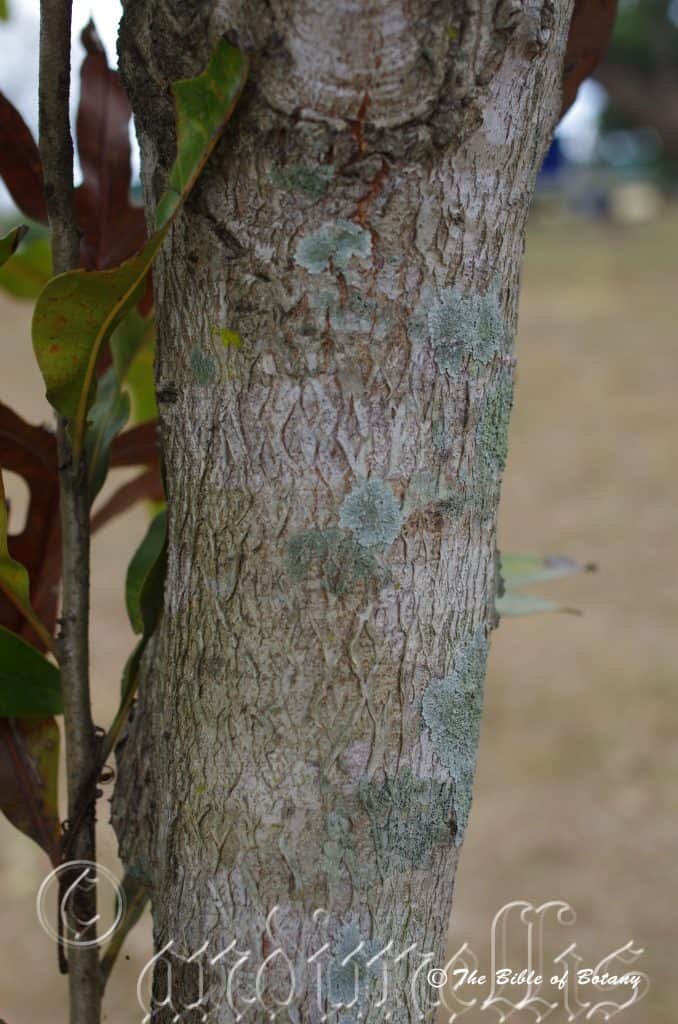
Brookside Qld.
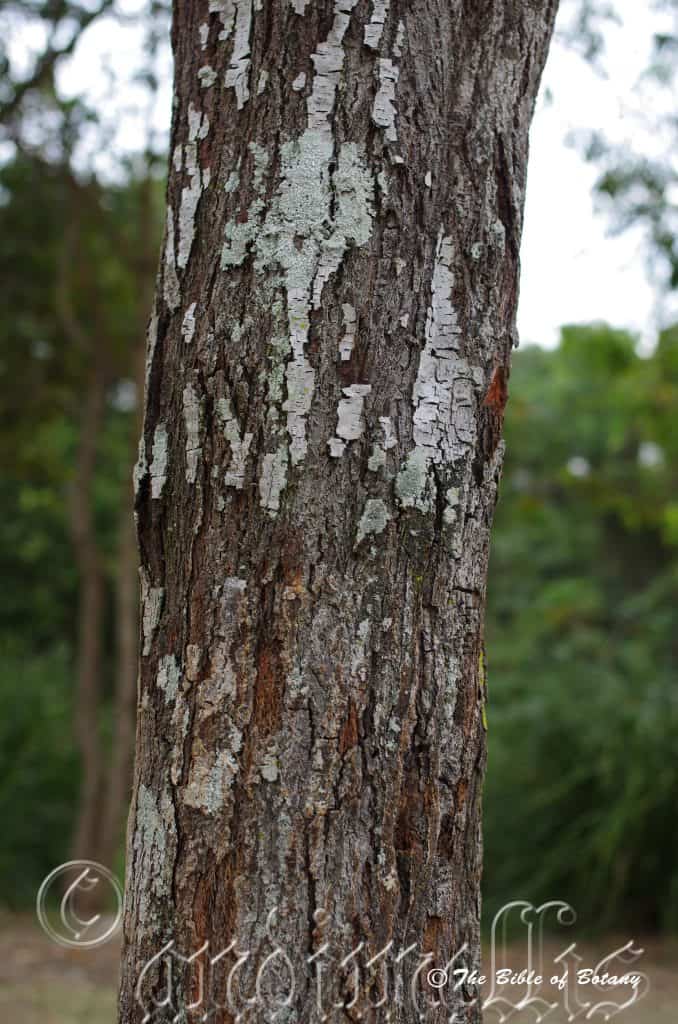
Brookside Qld.
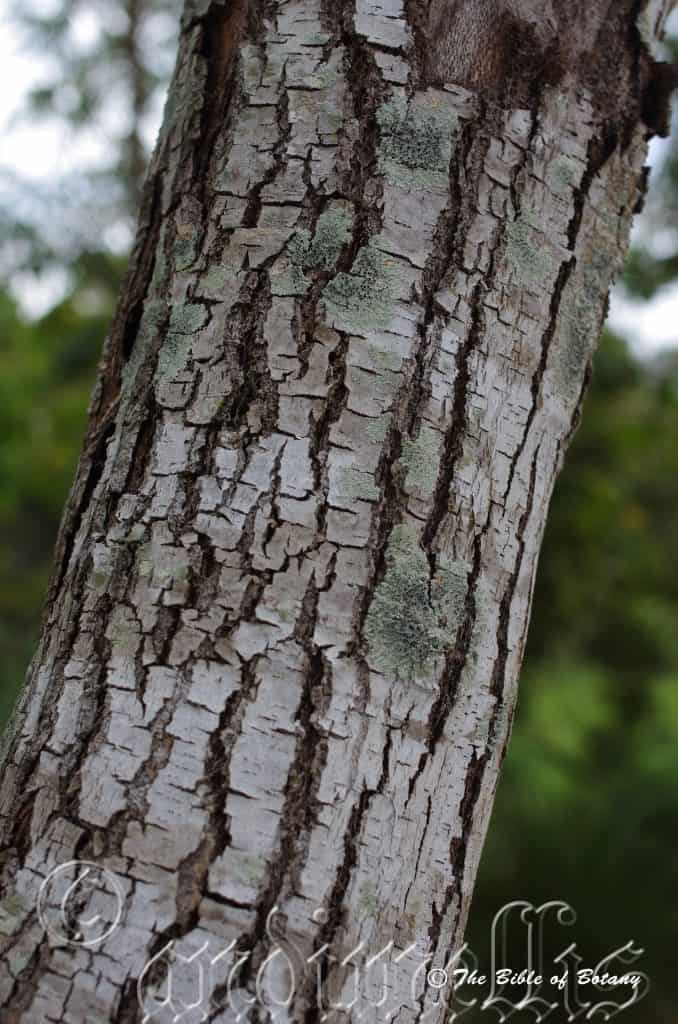
Brookside Qld.

Author’s Garden The Pinnacles NSW

Author’s Garden The Pinnacles NSW
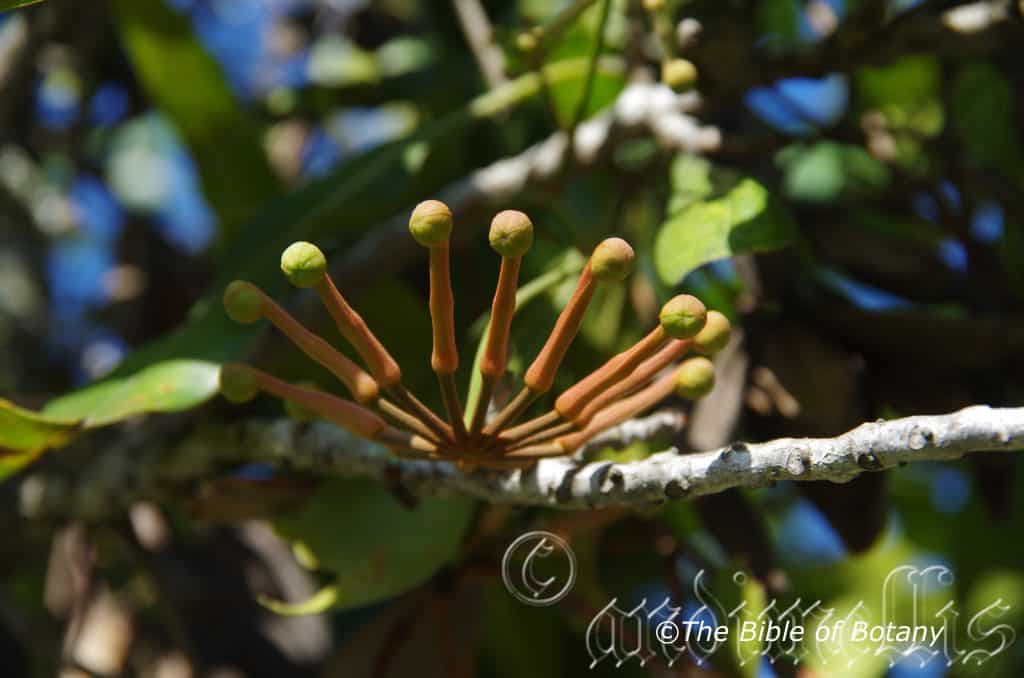
Grafton NSW
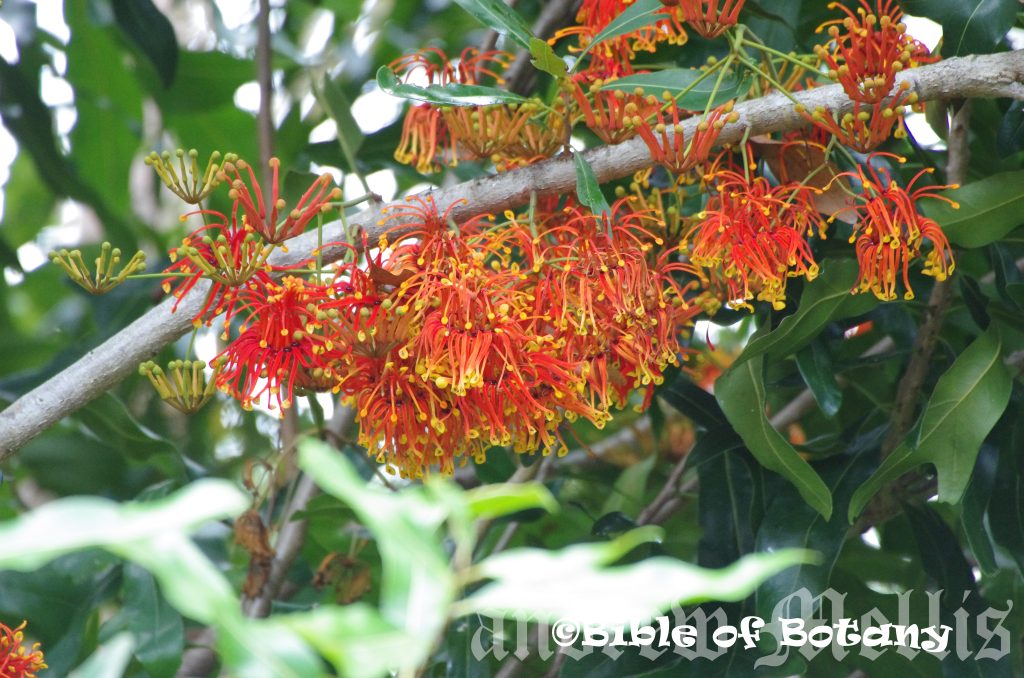
Author’s Garden The Pinnacles NSW

Grafton NSW

Author’s Garden The Pinnacles NSW
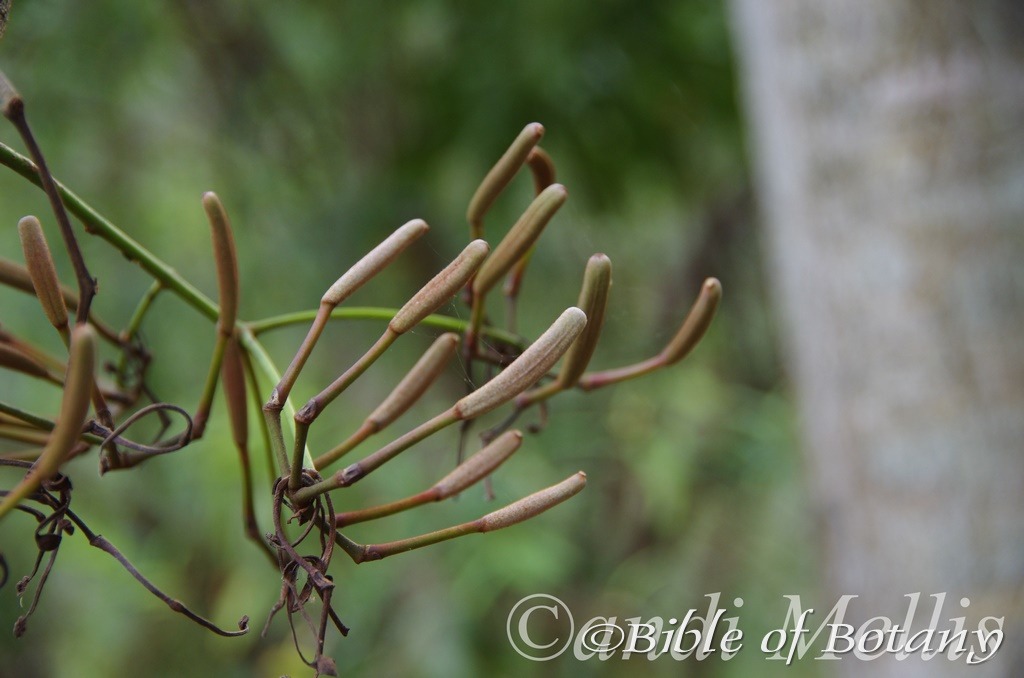
Author’s Garden The Pinnacles NSW

Grafton NSW
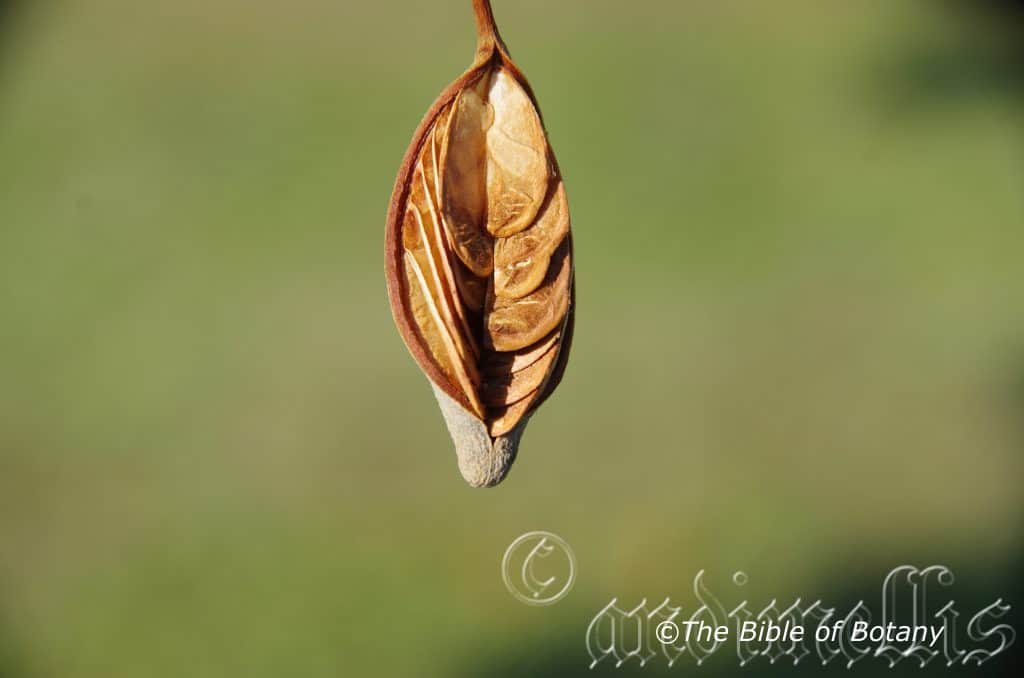
Grafton NSW
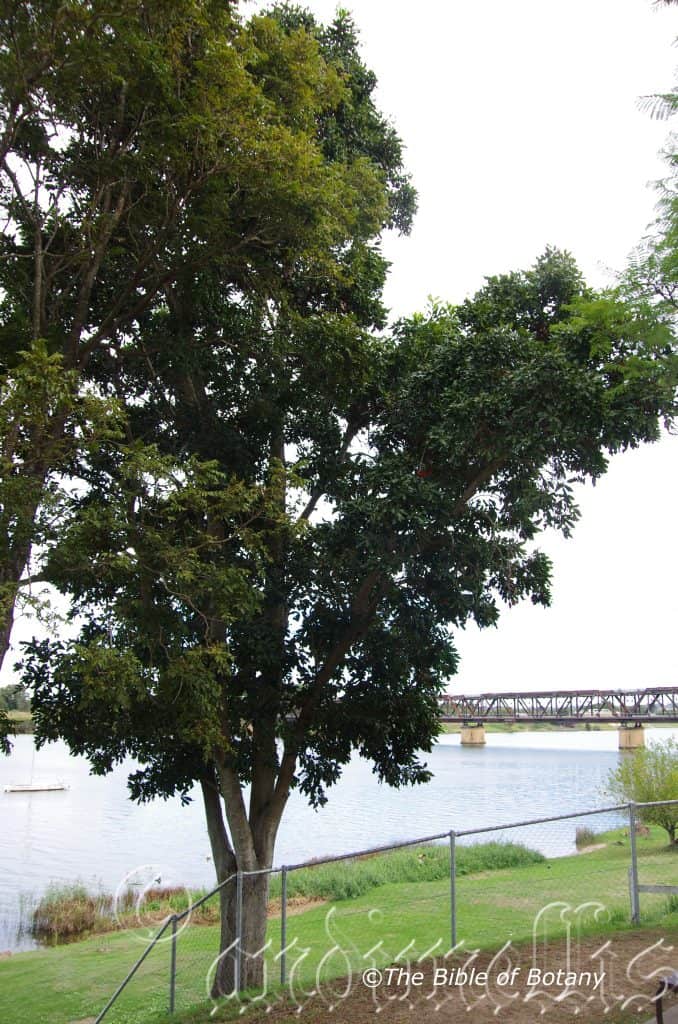
Clarence River Grafton
Stenocarpus sinuatis
Classification:
Unranked: Eudicots
Order: Proteales
Family: Proteaceae
Genus: From Stenos, which is Ancient Greek for narrow and Karpós, which is Ancient Greek for a fruit. It refers to the fruits, which are rather slender.
Specie: From Sinuare, which is Latin for to bend, undulating or strongly bending. It refers to structures or organs, which are wavy or bendy in the case of a sinuous path.
Sub specie:
Common Name: Fire Wheel Tree.
Distribution:
Stenocarpus sinuatis is found south from the Daintree River National Park to of Sydney and from the Nambucca River in central coastal New South Wales. It is mainly found on and east of the Great Dividing Range.
https://avh.ala.org.au/occurrences/search?taxa=Stenocarpus+sinuatis#tab_mapView
Habitat Aspect Climate:
Stenocarpus sinuatis prefers medium shade to full sun. It grows east of the Great Dividing Range to the back dunes in littoral rainforests, warm sub-tropical rainforests or cool tropical rainforests. The altitude ranges from 400 meters ASL to 1200 meters ASL.
The temperatures range from minus 4 degrees in August to 39 degrees in January.
The rainfalls range from lows of 850mm to 3000mm average per annum.
Soil Requirements:
Stenocarpus sinuatis prefers better quality sandy loams to medium clays. The soils are usually derived from decomposed brown basalt, black basalts or metamorphic rocks often with over limestone. The soils pH ranges from 4.5pH to 6pH. It does not tolerate water logged soils. Non saline soils to moderately saline soils are tolerated.
Height & Spread:
Wild Plants: 25m to 35m by 7m to 9m.
Characteristics:
The main trunk of Stenocarpus sinuatis is tall, straight, pale grey to pale brown and longitudinally wrinkled. The bark is hard and corky. The branches are grey to brown and only becoming pale green near the apex where the leaf growth occurs. The branchlets are glabrous.
The opposite, sub opposite or clustered, oblong-lanceolate leaves of Stenocarpus sinuatis measure 100mm to 250mm in length by 20mm to 60mm in width when entire. It is shorter and wider when the leaves are lobed. The juvenile trees often have larger leaves which are always lobed and measure 450mm by 240mm in width. The base is tapering attenuate while the apexes are obtuse. The concolourous laminas are deep grass-green to sea-green, semi glossy to glossy and glabrous on the upper lamina while the lower lamina is semi glossy. The leaf margins are entire, flat and decurve towards the apex. The mid vein and main vein on the lobes are prominent on the upper laminas. The petiole measures 10mm to 26mm in length.
The inflorescences of Stenocarpus sinuatis are born on umbels from the terminals or ramiflorously from the branches. There are 12 to 20 individual flowers on a peduncle. The yellow to dull yellow-orange peduncles and pedicels are glabrous. The long narrow campanulate pedicels radiate out from the campanulate peduncle’s apex like the spokes in a wheel. The peduncles measure 55mm to 90mm in length while the pedicels measure 8mm to 12mm in length. The perianth tube is scarlet red and covered in rusty-red pulverulent hairs externally and is glabrous internally. The perianths measure 25mm to 30mm in length by 4mm to 5mm in width.
The 2 pale reddish to orangey-red filaments are rusty-red pulverulent hairs externally and is glabrous internally and are rectangular in cross section. The twisting filaments measure 25mm to 30mm in length. The lateral anthers are yellow while the pollen is pale yellow. The anthers measure 4mm to 6mm in diameter.
The reddish to orange-red style has a lateral stigma. The oblique pollen presenter is yellow. The pistils are glabrous to sparsely covered in white pilose hairs and measure 25mm to 30mm in length. The stigmas are oblique and measure 4mm to 5mm in diameter. The flowers appear from March through to July.
The fruits of Stenocarpus sinuatis are globose to oblong follicles. The follicles are glabrous and slightly scabrous to touch and measure 40mm to 70mm in length by 12mm to 25mm in diameter. The green capsules turn deep grey to brown externally and paler internally when ripe. The calyx lobes are persistent on the ripe fruit. There are 3 to 5 dull fawn to pale woody brown seeds are flattened, ellipsoidal, woody seeds in each half of the follicle. They measure 25mm to 36mm in length including the terminal wing. The fruit ripen from September to November.
Wildlife:
Stenocarpus sinuatis support native bees along the coast. The trees follicles are often eaten out internally by unknown weevils.
Cultivation:
Stenocarpus sinuatis is a magnificent small tree that should be grown in association with other rainforest specie in medium to larger gardens. It is ideal at the edge of a rain forest or deep in the center of the rainforest though at the center the beautiful foliage will not be seen once the trees gain some height. They also make great park trees offering rather quick growth, and shade. In cultivation they will grow from 12 meters to 18 meters in height by 9 meters to 15 meters in diameter when grown in the open or taller and narrower if grown closer together as a rainforest tree. Most trees will not commence spreading until they reach a semi mature height and begin flowering which may take 7 to 8 years from seed. Cutting grown trees usually flower from the third year.
They grow exceptionally well on lighter clay soils where deep leaf litter keeps the soil cool and moisture at an even level. If these requirements are met they can cope with temperatures as low as minus 5 degrees and up to 40 degrees. It is moderately drought resistant once established however growth is slowed a lot when other than ideal conditions are supplied.
However if it is given an adequate supply of water and a little native fertilizer on a regular basis the plants should respond with exceptional flowering and fruit over a long period.
Stenocarpus sinuatis make very good accent trees in front of low set and 2 story commercial or industrial sheds where they will break up hard rigid architectural lines and give warmth and breadth to a building. In front of high rise buildings they give balance especially where they could be grown in curves standing as sentries to the entry doors. For something different use them from the front corners and meander them back to the main entry leaving large space to plant very small shrubs or annual flowers between the trees and the nature strip. This makes a strong statement of welcome, calmness and peace with colour in your day.
Try using them in a court yard where the only other feature is a large rock, stump or formal or informal frog or fish pond. Next to such features their large glossy leaves and brilliant red flowers are never overpowering but strong enough to be noticed. I am surprised that they have never been used in commercial entrances and foyers to break the ice and give a feeling of business as usual but somehow make the business more relaxing.
It is great when used in medium to large rockeries as the feature plant. Here they can be planted in small groups of 2 or 3 or as a standalone plant to create the center of attention. If it is surrounded by shorter plants with finer or larger foliages, that are yellow-green or pale green then year round contrast can be created with a strong accent in the center of the bed. A more formal look can be achieved by radiating the smaller plants in a pattern of gold and purple. Their deep red to red-orange flowers will also create that dominate affect at the center giving height and strength to the bed especially if yellow autumn and winter flowering plants are used. This dominance in foliage will stand unchallenged.
The trees are ideal for the growing epiphytic ferns and orchids on especially when grown on the edge of a forest.
Propagation:
Seeds: The seeds of Stenocarpus sinuatis can be removed easily from the fruits.
Sow fresh seeds directly into a seed raising mix, keeping them moist not wet. Do not over water as the seeds will rot off before germination takes place. Place the trays in a cool shaded area with 50mm shade cloth in the bush house. When the seedlings are 20 to 25mm tall, prick them out and plant them into 50mm native tubes using a good organic mix.
As the seedlings roots reach the bottom of the tubes plant them out into their permanent position. Do not delay.
Fertilize using Seaweed, fish emulsion or organic chicken pellets soaked in water and apply the liquid on an alternate basis. Fertilize every 2 months until the plants are well established then on an annual basis in September or March to maintain health, vitality and better flowering.
Further Comments from Readers:
“Hi reader, it seems you use The Bible of Botany a lot. That’s great as we have great pleasure in bringing it to you! It’s a little awkward for us to ask, but our first aim is to purchase land approximately 1,600 hectares to link several parcels of N.P. into one at The Pinnacles NSW Australia, but we need your help. We’re not salespeople. We’re amateur botanists who have dedicated over 30 years to saving the environment in a practical way. We depend on donations to reach our goal. If you donate just $5, the price of your coffee this Sunday, We can help to keep the planet alive in a real way and continue to bring you regular updates and features on Australian plants all in one Botanical Bible. Any support is greatly appreciated. Thank you.”
In the spirit of reconciliation we acknowledge the Bundjalung, Gumbaynggirr and Yaegl and all aboriginal nations throughout Australia and their connections to land, sea and community. We pay our respect to their Elders past, present and future for the pleasures we have gained.
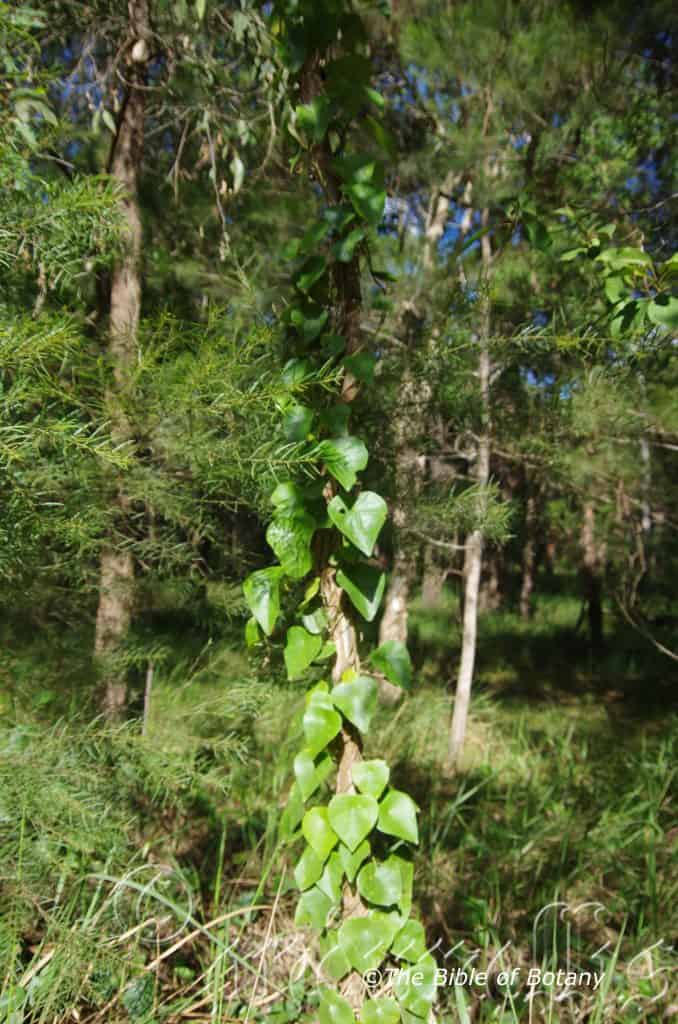
Tucabia NSW

North Yuraygir National Park NSW
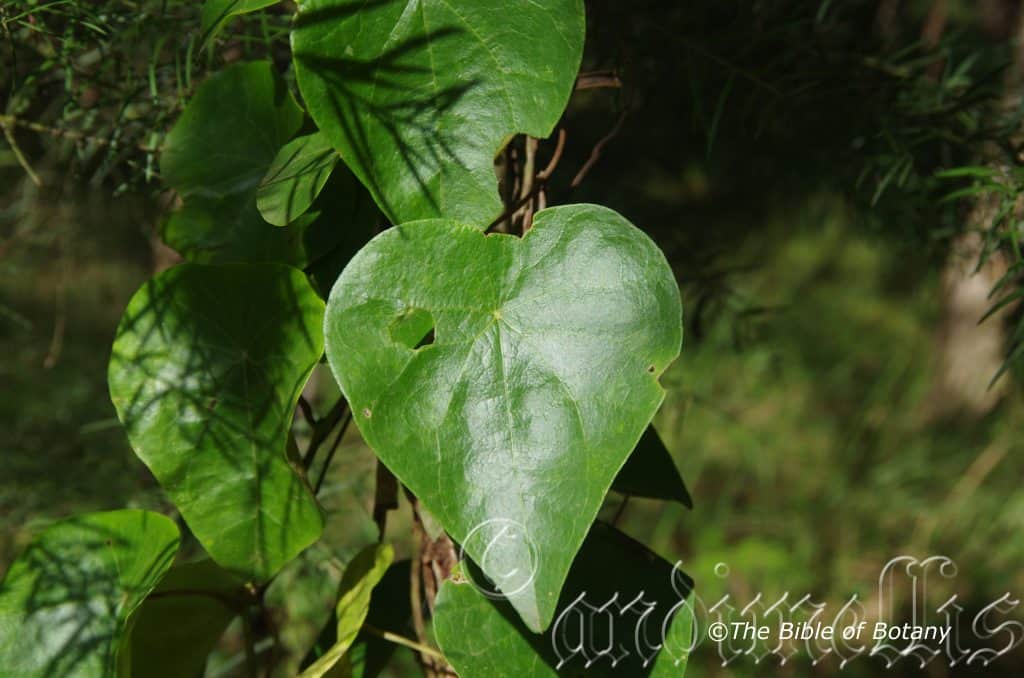
Tucabia NSW

Tucabia NSW

Tucabia NSW
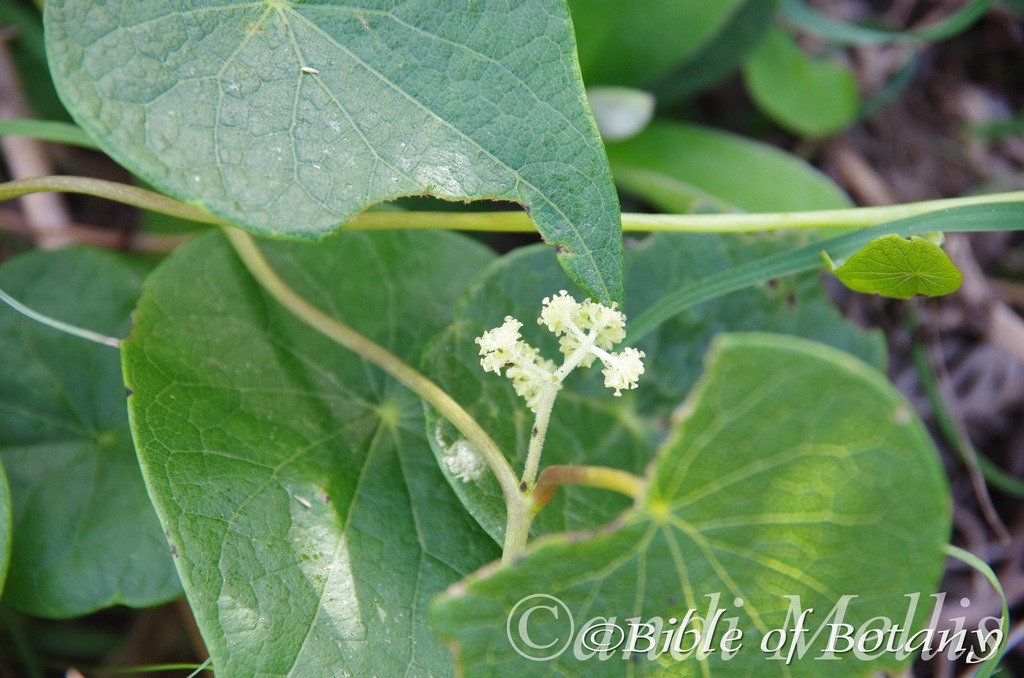
TNorth Yuraygir National Park NSW
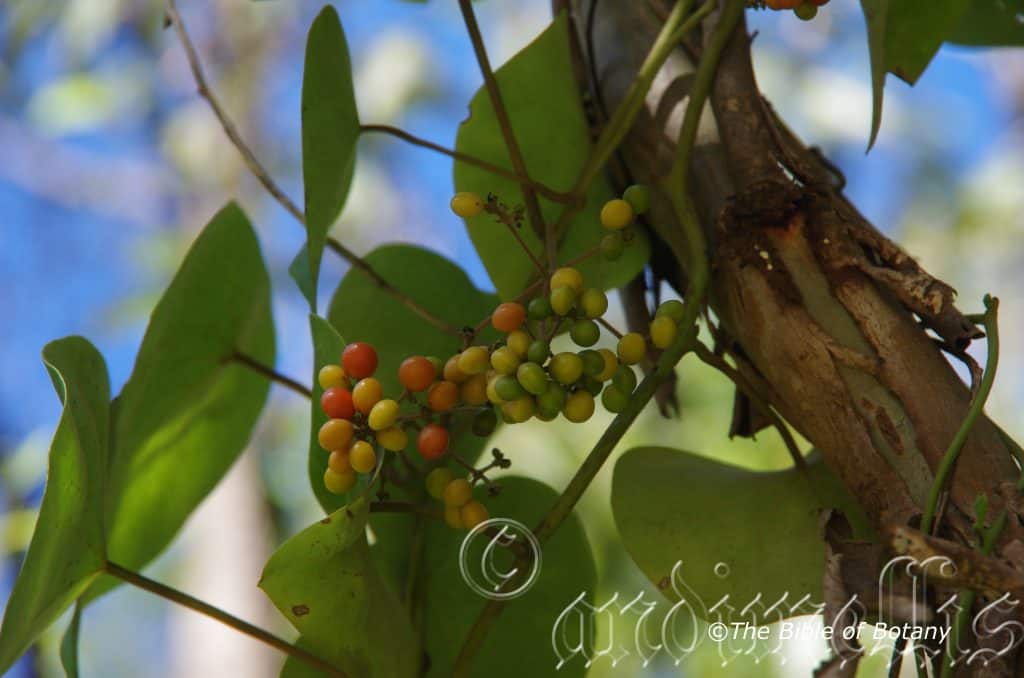
Tucabia NSW
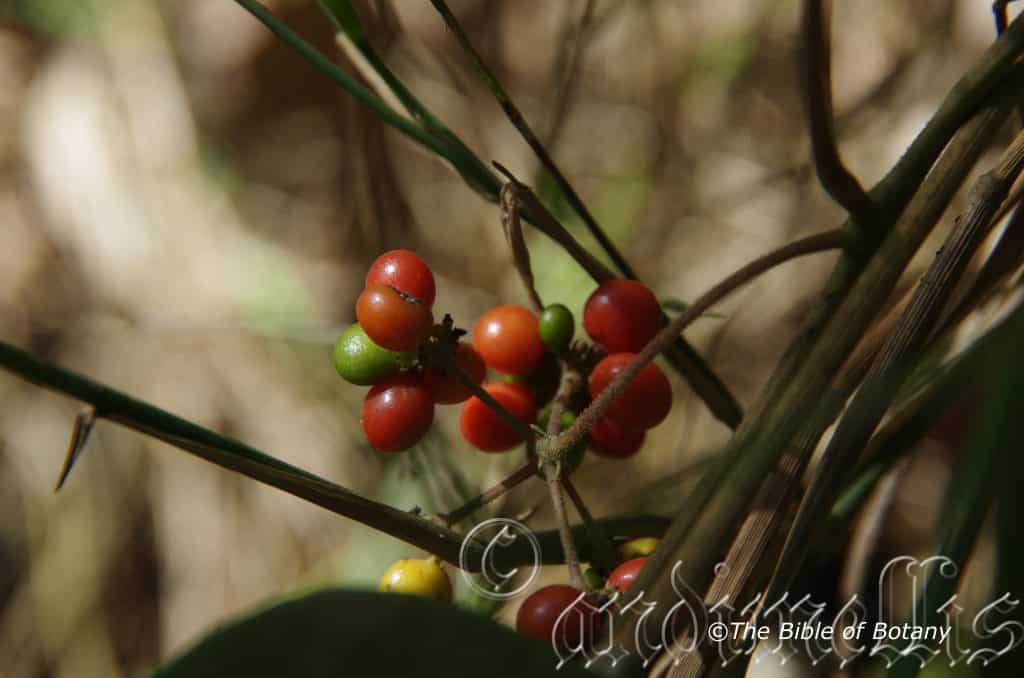
Tucabia NSW
Stephania japonica
Classification:
Unranked: Eudicots
Order: Ranunculales
Family: Menispermaceae
Genus: Is named in honour of Christian Fredrich Stephan; 1757-1814, who was a German botanist who kept a herbarium on Russian plants mainly from Crimea and Siberia.
Specie: From Japanese, which is Latinized for Japan. It refers to plants, which were first discovered in Japan.
Variety: Stephania japonica var. discolor. From Japanese, which is Latinized for Japan. It refers to plants, which were first discovered in Japan.
Variety: Stephania japonica var. japonica. From Japanese, which is Latinized for Japan. It refers to plants, which were first discovered in Japan.
Variety: Stephania japonica var. timoriensis. From Japan, which is Latinized for Japan or Japanese. It refers to plants, which were first discovered in Japan.
Common Name: Snake Vine or Tape Vine.
Distribution:
Stephania japonica var. discolor is found south from the Starke National Park north of Cooktown to Eden in southern coastal New South Wales. It is mainly found on the Western Slopes close to the Range, on and east of the Great Dividing Range to the coast.
Stephania japonica var. japonica is found east from the Ord River in far north eastern Western Australia, along the far northern portion of the Northern Territory and south from the tip of Cape York Peninsular to the Richmond River in far north eastern New South Wales. It is mainly found on and east of the Great Dividing Range to the coast.
Stephania japonica var. timoriensis is found east from the Ord River in far north eastern Western Australia, along the far northern portion of the Northern Territory and south from the tip of Cape York Peninsular to Port Stephens eastern New South Wales. It is mainly found on and east of the Great Dividing Range to the coast.
https://avh.ala.org.au/occurrences/search?taxa=Stephania+japonica#tab_mapView
Habitat Aspect Climate:
Stephania japonica prefers full shade to part sun. It grows on the back dunes, in littoral rainforests, warm sub-tropical rainforests or cool tropical rainforests usually at lower altitudes. The altitude ranges from 1 meter ASL to 1100 meters ASL.
The temperatures range from minus 4 degrees in August to 39 degrees in January.
The rainfalls range from lows of 850mm to 3000mm average per annum.
Soil Requirements:
Stephania japonica prefers to grow on better quality sandy loams to medium clays. The soils are usually derived from decomposed sandstones, granites, brown basalt, black basalts, metamorphic rocks or accumulated beach sands.. The soils pH ranges from 5pH to 7.5pH. It does not tolerate waterlogged soils. Non saline soils to moderately saline soils are tolerated.
Height & Spread:
Wild Plants: 2.5m to 3.5m by 2m to 3m.
Characteristics:
Stephania japonica grows as a small wiry creeper with deep sea-green, glabrous to densely covered stems with white to fawn pannate hairs. The stems are deep sea-green and only becoming glossy green near the apex where the newer leaf growth occurs. The plants have tuberous roots.
The alternate, peltate ovate, orbicular or deltoid leaves of Stephania japonica var. japonica measure 60mm to 140mm in length by 50mm to 120mm in width. The petioles measure 40mm to 85mm in length. The bases are broad rounded to truncate while the apex is broadly obtuse. The discolourous laminas are deep sea-green, semi glossy and glabrous on the upper lamina while the lower lamina is paler and dull. The leaf margins are entire, flat or very slightly recurve from the petiole. There are 7 to 10 main veins which radiate out from the petiole. The veins are faintly prominent on the lower laminas and faintly visible on the upper laminas.
The alternate, peltate ovate, orbicular or deltoid leaves of Stephania japonica var. discolor measure 50mm to 120mm in length by 30mm to 80mm in width. The petioles measure 30mm to 120mm in length. The bases are broad rounded to rounded-cordate while the apex is broadly obtuse to acuminate-obtuse. The discolourous laminas are deep sea-green to deep grass green, glossy to glabrous on the upper lamina while the lower lamina is paler, dull and is glabrous to moderately covered in fine white pannate hairs. The leaf margins are entire, flat or very slightly recurve from the petiole. There are 7 to 12 main veins which radiate out from the petiole. The prominent radiating veins are faintly visible on the lower laminas and faintly visible on the upper laminas.
The alternate, peltate leaves of Stephania japonica var. timoriensis are broadly deltoid and very slightly palmate. They measure 40mm to 110mm in length by 40mm to 110mm in width with the lobes measuring 1mm to 3mm in length. The base is broadly rounded to truncate or slightly emarginated while the apex is broadly acute to broadly acuminate. The concolourous laminas are deep sea-green, semi glossy and glabrous. The leaf margins are entire, flat or very slightly recurve from the petiole. There are 5 to 9 main veins which radiate out from the petiole. The veins are faintly prominent on the lower laminas and faintly visible on the upper laminas. The petioles measure 30mm to 80mm in length.
Inflorescences of Stephania japonica var. japonica are dioecious and are born compound umbels which contain 7 or 8 heads from the leaf axils.
The male inflorescences consist of head contains 15 to 17 individual flowers. The inflorescences measure 25mm 90mm in length. The flowers measure 2.5mm to 3 mm in diameter. The sepals are in 2 whorls with 4 sepals in each whorl. The narrow oblong sepals measure 1.5mm in length while the broad sepals measure 1 mm in length. The stamens are fused to form a peltate structure. The pollen is white.
The female inflorescence measure 100mm to 110mm in length. The flowers are borne in umbels which in turn are arranged in smaller umbels. The flowers measure 1mm to 1.2mm in length. The sepals are narrow elliptic and covered in off white hirsute hairs externally and are glabrous internally. The sepals measure 0.75mm to 1mm in length. The petals are broad obovate to orbicular and measure 0.75mm to 1mm in length. The ovary measures 1mm to 1.25mm in length. The stigmas are bilobed or trilobed. The flowers appear from late August to early April.
Inflorescences of Stephania japonica var. discolor are dioecious and are born compound umbels which contain 7 or 8 heads from the leaf axils.
The male inflorescences consist of head contains 15 to 17 flowers. The 8 sepals are spathulate and measure 1mm in length. The 4 petals are obtriangular and measure 0.6mm to 0.7mm in length. The anthers are fused together to form a stalked disk like structure in the centre of the flower. The anther’s disk measures 1mm to 1.2mm in length by 2.5mm in diameter. The pedicel measures 1.5mm to 2mm in length. The anthers dehisce through a single slit around the margin of the disk.
The female flowers inflorescence consists of 6 to 10 individual flowers in a head. The sepals measure 1mm to 1.5mm in length by 0.5mm to 1mm in width. The petals measure 0.8mm to 1mm in length by 0.6mm to 0.8mm in width. The stigmas are trilobed. The flowers appear from late December to early February or early March in favourable seasons.
Inflorescences ofStephania japonica var. timoriensis are dioecious and are born compound umbels which contain 7 or 8 heads from the leaf axils.
The male inflorescences consist of head contains 15 to 17 individual flowers. The inflorescences measure 25mm 90mm in length. The flowers measure 2.5mm to 3 mm in diameter. The sepals are in 2 whorls with 4 sepals in each whorl. The narrow oblong sepals measure 1.5mm in length while the broad sepals measure 1 mm in length. The stamens are fused to form a peltate structure. The pollen is white.
The female inflorescences are panicles of umbels or heads. The individual flowers measure 0.8mm to 1mm in diameter. The 5 to 8 sepals are covered in long, white pilose hairs externally and are glabrous internally. The 2 to 4 petals are much shorter than the sepals. The ovary measures 1mm to 1.2mm in length. The 3 stigmas are sessile. There is 1 ovary in each ovule.
Stephania japonica var. japonica fruits are laterally compressed, globose drupes. The drupes are glabrous and measure 7mm to 8mm in length by 6mm to 7mm in diameter. The green capsules turn scarlet-red when ripe. The styles are persistent on the ripe fruit. The single brown seeds are laterally compressed and rugose. They measure 5mm to 6mm in length by 4mm to 5mm in diameter.
Stephania japonica var. discolor fruits are spherical drupes. The drupes are glabrous and measure 5mm to 7mm in length by 5mm to 7mm in diameter. The green capsules turn scarlet-red when ripe. The styles are persistent on the ripe fruit. The single brown seeds are spherical and irregularly pitted. They measure 4.5mm to 5mm in diameter.
Stephania japonica var. timoriensis fruits are laterally compressed, globose drupes. The large drupes are glabrous and measure 6mm to 8mm in length by 6mm to 7mm in diameter. The green capsules turn scarlet-red when ripe. The styles are persistent on the ripe fruit. The single brown seeds are ovoidal and are spiny or rugose. They measure 5mm to 6mm in length by 4mm to 5mm in diameter.
Wildlife:
Stephania japonica support native bees when in flower.
Cultivation:
Stephania japonica is a beautiful evergreen creeper for pergolas, fences or can be grown in association with other rainforest specie as a ground cover. It is ideal at the edge of a rain forest or deep in the center of the rainforest. In cultivation they will grow from 2.5 meters to 3.5 meters in height by 2 meters to 3 meters in width when grown in the open on a trellis or fence or about 2 meters in diameter when grown in a forest situation as a ground cover.
They grow exceptionally well on light or heavy soils where deep leaf litter keeps the soil cool and moisture at an even level. If these requirements are met they can cope with temperatures as low as minus 5 degrees and up to 36 degrees. It is moderately drought resistant.
Add to the above, if it is given an adequate supply of water and a little native fertilizer on a regular basis the plants respond with good flowering and fruit over a long period.
It is most suitable for use around semi shaded swimming pools, courtyards, besides pathways, shady rockeries, along sandy clay banks or along drive ways or adjacent to natural bush gardens. Mass plantings of 5 or more plants even in small areas; really do the plants justification especially when it is in fruit. Medium fish or frog ponds will benefit from Stephania japonica.
If it is placed around a pool, courtyards or other confined spaces then plant them in small groups or scatter plant them for a more informal natural look with plants that have vertical growth habits. This way the contrast with the walls and other structures remain strong and powerful yet blend together. Lomandra spicta, Lomandra longifolia or Lomandra confertus are great choices. Where height is required with a splash of colour try using Anigozanthos flavida where there is a great variety in colour and height to select from.
Using rocks and small boulders can make the pool or any water feature appear like an oasis. If companion plants are sought then the choice of plants to use either side is limited only by size of the area to be landscaped and the size of the other plants as they should be no more than 1.5m in height to emphasize the Stephania japonica.
Propagation:
Seeds: The seeds of Stephania japonica can be removed easily from the fruits.
Sow fresh seeds directly into a seed raising mix. Cover them to a depth of about 4mm to 8mm. Keep the seeds moist not wet. Place the trays in a cool shaded area with 50mm shade cloth in the bush house. When the seedlings are 20mm to 25mm tall, prick them out and plant them into 50mm native tubes using a good organic mix.
As the seedlings roots reach the bottom of the tubes plant them out into their permanent position. Do not delay.
Fertilize using Seaweed, fish emulsion or organic chicken pellets soaked in water and apply the liquid on an alternate basis. Fertilize every 2 months until the plants are well established then on an annual basis in September or March to maintain health, vitality and better flowering.
Further Comments from Readers:
“Hi reader, it seems you use The Bible of Botany a lot. That’s great as we have great pleasure in bringing it to you! It’s a little awkward for us to ask, but our first aim is to purchase land approximately 1,600 hectares to link several parcels of N.P. into one at The Pinnacles NSW Australia, but we need your help. We’re not salespeople. We’re amateur botanists who have dedicated over 30 years to saving the environment in a practical way. We depend on donations to reach our goal. If you donate just $5, the price of your coffee this Sunday, We can help to keep the planet alive in a real way and continue to bring you regular updates and features on Australian plants all in one Botanical Bible. Any support is greatly appreciated. Thank you.”
In the spirit of reconciliation we acknowledge the Bundjalung, Gumbaynggirr and Yaegl and all aboriginal nations throughout Australia and their connections to land, sea and community. We pay our respect to their Elders past, present and future for the pleasures we have gained.
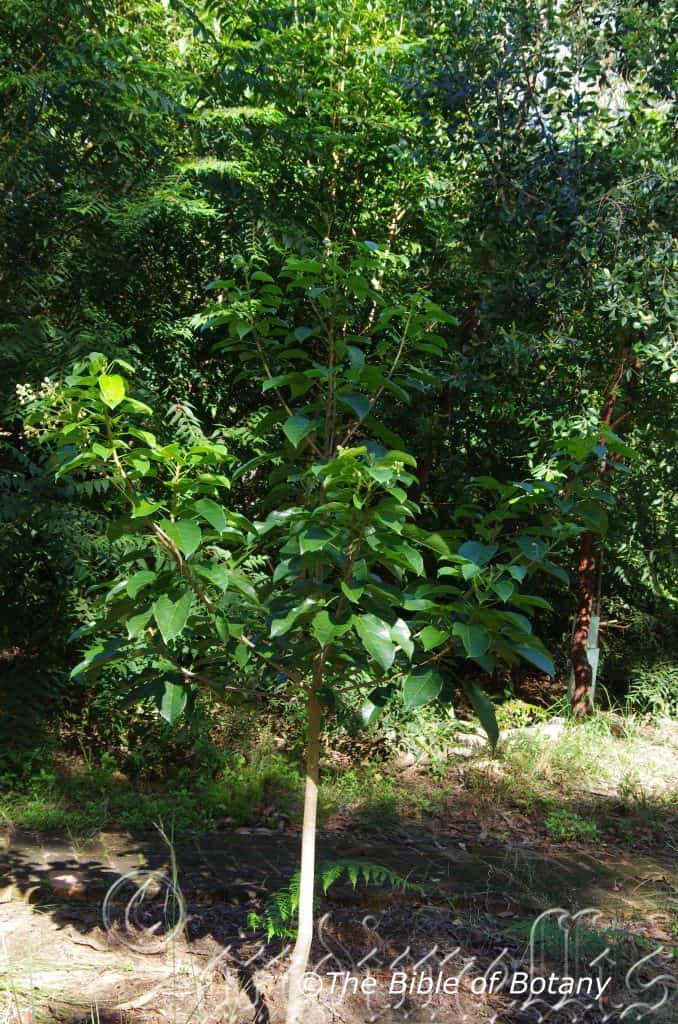
Author’s Garden The Pinnacles NSW
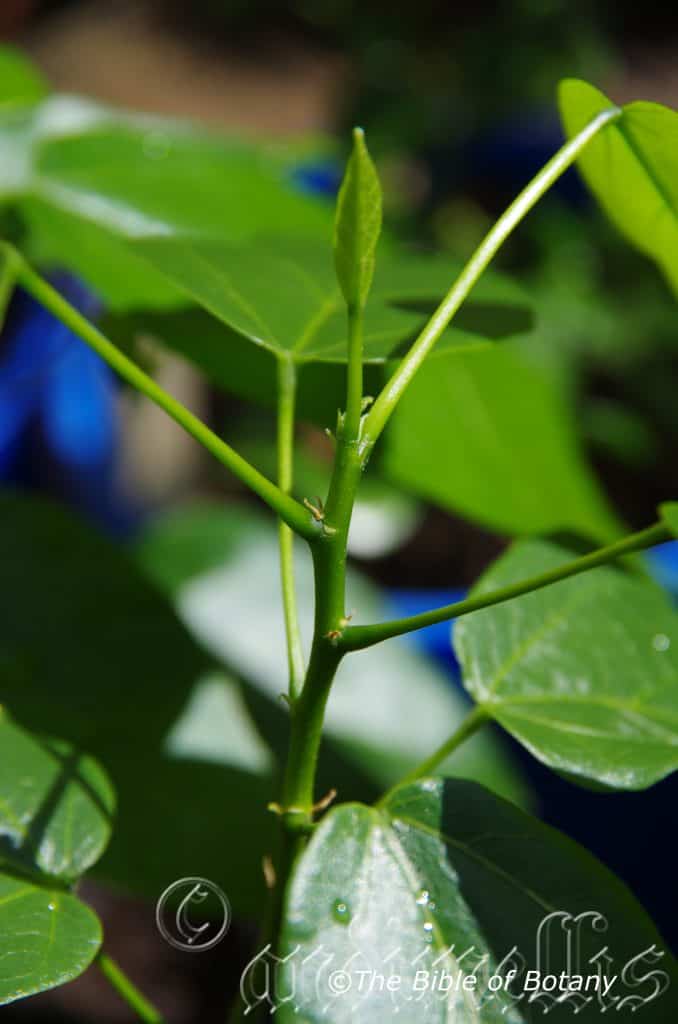
Author’s Garden The Pinnacles NSW

Author’s Garden The Pinnacles NSW
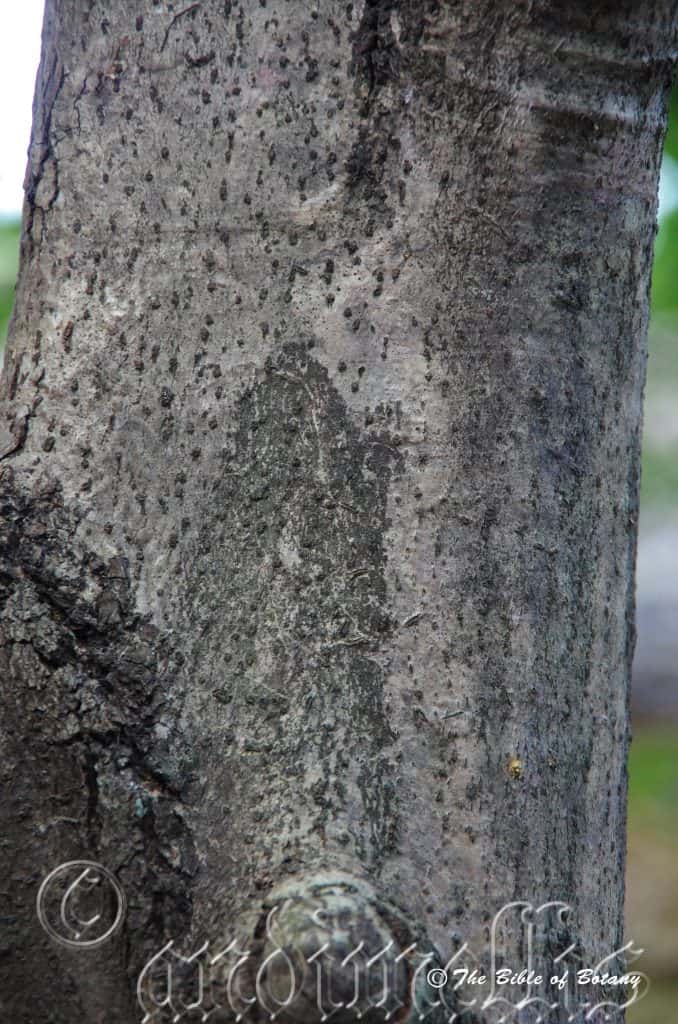
Mount Cootha Botanical Gardens Qld.
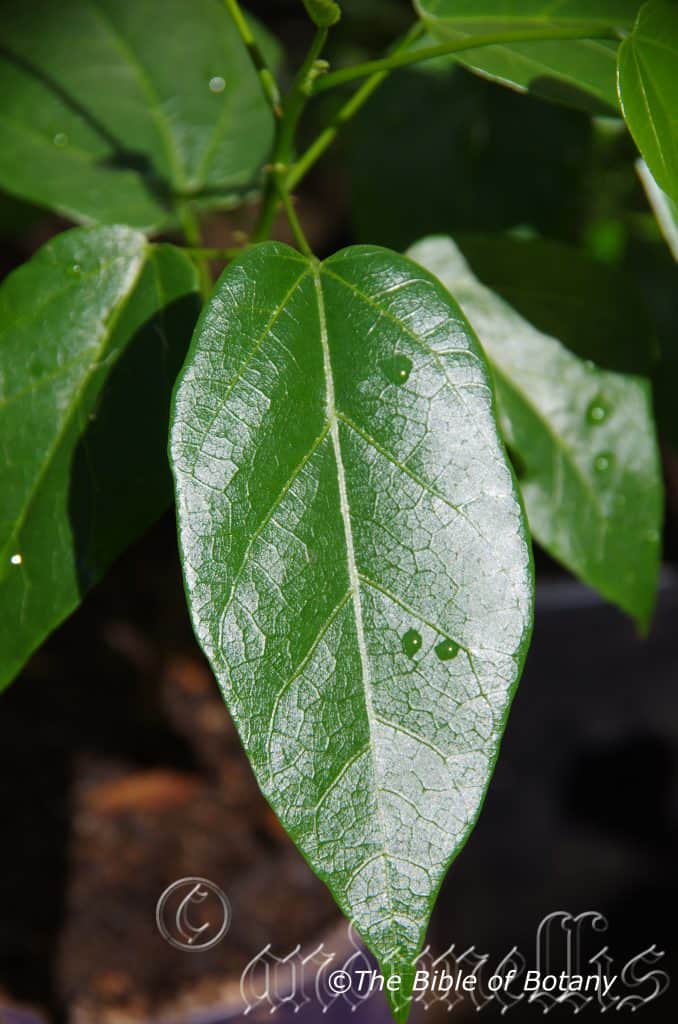
Author’s Garden The Pinnacles NSW

Author’s Garden The Pinnacles NSW
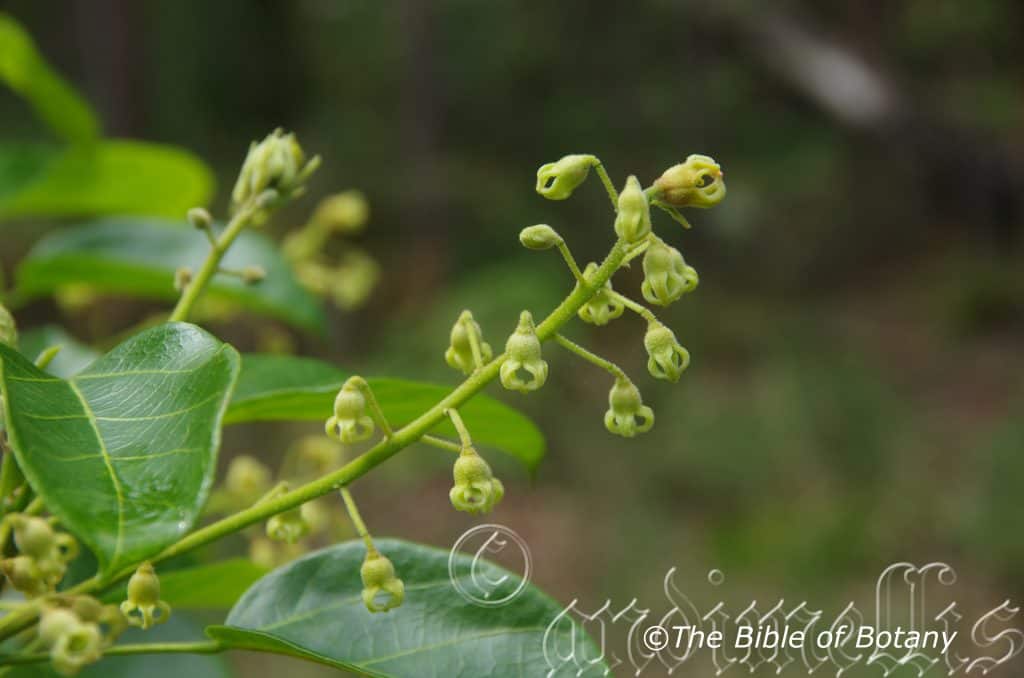
Author’s Garden The Pinnacles NSW

Author’s Garden The Pinnacles NSW

Author’s Garden The Pinnacles NSW
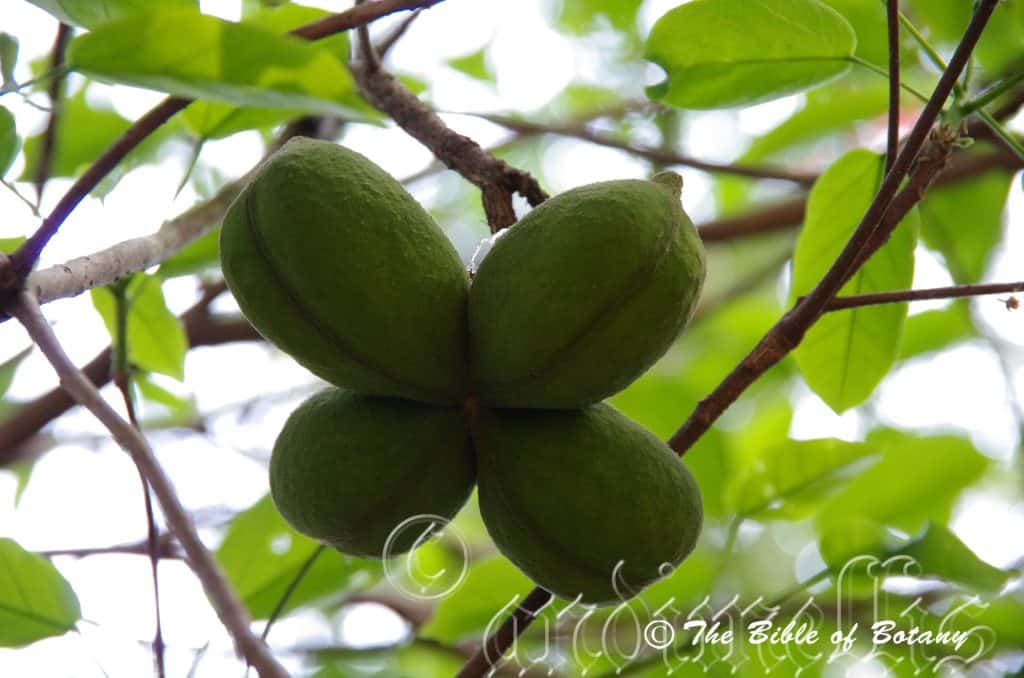
Mount Cootha Botanical Gardens Qld.
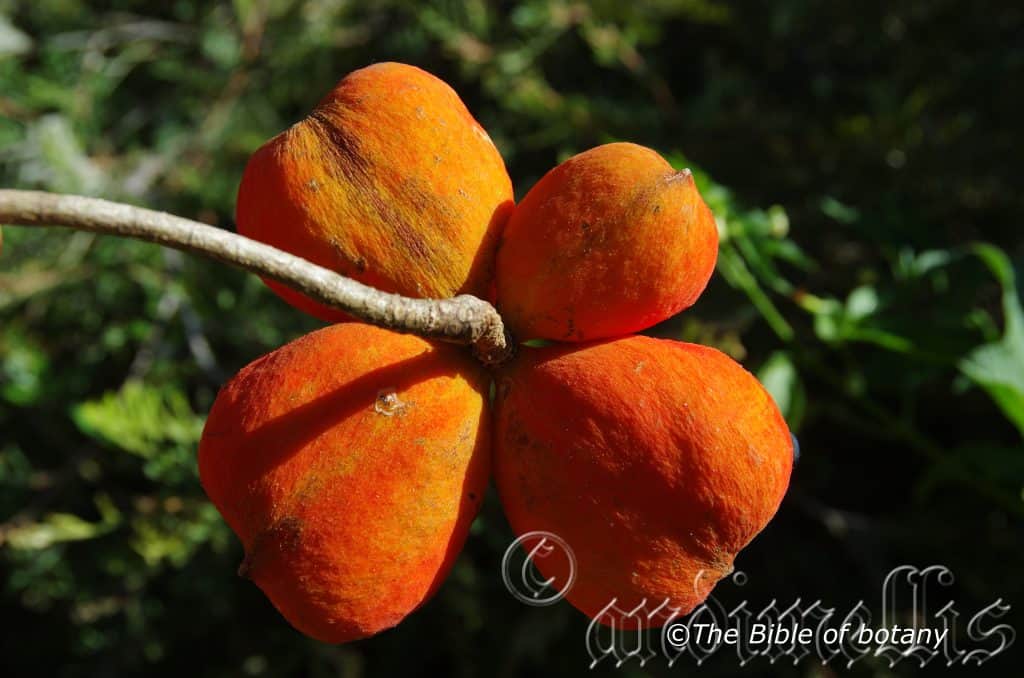
Nana Glen NSW
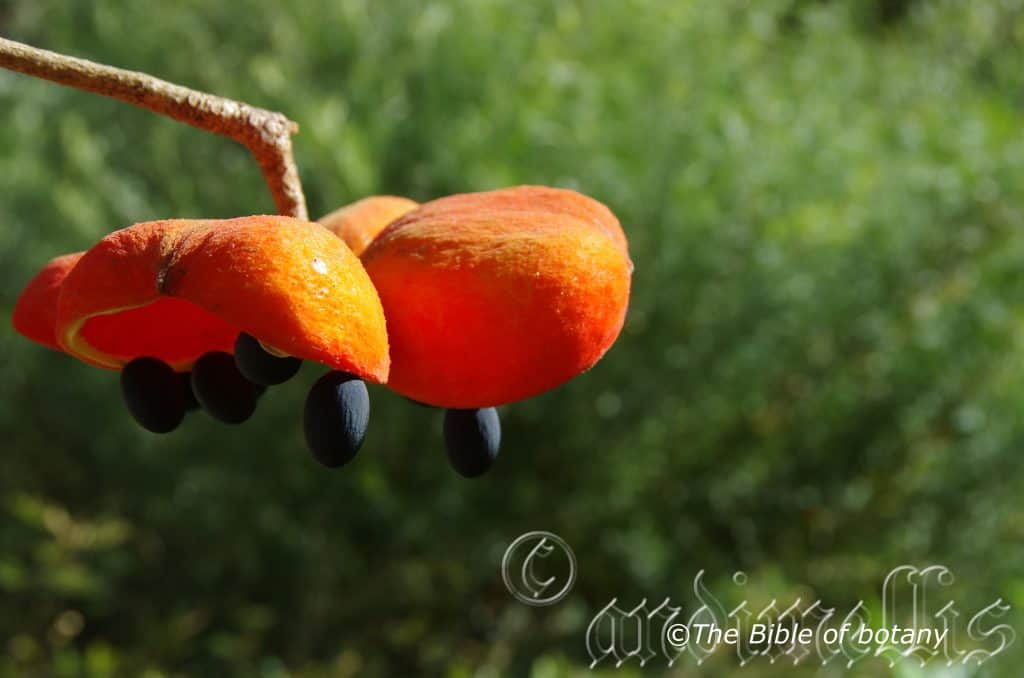
Nana Glen NSW
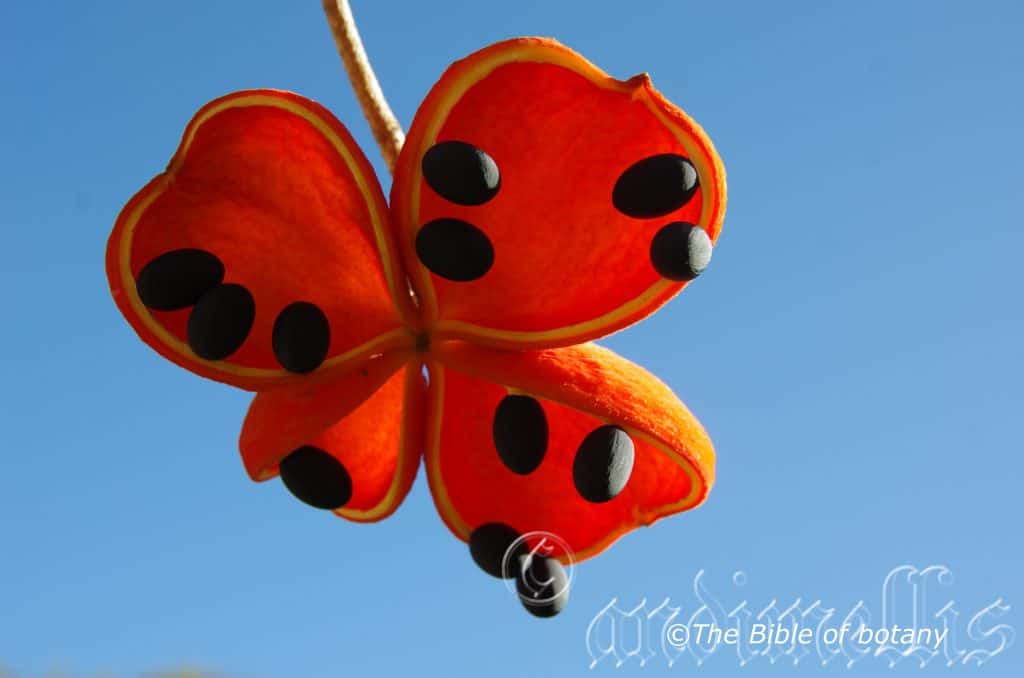
Nana Glen NSW
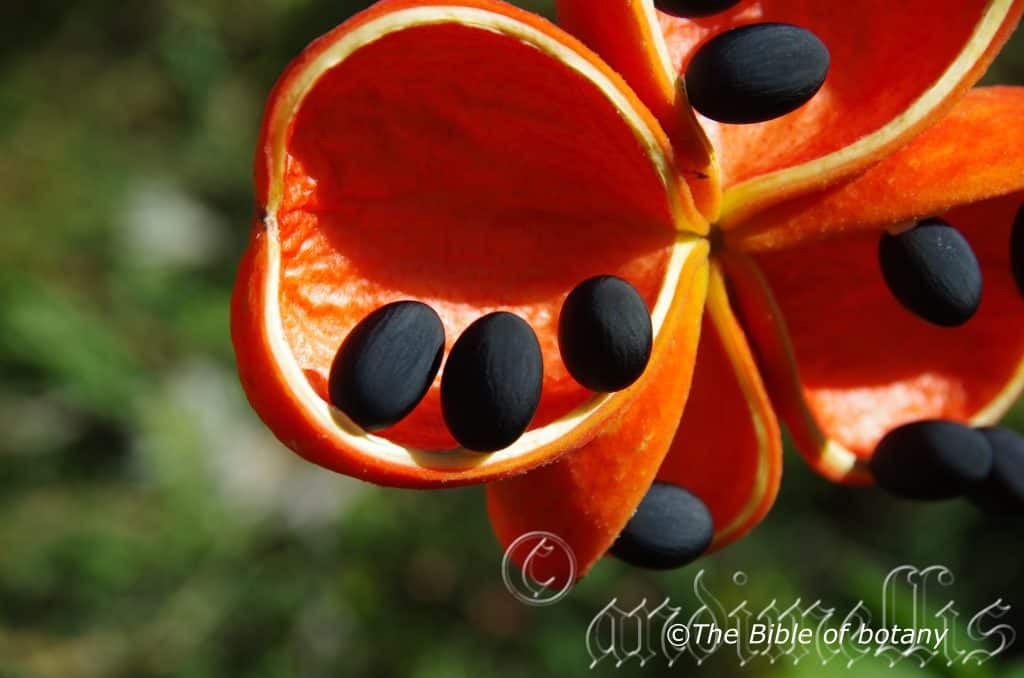
Nana Glen NSW
Sterculia quadrifida
Classification:
Unranked: Eudicots
Unranked: Rosids
Order: Malvales
Family: Malvaceae
Subfamily: Sterculiodeae
Genus: From Stercus, which is Latin for aging faeces or the Roman deity which discovered the benefits of manuring. It refers to plants, which yield a fetid odour from the flowers in some of the overseas species.
Specie: From Qu?d which is Latin for four and Findere which is Latin for to divide, split or cut. It refers to structures or organs which split into four.
Sub specie:
Common Name: Peanut Tree, Kuman, Red Fruited Kurrajong.
The following are some of the aboriginal dialects Balkpalk Yolngu people, Dundil Larrakia people or Malikini Tiwi Island people.
Distribution:
Sterculia quadrifida is found east from inlets along the Kimberley coast to in north western, Western Australia Groote Eyelandt in eastern Northern Territory.
In the east it is found south from the tip of Cape York Peninsular to Broken Head in north eastern coastal New South Wales. It is found on and east of the Great Dividing Range.
https://avh.ala.org.au/occurrences/search?taxa=Sterculia+quadrifida#tab_mapView
Habitat Aspect Climate:
Sterculia quadrifida prefers part shade to full sun. It grows in well-developed littoral, riverine rainforests monsoonal forests or vine thickets along the coast. In the west it is common in riparian zones along coastal inlets, ridge tops facing the coast and sandstone boulder country. The altitude ranges from 5 meters ASL to 500 meters ASL.
Temperatures range from 1 degree in August to 40 degrees in January.
The rainfalls range from lows of 850mm to 3200mm average per annum.
Soil Requirements:
Sterculia quadrifida prefers better quality sandy loams to gritty medium clays. The soils are usually derived from decomposed brown basalt, black basalts or metamorphic rocks. The soils pH ranges from 5pH to 6.5pH. It does not tolerate water logged soils however short periods of inundations in riparian zones or rising water tables may occur where plants are growing close to sandy swamps behind the frontal dunes. Non saline soils to moderately saline soils are tolerated.
Height & Spread:
Wild Plants: 12m to 20m by 6m to 9m.
Characteristics:
Sterculia quadrifida grows as a medium broad spreading tree with a straight, pale grey to mid grey, longitudinally fissured bark. The bark is hard and covered in lichens and mosses. The branches are pale grey to fawn and only becoming pale green near the apex where the newer leaf growth occurs. The branchlets are glabrous.
The alternate, crowded, ovate to oblong leaves of Sterculia quadrifida are in whirls near the end of the branches and measure 55mm to 160mm in length by 30mm to 80mm in width. The bases are truncate to shallowly cordate while the apex is broadly acuminate with an obtuse tip. The discolourous laminas are grass-green to deep grass-green, dull to semi glossy and glabrous on the upper lamina while the lower lamina is slightly paler dull and sparsely covered in minute translucent stellate hairs. The leaf margins are entire, recurve slightly from the mid vein to the margins and are undulating. The margins on juvenile trees are often shallowly lobed. The mid vein and lateral veins are prominent on the lower laminas and are distinctly visible from the upper laminas. The petiole measures 20mm to 70mm in length. The trees are deciduous at the end of the dry season in late July through to early September.
Inflorescences of Sterculia quadrifida are monoecious and are born on multiple racemes from the upper leaf axils. The grass-green peduncles, racemes and pedicels are sparsely to densely covered in silvery-white or burgundy-red stellate hairs. The peduncles measure 6mm to 25mm in length while the rachises measure 16mm to 35mm in length and the pedicels measure 5mm to 9mm in length. The pale green, pale silvery-green or pale yellow-ochre perianth tubes and 4 lobes are densely covered in silvery-white or red to burgundy-red stellate hairs. The campanulate to urceolate-campanulate perianth tube measures 3mm to 5mm in length by 4mm to 6mm in diameter while the elliptical lobes are spreading and strongly recurve, cohering at the apex and measure 2.5mm to 4mm in length.
The 12 to 17 anthers in the male flowers are deep yellow-orange and crowded into a mass globular head at the base of the perianth.
The white style and stigma are glabrous while the ovary is green. The flowers appear from late October to early January.
The fruits of Sterculia quadrifida are oblong follicles. The large follicles are glabrous and measure 50mm to 80mm in length by 32mm to 54mm in diameter. The green capsules turn deep orange-red to carmine-red externally and internally with a white band between the outer and inner surfaces when ripe. The lobes are not persistent on the ripe fruit. The 3 to 10 dull black seeds are glabrous and variable in shape from oblong, almost spherical to ovoidal. There is a short white funicle at the apex. The seeds measure 9mm to 15mm in length by 8mm to 12mm in diameter. The fruit ripen from June through to August.
Wildlife:
Sterculia quadrifida support native bees like Tetragonula carbonaria and the Blue banded bee Amegilla cingulata along the coast.
The seeds were eaten by aborigines and comprised a major part of their diet at the end of winter. The seeds can be treated very similar to peanuts and have a similar taste, without the high oil content.
Cultivation:
Sterculia quadrifida is a magnificent small tree that should be grown in association with other rainforest specie. It is ideal at the edge of a rain forest or deep in the center of the rainforest close to the coast though I would be very tempted to grow the trees west of the Great Dividing Range where adequate moisture prevails throughout the year. In cultivation they will grow from 12 meters to 15 meters in height by 14 meters to 18 meters in diameter when grown in the open or taller and narrower if grown closer together as a rainforest tree.
They grow exceptionally well on lighter sandy soils to light medium clays where deep leaf litter keeps the soil cool and moisture at an even level. If these requirements are met they can cope with temperatures as low as minus 1 degree and up to 36 degrees. It is moderately drought resistant in their climatic zones.
Add to the above, if it is given an adequate supply of water and a little native fertilizer on a regular basis the plants should respond with good flowering and fruit over a long period.
It is ideal along long driveways and avenues or as a feature tree in a large garden bed. They also make great park trees offering rather quick growth and good shade.
The trees would make very good accent trees in front of low set commercial or industrial sheds where they will break up hard rigid architectural lines and give warmth and breadth to a building. This is especially the case where they could be grown in curves meandering towards the entry doors. For something different use them from the far corners close to the street and meander them back to near the front entry with shrubs or flowers planted between the trees and the building and the trees and the nature strip.
In front of high rise buildings they give balance with a warm friendly feeling.
Try using them in a court yard where the only other feature is a large rock, stump or formal or informal frog or fish pond. Next to such features their large leaves, small flowers and large fruits enticing yet are never overpowering. I am surprised that they have never been used in commercial entrances and foyers to break the ice and give a feeling of business as usual but somehow make the business more relaxing.
The large bright reddish-orange fruits make a spectacular display over a prolonged period and are just as showy when the fruits split and display the larges, ripe black seeds.
Propagation:
Seeds: The seeds of Sterculia quadrifida can be removed easily from the fruits.
Sow fresh seeds directly into 50mm native tubes using a good organic seed raising mix, keeping them moist not wet. Do not over water as the seeds will rot off before germination takes place. Place the trays in a cool shaded area with 50mm shade cloth in the bush house.
When the seedlings are 150 to 250mm tall, prick them out and plant them into 250mm pots or out into their permanent position. Do not allow them to become root bound as set back will occur.
Fertilize using Seaweed, fish emulsion or organic chicken pellets soaked in water and apply the liquid on an alternate basis. Fertilize every 2 months until the plants are well established then on an annual basis in September or March to maintain health, vitality and better flowering.
Further Comments from Readers:
“Hi reader, it seems you use The Bible of Botany a lot. That’s great as we have great pleasure in bringing it to you! It’s a little awkward for us to ask, but our first aim is to purchase land approximately 1,600 hectares to link several parcels of N.P. into one at The Pinnacles NSW Australia, but we need your help. We’re not salespeople. We’re amateur botanists who have dedicated over 30 years to saving the environment in a practical way. We depend on donations to reach our goal. If you donate just $5, the price of your coffee this Sunday, We can help to keep the planet alive in a real way and continue to bring you regular updates and features on Australian plants all in one Botanical Bible. Any support is greatly appreciated. Thank you.”
In the spirit of reconciliation we acknowledge the Bundjalung, Gumbaynggirr and Yaegl and all aboriginal nations throughout Australia and their connections to land, sea and community. We pay our respect to their Elders past, present and future for the pleasures we have gained.
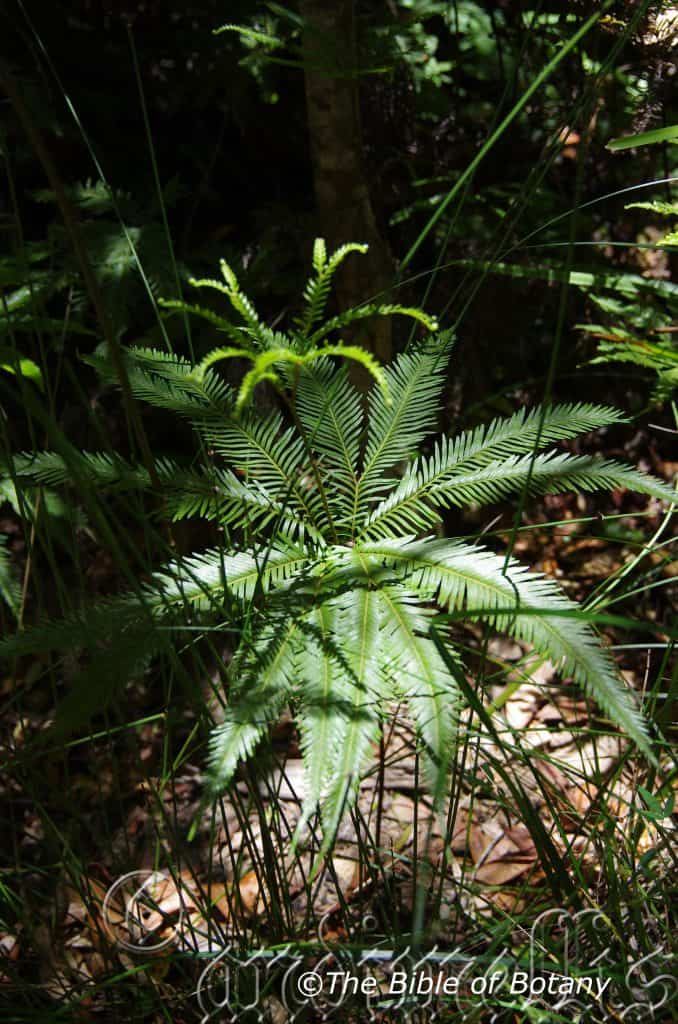
Washpool National Park NSW
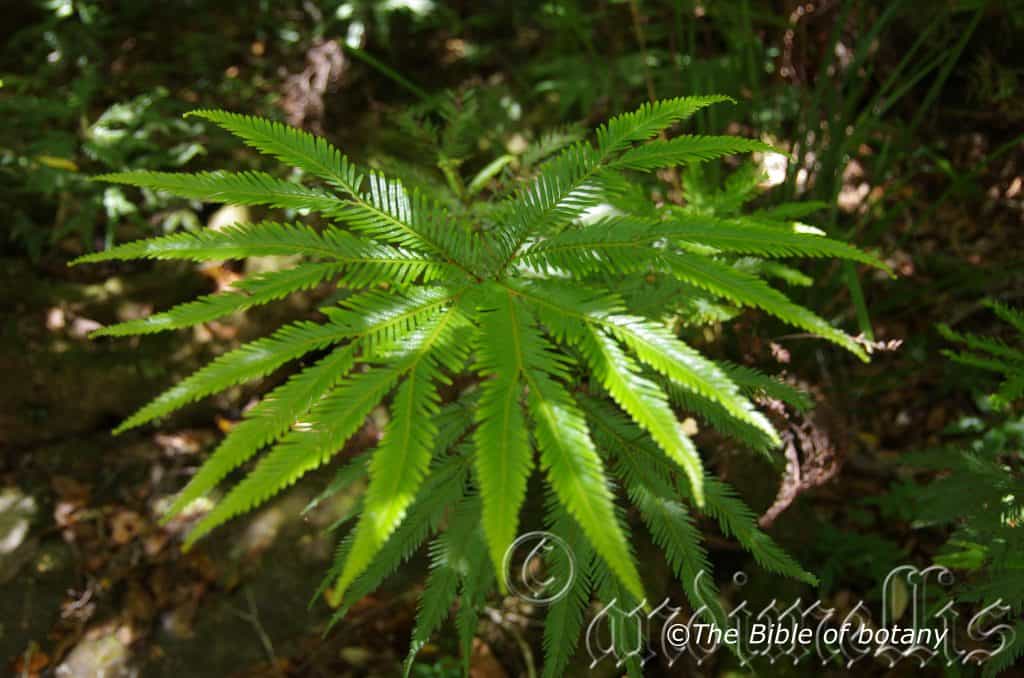
Washpool National Park NSW
Sticherus flabellatus
Classification:
Unranked: Pteridiophyta
Class: Pteridopsida
Order: Gleicheniales
Family: Gleicheniacea
Genus: From stichos, which is Ancient Greek for a row or line. It refers to the sori being placed in a single row either side of the pinnae’s midrib.
Specie: From Flabellum, which is Latin for a fan shape. It refers to leaves or branches, which have a fan shape.
Variety: Sticherus flabellatus var. compactus. From Com/Cum, which is Latin for to come together and Pactum, which is Latin for to put away or bind together. It refers to flower heads, which are rather compressed or compacted together.
Variety: Sticherus flabellatus var. flabellatus. From Flabellum, which is Latin for a fan shape. It refers to leaves or branches, which have a fan shape.
Common Name: Umbrella Fern.
Distribution:
Sticherus flabellatus var. compactus is found in several disjunct populations south from the Jardine River National Park and across to Bamaga on Cape York Peninsular to Mackay in Queensland. It is found on and east of the Great Dividing Range to the coast.
Sticherus flabellatus var. flabellatus is found south from the Jardine River National Park and across to Bamaga on Cape York Peninsular to Orbost in Victoria. It is found on and east of the Great Dividing Range to the coast.
There is an isolated population along Rindarrie Creek in east Arnhem Land in the far north east corner of the Northern Territory.
https://avh.ala.org.au/occurrences/search?taxa=Sticherus+flabellatus#tab_mapView
Habitat Aspect Climate:
Sticherus flabellatus prefers dense shade to full sun. It grows in the mountains adjacent to warm sub-tropical rainforests, cool tropical rainforests, and warm temperate rainforests, along watercourses, drainage channels and road side verges. The altitude ranges from 5 meters ASL to 800 meters ASL.
The temperatures range from minus 4 degrees in July to 37 degrees in January.
The rainfalls range from lows of 850mm to 3200mm average per annum.
Soil Requirements:
Sticherus flabellatus prefers better quality sandy loams to medium clays. The soils are usually derived from decomposed sandstones, granites, brown basalt, black basalts or metamorphic rocks. The soils pH ranges from 4.5pH to 6pH. It tolerates water logged soils with plants often grow where it is inundated during small storms in riparian zones or continual seepage keeps the soils wet for weeks or even months after rain. Non saline soils to moderately saline soils are tolerated.
Height & Spread:
Wild Plants: 0.5m to 1m by 1m to large areas of 100 to 200 square meters.
Characteristics:
Sticherus flabellatus rhizomes grows as a large fern with long, slender, creeping and sparsely covered in brown scales.
Sticherus flabellatus slender 50mm to 100mm long stipes are deep glossy brown and grass-green on the final rachises. The glabrous or sparsely scaly primary lateral stipes usually have 1 or 2 pairs of axis or at times 3 pairs of axis growing from the center point.
The fronds measure 500mm to 1000mm in height. The pinnules are at an angle of around 45 degrees to the glabrous rachis. The discolourous pinnules are glabrous, grass-green, semi glossy to glossy on the upper lamina while the lower lamina is much paler or slightly glaucous. The pinnules measure 20mm to 30mm in length by 2mm to 3.2mm in width. The margins are very finely toothed and flat while the apex is long tapering.
The fertile fronds are similar to the sterile fronds. Sticherus flabellatus’s angulated sori are irregularly spaced, midway between the mid vein and the margin from near the base for 50mm to 60mm of the lobes length of the pinnules.
Spores are small circular and yellow-brown in colour.
Confusing Species:
Sticherus flabellatus pinnules are at 40 to 50 degrees. The spore is in a single row 50 to 60mm from the margins. The pinnules near the base of axis are absent.
Sticherus lobatus are at 80 to 85 degrees. The spores are in clusters of 2 to 4, 30 to 40mm & 50 to 70mm of the distance from the margins. The pinnules are large near the bases of the axis.
Sticherus urceolatus pinnules are at 70 to 80 degrees. The spores are in clusters of 2 to 4 closer to the margin than the middle. There are scaly nodes at dichotomous forks.
Wildlife:
Sticherus flabellatus wildlife is unknown to the author.
Cultivation:
Sticherus flabellatus are excellent ferns for cultivation in wet shady areas but are difficult to establish. When the location is right they will thrive. It is ideal as a ground cover for areas where there is light shade with a little morning or afternoon sun where moisture is reliable.
They always look green and fresh giving a tropical look in a short time. It is most suitable on medium clays to heavy clay soils and are great for medium and large gardens close to the coast in warm temperate, warm sub-tropical or cool tropical gardens. As garden subjects they will colonize soils that have established rainforests, at the bottom of moist shady banks or between houses particularly on the southern side. It is cold tolerant to temperatures as low as minus 2 degrees once established though some frond burning may occur at lower temperatures to minus 4 degrees.
It is most suitable for use as a rainforest understory plant where they can break the monotony of large deep green leaves. They like plenty of leaf litter to help increase soil fertility, maintain soil moisture and to maintain a cool root zone.
Sticherus flabellatus are attractive clump-forming ferns and can be used very effectively either mass planted or as individual plants scattered throughout the garden.
Propagation:
Fern Spores: All ferns that are declared rare, vulnerable or endangered are protected by Federal and State Laws and must not be removed from the wild unless you are a land developer, forestry, mining company or main Roads department etc. This includes bulbs, roots, leaves and flowers. No part of any plant can be removed from Federal, State or Local Government land without the prior permission of the authority and this includes the spore.
Most people are put off at the thought of growing ferns from spore. Like all plants that produce their offspring from seed or spore the methods are basically the same. Remember nature has been doing this for millions of years and has been very successful. I have had excellent results growing over 200 different species of Australian ferns so don’t be afraid. Give it a go.
Step 1. Select spore from the fern fronds. Wait until the fern is just starting to release its spore. Rinse the fronds under clean running water and dry. This is to wash off any other spores from rogue ferns that may have settled onto the fronds. (There is nothing worse than having common brake or common soft bracken contaminating a prized tree fern or epiphyte.)
Step 2. Place the dry fronds in a clean brown paper bag and keep them in a cool dark place like the linen closet for about a week to ten days before you are ready to sow the spore. The exception to this rule applies to ferns, which produce green spores. These must be sown immediately that they are released. Todea Barbara is a good example of a fern, which produces green spore.
Step 3. Take a large ice cream container, a small ice cream container and a clean clear plastic bag large enough to seal the large ice cream container and three or four milk bottle tops.
Step 4. Punch or drill 6 to 10 5mm holes in the bottom of the small ice cream container.
Step 5. Wash both containers, tops and plastic bag so that they are very clean and sterile.
Step 6. Use a clean fine seed raising mi. We used 30mm fine sand, 30mm peat and 30mm perlite and 10mm vermiculite. We used crushed basalt, crusher dust and peat in a 50:50 ratio for epiphytes. Moisten the mix enough that water does not run out when the mix is squeezed between the fingers.
Step 7. Place the moisten mix (Enough to half fill the small ice cream container) in the microwave oven with a large glass of water for 7 or 8 minutes, until the water is boiling. Allow them to cool in the oven. You will need the water later so do not tip it out.
Step 8. Take the brown paper bag out of the linen closet. Shake the bag and remove the fronds. You should have a yellow, brown, black or rarely greenish brown or ochre powder or very fine, small round pin head size spore depending on the specie involved.
Step 9. Remove the mixture from the oven once it has cooled and place it in the small ice cream container and level.
Step 10. Sprinkle the spore sparsely over the mixture in the small ice cream container.
Step 11. Place the milk bottle tops in the large ice cream container with the flat surface facing down. Place the small ice cream container in the large ice cream container so that it is sitting on the milk bottle tops.
Step 12. Remove the water from the microwave and pour it into the larger ice cream container so there is 25mm to 30mm of water in the bottom.
Step 13. Place the ice cream containers in the plastic bag and seal. Step 14. Place the contents and bag in a warm shady place preferably 50mm to 70mm shade depending on the specie. Shade houses and some window sills are ideal.
Step 15. The surface should turn green within a week to two weeks. The prothallus will then develop. From the prothalus the first true fronds will appear. Wait until the ferns are 20mm to 35mm in height before you attempt to transplant them. Once they are ready open the bag up slightly and allow the air to flow around the little ferns. Every 3 to 5 days open the bag a little further so the ferns get use to their new environment. Allow them a week to two weeks to harden off before you transplant them following the removal of the plastic bag. Carefully prick them out into 50mm standard squat tubes as you would any seedling.
Do not try to transplant them as single plants as they are still a little delicate still.
Once the smaller ones again reach 50mm to 70mm you may wish to divide the stronger and hardier individual plants into smaller clumps in 100mm squat pots.
Step 16. We fertilized with seaweed, fish emulsion or organic chicken pellets soaked in water on an alternate basis until established. Fertilize every two months for one year even when in the ground.
Further Comments from Readers:
“Hi reader, it seems you use The Bible of Botany a lot. That’s great as we have great pleasure in bringing it to you! It’s a little awkward for us to ask, but our first aim is to purchase land approximately 1,600 hectares to link several parcels of N.P. into one at The Pinnacles NSW Australia, but we need your help. We’re not salespeople. We’re amateur botanists who have dedicated over 30 years to saving the environment in a practical way. We depend on donations to reach our goal. If you donate just $5, the price of your coffee this Sunday, We can help to keep the planet alive in a real way and continue to bring you regular updates and features on Australian plants all in one Botanical Bible. Any support is greatly appreciated. Thank you.”
In the spirit of reconciliation we acknowledge the Bundjalung, Gumbaynggirr and Yaegl and all aboriginal nations throughout Australia and their connections to land, sea and community. We pay our respect to their Elders past, present and future for the pleasures we have gained.
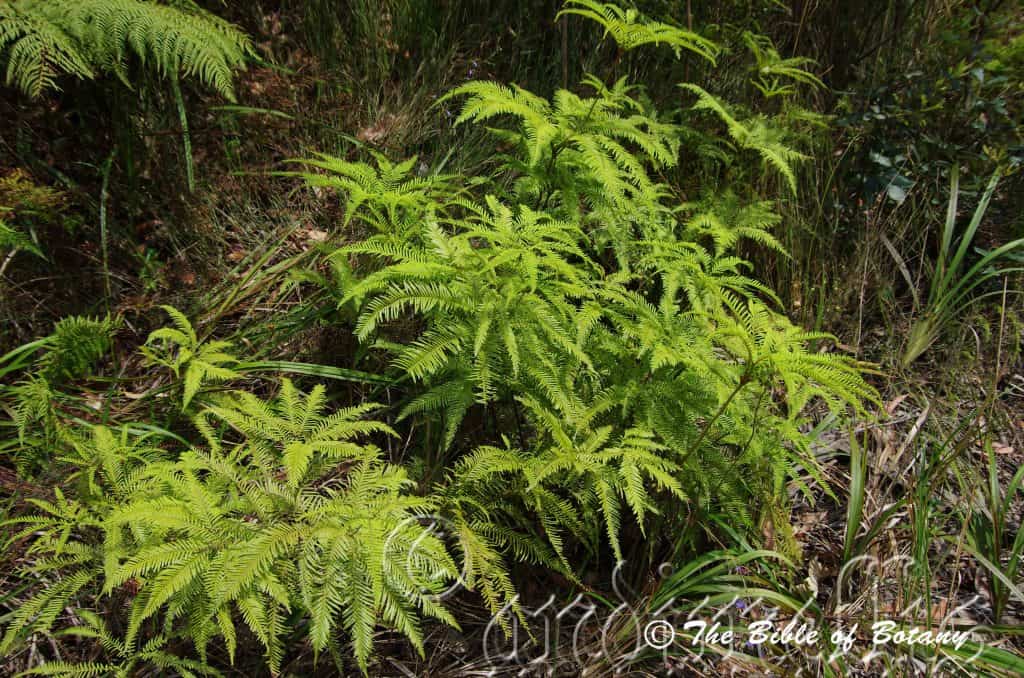
Nana Glen to Glenreagh NSW
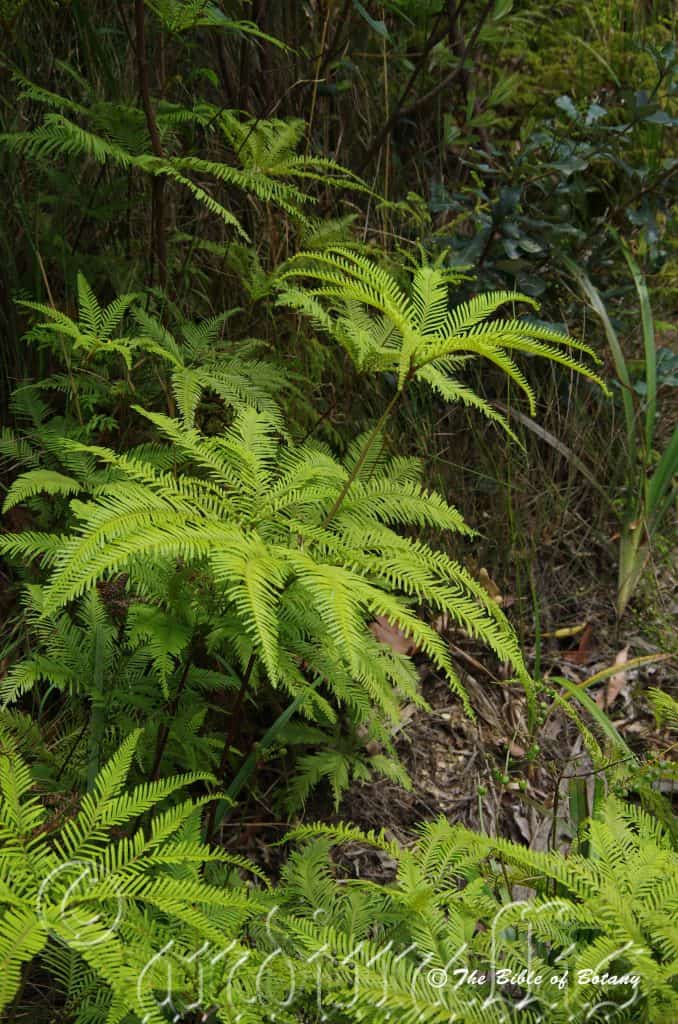
Nana Glen to Glenreagh NSW
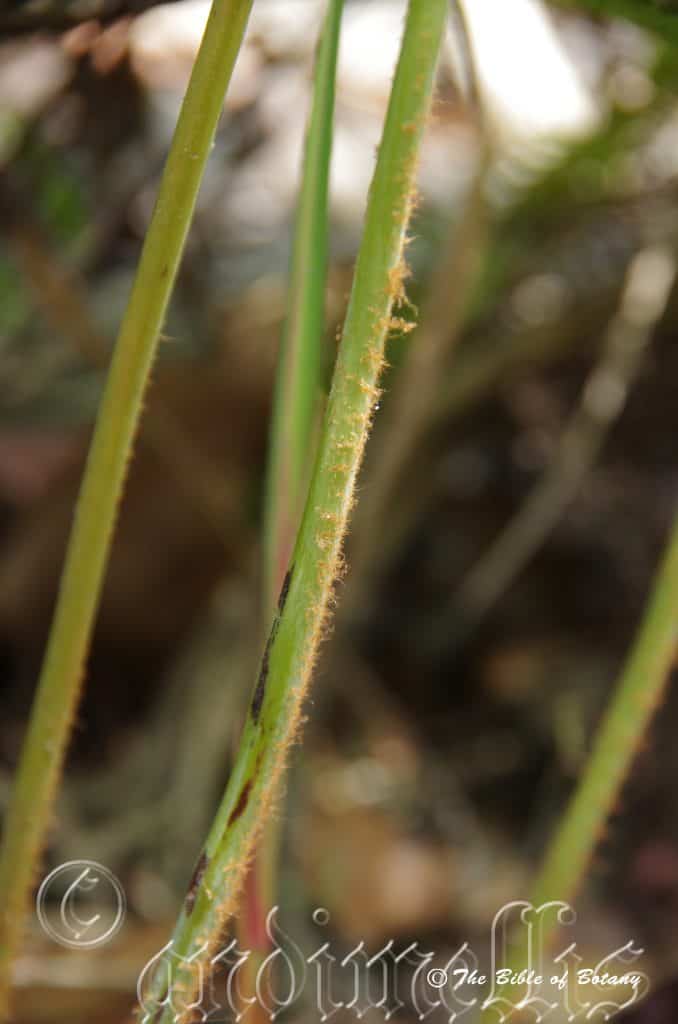
Nana Glen to Glenreagh NSW

Nana Glen to Glenreagh NSW
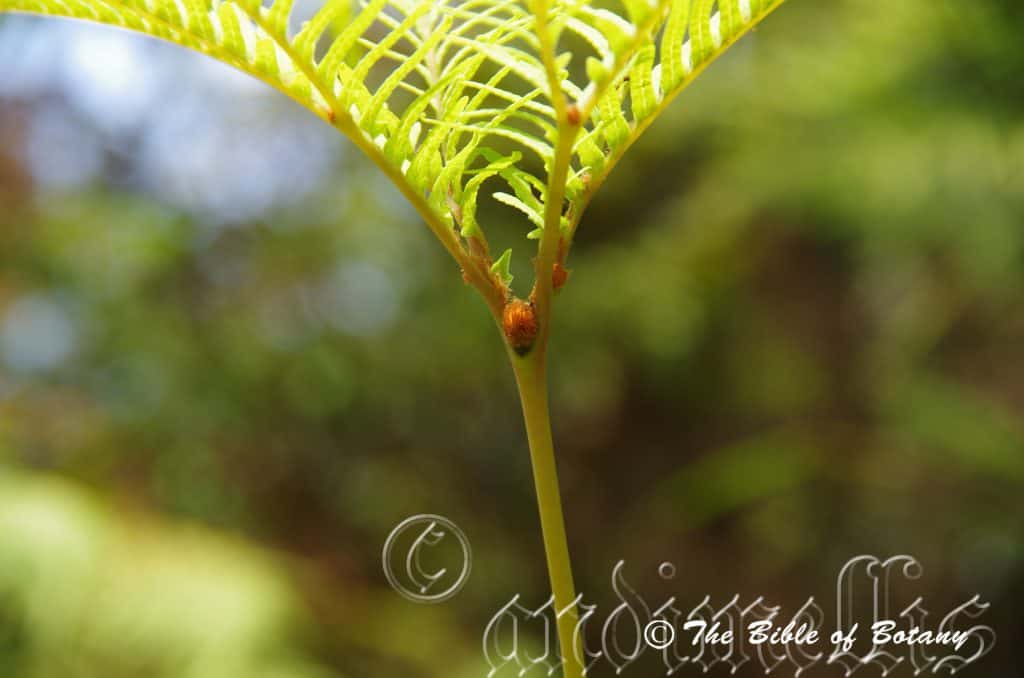
Nana Glen to Glenreagh NSW
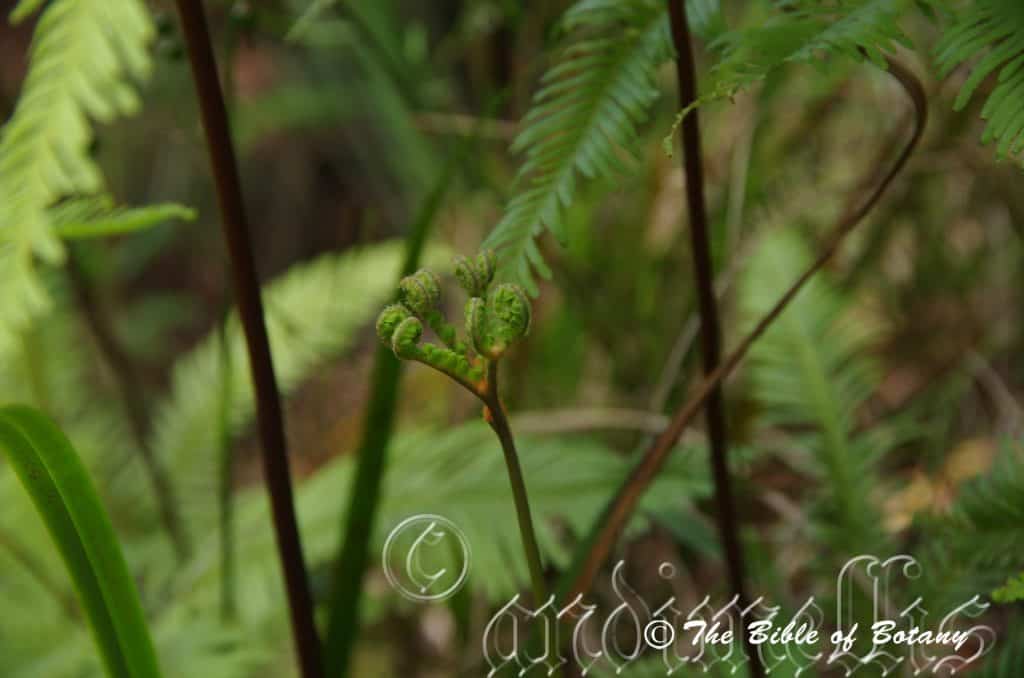
Nana Glen to Glenreagh NSW
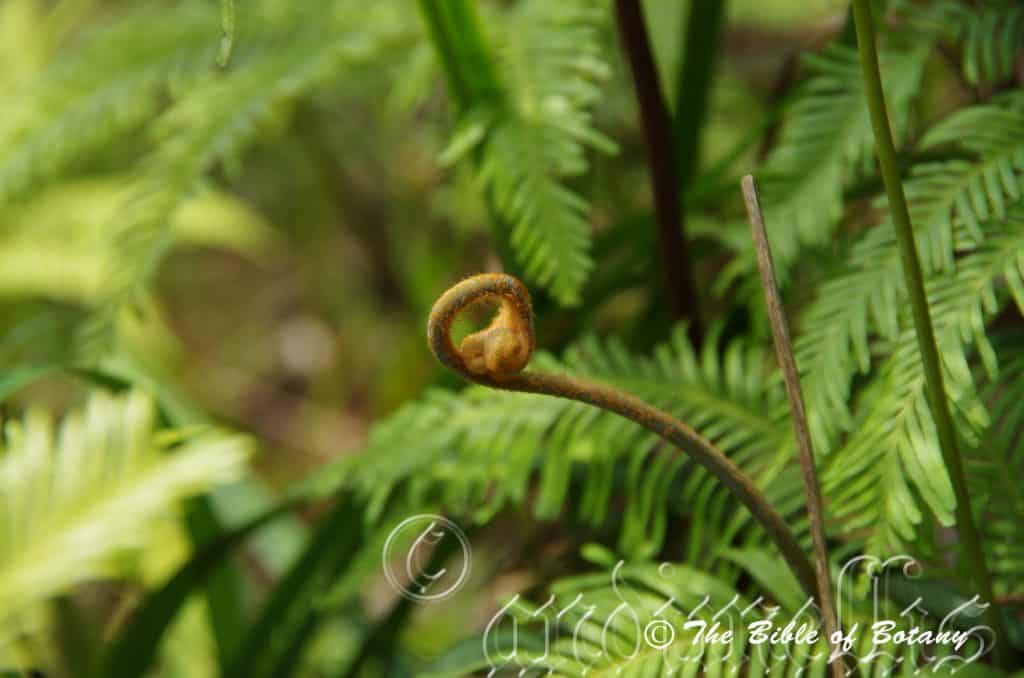
Nana Glen to Glenreagh NSW
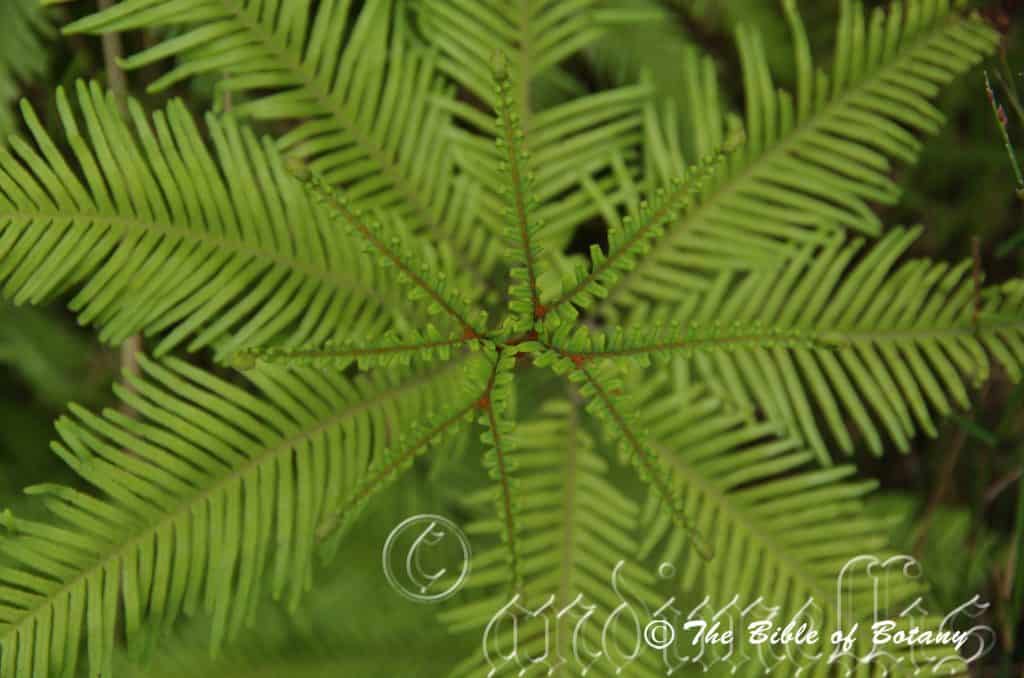
Nana Glen to Glenreagh NSW
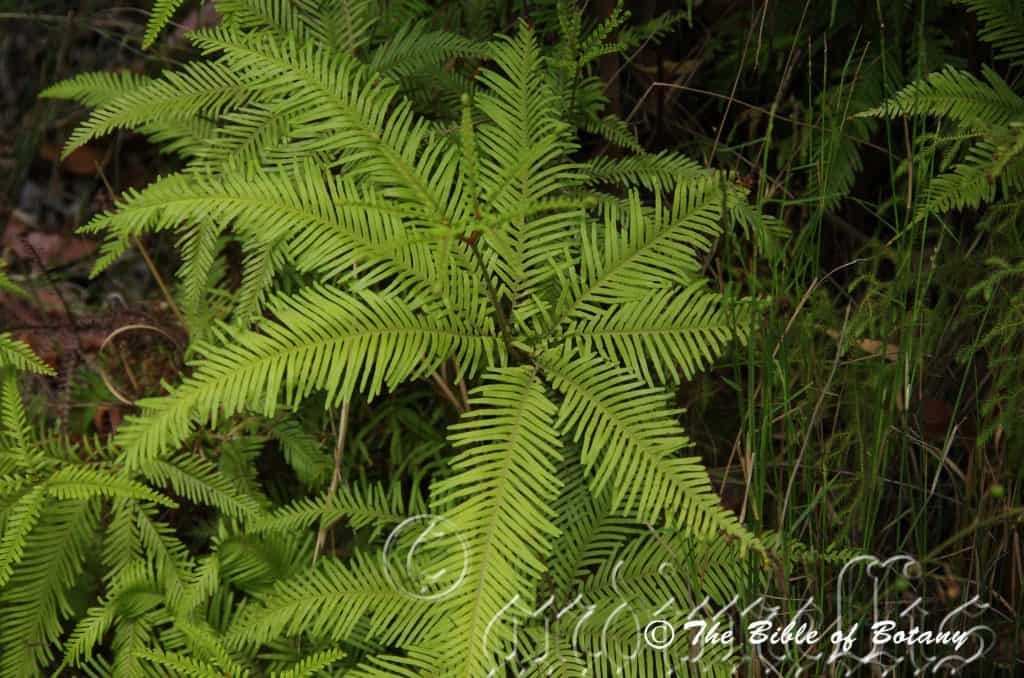
Nana Glen to Glenreagh NSW

Nana Glen to Glenreagh NSW

Nana Glen to Glenreagh NSW
Sticherus lobatus
Classification:
Unranked: Pteridiophyta
Class: Pteridopsida
Order: Gleicheniales
Family: Gleicheniacea
Genus: From stichos, which is Ancient Greek for a row or line. It refers to the sori being placed in a single row either side of the pinnae’s midrib.
Specie: From Lobos/Lob?, which are Ancient Greek for an ear lobe. It refers to lobes at the forks of the stipes, which are more prominent on this species than other species in the genus.
Sub specie:
Common Name: Shield Fern or Spreading Fan Fern.
Distribution:
Sticherus lobatus is found in several disjunct populations south from near the Conondale National Park to Wilson’s Promontory and Seaford on Mornington Peninsular with a small population in the Great Ottway National park in southern Victoria.
In Tasmania it is found south west from Devonport to Smithton then across to Marrawah and down the west coast to Strahan. On the east coast it is found bounded by Hobart, South Bruny, South west National Park and north to around Tarraleah.
https://avh.ala.org.au/occurrences/search?taxa=Sticherus+lobatus#tab_mapView
Habitat Aspect Climate:
Sticherus lobatus prefer heavy shade to almost full sun. It grows in the mountains adjacent to warm sub-tropical rainforests, cool tropical rainforests, and warm temperate rainforests, along watercourses, drainage channels and road side verges. The altitude ranges from 5 meters ASL to 950 meters ASL.
The temperatures range from minus 5 degrees in July to 37 degrees in January.
The rainfalls range from lows of 850mm to 3200mm average per annum.
Soil Requirements:
Sticherus lobatus prefer to grow on better quality sandy loams to medium clays. The soils are derived from decomposed sandstones, granites, brown basalt, black basalts or metamorphic rocks. The soils pH ranges from 6pH to 7pH. It tolerates water logged soils with plants often grow where it is inundated during small storms in riparian zones or continual seepage keeps the soils moist for weeks or even months after rain. Non saline soils to moderately saline soils are tolerated.
Height & Spread:
Wild Plants: 0.5m to 2m by 4m to large areas of 100 to 200 square meters.
Characteristics:
Sticherus lobatus rhizomes are long, thin, creeping and sparsely covered in brown fringed scales.
Sticherus lobatus slender 200mm to 1500mm long stipes are deep glossy brown and grass-green turning deep purple brown on the final rachises. The glabrous or sparsely scaly primary stipes usually have 1 to 3 pairs of axis or at times 4 pairs of axis growing from the center point.
The fronds measure 1200mm to 2000mm in height. The lateral pinnules at the base of the axis are broadly lanceolate to ovate with lobed margins and glabrous. These pinnules measure 10mm to 45mm in length by 16mm to 36mm. This is an easy way to quickly distinguish it from the other 2 native Sticherus as these pinnules are absent.
The pinnules are at an angle of around 80 to 85 degrees to the glabrous rachis. The discolourous pinnules are glabrous, grass-green, semi glossy to glossy on the upper lamina while the lower lamina is much paler or slightly glabrous. The pinnules measure 10mm to 45mm in length by 2mm to 4mm in width. The margins are very minutely crenate and flat while the apex is obtuse.
The fertile fronds are similar to the sterile fronds. Sticherus flabellatus’s orbicular sori are in groups of 2 to 4 midway between the mid vein and the margin and from near the base for 30mm to 40mm of the lobes length and again between 50mm to 70mm of the pinnules length.
Spores are small circular and yellow-brown in colour.
Confusing Species:
Sticherus lobatus are at 80 to 85 degrees. The spores are in clusters of 2 to 4, 30 to 40mm & 50 to 70mm of the distance from the margins. The pinnules are large near the bases of the axis.
Sticherus flabellatus pinnules are at 40 to 50 degrees. The spore is in a single row 50 to 60mm from the margins. The pinnules near the base of axis are absent.
Sticherus urceolatus pinnules are at 70 to 80 degrees. The spores are in clusters of 2 to 4 closer to the margin than the middle. There are scaly nodes at dichotomous forks.
Wildlife:
Sticherus lobatus wildlife is unknown to the author.
Cultivation:
Sticherus lobatus are excellent ferns for cultivation in wet shady areas but are difficult to establish. When the location is right they will thrive. It is ideal as a ground cover for areas where there is light shade with a little morning or afternoon sun where moisture is reliable.
They always look green and fresh giving a tropical look in a short time. It is most suitable on medium clays to heavy clay soils and are great for medium and large gardens close to the coast in warm temperate, warm sub-tropical or cool tropical gardens. As garden subjects they will colonize soils that have established rainforests, at the bottom of moist shady banks or between houses particularly on the southern side. It is cold tolerant to temperatures as low as minus 2 degrees once established though some frond burning may occur at lower temperatures to minus 4 degrees.
It is most suitable for use as a rainforest understory plant where they can break the monotony of large deep green leaves. They like plenty of leaf litter to help increase soil fertility, maintain soil moisture and to maintain a cool root zone.
Sticherus lobatus are attractive clump-forming ferns and can be used very affectively either mass planted or as individual plants scattered throughout the garden.
Propagation:
Fern Spores: All ferns that are declared rare, vulnerable or endangered are protected by Federal and State Laws and must not be removed from the wild unless you are a land developer, forestry, mining company or main Roads department etc. This includes bulbs, roots, leaves and flowers. No part of any plant can be removed from Federal, State or Local Government land without the prior permission of the authority and this includes the spore.
Most people are put off at the thought of growing ferns from spore. Like all plants that produce their offspring from seed or spore the methods are basically the same. Remember nature has been doing this for millions of years and has been very successful. I have had excellent results growing over 200 different species of Australian ferns so don’t be afraid. Give it a go.
Step 1. Select spore from the fern fronds. Wait until the fern is just starting to release its spore. Rinse the fronds under clean running water and dry. This is to wash off any other spores from rogue ferns that may have settled onto the fronds. (There is nothing worse than having common brake or common soft bracken contaminating a prized tree fern or epiphyte.)
Step 2. Place the dry fronds in a clean brown paper bag and keep them in a cool dark place like the linen closet for about a week to ten days before you are ready to sow the spore. The exception to this rule applies to ferns, which produce green spores. These must be sown immediately that they are released. Todea Barbara is a good example of a fern, which produces green spore.
Step 3. Take a large ice cream container, a small ice cream container and a clean clear plastic bag large enough to seal the large ice cream container and three or four milk bottle tops.
Step 4. Punch or drill 6 to 10 5mm holes in the bottom of the small ice cream container.
Step 5. Wash both containers, tops and plastic bag so that they are very clean and sterile.
Step 6. Use a clean fine seed raising mi. We used 30mm fine sand, 30mm peat and 30mm perlite and 10mm vermiculite. We used crushed basalt, crusher dust and peat in a 50:50 ratio for epiphytes. Moisten the mix enough that water does not run out when the mix is squeezed between the fingers.
Step 7. Place the moisten mix (Enough to half fill the small ice cream container) in the microwave oven with a large glass of water for 7 or 8 minutes, until the water is boiling. Allow them to cool in the oven. You will need the water later so do not tip it out.
Step 8. Take the brown paper bag out of the linen closet. Shake the bag and remove the fronds. You should have a yellow, brown, black or rarely greenish brown or ochre powder or very fine, small round pin head size spore depending on the specie involved.
Step 9. Remove the mixture from the oven once it has cooled and place it in the small ice cream container and level.
Step 10. Sprinkle the spore sparsely over the mixture in the small ice cream container.
Step 11. Place the milk bottle tops in the large ice cream container with the flat surface facing down. Place the small ice cream container in the large ice cream container so that it is sitting on the milk bottle tops.
Step 12. Remove the water from the microwave and pour it into the larger ice cream container so there is 25mm to 30mm of water in the bottom.
Step 13. Place the ice cream containers in the plastic bag and seal. Step 14. Place the contents and bag in a warm shady place preferably 50mm to 70mm shade depending on the specie. Shade houses and some window sills are ideal.
Step 15. The surface should turn green within a week to two weeks. The prothallus will then develop. From the prthalus the first true fronds will appear. Wait until the ferns are 20mm to 35mm in height before you attempt to transplant them. Once they are ready open the bag up slightly and allow the air to flow around the little ferns. Every 3 to 5 days open the bag a little further so the ferns get use to their new environment. Allow them a week to two weeks to harden off before you transplant them following the removal of the plastic bag. Carefully prick them out into 50mm standard squat tubes as you would any seedling.
Do not try to transplant them as single plants as they are still a little delicate still.
Once the smaller ones again reach 50mm to 70mm you may wish to divide the stronger and hardier individual plants into smaller clumps in 100mm squat pots.
Step 16. We fertilized with seaweed, fish emulsion or organic chicken pellets soaked in water on an alternate basis until established. Fertilize every two months for one year even when in the ground.
Further Comments from Readers:
“Hi reader, it seems you use The Bible of Botany a lot. That’s great as we have great pleasure in bringing it to you! It’s a little awkward for us to ask, but our first aim is to purchase land approximately 1,600 hectares to link several parcels of N.P. into one at The Pinnacles NSW Australia, but we need your help. We’re not salespeople. We’re amateur botanists who have dedicated over 30 years to saving the environment in a practical way. We depend on donations to reach our goal. If you donate just $5, the price of your coffee this Sunday, We can help to keep the planet alive in a real way and continue to bring you regular updates and features on Australian plants all in one Botanical Bible. Any support is greatly appreciated. Thank you.”
In the spirit of reconciliation we acknowledge the Bundjalung, Gumbaynggirr and Yaegl and all aboriginal nations throughout Australia and their connections to land, sea and community. We pay our respect to their Elders past, present and future for the pleasures we have gained.
Sticherus urceolatus
Classification:
Unranked: Pteridiophyta
Class: Pteridopsida
Order: Gleicheniales
Family: Gleicheniacea
Genus: From stichos, which is Ancient Greek for a row or line. It refers to the sori being placed in a single row either side of the pinnae’s midrib.
Specie: From Urceolus, which is Latin for a small pitcher or pot. It refers to flowers, fruits or sporangia, which have a distinct urn shape.
Sub specie:
Common Name: Fan Fern.
Distribution:
Sticherus urceolatus is found in several disjunct populations along the east and south east coast of Australia south from near Billinudgel in far north east New South Wales to the Ottway Ranges in southern Victoria and further west to the Grampians.
It is also found on the Bass Straight Islands and most of Tasmania except the highest altitudes.
https://avh.ala.org.au/occurrences/search?taxa=Sticherus+urceolatus#tab_mapView
Habitat Aspect Climate:
Sticherus urceolatus prefers medium shade to dappled shade. It grows in cool, wet subtropical rainforests, moist gallery forests, and warm wet temperate rainforests, beside rivers, streams, creeks, waterfalls or seepage lines, often in disturbed sites, like road cuttings. The altitude ranges from 20 meters ASL to 800 meters ASL.
The temperatures range from minus 3 degrees in July to 37 degrees in January.
The rainfalls range from lows of 700mm to 2100mm average per annum. All the locations are subject to orographic precipitation.
Soil Requirements:
Sticherus urceolatus prefers better quality sandy loams to medium clays. The soils are derived from decomposed sandstones, granites or black basalts. The soils pH ranges from 6pH to 7pH. It does not tolerate water logged soils however the plants often grow where it is subject to water flowing over them during small storms in riparian zones or drainage lines or continual seepage keeps the soils moist for months after rain. Non saline soils to slightly saline soils are tolerated.
Height & Spread:
Wild Plants: 0.5m to 2m by 2m to large areas of 100 or more square meters.
Characteristics:
Sticherus urceolatus rhizomes are long, thin, creeping and sparsely covered in brown fringed scales.
Sticherus urceolatus slender 200mm to 1500mm long stipes are glossy black at the base and turn deep glossy brown to grass-green at the rachises. The primary lateral axes are singular to 4 pairs. Each branch is acutely angled. The primary lateral axes bearing pinnules between the main rachis of the frond and the first dichotomy. The lateral axes sparsely covered with pale brown fringed scales.
The fronds measure 1200mm to 2000mm in height. The lateral pinnules at the base of the axis are broadly lanceolate to ovate with lobed margins and glabrous. These pinnules measure 10mm to 45mm in length by 16mm to 36mm.
The pinnules are sessile and measure 15mm to 27mm in length by 2mm to 3mm in width in the middle section of the ultimate branch. The concolourous laminas are grass-green and glabrous on the upper laminas while the lower laminas are covered in pale brown to fawnish simple or branched hairs along the main vein and lateral veins.
The fertile fronds are similar to the sterile fronds. Sticherus urceolatus orbicular sori are in groups of 2 to 4 midway between the mid vein and the margin and from near the base for 30mm to 40mm of the lobes length and again between 50mm to 70mm of the pinnules length.
Spores are small circular and yellow-brown in colour.
Confusing Species:
Sticherus urceolatus pinnules are at 70 to 80 degrees. The spores are in clusters of 2 to 4 closer to the margin than the middle. There are scaly nodes at dichotomous forks.
Sticherus flabellatus pinnules are at 40 to 50 degrees. The spore is in a single row 50 to 60mm from the margins. The pinnules near the base of axis are absent.
Sticherus lobatus pinnules are at 80 to 85 degrees. The spores are in clusters of 2 to 4, 30 to 40mm & 50 to 70mm of the distance from the margins. The pinnules are large near the bases of the axis.
Wildlife:
Sticherus urceolatus wildlife is unknown to the author.
Cultivation:
Sticherus urceolatus are excellent ferns for cultivation in wet shady areas but are difficult to establish. When the location is right they will thrive. It is ideal as a ground cover for areas where there is light shade with a little morning or afternoon sun where moisture is reliable.
It always looks green and fresh giving a tropical look in a short time. It is most suitable on medium clays to heavy clay soils and are great for medium and large gardens close to the coast in warm temperate, warm sub-tropical or cool tropical gardens. As garden subjects they will colonize soils that have established rainforests, at the bottom of moist shady banks or between houses particularly on the southern side. It is cold tolerant to temperatures as low as minus 2 degrees once established though some frond burning may occur at lower temperatures to minus 4 degrees.
It is most suitable for use as a rainforest understory plant where they can break the monotony of large deep green leaves. They like plenty of leaf litter to help increase soil fertility, maintain soil moisture and to maintain a cool root zone.
Sticherus urceolatus are attractive clump-forming ferns and can be used very affectively either mass planted or as individual plants scattered throughout the garden.
Propagation:
Fern Spores: All ferns that are declared rare, vulnerable or endangered are protected by Federal and State Laws and must not be removed from the wild unless you are a land developer, forestry, mining company or main Roads department etc. This includes bulbs, roots, leaves and flowers. No part of any plant can be removed from Federal, State or Local Government land without the prior permission of the authority and this includes the spore.
Most people are put off at the thought of growing ferns from spore. Like all plants that produce their offspring from seed or spore the methods are basically the same. Remember nature has been doing this for millions of years and has been very successful. I have had excellent results growing over 200 different species of Australian ferns so don’t be afraid. Give it a go.
Step 1. Select spore from the fern fronds. Wait until the fern is just starting to release its spore. Rinse the fronds under clean running water and dry. This is to wash off any other spores from rogue ferns that may have settled onto the fronds. (There is nothing worse than having common brake or common soft bracken contaminating a prized tree fern or epiphyte.)
Step 2. Place the dry fronds in a clean brown paper bag and keep them in a cool dark place like the linen closet for about a week to ten days before you are ready to sow the spore. The exception to this rule applies to ferns, which produce green spores. These must be sown immediately that they are released. Todea Barbara is a good example of a fern, which produces green spore.
Step 3. Take a large ice cream container, a small ice cream container and a clean clear plastic bag large enough to seal the large ice cream container and three or four milk bottle tops.
Step 4. Punch or drill 6 to 10 5mm holes in the bottom of the small ice cream container.
Step 5. Wash both containers, tops and plastic bag so that they are very clean and sterile.
Step 6. Use a clean fine seed raising mi. We used 30mm fine sand, 30mm peat and 30mm perlite and 10mm vermiculite. We used crushed basalt, crusher dust and peat in a 50:50 ratio for epiphytes. Moisten the mix enough that water does not run out when the mix is squeezed between the fingers.
Step 7. Place the moisten mix (Enough to half fill the small ice cream container) in the microwave oven with a large glass of water for 7 or 8 minutes, until the water is boiling. Allow them to cool in the oven. You will need the water later so do not tip it out.
Step 8. Take the brown paper bag out of the linen closet. Shake the bag and remove the fronds. You should have a yellow, brown, black or rarely greenish brown or ochre powder or very fine, small round pin head size spore depending on the specie involved.
Step 9. Remove the mixture from the oven once it has cooled and place it in the small ice cream container and level.
Step 10. Sprinkle the spore sparsely over the mixture in the small ice cream container.
Step 11. Place the milk bottle tops in the large ice cream container with the flat surface facing down. Place the small ice cream container in the large ice cream container so that it is sitting on the milk bottle tops.
Step 12. Remove the water from the microwave and pour it into the larger ice cream container so there is 25mm to 30mm of water in the bottom.
Step 13. Place the ice cream containers in the plastic bag and seal. Step 14. Place the contents and bag in a warm shady place preferably 50mm to 70mm shade depending on the specie. Shade houses and some window sills are ideal.
Step 15. The surface should turn green within a week to two weeks. The prothallus will then develop. From the prthalus the first true fronds will appear. Wait until the ferns are 20mm to 35mm in height before you attempt to transplant them. Once they are ready open the bag up slightly and allow the air to flow around the little ferns. Every 3 to 5 days open the bag a little further so the ferns get use to their new environment. Allow them a week to two weeks to harden off before you transplant them following the removal of the plastic bag. Carefully prick them out into 50mm standard squat tubes as you would any seedling.
Do not try to transplant them as single plants as they are still a little delicate still.
Once the smaller ones again reach 50mm to 70mm you may wish to divide the stronger and hardier individual plants into smaller clumps in 100mm squat pots.
Step 16. We fertilized with seaweed, fish emulsion or organic chicken pellets soaked in water on an alternate basis until established. Fertilize every two months for one year even when in the ground.
Further Comments from Readers:
“Hi reader, it seems you use The Bible of Botany a lot. That’s great as we have great pleasure in bringing it to you! It’s a little awkward for us to ask, but our first aim is to purchase land approximately 1,600 hectares to link several parcels of N.P. into one at The Pinnacles NSW Australia, but we need your help. We’re not salespeople. We’re amateur botanists who have dedicated over 30 years to saving the environment in a practical way. We depend on donations to reach our goal. If you donate just $5, the price of your coffee this Sunday, We can help to keep the planet alive in a real way and continue to bring you regular updates and features on Australian plants all in one Botanical Bible. Any support is greatly appreciated. Thank you.”
In the spirit of reconciliation we acknowledge the Bundjalung, Gumbaynggirr and Yaegl and all aboriginal nations throughout Australia and their connections to land, sea and community. We pay our respect to their Elders past, present and future for the pleasures we have gained.
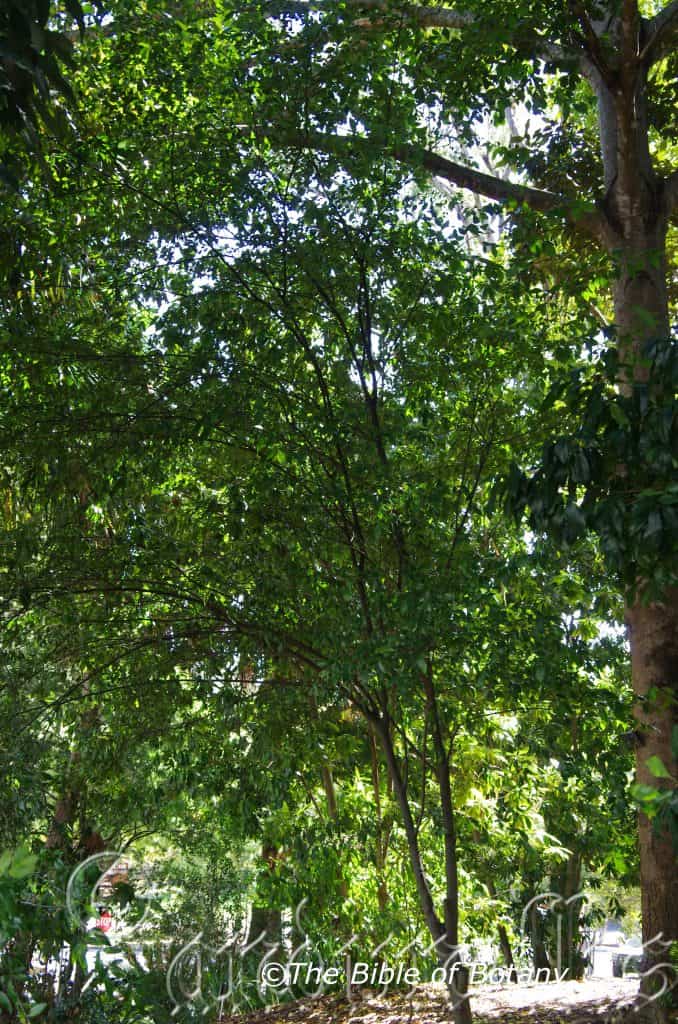
Mount Cootha Botanic Gardens Qld.
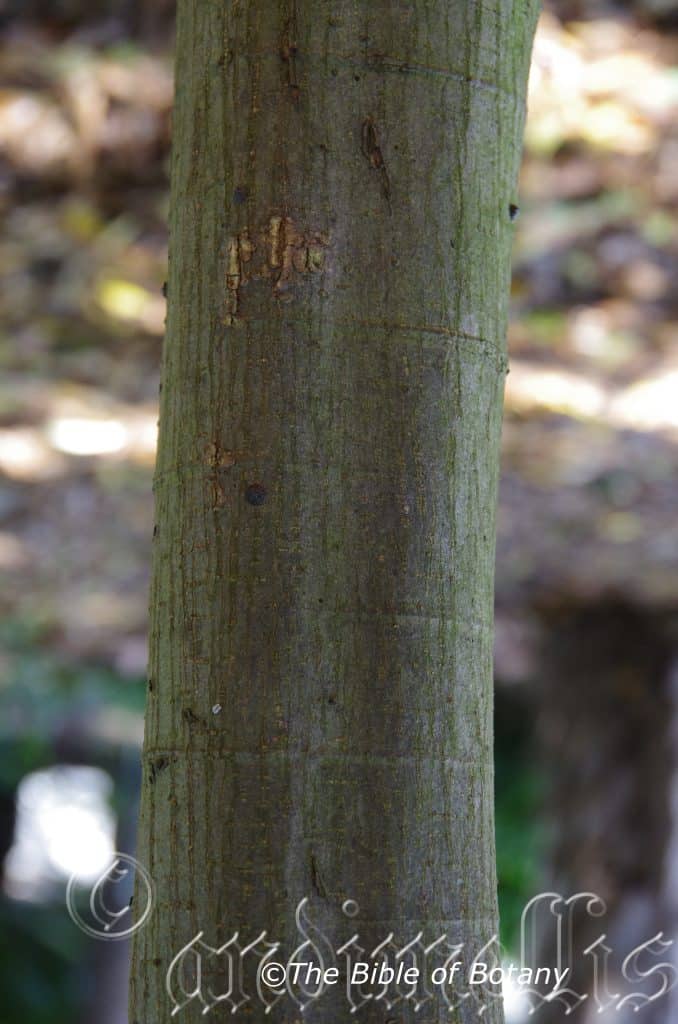
Mount Cootha Botanic Gardens Qld.
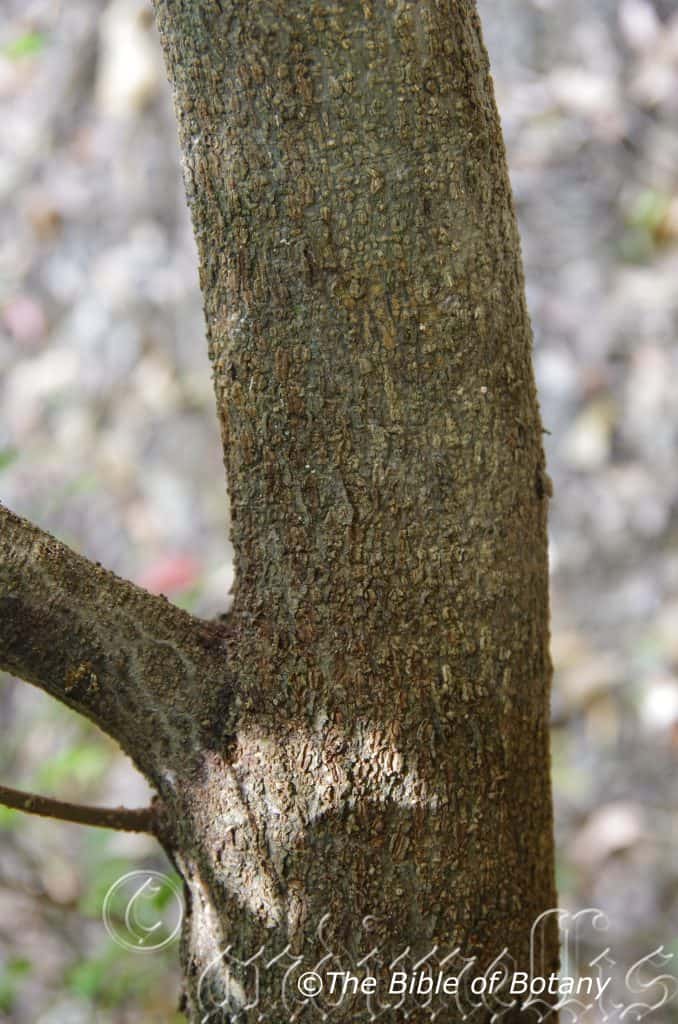
NCBG Coffs Harbour NSW

Mount Cootha Botanic Gardens Qld.
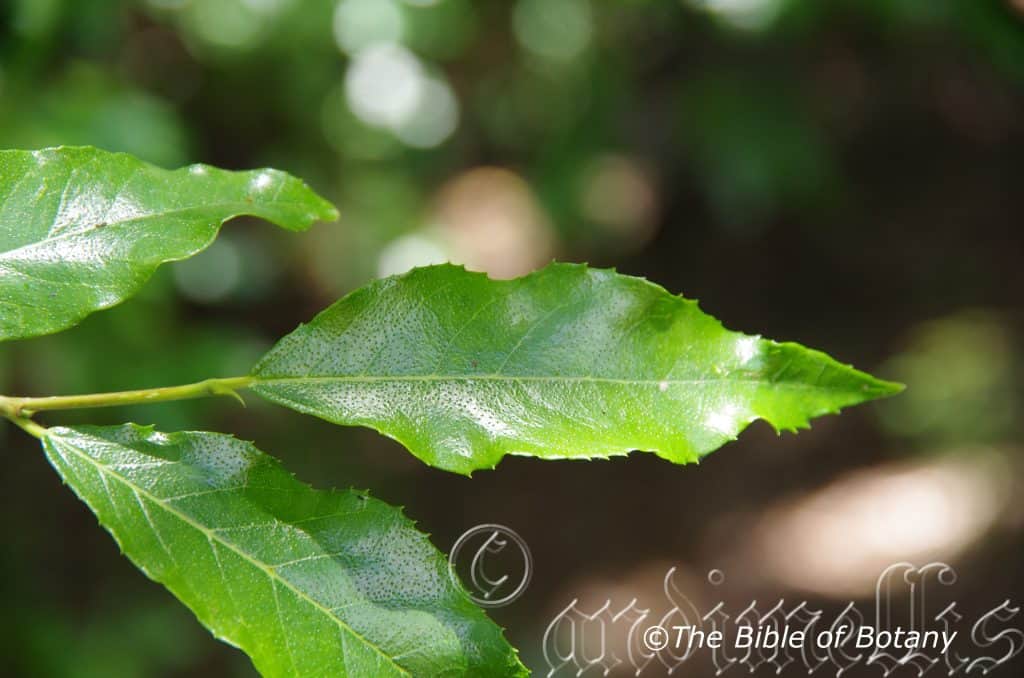
NCBG Coffs Harbour NSW
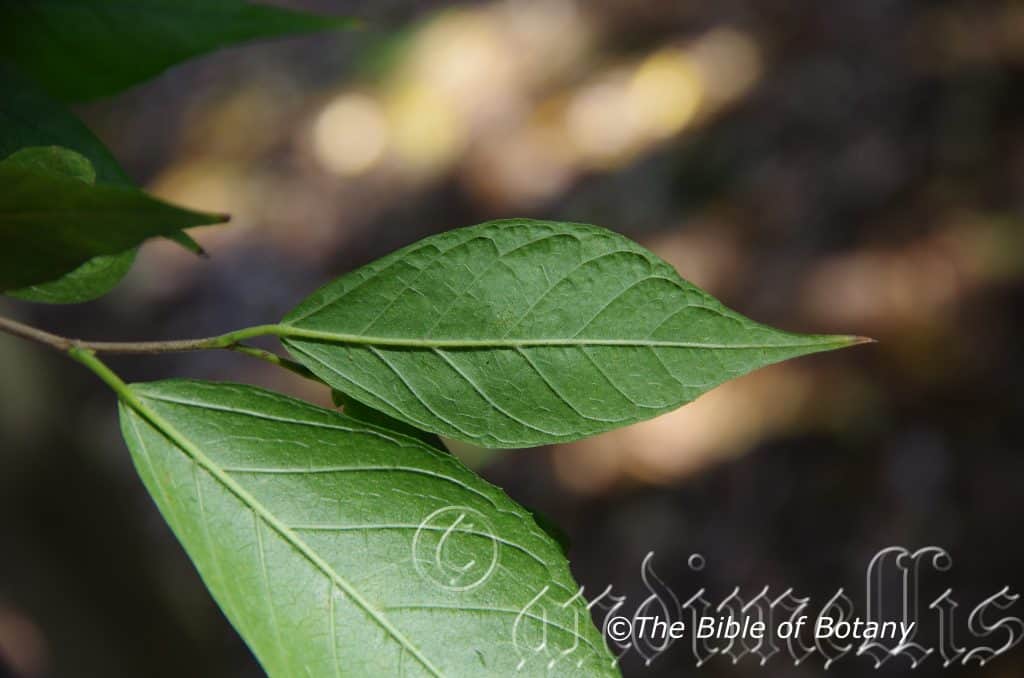
Mount Cootha Botanic Gardens Qld.
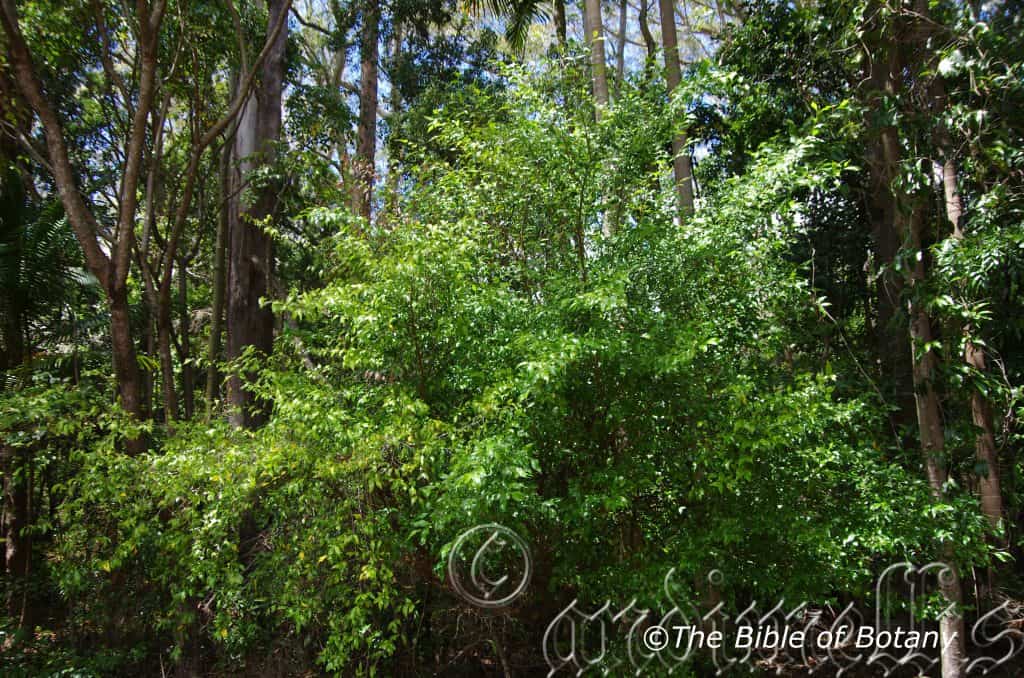
NCBG Coffs Harbour NSW
Streblus brunonianus
Classification:
Unranked: Eudicots
Class: Rosids
Order: Rosales
Family: Moraceae
Tribe: Moreae
Genus: From Streblos, which is Ancient Greek for crooked. It refers to the trunk and branches of the type species Streblus asper, which are rather crooked.
Specie: Is probably named in honour of Robert Brown; 1773-1858, who was a Scottish botanist and palaeobotanist who sailed with Mathew Flinders when he circumnavigated Australia.
Sub specie:
Common Name:
Distribution:
Streblus brunonianus is found south from the Torres Straight Islands in far north eastern Queensland to Shoalhaven in southern coastal New South Wales. It is mainly found on the western side, on and east of the Great Dividing Range.
https://avh.ala.org.au/occurrences/search?taxa=Streblus+brunonianus#tab_mapView
Habitat Aspect Climate:
Streblus brunonianus prefers light shade to medium shade. It grows along creeks, streams and rivers in warm sub-tropical rainforests and tropical rainforest and warm gallery forests. The altitude ranges from 10 meters ASL to 1380 meters ASL.
The temperatures range from 3 degrees in August to 37 degrees in January.
The rainfalls range from lows of 100mm to 500mm average per annum.
Soil Requirements:
Streblus brunonianus prefers fine sandy loams to medium clays. The soils are usually derived from decomposed sandstones, granites, metamorphic rocks, brown basalts, black basalts or alluvial deposits. The soils pH ranges from 5pH to 7pH. It does not tolerate water logged soils however seasonal flooding may occur during downpours in the wet season. Non saline soils to moderately saline soils are tolerated.
Height & Spread:
Wild Plants: 10m to 30m by 6m to 8m.
Characteristics:
Streblus brunonianus grows as a large shrub or small tree with raised lenticels on the trunk or larger branches. The branches are covered in transverse ridges from discarded stipules. The bark is tough and exudes a small quantity of white milky latex. The olive-green to grass-green stems are glabrous.
The alternate elliptic, ovate to lanceolate leaves measure 30mm to 80mm in length by 15mm to 40mm in width. The glabrous petioles measure 3mm to 8mm in length. The bases are broad cuneate to while the apexes are acute. The discolourous laminas are mid green to mid greyish-green, glossy and glabrous to slightly scabrous on the upper laminas while the lower laminas are paler and moderately scabrous. The laminas are raised between the main vein and the lateral veins and decurve gently downwards near the base or near the apex. The margins are regularly toothed and decurve downwards close to the edge. The mid vein and the 18 to 24 alternate lateral veins are strongly prominent on the lower laminas and are clearly visible from the upper lamina. The lateral veins form distinct loops inside the blade margin.
The juvenile leaves are often hastate and measure 100mm to 150mm in length.
The dioecious inflorescences are born on racemes from the leaf axils. The mid green peduncles and rachises are glabrous. The male and female flowers are sessile while the bracts are cordate, reniform or peltate. The racemes measure 10mm to 50mm in length.
The male staminal filaments measure 2mm to 2.2mm in length.
The female spikes have 3 or 4 individual flowers. The perianths measure 1mm to 1.2mm in length. The glabrous ovary measures 1.5mm to 2mm in length. The style’s arms measure 4mm to 5mm in length. The flowers appear from September to December.
The fruits are spherical drupes. The glabrous drupes measure 6mm to 8mm in length by 6mm to 8mm in diameter. The green capsules turn reddish externally and reddish-yellow internally when ripe. The perianth is persistent at the base while the style remnants are persistent at the apex on the ripe drupes. The pale brown seed measures 4mm to 5mm in length by 3.5mm to 4mm in diameter. The fruits ripen from January to April.
Wildlife:
Streblus Streblus brunonianus fruits are eaten by most honeyeaters and pigeons including the Brown Cuckoo dove Macropygia phasianella, Green catbird Ailuroedus crassirostris, Lewin’s honeyeater Meliphaga lewinii, Rose Crowned fruit dove Ptilinopus regina and the Topknot pigeon Lopholaimus antarcticus.
Cultivation:
This is a magnificent small tree that can be grown in association with other rainforest specie in medium to larger gardens. It is ideal at the edge of a rain forest or deep in the center of the rainforest though at the center the beautiful foliage will not be seen once the trees gain some height. It also makes great park trees offering rather quick growth in the long term with dense shade. In cultivation it grows from 6 meters to 10 meters in height by 8 meters to 13 meters in diameter when grown in the open or taller and narrower if grown closer together as a rainforest tree. Most trees will not commence spreading until they reach a semi mature height. The first flowers when the trees are 7 to 8 years old from seed.
It grows exceptionally well on better quality light clays to medium clays soils where deep leaf litter keeps the soil cool and moisture at an even level. If these requirements are met they can cope with temperatures as low as minus 3 degrees and up to 40 degrees. It is moderately drought resistant once established however growth is slowed a lot when other than ideal conditions are supplied.
If it is given an adequate supply of water and a little native fertilizer on a regular basis the plants should respond with exceptional flowering and fruit over a long period.
It would make a good accent tree in front of low set and 2 story commercial buildings, industrial sheds or low set school buildings where they will break up hard rigid architectural lines and give warmth and breadth to a building. In front of high rise buildings they give balance.
Try using them in a court yard where the only other feature is a large rock, stump or formal or informal frog or fish pond. Next to such features their large glossy leaves and brilliant red flowers are never overpowering but strong enough to be noticed. I am surprised that they have never been used in commercial entrances and foyers to break the ice and give a feeling of business as usual but somehow make the business more relaxing.
It is great when used in medium to large rockeries as the feature plant. Here it can be planted in small groups of 2 or 3 or as a standalone plant to create the center of attention. If it is surrounded by shorter plants with finer or larger foliages, that are yellow-green or pale green then year round contrast can be created with a strong accent in the center of the bed. A more formal look can be achieved by radiating the smaller plants in a pattern of gold and purple. It’s deep red to red-orange flowers will also create that dominate affect at the center giving height and strength to the bed especially if yellow autumn and winter flowering plants are used. This dominance in foliage will stand unchallenged.
The trees also make very good indoor plants in well-lit areas in the home. Try planting 3 to 5 in a 250mm or 300mm pot for a dense look.
The trees are ideal for the growing epiphytic ferns and orchids on especially when grown on the edge of a forest.
Streblus brunonianus makes an ideal long lived bonsai plant.
Propagation:
Seeds: The seeds can be removed easily from the mature drupes.
Sow fresh seeds directly into a seed tray using a good quality seed raising mix. Keep the mix moist not wet. Do not over water as the seeds will rot off before germination takes place. Place the trays in a warm shady area preferably beneath 30mm to 50mm shade cloth.
When the seedlings are 30mm to 50mm tall, prick them out and plant them into 50mm native tubes using a good organic mix.
When the roots appear at the bottom of the tubes they can be planted out in their permanent positions or nip the tips out and plant several in larger pots for indoors.
Fertilize using Seaweed, fish emulsion or organic chicken pellets soaked in water and apply the liquid on an alternate basis. Fertilize every 2 months until the plants are well established then on an annual basis in September or March to maintain health, vitality and better flowering.
Further Comments from Readers:
“Hi reader, it seems you use The Bible of Botany a lot. That’s great as we have great pleasure in bringing it to you! It’s a little awkward for us to ask, but our first aim is to purchase land approximately 1,600 hectares to link several parcels of N.P. into one at The Pinnacles NSW Australia, but we need your help. We’re not salespeople. We’re amateur botanists who have dedicated over 30 years to saving the environment in a practical way. We depend on donations to reach our goal. If you donate just $5, the price of your coffee this Sunday, We can help to keep the planet alive in a real way and continue to bring you regular updates and features on Australian plants all in one Botanical Bible. Any support is greatly appreciated. Thank you.”
In the spirit of reconciliation we acknowledge the Bundjalung, Gumbaynggirr and Yaegl and all aboriginal nations throughout Australia and their connections to land, sea and community. We pay our respect to their Elders past, present and future for the pleasures we have gained.
Streptothamnus moorei
Classification:
Phylum: Eudicots
Class: Equisetopsida
Order: Berberidopsidales
Family: Berberidopsidaceae
Genus: From Streptós, which is Ancient Greek for twisted, plaited, coiled or bent and Thamnos, which is Ancient Greek for a shrub or bush. It refers to the stems, which are often twisted and bent on this shrub.
Specie: Is named in honour of Moore but which Moore cannot be substantiated though Charles Moore found the halo type along the Clarence River on 28.3.1862.
Sub specie:
Common Name:
Distribution:
Streptothamnus moorei is restricted to a small area between Coomera in far south eastern Queensland to Ebor in north eastern New South Wales. It is mainly found on and east of the Great Dividing Range especially on the coastal ranges.
https://avh.ala.org.au/occurrences/search?taxa=Streptothamnus+moorei#tab_mapView
Habitat Aspect Climate:
Streptothamnus moorei prefer light shade to full sun. It grows in cool subtropical rainforests, in warm temperate rainforest on the coastal ranges or at times in coastal littoral rainforests. The altitude ranges from 10 meters ASL to 1240 meters ASL.
The temperatures range from minus 3 degrees in August to 36 degrees in January.
The rainfalls range from lows of 1000mm to 2100mm average per annum. The lower rainfall areas are subject to additional moisture through orographic precipitation.
Soil Requirements:
Streptothamnus moorei prefers light clays to medium clays. The soils are usually derived from decomposed black basalts. The soils pH ranges from 5pH to 6pH. It does not tolerate water logged soils. Non saline soils to moderately saline soils are tolerated.
Height & Spread:
Wild Plants: 6m to 10m by 4m to 6m.
Characteristics:
Streptothamnus moorei grows as a twinning climber with grey-green glabrous stems. The new growth is lime-green, glossy and glabrous.
The opposite, sub opposite or alternate broad ovate to orbicular leaves measure 60mm to 120mm in length by 40 to 120mm in width. The petioles are distinctly swollen at the junction with the stem and measure 10mm to 35mm in length. The bases are broad cuneate, rounded to truncate while the apexes are broad acute, broad acuminate to almost obtuse. The discolourous laminas are mid green to deep green, semi glossy and glabrous on the upper laminas while the lower laminas are paler and dull. The coriaceous laminas are flat to strongly recurve upwards from the mid vein to the margins and gently decurve downwards near the apex or gently decurve downwards from the base. The margins are entire. The mid vein and the 2 basal, opposite, pinnate lateral veins are strongly prominent at the base and are not prominent on the apical half while the next pair are slightly prominent at the junction of the main vein only. The veins are faintly visible from the upper lamina.
The inflorescences are born singularly from just above the leaf axils. The pale mid green to deep green peduncles measure 20mm to 30mm in length. The 5 imbricate, green sepals are imbricate. The 5 oblong, usually white, pastel pink or cream petals have an obtuse apex. The strongly retrorse, caducous petals measure 5mm to 7mm in length by 2.5mm to 3.5mm in width.
The 65 to 75 usually white, pastel pink or cream filiform filaments measure 4mm to 7mm in length. The apiculate, cream anthers measure 1.8mm to 2.2mm in length.
The green ovary is glabrous and has 3 to 5 locules. The white to cream style measures 2.5mm to 2.4mm in length. The flowers appear from September to November.
The fruits are ellipsoidal berries. The glabrous berries measure 20mm to 25mm in length by 19mm to 24mm in diameter. The green berries turn deep purple to purple-black externally when ripe. The sepals are persistent at the base while the style remnant is persistent at the apex with in an orbicular crater. There are 20 to 25 seeds in each fruit.
Wildlife:
Streptothamnus moorei wildlife is unknown to the author.
Cultivation:
Streptothamnus moorei is a medium liana for pergolas, fences or as a ground cover with in a rainforest setting. In cultivation it grows from 4 meters to 10 meters in height by 2 meters to 3 meters in diameter when grown over trees or 4 meters to 5 meters in diameter as a ground cover.
It grows exceptionally well on lighter sandy soils where the soil is exposed to the air. If these requirements are met it can cope with temperatures as low as minus 3 degrees and up to 36 degrees. It is drought resistant and will need very little attention to look their best once established.
Add to the above, if it is given a little supply of water and a little native fertilizer early on or when it rains will see the plants respond with excellent flowering and fruiting over a long period.
Propagation:
Seeds: The seeds can be removed easily from the mature fruits.
Sow freshly washed seeds directly into a seed tray using a good quality seed raising mix. Keep the mix moist not wet. Do not over water as the seeds will rot off before germination takes place. Place the trays in a warm shady area preferably beneath 30mm to 50mm shade cloth.
When the seedlings are 30mm to 50mm tall, prick them out and plant them into 50mm native tubes using a good organic mix.
When the roots appear at the bottom of the tubes they can be planted out in their permanent positions or nip the tips out and plant several in larger pots for indoors.
Fertilize using Seaweed, fish emulsion or organic chicken pellets soaked in water and apply the liquid on an alternate basis. Fertilize every 2 months until the plants are well established then on an annual basis in September or March to maintain better health, vitality and flowering.
Further Comments from Readers:
“Hi reader, it seems you use The Bible of Botany a lot. That’s great as we have great pleasure in bringing it to you! It’s a little awkward for us to ask, but our first aim is to purchase land approximately 1,600 hectares to link several parcels of N.P. into one at The Pinnacles NSW Australia, but we need your help. We’re not salespeople. We’re amateur botanists who have dedicated over 30 years to saving the environment in a practical way. We depend on donations to reach our goal. If you donate just $5, the price of your coffee this Sunday, We can help to keep the planet alive in a real way and continue to bring you regular updates and features on Australian plants all in one Botanical Bible. Any support is greatly appreciated. Thank you.”
In the spirit of reconciliation we acknowledge the Bundjalung, Gumbaynggirr and Yaegl and all aboriginal nations throughout Australia and their connections to land, sea and community. We pay our respect to their Elders past, present and future for the pleasures we have gained.
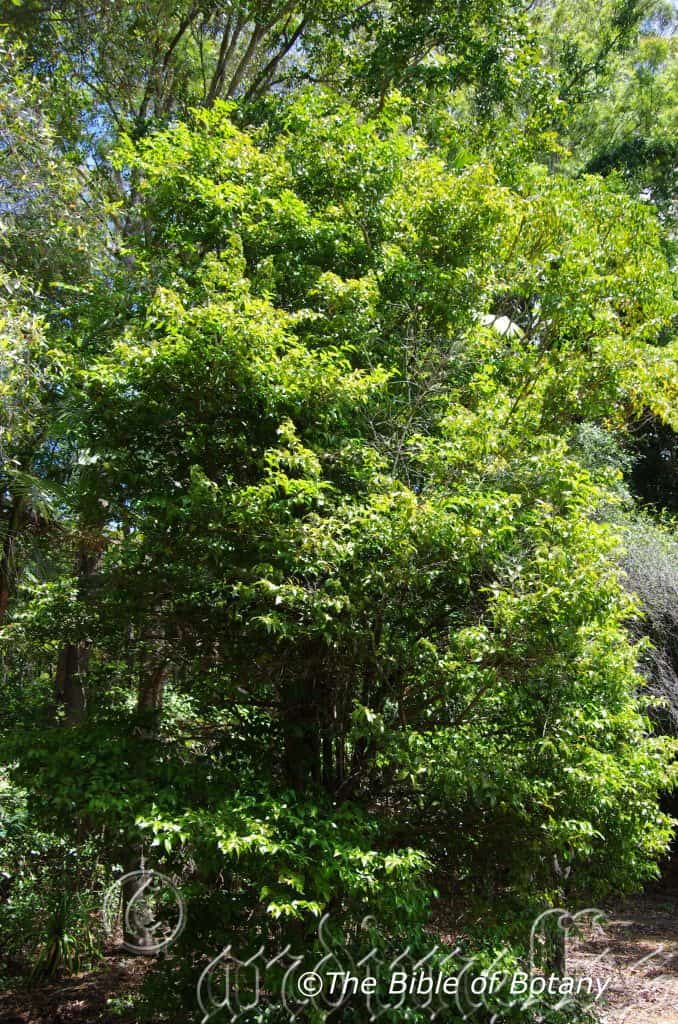
NCBG Coffs Harbour NSW

NCBG Coffs Harbour NSW
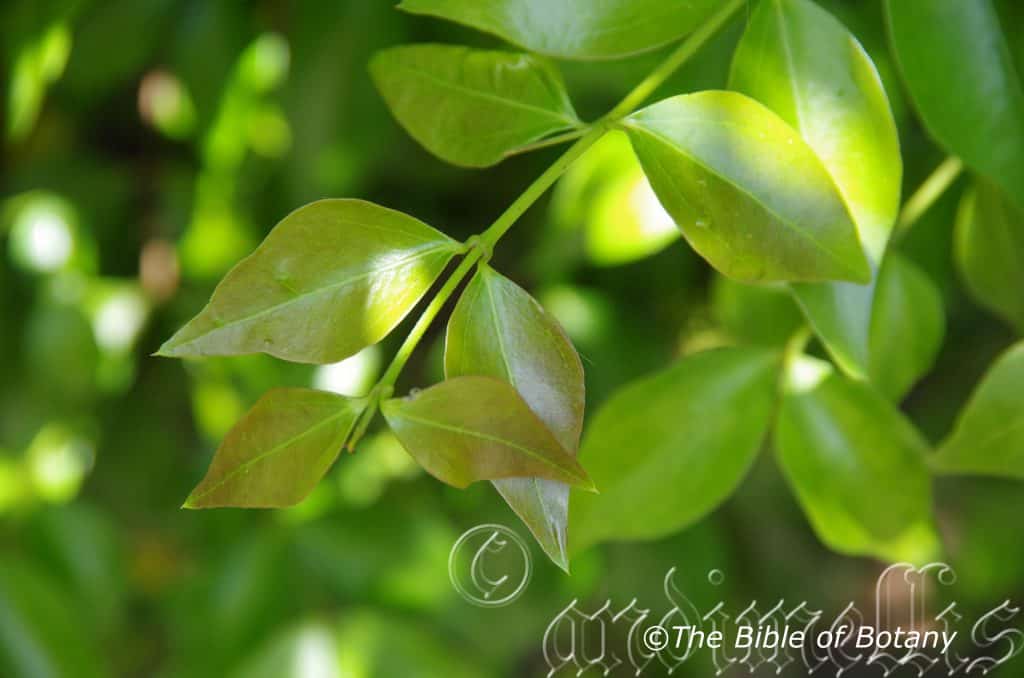
NCBG Coffs Harbour NSW

NCBG Coffs Harbour NSW
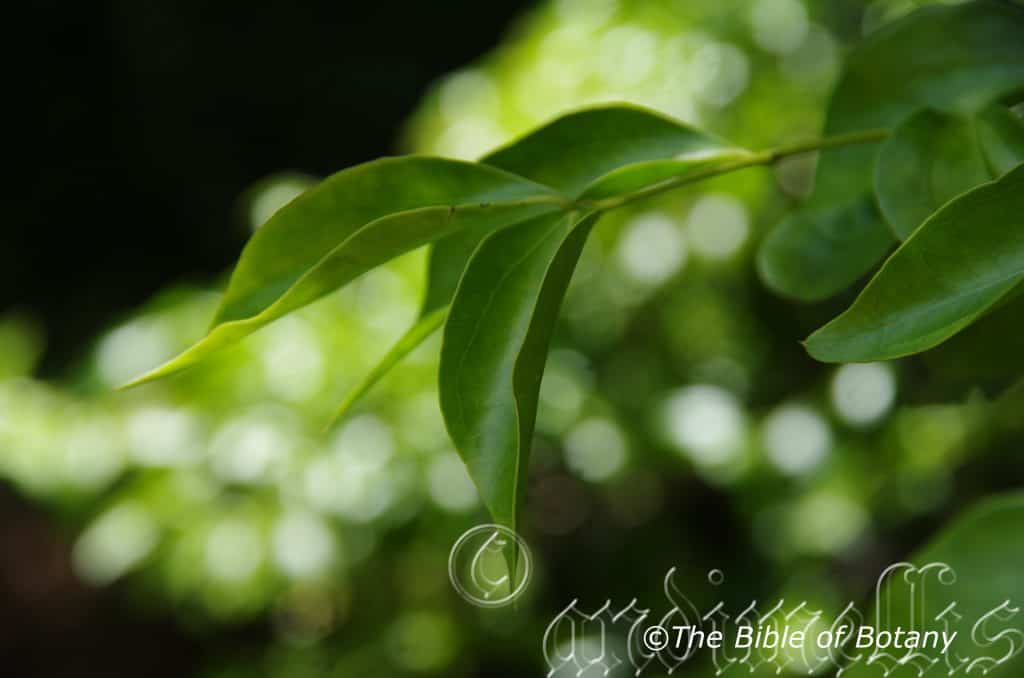
NCBG Coffs Harbour NSW

NCBG Coffs Harbour NSW
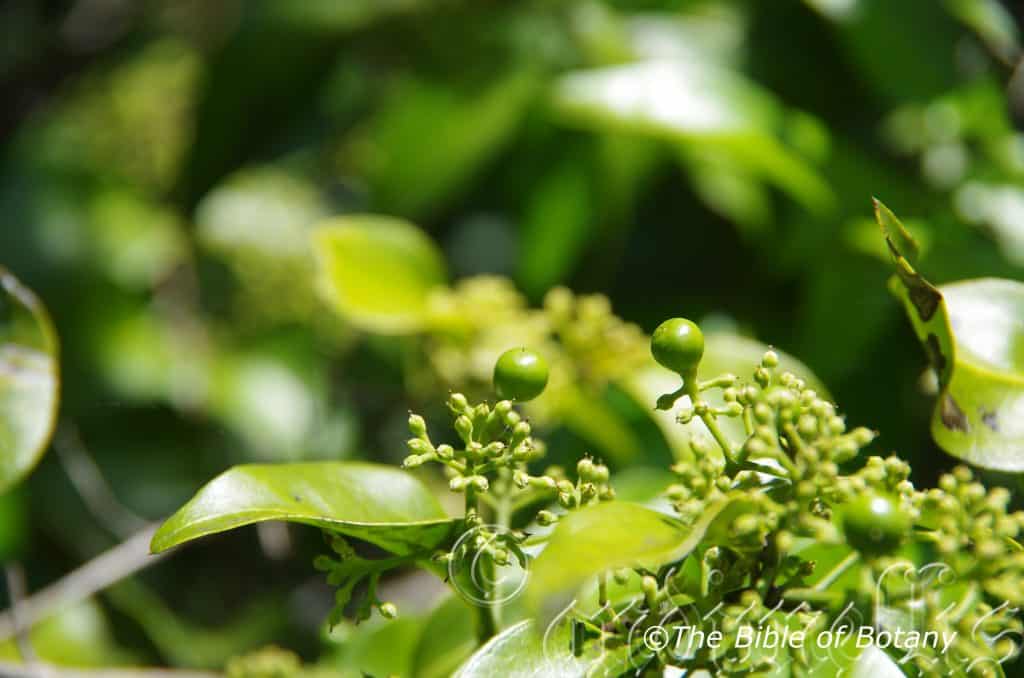
NCBG Coffs Harbour NSW
Strychnos arborea
Classification:
Phylum: Eudicots
Subclass: Magnoliidae
Order: gentianales
Family: Loganiacaceae
Genus: From Strúkhnon, which is Ancient Greek or later Strychnos, which is Greek for acrid or bitter. It was originally applied by Pliny the Elder in his Natural History to Solanum nigrum. It now refers to plants, which have higher concentrations of the toxic colourless poison, Strychnine; C21H22N2O2, which is found in varying quantities in most seeds.
Specie: From Arborescent, which is Latin for a tree. It refers to plants, which have a typical tree like structure.
Sub specie:
Common Name:
Distribution:
Strychnos arborea is found south from Mount Surprise in far north eastern Queensland to Copmanhurst in north eastern New South Wales with a disjunct population further north on the Claudir River in Kings Park on Cape York Peninsular. It is mainly found on and east of the Great Dividing Range especially on the coastal ranges.
https://avh.ala.org.au/occurrences/search?taxa=Strychnos+arborea#tab_mapView
Habitat Aspect Climate:
Strychnos arborea prefer light shade to full sun. It grows in dry rainforest. The altitude ranges from 10 meters ASL to 450 meters ASL.
The temperatures range from minus 1 degree in August to 36 degrees in January.
The rainfalls range from lows of 600mm to 2100mm average per annum.
Soil Requirements:
Strychnos arborea prefers light clays to medium clays. The soils are usually derived from decomposed brown basalts or black basalts. The soils pH ranges from 5pH to 6pH. It does not tolerate water logged soils. Non saline soils to moderately saline soils are tolerated.
Height & Spread:
Wild Plants: 15m to 25m by 5m to 8m.
Characteristics:
Strychnos arborea grows as a small tree with deep brown finely fissured bark. The new growth is mid green and glabrous to sparsely covered in white, caducous, hirsute hairs.
The opposite broad ovate to ovate leaves measure 30mm to 60mm in length by 20mm to 45mm in width. The glabrous, green petioles are sparsely covered in off white hirsute hairs and measure 3mm to 4mm in length. The bases are broad cuneate to rounded while the apexes are short caudate, long caudate to aristate. The discolourous laminas are mid green to deep green, semi glossy to glossy, and glabrous on the upper laminas while the lower laminas are paler and dull. The laminas recurve upwards from the mid vein to the margins and are slightly twisted or undulating. The margins are entire. The mid vein with the basal pair of lateral veins are prominent on the lower laminas at the base and are not prominent on the apical third. The mid vein with the basal pair of lateral veins are visible on the upper lamina. The mid vein and 2 basal laterals are sparsely covered in off white hirsute hairs near the base.
The inflorescences are born on an umbel or clusters of umbels from the upper leaf axils. The mid green to deep green peduncles and pedicels are glabrous. The peduncles measure 15mm to 30mm in length while the pedicels measure 1.5mm to 2mm in length. The cupuliform calyxes and 5 minute lobes are erect, glabrous and measure 4mm to 8mm in length.
The calyx and calyx lobes are glabrous and measure 0.4mm to 0.6mm in length overall. The corolla is covered in white pulverulent hairs externally and has line of long, soft fawnish tomentose hairs around the mouth internally. The white corolla measures 4mm to 5mm in length overall including the 5 acute thickened lobes that measure 3mm to 4mm in length.
The white stamens are inserted about half-way down tube. The ovary is glabrous. The short stout style is white. The sweetly scented flowers appear from November to February.
The fruits are globose drupes. The glabrous drupes measure 8mm to 13mm in length by 8mm to 13mm in diameter. The green drupes turn scarlet-red to orange–red externally and creamy-grey internally when ripe.
The single or rarely 2 seeds are orbicular, flattish and measure 7mm to 8.5mm in diameter.
Wildlife:
Strychnos arborea’s wildlife is unknown to the author.
The tree is a source of strychnine and curare. Curare is used in the treatment of tetanus.
Strychnine causes muscle spasms and eventually death by asphyxiation. Curare causes the muscles to relax which can lead to death by asphyxiation.
Cultivation:
Strychnos arborea is a truly beautiful small tree that can be grown in association with other dry rainforest specie in medium to larger gardens. It is ideal at the edge of a rain forest or deep in the center of the rainforest. It also makes a great park tree but is slower in growth than most rainforest trees. It offers a good dense canopy with dense shade beneath. In cultivation it grows from 6 meters to 10 meters in height by 6 meters to 12 meters in diameter when grown in the open or taller and narrower if grown closer together as a rainforest tree. Most trees will not commence spreading until they reach a semi mature height. The first flowers when the trees are 7 to 8 years old from seed.
It grows exceptionally well on better quality light clays to medium clays soils where deep leaf litter keeps the soil cool and moisture at an even level. If these requirements are met they can cope with temperatures as low as minus 3 degrees and up to 40 degrees. It is moderately drought resistant once established however growth is slowed a lot when other than ideal conditions are supplied.
If it is given an adequate supply of water and a little native fertilizer on a regular basis the plants should respond with exceptional flowering and fruit over a long period.
It would make a good accent tree in front of low set and 2 story commercial buildings, industrial sheds or low set school buildings where they will break up hard rigid architectural lines and give warmth and breadth to a building. In front of high rise buildings they give balance.
Try using them in a court yard where the only other feature is a large rock, stump or formal or informal frog or fish pond. Next to such features their glossy leaves and brilliant red fruits and sweetly scented flowers are never overpowering but strong enough to be noticed. I am surprised that they have never been used in commercial entrances and foyers to break the ice and give a feeling of business as usual but somehow make the business more relaxing.
It is great when used in medium to large rockeries as the feature plant. Here they can be planted in small groups of 2 or 3 or as a standalone plant to create the center of attention. If it is surrounded by shorter plants with finer or larger foliages, that are yellow-green or pale green then year round contrast can be created with a strong accent in the center of the bed. A more formal look can be achieved by radiating the smaller plants in a pattern of gold and purple. Their deep red to red-orange flowers will also create that dominate affect at the center giving height and strength to the bed especially if yellow autumn and winter flowering plants are used. This dominance in foliage will stand unchallenged.
The trees also make very good indoor plants in well-lit areas in the home. Try planting 3 to 5 in a 250mm or 300mm pot for a dense look.
The trees are ideal for the growing epiphytic ferns and orchids on especially when grown on the edge of a forest.
Strychnos arborea makes an ideal long lived bonsai plant.
Propagation:
Seeds: The seeds can be removed easily from the mature pods.
Sow the fresh seeds directly into a seed tray using a good quality seed raising mix. Keep the mix moist not wet. Do not over water as the seeds will rot off before germination takes place. Place the trays in a warm shady area preferably beneath 30mm to 50mm shade cloth.
When the seedlings are 30mm to 50mm tall, prick them out and plant them into 50mm native tubes using a good organic mix.
When the roots appear at the bottom of the tubes they can be planted out in their permanent positions or nip the tips out and plant several in larger pots for indoors.
Fertilize using Seaweed, fish emulsion or organic chicken pellets soaked in water and apply the liquid on an alternate basis. Fertilize every 2 months until the plants are well established then on an annual basis in September or March to maintain better health, vitality and flowering.
Further Comments from Readers:
“Hi reader, it seems you use The Bible of Botany a lot. That’s great as we have great pleasure in bringing it to you! It’s a little awkward for us to ask, but our first aim is to purchase land approximately 1,600 hectares to link several parcels of N.P. into one at The Pinnacles NSW Australia, but we need your help. We’re not salespeople. We’re amateur botanists who have dedicated over 30 years to saving the environment in a practical way. We depend on donations to reach our goal. If you donate just $5, the price of your coffee this Sunday, We can help to keep the planet alive in a real way and continue to bring you regular updates and features on Australian plants all in one Botanical Bible. Any support is greatly appreciated. Thank you.”
In the spirit of reconciliation we acknowledge the Bundjalung, Gumbaynggirr and Yaegl and all aboriginal nations throughout Australia and their connections to land, sea and community. We pay our respect to their Elders past, present and future for the pleasures we have gained.
Stuckenia pectinata
Classification:
Unranked: Monocots
Order: Alismatales
Family: Potamogetonaceae
Genus: Is named in honour of Stuckey.
Specie: From kteís, which is Ancient Greek for to pluck or pull or later Pectinare, which is Latin for to comb or a comb. It refers to the stipules and ligules, which are easily pulled off.
Sub specie:
Common Name: Sago Pond Weed or Fennel Pond Weed.
Distribution:
Stuckenia pectinatus is found throughout Australia where permanent cool to warm, deep, slow or still saline waters exist.
https://avh.ala.org.au/occurrences/search?taxa=Stuckenia+pectinata#tab_mapView
Habitat Aspect Climate:
Stuckenia pectinata prefer full sun to very light dappled shade. It grows in deeper water with muddy substrates to 4 meters in depth. The altitude ranges from 2 meters ASL to 450 meters ASL.
The water temperatures range from 10 degrees in August to 26 degrees in January.
The rainfalls range from lows of 150mm to 2100mm average per annum.
Soil Requirements:
Stuckenia pectinata prefers on wet muddy soils. The soils are derived from most rock types. The soils pH ranges from 6.8pH to 8pH. It does not tolerate water logged soils. Non saline soils to very saline or extreme saline waters are tolerated.
Height & Spread:
Wild Plants: 1m to 3m by 1m to hundreds of square meters.
Characteristics:
Stuckenia pectinata grows as a submerged rhizomatous aquatic perennial with a vigorous rhizome system that penetrates mud to about 1 meter in depth. It produces numerous white, fleshy root tubers. The stems measure 1 meter to 3 meters in length. The stems are strongly branched. Turions have not been recorded on this species probably because it prefers to grow in permanent water that doesn’t freeze over the surface in winter and doesn’t get extremely warm in the summer or autumn.
The alternate, narrow linear leaves measure 50mm to 170mm in length by 1mm to 2mm in length. The leaves join to a loose stipula sheath. The upper portion of the sheath forms a distinctive, stem clasping ligule. The long, hyaline ligule measures 3mm to 15mm in length. The apexes are mucronate to acute. The concolourous laminas are bright lime-green to pale grass-green, semi glossy and glabrous. The margins are entire.
The inflorescences are born on lax emergent, floating or submerged spikes from the leaf axils. The lime-green to mid grass-green peduncles, rachises are glabrous. The peduncle and rachis measure 30mm to 50mm in length while the pedicels are sessile. The flowers are born in interrupted small globose clusters of 2 to 6 individual flowers.
The cupular receptacle is attended by 2 or 3 fleshy, orbicular, cupuliform bracts. The receptacles measure 1.6mm to 2mm in height by 3mm to 4mm in diameter. The reddish-brown to reddish-green bracts measure 3mm to 4mm in length by 1.2mm to 1.6mm in width. The ovary is glabrous. The slender style measures 5mm to 11mm in length. The flowers appear from September to April.
The fruits are globose and laterally compressed nutlets. The nutlets are smooth and glabrous with a short slightly rostrate beak. They measure 3mm to 4.5mm in length excluding the beak by 2.5mm to 3.5mm in width. The green capsules turn deep orange-brown when ripe.
Wildlife:
Stuckenia pectinata’s wildlife is unknown to the author.
Cultivation:
Stuckenia pectinata rhizomes form mats which play an important role in erosion control of slow moving streams and rivers. It is also a safe refuge for small and medium fish species and provides safe corridors for travelling along. It is the food source for several water born snails.
This is an essential water plant for the conservation of our native fish in the areas in estuarine zones where the salinity varies on rainfall from 0.5 parts per million when the rivers are being flushed out to 30 parts per million during droughts.
Of the 300 species of native freshwater fish known in Australia over 40mm are now considered threatened, rare or vulnerable due to the introduction of exotic fish and habitat destruction.
Propagation:
Seeds: The seeds can be removed easily from the mature fruits.
Sow fresh seeds soon after collecting as viability is not long. Plant directly into small peat jiffy pots. Place the jiffy pots in a tray of water so the water is 20mm to 30mm above the pots. Place the trays in a warm sunny area or preferably beneath 10mm to 20mm shade cloth. When the seedlings roots appear at the bottom or sides of the pots or the shoots start to break the surface of the water place them into their permanent position in the estuarine zones or aquariums.
Further Comments from Readers:
“Hi reader, it seems you use The Bible of Botany a lot. That’s great as we have great pleasure in bringing it to you! It’s a little awkward for us to ask, but our first aim is to purchase land approximately 1,600 hectares to link several parcels of N.P. into one at The Pinnacles NSW Australia, but we need your help. We’re not salespeople. We’re amateur botanists who have dedicated over 30 years to saving the environment in a practical way. We depend on donations to reach our goal. If you donate just $5, the price of your coffee this Sunday, We can help to keep the planet alive in a real way and continue to bring you regular updates and features on Australian plants all in one Botanical Bible. Any support is greatly appreciated. Thank you.”
In the spirit of reconciliation we acknowledge the Bundjalung, Gumbaynggirr and Yaegl and all aboriginal nations throughout Australia and their connections to land, sea and community. We pay our respect to their Elders past, present and future for the pleasures we have gained.
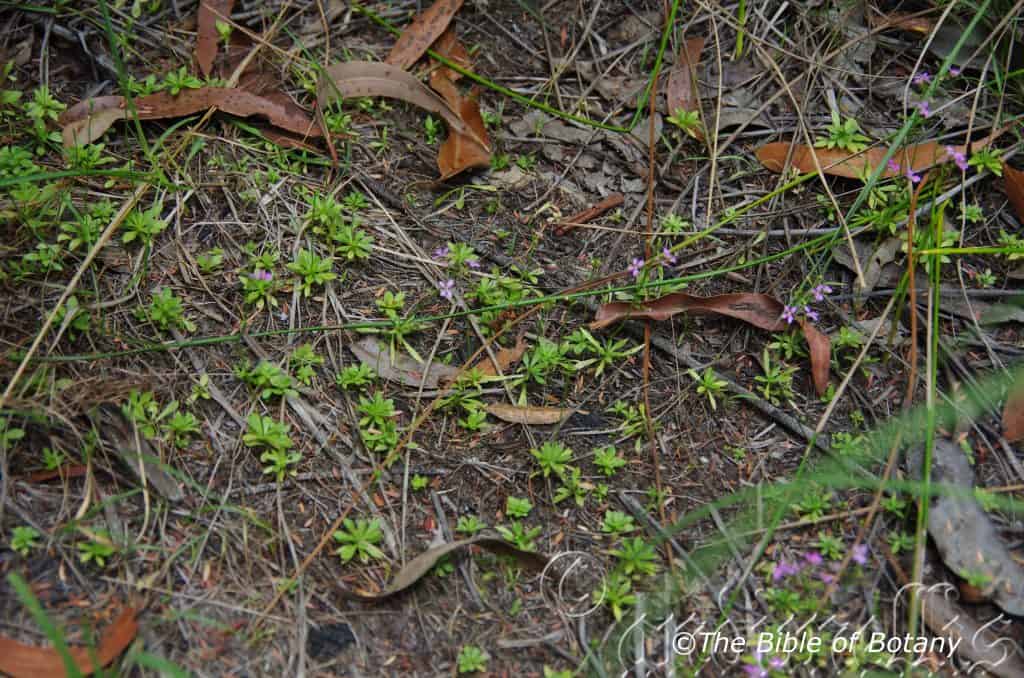
The Pinnacles NSW
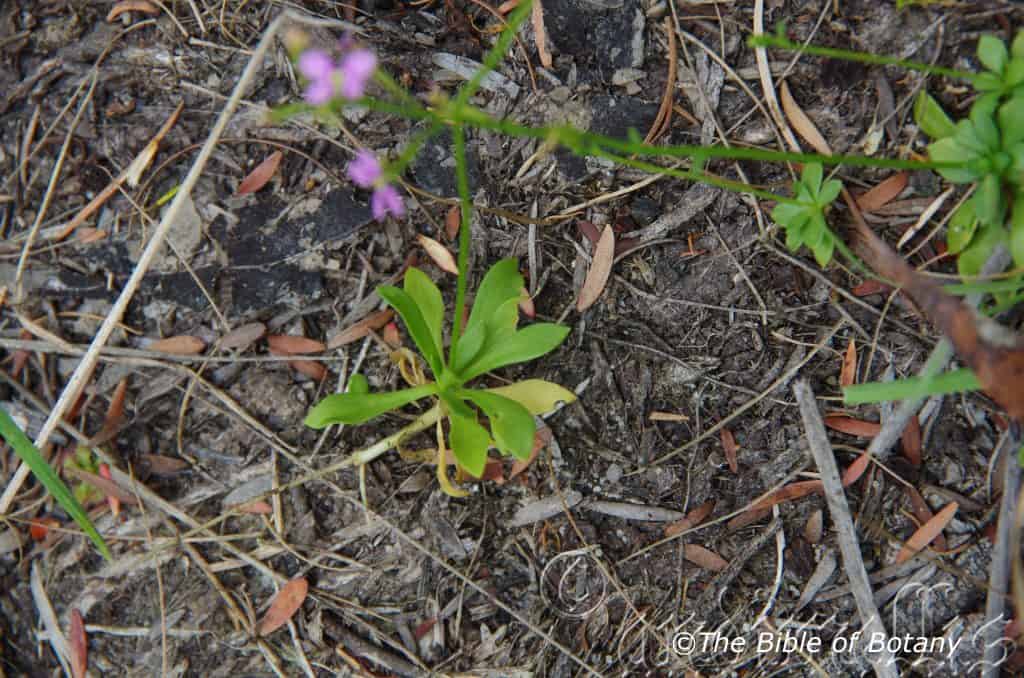
The Pinnacles NSW
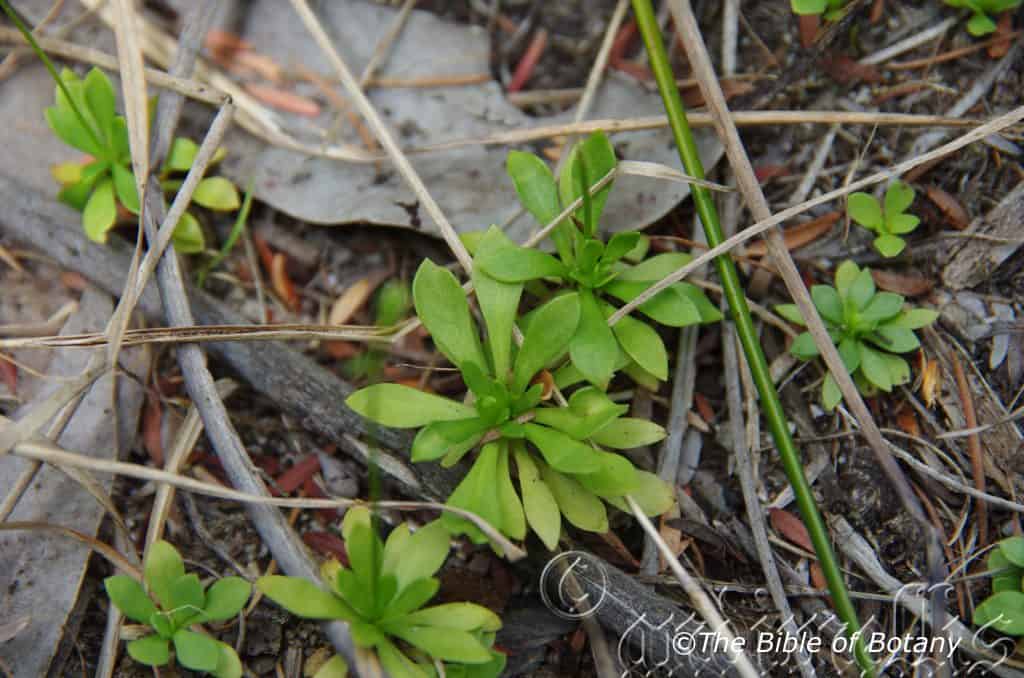
The Pinnacles NSW
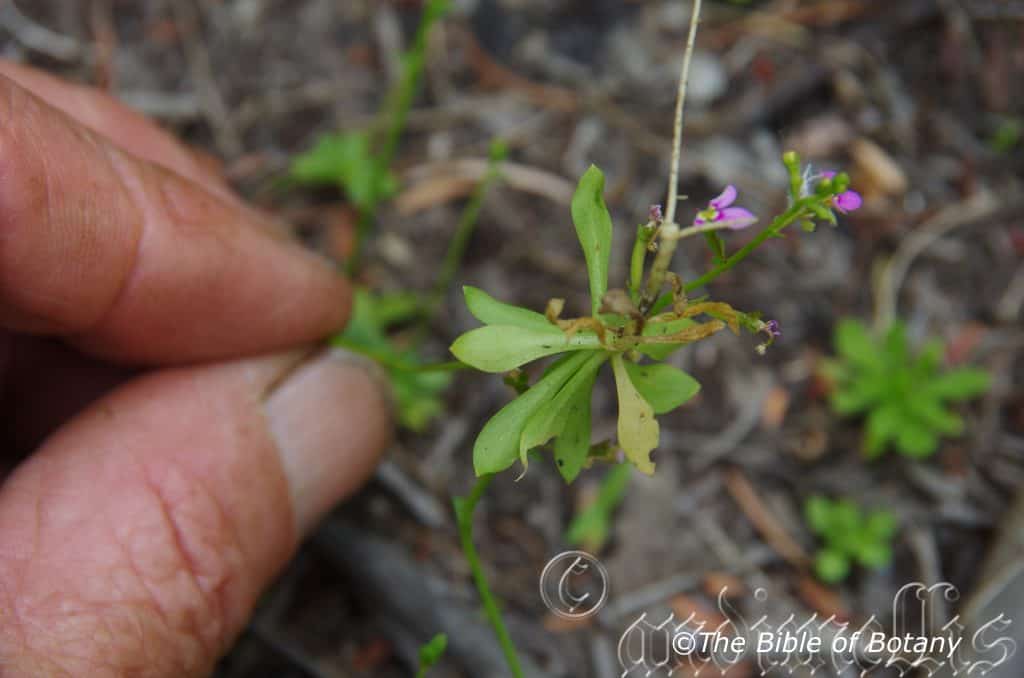
The Pinnacles NSW

The Pinnacles NSW
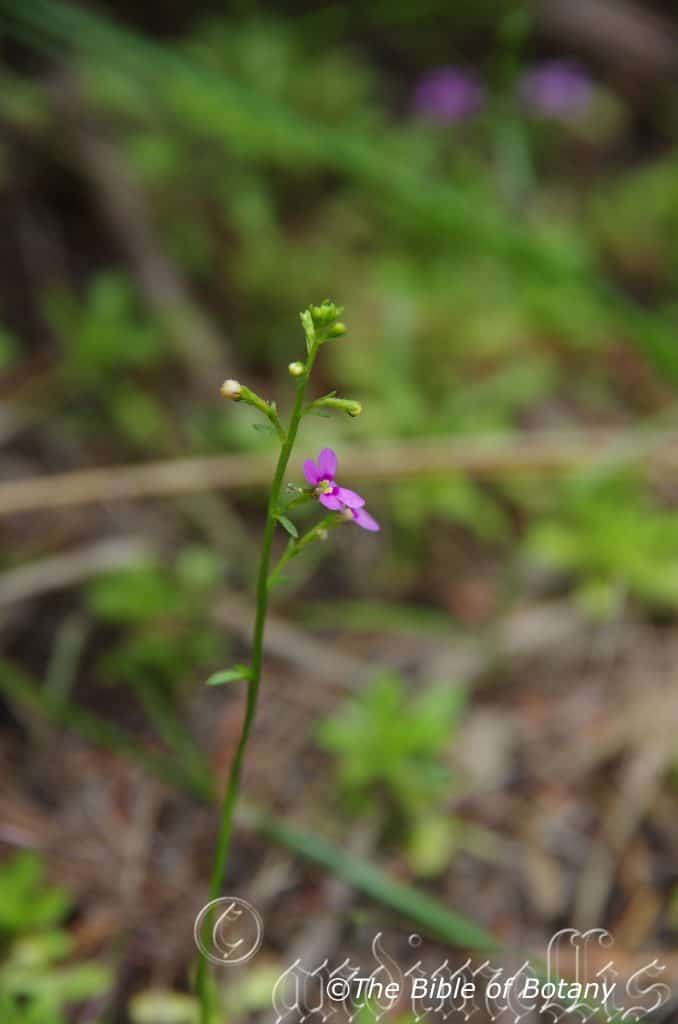
The Pinnacles NSW

The Pinnacles NSW
Stylidium debile
Classification:
Unranked: Eudicots
Class: Asterids
Order: Asterales
Family: Stylidiaceae
Subfamily: Stylidioideae
Genus: From St?los, which is Ancient Greek for a column or later Greek for a part of the female reproductive organ between the ovaries and the stigma. It refers to styles, which have become specialized in having a trigger mechanism, which pulls the stigma down to contact its insect pollinator.
Subgenus: Tolypangium
Specie: From Dedile, which is Latin for weak, feeble or debilitated. It refers to the straggly weak nature of the growth habit.
Sub specie:
Common Name: Frail Trigger Plant
Distribution:
Stylidium debile is found in several disjunct populations south from Bellenden Kerr in far north east Queensland to Burwood in New South Wales. It is found on the Western Slopes in Queensland and on and east of the range to the coast in both states.
https://avh.ala.org.au/occurrences/search?taxa=Stylidium+debile#tab_mapView
Habitat Aspect Climate:
Stylidium debile prefers light shade to full sun. It grows on seasonal wet ground, permanently wet places adjacent to lakes, wallums, swamps or shallow depressions in ephemeral pools. The altitude ranges from 5 meters ASL to 1400 meters ASL.
The temperatures range from 3 degrees in August to 40 degrees in January.
The rainfalls range from lows of 100mm to 1400mm average per annum.
Soil Requirements:
Stylidium debile prefers nutrient poor course orange, red or reddish-brown sands, fine sands to sandy loams. The soils are usually derived from decomposed sandstones or at times granites. The soils pH ranges from 6pH to 7pH. It does not tolerate water logged soils. Non saline soils to slightly saline soils are tolerated.
Height & Spread:
Wild Plants: 0.25m to 0.35m by 0.05m to 0.07m.
Characteristics:
Stylidium debile grows as a perennial herb with loose rosette basal leaves and leaves at apex of a short stem. The leaves are often scattered with several smaller leaves below the apical leaves.
The spathulate to obovate rosette leaves measure 5mm to 35mm in length by 4mm to 8mm in width. The pale green, fleshy petioles are glabrous and measure 6mm to 8mm in length. The bases taper along the attenuate petiole while the apexes are apiculate. The concolourous laminas are pale green, dull and glabrous. The laminas are concave on the upper laminas while the margins are entire. The obtuse mid vein is prominent on the basal half of the lower lamina and is not visible from the upper lamina.
The inflorescences are born on a scape from the center of the rosette of basal leaves. The reddish-green to pale green scapes measure 50mm to 350mm in length and are moderately to densely covered in white, reddish tipped glandular hairs.
The ovary reddish-green to green ovary is moderately to densely covered in white tipped reddish glandular hairs. The oblong, inferior ovary measures 1.5mm to 2mm in length. The mid green deep green sepals are moderately to densely covered in white, reddish tipped glandular hairs. The sepals measure 1mm to 1.5mm in length. The greenish-yellow to yellow-green corolla tube is glabrous and measures 2mm to 4mm in length. The 4 lobes are white at the base while the surfaces are pink, bright mauve or reddish-pink. The dimorphic lobes are very sparsely to sparsely covered in white, reddish tipped glandular hairs externally and measure 3mm to 5mm in length.
The trigger mechanism measures 4mm to 5mm in length and recurves 180 degrees at 2mm to 2.5mm from the base. The lateral, clavate pollen presenter is covered in long white hirsute hairs and measures 1.5mm to 2mm in length by 1mm to 1.5mm in diameter. The flowers appear from September to May.
Stylidium debile fruits are narrow oblong, slightly curved capsules. The capsules measure 6mm to 8mm in length. The green capsules turn grey-brown when ripe. The tawny-brown seeds are covered in white hirsute hairs.
Confusing Species:
Stylidium debile’s flowers are on a scape. The trigger mechanisms bend is 30 degrees.
Stylidium paniculatum’s flowers are on a panicle. The trigger mechanisms bend is 50 degrees.
Wildlife:
Stylidium debile wildlife is unknown to the author.
Cultivation:
Stylidium debile is an unusual addition for the keen gardener who is looking for something different yet still easy to grow. It is ideal in settings near ponds in court yards or the rockeries especially when mass planted. It needs some good sun light to very light shade to grow at its best.
To make a bog garden, extend the pond or to make an artificial marshland on sand all you need is a sheet of black plastic and some rocks. Dig the soil out and lay two or three layers of black plastic on the shallow depression. Before backfilling the plastic to the original level with sand and peat mixed at a ratio of 1 to 4 perforate the plastic to allow excess water drain and prevent stagnation. Make sure the sand is free of salt. If it isn’t the wash the sand several times to make sure the salt is completely removed. Fill the depression with water until it is within 50mm of the surface. Place the rocks around the perimeter so that it looks natural. Make a depression with your arm in the corner on the low side so excess water can drain away when it rains.
I like to use some of the small Juncus like Juncus bufonius or Juncus planifolius as a base and back drop when growing carnivorous plants as most are small and they look more natural when planted around or amongst the sedges but can become overpowering. It would make a good addition around small carnivourous plants like Drosera burmanni, Drosera spathulata, Drosera peltata grows naturally in the same area and is also a small upright plant of similar size and frail looking or Cephalotus follicularis to mention a few of our beautiful natives.
Carefully remove the plants from their pots and plant them into their artificial wallum. Do not fertilize.
The best thing about the carnivorous plants is you can grow a large number in a small area. They often reach their full potential in just 1 growing season. If the water level is kept topped up it is really very easy to grow and maintain.
Propagation:
Seeds: The seeds can be removed easily from the mature capsules.
To treat the seeds by placing them in hot, not boiling water and allow them to soak overnight. Another method is to lightly rub the seeds on fine sand paper to remove part of the outer testa.
Sow freshly treated seeds directly into peat jiffy pots, keeping them moist not wet. Do not over water as the seeds will rot off before germination takes place. Place the trays in a warm sunny area.
When the seedlings roots appear at the bottom or sides of the pots place them into their permanent position in the ground.
Fertilize using Seaweed or fish emulsion on planting out to maintain better health, vitality and flowering.
Further Comments from Readers:
“Hi reader, it seems you use The Bible of Botany a lot. That’s great as we have great pleasure in bringing it to you! It’s a little awkward for us to ask, but our first aim is to purchase land approximately 1,600 hectares to link several parcels of N.P. into one at The Pinnacles NSW Australia, but we need your help. We’re not salespeople. We’re amateur botanists who have dedicated over 30 years to saving the environment in a practical way. We depend on donations to reach our goal. If you donate just $5, the price of your coffee this Sunday, We can help to keep the planet alive in a real way and continue to bring you regular updates and features on Australian plants all in one Botanical Bible. Any support is greatly appreciated. Thank you.”
In the spirit of reconciliation we acknowledge the Bundjalung, Gumbaynggirr and Yaegl and all aboriginal nations throughout Australia and their connections to land, sea and community. We pay our respect to their Elders past, present and future for the pleasures we have gained.
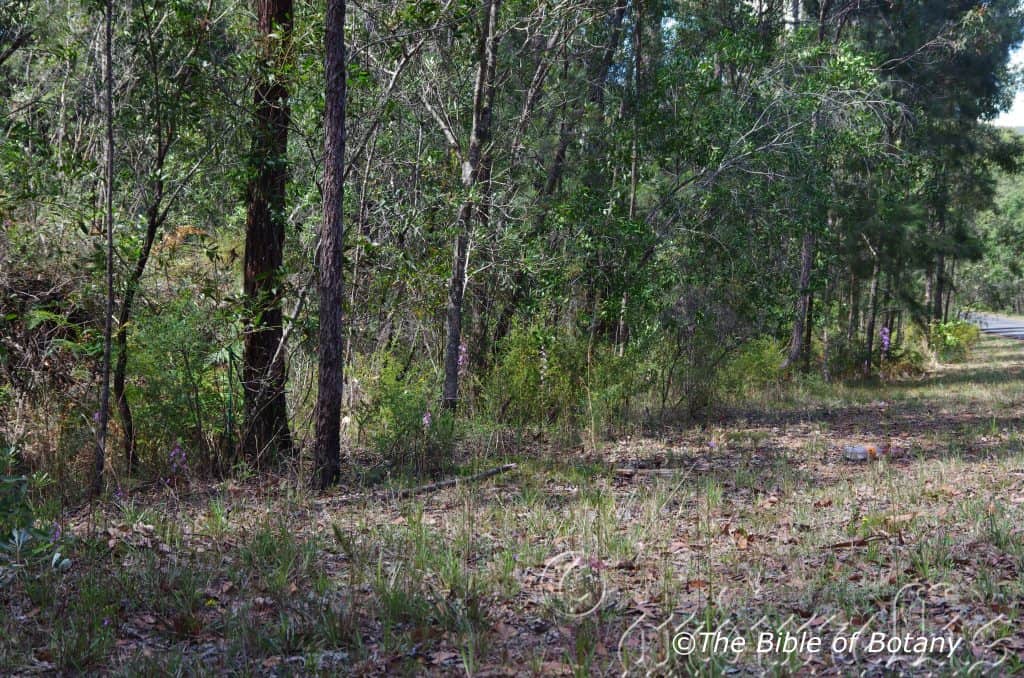
Fortis Creek National Park NSW
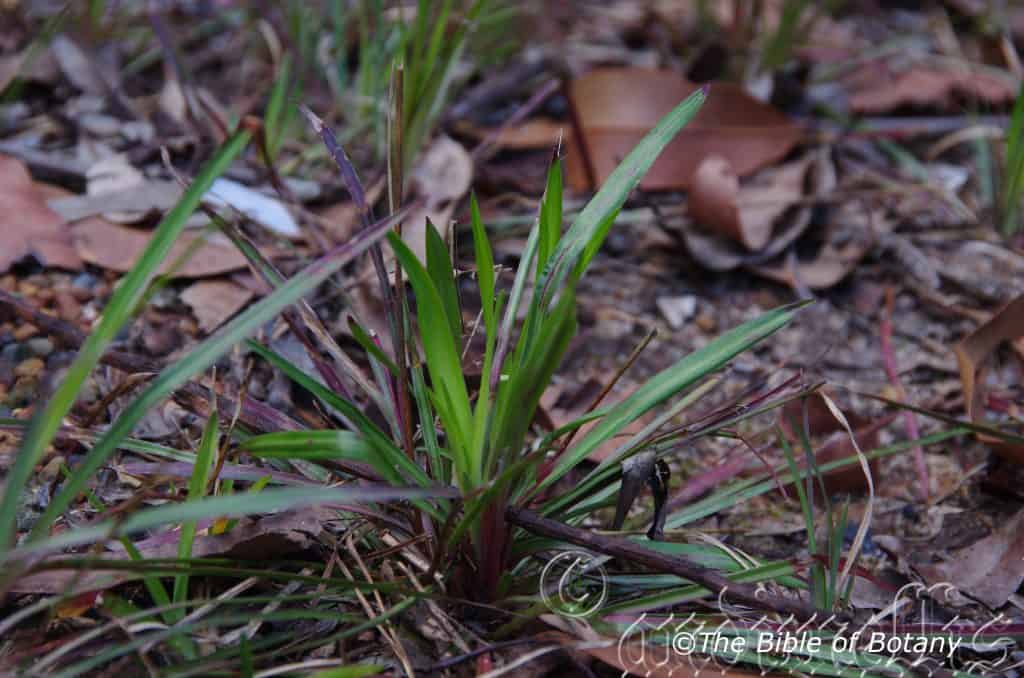
Fortis Creek National Park NSW
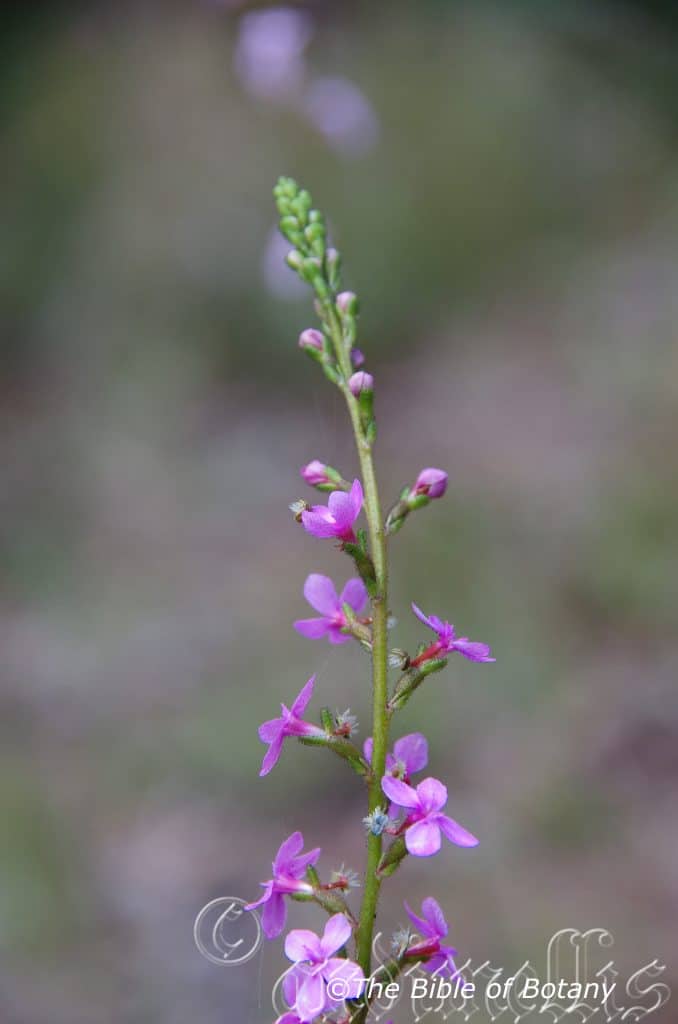
Fortis Creek National Park NSW
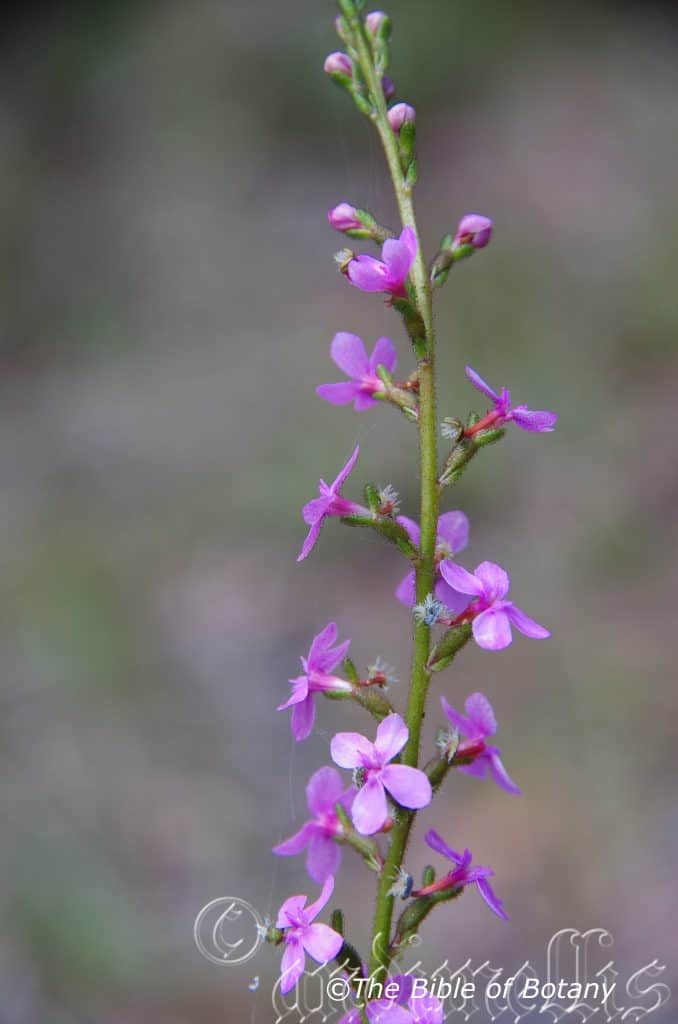
Fortis Creek National Park NSW
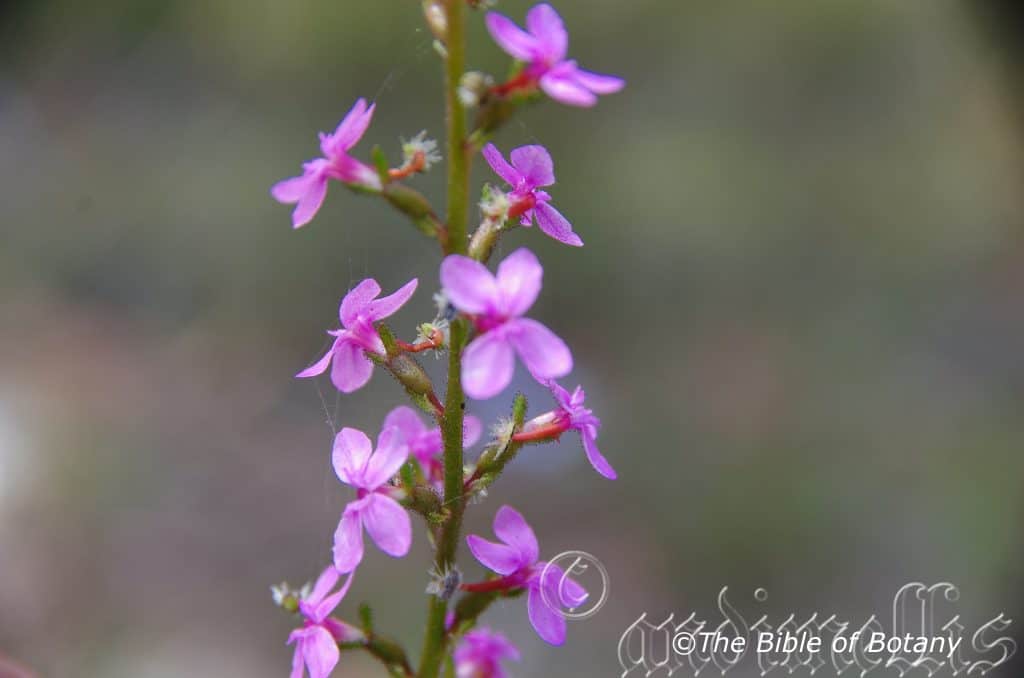
Fortis Creek National Park NSW

NCBG Coffs Harbour NSW
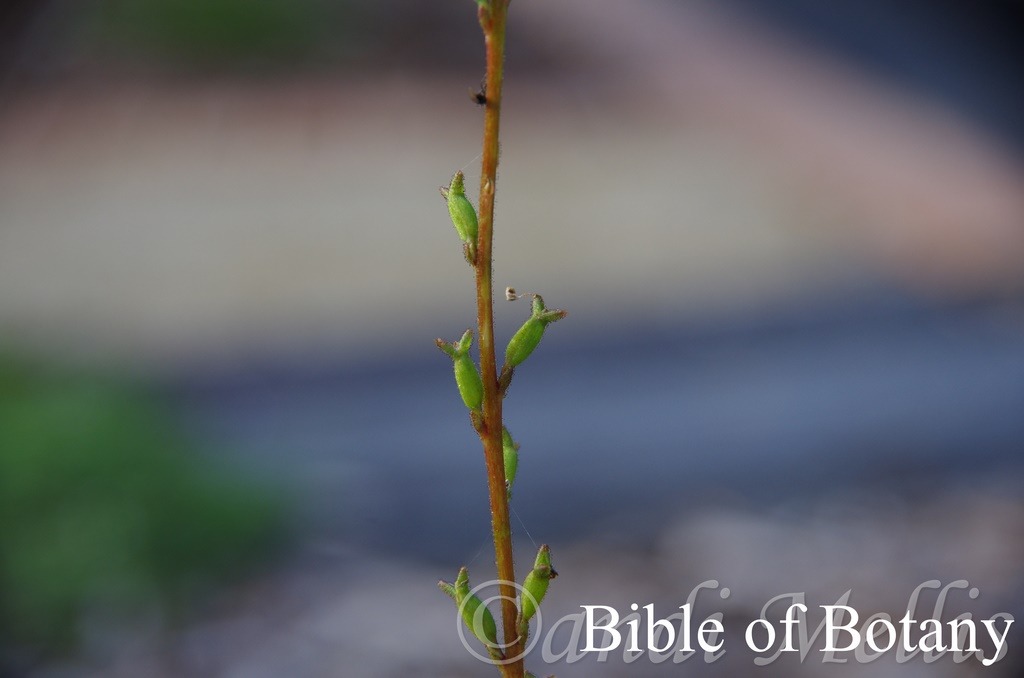
NCBG Coffs Harbour NSW
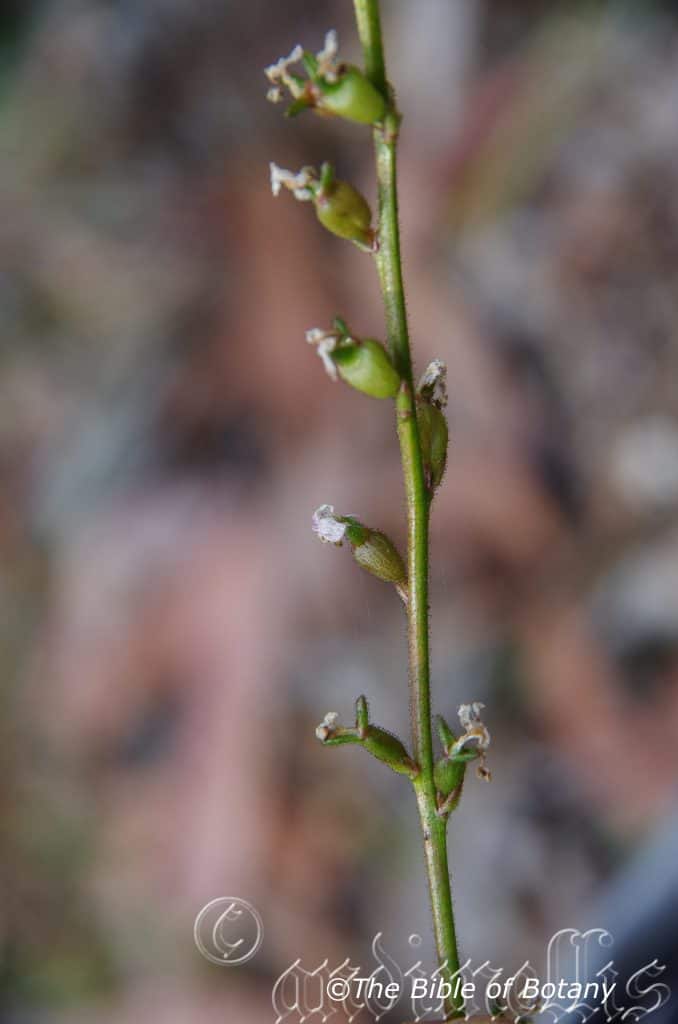
Fortis Creek National Park NSW
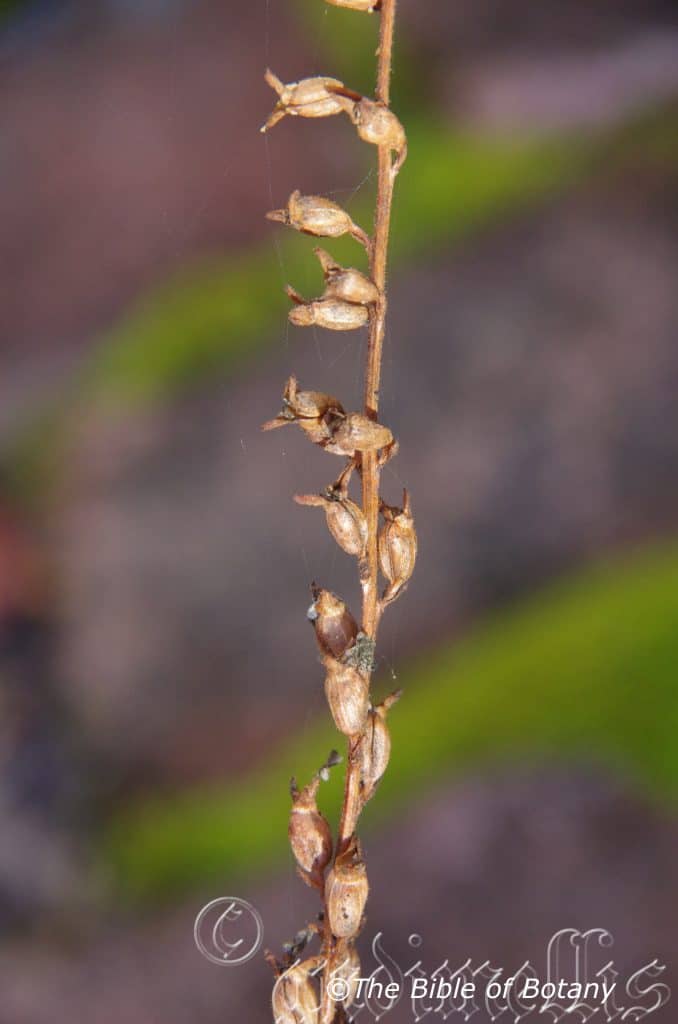
Fortis Creek National Park NSW
Stylidium graminifolium
Classification:
Unranked: Eudicots
Class: Asterids
Order: Asterales
Family: Stylidiaceae
Subfamily: Stylidioideae
Genus: From St?los, which is Ancient Greek for a column or later Greek for a part of the female reproductive organ between the ovaries and the stigma. It refers to styles, which have become specialized in having a trigger which pulls the stigma in contact with the insect pollinator.
Subgenus: Tolypangium
Specie: From Gramine, which is Latin for grass like and Folium, which is Latin for foliage. It refers to plants, which have leaves which resemble many grasses.
Sub specie:
Common Name: Grass Trigger Plant
Distribution:
Stylidum graminifolium is found in 2 disjunct populations along the east coast. The northern population is found between the Windsor Tablelands and Ravenshoe in far north eastern Queensland.
The southern population is found south from Mimosa Creek in central eastern Queensland to Kangaroo Island in southern South Australia. It is mainly found on the Western Plains, on and east of the Great Dividing Range to the coast.
It is also found on the Bass Straight Islands and Tasmania.
https://avh.ala.org.au/occurrences/search?taxa=Stylidium+graminifolium#tab_mapView
Habitat Aspect Climate:
Stylidum graminifolium prefers light shade to full sun. It grows in dry sclerophyll forests. The altitude ranges from 15 meters ASL to 1520 meters ASL.
The temperatures range from minus 5 degrees in August to 36 degrees in January.
The rainfalls range from lows of 520mm to 3200mm average per annum.
Soil Requirements:
Stylidum graminifolium prefer to grow on nutrient poor fine sands, course sands to light fatty clays. The soils are usually derived from decomposed granites, sandstones or accumulated beach sands. The soils pH ranges from 6pH to 7pH. It does not tolerate water logged soils. Non saline soils to slightly saline soils are tolerated.
Height & Spread:
Wild Plants: 0.3m to 0.7m by 0.2m to 0.3m when in flower.
Characteristics:
Stylidum graminifolium grows as a perennial tufted herb with erect grass like leaves from the base.
The basally tufted linear leaves measure 50mm to 260mm in length by 2mm to 6mm in width. The bases are clasping while the apex is acute to broadly acute. The concolourous laminas are deep blue-green to deep green, dull, and glabrous. The leaf margins are entire to finely tooth. The mid vein is prominent on the lower lamina and is clearly visible from the upper lamina.
The inflorescences are born on a raceme from the center of the rosette of basal leaves. The pale green to deep green raceme usually measures half the length of the peduncle. The peduncle is sparsely covered in white, reddish tipped glandular hairs at the base becoming to densely covered at the racemes apex. The pale green to deep green scapes measure 30mm to 700mm in length. The flowers are shortly pedicellate.
The ovary reddish-green to green ovary is moderately to densely covered in white tipped reddish glandular hairs. The oblong, inferior ovary measures 4.5mm to 5.5mm in length. The mid green deep green sepals are moderately to densely covered in white, reddish tipped glandular hairs. The 4 oblong sepals measure 1mm to 2mm in length. The greenish-yellow to yellow-green corolla tube is glabrous and measures 5mm to 10mm in length. The 4 lobes are pink, bright mauve or reddish-pink. The dimorphic lobes are sparsely to sparsely to moderately covered in white, reddish tipped glandular hairs externally and measure 4mm to 8mm in length.
The reddish-orange trigger mechanism measures 8mm to 10mm in length and recurves 90 degrees at 7mm to 8mm from the base. The lateral, pale green spherical apex has a relatively large spherical pollen presenter which is covered in short white hirsute hairs. The measures 2mm to 2.5mm in length by 1.8mm to 2mm in diameter. The white anthers are exserted and are covered in fringed glands. The flowers appear from August to January.
The fruits are ovoidal to obloidal angulated capsules. The capsules measure 5mm to 12mm in length by 12mm to 22mm in diameter. The green capsules turn grey-brown when ripe. The tawny-brown seeds are smooth and glabrous.
Wildlife:
Stylidum graminifolium flowers attracts native bees like Exoneura robusta, Exoneura angophorae and Lasioglossum lanarium to carry out their pollination.
Cultivation:
Stylidum graminifolium is an unusual addition for the keen gardener who is looking for something different yet still easy to grow. It is ideal in settings near ponds in court yards or the rockery. It needs strong sun light to very light shade and controlled moisture levels to grow at its best.
To make a bog garden, extend the pond or to make an artificial marshland on sand all you need is a sheet of black plastic and some rocks. Dig the soil out and lay two or three layers of black plastic on the shallow depression. Before backfilling the plastic to the original level with sand and peat mixed at a ratio of 1 to 4 perforate the plastic to allow excess water drain and prevent stagnation. Make sure the sand is free of salt. If it isn’t the wash the sand several times to make sure the salt is completely removed. Fill the depression with water until it is within 50mm of the surface. Place the rocks around the perimeter so that it looks natural. Make a depression with your arm in the corner on the low side so excess water can drain away when it rains.
I like to use some of the small Juncus like Juncus bufonius or Juncus planifolius as a base and back drop when growing carnivorous plants as most are small and they look more natural when planted around or amongst the sedges.
Carefully remove the plants from their pots and plant them into their artificial wallum. Do not fertilize.
The best thing about the carnivorous plants is you can grow a large number in a small area. They often reach their full potential in just 1 growing season. If the water level is kept topped up it is really very easy to grow and maintain. Drosera binata is one of the easiest to grow.
Propagation:
Seeds: The seeds can be removed easily from the mature pods.
To treat the seeds by placing them in hot, not boiling water and allow them to soak for a couple of hours. Another method is to lightly rub the seeds on fine sand paper to remove part of the outer testa.
Sow freshly treated seeds directly into peat jiffy pots, keeping them moist not wet. Do not over water as the seeds will rot off before germination takes place. Place the trays in a warm sunny area. When the seedlings roots appear at the bottom or sides of the pots place them into their permanent position in the ground or plant them into hanging baskets for something colourful and different.
Fertilize using Seaweed or fish emulsion on planting out to maintain better health, vitality and flowering.
Further Comments from Readers:
“Hi reader, it seems you use The Bible of Botany a lot. That’s great as we have great pleasure in bringing it to you! It’s a little awkward for us to ask, but our first aim is to purchase land approximately 1,600 hectares to link several parcels of N.P. into one at The Pinnacles NSW Australia, but we need your help. We’re not salespeople. We’re amateur botanists who have dedicated over 30 years to saving the environment in a practical way. We depend on donations to reach our goal. If you donate just $5, the price of your coffee this Sunday, We can help to keep the planet alive in a real way and continue to bring you regular updates and features on Australian plants all in one Botanical Bible. Any support is greatly appreciated. Thank you.”
In the spirit of reconciliation we acknowledge the Bundjalung, Gumbaynggirr and Yaegl and all aboriginal nations throughout Australia and their connections to land, sea and community. We pay our respect to their Elders past, present and future for the pleasures we have gained.
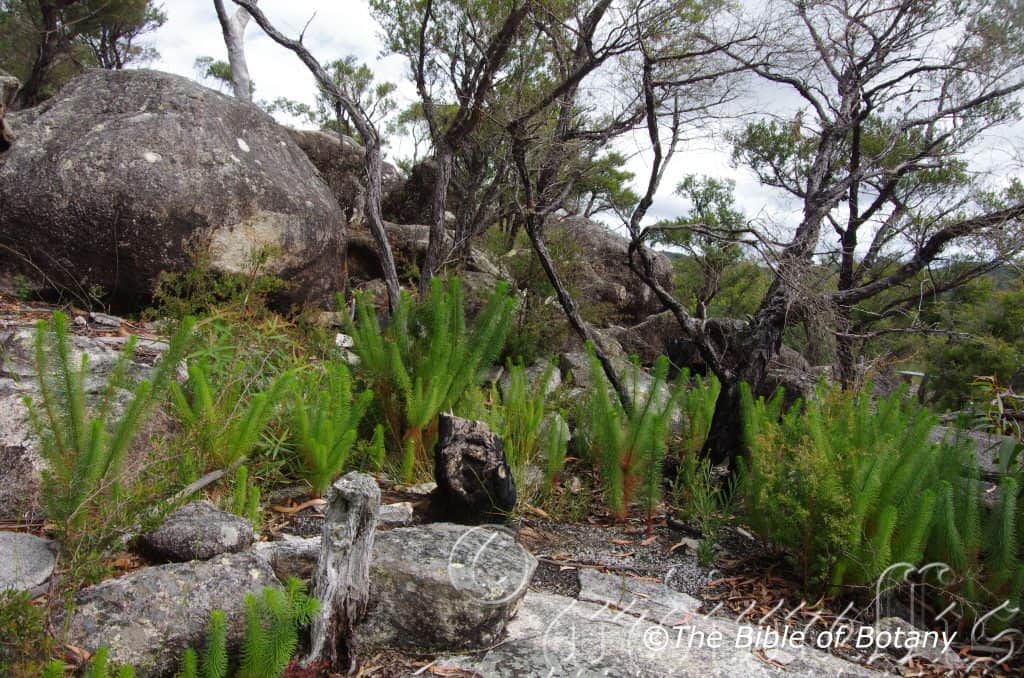
Washpool National Park NSW
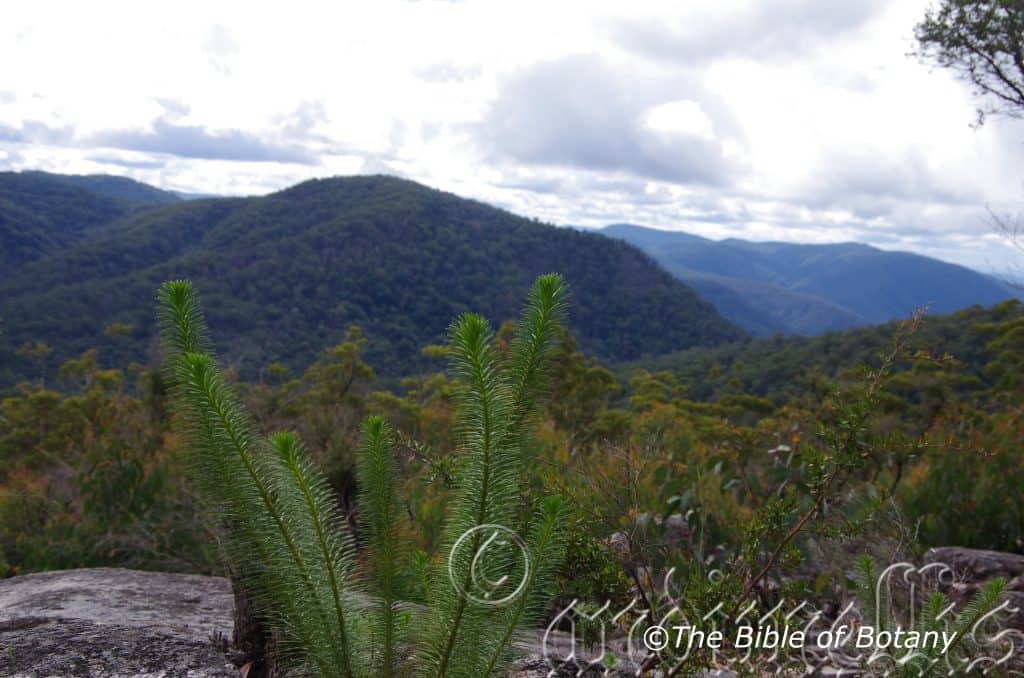
Washpool National Park NSW
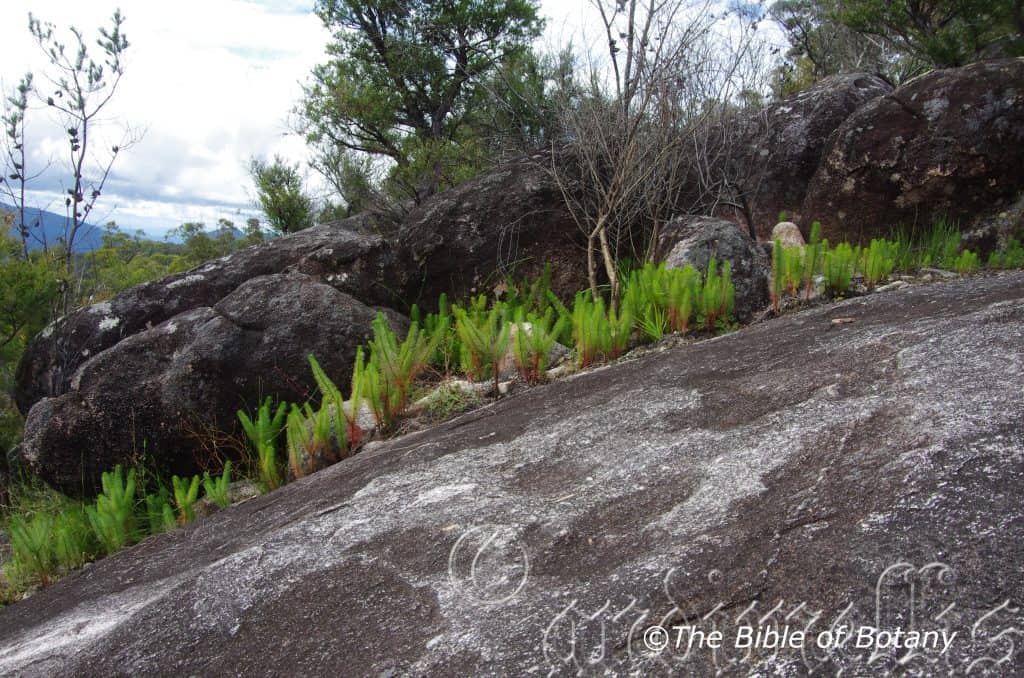
Washpool National Park NSW
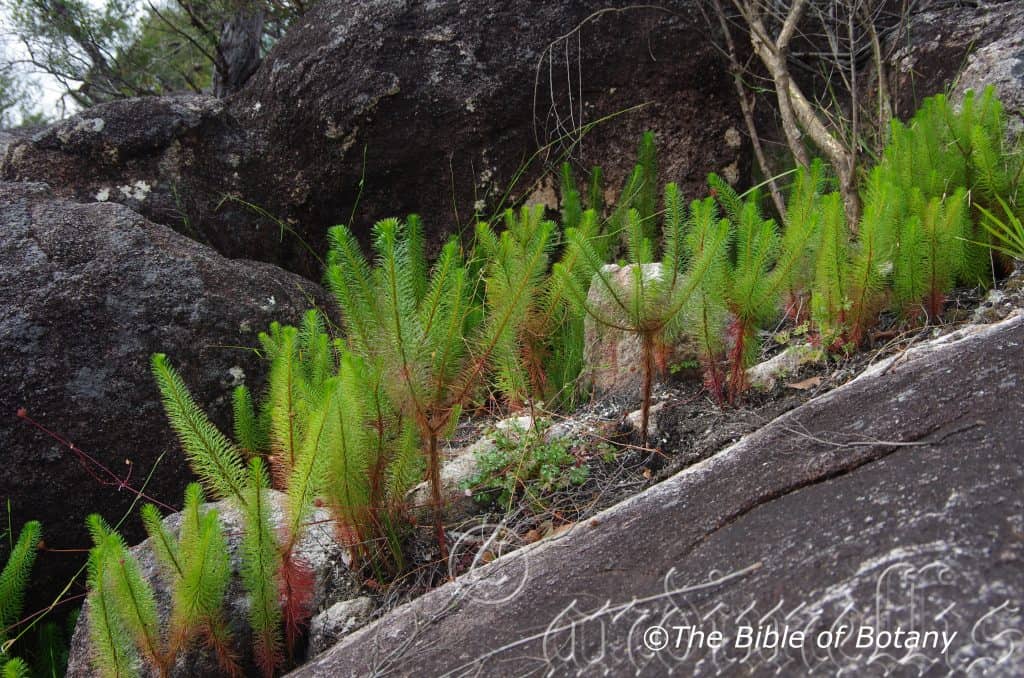
Washpool National Park NSW
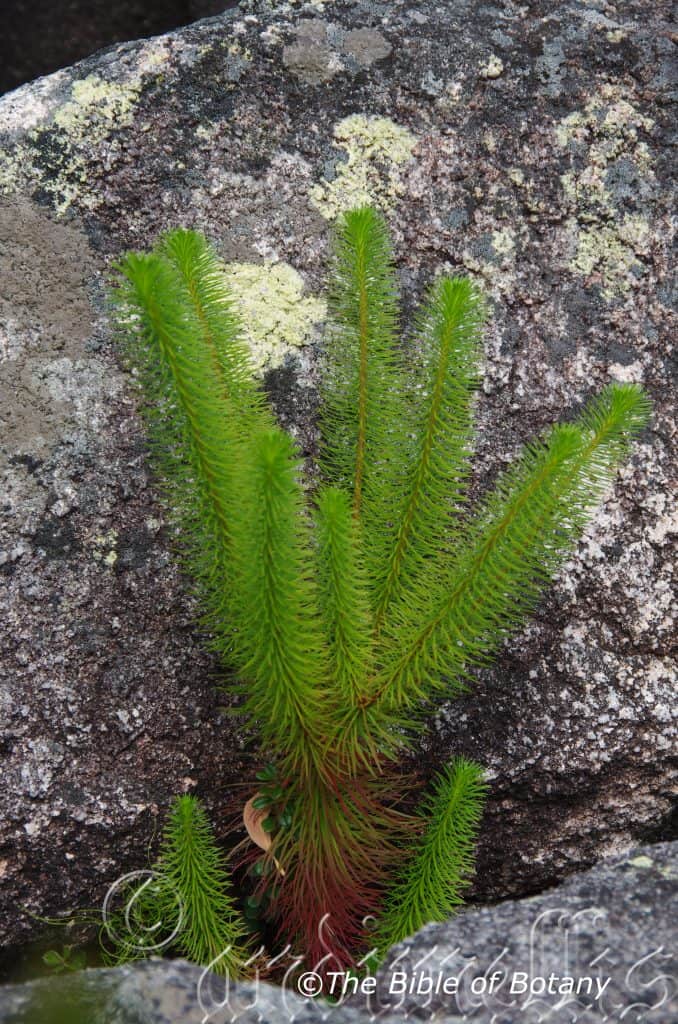
Washpool National Park NSW
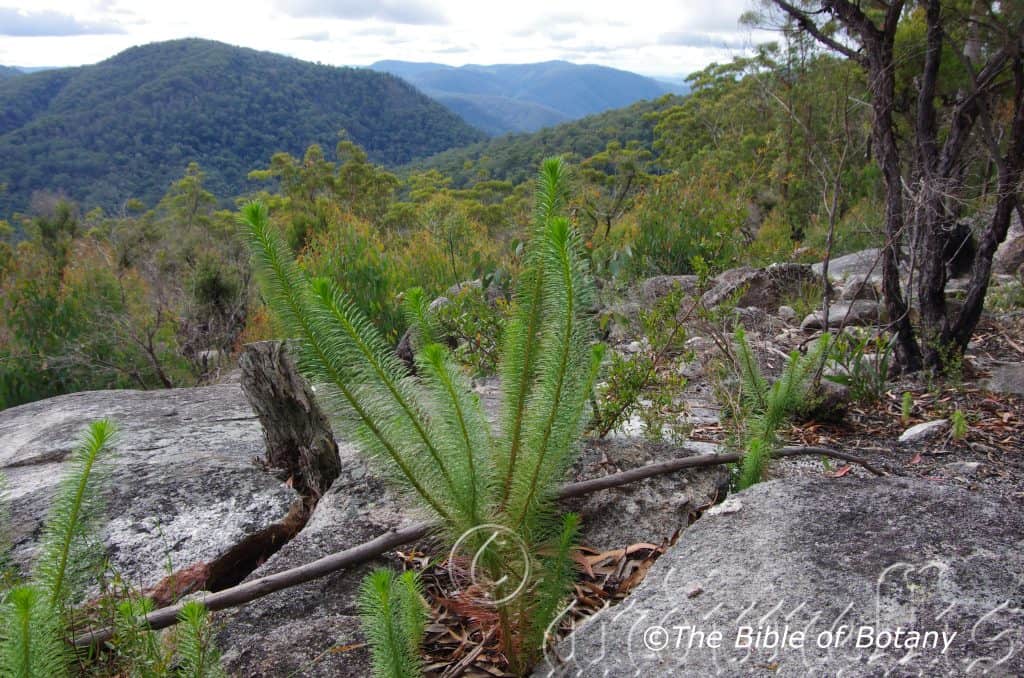
Washpool National Park NSW
Stylidium laricifolium
Classification:
Unranked: Eudicots
Class: Asterids
Order: Asterales
Family: Stylidiaceae
Subfamily: Stylidioideae
Genus: From St?los, which is Ancient Greek for a column or later Greek for a part of the female reproductive organ between the ovaries and the stigma. It refers to styles, which have become specialized in having a trigger which pulls the stigma in contact with the insect pollinator.
Subgenus: Tolypangium
Specie: From Laric, which is Latin for Larix or a Larch and Folium, which is Latin for foliage. It refers to leaves, which have a close resemblance to some of the European Larchs which belong to the Larix genus.
Sub specie:
Common Name: Giant Trigger Plant or Tree Trigger Plant.
Distribution:
Stylidium laricifolium is widespread south from Rollestone in south eastern Queensland to Wingan inlet in far north eastern Victoria. It is found on both sides of the Great Dividing Range to the coast.
https://avh.ala.org.au/occurrences/search?taxa=Stylidium+laricifolium#tab_mapView
Habitat Aspect Climate:
Stylidium laricifolium prefers light shade to full sun. It grows in cool and warm dry sclerophyll forest in mountainous or hilly country on rocky and boulder terrain. The altitude ranges from 30 meters ASL to 1260 meters ASL.
The temperatures range from minus 4 degrees in August to 40 degrees in January.
The rainfalls range from lows of 800mm to 1900mm average per annum, however orographic precipitation would add considerably to this amount and keeps the rock surfaces moist over prolonged periods.
Soil Requirements:
Stylidium laricifolium prefers nutrient poor fine sands, course sands or sandy loams. The soils are usually derived from decomposed sandstones or granites or at times coarse sandy black basalts. The soils pH ranges from 5pH to 6.5pH. It does not tolerate water logged soils. Non saline soils to slightly saline soils are tolerated.
Height & Spread:
Wild Plants: 0.2m to 1.5m by 0.1m to 0.5m when in flower.
Characteristics:
Stylidium laricifolium grows as a perennial sub shrub with glabrous stems.
The alternate, crowded, linear leaves measure 10mm to 40mm in length by 0.9mm to 1.2mm in width. The bases are sessile while the apexes are acute. The concolourous laminas are green, dull, and glabrous. The leaf margins are entire, and often revolute.
The inflorescences are born on a panicle from the center of the rosette of basal leaves. The panicle has one main stem and several lesser racemes. The reddish-green to yellow-green panicle measures 150mm to 450mm in length and are glabrous at the base and moderately to densely covered in white, reddish tipped glandular hairs at the apexes.
The reddish-green to grass-green ovary is moderately to densely covered in white, reddish tipped glandular hairs. The oblong, inferior ovary measures 3mm to 4mm in length. The mid green sepals are moderately to densely covered in white, reddish tipped glandular hairs. The sepals measure 1.5mm to 2mm in length. The white corolla tube is glabrous and measures 10mm to 15mm in length. The 4 lobes are white at the base while the surfaces are pink, bright mauve or deep pink. The slightly dimorphic lobes are very sparsely to sparsely covered in white, reddish tipped glandular hairs externally and measure 10mm to 15mm in length.
The trigger mechanism is pinkish at the base then turns reddish-green and white at the apex. The trigger mechanism measures 9mm to 14mm in length and recurves 165 degrees at 6mm to 10mm from the base. The lateral, clavate apex is covered in long white hirsute hairs and measures 1.5mm to 2mm in length by 1mm to 1.5mm in diameter. The flowers appear from September to December.
The fruits are obloidal capsules. The capsules measure 8mm to 12mm in length. The green capsules turn deep grey-brown when ripe. The numerous seeds are deep brown, smooth and glabrous.
Wildlife:
Stylidium laricifolium’s wildlife is unknown to the author.
Cultivation:
Stylidium laricifolium is an unusual addition for the keen gardener who is looking for something different yet still easy to grow. It would be ideal in settings near ponds in court yards placed on flat, granite boulders where a microclimate of high humidity can be maintained, with some moisture remaining on the rocks. It needs strong sun light to very light shade to grow at its best.
It is best planted at the edge of a bog garden as it prefers drier conditions than most carnivorous plants. To make a bog garden, extend the pond or to make an artificial marshland on sand all you need is a sheet of black plastic and some rocks. Dig the soil out and lay two or three layers of black plastic on the shallow depression. Before backfilling the plastic to the original level with sand and peat mixed at a ratio of 1 to 4 perforate the plastic to allow excess water drain and prevent stagnation. Make sure the sand is free of salt. If it isn’t the wash the sand several times to make sure the salt is completely removed. Fill the depression with water until it is within 50mm of the surface. Place the rocks around the perimeter so that it looks natural. Make a depression with your arm in the corner on the low side so excess water can drain away when it rains.
I like to use some of the small Juncus like Juncus bufonius or Juncus planifolius as a base and back drop when growing carnivorous plants as most are small and they look more natural when planted around or amongst the sedges.
Carefully remove the plants from their pots and plant them into their artificial wallum. Do not fertilize.
The best thing about the carnivorous plants is you can grow a large number in a small area. They often reach their full potential in just 1 growing season. If the water level is kept topped up it is really very easy to grow and maintain. Drosera binata is one of the easiest to grow.
Propagation:
Seeds: The seeds can be removed easily from the mature pods.
To treat the seeds by placing them in hot, not boiling water and allow them to soak for a couple of hours. Another method is to lightly rub the seeds on fine sand paper to remove part of the outer testa.
Sow freshly treated seeds directly into peat jiffy pots, keeping them moist not wet. Do not over water as the seeds will rot off before germination takes place. Place the trays in a warm sunny area. When the seedlings roots appear at the bottom or sides of the pots place them into their permanent position in the ground or plant them into hanging baskets for something colourful and different.
Fertilize using Seaweed or fish emulsion on planting out to maintain better health, vitality and flowering.
Further Comments from Readers:
“Hi reader, it seems you use The Bible of Botany a lot. That’s great as we have great pleasure in bringing it to you! It’s a little awkward for us to ask, but our first aim is to purchase land approximately 1,600 hectares to link several parcels of N.P. into one at The Pinnacles NSW Australia, but we need your help. We’re not salespeople. We’re amateur botanists who have dedicated over 30 years to saving the environment in a practical way. We depend on donations to reach our goal. If you donate just $5, the price of your coffee this Sunday, We can help to keep the planet alive in a real way and continue to bring you regular updates and features on Australian plants all in one Botanical Bible. Any support is greatly appreciated. Thank you.”
In the spirit of reconciliation we acknowledge the Bundjalung, Gumbaynggirr and Yaegl and all aboriginal nations throughout Australia and their connections to land, sea and community. We pay our respect to their Elders past, present and future for the pleasures we have gained.
Stylidium paniculatum
Classification:
Unranked: Eudicots
Class: Asterids
Order: Asterales
Family: Stylidiaceae
Subfamily: Stylidioideae
Genus: From St?los, which is Ancient Greek for a column or later Greek for a part of the female reproductive organ between the ovaries and the stigma. It refers to styles, which have become specialized in having a trigger which pulls the stigma in contact with the insect pollinator.
Subgenus: Tolypangium
Specie: From Panos, which is Ancient Greek or P?nicula, which is Latin for a flower head. It refers to many flowers, which are arranged in a compact head.
Sub specie:
Common Name: Frail Trigger Plant
Distribution:
Stylidium paniculatum is restricted to an area between Middle Creek near Inverell to Severn River Falls, Watson’s Swamp near Amiens, Tooloom Falls and Boonoo Boonoo National Park with a population further south east at South West Rocks.
https://avh.ala.org.au/occurrences/search?taxa=Stylidium+paniculatum#tab_mapView
Habitat Aspect Climate:
Stylidium paniculatum prefers light shade to full sun. It grows in open cool mountainous woodlands or adjacent to mountainous heaths or slopes. The altitude ranges from 340 meters ASL to 880 meters ASL.
The temperatures range from minus 3 degrees in August to 36 degrees in January.
The rainfalls range from lows of 100mm to 500mm average per annum.
Soil Requirements:
Stylidium paniculatum prefers nutrient poor course orange, red or reddish-brown sands, fine sands or sandy loams. The soils are usually derived from decomposed sandstones or at times granites. The soils pH ranges from 6pH to 7pH. It does not tolerate water logged soils. Non saline soils to slightly saline soils are tolerated.
Height & Spread:
Wild Plants: 0.2m to 0.6m by 0.6m to 1.4m
Characteristics:
Stylidium paniculatum grows as a perennial herb with loose rosette basal leaves and leaves at apex of a short stem. The leaves are often scattered with several smaller leaves below the apical leaves.
The spathulate to obovate rosette leaves measure 5mm to 35mm in length by 4mm to 8mm in width. The pale green, fleshy petioles are glabrous and measure 6mm to 8mm in length. The bases taper along the attenuate petiole while the apexes are apiculate. The concolourous laminas are pale green, dull and glabrous. The laminas are concave on the upper laminas while the margins are entire. The obtuse mid vein is prominent on the basal half of the lower lamina and is not visible from the upper lamina.
The inflorescences of are born on a panicle from the center of the rosette of basal leaves. The reddish-green to pale green scapes measure 50mm to 350mm in length and are moderately to densely covered in white, reddish tipped glandular hairs.
The reddish-green to green ovary is moderately to densely covered in white tipped reddish glandular hairs. The oblong, inferior measures 1.5mm to 2mm in length. The mid green deep green sepals are moderately to densely covered in white, reddish tipped glandular hairs. The sepals measure 1mm to 1.5mm in length. The greenish-yellow to yellow-green corolla tube is glabrous and measures 2mm to 4mm in length. The 4 lobes are white at the base while the surfaces are pink, bright mauve or reddish-pink. The dimorphic lobes are very sparsely to sparsely covered in white, reddish tipped glandular hairs and measure 3mm to 5mm in length.
The trigger mechanism measures 4mm to 5mm in length and recurves 130 degrees at 2mm to 2.5mm from the base. The lateral, clavate apex is covered in long white hirsute hairs and measures 1.5mm to 2mm in length by 1mm to 1.5mm in diameter. The flowers appear from July through to October to May.
The fruits are narrow obloidal capsules.
Confusing Species:
Stylidium paniculatum’s flowers are in a panicle. The trigger mechanisms bend is 50 degrees.
Stylidium debile’s flowers are in a raceme. The trigger mechanisms bend is 50 degrees.
Wildlife:
Stylidium paniculatum wildlife is unknown to the author.
Cultivation:
Stylidium paniculatum is an unusual addition for the keen gardener who is looking for something different yet still easy to grow. It is ideal in settings near ponds in court yards or the rockery. It needs strong sun light to very light shade to grow at its best.
To make a bog garden, extend the pond or to make an artificial marshland on sand all you need is a sheet of black plastic and some rocks. Dig the soil out and lay two or three layers of black plastic on the shallow depression. Before backfilling the plastic to the original level with sand and peat mixed at a ratio of 1 to 4 perforate the plastic to allow excess water drain and prevent stagnation. Make sure the sand is free of salt. If it isn’t the wash the sand several times to make sure the salt is completely removed. Fill the depression with water until it is within 50mm of the surface. Place the rocks around the perimeter so that it looks natural. Make a depression with your arm in the corner on the low side so excess water can drain away when it rains.
I like to use some of the small Juncus like Juncus bufonius or Juncus planifolius as a base and back drop when growing carnivorous plants as most are small and they look more natural when planted around or amongst the sedges but can become overpowering. It would make a good addition around small carnivourous plants like Drosera burmanni, Drosera spathulata, Drosera peltata, Drosera binata grows naturally in the same area and is also a small upright plant of similar size and frail looking or Cephalotus follicularis to mention a few of our beautiful natives.
Carefully remove the plants from their pots and plant them into their artificial wallum. Do not fertilize.
The best thing about the carnivorous plants is you can grow a large number in a small area. It will reach its full potential in just 1 growing season. If the water level is kept topped up it is really very easy to grow and maintain. Drosera binata is one of the easiest to grow. Remember these are annuals so seed needs to be sown on a regular basis to maintain a coverage.
Propagation:
Seeds: The seeds can be removed easily from the mature pods.
To treat the seeds by placing them in hot, not boiling water and allow them to soak for a couple of hours. Another method is to lightly rub the seeds on fine sand paper to remove part of the outer testa.
Sow freshly treated seeds directly into peat jiffy pots, keeping them moist not wet. Do not over water as the seeds will rot off before germination takes place. Place the trays in a warm sunny area. When the seedlings roots appear at the bottom or sides of the pots place them into their permanent position in the ground or plant them into hanging baskets for something colourful and different.
Fertilize using Seaweed or fish emulsion on planting out to maintain better health, vitality and flowering.
Further Comments from Readers:
“Hi reader, it seems you use The Bible of Botany a lot. That’s great as we have great pleasure in bringing it to you! It’s a little awkward for us to ask, but our first aim is to purchase land approximately 1,600 hectares to link several parcels of N.P. into one at The Pinnacles NSW Australia, but we need your help. We’re not salespeople. We’re amateur botanists who have dedicated over 30 years to saving the environment in a practical way. We depend on donations to reach our goal. If you donate just $5, the price of your coffee this Sunday, We can help to keep the planet alive in a real way and continue to bring you regular updates and features on Australian plants all in one Botanical Bible. Any support is greatly appreciated. Thank you.”
In the spirit of reconciliation we acknowledge the Bundjalung, Gumbaynggirr and Yaegl and all aboriginal nations throughout Australia and their connections to land, sea and community. We pay our respect to their Elders past, present and future for the pleasures we have gained.
Styphelia triflora
Classification:
Unranked: Eudicots
Class: Asterids
Order: Ericales
Family: Ericaceae
Subfamily: Styphelioideae
Tribe: Stypheliae
Genus: From Styphelos, which is Ancient Greek for dense. It refers to growth habits, which in its natural environment and in cultivation is very dense.
Specie: From Treîs/Tría, which are Ancient Greek or Tri, which is Latin for three and Fl?ris, which is Latin for a flower or Fl?s, which is Roman for the Goddess of spring and flowers. It refers to plants, which have three flowers from each leaf node.
Sub specie:
Common Name: Pink Five Corners.
Distribution:
Styphelia triflora is found east of a line from Brisbane to Millmerran in south eastern Queensland to the Gwydir River, Bogan Gate near Parkes, Queanbeyan and Nowra with a single population further south in the Bega Valley.
https://avh.ala.org.au/occurrences/search?taxa=Styphelia+triflora#tab_mapView
Habitat Aspect Climate:
Styphelia triflora prefer light shade to full sun. It grows in open sclerophyll forest and woodland in association with various Casuarina and Callitris species. The altitude ranges from 20 meters ASL to 1070 meters ASL.
The temperatures range from minus 4 degrees in August to 36 degrees in January.
The rainfalls range from lows of 400mm to 1800mm average per annum.
Soil Requirements:
Styphelia triflora prefers sandy soils or sandy loams over various substrates. The soils are usually derived from decomposed granites, sandstones or at times alluvial deposits. The soils pH ranges from 4pH to 5.5pH. It does not tolerate water logged soils. Non saline soils to moderately saline soils are tolerated.
Height & Spread:
Wild Plants: 0.4m to 2m by 0.7m to 1.6m
Characteristics:
Styphelia triflora grows as a spreading open shrub to an erect bushy shrub. The branchlets are glabrous and smooth or rarely scabrous.
The clustered elliptic to oblong-elliptic leaves measure 14mm to 33mm in length by 3mm to 8.5mm in width. The glabrous petioles measure 2mm to 4mm in length. The bases taper to the petioles while the apexes are acute. The appressed, concolourous laminas are mid blue-green, dull and glabrous. The laminas are usually flat or at times slightly concaved and straight while the margins are entire. The parallel veins are faintly visible on the lower laminas and are not visible from the upper lamina.
The juvenile and new seasonal growth leaves are obovate to oblanceolate.
The inflorescences are born singularly or in pairs from the leaf axils. The divaricate to nodding flowers are usually pale pink to pink, red or occasionally cream or pale yellow-green. The pale creamy-yellow, glabrous pedicels measure 3mm to 5mm in length. The 5 pinkish, glabrous bracteoles measure 2.8mm to 5.6mm in length. The 5 long narrow lanceolate, glabrous sepals are usually pale pink to pink, red or occasionally cream or pale yellow-green. The sepals measure 8.2mm to 13.4mm in length. The glabrous corolla tube measures 13.5mm to 29.4mm in length. The lobes are strongly revolute and are densely covered in long, soft, white villous hairs internally especially on the apical half. The lobes measure12.5mm to 18mm in length.
The filiform, usually pale pink to pink, red or occasionally cream or pale yellow-green filaments measure 9mm to 17.2mm in length. The deep brown or brownish-maroon dorsifixed, fusiform anthers measure 3mm to 5mm in length by 0.5mm to 0.7mm in diameter.
The ovary is glabrous. The filiform pastel yellow-green to pale yellow-green style measures 9mm to 18mm in length. The flowers appear throughout the year with a peak from July to October.
The fruits are finely ribbed drupes. The drupes measure 6.5mm to 8mm in length. The green capsules turn deep grey-brown when ripe.
Wildlife:
Styphelia triflora flowers are very attractive to most small honeyeaters like Acanthorhynchus tenuirostris.
Cultivation:
Styphelia triflora is a very beautiful medium which should be more widely grown in subtropical to cool temperate gardens. It is ideal in small to large gardens especially on sandstone derived soils. In cultivation it grows from 1.5 meters to 1.8 meters in height by 1.5 meters to 1.8 meters in diameter when grown in the open.
It is particularly good around swimming pools adding colour particularly in the winter months when the pool and surrounds are not all that attractive. In formal gardens they break up the foliage of English type gardens without being overpowering.
In Native gardens it can be used to attract honeyeaters or used as a small screen or low hedge row. A straight line can be broken easily and affectively with Styphelia triflora . Place smaller annuals and perennials either side of the path and all of a sudden the path comes to life. Place taller, deep green foliaged or weeping plants in the background to ensure the viewer’s eyes are in constant movement as they walk the bend without noticing the change in direction.
Try using it with a mixture of small Acacias like Acacia brownii, Acacia suaveolens or even Grevillea acanthifolia. For a taller Acacia specie in the background I think of Acacia granitica or Acacia wardellii for something different and strong.
Propagation:
Seeds: The seeds can be removed easily from the mature pods.
Sow fresh seeds directly into a seed raising mix, keeping them moist not wet. Do not over water as the seeds will rot off before germination takes place. Place the trays in a cool shaded area with 20mm shade cloth in the bush house. When the seedlings are 20mm to 25mm tall, prick them out and plant them into 50mm native tubes using a good organic mix.
As the seedlings roots reach the bottom of the tubes plant them out into their permanent position. Do not delay.
Cuttings: Fortunately cuttings strike easy. Use 100mm to 200mm long tip cuttings or lateral shoots from the present season’s growth. Take them in warmer months of the year. Remove half the leaves from the bottom section being careful not to tear the bark.
1 Prepare the cutting mix by adding two thirds sharp clean river sand, one third peat or one third perlite. These ingredients must be sterilized,
2 Select good material from non diseased plants,
3 Select semi green stems for cuttings. Look for a stem with two or three nodes,
4 Place the cutting on a flat, hard surface, and make a clean cut down one side of the cutting at the base for 10mm with a sharp sterile knife or razor blade. – This scarification of the node will increase the chances of roots emerging from this spot. Now remove all but one or two the leaves, leaving the apex leaves in tact. If the leaves are very large in proportion to the stem, cut off the apical halves.
5 Fill a saucer with water, and place a little medium strength rooting hormone into another container like a milk bottle top. Dip the node end of the cutting into the water and then into the rooting hormone. Tap off any excess hormone,
6 Use a small dipple stick or old pencil to poke a hole into the soilless potting mix. Ensure the hole is slightly larger than the stem diameter and be careful not to wipe the rooting hormone off the cuttings base. Place 2 to 4 cuttings in each of the 50mm native tubes,
7 I like to place the tubes in bucket with holes drilled in the bottom to allow excess water to drain out. A plastic bag that fits over the bucket is ideal to help maintain temperature and moisture. Place in a semi shaded, warm position like under 50mm shade cloth.
8 When the cuttings have struck, open the bag to allow air circulation for a few days to a week,
9 Once hardened off remove the cuttings from the bag and allow to further hardening for a few more days to a week,
10 Transplant into a good potting mix to grow on.
Fertilize using seaweed, fish emulsion or organic chicken pellets soaked in water on an alternate basis. Fertilize every two months until the plants are established then twice annually in early September or March to maintain health, vitality and better flowering.
Further Comments from Readers:
“Hi reader, it seems you use The Bible of Botany a lot. That’s great as we have great pleasure in bringing it to you! It’s a little awkward for us to ask, but our first aim is to purchase land approximately 1,600 hectares to link several parcels of N.P. into one at The Pinnacles NSW Australia, but we need your help. We’re not salespeople. We’re amateur botanists who have dedicated over 30 years to saving the environment in a practical way. We depend on donations to reach our goal. If you donate just $5, the price of your coffee this Sunday, We can help to keep the planet alive in a real way and continue to bring you regular updates and features on Australian plants all in one Botanical Bible. Any support is greatly appreciated. Thank you.”
In the spirit of reconciliation we acknowledge the Bundjalung, Gumbaynggirr and Yaegl and all aboriginal nations throughout Australia and their connections to land, sea and community. We pay our respect to their Elders past, present and future for the pleasures we have gained.

The Pinnacles NSW
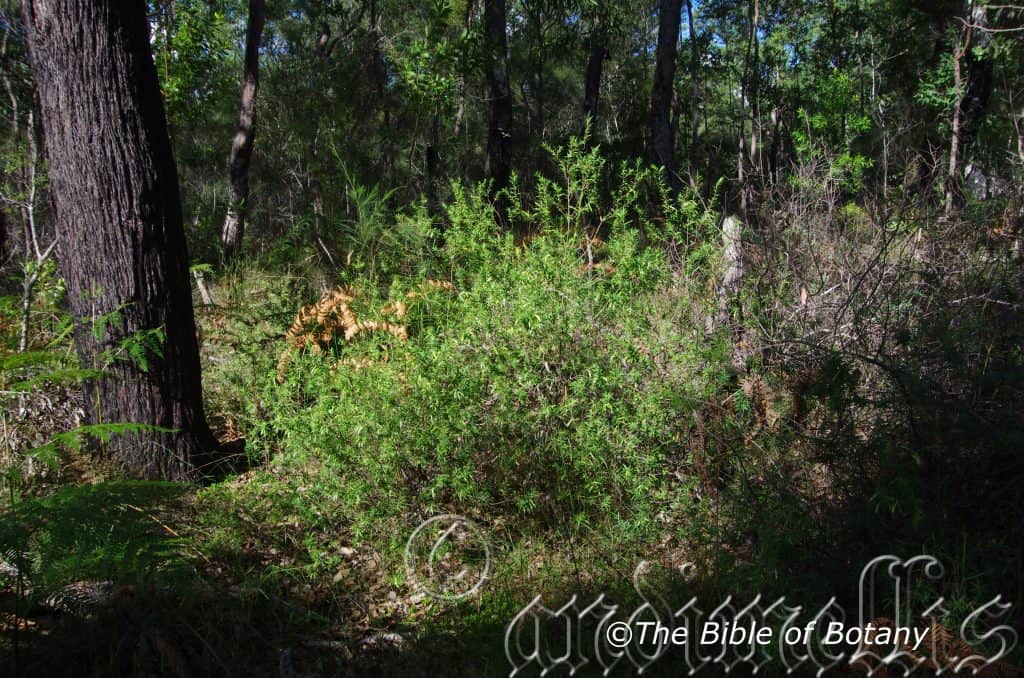
Fortis Creek National Park NSW
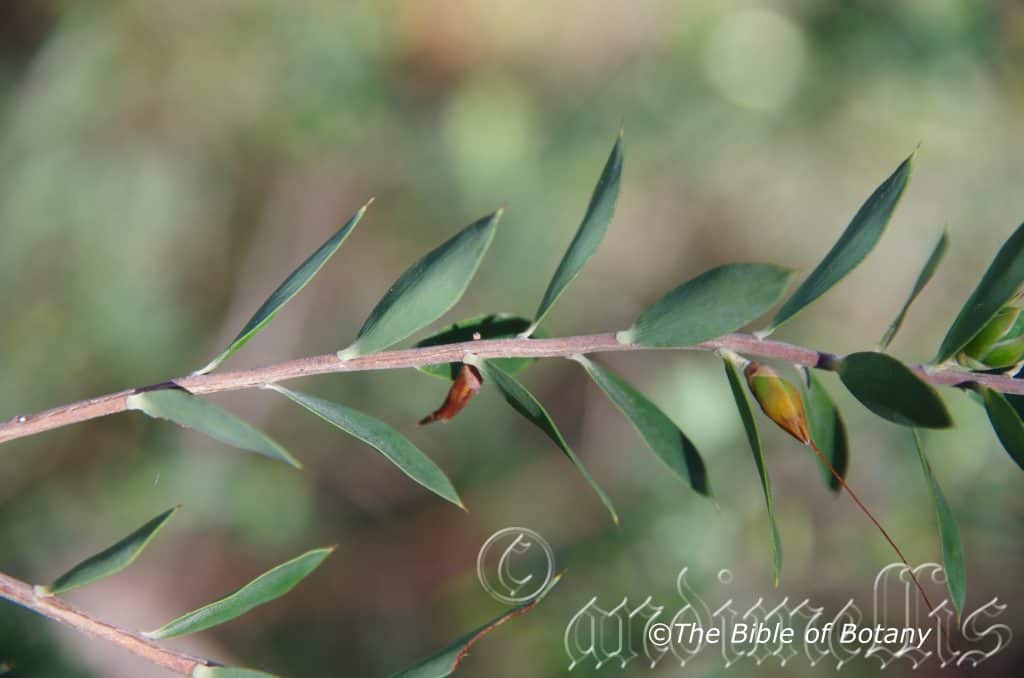
The Pinnacles NSW
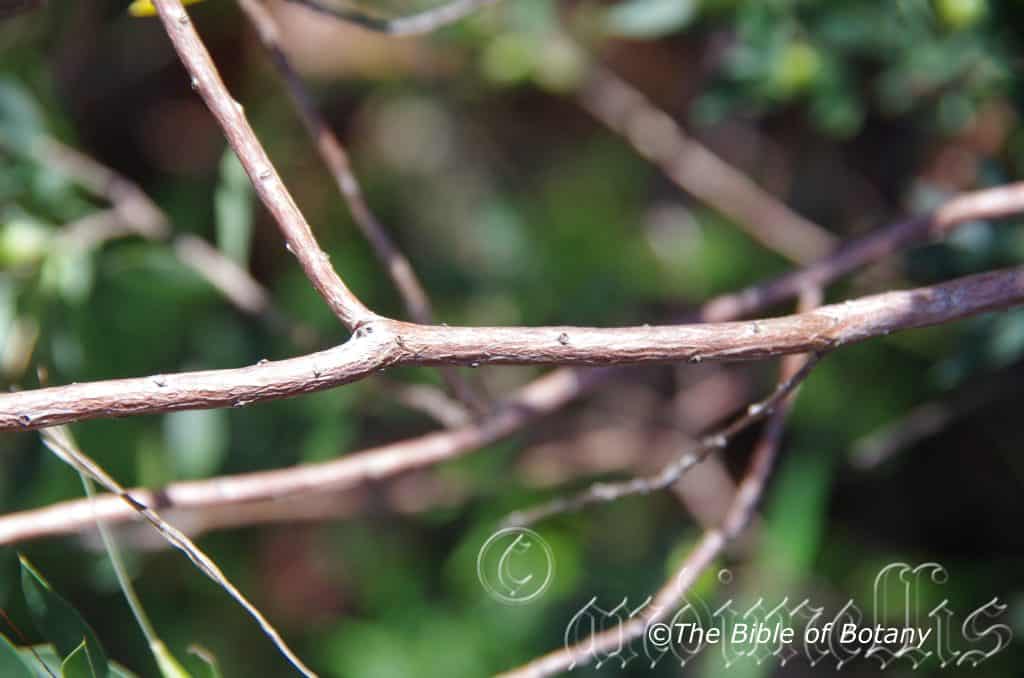
The Pinnacles NSW

The Pinnacles NSW

The Pinnacles NSW
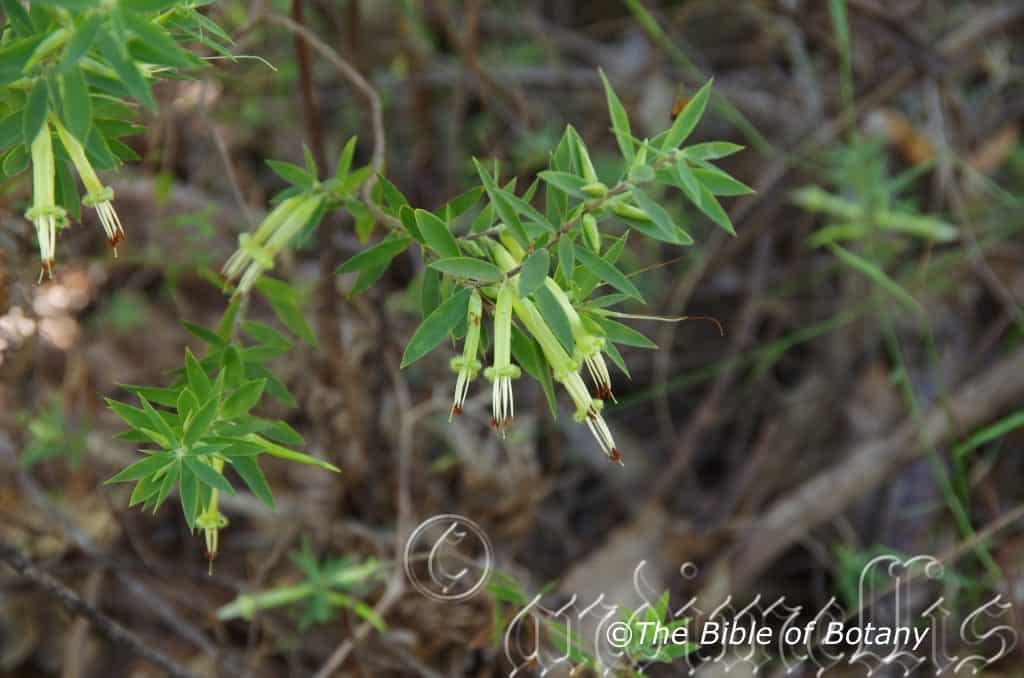
Fortis Creek National Park NSW
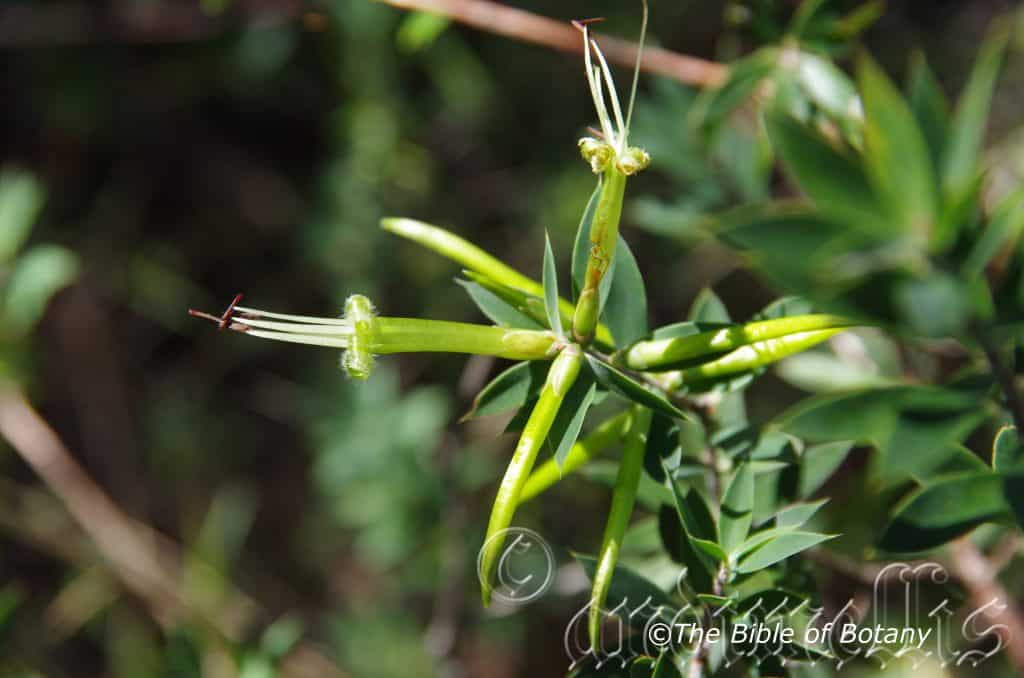
The Pinnacles NSW
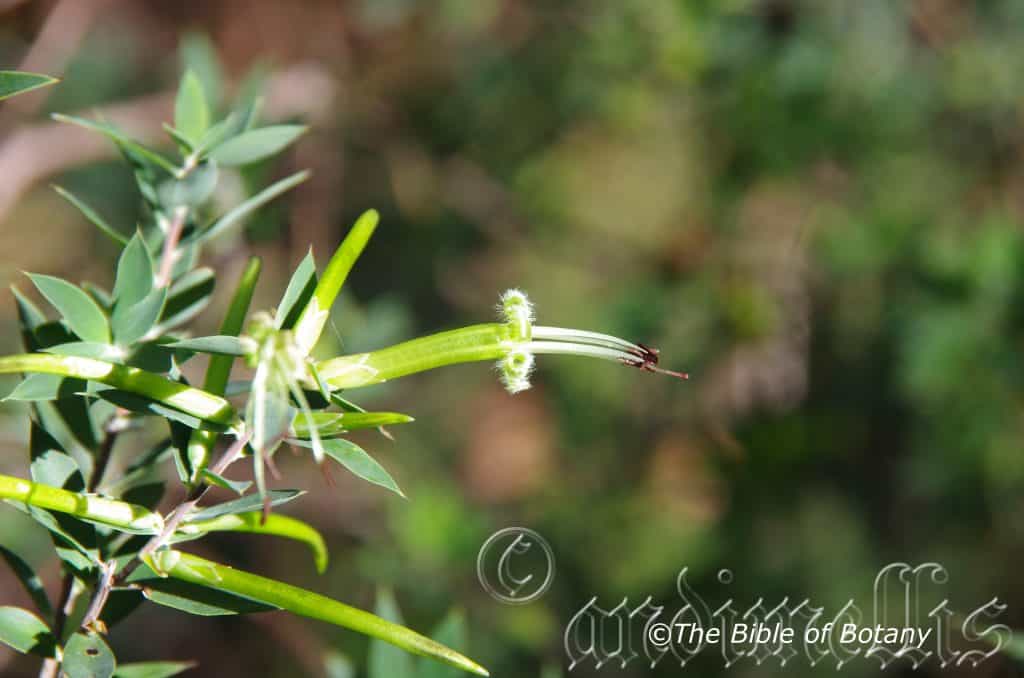
The Pinnacles NSW
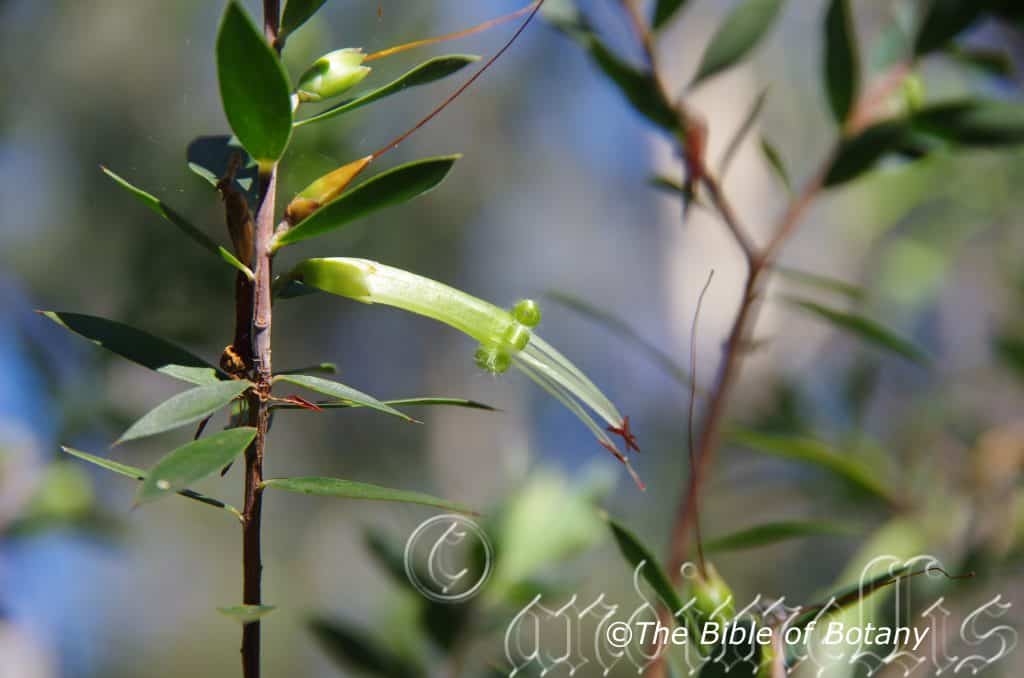
Fortis Creek National Park NSW
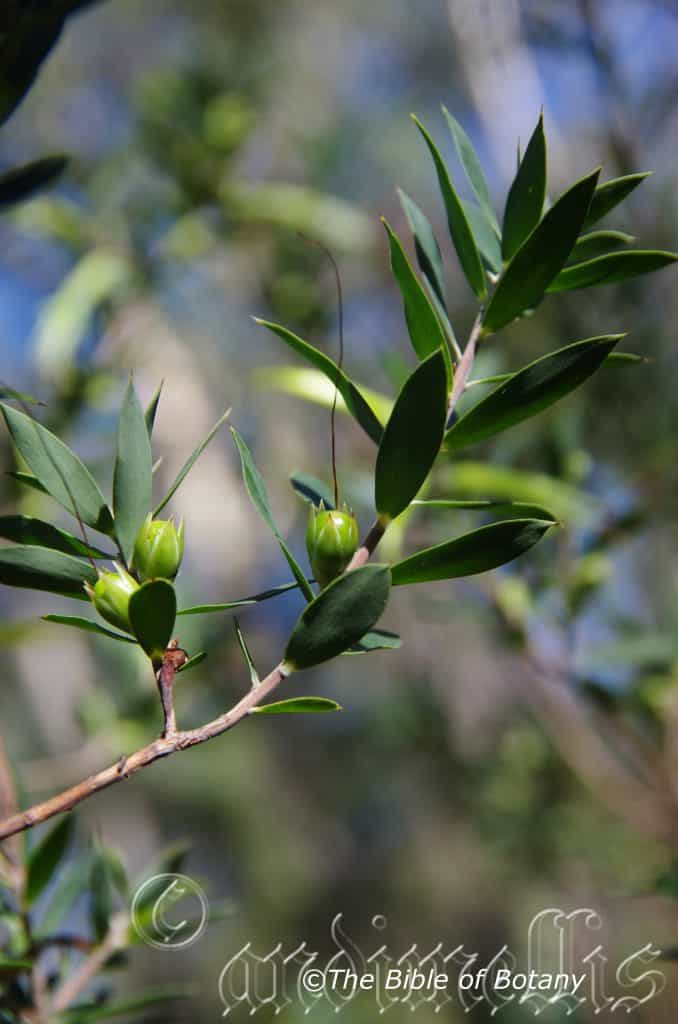
The Pinnacles NSW

Banyabba National Park NSW
Styphelia viridis
Classification:
Unranked: Eudicots
Class: Asterids
Order: Ericales
Family: Ericaceae
Subfamily: Styphelioideae
Tribe: Stypheliae
Genus: From Styphelos, which is Ancient Greek for dense. It refers to growth habits, which in its natural environment and in cultivation is very dense.
Specie: From Virens, which is Latin for green. It refers to any structure or organ, which is bright green.
Sub specie: Styphelia viridis subsp. breviflora. From Brevis, which is Latin for short and Fl?ris which is Latin for a flower or Fl?s, which is Roman for the goddess of spring and flowers. It refers to the corollas or petals, which are much shorter than other species in the genus.
Sub specie: Styphelia viridis subsp. viridis. From Virens, which is Latin for green. It refers to any structure or organ, which is bright green.
Common Name:
Distribution:
Styphelia viridis subsp. breviflora is found south from Fraser Island to Goondiwindi in south eastern Queensland and Parramatta in central coastal New South Wales. It occurs on the western Plains, on and east of the Great Dividing Range.
Styphelia viridis subsp. viridis is found south from Moreton Bay in south east Queensland to Kiama in central coastal New South Wales. It occurs on the coastal strip east of the Great Dividing Range.
https://avh.ala.org.au/occurrences/search?taxa=Styphelia+viridis#tab_mapView
Habitat Aspect Climate:
Styphelia viridis prefer light shade to full sun. It grows in heath or in dry sclerophyll forest. The altitude ranges from 5 meters ASL to 1500 meters ASL.
The temperatures range from minus 4 degrees in August to 38 degrees in January.
The rainfalls range from lows of 400mm to 2100mm average per annum.
Soil Requirements:
Styphelia viridis prefers course sands, fine sands to sandy loams or light silts medium silts. The soils are usually derived from decomposed granites, sandstones or at times alluvial deposits. The soils pH ranges from 4.5pH to 6pH. It does not tolerate water logged soils. Non saline soils to moderately saline soils are tolerated as are salt laden winds.
Height & Spread:
Wild Plants: 0.3m to 1.8m by 0.5m to 1.4m.
Characteristics:
Styphelia viridis grows as an erect shrub or at times as a spreading sub shrub. The stems are pale greyish fawn while the new growth is sparsely to moderately covered in fine soft, white pulverulent hairs.
The crowded oblong, oblong-elliptic to oblong-ovate leaves measure 12mm to 30mm in length by 3mm to 7.5mm in width. The petioles are sparsely to moderately covered in fine soft, white pulverulent hairs and measure 1mm to 2mm in length. The bases are rounded-cuneate while the apexes are shortly apiculate to mucronate. The concolourous laminas are grass-green, pale blue-green to mid blue-green, dull to glossy and glabrous or scabrous near the base on the upper lamina while the lower lamina is glabrous. The laminas are usually flat or at rarely slightly concaved and straight while the margins are entire or minutely fimbriate. The parallel veins are faintly visible on the lower laminas and are not visible from the upper lamina.
The inflorescences are born singularly or in pairs from the leaf axils. The sub erect to divaricate flowers are usually pastel translucent green to pale yellow or pastel yellow-orange. The pale creamy-yellow, glabrous pedicels measure 3mm to 5mm in length. The 5 greenish, glabrous bracteoles are marked reddish on the shallow mucronate apexes and measure 3mm to 5mm in length. The 5 long narrow oblong sepals are usually pastel translucent green to pale yellow or pastel yellow-orange and are glabrous and sparsely to moderately covered in minute, white pulverulent hairs near the apexes. The sepals measure 8.5mm to 16mm in length. The glabrous corolla tube measures 14mm to 23mm in length. The lobes are strongly revolute and are sparsely to moderately covered in long, soft, white pilose hairs internally especially on the apical half. The lobes measure12mm to 21mm in length.
The 5 filiform pastel yellow-green filaments measure 10mm to 16mm in length. The deep brown or brownish-maroon dorsifixed, fusiform anthers measure 3.2mm to 6.3mm in length by 0.7mm to 0.9mm in diameter.
The ovary is glabrous. The filiform pastel yellow-green to pale yellow-green style measures 11mm to 18mm in length.
The ovary is covered in white canescent hairs. The slender style measures 5mm to 11mm in length. The flowers appear from April to September.
The fruits are 5 angulated flat top drupes. The drupes measure 7.3mm to 10mm in length.
Confusing Subspecies Varieties:
Styphelia viridis subsp. viridis leaves are oblong to oblong-obovate and measure 14.8mm to 22.4mm in length by 4.7mm to 7.2mm in width. The bases are obtuse. The petiole measures 0.5mm to 1.1mm in length. The sepals measure 12.4mm to 18mm in length. The anthers measure 4.8mm to 6.8mm in length.
Styphelia viridis subsp. breviflora leaves are oblong to oblong-elliptic and measure 19.6mm to 25.6mm in length by 2.9mm to 4.9mm in width. The bases taper gradually into the 1mm to 2.1mm long petiole. The sepals measure 8.5mm to 13.3mm in length. The anthers measure 3.2mm to 4.5mm in length.
Wildlife:
Styphelia viridis flowers are very attractive to most small honeyeaters like Acanthorhynchus tenuirostris.
Cultivation:
Styphelia viridis is a very beautiful medium size shrub, which should be more widely grown in subtropical to cool temperate gardens. It is ideal in small to large gardens especially on sandstone derived soils. In cultivation it grows from 1.2 meters to 1.5 meters in height by 1.2 meters to 1.5 meters in diameter when grown in the open.
It is particularly good around swimming pools adding colour particularly in the winter months when the pool and surrounds are not all that attractive. In formal gardens they break up the foliage of English type gardens without being overpowering.
In Native gardens it can be used to attract honeyeaters or used as a small screen or low hedge row. A straight line can be broken easily and affectively with Styphelia viridis. Place smaller annuals and perennials either side of the path and all of a sudden the path comes to life. Place taller, deep green foliaged or weeping plants in the background to ensure the viewer’s eyes are in constant movement as they walk the bend without noticing the change in direction.
Try using it with a mixture of small Acacias like Acacia brownii, Acacia suaveolens or even Grevillea acanthifolia. For a taller Acacia specie in the background Acacia granitica could be used for its fine needle like foliage or for a broad leaf Acacia wardellii would be something different and strong.
Propagation:
Seeds: The seeds can be removed easily from the mature pods.
Sow fresh seeds directly into a seed raising mix, keeping them moist not wet. Do not over water as the seeds will rot off before germination takes place. Place the trays in a cool shaded area with 20mm shade cloth in the bush house. When the seedlings are 20mm to 25mm tall, prick them out and plant them into 50mm native tubes using a good organic mix.
As the seedlings roots reach the bottom of the tubes plant them out into their permanent position. Do not delay.
Cuttings: Cuttings rather difficult to strike. Use 100mm to 200mm long tip cuttings or lateral shoots from the present season’s growth. Take them in warmer months of the year. Remove half the leaves from the bottom section being careful not to tear the bark.
1 Prepare the cutting mix by adding two thirds sharp clean river sand, one third peat or one third perlite. These ingredients must be sterilized,
2 Select good material from non diseased plants,
3 Select semi green stems for cuttings. Look for a stem with two or three nodes,
4 Place the cutting on a flat, hard surface, and make a clean cut down one side of the cutting at the base for 10mm with a sharp sterile knife or razor blade. – This scarification of the node will increase the chances of roots emerging from this spot. Now remove all but one or two the leaves, leaving the apex leaves in tact. If the leaves are very large in proportion to the stem, cut off the apical halves.
5 Fill a saucer with water, and place a little medium strength rooting hormone into another container like a milk bottle top. Dip the node end of the cutting into the water and then into the rooting hormone. Tap off any excess hormone,
6 Use a small dipple stick or old pencil to poke a hole into the soilless potting mix. Ensure the hole is slightly larger than the stem diameter and be careful not to wipe the rooting hormone off the cuttings base. Place 2 to 4 cuttings in each of the 50mm native tubes,
7 I like to place the tubes in bucket with holes drilled in the bottom to allow excess water to drain out. A plastic bag that fits over the bucket is ideal to help maintain temperature and moisture. Place in a semi shaded, warm position like under 50mm shade cloth.
8 When the cuttings have struck, open the bag to allow air circulation for a few days to a week,
9 Once hardened off remove the cuttings from the bag and allow to further hardening for a few more days to a week,
10 Transplant into a good potting mix to grow on.
Fertilize using seaweed, fish emulsion or organic chicken pellets soaked in water on an alternate basis. Fertilize every two months until the plants are established then twice annually in early September or March to maintain health, vitality and better flowering.
Further Comments from Readers:
“Hi reader, it seems you use The Bible of Botany a lot. That’s great as we have great pleasure in bringing it to you! It’s a little awkward for us to ask, but our first aim is to purchase land approximately 1,600 hectares to link several parcels of N.P. into one at The Pinnacles NSW Australia, but we need your help. We’re not salespeople. We’re amateur botanists who have dedicated over 30 years to saving the environment in a practical way. We depend on donations to reach our goal. If you donate just $5, the price of your coffee this Sunday, We can help to keep the planet alive in a real way and continue to bring you regular updates and features on Australian plants all in one Botanical Bible. Any support is greatly appreciated. Thank you.”
In the spirit of reconciliation we acknowledge the Bundjalung, Gumbaynggirr and Yaegl and all aboriginal nations throughout Australia and their connections to land, sea and community. We pay our respect to their Elders past, present and future for the pleasures we have gained.
Suaeda australis
Classification:
Unranked: Eudicots
Order: Caryophyllales
Family: Amaranthaceae
Subfamily: Suandoideae
Sub Tribe: Astragalinae
Genus: From Suaeda, which is Latinized from the vernacular of the Arabic word for the type species found there or Su?dum, which is Latin for to persuade.
Specie: From Terra Australis, which is Latin for land of the south. It refers to plants, which were first discovered from the land down under.
Sub specie:
Common Name: Seablite or Redblite.
Distribution: Suaeda australis is found along the coastal regions of Australia south from the mouth of the Murchison River to Israelite Bay in the south western corner of Western Australia and along the lower reaches of the Ord River in the north
In the Northern Territory it is found in the north along the Glide River.
In the east it is found south from Cairnscross Islet and Puddingpan Harbour to Fowlers bay in southern South Australia. It is also found about 140 kilometres north east of Kinkoonya, Lake Callabonna Fossil Reserve and along the Murray River as far east as Bruce’s Bend east of Mildura.
It is found on Flinders Island in Bass Straight and circumnavigates Tasmania.
https://avh.ala.org.au/occurrences/search?taxa=Suaeda+australis#tab_mapView
Habitat Aspect Climate:
Suaeda australis prefer light shade to full sun. It grows on coastal mud flats behind the mangroves, estuarine shorelines, and saline affected marshes, around inland salt lakes or inland saline rivers. The altitude ranges from 1 meters ASL to 49 meters ASL.
The temperatures range from minus 2 degrees in August to 40 degrees in January.
The rainfalls range from lows of 100mm to 3200mm average per annum.
Soil Requirements:
Suaeda australis prefer to grow on fine sands, course sands, and gravelly sands, fine silts to medium silts or gravelly silts. The soils are usually derived from accumulated sands or alluvial deposits. The soils pH ranges from 7pH to 8pH. It does not tolerate water logged soils. Very saline soils to extremely saline soils are tolerated as are salt laden winds.
Height & Spread:
Wild Plants: 0.1m to 1m by 0.3m to 1m or more.
Characteristics:
Suaeda australis grows as a glabrous spreading perennial with succulent like stems.
The alternate succulent, terete to ovate in cross section, linear leaves measure 15mm to 45mm in length by 2mm to 6mm in width. The bases taper to the stems while the apexes are acute. The concolourous or discolourous laminas are grass-green pale blue-green, deep-blue, mid green, reddish to purplish, dull, and glabrous. The laminas are straight or recurve gently upwards while the margins are entire.
The bisexual inflorescences are born singularly from the leaf axils or on a leafy terminal raceme. The peduncles and rachises are grass-green pale blue-green, deep-blue, mid green, reddish to purplish, dull, and glabrous. The peduncles measure 2mm to 12mm in length while the rachises measure 20mm to 30mm in length.
There are 2 minute fleshy bracts. The 4 minute fleshy sepals on the male flowers measure 1.5mm to 2mm in length. The white filiform filaments measure 2.5mm to 3mm in length while the dorsifixed, spherical anthers measure 0.8mm to 1mm in diameter.
The pale lemon-green ovary is glabrous. The bifid or trifid stigma is sessile and measures 0.5mm to 0.6mm in length. The flowers appear throughout the year.
The fruits are globose berries. The glabrous berries measure 1.5mm to 2mm in height by 2mm to 2.5mm in diameter. The green capsules turn reddish to purplish when ripe.
Wildlife:
Suaeda australis wildlife is unknown to the author. It is a terrific silt stabilizers on saline soils and are a good indicator of salt.
Cultivation:
Suaeda australis is a magnificent small prostrate ground cover that can be grown in association with other small desert or sand dune plants. It is ideal at the edge of small rockeries or moist succulent beds in full sun. In cultivation it usually grows from 0.2 meters to 0.5 meters in height by 0.5 meters to 2 meters in diameter when grown in the open. It is easy to control to the diameter that you required.
It grows exceptionally well on light silts to heavy silts where the soil has good drainage but is kept moist. If these requirements are met they can cope with temperatures as low as minus 2 degrees and up to 45 degrees. It is drought resistant and will need very little attention to look their best.
It is the ideal plant for the desert garden, rockery, around swimming pools or hot court yards. Around swimming pools it has the ability to make the pool look like an oasis and the garden a lot larger than it really is especially when other small desert plants or native succulents are used. Here I think of Carpobrotus specie, Calandrinia specie, Peperomia specie, Portulaca specie and Sarcocornia specie to mention just 5 that have very fleshy type stems and leaves or Plectranthus specie for a more upright growth with beautiful contrasting foliages.
It can also be used as hanging basket plants anywhere in mainland Australia.
When you design miniature desert garden, use contours to display the plants without any system involved of placement to display them at their best. The use of small tussock grasses or small Lomandra species adjacent to Suaeda australis can add to the barrenness and harshness of the scene.
Use old stumps, roots and boulders to make the stumps or roots look larger and to soften the plants. Select an area of ground and let your hair down and be imaginative. This is one plant that may just change your life. Remember this plant likes soil moisture so consider this when placing it the succulent garden. Deserts are usually rolling, flat plains or harsh barren steep hills so it is best to use a gentle slope or a basin with a small pool at the bottom. A billabong affect is the go, not a waterfall or cascades.
Propagation:
Seeds: The seeds can be removed easily from the mature capsules.
Sow fresh seeds directly into a seed raising mix, keeping them moist not wet. Do not over water as the seeds will rot off before germination takes place. Place the trays in a cool shaded area with 20mm shade cloth in the bush house. When the seedlings are 20mm to 25mm tall, prick them out and plant them into 50mm native tubes using a good organic mix.
As the seedlings roots reach the bottom of the tubes nip the tips out and plant them out into their permanent position.
Cuttings: Cuttings strike relatively easy. Use 100mm to 200mm long tip cuttings or lateral shoots from the present season’s growth. Take them in warmer months of the year. Remove half the leaves from the bottom section being careful not to tear the bark.
1 Prepare the cutting mix by adding two thirds sharp clean river sand, one third peat or one third perlite. These ingredients must be sterilized,
2 Select good material from non diseased plants,
3 Select semi green stems for cuttings. Look for a stem with two or three nodes,
4 Place the cutting on a flat, hard surface, and make a clean cut down one side of the cutting at the base for 10mm with a sharp sterile knife or razor blade. – This scarification of the node will increase the chances of roots emerging from this spot. Now remove all but one or two the leaves, leaving the apex leaves in tact. If the leaves are very large in proportion to the stem, cut off the apical halves.
5 Hormones are not required,
6 Use a small dipple stick or old pencil to poke a hole into the soilless potting mix. Ensure the hole is slightly larger than the stem diameter and be careful not to damage the base,
7 I like to place the tubes in bucket with holes drilled in the bottom to allow excess water to drain out. A plastic bag that fits over the bucket is ideal to help maintain temperature and moisture. Place in a semi shaded, warm position like under 50mm shade cloth.
8 When the cuttings have struck, open the bag to allow air circulation for a few days to a week,
9 Once hardened off remove the cuttings from the bag and allow to further hardening for a few more days to a week,
10 Transplant into a good potting mix to grow on.
Fertilize using seaweed, fish emulsion or organic chicken pellets soaked in water on an alternate basis. Fertilize every two months until the plants are established then twice annually in early September or March to maintain health, vitality and better flowering.
Further Comments from Readers:
“Hi reader, it seems you use The Bible of Botany a lot. That’s great as we have great pleasure in bringing it to you! It’s a little awkward for us to ask, but our first aim is to purchase land approximately 1,600 hectares to link several parcels of N.P. into one at The Pinnacles NSW Australia, but we need your help. We’re not salespeople. We’re amateur botanists who have dedicated over 30 years to saving the environment in a practical way. We depend on donations to reach our goal. If you donate just $5, the price of your coffee this Sunday, We can help to keep the planet alive in a real way and continue to bring you regular updates and features on Australian plants all in one Botanical Bible. Any support is greatly appreciated. Thank you.”
In the spirit of reconciliation we acknowledge the Bundjalung, Gumbaynggirr and Yaegl and all aboriginal nations throughout Australia and their connections to land, sea and community. We pay our respect to their Elders past, present and future for the pleasures we have gained.
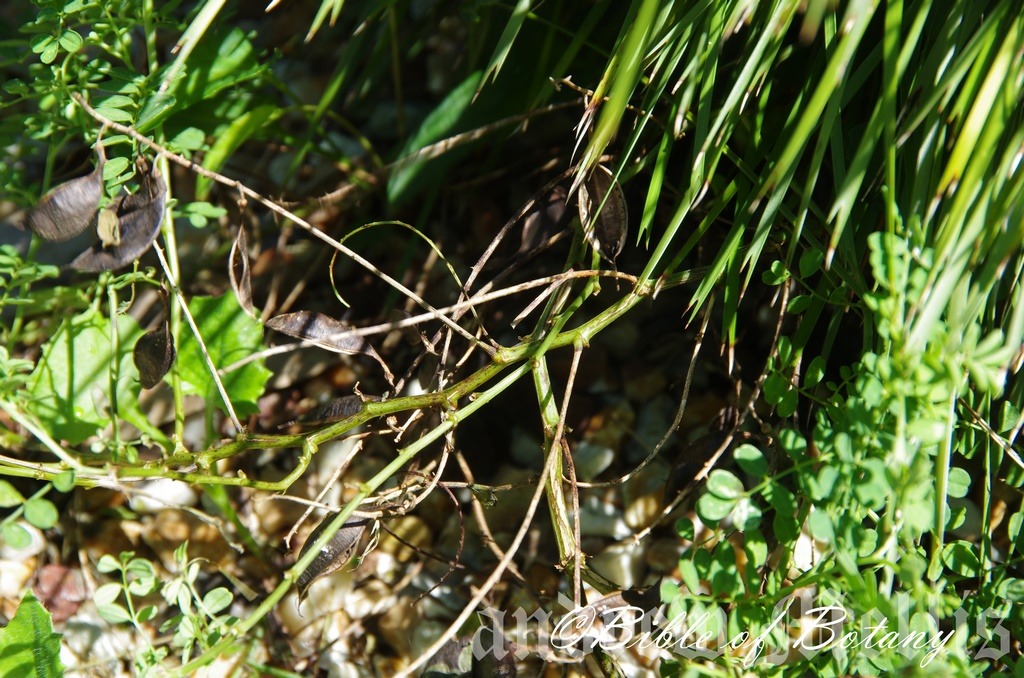
NCBG Coffs Harbour NSW

NCBG Coffs Harbour NSW
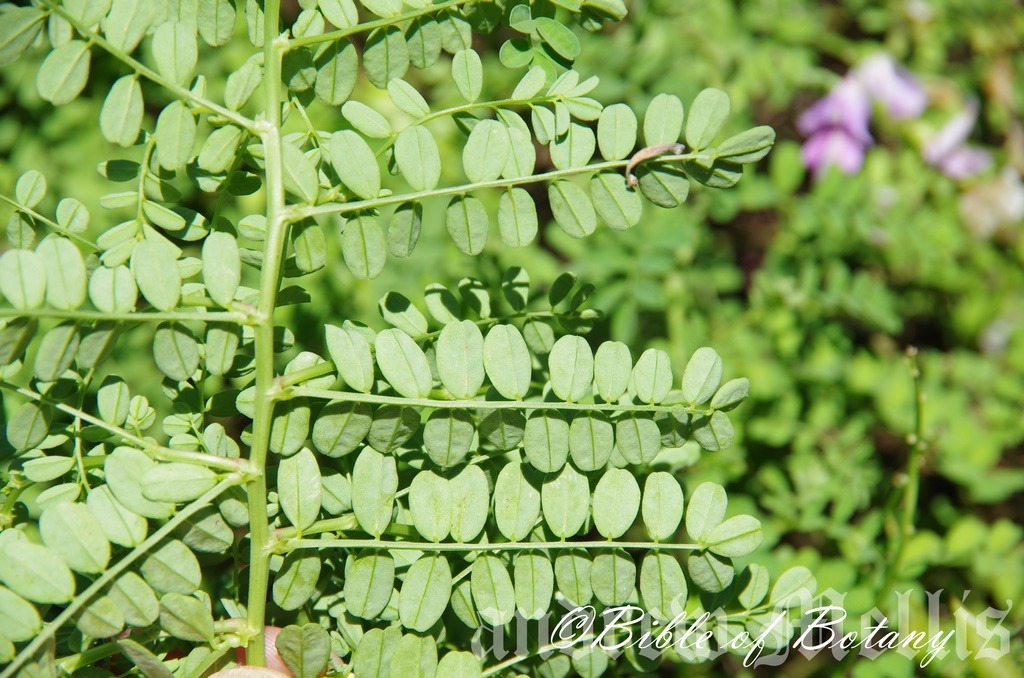
NCBG Coffs Harbour NSW
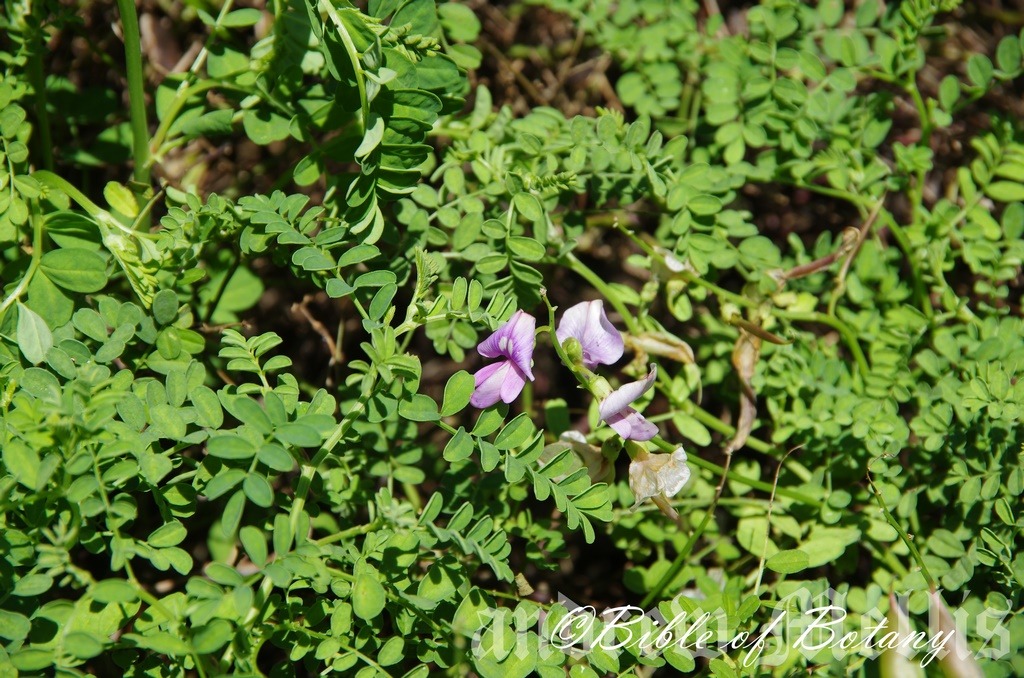
NCBG Coffs Harbour NSW

NCBG Coffs Harbour NSW

NCBG Coffs Harbour NSW

NCBG Coffs Harbour NSW
Swainsona brachycarpa
Classification:
Unranked: Eudicots
Class: Rosids
Order: Fabales
Family: Fabaceae
Subfamily: Faboideae
Tribe: Galegeae
Sub Tribe: Astragalinae
Genus: Is named in honour of Isacc Swainson; 1746-1812, who was an English scientist and physician.
Specie: From Brachus, which is Ancient Greek for short and Karpós, which is Ancient Greek for a fruit. It refers to plants which have smaller fruits than other species in the genus.
Sub specie:
Common Name: Slender Swainsona Pea.
Distribution:
Swainsona brachycarpa is found 4 isolated populations in the east with the largest population found east of a line from Miriam vale to Zamia Creek catchment in Palmgrove National Park in southern Queensland to Moree and Point Plomer in north eastern coastal New South Wales with a population further south on Lake Bellfield in the Grampians National Park, west on Mulianna Creek near Tinderry and Rockingham bay near Cardwell.
https://avh.ala.org.au/occurrences/search?taxa=Swainsona+brachycarpa#tab_mapView
Habitat Aspect Climate:
Swainsona brachycarpa prefer light shade to full sun. It grows in grassland or grassy woodlands or grassy heaths. The altitude ranges from 10 meters ASL to 1500 meters ASL.
The temperatures range from minus 3 degrees in August to 40 degrees in January.
The rainfalls range from lows of 100mm to 500mm average per annum.
Soil Requirements:
Swainsona brachycarpa prefer to grow on poorer coarse sands, fine sands to sandy loams often associated with rocks and boulders. The soils are usually derived from decomposed granites, sandstones or at times metamorphic rocks or alluvial deposits. The soils pH ranges from 5pH to 6.5pH. It does not tolerate water logged soils. Non saline soils to moderately saline soils are tolerated.
Height & Spread:
Wild Plants: 0.5m to 1m by 0.6m to 1.4m
Characteristics:
Swainsona brachycarpa usually grows as a prostrate to ascending perennial or at times a scrambling shrub. The apical 100mm of the stems are glabrous or with tubercles with minute, white appressed or divergent, basifixed hairs.
The alternate, odd pinnate leaves of Swainsona brachycarpa measure 20mm to 100mm in length. The 9 to 23 ovate, elliptic to narrow elliptic leaflets measure 2mm to 12mm in length by 1mm to 4mm in width. The 2 minute stipules measure 1mm to 1.3mm in length. The petioles, rachises and petiolules are blue green, and glabrous. The petioles measure 10mm to 20mm in length while the rachises measure 10mm to 80mm in length while the petiolules measure 1mm to 1.5mm in length. The bases taper to the stems while the apexes are emarginate. The concolourous laminas are blue-green, dull, and glabrous. The laminas recurve upwards from the mid vein to the margins and decurve slightly downwards near the apexes. The margins are entire. The mid vein is prominent on the lower laminas and is visible from the upper lamina.
Inflorescences of Swainsona brachycarpa are born on a raceme from the leaf axils of 2 to 12 flowers. The glabrous peduncles are rachises mid bluish-green while the glabrous pedicels are reddish. The peduncles measure 10mm to 30mm in length while the rachises measure 50mm to 120mm and the petioles measure 3mm to 4mm in length. The bluish-green, cupuliform calyx and triangular calyx lobes are erect and glabrous. The calyx measures 3mm to 3.5mm in length while the 5 lobes measure 0.5mm in length. The calyx and calyx lobes are densely covered in white canescent hairs.
The orbicular standard petal is deep red often with a splash of white near the base. The margins are entire with an emarginate apex. The standards measure 8mm to 10mm in height by 10mm to 13mm in width.
The deep red, oblong wing petals run parallel to and partially covered the keel. The wings measure 6mm to 7mm in length by 2.5mm to 3.5mm in height.
The deep red, hemi orbicular keel petals measure 7mm to 9mm in length by 4mm to 5mm in height. The keel’s apex is obtuse, retracted or with a short beak on the upper section.
The 10 diadelphous stamens comprise of 2 bundles, one with 4 stamens, one with 5 stamens and one free stamen. The ovary is glabrous. The style tip is straight, incurved or strongly inflexed with a tuft of white hairs behind the stigma. The flowers appear throughout the year when favourable conditions exist.
Swainsona brachycarpa fruits are ellipsoidal-crescent shaped pods. The pods measure 15mm to 30mm in length by 4mm to 8.5mm in diameter. The green pods are glabrous and turn pale fawn when ripe. The style is persistent on the ripe fruits. The stipe measures 2mm to 3mm in length. The 3 to 5 brown reniform, rugose seeds measure 4.5mm to 5mm in length by 3mm to 3.5mm in diameter.
Wildlife:
Swainsona brachycarpa wildlife is unknown to the author. It is a terrific sand stabilizer on desert sand dunes and a nitrogen fixer to the soil.
Cultivation:
Swainsona brachycarpa is a magnificent small shrub that can be grown in a desert or arid scene because of its foliage. This again would effectively represent the haze experienced in real life and that is where Swainsona brachycarpa shines or it can be used in the valleys and flats with taller shrubs in the back ground to give depth and height. Don’t make the ridge straight curve it, wind it around. Use small tussock grasses or Lomandra specie adjacent to Swainsona canescens to give them height. Prune plants up the valleys and background so they remain shorter than those in the foreground to give greater depth.
Place them near old stumps and roots to make the stumps or roots look larger. Select an area of ground and let your hair down and be imaginative and this is the plant that may just change your life. Remember this plant dislikes water so be sparing with the water and allow an area around the plant free for good aeration. Deserts are rolling flat plains not steep hills so it is best to use a gentle slope or a basin with a small pool at the bottom. A billabong affect is the go, not a waterfall or cascades.
Propagation:
Seeds: The seeds of Swainsona brachycarpa can be removed easily from the pods.
Treat the seeds by placing them in hot, not boiling water and allow them to soak for a 6 to 8 hours. Another method is to lightly rub the seeds on fine sand paper to remove part of the outer testa.
Do not over water as the seeds will rot off before germination takes place. Place the trays in a warm sunny area or beneath 20mm shade cloth in the bush house. When the seedlings are 20mm to 25mm tall, prick them out and plant them into 50mm native tubes using a good organic mix.
As the seedlings roots reach the bottom of the tubes nip the tips out and plant them out into their permanent position.
Fertilize using Seaweed, fish emulsion or organic chicken pellets soaked in water and apply the liquid on an alternate basis. Fertilize every 2 months until the plants are well established then on an annual basis in September or March to maintain better health, vitality and flowering
Further Comments from Readers:
“Hi reader, it seems you use The Bible of Botany a lot. That’s great as we have great pleasure in bringing it to you! It’s a little awkward for us to ask, but our first aim is to purchase land approximately 1,600 hectares to link several parcels of N.P. into one at The Pinnacles NSW Australia, but we need your help. We’re not salespeople. We’re amateur botanists who have dedicated over 30 years to saving the environment in a practical way. We depend on donations to reach our goal. If you donate just $5, the price of your coffee this Sunday, We can help to keep the planet alive in a real way and continue to bring you regular updates and features on Australian plants all in one Botanical Bible. Any support is greatly appreciated. Thank you.”
In the spirit of reconciliation we acknowledge the Bundjalung, Gumbaynggirr and Yaegl and all aboriginal nations throughout Australia and their connections to land, sea and community. We pay our respect to their Elders past, present and future for the pleasures we have gained.
Swainsona canescens
Classification:
Unranked: Eudicots
Class: Rosids
Order: Fabales
Family: Fabaceae
Subfamily: Faboideae
Tribe: Galegeae
Sub Tribe: Astragalinae
Genus: Is named in honour of Isacc Swainson; 1746-1812, who was an English scientist and physician.
Specie: From Cascus, which old Latin or C?num, which is modern Latin for grey and hoary, to become old and grey. It refers to structures or organs, which are covered in straggly, unkempt, soft grey hairs.
Sub specie: Swainsona canescens subsp. canescens. From Cascus, which old Latin or C?num, which is modern Latin for grey and hoary, to become old and grey. It refers to structures or organs, which are covered in straggly, unkempt, soft grey hairs.
Sub specie: Swainsona canescens subsp. horniana. Is named in honour of Horn.
Common Name: Smooth Darling Pea.
Distribution:
Swainsona canescens subsp. canescens and Swainsona canescens subsp. horniana are found in two large disjunct populations, one in the western two thirds and half Western Australia and from the lower half of the Northern Territory and South Australia to Port Augusta.
There are also two isolated populations (Old I.D by Mueller) west of Cobar in western New South Wales.
https://avh.ala.org.au/occurrences/search?taxa=Swainsona+canescens#tab_mapView
Habitat Aspect Climate:
Swainsona canescens prefer light shade to full sun. It grows in open woodlands, open Acacia woodlands, savannah woodland to open plains or on sandy slopes. It is found in most arid areas but not in the true deserts or close to the salt pans of inland Australia. The altitude ranges from 0 meters ASL to 670 meters ASL.
The temperatures range from 3 degrees in August to 40 degrees in January.
The rainfalls range from lows of 100mm to 500mm average per annum.
Soil Requirements:
Swainsona canescens prefers course sands, fine sands to sandy loams. The soils are usually derived from decomposed sandstones or at times granites. The soils pH ranges from 6pH to 7pH. It does not tolerate water logged soils. Non saline soils to moderately saline soils are tolerated.
Height & Spread:
Wild Plants: 0.2m to 0.6m by 0.6m to 1.4m.
Characteristics:
Swainsona canescens grows as an ascending or sub erect perennial with stout rigid but herbaceous stems. The stems measure 200mm to 600mm in length by 3mm to 9mm in diameter. The stems are covered in pale grey tomentose or canescent hairs.
The alternate leaves of Swainsona canescens are odd pinnate with 9 to 15 leaflets. The leaves measure 50mm to 120mm in length. The 2 minute ovate to acute stipules measure 3mm to 7mm in length. The petioles, rachises and petiolules are fawnish and densely covered in soft pale grey tomentose or canescent hairs. The petioles measure 15mm to 40mm in length while the rachises measure 35mm to 80mm in length while the petiolules measure 1mm to 2.5mm in length. The bases are rounded while the apexes are emarginate, mucronate or emarginate with a small mucronate tip within the sinus. The obovate, broad elliptic to oblong leaflets measure 10mm to 20mm in length by 5mm to 15mm in width. The concolourous laminas are blue-green, dull, and glabrous. The laminas recurve upwards from the mid vein to the margins and decurve slightly downwards near the apexes. The margins are entire. The mid vein is prominent on the lower laminas and is visible from the upper lamina.
Inflorescences of Swainsona canescens are born on dense racemes from the leaf axils with 20 to 25 individual flowers. The whitish, pale pinkish to fawnish peduncles, rachises and pedicels are densely covered in pale grey canescent hairs. The peduncles measure 30mm to100mm in length while the rachises measure 70mm to 140mm and the petioles measure 0.5mm to 1.2mm in length. The 5 fawn to pale brown calyxes lobes are erect, glabrous and measure 4mm to 8mm in length. The calyx and calyx lobes are densely covered in white canescent hairs.
The narrow triangular bract is acuminate and covered in pale grey canescent hairs externally and is glabrous internally. The bracts measures 3mm to 5mm in length. The lanceolate bracteoles measure 1mm to 3mm in length. The cupuliform calyxes are densely covered in white, silky, villous hairs and measures 4mm to 6mm in length. The 5 calyx lobes are broad triangular to narrow triangular and measures 4mm to 6mm in length.
The purplish-pink standard has a pale yellow splash near the base. The standard is broad ovate with a truncate base and an emarginate apex. The standards measure 10mm to 12mm in height by 12mm to 15mm in width.
The oblong wings have an obtuse apex and are strongly auriculate above the short claw. The wings measure 7mm to 8.5mm in length by 2mm to 2.5mm in width.
The asymmetrical hemi orbicular keel petals are deeply ovate on the lower side and almost linear on the upper edge. The apexes are beaked, with a small expanded callous tip and a wide hemi orbicular auricle that measures 3mm to 4.5mm in length on a linear claw. The keel measure 8mm to 10mm in length by 4.5mm to 6mm in width.
The 10 diadelphous stamens comprise of 2 bundles, one with 4 stamens, one with 5 stamens and one free stamen. The subsessile, cylindrical style is inflexed to coil at the tip just below the stigma. The stout style is laterally compressed on the basal two thirds and is covered in pale grey hirsute hairs which are longer at the base than the apex. Swainsona canescens flowers usually appear from May to October but it can flower throughout the year under favourable conditions or when good unseasonal rains occur.
Swainsona canescens fruits are ellipsoidal-crescent shaped pods. The pods are densely covered in soft, pale grey canescent hairs. The pods measure 10mm to 15mm in length by 4mm to 6mm in width. The green pods turn pale fawnish or pinkish when ripe. The style is persistent on the ripe pods. The stipe measures 2mm to 3mm in length. The 8 to 10 olive-green to greenish-brown, reniform seeds are smooth, glabrous and semi glossy. The seeds measure 1.5mm to 2mm in length.
Subspecie Differences:
Swainsona canescens subsp. canescens leaflets are densely covered in pale grey tomentose hairs.
Swainsona canescens subsp. horniana leaflets are glabrous on the upper laminas and are covered with pale grey canescent hairs on the lower laminas.
Wildlife:
Swainsona canescens wildlife is unknown to the author. It is a terrific sand stabilizer on desert sand dunes and a nitrogen fixer to the soil.
Cultivation:
Swainsona canescens is a magnificent small shrub that can be grown in association with other semi-arid plants or in a bush garden. In cultivation it grows from 0.4 meters to 0.6 meters in height by 0.6 meters to 1 meter in diameter when grown in the open.
It grows exceptionally well on most soils where the soil is exposed to the air. If these requirements are met they can cope with temperatures as low as 1 degree and up to 45 degrees. It is drought resistant and will need very little attention to look their best.
It is the ideal annual for the desert garden, rockery, around swimming pools or hot court yards. The hairy leaves, stems with the profusion of pink flowers over a long period will soften the hardest walls and structures. Great affects can be achieved using low sub shrubs with yellow flowers like Hibbertia scandens or even Senecio species.
When you design a miniature desert garden, use contours to display the plants to their best. Plant a row of small shrubs on the top to represent the hills or a ridge or use them on the plains to give a feeling of expansive flatness with the small hills in the distance. Another method would be to cover the hills in the distance with annuals that have soft grey foliage. This again would effectively represent the haze experienced in real life and that is where Swainsona canescens shines or they can be used in the valleys and flats with taller shrubs in the back ground to give depth and height. Don’t make the ridge straight curve it, wind it around. Use small tussock grasses or Lomandra specie adjacent to Swainsona canescens to give them height. Prune plants up the valleys and background so they remain shorter than those in the foreground to give greater depth.
Propagation:
Seeds: The seeds ofSwainsona canescens can be removed easily from the pods.
Treat the seeds by placing them in hot, not boiling water and allow them to soak for a 6 to 8 hours. Another method is to lightly rub the seeds on fine sand paper to remove part of the outer testa.
Do not over water as the seeds will rot off before germination takes place. Place the trays in a warm sunny area or beneath 20mm shade cloth in the bush house. When the seedlings are 20mm to 25mm tall, prick them out and plant them into 50mm native tubes using a good organic mix.
As the seedlings roots reach the bottom of the tubes nip the tips out and plant them out into their permanent position.
Fertilize using Seaweed, fish emulsion or organic chicken pellets soaked in water and apply the liquid on an alternate basis. Fertilize every 2 months until the plants are well established then on an annual basis in September or March to maintain better health, vitality and flowering
Further Comments from Readers:
“Hi reader, it seems you use The Bible of Botany a lot. That’s great as we have great pleasure in bringing it to you! It’s a little awkward for us to ask, but our first aim is to purchase land approximately 1,600 hectares to link several parcels of N.P. into one at The Pinnacles NSW Australia, but we need your help. We’re not salespeople. We’re amateur botanists who have dedicated over 30 years to saving the environment in a practical way. We depend on donations to reach our goal. If you donate just $5, the price of your coffee this Sunday, We can help to keep the planet alive in a real way and continue to bring you regular updates and features on Australian plants all in one Botanical Bible. Any support is greatly appreciated. Thank you.”
In the spirit of reconciliation we acknowledge the Bundjalung, Gumbaynggirr and Yaegl and all aboriginal nations throughout Australia and their connections to land, sea and community. We pay our respect to their Elders past, present and future for the pleasures we have gained.
Swainsona formosa
South Australia & Broken Hill’s Floral Emblem
Classification:
Unranked: Eudicots
Class: Rosids
Order: Fabales
Family: Fabaceae
Subfamily: Faboideae
Tribe: Galegeae
Sub Tribe: Astragalinae
Genus: Is named in honour of Isacc Swainson; 1746-1812, who was an English scientist and physician.
Specie: From Formosa, which is Latin for beautiful or vivacous. It refers to the beauty of the species, which can be bold or dainty.
Sub specie:
Common Name: Sturts Desert Pea.
Distribution:
Swainsona formosa is found from near Katharra on the Western Australia coast to the Darling River system in far western New South Wales then south south-west to the Murray depression and westward to the Nullarbor Plain in South Australia. It is probably more widely spread in this area than any of the maps indicate because of its remoteness.
https://avh.ala.org.au/occurrences/search?taxa=Swainsona+formosa#tab_mapView
Habitat:
Aspect / Climate:
Swainsona formosa prefers full sun to light filtered shade. It grows in mulga scrub land, mallee woodlands, open Acacia woodlands, rocky ridges, dry creek lines and drainage channels in arid zones. The altitude ranges from 5 meters ASL to 400 meters ASL.
The temperatures range from minus 1 degree in August to 40 degrees in January.
The rainfall ranges from lows of 150mm to 300mm average per annum.
Soil Requirements:
Swainsona formosa prefers to grow on fine to course sandy loams to medium gritty clays. The soils are usually derived from decomposed sandstones or granites. The soils pH. ranges from 5pH to 7pH. It does not tolerate water logged soils. Non saline soils to very saline soils are tolerated.
Height & Spread:
Wild Plants:0.2m to 0.4m by 1m to 3m.
Characteristics:
Swainsona formosa grows as a prostrate to scrambling ground cover or trailing creeper over adjacent plants. The pale pinkish-red stems only turn pale grey-green near the apex. It is densely covered in white pulverulent and spreading basifixed hairs.
The disjunct alternate leaves of Swainsona formosa are odd pinnate. The ovate to broad elliptical stipules measure 10mm to 15mm in length. The petiolules, rachises and petioles are pale blue-green to pale grey-green, and covered in soft white pulverulent hairs. The petiolules measure 8mm to 20mm in length while the rachises measure 40mm to 70mm in length while the petioles measure 0.2mm to 1mm in length.
The 4 to 7 pairs of pinnae plus the terminal pinnules measure 100mm to 150mm in length by 32mm to 44mm in width overall. The individual pinnules are elliptical to ovate and measure 10mm to 30mm in length by 6mm to 12mm in width. The bases are broadly cuneate while the apexes are acute, obtuse or retuse. The concolourous laminas are blue-green to deep-blue green, dull, and densely covered in white pubescent hairs on the upper lamina while the lower lamina is covered in white spreading hairs. The leaf margins are entire, recurve from the mid vein to the margins. The mid veins are prominent on the lower laminas and are faintly visible from the upper lamina.
Inflorescences of Swainsona formosa are born on an n umbel from the leaf axils. There are 5 or 7 flowers on an umbel. The pale blue-green to mid blue-green peduncles and pedicels are densely covered in white canescent hairs. The peduncles measure 45mm to 55mm in length while the petioles measure 10mm to 15mm in length. The pale blue-green calyx and calyx lobes are erect and covered in white pulverulent hairs. The calyx tubes measure 8mm to 10mm in length while the lobes measure 6mm to 9mm in length.
The broad oblong, erect standard petal is glossy black near the base and red, deep scarlet-red or rarely white near the apex. The flowers measure 50mm to 60mm overall. The margins are entire, decurve from the center to the margins and slightly towards the apex while the apex is acute. The standards measure 26mm to 32mm in height by 7mm to 15mm in width. The falcate wing petals run parallel to the keel petals. The scarlet-red wing petals measure 9mm to 15mm in length by 3mm to 4mm in width. The falcate keel petals are deeply ovate on the lower side and almost linear on the upper edge. The keel scarlet-red measure 25mm to 30mm in length by 4mm to 7mm in width.
The ovary is covered in white pulverulent hairs. The slender white style is exserted for 3.5mm to 5mm. Willdampia formosa flowers appear from July through to March but this is influenced more by rainfall patterns than seasonal temperatures.
The fruits of Swainsona formosa are narrow elliptical-oblong pods. The pods are densely covered in white puberulent hairs and measure 40mm to 90mm in length by 12mm to 22mm in diameter. The green capsules turn deep grey-brown externally and paler internally when ripe. The style and stipes are persistent. The style lengthens to 30mm to 40mm in length while the stipes measure 5mm to 15mm in length. The 3 to 5 brown reniform, rugose seeds measure 4.5mm to 5mm in length by 3mm to 3.5mm in diameter.
Wildlife:
Swainsona formosa wildlife is unknown to the author. It is a terrific sand stabilizer on desert sand dunes and a nitrogen fixer to the soil.
Cultivation:
Swainsona formosa is a magnificent small prostrate ground cover that should be grown in association with other small desert plants. It is ideal at the edge of a fish or frog pond in full sun. In cultivation they will grow from 0.4 meters to 0.5 meters in height by 0.8 meters to 1.2 meters in diameter when grown in the open.
It grows exceptionally well on lighter sandy soils where the soil is exposed to the air. If these requirements are met it can cope with temperatures as low as 1 degree and up to 45 degrees. It is drought resistant and will need very little attention to look their best.
Add to the above, if it is given a little supply of water and a little native fertilizer early on or when it rains will see the plants respond with excellent flowering and fruiting over a long period.
It is the ideal annual for the desert garden, rockery, around swimming pools or hot court yards. It can also be used as hanging basket plants anywhere in mainland Australia.
When you design a miniature desert garden, use contours to display the plants to their best. Plant a row of small shrubs on the top to represent the hills or a ridge or use them on the plains to give a feeling of expansive flatness with the small hills in the distance. Another method would be to cover the hills in the distance with annuals that have soft grey foliage. This again would effectively represent the haze experienced in real life and that is where Swainsona canescens shines or they can be used in the valleys and flats with taller shrubs in the back ground to give depth and height. Don’t make the ridge straight curve it, wind it around. Use small tussock grasses or Lomandra species adjacent to Swainsona canescens to give them height. Prune plants up the valleys and background so they remain shorter than those in the fore ground to give greater depth.
Place it near old stumps and roots to make the stumps or roots look larger. Select an area of ground and let your hair down and be imaginative and this is the plant that may just change your life. Remember this plant dislikes water so be sparing with the water and allow an area around the plant free for good aeration. Deserts are rolling flat plains not steep hills so it is best to use a gentle slope or a basin with a small pool at the bottom. A billabong affect is the go, not a waterfall or cascades.
Swainsona formosa would make a good contribution to a sandy or rocky terrain rock garden. Here they can be used as fill in plants, scattered throughout the boulders. When you use it in an area that is strewn with large boulders do not over crowd the scene as the boulders are a formidable part of the scene. Swainsona formosa is well suited to such conditions so use contours to display the plants. Boulder country are almost always rising and falling in contour and have sharp rises. Plants must be planted sparingly with short pink, mauve or white flowering annuals between to give vibrant Col?r contrasts. Make the scene so you can see over the tallest ones with the exception of one or two plants at the most. The idea is to achieve a feeling of expansive harshness. This can be achieved with using Swainsona formosa’s blue-green leaves contrasting with finer pale green coloured foliages. If large deep green leaf plants are wanted try using them as prostrate plants. Use a lot of procumbent plants like Hibbertia to make the rocks look larger and the spaces between the plants bigger. Mix it with other smaller shrubs so none of them dominate the scene but blend in to give a mosaic of foliage colours that you oversee.
Propagation:
Seeds: The seeds of Swainsona formosa can be removed easily from the fruits.
To treat the seeds by placing them in hot not boiling water and allow them to soak for a couple of hours. Another method is to lightly rub the seeds on fine sand paper to remove part of the outer testa.
Sow freshly treated seeds directly into peat jiffy pots, keeping them moist not wet. Do not over water as the seeds damp off before germination takes place. Place the trays in a warm sunny area. When the seedlings roots appear at the bottom or sides of the pots place them into their permanent position in the ground or plant them into hanging baskets for something colourful and different.
Fertilize using Seaweed, fish emulsion or organic chicken pellets soaked in water and apply the liquid on an alternate basis. Fertilize and water on a monthly basis if it is hot and does not rain until the buds appear.
Further Comments from Readers:
“Hi reader, it seems you use The Bible of Botany a lot. That’s great as we have great pleasure in bringing it to you! It’s a little awkward for us to ask, but our first aim is to purchase land approximately 1,600 hectares to link several parcels of N.P. into one at The Pinnacles NSW Australia, but we need your help. We’re not salespeople. We’re amateur botanists who have dedicated over 30 years to saving the environment in a practical way. We depend on donations to reach our goal. If you donate just $5, the price of your coffee this Sunday, We can help to keep the planet alive in a real way and continue to bring you regular updates and features on Australian plants all in one Botanical Bible. Any support is greatly appreciated. Thank you.”
In the spirit of reconciliation we acknowledge the Bundjalung, Gumbaynggirr and Yaegl and all aboriginal nations throughout Australia and their connections to land, sea and community. We pay our respect to their Elders past, present and future for the pleasures we have gained.
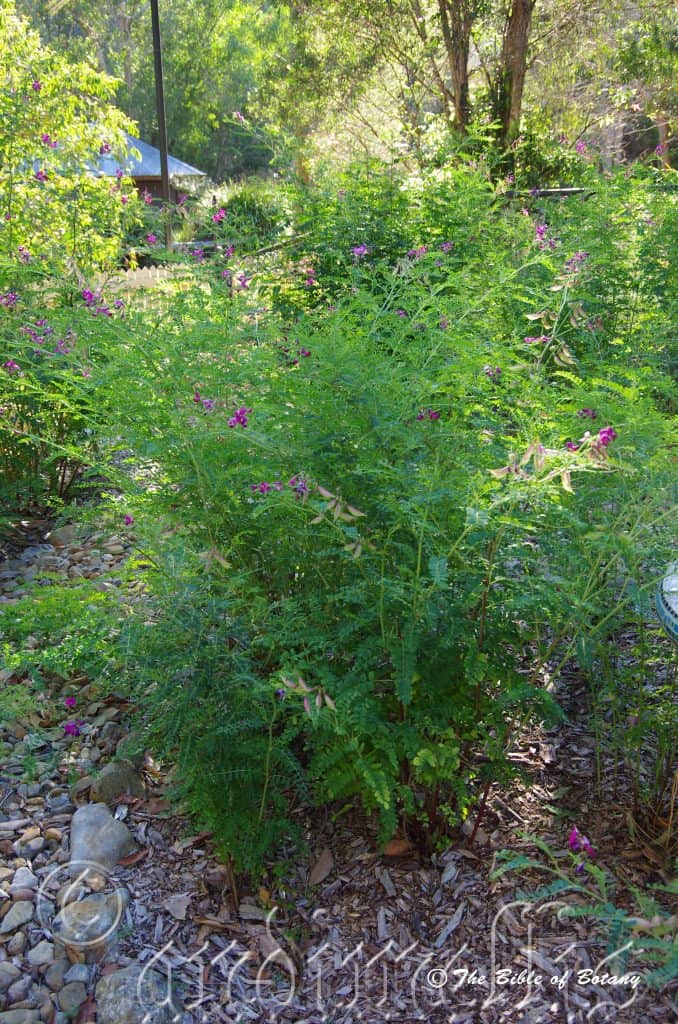
Indigiscapes Capalaba Qld.
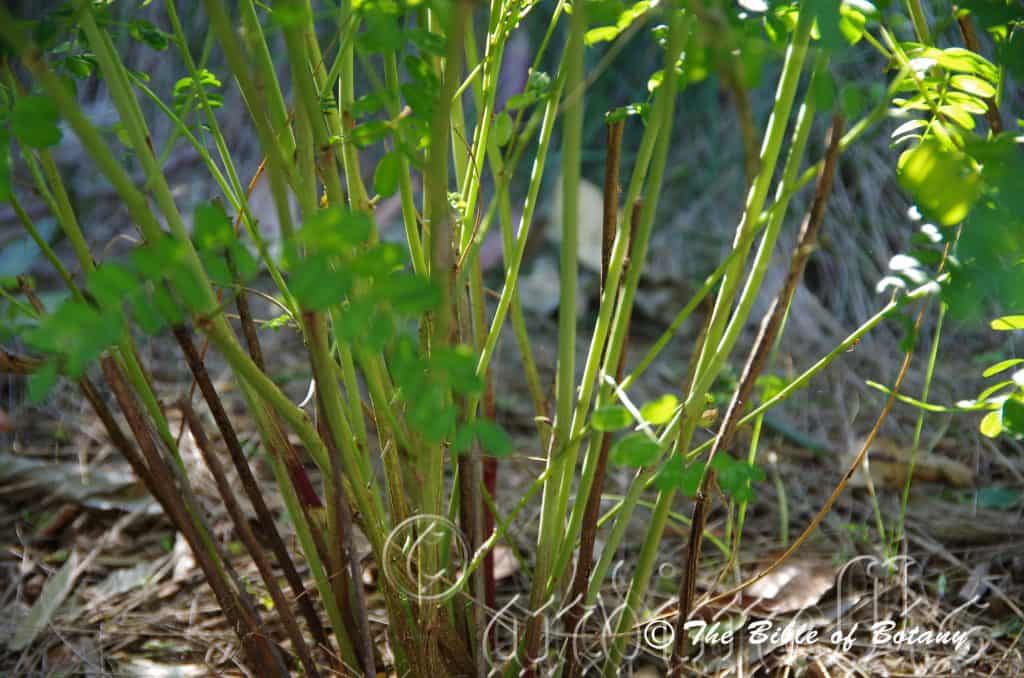
Indigiscapes Capalaba Qld.

Washpool National Park NSW
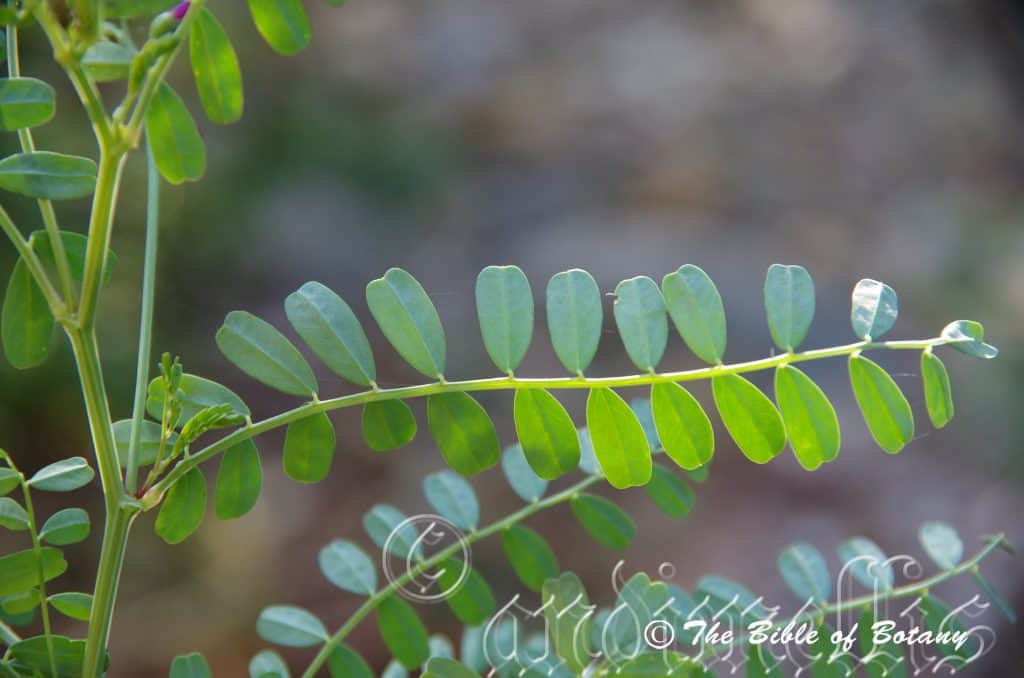
Indigiscapes Capalaba Qld.

Erwingar State Forest NSW
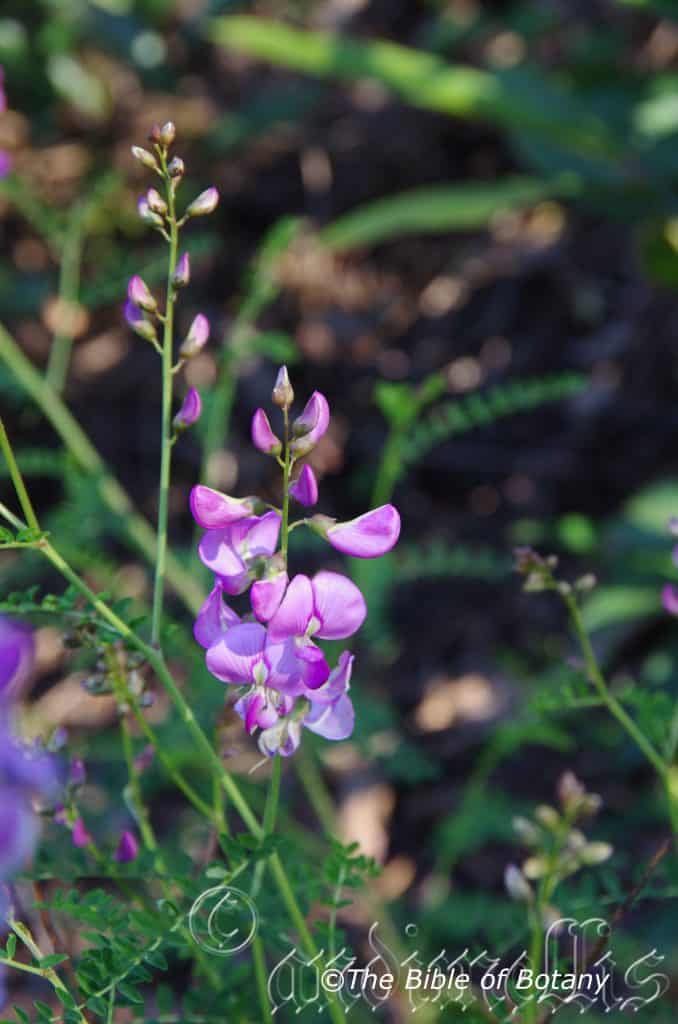
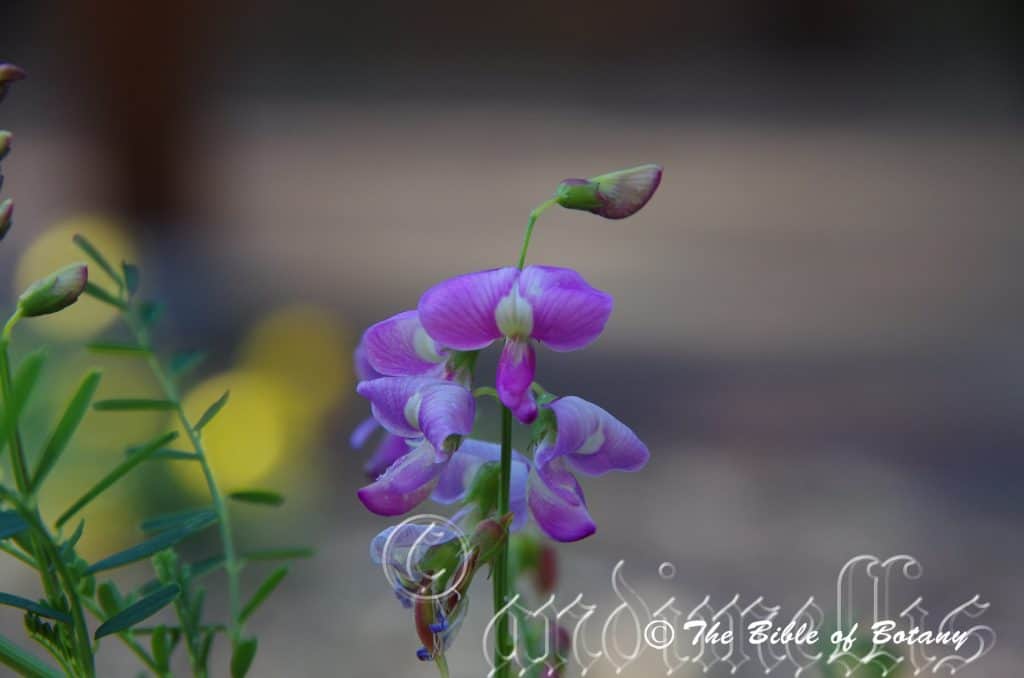
Indigiscapes Capalaba Qld.

Indigiscapes Capalaba Qld.
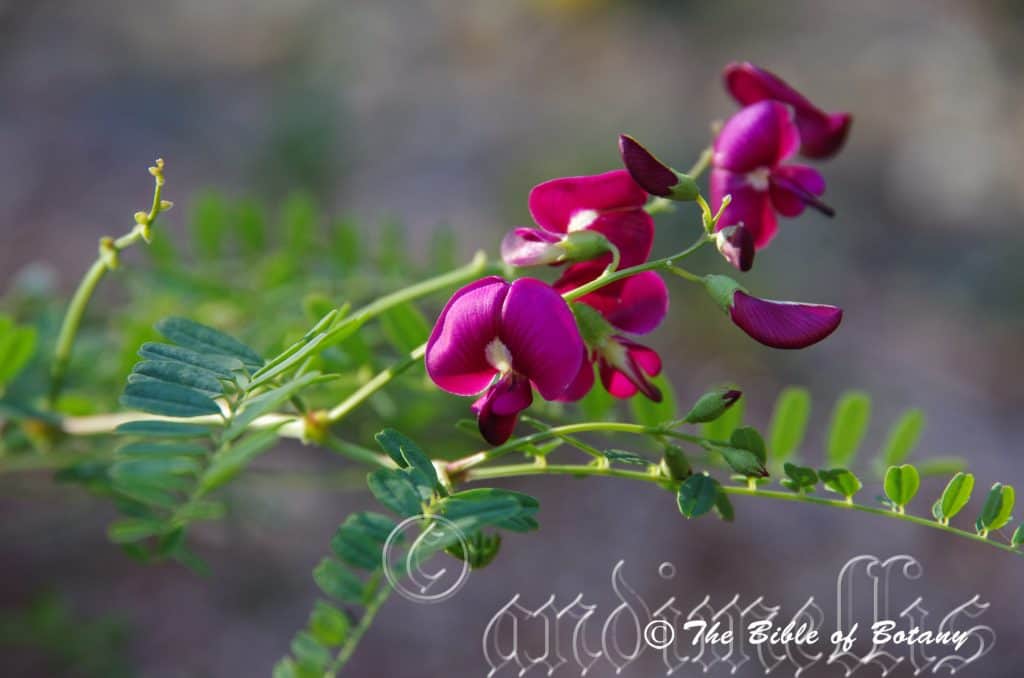
Indigiscapes Capalaba Qld.
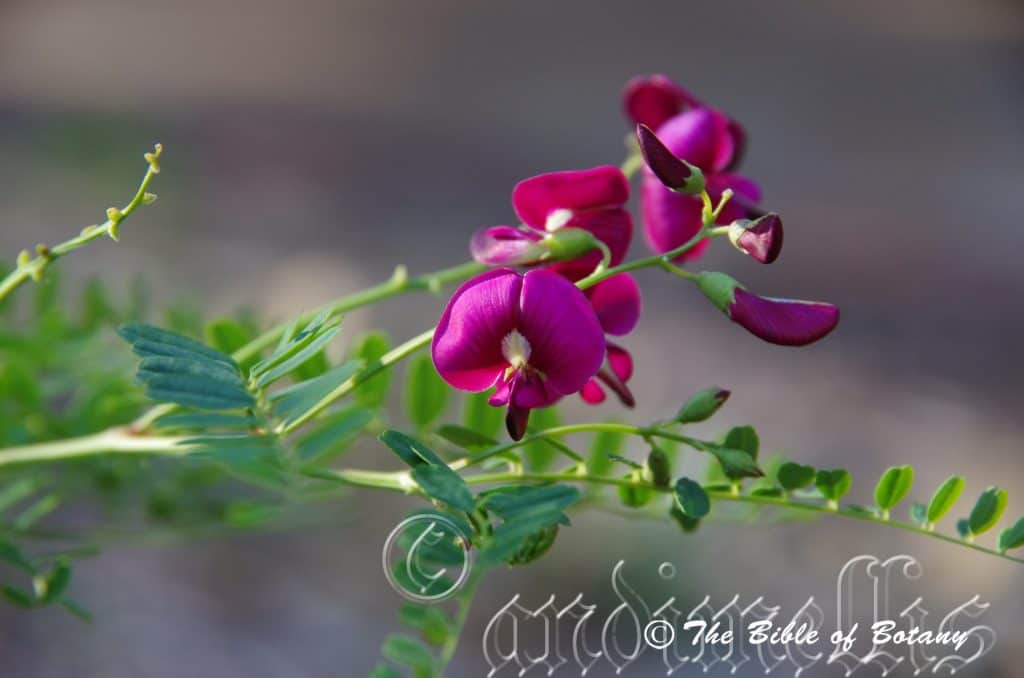
Indigiscapes Capalaba Qld.

Indigiscapes Capalaba Qld.

Indigiscapes Capalaba Qld.
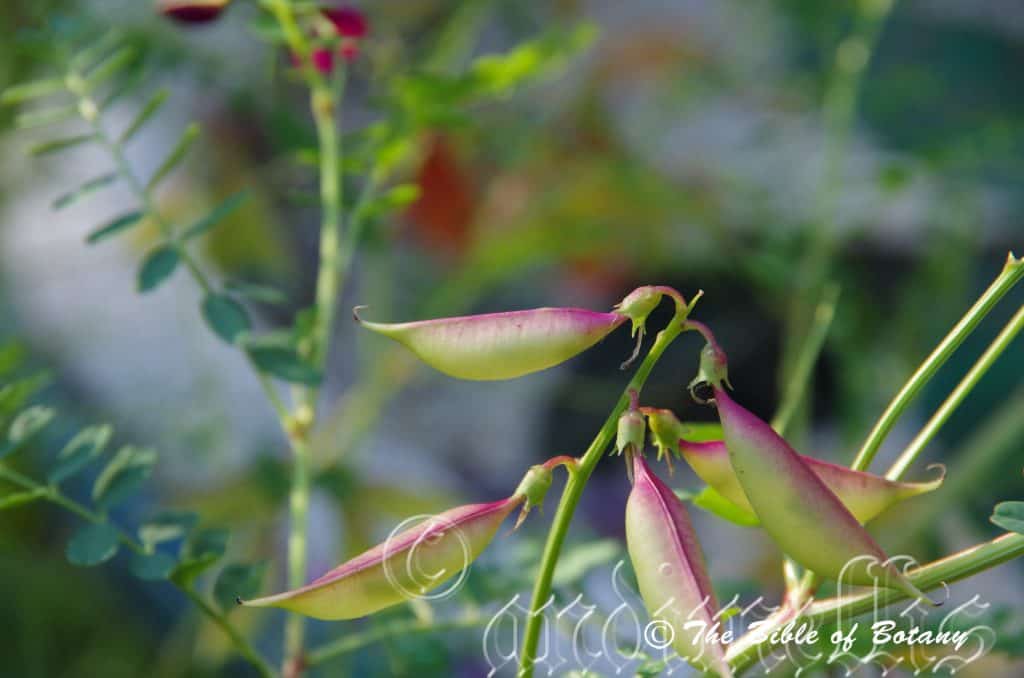
Indigiscapes Capalaba Qld.

Indigiscapes Capalaba Qld.
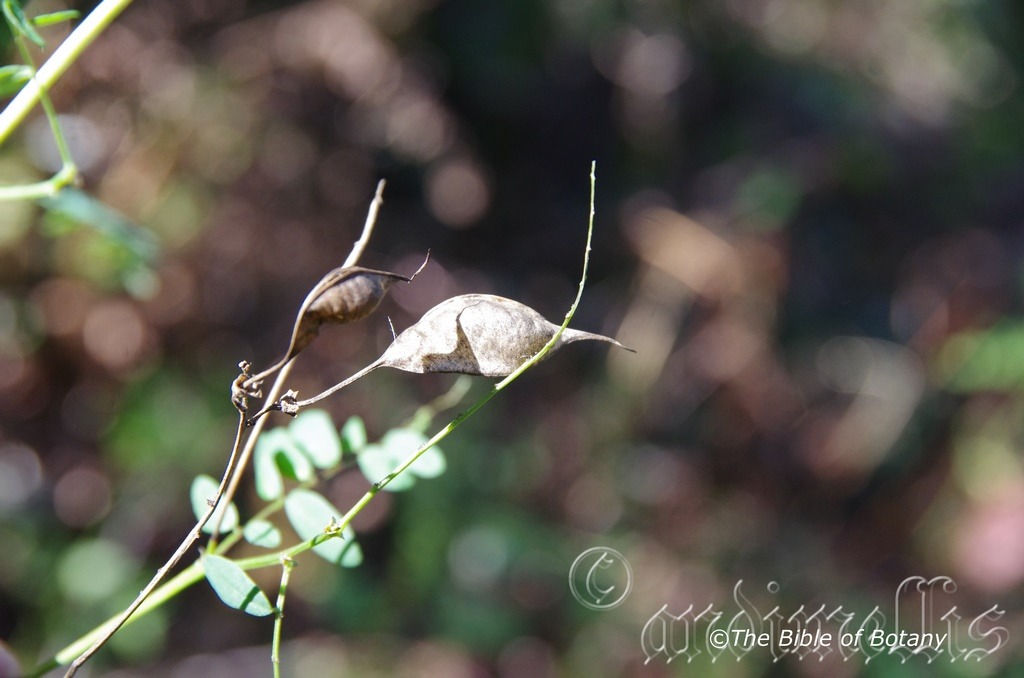
Washpool National Park NSW
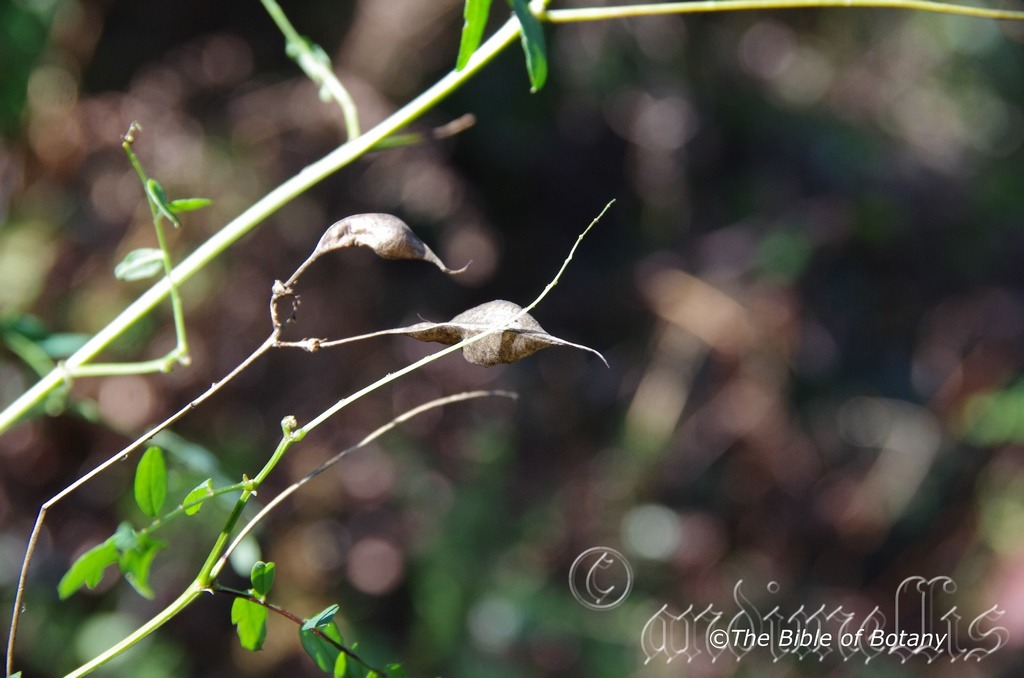
Washpool National Park NSW
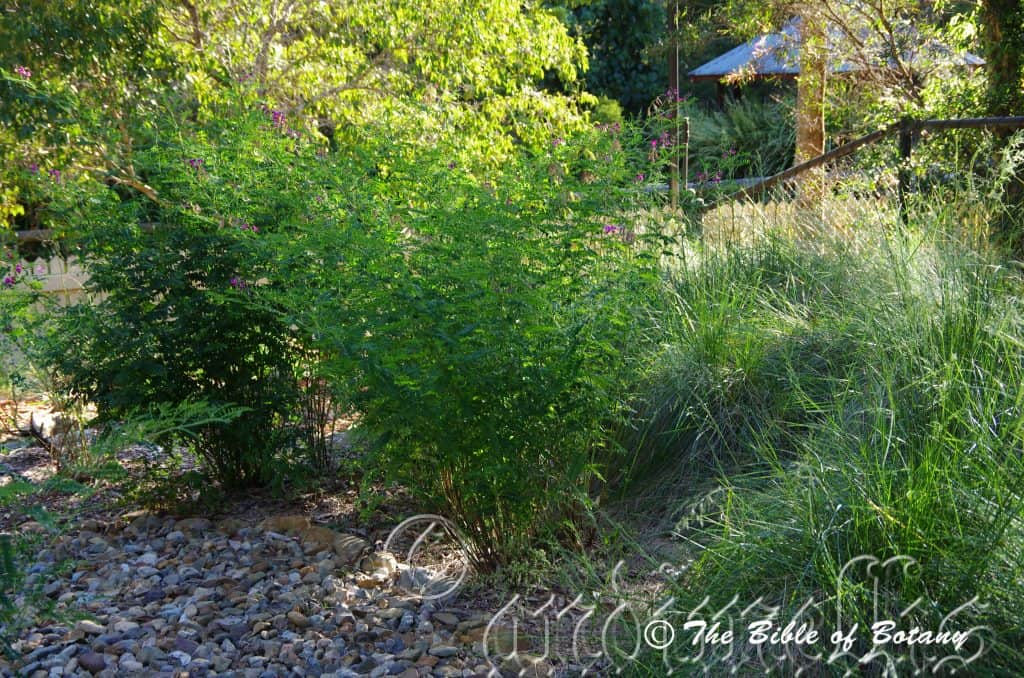
Indigiscapes Capalaba Qld.
Swainsona galegifolia
Classification:
Unranked: Eudicots
Class: Rosids
Order: Fabales
Family: Fabaceae
Subfamily: Faboideae
Tribe: Galegeae
Sub Tribe: Astragalinae
Genus: Is named in honour of Isacc Swainson; 1746-1812, who was an English scientist and physician.
Specie: From Galactos, which is Ancient Greek for milk and Folium, which is Latin for foliage. It refers to foliages which were extensively used as cow and goat fodder to improve the milk quality.
Sub specie:
Common Name: Smooth Darling Pea.
Distribution:
Swainsona galegifolia is found east of a line from the Millstream Falls near Ravenshoe in far north eastern Queensland south to Wodonga West in northern Victoria and northeast to Bateman’s Bay in south eastern coastal New South Wales.
There are 2 isolated populations further west on the Western Australian coast south of Dongarra and in far north western Queensland at Lower Settlement creek north west of Burke.
https://avh.ala.org.au/occurrences/search?taxa=Swainsona+galegifolia#tab_mapView
Habitat Aspect Climate:
Swainsona galegifolia prefer light shade to full sun. It grows in open scrub lands, open dry forests, rainforest margins, seasonal river stream or creek riparian zones, open plains, hills or mountains. The altitude ranges from 5 meters ASL to 850 meters ASL.
The temperatures range from minus 3 degrees in August to 40 degrees in January.
The rainfalls range from lows of 300mm to 2800mm average per annum.
Soil Requirements:
Swainsona galegifolia prefers to grow on course sands to heavy clays including vertisols soils. The soils are derived from most types of decomposed parent rocks, alluvial deposits or accumulated peaty beach sands. The soils pH ranges from 4pH to 7.5pH. It does not tolerate water logged soils. Non saline soils to very saline soils are tolerated as are salt laden winds.
Height & Spread:
Wild Plants: 0.6m to 1m by 0.6m to 1m.
Characteristics:
Swainsona galegifolia grows as a perennial with grey-green to mid green glabrous stems.
The leaves of Swainsona galegifolia are odd or even pinnate and have the first, second or at times three pair of leaflets opposite with the remainder alternate. The leaves measure 50mm to 100mm in length. 21 to 29 leaflets are narrow-obovate to elliptic, and measure 8mm to 15mm in length by 3mm to 5mm in width. The stipules measure 0.5mm to 4mm in length. The petioles, rachises and petiolules are blue-green, and glabrous. The petioles measure 3mm to 6mm in length while the rachises measure 60m to 100mm in length while the petiolules measure 1.5mm to 2mm in length. The bases are broad cuneate to cuneate while the apexes are shallow obtuse, emarginate or at times mucronate or emarginate with a small mucronate tip within the sinus. The discolourous laminas are blue-green to deep blue-green, dull and glabrous on the upper laminas while the lower laminas are paler ar rarely whiteish. The laminas recurve slightly from the mid vein to the margins. The margins are entire. The mid vein is prominent on the lower lamina and is visible from the upper lamina.
The inflorescences of Swainsona galegifolia are born on a raceme from the leaf axils. The racemes have 15 to 20 individual flowers. The pale blue-green to mid blue-green peduncles, rachises and pedicels are glabrous. The peduncles measure 15mm to 25mm in length while the rachises measure 15mm to 30mm and the petioles measure 3mm to 5mm in length. The single, petiole bract is appressed and measures 1.5mm to 2mm in length. The pale green calyx and calyx lobes are erect and glabrous. The cupuliform calyxes measure 3mm to 4mm in length by 3mm to 3.5mm in diameter while the calyx lobes measure 1.2mm to 1.6mm in length.
The orbicular standard petal is pale pink to deep pink, mauves to magenta and crimson with a splash of white near the base. The margins are entire with a cordate base and an emarginate apex. The standards measure 14mm to 17mm in height by 20mm to 25mm in width.
The pale pink to deep pink, mauves to magenta and crimson, sickle shaped wing petals run parallel to and partially cover the upper part of the keel. The wings measure 6mm to 7mm in length by 2.5mm to 3.3mm in height.
The keels are pale pink to deep pink, mauves to magenta and crimson with various degrees of white markings. The hemi orbicular keel petals measure 7mm to 9mm in length by 4mm to 5mm in height. The keel’s apex is obtuse, retracted or with a short beak on the upper section.
The 10 diadelphous stamens comprise of 2 bundles, one with 4 stamens, one with 5 stamens and one free stamen. The ovary is glabrous. The anthers measure 5mm to 6mm in length. The style tip is straight or incurved with a few hairs below the stigma. The style measures 6mm to 7mm in length. The flowers appear throughout the year when favourable conditions exist with a peak in October to November.
Swainsona galegifolia fruits are asymmetrical, ellipsoidal pods. The pods measure 20mm to 40mm in length by 8mm to 10mm in diameter. The green pods are glabrous and usually turn fawn tinged crimson or at times scarlet red or crimson and are translucent when ripe. The persistent style measures 8mm to 10mm on the ripe fruits. The stipe measures 10mm to 12mm in length. The 3 to 5 brown reniform, rugose seeds measure 4.5mm to 5mm in length by 3mm to 3.5mm in diameter.
Wildlife:
Swainsona galegifolia wildlife is unknown to the author. It is a terrific soil stabilizers and a nitrogen fixer to the soil.
Cultivation:
Swainsona galegifolia is a magnificent small shrub that can be grown in association with other bush garden shrubs. In cultivation it grows from 1 meter to 1.2 meters in height by 1 meter to 1.7 meters in diameter when grown in the open. It grows annually from a crown. In older crowns, crowded with new shoots, the outer stems tend to be pushed outward and tend to become semi pendant, especially if the shrub is given the space to develop to its full extent.
It grows exceptionally well on most soils where a loose mulch is added to the soil surface. If these requirements are met they can cope with temperatures as low as 1 degree and up to 45 degrees. It is drought resistant and will need very little attention to look their best.
It is ideal in a shrubby heath style garden. Try to use contours to display the plants to their best planting it on bends rather than straight lines for an informal look. The formal look can be achieved with straight lines with a row of smaller white or yellow flowering natives in the foreground. Here I think of plants like Senna notabilis though it may need a little pruning to encourage lateral growth or any of the Senecio specie or Ranunculus specie for something different in the foliage.
Propagation:
Seeds: The seeds of Swainsona galegifolia can be removed easily from the pods.
Treat the seeds by placing them in hot, not boiling water and allow them to soak for a 6 to 8 hours. Another method is to lightly rub the seeds on fine sand paper to remove part of the outer testa.
Do not over water as the seeds will rot off before germination takes place. Place the trays in a warm sunny area or beneath 20mm shade cloth in the bush house. When the seedlings are 20mm to 25mm tall, prick them out and plant them into 50mm native tubes using a good organic mix.
As the seedlings roots reach the bottom of the tubes nip the tips out and plant them out into their permanent position.
Fertilize using Seaweed, fish emulsion or organic chicken pellets soaked in water and apply the liquid on an alternate basis. Fertilize every 2 months until the plants are well established then on an annual basis in September or March to maintain better health, vitality and flowering.
Further Comments from Readers:
“Hi reader, it seems you use The Bible of Botany a lot. That’s great as we have great pleasure in bringing it to you! It’s a little awkward for us to ask, but our first aim is to purchase land approximately 1,600 hectares to link several parcels of N.P. into one at The Pinnacles NSW Australia, but we need your help. We’re not salespeople. We’re amateur botanists who have dedicated over 30 years to saving the environment in a practical way. We depend on donations to reach our goal. If you donate just $5, the price of your coffee this Sunday, We can help to keep the planet alive in a real way and continue to bring you regular updates and features on Australian plants all in one Botanical Bible. Any support is greatly appreciated. Thank you.”
In the spirit of reconciliation we acknowledge the Bundjalung, Gumbaynggirr and Yaegl and all aboriginal nations throughout Australia and their connections to land, sea and community. We pay our respect to their Elders past, present and future for the pleasures we have gained.
Swainsona greyana
Classification:
Unranked: Eudicots
Class: Rosids
Order: Fabales
Family: Fabaceae
Subfamily: Faboideae
Tribe: Galegeae
Sub Tribe: Astragalinae
Genus: Is named in honour of Isacc Swainson; 1746-1812, who was an English scientist and physician.
Specie: Is named in honour of George Grey; 1812-1898, who was a Portuguese born son of British parents, explorer and creator of the horrific “Aboriginal Witnesses Act” despite having his own life saved by the good deeds of Aborigines in Western Australia.
Sub specie:
Common Name: Hairy Darling Pea.
Distribution:
Swainsona greyana has a restricted distribution, mainly along the Darling River system and tributaries in far western New South Wales from the Queensland border down to the mouth of the Murray River in South Australia.
https://avh.ala.org.au/occurrences/search?taxa=Swainsona+greyana#tab_mapView
Habitat Aspect Climate:
Swainsona greyana prefers light dappled shade to full sun. It grows along the banks and on river flood plains. The altitude ranges from 5 meters ASL to 350 meters ASL.
The temperatures range from minus 2 degree in August to 38 degrees in January.
The rainfalls range from lows of 200mm to 650mm average per annum.
Soil Requirements:
Swainsona greyana prefers light gritty clays to heavy clays. The soils are usually derived from decomposed brown basalts, black basalts, granites, metamorphic rocks or sandstones laid down as alluvial deposits. The soils pH ranges from 6pH to 6.5pH. It does not tolerate water logged soils. Non saline soils to moderately saline soils are tolerated.
Height & Spread:
Wild Plants: 0.5m to 1.5m by 1m to 1.5m.
Characteristics:
The stems of Swainsona greyana are slender scrambling to semi erect. It is small open bushes or dense compact shrubs. The pale green stems turn pale grey-green near the apex. It is densely covered in white pilose and spreading basifixed hairs.
The disjunct alternate leaves of Swainsona greyana are odd pinnate. The ovate to broad elliptical stipules measure 4mm to 10mm in length. The petioles, rachises and petiolules are pale blue-green to pale grey-green, and are covered in soft white pulverulent hairs. The petioles measure 25mm to 40mm in length while the rachises measure 65mm to 100mm in length and the petiolules measure 0.2mm to 1mm in length.
The 7 to 11 pairs of pinnae plus the terminal pinnules measure 100mm to 150mm in length by 23mm to 62mm in width overall. The individual pinnules are elliptical to obovate and measure 10mm to 30mm in length by 5mm to 10mm in width. The base is cuneate while the apex is obtuse to broadly obtuse-acute. The concolourous laminas are pale blue-green to blue green, dull, and sparsely covered in white puberulent hairs on the upper lamina while the lower lamina is densely covered in white pulverulent hairs. The leaf margins are entire and recurve from the mid vein to the margins. The mid veins are prominent on the lower laminas and are faintly visible from the upper lamina.
Inflorescences of Swainsona greyana are born on a raceme from the terminals. There are 12 or 20 flowers on a raceme. The pale blue-green to mid green peduncles, rachises and pedicels are densely covered in white pulverulent hairs. The peduncles measure 35mm to 100mm in length while the rachises measure 60mm to 135mm in length and the petioles measure 7mm to 12mm in length. The silvery white calyx and calyx lobes are erect and densely covered in white pilose hairs. The calyx tubes measure 5mm to 6mm in length while the lobes measure 2.5mm to 3.5mm in length.
The orbicular, erect standard petal is white near the base and deep carmine-red or rarely white near the apex. The flowers measure 18mm to 22mm in length by 20mm to 25mm in width overall. The standards margins are entire, decurve from the center to the margins and slightly towards the apex while the apex is broadly emarginate. The standards measure 18mm to 22mm in height by 20mm to 25mm in width. The oblong wing petals run parallel to the keel petals.
The carmine-red wing petals measure 12mm to 16mm in length by 7mm to 9mm in width.
The semi orbicular keel petals are carmine-red. The keels measure 12mm to 16mm in length by 6mm to 8mm in width.
The 10 diadelphous stamens comprise of 2 bundles, one with 4 stamens, one with 5 stamens and one free stamen. The ovary is covered in white pulverulent hairs. The slender white style is exserted for 3.5mm to 5mm. Swainsona greyana flowers appear throughout the year and are affected by floods and seasonal rains.
The fruits of Swainsona greyana are broad elliptical pods. The pods are glabrous and measure 30mm to 50mm in length by 10mm to 18mm in width and 7mm to 12mm in breadth. The green capsules turn deep grey-brown externally and paler internally when ripe. The style, calyx and stipes are persistent. The style lengthens to 5mm to 8mm in length while the calyx and lobes still measures 7.5mm to 9mm in length and the stipe measures 9mm to 11mm in length. The 10 to 28 brown spherical to cordate seeds are olive-green or brown, shiny and measure 4mm to 4.5mm in length by 4mm to 4.5mm in diameter.
Wildlife:
Swainsona greyana wildlife is unknown to the author. It is a terrific sand stabilizer on desert sand dunes and a nitrogen fixer to the soil.
Cultivation:
Swainsona greyana is a magnificent small shrub that should be grown in association with other small moisture loving arid zone plants. It is ideal at the edge of a fish or frog pond in full sun. In cultivation they will grow from 1 meter to 1.2 meters in height by 1 meter to 1.2 meters in diameter when grown in the open.
They grow exceptionally well on lighter sandy soils where the soil is exposed to the air. If these requirements are met they can cope with temperatures as low as 1 degree and up to 45 degrees. It is drought resistant once established and will need very little attention to look their best.
Add to the above, if it is given a little supply of water and a little native fertilizer early on or when it rains will see the plants respond with excellent flowering over a long period.
It is the reliable perennials for the desert garden, rockery, around swimming pools or hot court yards.
When you design a miniature desert garden, use contours to display the plants to their best. Plant a row of small shrubs on the top to represent the hills or a ridge or use them on the plains to give a feeling of expansive flatness with the small hills in the distance. Another method would be to cover the hills in the distance with annuals that have soft grey foliage. This again would effectively represent the haze experienced in real life and that is where Swainsona greyana shines or they can be used in the valleys and flats with taller shrubs in the back ground to give depth and height. Use arid or frontal dune plants like Carpobrotus specie, Calandrinia specie, Peperomia specie, Portulaca specie and Sarcocornia specie to mention just 5 that have very fleshy type stems and leaves or Plectranthus specie for a more upright growth with beautiful contrasting foliages.
Place them near old stumps and roots to make the stumps or roots look larger. Select an area of ground and let your hair down and be imaginative and this is the plant that may just change your life. Remember this plant dislikes water so be sparing with the water and allow an area around the plant free for good aeration. Deserts are rolling flat plains not steep hills so it is best to use a gentle slope or a basin with a small pool at the bottom. A billabong affect is the go, not a waterfall or cascades.
Swainsona greyana would make a good contribution to a sandy or rocky terrain rock garden. Here they can be used as fill in plants, scattered throughout the boulders. When you use them in an area that is strewn with large boulders do not over crowd the scene as the boulders are a formidable part of the scene. Swainsona greyana is well suited to such conditions so use contours to display the plants. Boulder country are almost always rising and falling in contour and have sharp rises. Plants must be planted sparingly with short pink, mauve or white flowering annuals between to give vibrant colour contrasts. Make the scene so you can see over the tallest ones with the exception of one or two plants at the most. The idea is to achieve a feeling of expansive harshness. This can be achieved with using Swainsona greyana’s blue-green leaves contrasting with finer pale green coloured foliages. If large deep green leaf plants are wanted try using them as prostrate plants. Use a lot of procumbent plants like Hibbertia to make the rocks look larger and the spaces between the plants bigger. Mix them with other smaller shrubs so none of them dominate the scene but blend in to give a mosaic of foliage colours that you oversee.
Propagation:
Seeds: The seeds of Swainsona greyana can be removed easily from the pods.
To treat the seeds by placing them in hot, not boiling water and allow them to soak for a couple of hours. Another method is to lightly rub the seeds on fine sand paper to remove part of the outer testa.
Sow fresh seeds directly into a seed raising mix, keeping them moist not wet. Do not over water as the seeds will rot off before germination takes place. Place the trays in a warm sunny in the bush house. When the seedlings are 20 to 25 mm tall, prick them out and plant them into 50mm native tubes using a good organic mix.
As the seedlings roots reach the bottom of the tubes plant them out into their permanent position. Do not delay as they resent being root bound. For mass plantings plant them out at 0.8 meter centers.
Fertilize using Seaweed, fish emulsion or organic chicken pellets soaked in water and apply the liquid on an alternate basis. Fertilize every 2 months until the plants are well established then on an annual basis in September or March to maintain better health, vitality and flowering
Further Comments from Readers:
“Hi reader, it seems you use The Bible of Botany a lot. That’s great as we have great pleasure in bringing it to you! It’s a little awkward for us to ask, but our first aim is to purchase land approximately 1,600 hectares to link several parcels of N.P. into one at The Pinnacles NSW Australia, but we need your help. We’re not salespeople. We’re amateur botanists who have dedicated over 30 years to saving the environment in a practical way. We depend on donations to reach our goal. If you donate just $5, the price of your coffee this Sunday, We can help to keep the planet alive in a real way and continue to bring you regular updates and features on Australian plants all in one Botanical Bible. Any support is greatly appreciated. Thank you.”
In the spirit of reconciliation we acknowledge the Bundjalung, Gumbaynggirr and Yaegl and all aboriginal nations throughout Australia and their connections to land, sea and community. We pay our respect to their Elders past, present and future for the pleasures we have gained.
Swainsona maccullochiana
Classification:
Unranked: Eudicots
Class: Rosids
Order: Fabales
Family: Fabaceae
Subfamily: Faboideae
Tribe: Galegeae
Sub Tribe: Astragalinae
Genus: Is named in honour of Isacc Swainson; 1746-1812, who was an English scientist and physician.
Specie: Is probably named in honour of Joseph Macculloch, who was an early plant collector in Australia, but it cannot be substantiated.
Sub specie:
Common Name: Ashburton Pea.
Distribution:
Swainsona maccullochiana is found from Newman south west to Kennedy National Park Yannarie and Karratha.
https://avh.ala.org.au/occurrences/search?taxa=Swainsona+maccullochiana#tab_mapView
Habitat Aspect Climate:
Swainsona maccullochiana prefers light shade to full sun. It grows in open woodlands in semi-arid zones on low lying depressions where water accumulates for short periods. The altitude ranges from 15meters ASL to 400 meters ASL.
The temperatures range from 5 degree in August to 42 degrees in January.
The rainfalls range from lows of 250mm to 400mm average per annum.
Soil Requirements:
Swainsona maccullochiana prefers medium gritty clays to medium clays with copious quantities of stone and gravel. The soils are usually derived from decomposed sandstones. The soils pH ranges from 6pH to 6.5pH. It does not tolerate water logged soils. Non saline soils to moderately saline soils are tolerated.
Height & Spread:
Wild Plants: 0.6m to 3m by 1m to 2m.
Characteristics:
Swainsona maccullochiana grows as a single stem annual with erect, curved which vary greatly in Colour from pale grey-green to mid green and even pale brown to vivid red branches. The branchlets are covered in white velutinous hairs.
The alternate, broad oblong leaves of Swainsona maccullochiana are odd pinnate. The ovate to broad elliptical stipules measure 4mm to 10mm in length. The petioles, rachises and petiolules are pale blue-green to pale grey-green and are covered in soft white velutinous hairs. The petioles measure 25mm to 40mm in length while the rachises measure 65mm to 100mm in length while the petiolules measure 0.2mm to 1mm in length.
The 5 to 15 pairs of pinnae plus the terminal pinnule measure 100mm to 150mm in length by 23mm to 62mm in width overall. The individual pinnules are elliptical and measure 10mm to 30mm in length by 5mm to 10mm in width. The base pinnules are longer than those closer to the apex. The bases are rounded to rounded-cuneate while the apexes are obtuse to broadly obtuse-acute. The concolourous laminas are pale blue-green to blue green, dull, and sparsely covered in white pulverulent hairs on the upper lamina while the lower lamina is densely covered in white pulverulent hairs. The leaf margins are entire, flat to slightly recurve from the mid vein to the margins. The mid veins are prominent on the lower laminas and are faintly visible from the upper lamina.
Inflorescences of Swainsona maccullochiana are born on long racemes from every leaf axil. There are 26 or 40 flowers on a raceme. The reddish-brown stipules are covered in white velutinous hairs. The pale blue-green to red or brown, peduncles, rachises and pedicels are densely covered in white velutinous hairs. The peduncles measure 35mm to 100mm in length while the rachises measure 60mm to 135mm in length and the petioles measure 7mm to 12mm in length. The reddish-brown to orange-brown calyx and calyx lobes are erect and covered in white velutinous hairs. The calyx tubes measure 5mm to 8mm in length while the lobes measure 5mm to 8mm in length.
The orbicular, erect standard petal is white near the base and deep carmine-red or rarely white near the apex. The flowers measure 25mm to 32mm in length by 22mm to 28mm in width overall. The standards margins are entire, decurve from the center to the margins and slightly towards the apex while the apex is broadly emarginate. The standards measure 18mm to 22mm in height by 25mm to 32mm in width.
The semi elliptical wing petals run parallel to the keel petals and almost completely surround them. The carmine-red wing petals measure 25mm to 30mm in length by 7mm to 10mm in width.
The semi elliptical keel petals are carmine-red. The keels measure 26mm to 31mm in length by 6mm to 9mm in width.
The 10 diadelphous stamens comprise of 2 bundles, one with 4 stamens, one with 5 stamens and one free stamen. The subsessile, cylindrical style is inflexed to coil at the tip just below the stigma. The stout style is laterally compressed on the basal two thirds and is covered in pale grey hirsute hairs which are longer at the base than the apex.
The fruits of Swainsona maccullochiana are broad elliptical pods. The pods are glabrous and measure 30mm to 50mm in length by 10mm to 18mm in width and 7mm to 12mm in breadth. The green capsules turn mid grey-brown externally and paler internally when ripe. The style, calyx and stipes are persistent. The style lengthens to 5mm to 8mm in length while the calyx and lobes still measures 7.5mm to 9mm in length and the stipe measures 9mm to 11mm in length. The 3 to 5 brown reniform, rugose seeds measure 4.5mm to 5mm in length by 3mm to 3.5mm in diameter.
Wildlife:
Swainsona maccullochiana wildlife is unknown to the author. It is a terrific sand stabilizer on desert sand dunes and a nitrogen fixer to the soil.
Cultivation:
Swainsona maccullochiana is a magnificent small shrub that should be grown in association with other small moisture loving desert plants. It is ideal at the edge of a fish or frog pond in full sun. In cultivation they will grow from 1 meter to 2 meters in height by 1 meter to 1.5 meters in diameter when grown in the open.
They grow exceptionally well on lighter sandy clay soils where the soil is exposed to the air. If these requirements are met they can cope with temperatures as low as 1 degree and up to 45 degrees but are frost sensitive. It is drought resistant once established and will need very little attention to look their best.
Add to the above, if it is given a little supply of water and a little native fertilizer early on or when it rains will see the plants respond with excellent flowering over a long period.
It is the reliable annuals for the desert garden, rockery, around swimming pools or hot court yards.
When you design a miniature desert garden, use contours to display the plants to their best. It is best used adjacent to small areas of bush close to paths or the house so their deep carmine flowers can be viewed regularly. It is great in medium to large rockeries as the feature plant. Here it is best planted in small groups of 2 or 3 as a standalone plant to create a harsh barren look with other arid plants. If it is surrounded by shorter plants with fine foliages and yellow flowers or better still white, creams, pale lilacs and mauve flowers they will dominate at the center. They will give an expansive look to the bed especially when it is in flower and planted towards the rear. This is one plant that benefits highly from being planted in scattered clumps. There small size enables this to be achieved even in small and medium size gardens.
Six or more planted back from a bend will become a very strong focal point when in flower gain a lot of attention whether you are coming or going because of the bold showing of the flowers even in the driest of times.
They cannot be regularly tip pruned if a smaller shrub is required so are best planted in small groups close together. Place them in the foreground with other large leaf ground covers and very small shrubs. To the rear, use large leaf taller plants. Plants with white, cream, pale purple, lilac or mauve flowers can be used in both the midground and background. This will lead the viewer’s eyes directly to the deep carmine pink flowers and red rachises and branchlets for a longer period.
Ensure that the whole plant or at least most of it is on display from most sections of the garden as the flowers are a real bonus.
When it is in flower these plants will catch your attention and the viewer will be transfixed on the display rather than watching the path. Plant them at 0.8 meter to 1 meter centers for group plantings.
Swainsona maccullochiana would make a good contribution to a sandy or rocky terrain rock garden. Here they can be used as feature plants, scattered throughout the boulders. When you use them in an area that is strewn with large boulders do not over crowd the scene as the boulders are a formidable part of the scene and Swainsona maccullochiana is a very strong, powerful attractant. It can be overpowering so use them sparingly and singularly not in groups. Swainsona maccullochiana is well suited to such conditions so use contours to display the plants. Boulder country are almost always rising and falling in contour and have sharp rises. Plants must be planted sparingly with short pink, mauve or white flowering annuals between to give vibrant colour contrasts. Make the scene so you can see over the tallest ones with the exception of one or two plants at the most. The idea is to achieve a feeling of expansive harshness. This can be achieved with using Swainsona maccullochiana blue-green leaves contrasting with finer pale green coloured foliages. If large deep green leaf plants are wanted try using them as prostrate plants. Use a lot of procumbent plants like Hibbertia to make the rocks look larger and the spaces between the plants bigger. Mix it with other smaller prostrate plants like Carpobrotus specie, Calandrinia specie, Peperomia specie, Portulaca specie, Sarcocornia specie to mention just 5 that have very fleshy type stems and leaves or Plectranthus specie small Hakea specie for a more upright growth with beautiful contrasting foliages.
Propagation:
Seeds: The seeds of Swainsona maccullochiana can be removed easily from the pods. To treat the seeds by placing them in hot, not boiling water and allow them to soak for a couple of hours. Another method is to lightly rub the seeds on fine sand paper to remove part of the outer testa.
Sow freshly treated seeds directly into a seed raising mix, keeping them moist not wet. Do not over water as the seeds will rot off before germination takes place. Place the trays in a warm sunny in the bush house. When the seedlings are 20 to 25 mm tall, prick them out and plant them into 50mm native tubes using a good organic mix.
As the seedlings roots reach the bottom of the tubes plant them out into their permanent position. Do not delay as they resent being root bound. For mass plantings plant them out at 0.8 meter centers.
Fertilize using Seaweed, fish emulsion or organic chicken pellets soaked in water and apply the liquid on an alternate basis. Fertilize every 2 months until the plants are well established then on an annual basis in September or March to maintain better health, vitality and flowering.
Further Comments from Readers:
“Hi reader, it seems you use The Bible of Botany a lot. That’s great as we have great pleasure in bringing it to you! It’s a little awkward for us to ask, but our first aim is to purchase land approximately 1,600 hectares to link several parcels of N.P. into one at The Pinnacles NSW Australia, but we need your help. We’re not salespeople. We’re amateur botanists who have dedicated over 30 years to saving the environment in a practical way. We depend on donations to reach our goal. If you donate just $5, the price of your coffee this Sunday, We can help to keep the planet alive in a real way and continue to bring you regular updates and features on Australian plants all in one Botanical Bible. Any support is greatly appreciated. Thank you.”
In the spirit of reconciliation we acknowledge the Bundjalung, Gumbaynggirr and Yaegl and all aboriginal nations throughout Australia and their connections to land, sea and community. We pay our respect to their Elders past, present and future for the pleasures we have gained.
Swainsona procumbens
Classification:
Class: Rosids
Order: Fabales
Family: Fabaceae
Subfamily: Faboideae
Tribe: Galegeae
Sub Tribe: Astragalinae
Genus: Is named in honour of Isacc Swainson; 1746-1812, who was an English scientist and physician.
Specie: From Procumbent, which is Latin for bending forward. It refers to plants, which lay across the ground but do not root easily at the nodes or axis.
Sub specie:
Common Name: Broughton Pea or Swamp Pea.
Distribution:
Swainsona procumbens is widespread specie west of the Great Dividing Range and south-east of the Darling River system in far western New South Wales and Queensland, across to Hawker and down to east of Port Augusta in South Australia. It is also found in an area between form Woolumbool across to Colac in Victoria, north east to Albury and north to near Condobolon.
https://avh.ala.org.au/occurrences/search?taxa=Swainsona+procumbens#tab_mapView
Habitat Aspect Climate:
Swainsona procumbens prefers light shade to full sun. It grows in mulga scrub land, open Acacia woodlands, Mallee country mainly along rivers or alluvial flats where the ground becomes swampy during the wet season. The altitude ranges from 10 meters ASL to 800 meters ASL.
The temperatures range from minus 4 degree in August to 36 degrees in January.
The rainfalls range from lows of 150mm to 400mm average per annum.
Soil Requirements:
Swainsona procumbens prefers heavy, gritty, grey clays to heavy grey clays or medium silts to heavy silts. The soils are derived from decomposed brown basalts, black basalts, granites, metamorphic rocks or sandstones. The soils pH ranges from 5pH to 6.5pH. It tolerates water logged soils. Non saline soils to moderately saline soils are tolerated.
Height & Spread:
Wild Plants: 0.2m to 0.6m by 0.8m to 1m.
Characteristics:
Swainsona procumbens grows as a small prostrate shrub with olive-green stems. The stems are glabrous to sparsely covered in puberulent hairs with basifixed or sub basifixed hairs.
The alternate leaves of Swainsona procumbens are odd pinnate. The linear stipules measure 2mm to 7mm in length. The petioles, rachises and petiolules are pale blue-green, olive-green to burgundy-green, and are covered in soft white pulverulent hairs. The petioles measure 15mm to 42mm in length while the rachises measure 40mm to 120mm in length and the petiolules measure 0.5mm to 2mm in length.
The 6 to 12 pairs of pinnae plus the terminal pinnule measure 50mm to 150mm in length by 12mm to 52mm in width overall. The individual pinnules are curve upwards from the petioles to the apex, are linear to obovate and measure 10mm to 25mm in length by 1.5mm to 5mm in width. The bases are cuneate to rounded-cuneate while the apexes are obtuse-acute, obtuse or retuse. The concolourous laminas are pale blue-green to blue green, dull, and glabrous on the upper lamina while the lower lamina is glabrous to covered in white puberulent hairs. The leaf margins are entire and recurve from the mid vein to the margins. The mid veins are prominent on the lower laminas and are faintly visible from the upper lamina.
Inflorescences of Swainsona procumbens are born on a raceme from the terminals. There are 2 or 12 flowers on a raceme. The peduncles are pale blue-green, mid green or olive-green while the rachises turn olive-red and red as they approach the apex of the rachises. The peduncles, rachises and pedicels are glabrous to sparsely covered in white puberulent hairs. The peduncles measure 80mm to 110mm in length while the rachises measure 60mm to 85mm in length and the petioles measure 4mm to 8mm in length. The olive-green tinged red white calyx and calyx lobes are erect and glabrous or sparsely covered in white puberulent hairs. The calyx tubes measure 2mm to 2.5mm in length while the lobes measure 2mm to 2.5mm in length.
The orbicular, erect standard petal is white near the base and is deep carmine-pink, deep purple to violet near the apex. The flowers measure 10mm to 20mm in length by 12mm to 25mm in width overall. The standards margins are entire and divaricate while the apex is broadly emarginate. The standards measure 12mm to 24mm in height by 18mm to 22mm in width. The broadly spathulate wing petals run parallel to the keel petals.
The deep carmine-pink, deep purple to violet wing petals measure 5mm to 8mm in length by 4mm to 6mm in width. The semi orbicular keel petals are deep carmine-pink, deep purple to violet.
The keel is curved upwards and coils to form a complete circle above the wing petals.
The 10 diadelphous stamens comprise of 2 bundles, one with 4 stamens, one with 5 stamens and one free stamen. The stipitate ovary is fusiform, flattened and glabrous. The rigid style is thickened at the base, twisted obliquely, grooved and very shortly incurved at just below the stigma and is covered in white hirsute for its whole length, with dense tuft of hairs behind the erect stigma.
Swainsona procumbens’ fruits are compressed ellipsoidal pods. The glabrous, reticulated pods are beaked on the apex and measure 10mm to 20mm in length by 6mm to 10mm in width. The green capsules turn deep grey-brown when ripe. The style and calyx are persistent on the ripe pods. The 1 to 5 brown, smooth, cordiform seeds measure 3mm to 4mm in length by 2mm to 3mm in diameter.
Wildlife:
Swainsona procumbens wildlife is unknown to the author.
Cultivation:
Swainsona procumbens is a magnificent prostrate ground cover that should be grown in association with other small moisture loving plants. It is ideal at the edge of a fish or frog pond in full sun where they can actually grow in the water. Treat it as an annual and collect seeds on an annual basis. In cultivation it grows from 0.3 meters to 0.6 meters in height by 1 meter to 1.2 meters in diameter when grown in the open.
It grows exceptionally well on heavy clays and alluviums where the soil has a generous covering of mulch. If these requirements are met they can cope with temperatures as low as 1 degree and up to 45 degrees though it is frost tender. It is not drought resistant and prefer wet boggy ground.
Add to the above, if it is given a little supply native fertilizer early on they will respond with excellent flowering over a long period.
It is the reliable perennials for the wet heath garden, wet rockery, around swimming pools or hot court yards. In fact find areas that are water logged or have poor drainage like in depressions and around sullage trenches. Place them at the bottom of slopes or retaining walls where moisture lies or seeps out. I have found by pruning the flowering stems back just prior to the last few flowers buds opening the plants will send up new flowering stems very quickly.
Swainsona procumbens would make outstanding contribution to a moist heath garden. Here they can be used for colour, scattered throughout the heath scene. When you design a flat heath garden which Swainsona procumbens is well suited don’t use contours to display the plants as heath lands are almost always flat or have a slight rise. Plants must be planted close together and be short so you can see over the tallest ones with the exception of one or two plants at the most. These will be feature plants. The idea is to achieve a feeling of expansive flatness. This can be achieved with using the Swainsona procumbens blue-green linear leaves and having them contrasting with finer pale green or soft grey to glaucous coloured foliages. Use a lot of procumbent plants like Carpobrotus edulis or Hibbertia scandens. Mix them with other smaller shrubs so none of them dominate the scene but blend in to give a mosaic of foliage colours that you oversee. Here I think of Carpobrotus specie, Calandrinia specie, Peperomia specie, Portulaca specie and Sarcocornia specie to mention just 5 that have very fleshy type stems and leaves or Plectranthus specie or hakea florulenta for a more upright growth with beautiful contrasting foliages. Remember this plant has fine leaves and is a desert dweller so is not use to strong competition so plant it near the edges where it can have clear ground around it.
If your land is flat or on a gentle slope and you want to create a bog garden all you need to do is dig. In heavy clay soils mark out the area that is required for the depression and dig it down to a depth of around 100mm to 150mm in the center and shape it to the sides. This will create a wet area where the water will pond and drain very slowly.
To make a bog garden in sandy soils takes a little more effort. To extend the pond or to make an artificial marshland adjacent to an existing water feature all you need is a sheet of black plastic and some rocks. Dig the soil out and lay two or three layers of black plastic on the shallow depression. Backfill the plastic to the original level with sharp course sand and peat mixed at a ratio of 4 to 1.Make sure the sand is free of salt. If it isn’t wash the sand several times to make sure the salt is completely removed. Fill the depression with water until it is within 50mm of the surface. Place the rocks around the perimeter so that it looks natural. Make a depression with your arm in the corner on the low side so excess water can drain away when it rains.
Place them near old stumps and roots to make the stumps or roots look larger. Select an area of ground and let your hair down and be imaginative and this is the plant that may just change your life. Remember this plant loves water so make a small depression when you plant it so the water lies for a short period after watering.
Propagation:
Seeds: The seeds of Swainsona procumbens can be removed easily from the fruits.
Sow freshly treated seeds directly into a seed raising mix, keeping them moist not wet. Do not over water as the seeds will rot off before germination takes place. Place the trays in a cool shaded area with 50mm shade cloth in the bush house. When the seedlings are 20 to 25 mm tall, prick them out and plant them into 50mm native tubes using a good organic mix.
As the seedlings roots reach the bottom of the tubes plant them out into their permanent position. Do not delay.
Fertilize using Seaweed, fish emulsion or organic chicken pellets soaked in water and apply the liquid on an alternate basis. Fertilize every 2 months until the plants are well established then on an annual basis in September or March to maintain better health, vitality and flowering
Further Comments from Readers:
“Hi reader, it seems you use The Bible of Botany a lot. That’s great as we have great pleasure in bringing it to you! It’s a little awkward for us to ask, but our first aim is to purchase land approximately 1,600 hectares to link several parcels of N.P. into one at The Pinnacles NSW Australia, but we need your help. We’re not salespeople. We’re amateur botanists who have dedicated over 30 years to saving the environment in a practical way. We depend on donations to reach our goal. If you donate just $5, the price of your coffee this Sunday, We can help to keep the planet alive in a real way and continue to bring you regular updates and features on Australian plants all in one Botanical Bible. Any support is greatly appreciated. Thank you.”
In the spirit of reconciliation we acknowledge the Bundjalung, Gumbaynggirr and Yaegl and all aboriginal nations throughout Australia and their connections to land, sea and community. We pay our respect to their Elders past, present and future for the pleasures we have gained.
Swainsona queenslandica
Classification:
Class: Rosids
Order: Fabales
Family: Fabaceae
Subfamily: Faboideae
Tribe: Galegeae
Sub Tribe: Astragalinae
Genus: Is named in honour of Isacc Swainson; 1746-1812, who was an English scientist and physician.
Specie: From Queensland, which is Latinized for the state of Queensland. It refers to species which were first discovered in Queensland or are restricted to Queensland.
Sub specie:
Common Name: Smooth Darling Pea.
Distribution:
Swainsona queenslandica is found in a triangle between west of Gladstone to Augathella to Charlevile.
Further south it is found between Jandowae to St George in Queensland to Coonamble and Manilla in New South Wales.
https://avh.ala.org.au/occurrences/search?taxa=Swainsona+queenslandica#tab_mapView
Habitat Aspect Climate:
Swainsona queenslandica prefers light shade to full sun. It grows in mulga scrub land, open woodlands, Acacia woodlands, dry Eucalyptus woodlands or arid savannah woodlands. The altitude ranges from 5 meters ASL to 650 meters ASL.
The temperatures range from minus 3 degree in August to 40 degrees in January.
The rainfalls range from lows of 300mm to 1200mm average per annum.
Soil Requirements:
Swainsona queenslandica prefers course orange to reddish-brown sands, fine sands to sandy loams. The soils are usually derived from decomposed brown basalts, black basalts, sandstones or at times granites. The soils pH ranges from 4.5pH to 6.5pH. It does not tolerate water logged soils. Non saline soils to very saline soils are tolerated.
Height & Spread:
Wild Plants: 0.3m to 1m by 0.8m to 1m.
Characteristics:
The stems of Swainsona queenslandica are small, straight, pale grey to pale green. The branchlets are pale grey to green and glabrous or sparsely covered in soft white puberulent hairs with bi spreading basifixed hairs.
The disjunct alternate leaves of Swainsona queenslandica are odd pinnate. The linear stipules measure 2.5mm to 3.5mm in length. The petioles, rachises and petiolules are pale grey to green and glabrous or sparsely covered in soft white puberulent hairs with bi spreading basifixed hairs. The petioles measure 5mm to 10mm in length while the rachises measure 35mm to 70mm in length while the petiolules measure 0.5mm to 1.5mm in length.
The 8 to 13 pairs of pinnae plus the terminal pinnule measure 55mm to 95mm in length by 23mm to 42mm in width overall. The individual pinnules are ovate to narrow ovate with the pinnules closer to the base being the longest. They measure 10mm to 20mm in length by 2mm to 3mm in width. The bases are cuneate while the apexes are obtuse to emarginate. The concolourous laminas are pale blue-green to green, dull and glabrous to sparsely covered in white puberulent hairs. The leaf margins are entire, flat or recurve slightly from the mid vein to the margins. The mid veins are prominent on the lower laminas and are faintly visible from the upper lamina.
The inflorescences of Swainsona queenslandica are born on a raceme from the leaf axils. The racemes have 15 to 20 individual flowers. The pale blue-green to mid blue-green peduncles, rachises and pedicels are glabrous. The peduncles measure 15mm to 25mm in length while the rachises measure 15mm to 30mm and the petioles measure 3mm to 5mm in length. The single, petiole bract is appressed and measures 1.5mm to 2mm in length. The pale green calyx and calyx lobes are erect and glabrous. The cupuliform calyxes measure 3mm to 4mm in length by 3mm to 3.5mm in diameter while the calyx lobes measure 1.2mm to 1.6mm in length.
The orbicular standard petal is pale pink to deep pink, mauves to magenta and crimson with a splash of white near the base. The margins are entire with a cordate base and an emarginate apex. The standards measure 14mm to 17mm in height by 20mm to 25mm in width.
The pale pink to deep pink, mauves to magenta and crimson, sickle shaped wing petals run parallel to and partially cover the upper part of the keel. The wings measure 6mm to 7mm in length by 2.5mm to 3.3mm in height.
The keels are pale pink to deep pink, mauves to magenta and crimson with various degrees of white markings. The hemi orbicular keel petals measure 7mm to 9mm in length by 4mm to 5mm in height. The keel’s apex is obtuse, retracted or with a short beak on the upper section.
The 10 diadelphous stamens comprise of 2 bundles, one with 4 stamens, one with 5 stamens and one free stamen. The ovary is glabrous. The anthers measure 5mm to 6mm in length. The style tip is straight or incurved with a few hairs below the stigma. The style measures 6mm to 7mm in length. The flowers appear in response to good rains.
Swainsona queenslandica fruits are inflated elliptical pods. The pods glabrous to sparsely covered in soft, minute, white puberulent hairs. They measure 25mm to 40mm in length by 12mm to 17mm in width and 10mm to 12mm in breadth. The green capsules turn deep grey-brown externally and paler internally when ripe. The style and calyx are persistent. The stipe measures 5mm to 10mm in length. The 3 to 5 brown reniform seeds measure 3.5mm to 4mm in length by 2.5mm to 3mm in diameter.
Wildlife:
Swainsona queenslandica wildlife is unknown to the author.
Cultivation:
Swainsona queenslandica is a beautiful small shrub that should be grown in association with other woodland loving plants. They should be treated as a perennial or even as an annual to maintain vigour in the garden and good flowering. In cultivation they will grow from 1 meter to 1.2 meters in height by 1 meter to 1.2 meters in diameter when grown in the open.
They grow exceptionally well on medium clays where the soil has a light covering of mulch. If these requirements are met they can cope with temperatures as low as 1 degree and up to 45 degrees. It is drought resistant once established and will need very little attention to look their best.
Add to the above, if it is given a little supply of water and a little native fertilizer early on they will respond with excellent flowering over a long period.
Swainsona queenslandica would make a good contribution to a sandy or rocky terrain rock garden. Here they can be used as fill in plants, scattered throughout the boulders. When you use them in an area that is strewn with large boulders do not over crowd the scene as the boulders are a formidable part of the scene. Swainsona queenslandica is well suited to such conditions so use contours to display the plants. Boulder country are almost always rising and falling in contour and have sharp rises. Plants must be planted sparingly with short pink, mauve or white flowering annuals between to give vibrant colour contrasts. Make the scene so you can see over the tallest ones with the exception of one or two plants at the most. The idea is to achieve a feeling of expansive harshness. This can be achieved with using Swainsona queenslandica blue-green leaves contrasting with finer pale green coloured foliages. If large deep green leaf plants are wanted try using them as prostrate plants. Use a lot of procumbent plants like Hibbertia to make the rocks look larger and the spaces between the plants bigger. Mix them with other smaller shrubs so none of them dominate the scene but blend in to give a mosaic of foliage colours that you oversee.
Propagation:
Seeds: The seeds of Swainsona queenslandica can be removed easily from the fruits.
Sow freshly treated seeds directly into a seed raising mix, keeping them moist not wet. Do not over water as the seeds will rot off before germination takes place. Place the trays in a cool shaded area with 50mm shade cloth in the bush house. When the seedlings are 20 to 25 mm tall, prick them out and plant them into 50mm native tubes using a good organic mix.
As the seedlings roots reach the bottom of the tubes plant them out into their permanent position. Do not delay.
Fertilize using Seaweed, fish emulsion or organic chicken pellets soaked in water and apply the liquid on an alternate basis. Fertilize every 2 months until the plants are well established then on an annual basis in September or March to maintain better health, vitality and flowering
Further Comments from Readers:
“Hi reader, it seems you use The Bible of Botany a lot. That’s great as we have great pleasure in bringing it to you! It’s a little awkward for us to ask, but our first aim is to purchase land approximately 1,600 hectares to link several parcels of N.P. into one at The Pinnacles NSW Australia, but we need your help. We’re not salespeople. We’re amateur botanists who have dedicated over 30 years to saving the environment in a practical way. We depend on donations to reach our goal. If you donate just $5, the price of your coffee this Sunday, We can help to keep the planet alive in a real way and continue to bring you regular updates and features on Australian plants all in one Botanical Bible. Any support is greatly appreciated. Thank you.”
In the spirit of reconciliation we acknowledge the Bundjalung, Gumbaynggirr and Yaegl and all aboriginal nations throughout Australia and their connections to land, sea and community. We pay our respect to their Elders past, present and future for the pleasures we have gained.
Sylvipoa queenslandica
Classification:
Class: Equisetopsida
Subclass: Magnoliidae
Superorder: Lilianae
Order: Poales
Family: Poaceae
Genus: From Sylv?ticum, which is Latin for a forest and Póa, which is Ancient Greek any grass that belonged to the old world grasses known as Poa. It refers to grasses, which prefer to grow in or beneath trees in a forest.
Specie: From Queensland, which is Latinized for the state of Queensland. It refers to species which were first discovered in Queensland or are restricted to Queensland.
Sub Species:
Common Name: Queensland Grass.
–
Distribution:
Sylvipoa queenslandica is found south from Killarney in southern Queensland to Shoalhaven in central coastal New South Wales with several disjunct populations further south and west of the Great Dividing Range at Maxwell Creek Flora Reserve, Milanesia Creek near Yuulong on Cape Otway and Mount Lindsey.
https://avh.ala.org.au/occurrences/search?taxa=Sylvipoa+queenslandica#tab_mapView
Habitat Aspect Climate:
Sylvipoa queenslandica prefer dappled shade to full sun. It can form large mats beneath trees in or adjacent to riverine forests, rainforests, moist littoral rainforests vine forests and swamp forests. The altitude usually ranges from 760 meters ASL to 1250 meters ASL with the noticeable exceptions being the populations at Upper Kedron, the Clarence valley and those on Cape Otway in southern Victoria.
The temperatures range from minus 3 degrees in August to 40 degrees in February.
The rainfalls range from lows of 850mm to an average 1600mm annually.
Soil Requirements:
Sylvipoa queenslandica prefer to grow on coarse sands, sandy loams to light fatty clays. The soils are usually derived from decomposed granites or at times Basalt. The soils pH. ranges from 4.5pH to 6.5pH. It does not tolerate water logged soils. Non saline soils to moderately saline soils are tolerated.
Height & Spread:
Wild Plants: 0.3m to 1.4m by 0.6m to 1.5m.
Characteristics:
Sylvipoa queenslandica s is a slender, tufted perennial with grass-green stems. The culms are erect to geniculately ascending and measure 400mm to 1500mm in length. The culms have 5 to 9 nodes. The mid culm’s internodes are glabrous. The lateral branches are sparsely branched once. The leaf sheaths are basal cauline, smooth and glabrous while the margins are entire or lacerated. The ligule is an eciliate membrane which is glabrous to moderately covered in white abaxially pubescent hairs. The truncate ligules measure 2mm to 4.5mm in length.
Sylvipoa queenslandica alternate simple leaves are linear and measure 160mm to 400mm in length by 4mm to 17mm in width. The bases taper slightly to the sheath while the apexes taper to a point. The concolourous laminas are grass-green and are smooth to scaberulous and glabrous. The laminas are flat to involute while the margins are entire. The mid vein is prominent on the lower lamina.
The inflorescences of Sylvipoa queenslandica are compound panicles. The peduncle and rachises are glabrous and are smooth to scabrous. The panicles measure 120mm to 350mm in length by 80mm to 160mm in diameter.
The spikelets are pedicelled with 2 to 6 individual flowers and 1 to 6 fertile florets. The florets are without a rachilla extension. The lanceolate to oblong, laterally compressed florets measure 3mm to 6.5mm in length.
The glumes are similar. The lower lanceolate or ovate, membranous, glabrous glume has a single keel with 1 to 3 nerves. The upper ovate, membranous glume has a single keel with 3 nerves. The glumes measure 1.7mm to 2.7mm in length.
The upper oblong, lemma has a single keel with 5 nerves. The lemmas measure 2.3mm to 3.2mm in length. The lodicules are present while the lemma’s surface is covered in fine off white pilose hairs. There are 3 white anthers. The flowers appear from late November to February.
Sylvipoa queenslandica fruits are oblong grains. The green grains turn dull creamy yellow when ripe. The grains measure 1.7mm to 1.9mm in length.
Wildlife:
Sylvipoa queenslandica is the host plant for theAndersons’s Skipper Butterfly (Toxidia andersoni).
The seeds are probably eaten by many native finches including the Red-browed finch (Neochmia temporalis).
Cultivation:
Sylvipoa queenslandica is a fine, wispy foliaged grass for small to large gardens but can look rather weedy in small areas if not incorporated properly into the landscape. It can be slashed and will recover very quickly but is not suitable for long term heavy grazing.
It is ideally suitable for full sunny areas against walls and solid fences where it will soften the structures or add to the hard lines giving a vertical appearance and breaking the horizontal lines. To make the walls soft it requires lower growing annuals or perennials to be planted in front. The foreground plants are best if it is about 50mm of the height of Poa billardierei. Use natives with deep green leaves and brightly coloured flowers like Scaevola tomentosa or Hibbertia obtusifolia.
It is eaten by stock and native mammals. It is considered a good fodder crop and can deliver bulk. It is better than most the other Poa specie and is grown overseas in conjunction with turnips.
Propagation:
Seeds: Sylvipoa queenslandica seeds directly into a seed raising mix. Cover them with 2mm of fine sand and keep moist not wet. Place the tray in a warm sunny position. When the seedlings are 25mm to 50mm tall, prick them out in small groups and plant them into 20mm tubes using a good organic mix.
Once the seedlings reach 75mm to 80mm in height, plant them out into their permanent position and water thoroughly with our recommended fertilizer. Plant them at 500mm centers.
Alternatively the seed can be broadcast out in small areas or used in a seeder on broad acreage.
Fertilize using organic chicken pellets at the time of sowing to maintain better colour, health, vitality and flowering
Further Comments from Readers:
“Hi reader, it seems you use The Bible of Botany a lot. That’s great as we have great pleasure in bringing it to you! It’s a little awkward for us to ask, but our first aim is to purchase land approximately 1,600 hectares to link several parcels of N.P. into one at The Pinnacles NSW Australia, but we need your help. We’re not salespeople. We’re amateur botanists who have dedicated over 30 years to saving the environment in a practical way. We depend on donations to reach our goal. If you donate just $5, the price of your coffee this Sunday, We can help to keep the planet alive in a real way and continue to bring you regular updates and features on Australian plants all in one Botanical Bible. Any support is greatly appreciated. Thank you.”
In the spirit of reconciliation we acknowledge the Bundjalung, Gumbaynggirr and Yaegl and all aboriginal nations throughout Australia and their connections to land, sea and community. We pay our respect to their Elders past, present and future for the pleasures we have gained.
Symplocos stawellii
Classification:
Unranked: Eudicots
Class: Rosids
Order: Ericales
Family: Symplocaceae
Genus: From Sym, which is Ancient Greek for to be joined or united and Ploce, which is Ancient Greek for to be woven. It refers to organs like the anthers that are joined at the base and are straggly, appearing to be woven together.
Specie: Is named in honour of Sir William Stawell, 1815-1889, who was the chief Justice of Victoria and promoted exploration in the 19th century.
Variety: Symplocos stawellii var. montana. From Montana, which is Latinized from the Spanish word for a mountain. It refers to plants, which prefer mountainous habitats.
Variety: Symplocos stawellii var. stawellii. From Queensland, which is Latinized for the state of Queensland. It refers to species which were first discovered in Queensland or are restricted to Queensland.
Common Name: White Hazelwood.
Distribution:
Symplocos stawellii var. montana is found south from Cedar bay National Park to Gosschalk forest logging Reserve with two disjunct populations further south at Broken River west of Mackay in central coastal Queensland to Mount Nardi in the Goonimbar State Forest in coastal New South Wales.
Symplocos stawellii var. stawellii is found south from Cooktown in far north eastern Queensland in disjunct populations on and east of the Great Dividing Range to the coast from Cooktown in far north Queensland to the Robertson Wildlife Reserve in southern coastal New South Wales.
https://avh.ala.org.au/occurrences/search?taxa=Symplocos+stawellii#tab_mapView
Habitat Aspect Climate:
Symplocos stawellii prefers dense shade to light dappled shade. It grows in warm, moist tropical rainforests, warm, moist subtropical rainforests or moist gallery forests.
Symplocos stawellii var. stawellii altitude ranges from 10 meters ASL to 700 meters ASL while its temperatures range from minus 2 degree in August to 36 degrees in January.
Symplocos stawellii var. montana’s altitude ranges from 850 meters ASL to 1000 meters ASL while its temperatures range from 4 degree in August to 34 degrees in January.
The rainfalls range from lows of 850mm to 3200mm average per annum.
Soil Requirements:
Symplocos stawellii prefers better quality light fatty clays to medium clays. The soils are usually derived from decomposed brown basalts, black basalts, shale, metamorphic rocks or at times granites or sandstone. The soils pH ranges from 5pH to 6.5pH. It does not tolerate water logged soils. Non saline soils to moderately saline soils are tolerated.
Height & Spread:
Wild Plants: 15m to 30m by 7m to 12m
Characteristics:
Symplocos stawellii grows as a large shrub or small tree. The pale grey trunk is glabrous while the branchlets are sparsely covered in off white puberulent hairs. The terminal shots are enclosed in green scales that are sparsely covered in off white puberulent hairs.
The alternate, elliptic to oblong-elliptic leaves measure 60mm to 150mm in length by 20mm to 58mm in width. The petiole is sparsely to moderately covered in white pubescent hairs and measures 9mm to 20mm in length. The bases are broad cuneate to rounded while the apexes are acuminate. The discolourous laminas are mid green to mid grass-green, semi glossy and glabrous on the upper lamina while the lower lamina is paler. The laminas recurve upwards from the mid vein to the margins and decurve downwards from the base to the apex. The margins are usually regularly toothed with callus tipped teeth or rarely entire. The broad obtuse mid vein is yellowish to pinkish-yellow and strongly prominent while the lateral pinnate veins are prominent on the lower laminas and distinctly visible from the upper laminas.
The inflorescences are born on spikes or spikes with several racemes from the upper leaf axils. The spikes are glabrous to moderately covered in white pubescent hairs and measure 20mm to 60mm in length. The individual flowers are sessile.
The olive–green calyx measures 0.5mm to 1mmin length while the lobes measure 0.5mm in length. The corolla tube measures 2.5mm to 4mm in length while the 5 white petals measure 4mm to 5mm in length.
The 25 to 50 stamens are free for their entire length. The filaments measure 7.5mm and 10.5mm in length.
The white style and stigma are glabrous while the ovary is green. The flowers appear from April through to July.
The fruits are ovoid to ellipsoid drupes. The glabrous drupes measure 5mm to 10mm in length by 4mm to 8mm in diameter. The green drupes turn deep purple-black to black when ripe. The calyx lobes are persistent on the ripe fruit. The brownish, ellipsoidal seeds are strongly ribbed and measure 5mm to 5.5mm in length by 3mm to 3.5mm in diameter.
Subspecie Differences:
Symplocos stawellii var. stawellii petiole and midvein are cream and shallowly channelled or flushed with the upper surface. Lateral veins form loops well inside the margins. The margins are covered in small and inconspicuous teeth which are more obvious towards the apex.
The inflorescence measure 40mm to 60mm in length. The corolla measures 2.5mm to 3mm in length. There are 30 to 50 stamens. The style is glabrous and measures 4mm to 4.5mm in length. The fruits are ellipsoidal to ovoidal and measure 4.5mm to 7mm in length. The endocarp measures 5mm to 5.5mm in length by 3mm to 3.5mm in diameter.
Symplocos stawellii var. montana petiole are deep green to purplish and flushed with the upper surface. Lateral veins form loops just inside the margins. The margins are entire. The inflorescence measure 20mm to 25mm in length. The corolla measures 3mm to 4mm in length. There are 15 to 35 stamens. The style is glabrous and measures 2mm to 5mm in length. The fruits are ovoidal to ampulliform and measure 6mm to 15mm in length by 4mm to 8mm in diameter. The endocarp measures 5mm to 9mm in length by 4mm to 5.5mm in diameter.
Wildlife:
Symplocos stawellii’s wildlife is unknown to the author.
Cultivation:
Symplocos stawellii is a beautiful large tree that should be grown in association with other rainforest specie. It is ideal at the edge of a rain forest or deep in the center of the rainforest. It also makes a great park tree offering quick growth and good shade on fertile soils. In cultivation it grows from 12 meters to 20 meters in height by 8 meters to 15 meters in diameter when grown in the open or taller and narrower if grown closer together as a rainforest tree.
It grows exceptionally well on lighter soils where deep leaf litter keeps the soil cool and moisture at an even level. If these requirements are met it can cope with temperatures as low as minus 3 degrees and up to 36 degrees. It is moderately drought resistant once established in their climatic zone.
Do not over fertilize after establishment as the trees can become too top heavy and are susceptible to wind damage or even blowing over especially on medium to heavy clays. To overcome this problem I planted Senna notabilis around the base of trees that have this problem and find it solves the problem feeds nitrogen and give forest litter when it is cut out.
It often reaches its full potential in just 12 to 15 years and flowers from the fifth or sixth year from seed.
Propagation:
Seeds: The seeds can be removed easily from the mature fruits. Wash the fruits and rough the outer layer of the seed on one side before sowing.
Sow the freshly treated seeds directly into a deep seed raising mix, keeping them moist not wet. Place the trays in a warm shaded area with 30mm shade cloth in the bush house. When the seedlings are 20m to 25mm tall, prick them out and plant them into 50mm native tubes using a good organic mix.
As the seedlings roots reach the bottom of the tubes plant them out into their permanent position. Do not delay.
Fertilize using Seaweed, fish emulsion or organic chicken pellets soaked in water and apply the liquid on an alternate basis. Fertilize every 2 months until the plants are well established then on an annual basis in September or March to maintain better health, vitality and flowering
Further Comments from Readers:
“Hi reader, it seems you use The Bible of Botany a lot. That’s great as we have great pleasure in bringing it to you! It’s a little awkward for us to ask, but our first aim is to purchase land approximately 1,600 hectares to link several parcels of N.P. into one at The Pinnacles NSW Australia, but we need your help. We’re not salespeople. We’re amateur botanists who have dedicated over 30 years to saving the environment in a practical way. We depend on donations to reach our goal. If you donate just $5, the price of your coffee this Sunday, We can help to keep the planet alive in a real way and continue to bring you regular updates and features on Australian plants all in one Botanical Bible. Any support is greatly appreciated. Thank you.”
In the spirit of reconciliation we acknowledge the Bundjalung, Gumbaynggirr and Yaegl and all aboriginal nations throughout Australia and their connections to land, sea and community. We pay our respect to their Elders past, present and future for the pleasures we have gained.
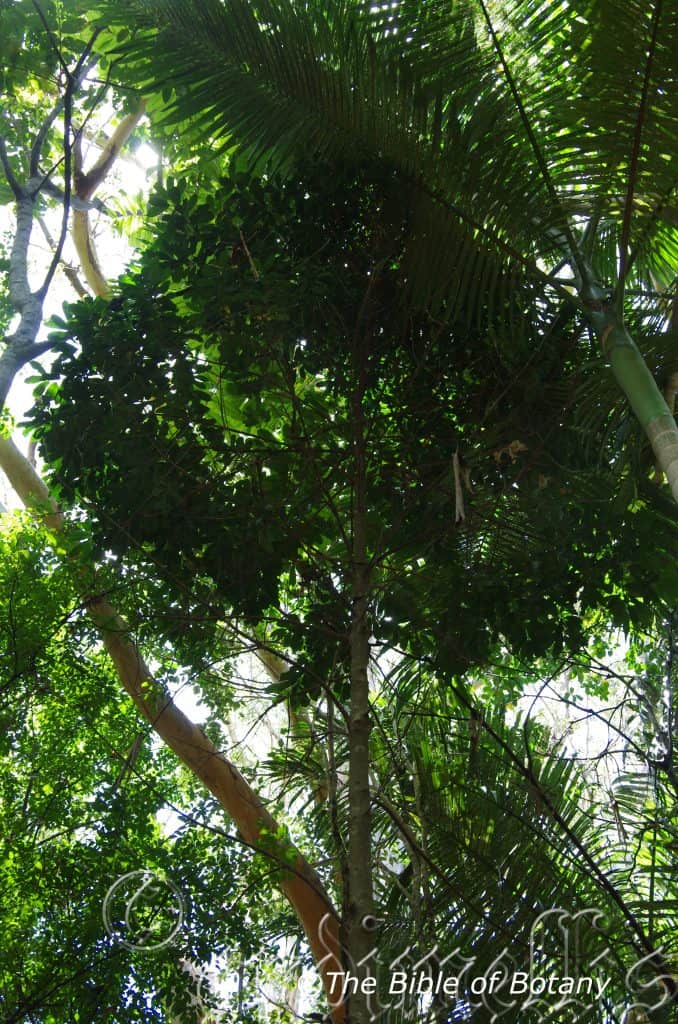
NCBG Coffs Harbour NSW

NCBG Coffs Harbour NSW

NCBG Coffs Harbour NSW
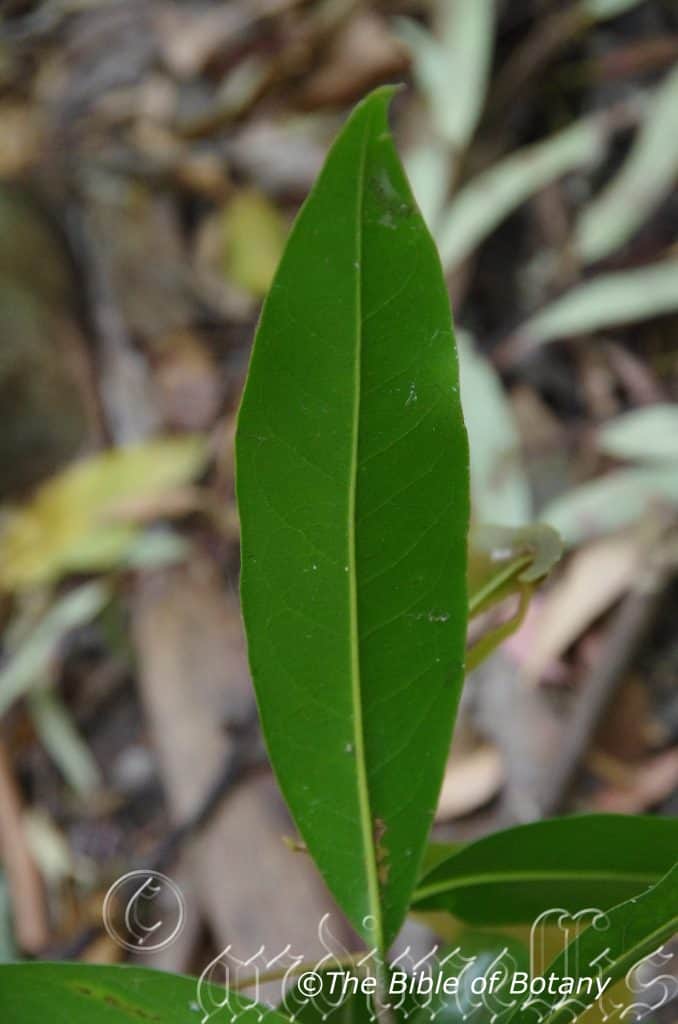
NCBG Coffs Harbour NSW
Symplocos thwaitesii
Classification:
Unranked: Eudicots
Class: Rosids
Order: Ericales
Family: Symplocaceae
Genus: From Sym, which is Ancient Greek for to be joined or united and Ploce, which is Ancient Greek for to be woven. It refers to organs like the anthers that are joined at the base and are straggly, appearing to be woven together.
Specie: Is named in honour of George Henry K. Thwaites; 1811-1882, who was a botanist and collector of plants.
Sub specie:
Common Name: Buff Hazelwood.
Distribution:
Symplocos thwaitesii is found in a several disjunct populations on and east of the Great Dividing Range south from Bettong Creek near Mareeba in far north Queensland to the Snowy River near Orbost in north eastern Victoria.
https://avh.ala.org.au/occurrences/search?taxa=Symplocos+thwaitesii#tab_mapView
Habitat Aspect Climate:
Symplocos thwaitesii prefer heavy shade to dappled shade. It grows in warm, moist tropical rainforests, warm, moist subtropical rainforests or moist gallery forests. The altitude ranges from 10 meters ASL to 900 meters ASL.
The temperatures range from minus 2 degree in August to 36 degrees in January.
The rainfalls range from lows of 850mm to 3000mm average per annum.
Soil Requirements:
Symplocos thwaitesii prefers better quality light fatty clays to medium clays. The soils are usually derived from decomposed brown basalts, black basalts, shale, metamorphic rocks or granite. The soils pH ranges from 5pH to 6.5pH. It does not tolerate water logged soils. Non saline soils to moderately saline soils are tolerated.
Height & Spread:
Wild Plants: 10m to 20m by 8m to 12m.
Characteristics:
Symplocos thwaitesii grows as a large shrub to small tree. The mid grey trunk is smooth. The mid grey branches are smooth and glabrous while the terminal buds are enclosed in glabrous green scales.
The alternate, oblanceolate to narrow elliptic leavesmeasure 100mm to 170mm in length by 30mm to 60mm in width. The petiole measures 6mm to 13mm in length. The bases are narrow cuneate to broad cuneate while the apexes are acute to acuminate. The discolourous laminas are deep grass-green to sea-green, dull to slightly glossy and glabrous on the upper laminas while the lower laminas are paler and dull. The laminas are flat to slightly recurved upwards from the mid vein to the margins and are straight or decurve gently near the base. The margins are usually irregularly toothed with callus tipped teeth especially on the apical half or at times are entire. The obtuse mid vein and pinnate lateral veins are strongly prominent while the reticulate and veins are prominent on the lower laminas. The lateral veins loop inside the margins.
The inflorescences are born on short racemes or panicles from the upper leaf axils. The peduncles, racemes and peduncles are glabrous and measure 50mm to 150mm in length. The pedicels measure 0mm to 8mm in length.
The long cupuliform calyxes measure 1.5mm to 2mm in length while the calyx lobes measure 0.2mm to 0.4mm in length. The 5 white petals measures 5mm to 6mm in length. The 90 to 110 white stamens measure 4mm to 6mm in length.
The white style and stigma are glabrous while the ovary is green. The stout pistil arises from the center of the green disc and measures 2mm to 2.5mm in length. The flowers appear from September to December.
The fruits are obcampanulate drupes. The drupes are glabrous and measure 6mm to 12mm in length by 4.5mm to 7mm in diameter. The green capsules turn deep purple to almost black when ripe. The calyx lobes are not persistent on the ripe fruit. The brownish, ellipsoidal seeds are ribbed and measure 3.5mm to 6.5mm in length by 3mm to 3.5mm in diameter.
Wildlife:
Symplocos thwaitesii wildlife is unknown to the author.
Cultivation:
Symplocos thwaitesii is a beautiful large tree that should be grown in association with other rainforest specie. It is ideal at the edge of a rain forest or deep in the center of the rainforest. It also makes a great park tree offering quick growth, and good shade on fertile soils. In cultivation it grows from 6 meters to 10 meters in height by 5 meters to 7 meters in diameter when grown in the open or taller and narrower if grown closer together as a rainforest tree.
It grows exceptionally well on lighter soils where deep leaf litter keeps the soil cool and moisture at an even level. If these requirements are met it can cope with temperatures as low as minus 3 degrees and up to 36 degrees. It is moderately drought resistant once established in their climatic zone.
Do not over fertilize after establishment as the trees can become too top heavy and are susceptible to wind damage or even blowing over especially on medium to heavy clays. To overcome this problem I planted Senna notabilis around the base of trees that have this problem and find it solves the problem feeds nitrogen and give forest litter when it is cut out.
It often reaches its full potential in just 12 to 15 years and flower from the fifth or sixth year from seed.
Propagation:
Seeds: The seeds of can be removed easily from the mature fruits. Wash the fruits and rough the outer layer of the seed on one side before sowing.
Sow the freshly treated seeds directly into a deep seed raising mix, keeping them moist not wet. Place the trays in a warm shaded area with 30mm shade cloth in the bush house. When the seedlings are 20m to 25mm tall, prick them out and plant them into 50mm native tubes using a good organic mix.
As the seedlings roots reach the bottom of the tubes plant them out into their permanent position. Do not delay.
Fertilize using Seaweed, fish emulsion or organic chicken pellets soaked in water and apply the liquid on an alternate basis. Fertilize every 2 months until the plants are well established then on an annual basis in September or March to maintain better health, vitality and flowering
Further Comments from Readers:
“Hi reader, it seems you use The Bible of Botany a lot. That’s great as we have great pleasure in bringing it to you! It’s a little awkward for us to ask, but our first aim is to purchase land approximately 1,600 hectares to link several parcels of N.P. into one at The Pinnacles NSW Australia, but we need your help. We’re not salespeople. We’re amateur botanists who have dedicated over 30 years to saving the environment in a practical way. We depend on donations to reach our goal. If you donate just $5, the price of your coffee this Sunday, We can help to keep the planet alive in a real way and continue to bring you regular updates and features on Australian plants all in one Botanical Bible. Any support is greatly appreciated. Thank you.”
In the spirit of reconciliation we acknowledge the Bundjalung, Gumbaynggirr and Yaegl and all aboriginal nations throughout Australia and their connections to land, sea and community. We pay our respect to their Elders past, present and future for the pleasures we have gained.

North Haven NSW
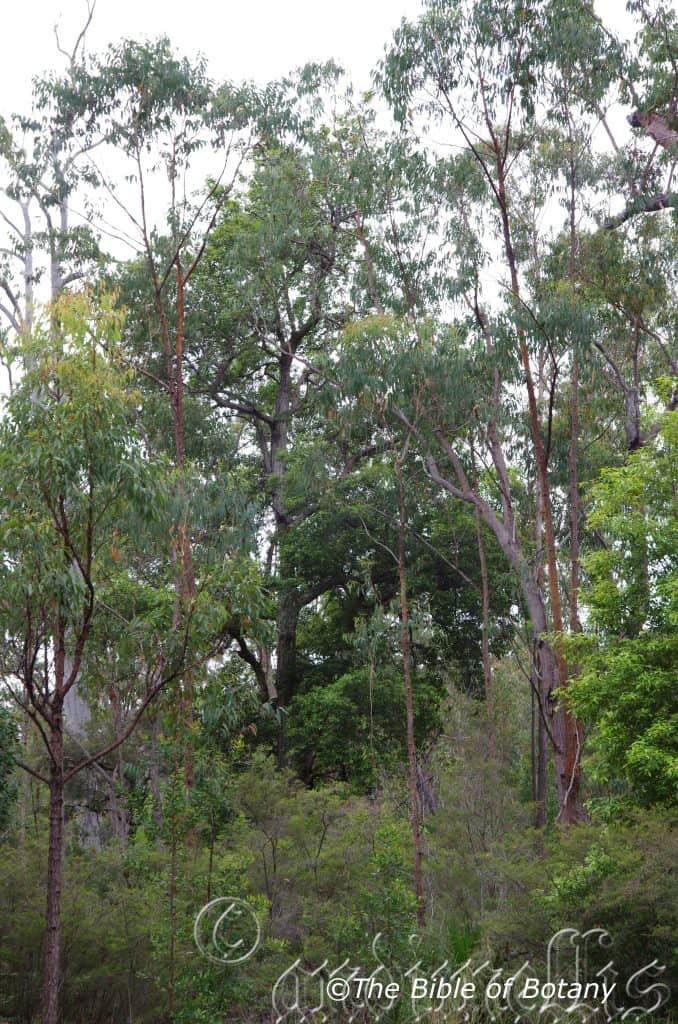
The Pinnacles NSW

Mount Cootha Botanic Gardens Qld.

North Haven NSW
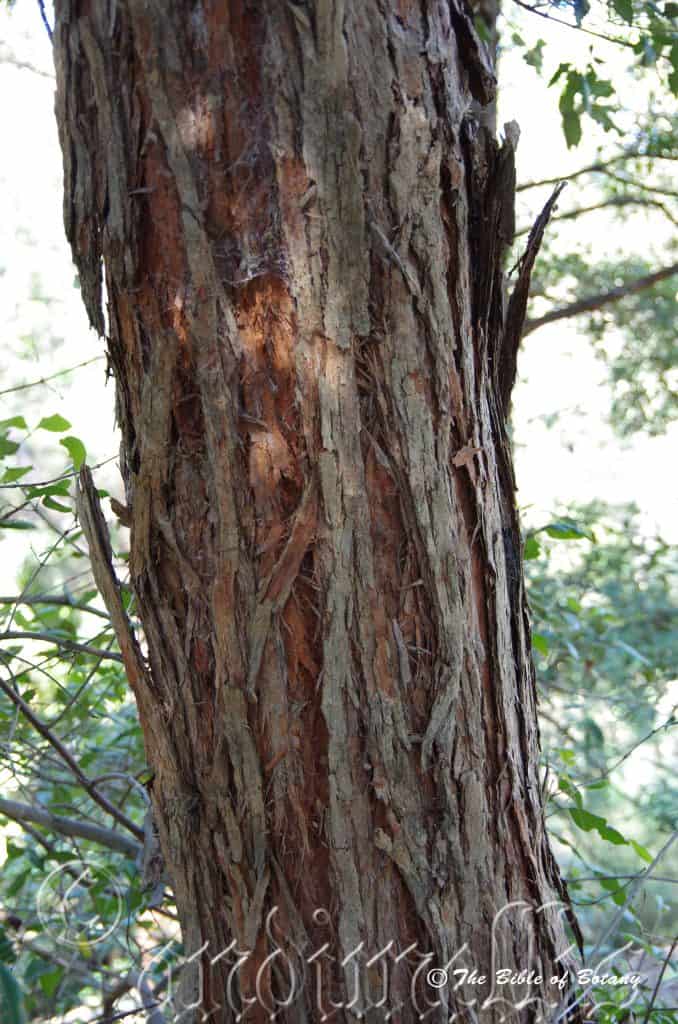
Mount Cootha Botanic Gardens Qld.

NCBG Coffs Harbour NSW

Washpool National Park NSW
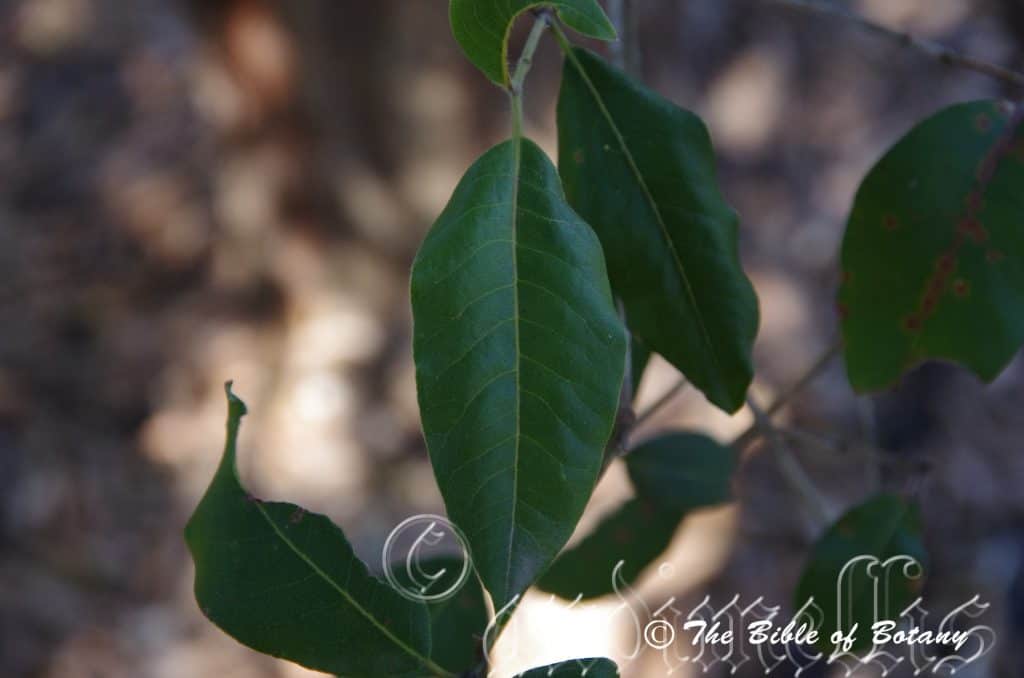
Mount Cootha Botanic Gardens Qld.
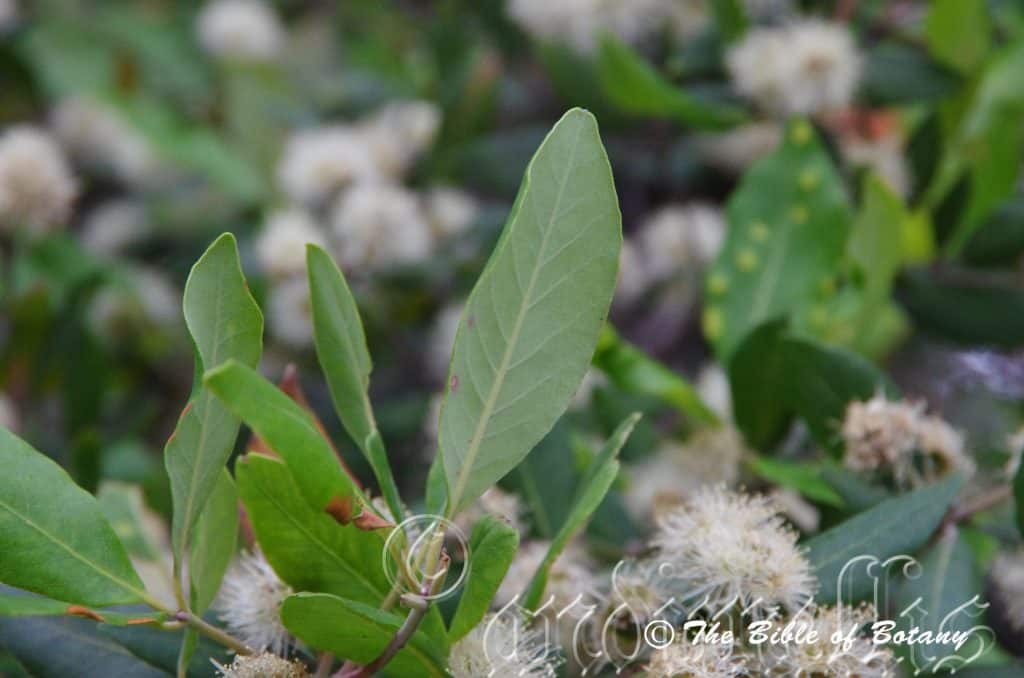
North Haven NSW
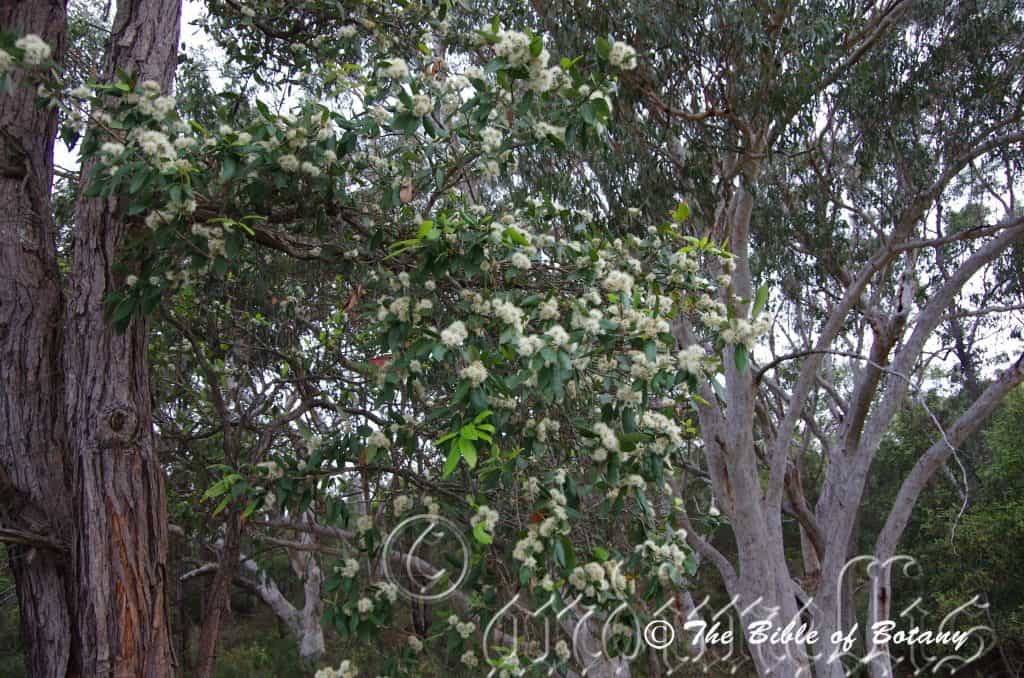
North Haven NSW
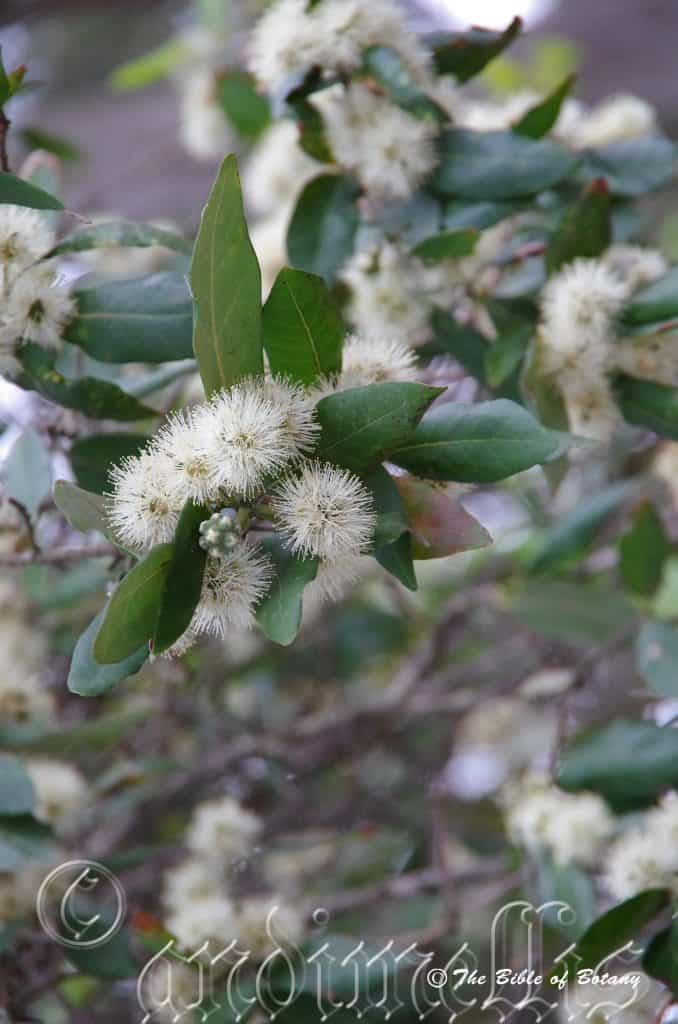
North Haven NSW

North Haven NSW
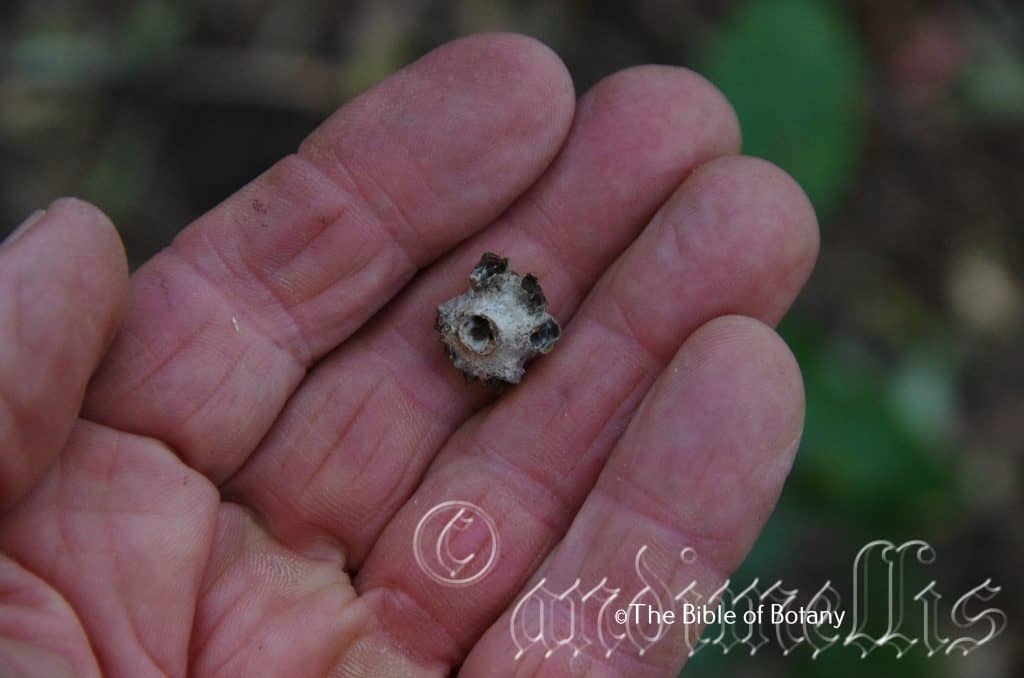
Washpool National Park NSW
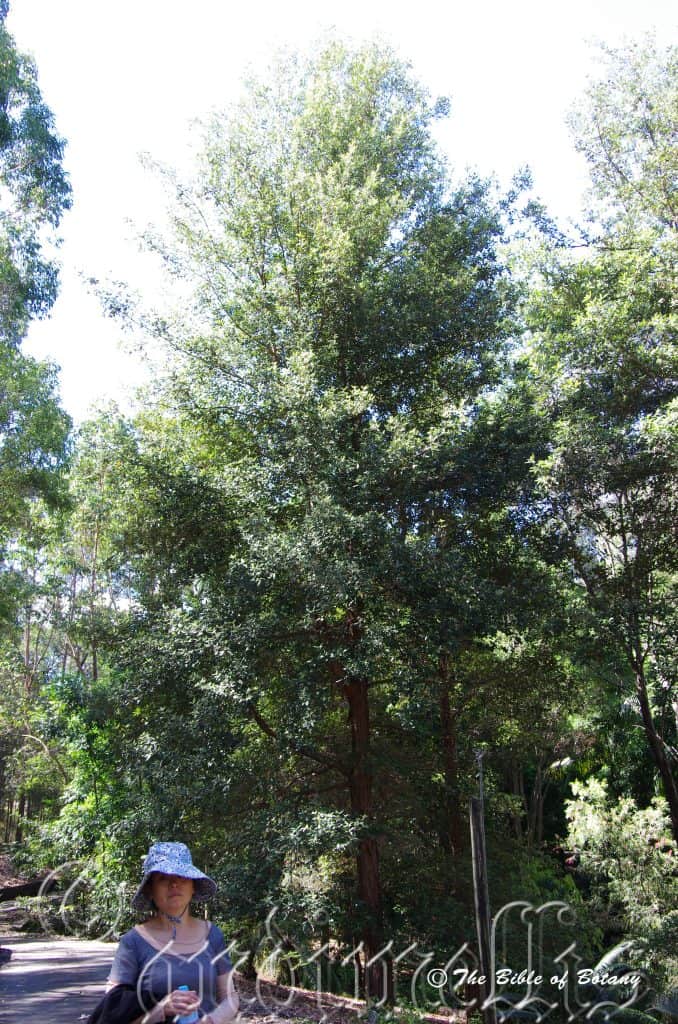
NCBG Coffs Harbour NSW
Syncarpia glomulifera
Classification:
Unranked: Eudicots
Unranked: Rosids
Order: Myrtales
Family: Myrtaceae
Genus: From Syn, which is Ancient Greek for with and Karpós, which is Ancient Greek for a fruit. It refers to fruits, which are united or joined together.
Specie: From Glometatus, which is Latin for to be gathered into making a ball and Ferae/Fer?rum, which is Latin for to bear or bearing. It refers to the individual a plant flowers, which are gathered together like little balls.
Sub specie: Syncarpia glomulifera subsp. glabra. From Glabra, which is Latin for glabrous or smooth. It refers to structures or organs, which have no hairs or scales.
Sub specie: Syncarpia glomulifera subsp. glomulifera. From Glometatus, which is Latin for to be gathered into making a ball and Ferae/Fer?rum, which is Latin for to bear or bearing. It refers to the individual a plant flowers, which are gathered together like little balls.
Common Name: Turpentine.
Distribution:
Syncarpia glomulifera subsp. glabra is found in a few disjunct populations south from the Clarence Valley to Macquarrie Lakes in coastal New South Wales.
Syncarpia glomulifera subsp. glomulifera is found south from Cairns mainly on and east of the Great Dividing Range in far north Queensland to Moruya in southern coastal New South Wales north.
https://avh.ala.org.au/occurrences/search?taxa=Syncarpia+glomulifera#tab_mapView
Habitat Aspect Climate:
Syncarpia glomulifera prefers heavy shade to full sun. It grows adjacent to moist rainforests, in dry rainforests, moist Eucalyptus forests gallery forests or riparian zones.
The temperatures range from minus 2 degree in August to 36 degrees in January.
The rainfalls range from lows of 900mm to 3000mm average per annum.
Soil Requirements:
Syncarpia glomulifera prefers better quality light fatty clays to medium clays. The soils are usually derived from decomposed brown basalts, black basalts, shale, or metamorphic rocks. The soils pH ranges from 5pH to 7pH. It does not tolerate water logged soils. Non saline soils to moderately saline soils are tolerated.
Height & Spread:
Wild Plants: 45m to 52m by 12m to 16m.
Characteristics:
Syncarpia glomulifera grows as a tall, straight tree with a long fibrous stringy bark. The bark is spongy, persistent straight or spiralling around the trunk. The branches are pale grey and scaly or flaky while the branchlets are pale grey, yellow-green to sea-green. The branchlets are glabrous on Syncarpia glomulifera sub sp. glabra while the new growth on Syncarpia glomulifera sub sp. glomulifera are sparsely to moderately covered in soft, white caducous pubescent hairs.
The ovate to narrow ovate leaves of Syncarpia glomulifera grow out in flushes and whirls around the stem. The whirls have 2 to 5, usually 4 leaves in a whirl which measure 70mm to 110mm in length by 25mm to 45mm in width. The base is broad cuneate while the apex is acute to acuminate often with an obtuse tip.
The discolourous laminas of Syncarpia glomulifera sub sp. glomulifera
are deep sea-green, dull and glabrous on the upper lamina while the lower lamina is paler and sparsely to moderately covered in minute, soft, white pubescent hairs.
The discolourous laminas of Syncarpia glomulifera sub sp. glabra are deep sea-green, dull and glabrous on the upper lamina while the lower lamina is paler and glabrous.
The leaf margins are entire and are decurve slightly towards the margins from the mid vein and as they approach the apex. The mid veins are prominent on the lower laminas. The petiole measures 7mm to 13mm in length.
The inflorescences of Syncarpia glomulifera are born on singularly or on clustered peduncles from the upper leaf axils. There are 4 to 7 peduncles in a cluster. There are 5 or 6 individual flowers in a ring with one at the apex on the peduncle.
The grass-green, deep sea-green or purple-green peduncles are glabrous on Syncarpia glomulifera sub sp. glabra while it is sparsely to moderately covered in white pubescent hairs on Syncarpia glomulifera sub sp. glomulifera.
The peduncles measure 2.5mm to 5mm in length while. The 5 creamy green sepals are erect and glabrous. The creamy green petals measure 5mm to 8mm in length by 5mm to 8mm in width.
The 30 to 40 stamens are free for their entire length and form two rings on the outer lip of the hypanthia. The dimorphic anthers measure 7.5mm and 10.5mm in length. The slender filaments are white while the basifixed, creamy yellow anthers measure 1mm to 1.5mm in length by 1mm to 1.5mm in diameter.
The white style and stigma are glabrous while the ovary is green. The pistil arises from the center of a pinkish or pale yellow-green disc and measures 5mm to 6mm in length. The flowers appear from October through to December.
The fruits of Syncarpia glomulifera are globose to depressed globose capsule. The capsules are glabrous and measure 9mm to 15mm in length by 10mm to 20mm in diameter. The green capsules turn deep grey when ripe. The calyx lobes are persistent on the ripe fruit. The rusty-brown seeds are flattened ellipsoidal and papery and measure 2mm in length.
Wildlife:
Syncarpia glomulifera is a good supplier of nectar so supports a wide range of native bees and nectar eating birds while insectivorous birds are attracted to the multitude of insects that are attracted to the flowers. The trees are a very reliable flower even during periods of drought.
Cultivation:
Syncarpia glomulifera is a beautiful large tree that should be grown in association with other rainforest specie. It is ideal at the edge of a rain forest or deep in the center of the rainforest. It also makes a great park trees offering quick growth, and good shade. In cultivation it will grow from 12 meters to 25 meters in height by 8 meters to 16 meters in diameter when grown in the open or taller and narrower if grown closer together as a rainforest tree.
It grows exceptionally well on lighter soils where deep leaf litter keeps the soil cool and moisture at an even level. If these requirements are met they can cope with temperatures as low as minus 5 degrees and up to 36 degrees. It is moderately drought resistant once established in their climatic zone.
Do not over fertilize after establishment as the trees can become too top heavy and are susceptible to wind damage or even blowing over.
It often reaches its full potential in just 12 to 15 years and flower from the fifth or sixth year from seed under ideal conditions.
Propagation:
Seeds: The seeds of Syncarpia glomulifera can be removed easily from the fruits.
Sow fresh seeds directly into a seed raising mix, keeping them moist not wet. Place the trays in a warm shaded area with 50mm shade cloth in the bush house. When the seedlings are 20m to 25mm tall, prick them out and plant them into 50mm native tubes using a good organic mix.
As the seedlings roots reach the bottom of the tubes plant them out into their permanent position. Do not delay.
Fertilize using Seaweed, fish emulsion or organic chicken pellets soaked in water and apply the liquid on an alternate basis. Fertilize every 2 months until the plants are well established then on an annual basis in September or March to maintain better health, vitality and flowering
Further Comments from Readers:
“Hi reader, it seems you use The Bible of Botany a lot. That’s great as we have great pleasure in bringing it to you! It’s a little awkward for us to ask, but our first aim is to purchase land approximately 1,600 hectares to link several parcels of N.P. into one at The Pinnacles NSW Australia, but we need your help. We’re not salespeople. We’re amateur botanists who have dedicated over 30 years to saving the environment in a practical way. We depend on donations to reach our goal. If you donate just $5, the price of your coffee this Sunday, We can help to keep the planet alive in a real way and continue to bring you regular updates and features on Australian plants all in one Botanical Bible. Any support is greatly appreciated. Thank you.”
In the spirit of reconciliation we acknowledge the Bundjalung, Gumbaynggirr and Yaegl and all aboriginal nations throughout Australia and their connections to land, sea and community. We pay our respect to their Elders past, present and future for the pleasures we have gained.
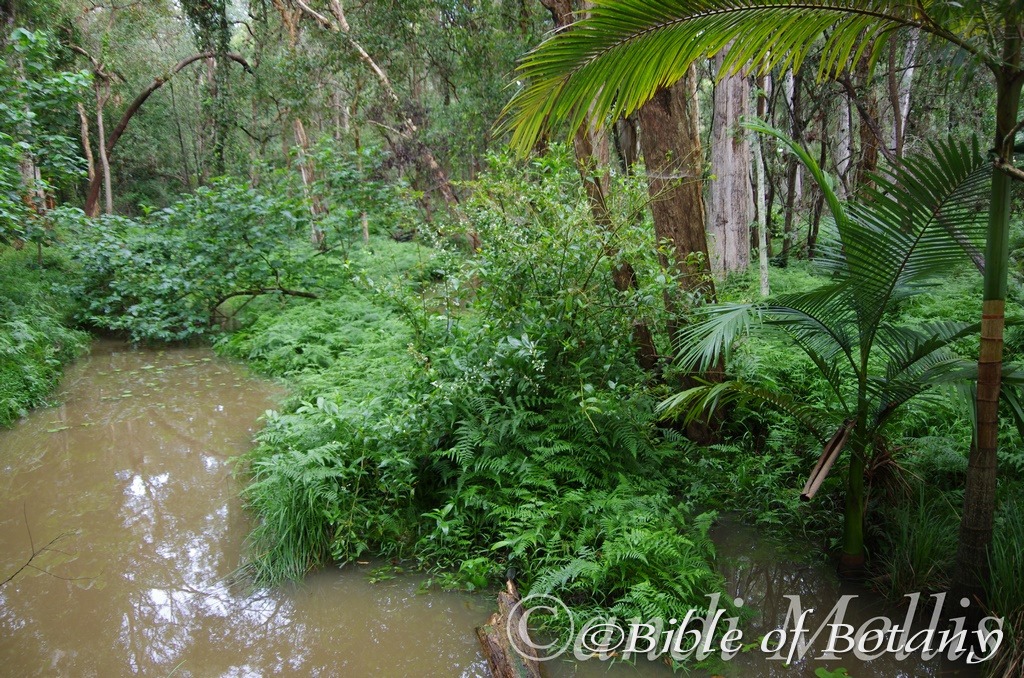
Indigiscapes Capalaba Qld.
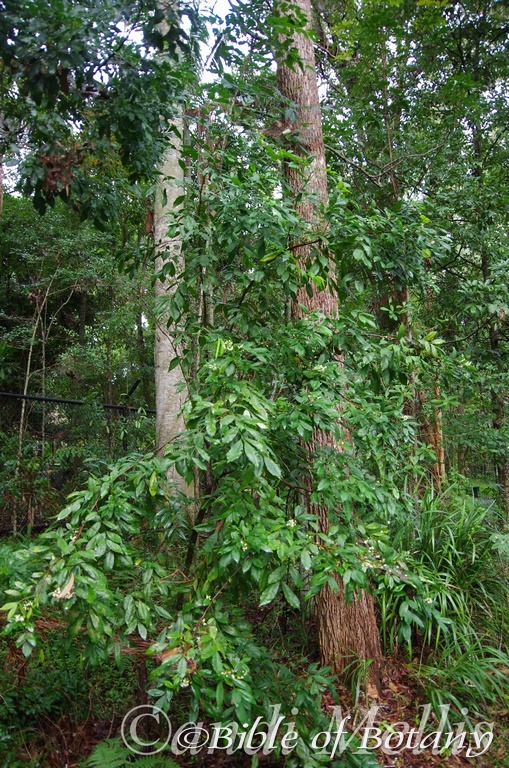
Indigiscapes Capalaba Qld.

Yuryaigir National Park NSW
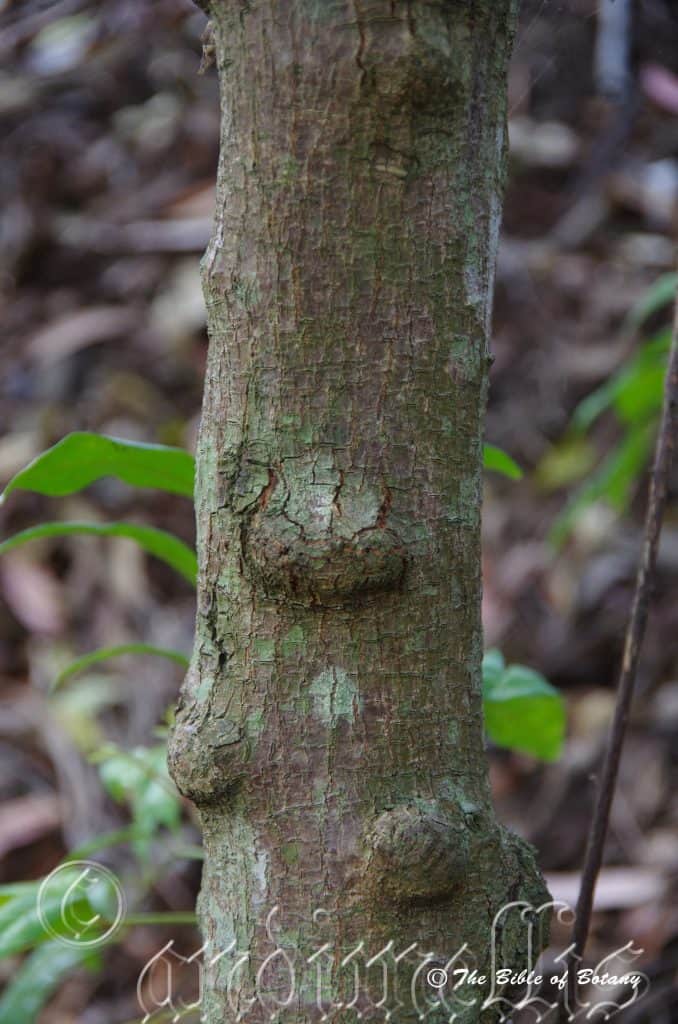
Mount Cootha Botanic Gardens Qld.

Wombat Creek Conservation Park NSW
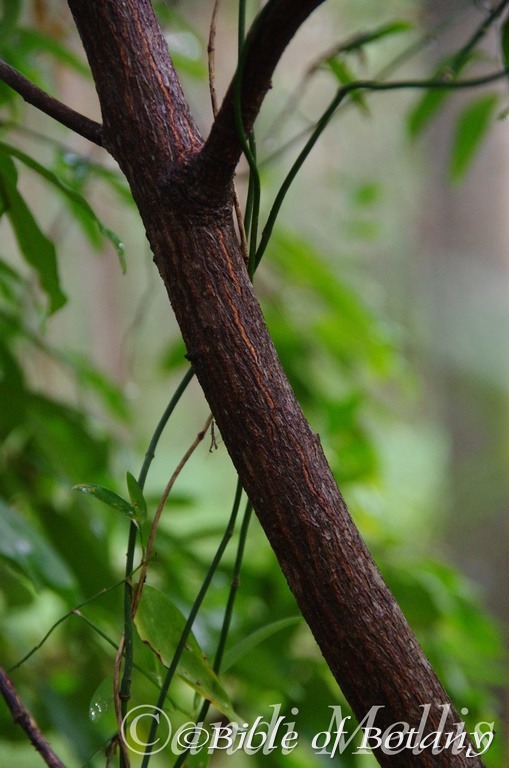
Indigiscapes Capalaba Qld.
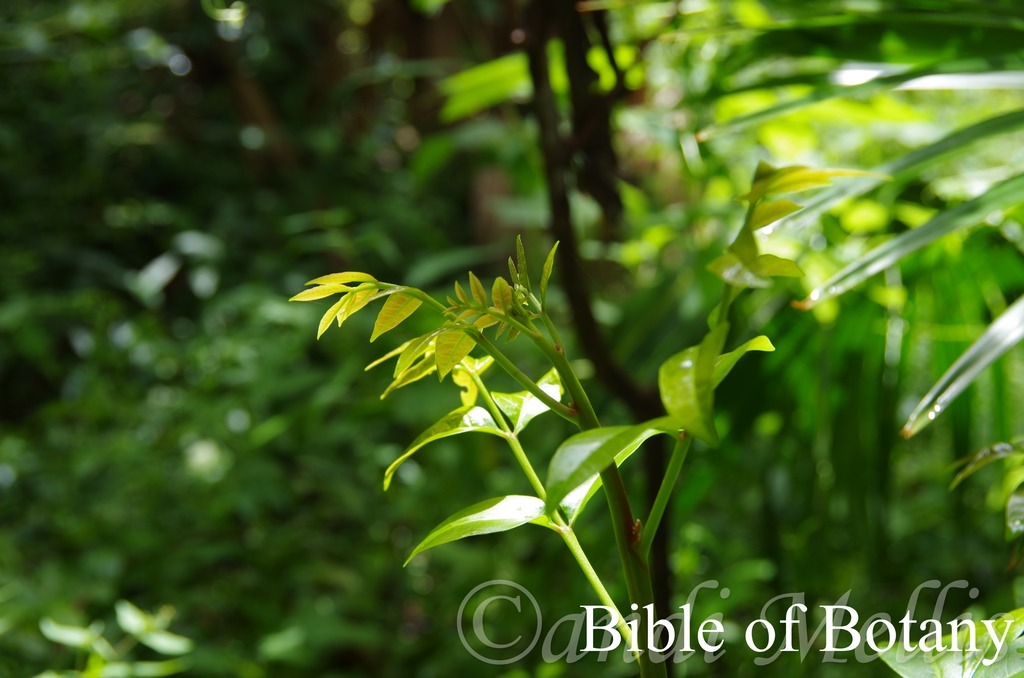
Wombat Creek Conservation Park NSW
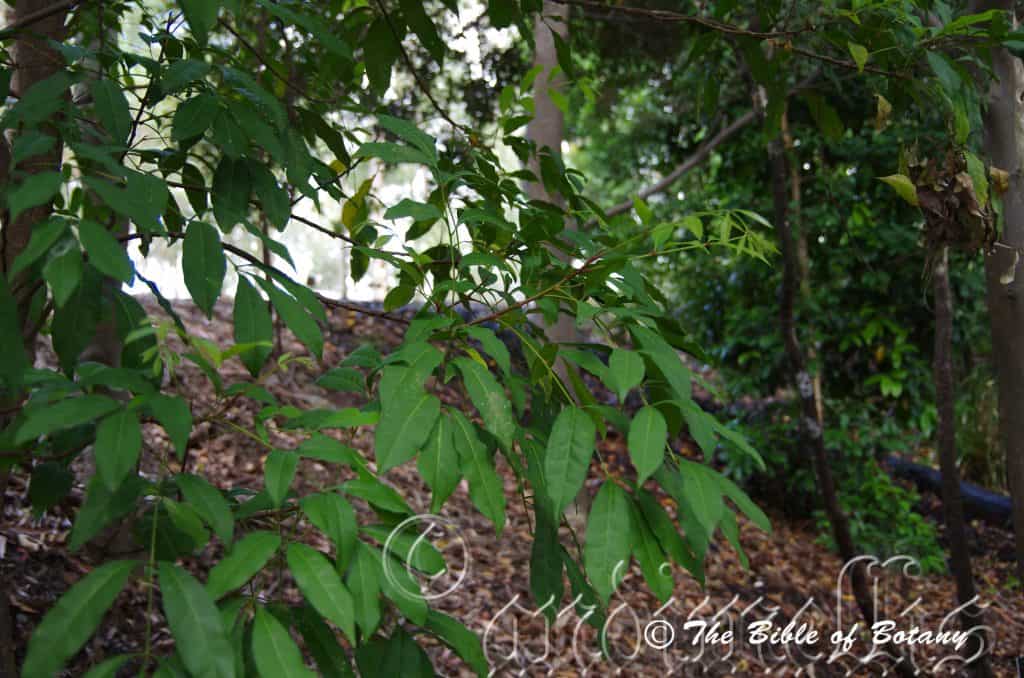
Mount Cootha Botanic Gardens Qld.
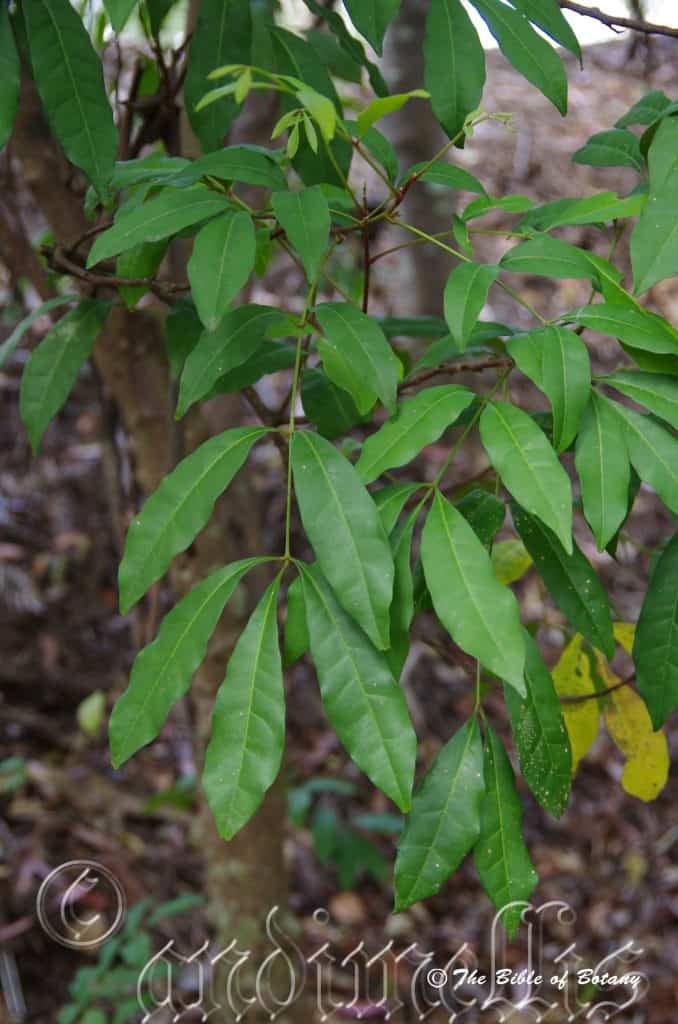
Mount Cootha Botanic Gardens Qld.

Wombat Creek Conservation Park NSW

Indigiscapes Capalaba Qld.

Indigiscapes Capalaba Qld.
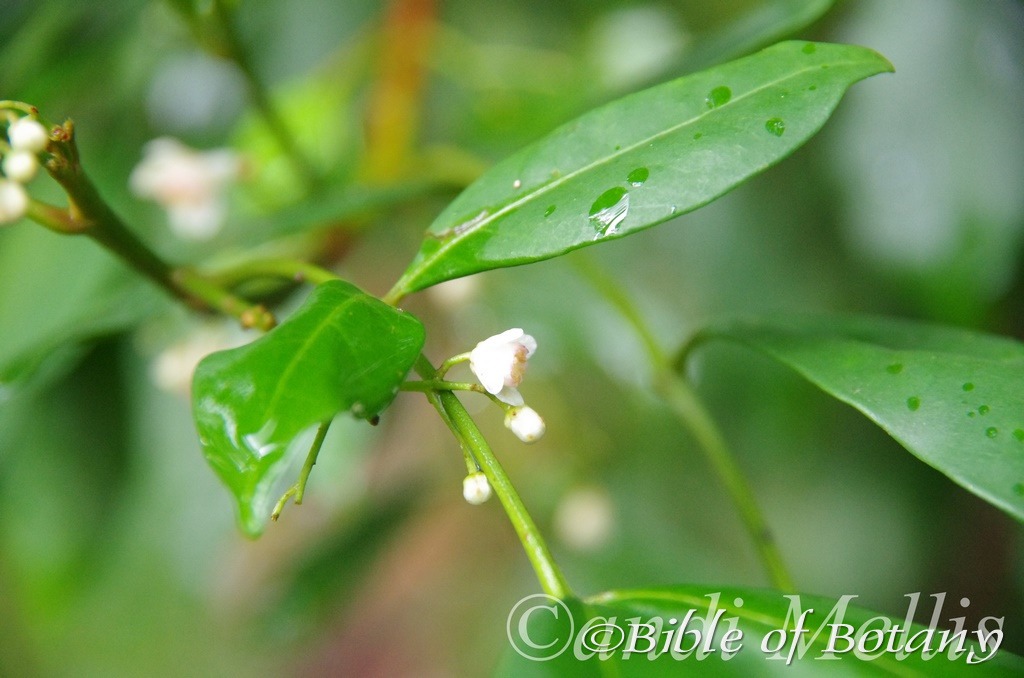
Indigiscapes Capalaba Qld.
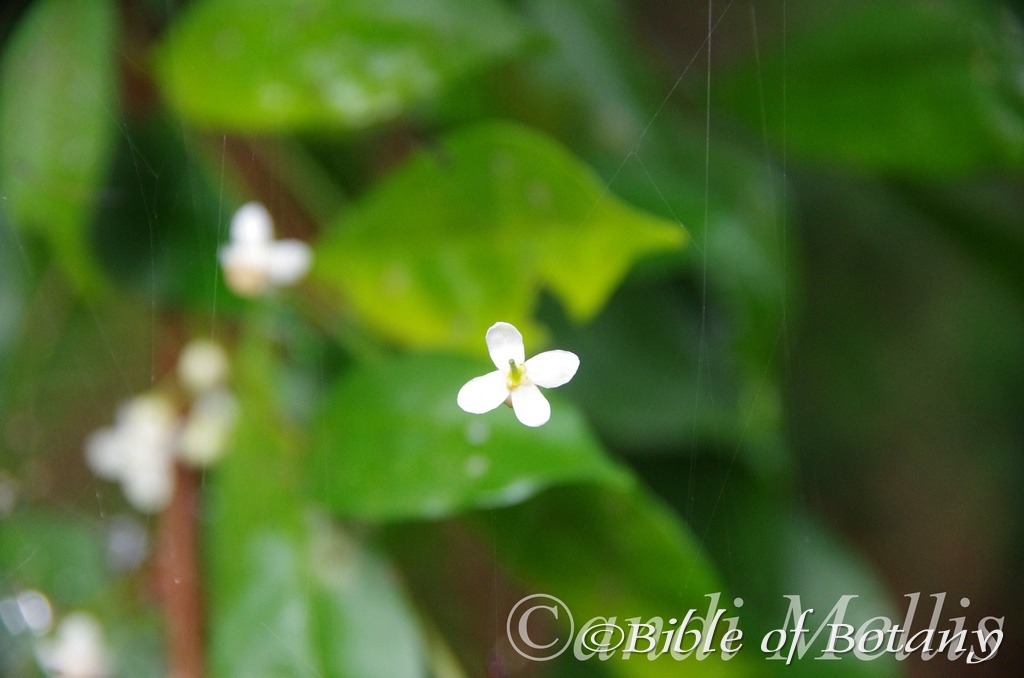
Indigiscapes Capalaba Qld.
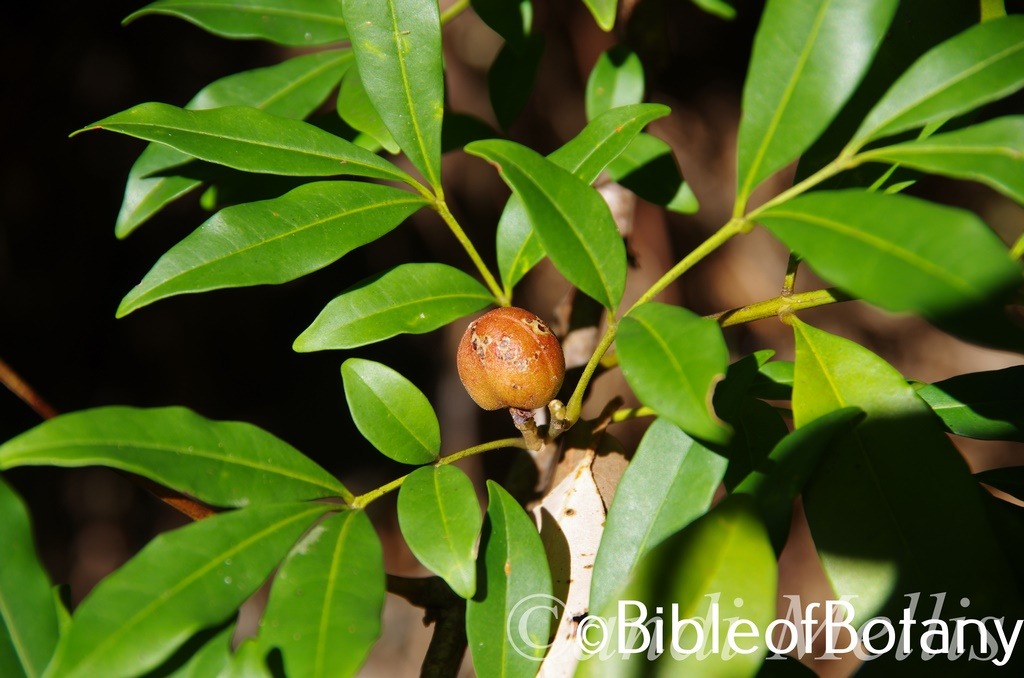
Yuryaigir National Park NSW
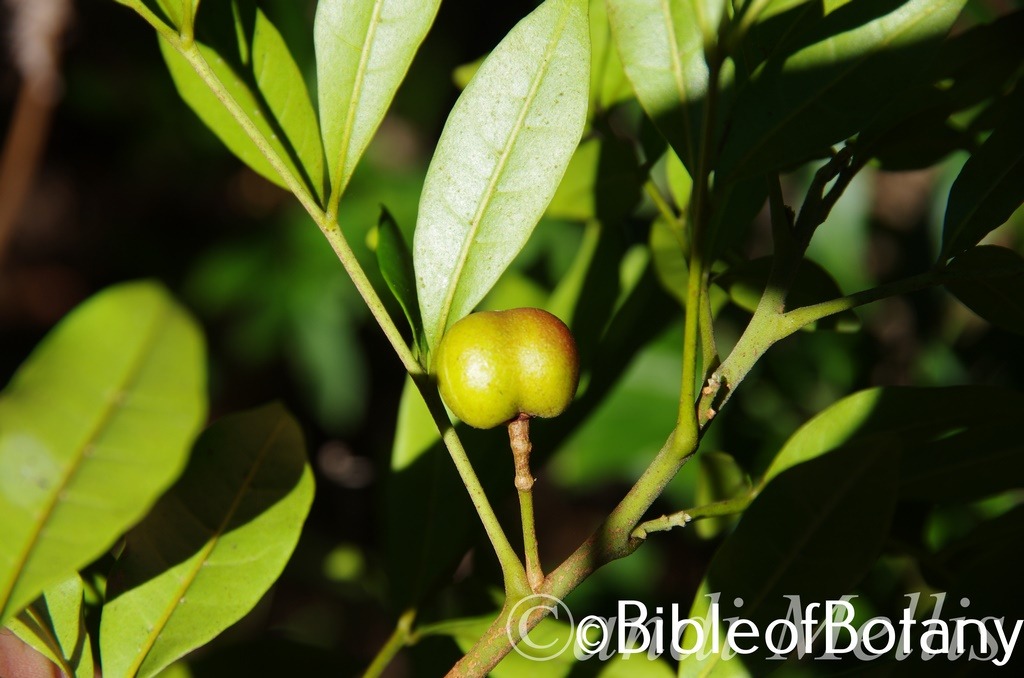
Yuryaigir National Park NSW
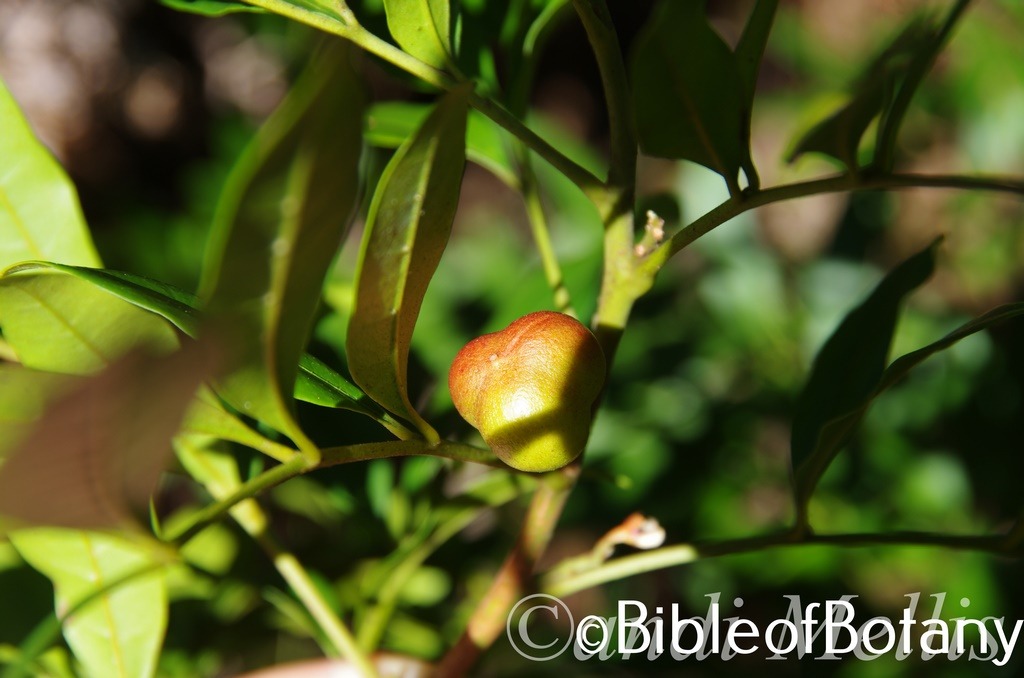
Yuryaigir National Park NSW

Yuryaigir National Park NSW

Mount Cootha Botanic Gardens Qld.
Synoum glandulosum
Classification:
Unranked: Magnoliidae
Class: Rosids
Order: Sapindales
Family: Meliaceae
Subfamily: Melioideae
Genus: From Syn, which is Ancient Greek for with and Oum, which is Ancient Greek for an ovum. It refers to two seeds which are joined together.
Specie: From Gland/Gl?ns, which are Latin for a gland. It refers to a group of cells, which make a large organ that produce a secretion.
Sub specie: Synoum glandulosum subsp. glandulosum. From Gland/Gl?ns, which are Latin for a gland. It refers to a group of cells, which make a large organ that produce a secretion.
Sub specie: Synoum glandulosum subsp. paniculosum. From Panos, which is Ancient Greek or P?nicula, which is Latin for a flower head or Panos which is Ancient Greek for a flower head. It refers to flowers, which are arranged in a head.
Common Name: Southern Rosewood or Northern Rosewood.
Distribution:
Synoum glandulosum subsp. glandulosum is found south from Tully Falls National Park in far north Queensland to Nelson’s Creek in far southern coastal New South Wales.
Synoum glandulosum subsp. paniculosum is found south from the Windsor Tableland to Keelbottom Creek in far north eastern Queensland.
https://avh.ala.org.au/occurrences/search?taxa=Synoum+glandulosum#tab_mapView
Habitat Aspect Climate:
Synoum glandulosum prefers dense shade to full sun. It grows adjacent to and in warm, moist well developed sub-tropical rainforests, warm, moist gallery forests or in cool well developed tropical rainforests. The altitude ranges from 200 meters ASL to 700 meters ASL.
The temperatures range from minus 2 degree in August to 36 degrees in January.
The rainfalls range from lows of 900mm to 3000mm average per annum.
Soil Requirements:
Synoum glandulosum prefers light gritty clays to medium clays. The soils are usually derived from decomposed brown basalts, black basalts, shale, or metamorphic rocks. The soils pH ranges from 6pH to 7pH. It does not tolerate water logged soils. Non saline soils to moderately saline soils are tolerated.
Height & Spread:
Wild Plants: 7m to 18m by 4m to 12m.
Characteristics:
The trunks of Synoum glandulosum sub sp. glandulosum have small, straight, reddish-brown scaly bark on older trees. The new growth is covered in white pulverulent hairs.
Synoum glandulosum sub sp. paniculosum have small, straight, reddish-brown strongly tessellated bark on older trees. The new growth is glabrous.
The bark is hard but corky. The branches are grey and only becoming pale deep green near the apex where the newer leaf growth occurs.
The alternate pinnate leaves of Synoum glandulosum sub sp. glandulosum measure 100mm to 300mm in length by 90mm to 200mm in width. The 3 to 11 oblanceolate to obovate or oblong-elliptical leaflets measure 50mm to 100mm in length by 15mm to 30mm in width. The terminal leaflet is the longest. The petioles, rachises and petiolules are glabrous. The petioles measure 10mm to 30mm in length while the rachises measure 0mm to 150mm and the petiolules measure 1mm to 3mm in length.
The alternate pinnate leaves of Synoum glandulosum sub sp. paniculosum measure 100mm to 380mm in length by 90mm to 240mm in width. The 3 to 11 oblanceolate to obovate or oblong-elliptical leaflets measure 50mm to 120mm in length by 25mm to 50mm in width. The terminal leaflet is the longest. The petioles, rachises and petiolules are glabrous with a channel on the upper edge of the petioles and rachises. The petioles measure 10mm to 40mm in length while the rachises measure 0mm to 220mm and the petiolules measure 1mm to 3mm in length.
The base is tapering attenuate while the apex is acuminate with an obtuse tip. The concolourous laminas are deep sea-green, dull and glabrous. The lower lamina’s domatia are positioned at junction of the main vein and the lateral veins. It is densely covered in white tomentose hairs. The leaf margins are entire while the laminas are flat or recurve slightly on the upper lamina. The mid vein and main laterals are prominent on the lower laminas.
Inflorescences of Synoum glandulosum sub sp. glandulosum are born on panicle from the leaf axils. The lime-green, orange-green, yellow-green or reddish-green peduncles, pedunculates, rachises and pedicels are glabrous. The peduncles measure 10mm to 15mm in length, the pedunculates measure 25mm to 35mm in length while the rachises measure 5mm to 16mm in length and pedicels measure 2mm to 3mm in length.
Inflorescences of Synoum glandulosum sub sp. paniculosum are born on panicle from the leaf axils. The lime-green, orange-green, yellow-green or reddish-green peduncles, pedunculates, rachises and pedicels are glabrous. The peduncles measure 10mm to 15mm in length, the pedunculates measure 25mm to 35mm in length while the rachises measure 5mm to 16mm in length and pedicels measure 2mm to 3mm in length.
The green to deep red calyx and 4 calyxes’ lobes of Synoum glandulosum are erect, glabrous with an obtuse apex. The calyxes measure 2.5mm to 3mm in length while the lobes measure 1.25mm to 1.5mm in length. The broad elliptical petals are white, white tinged pink, white tinged red or pale pink externally and white internally. The petals measure 4mm to 6mm in length by 3mm to 5mm in length.
The exserted 10 filaments are free and form a staminal tube which measure 4.5mm to 5.5mm in length on Synoum glandulosum sub sp. glandulosum and 3.5mm to 4.5mm on Synoum glandulosum sub sp. paniculosum.
The filaments are white and much broader than the cream anthers. The spherical anthers are sessile and measure 0.3mm to 0.6mm in diameter.
The white style and stigma are glabrous while the ovary is pale green and covered in white pulverulent hairs. The ovary is attached and surrounds the lower part of the ovary which measures 1.5mm to 2mm in length by 2.5mm in diameter. The stigma is a flattened umbrella like disc which measures 1.5mm in diameter. The flowers appear from March through to April.
The fruits of Synoum glandulosum sub sp. glandulosum are depressed globose, glabrous capsules. The large 3 lobed capsules are glabrous and measure 10mm to 15mm in length by 10mm to 20mm in diameter. The green capsules turn reddish when ripe. The calyx lobes are not persistent on the ripe fruit. The glossy brown seeds are ellipsoidal and partially surrounded by a red aril.
The fruits of Synoum glandulosum sub sp. paniculosum are depressed globose, glabrous capsules. The large 2 lobed capsules are glabrous and measure 15mm to 20mm in length by 16mm to 22mm in diameter. The green capsules turn deep pale creamy yellow to ochre when ripe. The calyx lobes are not persistent on the ripe fruit. The glossy brown seeds are ellipsoidal and partially surrounded by an ochre aril.
Wildlife:
Synoum glandulosum support a myriad of native insects including the native bees along the coast.
Cultivation:
Synoum glandulosum is a magnificent small tree that should be grown in association with other rainforest specie. It is ideal at the edge of a rain forest or deep in the center of the rainforest in warm temperate gardens to cool tropical gardens. They also make great park trees offering quick growth, and good shade. In cultivation they will grow from 8 meters to 10 meters in height by 6 meters to 8 meters in diameter when grown in the open or taller and narrower if grown closer together as a rainforest tree.
They grow exceptionally well on all deeper soils where a deep layer of leaf litter keeps the soil cool and moisture at an even level. Even soil moisture is critical to good growth however they dislike water logged soils. If these requirements are met they can cope with temperatures as low as minus 5 degrees and up to 38 degrees.
Add to the above, if it is given a little native fertilizer on a regular basis the plants should respond with good flowering and fruit over a long period.
3 to 5 trees planted at 7 meter to 8 meter centers in a triangle pattern can make a superb display even in a medium size back yard. This can also be the start of a very formal Bar-B- Q area, fern or shade garden. This format also lends itself well to an informal shade garden. Planted out beneath with various ferns with the upper trunk and branches covered in Platycerium specie, Pyrrosia specie or Dendrobium specie creates a miniature rainforest setting with all the extras.
They often reach their full potential in just 6 to 8 years and flower from the sixth or eighth year from seed.
The trees branches are good for epiphytic ferns and orchids.
Propagation:
Seeds: The seeds of Synoum glandulosum can be removed easily from the fruits.
Sow fresh seeds directly into a seed raising mix, keeping them moist not wet. Do not over water as the seeds will rot off before germination takes place. Place the trays in a cool shaded area with 50mm shade cloth in the bush house. When the seedlings are 40 to 60 mm tall, prick them out and plant them into 50mm native tubes using a good organic mix. Germination is usually quick and rapid growth is maintained in the nursery.
As the seedlings roots reach the bottom of the tubes plant them out into their permanent position. Do not delay.
Fertilize using Seaweed, fish emulsion or organic chicken pellets soaked in water and apply the liquid on an alternate basis. Fertilize every 2 months until the plants are well established then on an annual basis in September or March to maintain health, vigour and better flowering.
Further Comments from Readers:
“Hi reader, it seems you use The Bible of Botany a lot. That’s great as we have great pleasure in bringing it to you! It’s a little awkward for us to ask, but our first aim is to purchase land approximately 1,600 hectares to link several parcels of N.P. into one at The Pinnacles NSW Australia, but we need your help. We’re not salespeople. We’re amateur botanists who have dedicated over 30 years to saving the environment in a practical way. We depend on donations to reach our goal. If you donate just $5, the price of your coffee this Sunday, We can help to keep the planet alive in a real way and continue to bring you regular updates and features on Australian plants all in one Botanical Bible. Any support is greatly appreciated. Thank you.”
In the spirit of reconciliation we acknowledge the Bundjalung, Gumbaynggirr and Yaegl and all aboriginal nations throughout Australia and their connections to land, sea and community. We pay our respect to their Elders past, present and future for the pleasures we have gained.

Mount Cootha Botanic Gardens Qld.
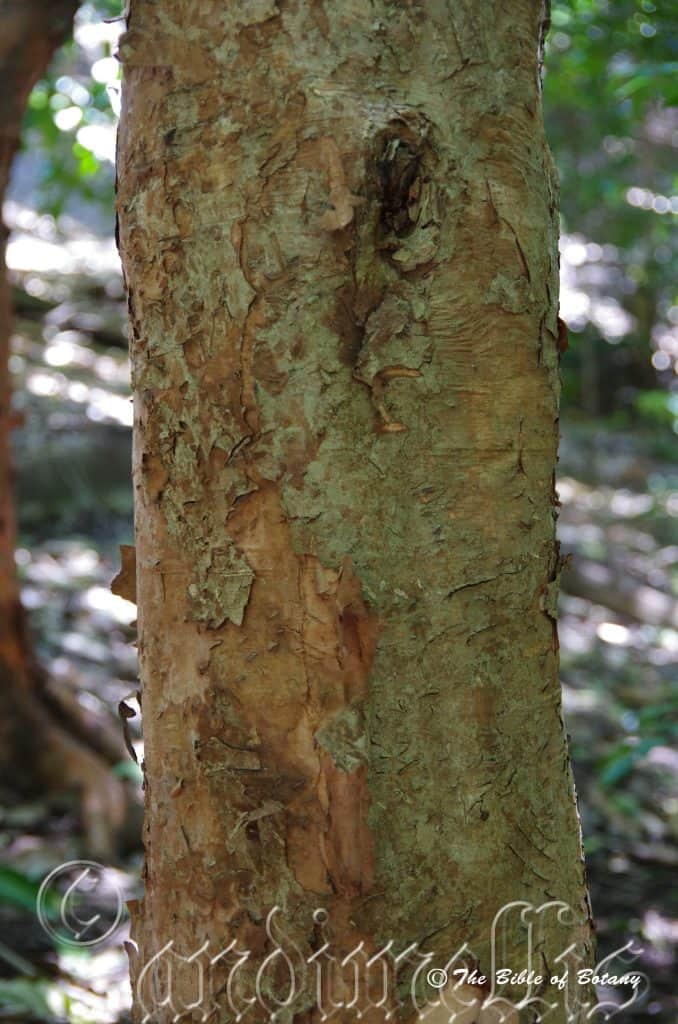
Mount Cootha Botanic Gardens Qld.
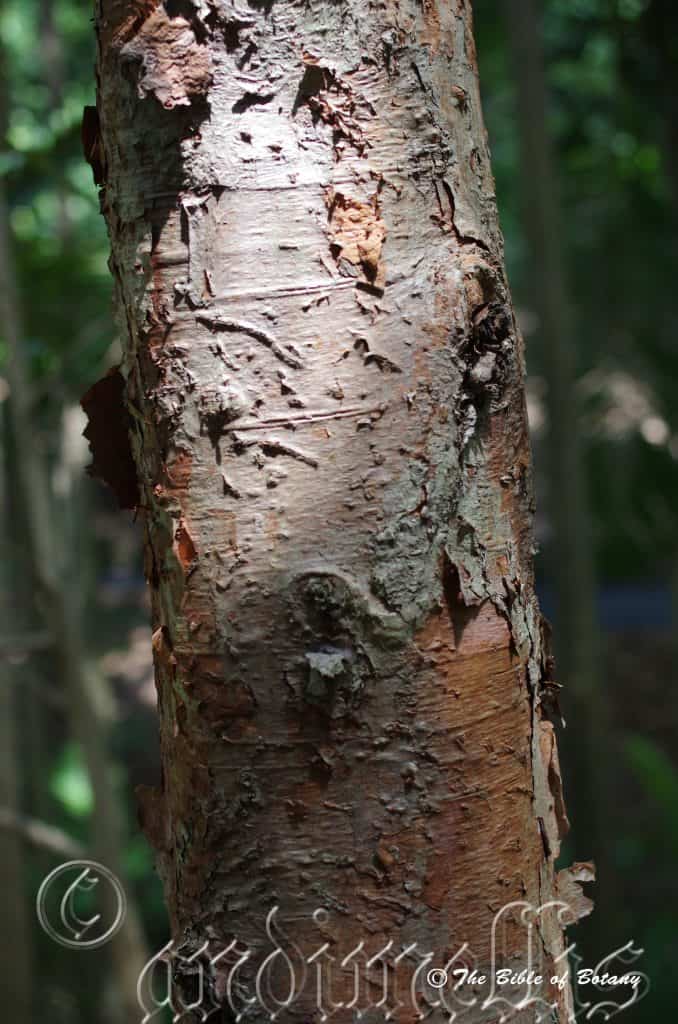
Mount Cootha Botanic Gardens Qld.
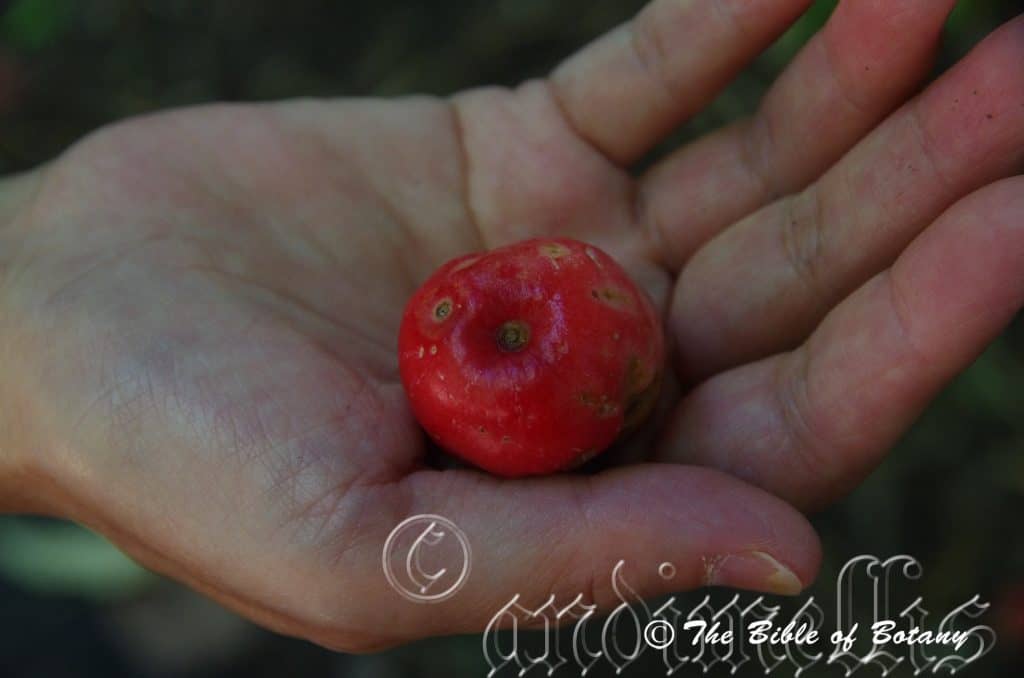
Mount Cootha Botanic Gardens Qld.
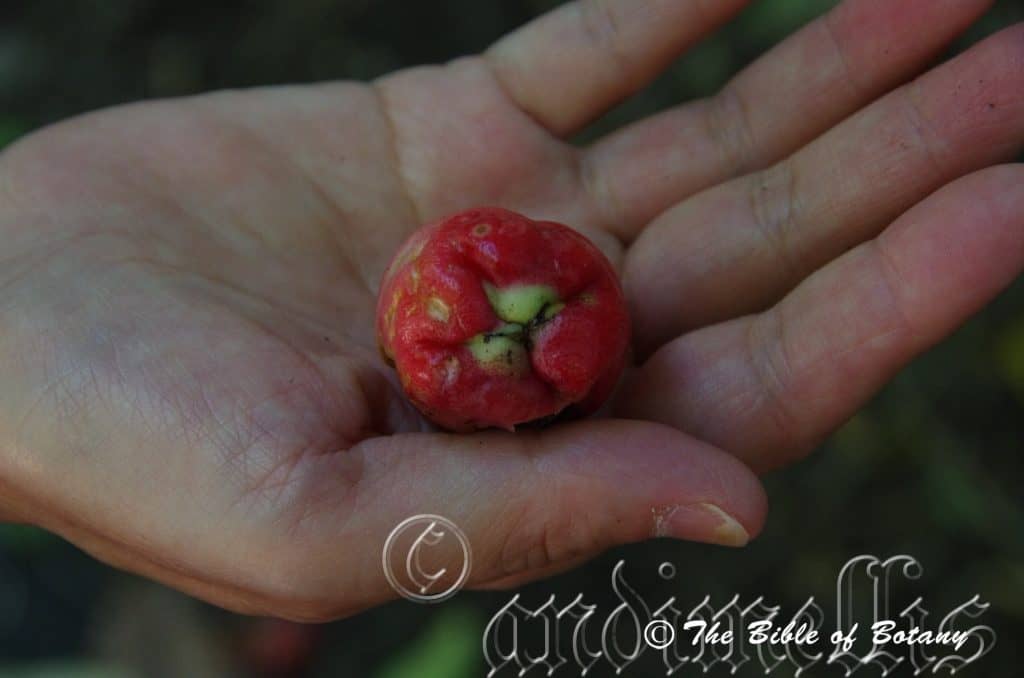
Mount Cootha Botanic Gardens Qld.
Syzygium alliiligneum
Classification:
Unranked: Eudicots
Class: Rosids
Order: Myrtales
Family: Myrtaceae
Subamily: Myrtoideae
Tribe: Syzygieae
Genus: From Súzugos, which is Ancient Greek or Syzygia, which is Latin for a pair or yoke together. It refers to leaves, which are joined together in pairs.
Specie: From Allium, which is Latin for an onion or garlic and Lignum, which is Ancient Greek for firewood or later Latin for wood. It refers to timber, which has sections of bark included in the wood, thus, it is often seen as concentric rings in stem cross sections of the wood.
Sub specie:
Common Name:
Distribution:
Syzygium alliiligneum is restricted to a small area in far north eastern Queensland on the eastern side of the Great Dividing Range between Noah Creek, Topaz and Cedar Creek Bingal Bay.
https://avh.ala.org.au/occurrences/search?taxa=Syzygium+alliigneum#tab_mapView
Habitat Aspect Climate:
Syzygium alliiligneum prefers dense shade to full sun. It grows in moist well developed tropical rainforests or moist tropical gallery forests. The altitude ranges from 20 meters ASL to 730 meters ASL.
The temperatures range from 10 degree in August to 36 degrees in January.
The rainfalls range from lows of 2200mm to 3200mm average per annum.
Soil Requirements:
Syzygium alliiligneum prefers sands, sandy loams to medium clays. The soils are derived from decomposed sandstones, granites, brown basalts, black basalts shale, or metamorphic rocks. The soils pH ranges from 6pH to 7pH. It does not tolerate water logged soils. Non saline soils to moderately saline soils are tolerated.
Height & Spread:
Wild Plants: 22m to 30m by 10m to 12m.
Characteristics:
Syzygium alliiligneum grows as a tall tree with pale reddish to pinkish brown, thin, flaky, chartaceous bark.
The opposite, broad oblanceolate to elliptical leaves of Syzygium alliiligneum measure 75mm to 115mm in length by 40mm to 56mm in width. The bluish-green, glabrous, terete petiole measures 12mm to 20mm in length. The bases are cuneate to shortly attenuate while the apexes are strongly acuminate. The coriaceous, discolourous laminas are deep green, to sea-green, semi glossy and glabrous on the upper lamina while the lower lamina is much paler to mid bluish-green and dull. The laminas are flat to recurve slightly upwards from the mid vein to the margins and decurve near the apex. The margins are entire and decurve strongly at the margin. The bluish-green mid vein is strongly prominent on the lower lamina and distinctly visible on the upper lamina. The lateral pinnate veins are faintly visible and loop inside the margins.
The inflorescences of Syzygium alliiligneum are born on simple panicles from the terminals. The deep green peduncles, rachises and pedicels are glabrous. The peduncles measure 6mm to 20mm in length while the rachises measure 6mm to 20mm in length and the pedicels measure 9mm to 17mm in length.
The deep green caducous bracts are absent at anthesis. The campanulate hypanthium (hypanthium) campanulate at anthesis measures 8mm to 12mm in length by 7mm to 11mm in diameter. The calyx lobes are hemi orbicular and measure 6mm to 7mm in length. The spathulate petals are reflexed at anthesis and measure 14mm to 16mm in length by 10mm to 12mm in width. The numerous oil dots are conspicuous and number more than 50 on each petal.
The white staminal filaments measure 18mm to 25mm in length and are glandular. The white anthers measure 1.5mm in length by 0.5mm in diameter. There is 20 to 30 locules in an ovary. The erect, white style measures 30mm to 40mm in length. The honey scented flowers appear from October through to December.
Syzygium alliiligneum’s The fruits are globular to slightly cylindrical dry fleshy berries. The large berries are glabrous and measure 38mm to 45mm in length by 30mm to 38mm in diameter. The green berries turn scarlet-red externally and white internally when ripe. The calyx lobes are persistent and recurve over the apex of the ripe fruits. The pericarp is firm and fleshy and contains numerous large oil glands particularly towards the epidermis. The seed measures 15mm to 20mm in diameter. The testa adheres to the pericarp but is easily separates.
Wildlife:
Syzygium alliiligneum support native bees along the coast. The fruits are consumed in large quantities by larger fruit eating birds like the Cassowary (Casuarius casuarius), the Little Red Flying Fox (Pteropus scapulatus) and the Grey Headed Flying Fox (Pteropus poliocephalus).
The fruits have a dry water melon texture internally and a flavour which is reminiscent of tarty loquats with a slight eucalyptus after taste. This is probably a very cleansing fruit for the Kidneys and liver.
Cultivation:
Syzygium alliiligneum is a magnificent medium tree that should be incorporated with other rainforest specie. It is ideal at the edge of a rain forest or deep in the center of the rainforest in warm sub-tropical gardens to cool tropical gardens. It also makes a great park tree offering quick growth and good shade where the soils are of better quality. In cultivation it grows from 10 meters to 15 meters in height by 6 meters to 10 meters in diameter when grown in the open or taller and narrower if grown closer together as a rainforest tree.
It grows exceptionally well on all deeper soils where a deep layer of leaf litter keeps the soil cool and moisture at an even level. Even soil moisture is critical to good growth, flowering and fruit set, however it dislikes water logged soils. If these requirements are met they can cope with temperatures as low as 2 degree and up to 38 degrees.
Add to the above, if it is given a little native fertilizer on a regular basis the plants should respond with good flowering and fruit over a long period.
3 to 5 trees planted at 8 meter to 12 meter centers in a triangle pattern can make a superb display even in a medium size back yard. This is especially the case if it is mixed with other similar size small trees with different barks. This can also be the start of a very formal Bar-B- Q area, fern or shade garden. This format also lends itself well to an informal shade garden planted out beneath with various ferns. The trunks are not suitable for attaching epiphytic ferns or orchids.
It often reaches its full potential in just 15 to 20 years in a garden and flowers from the fifth or sixth year from seed.
Propagation:
Seeds: The seeds of Syzygium alliiligneum can be removed easily from the fruits.
Sow fresh seeds directly into 50mm native tubes using a good organic mix. Germination is usually quick and rapid growth is maintained in the nursery. Do not allow the seedlings to become root bound.
As the seedlings roots reach the bottom of the tubes plant them out into their permanent position. Do not delay.
Fertilize using Seaweed, fish emulsion or organic chicken pellets soaked in water and apply the liquid on an alternate basis. Fertilize every 2 months until the plants are well established then on an annual basis in September or March to maintain health, vigour and better flowering.
Further Comments from Readers:
“Hi reader, it seems you use The Bible of Botany a lot. That’s great as we have great pleasure in bringing it to you! It’s a little awkward for us to ask, but our first aim is to purchase land approximately 1,600 hectares to link several parcels of N.P. into one at The Pinnacles NSW Australia, but we need your help. We’re not salespeople. We’re amateur botanists who have dedicated over 30 years to saving the environment in a practical way. We depend on donations to reach our goal. If you donate just $5, the price of your coffee this Sunday, We can help to keep the planet alive in a real way and continue to bring you regular updates and features on Australian plants all in one Botanical Bible. Any support is greatly appreciated. Thank you.”
In the spirit of reconciliation we acknowledge the Bundjalung, Gumbaynggirr and Yaegl and all aboriginal nations throughout Australia and their connections to land, sea and community. We pay our respect to their Elders past, present and future for the pleasures we have gained.
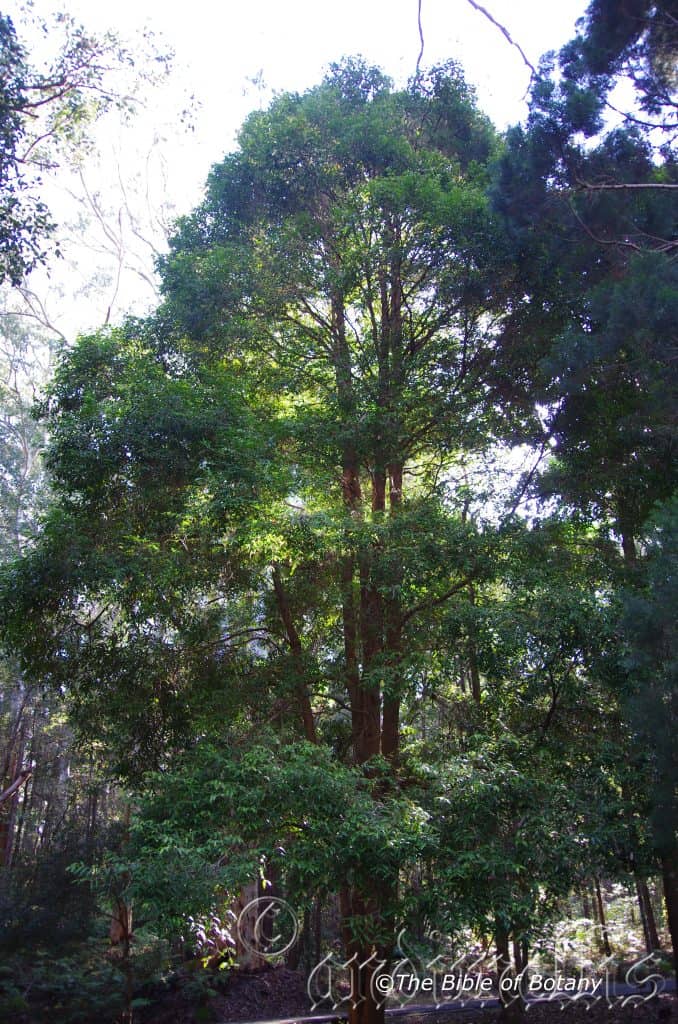
NCBG Coffs Harbour NSW

NCBG Coffs Harbour NSW
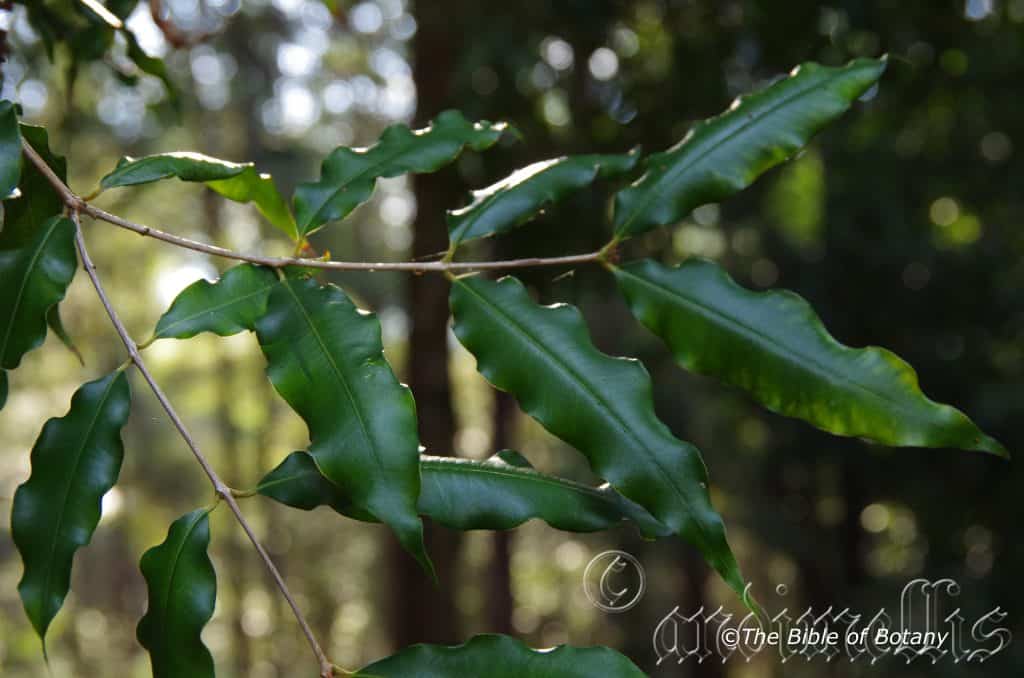
NCBG Coffs Harbour NSW

NCBG Coffs Harbour NSW
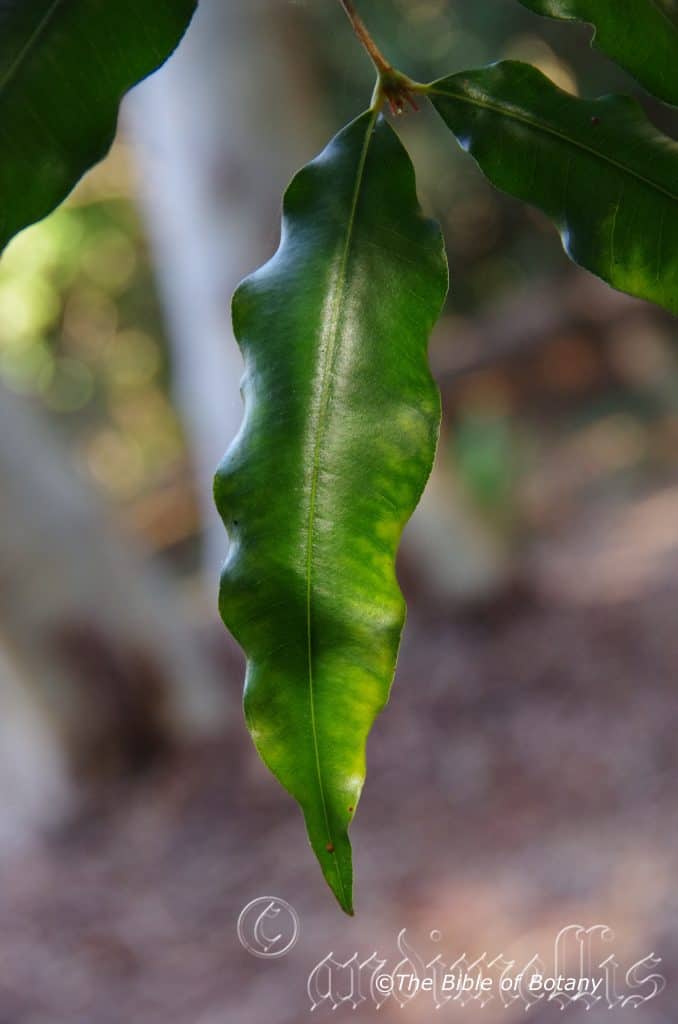
NCBG Coffs Harbour NSW
Syzygium anasatum
Classification:
Unranked: Eudicots
Class: Rosids
Order: Myrtales
Family: Myrtaceae
Subamily: Myrtoideae
Tribe: Syzygieae
Genus: From Súzugos, which is Ancient Greek or Syzygia, which is Latin for a pair or yoke together. It refers to leaves, which are joined together in pairs.
Specie: From ánison, which is Ancient Greek for aniseed. It refers to organs or structures usually the leaves, which have a distinct aniseed aroma.
Sub specie:
Common Name:
Distribution:
Syzygium anasatum is restricted to a small area in far north eastern New South Wales between the lower reaches of the Bellinger River and the lower reaches of the Macleay River.
https://avh.ala.org.au/occurrences/search?taxa=Syzygium+aqueum#tab_mapView
Habitat Aspect Climate:
Syzygium anasatum prefers dense shade to full sun. It grows adjacent to moist monsoonal lowland rainforests, gallery forests or riparian zones. The altitude ranges from 10 meters ASL to 150 meters ASL.
The temperatures range from 1 degree in August to 40 degrees in January.
The rainfalls range from lows of 900mm to 1200mm average per annum.
Soil Requirements:
Syzygium anasatum prefers better quality fine silty sands, sandy loams to medium clays. The soils are derived from decomposed, granites, brown basalts, black basalts shale and alluvial silts. The soils pH ranges from 6pH to 7.5pH. It does not tolerate water logged soils. Non saline soils to moderately saline soils are tolerated.
Height & Spread:
Wild Plants: 6m to 10m by 4m to 6m.
Characteristics:
Syzygium anasatum grows as a small, crooked trunked tree with a corky, deep grey-brown, longitudinally fissured, ribbed flaky bark. The branches are deep grey-brown. The stems are glabrous and pale green near the apex where the newer leaves growth occurs.
The opposite to subopposite, lanceolate to elliptic leaves of Syzygium anasatum measure 50mm to 125mm in length by 10mm to 25mm in width. The terete petiole measures 5mm to 10mm in length. The base is round cuneate to slightly attenuate while the apex is acuminate. The discolourous laminas are deep green, glossy and glabrous on the upper lamina, while the lower lamina is paler and duller. The undulating leaf margins are entire, while the laminas decurve or recurve from the mid vein towards the margin and decurve towards gently from the base to the apex. The mid vein and main laterals are slightly prominent on the lower lamina, while the main vein is depressed on the upper surface. The intramarginal vein is close to margin. There are numerous distinct oil dots, while the crushed leaves emit a strong aniseed scent.
Inflorescences of Syzygium anasatum are born on simple cymes from the upper leaf axis and are terminal. The pale blueish-green or pale green peduncles, rachises and pedicels are glabrous. The peduncles measure 6mm to 22mm in length, while the rachises measure 6mm to 20mm in length and the pedicels measure 4mm to 8mm in length.
The 5 cream calyx lobes are glabrous. The calyx tubes measure 3mm to 7mm in length while the dimorphic, lanceolate to obtuse lobes measure 1mm to 1.5mm in length. The 5 white petals are obtuse and measure 2.5mm to 4mm in length by 2.5mm to 4mm in diameter.
The hypanthium is pale green and glabrous.
The exserted filaments are free for their entire length and dimorphic in length. The outer filaments measure 10mm to 16mm in length while the inner filaments measure 6mm to 8mm in length. The anthers are pale cream. The orbicular anthers are basifixed.
The white style and stigma are glabrous and measure 10mm to 16mm. The flowers appear from September through to November.
The fruits Syzygium anasatum are campanulate berries. The fruits measure 4mm to 7mm in length by 4mm to 7mm in diameter.
Wildlife:
Syzygium anasatum support most of our local native bees like Tetragonula carbonaria.
Cultivation:
Syzygium anasatum is a magnificent small tree that should be incorporated with other rainforest specie. It is ideal at the edge of a rain forest or deep in the center of the rainforest in warm sub-tropical gardens to cool tropical gardens. They also make great park trees offering quick growth, and good shade. In cultivation they will grow from 6 meters to 8 meters in height by 4 meters to 6 meters in diameter when grown in the open or taller and narrower if grown closer together as a rainforest tree.
It grows exceptionally well on all deeper soils where a deep layer of leaf litter keeps the soil cool and moisture at an even level. Even soil moisture is critical to good growth, flowering and fruit set, however they dislike water logged soils. If these requirements are met they can cope with temperatures as low as minus 5 degrees and up to 38 degrees.
Add to the above, if it is given a little native fertilizer on a regular basis the plants should respond with good flowering and fruit over a long period.
3 to 5 trees planted at 5 meter to 7 meter centers in a triangle pattern can make a superb display even in a medium size back yard. This is especially the case if it is mixed with other similar size small trees with different barks. This can also be the start of a very formal Bar-B- Q area, fern or shade garden. This format also lends itself well to an informal shade garden. Planted out beneath with various ferns with the upper trunk and branches covered in Platycerium, Pyrrosia or Dendrobium creates a miniature rainforest setting with all the extras.
It often reaches its full potential in just 5 to 6 years and flowers from the fifth or sixth year from seed.
The trees branches are good for epiphytic ferns and orchids.
As an orchard tree for its aniseed oil known in the aromatherapy trade as anise myrtale oil it shows great potential in the tropics. It has a good shelf life and refrigerate for several years. When grown commercially it should be planted at 5 meter centers and pruned early to induce lateral growth. Lateral branches will produce smaller trees with a greater spread which makes the leaves easier to harvest. It is a light feeder that require high volumes of water to keep the soil at even moisture level. This is critical for good leaf production. It responds well to native organic fertilizers and animal manures.
Propagation:
Seeds: The seeds of Syzygium anasatum can be removed easily from the fruits.
Sow fresh seeds directly into a seed raising mix, keeping them moist not wet. Do not over water as the seeds will rot off before germination takes place. Place the trays in a cool shaded area with 50mm shade cloth in the bush house. When the seedlings are 40 to 60 mm tall, prick them out and plant them into 50mm native tubes using a good organic mix. Germination is usually quick and rapid growth is maintained in the nursery. Do not allow the seedlings to become root bound especially if it is going to be used for fruit production.
As the seedlings roots reach the bottom of the tubes plant them out into their permanent position.
Cuttings:
Fortunately Syzygium anasatum cuttings strike relatively easy and should be used where plants that have better quality or volume of oil is required. Use 100mm to 200mm long tip cuttings or lateral shoots from the present season’s growth. Take them in warmer months of the year. Remove half the leaves from the bottom section being careful not to tear the bark.
1 Prepare the cutting mix by adding two thirds sharp clean river sand, one third peat or one third perlite. These ingredients must be sterilized,
2 Select good material from non diseased plants,
3 Select semi green stems for cuttings. Look for a stem with two or three nodes,
4 Place the cutting on a flat, hard surface, and make a clean cut down one side of the cutting at the base for 10mm with a sharp sterile knife or razor blade. – This scarification of the node will increase the chances of roots emerging from this spot. Now remove all but one or two the leaves, leaving the apex leaves in tact. If the leaves are very large in proportion to the stem, cut off the apical halves.
5 Fill a saucer with water, and place a little medium strength rooting hormone into another container like a milk bottle top. Dip the node end of the cutting into the water and then into the rooting hormone. Tap off any excess hormone,
6 Use a small dipple stick or old pencil to poke a hole into the soilless potting mix. Ensure the hole is slightly larger than the stem diameter and be careful not to wipe the rooting hormone off the cuttings base. Place 2 to 4 cuttings in each of the 50mm native tubes,
7 I like to place the tubes in bucket with holes drilled in the bottom to allow excess water to drain out. A plastic bag that fits over the bucket is ideal to help maintain temperature and moisture. Place in a semi shaded, warm position like under 50mm shade cloth.
8 When the cuttings have struck, open the bag to allow air circulation for a few days to a week,
9 Once hardened off remove the cuttings from the bag and allow to further hardening for a few more days to a week,
10 Transplant into a good potting mix to grow on.
Fertilize using seaweed, fish emulsion or organic chicken pellets soaked in water on an alternate basis. Fertilize every two months until the plants are established then twice annually in early September or March to maintain health, vitality and better flowering.
Further Comments from Readers:
“Hi reader, it seems you use The Bible of Botany a lot. That’s great as we have great pleasure in bringing it to you! It’s a little awkward for us to ask, but our first aim is to purchase land approximately 1,600 hectares to link several parcels of N.P. into one at The Pinnacles NSW Australia, but we need your help. We’re not salespeople. We’re amateur botanists who have dedicated over 30 years to saving the environment in a practical way. We depend on donations to reach our goal. If you donate just $5, the price of your coffee this Sunday, We can help to keep the planet alive in a real way and continue to bring you regular updates and features on Australian plants all in one Botanical Bible. Any support is greatly appreciated. Thank you.”
In the spirit of reconciliation we acknowledge the Bundjalung, Gumbaynggirr and Yaegl and all aboriginal nations throughout Australia and their connections to land, sea and community. We pay our respect to their Elders past, present and future for the pleasures we have gained.
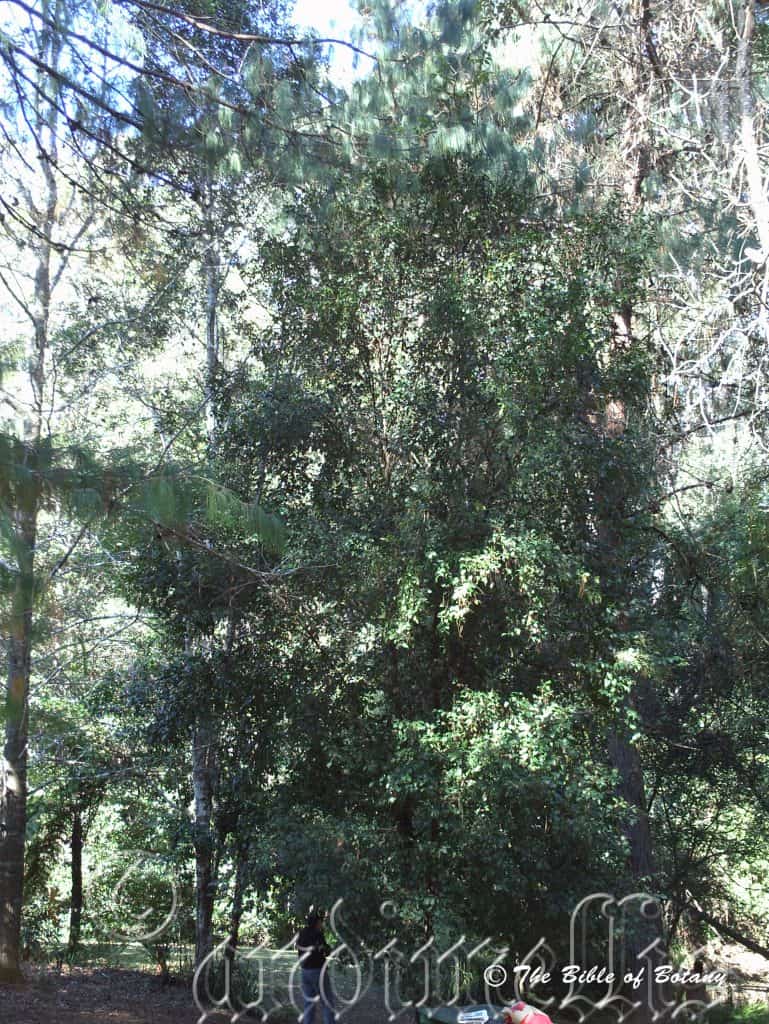
Swans Crossing NSW

Author’s Garden The Pinnacles NSW
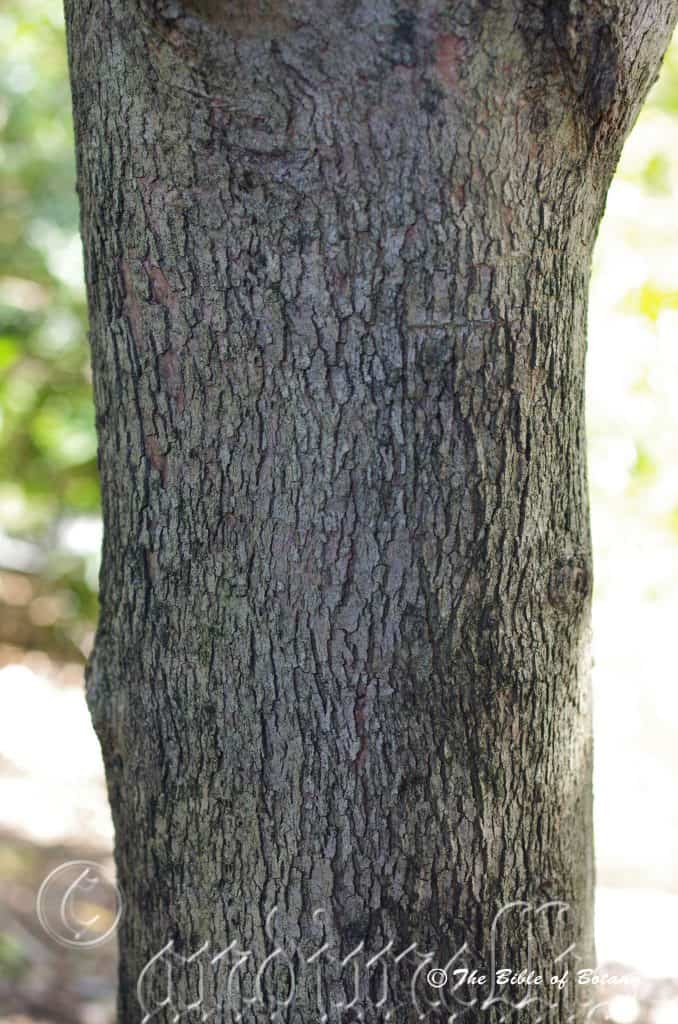
Mount Cootha Botanical Gardens Qld.
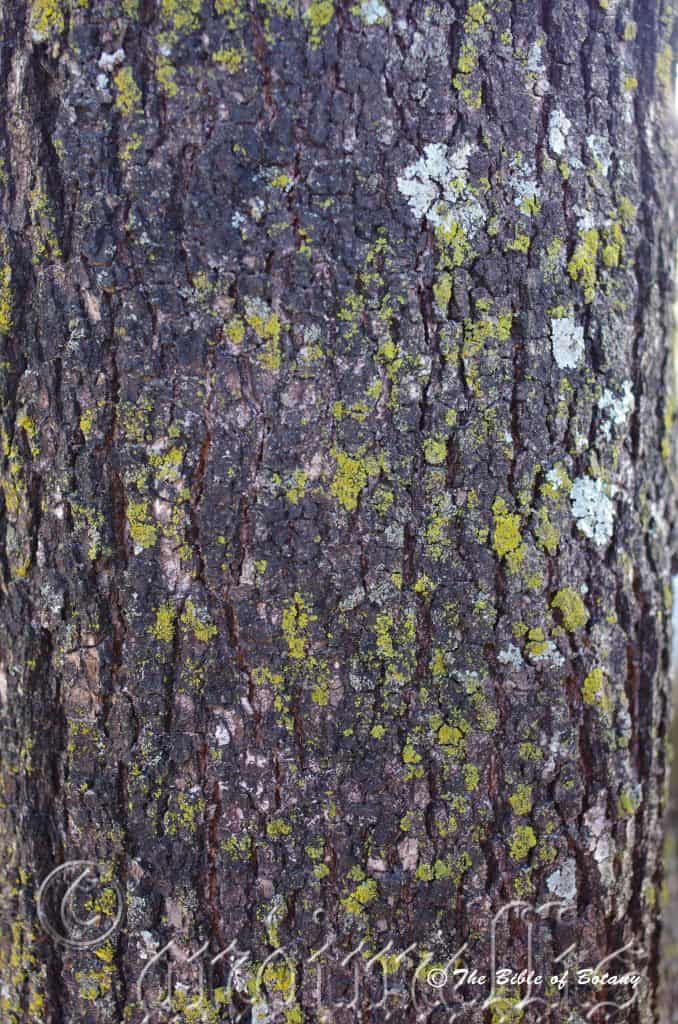
Everton Park Qld.

Author’s Garden The Pinnacles NSW
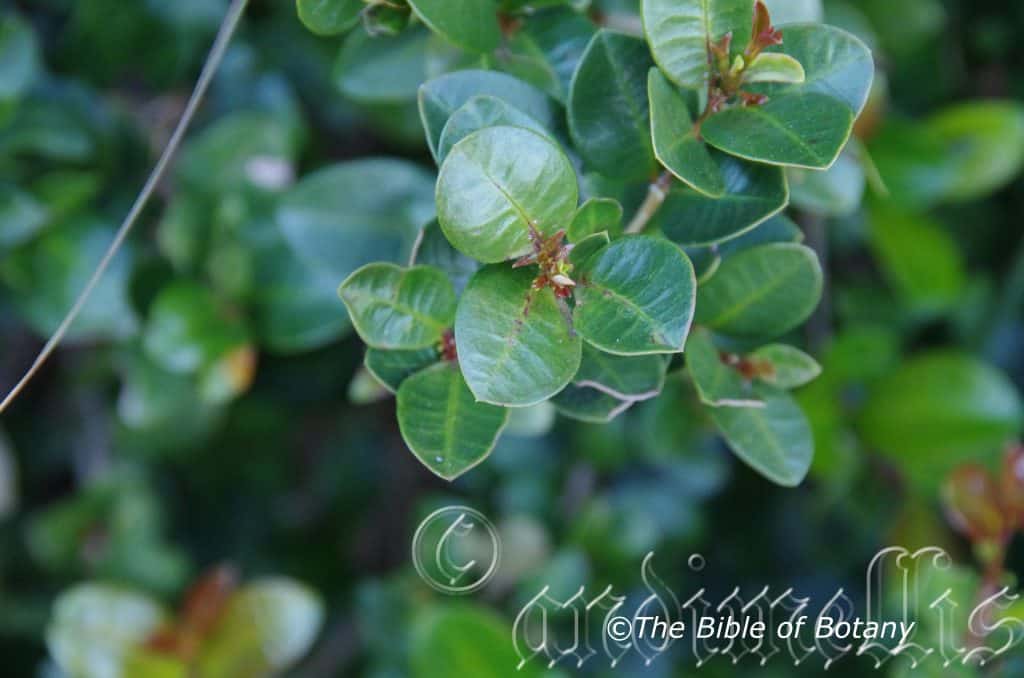
Look At Me Now Headland NSW

Look At Me Now Headland NSW
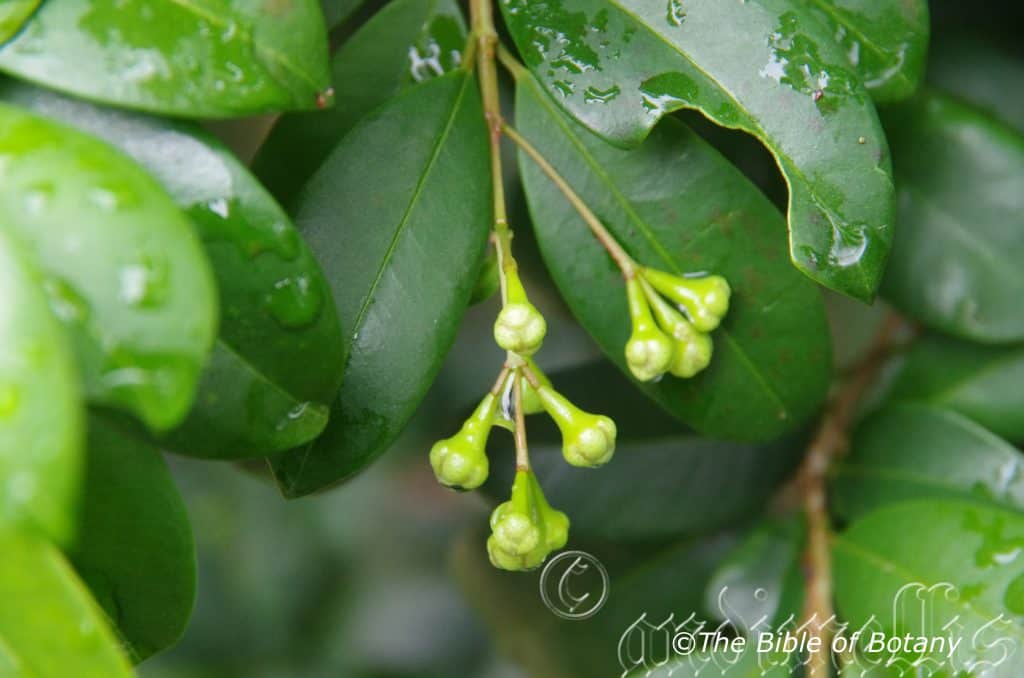
Author’s Garden The Pinnacles NSW

Author’s Garden The Pinnacles NSW
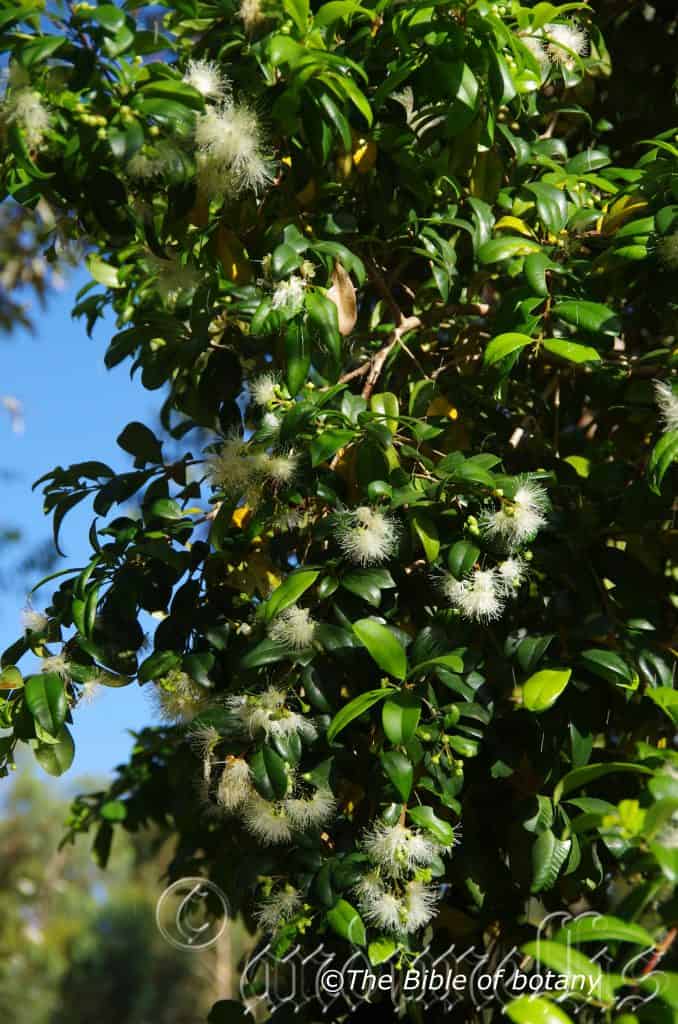
Author’s Garden The Pinnacles NSW
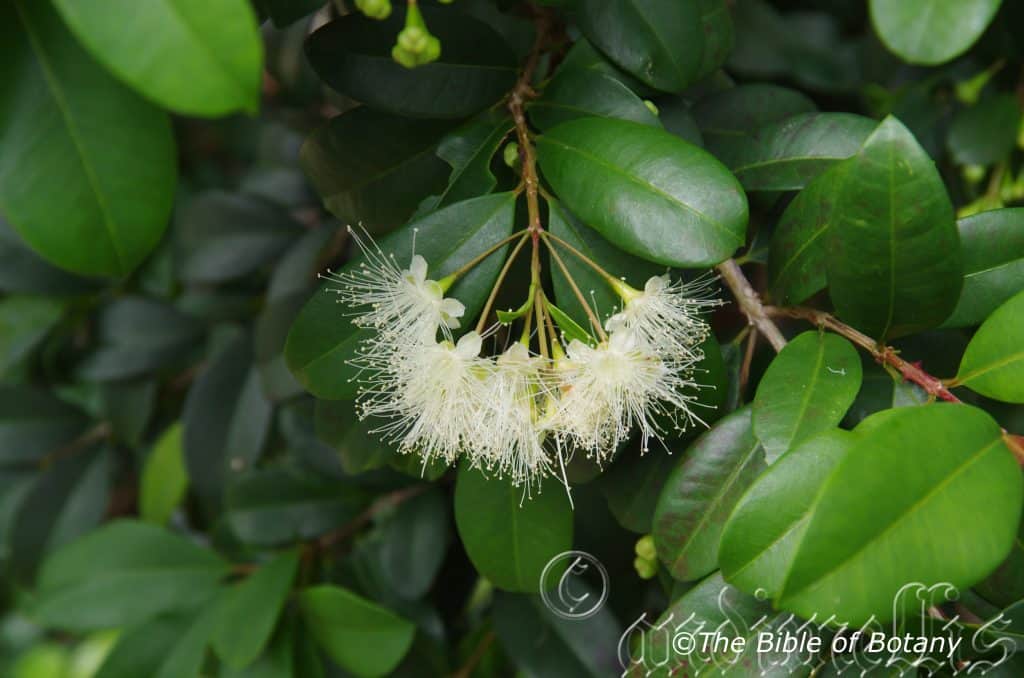
Author’s Garden The Pinnacles NSW

Author’s Garden The Pinnacles NSW

Author’s Garden The Pinnacles NSW

Author’s Garden The Pinnacles NSW

Author’s Garden The Pinnacles NSW
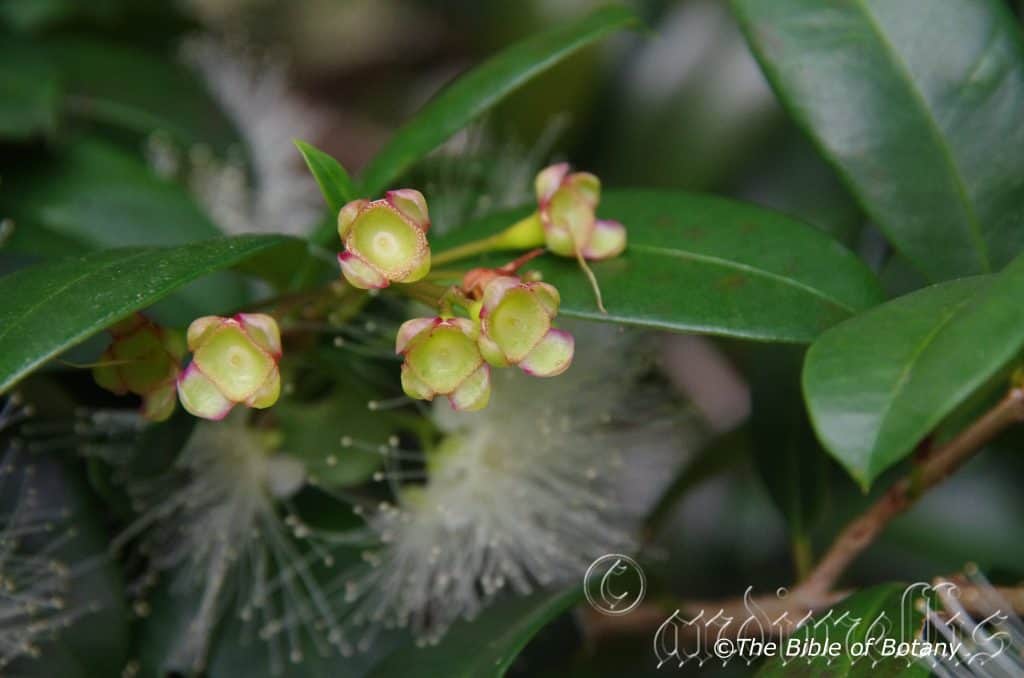
Author’s Garden The Pinnacles NSW
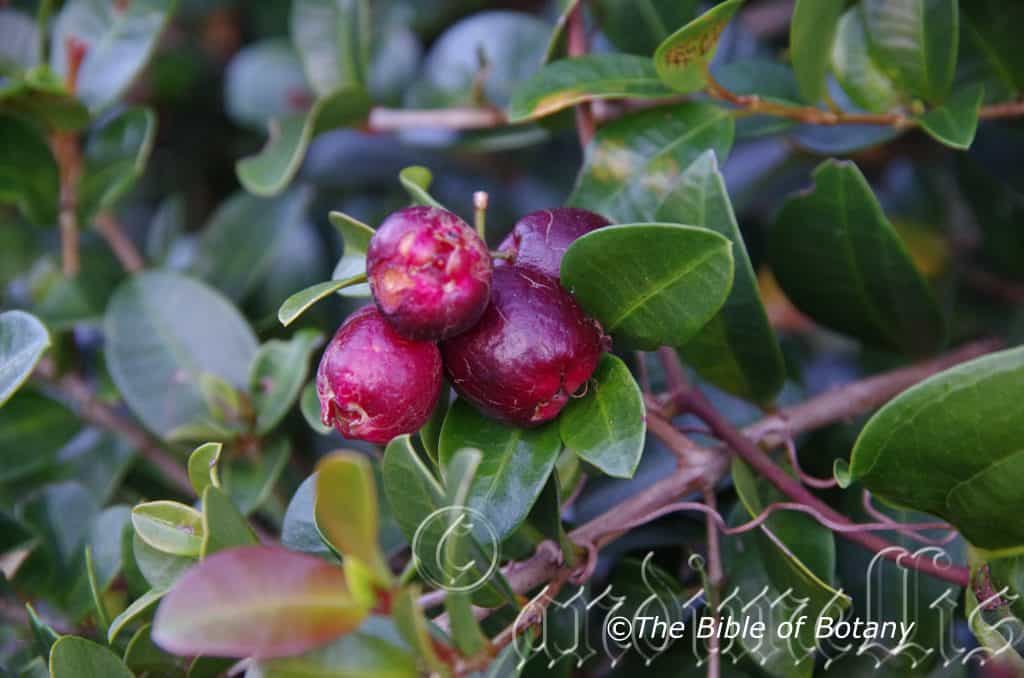
Look At Me Now Headland NSW

Author’s Garden The Pinnacles NSW

Metura elongatus Author’s Garden The Pinnacles NSW

Metura elongatus Author’s Garden The Pinnacles NSW

Author’s Garden The Pinnacles NSW

Mount Cootha Botanic Gardens Qld.
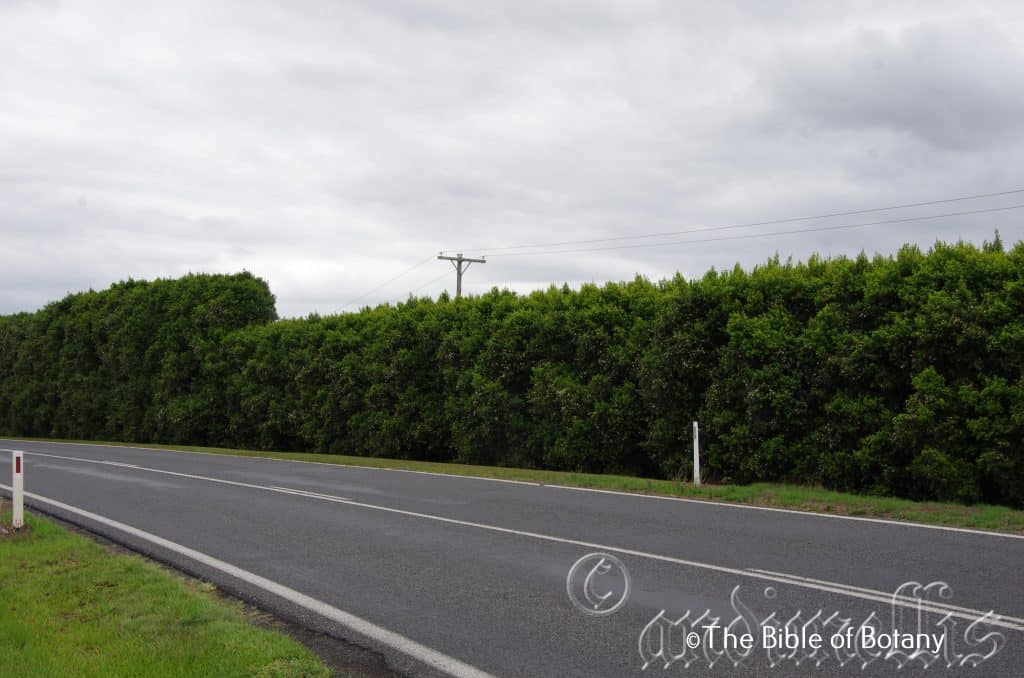
Grafton NSW
Syzygium australe
Coffs Harbour’s floral emblem
Classification:
Unranked: Eudicots
Class: Rosids
Order: Myrtales
Family: Myrtaceae
Subamily: Myrtoideae
Tribe: Syzygieae
Genus: From Súzugos, which is Ancient Greek or later Syzygia, which is Latin for a pair or yoke together. It refers to leaves, which are joined together in pairs.
Specie: From Terra Australis, which is Latin for land of the south. It refers to plants, which were first discovered from the land down under.
Sub specie:
Common Name: Bush Cherry.
In the Gumbaynggirr language it is known as Jijimam.
Distribution:
Syzygium australe is found south from the Daintree National Park in far north Queensland to Batemans Bay in southern coastal New South Wales. It is found on and east of the Great Dividing Range to the coast.
https://avh.ala.org.au/occurrences/search?taxa=Syzygium+australe#tab_mapView
Habitat Aspect Climate:
Syzygium australe prefer heavy shade to full sun. It grows adjacent to moist rainforests, in dry rainforests; moist Eucalyptus forests gallery forests, riparian zones and especially in littoral rainforests behind the frontal dunes. The altitude ranges from 5 meters ASL to 1100 meters ASL.
The temperatures range from minus 2 degree in August to 36 degrees in January.
The rainfalls range from lows of 900mm to 3200mm average per annum.
Soil Requirements:
Syzygium australe prefer to grow on pure sand through to medium clays. The soils are derived from decomposed brown and black basalts, better quality shale, sandstone, metamorphic rocks or accumulated peaty sands behind the frontal dunes. The soils pH. ranges from 5pH to 6pH. It does not tolerate water logged soils however trees in riparian zones may experience periodic flooding for short periods. Non saline soils to very saline soils are tolerated.
Height & Spread:
Wild Plants: 4m to 12m by 2.5m to 6m.
Characteristics:
The single or multi trunks of Syzygium australe are small, straight, pale grey, flaky and vertically patterned. The branchlets are pale grey tending to grass green with a purple tinge where the leaves are produced. The green sections are 4 angled or with short flaky wings which separate around the leaf nodes. The branchlets are glabrous.
The opposite, elliptical to ovate leaves of Syzygium australe measure 30mm to 100mm in length by 12mm to 30mm in width. The bases are cuneate to broad cuneate while the apexes are acuminate. The discolourous laminas are deep sea-green, semi glossy to glossy and glabrous on the upper lamina while the lower lamina is paler and duller. The leaf margins are entire while the laminas are flat and decurve towards the apex. The mid vein and main laterals are prominent on the lower lamina. Oil glands are numerous and scattered irregularly over the laminas. The petiole measures 3mm to 10mm in length.
Inflorescences of Syzygium australe are born on simple or compound umbels from the upper leaf axils or terminals. There are 3 to 7 flowers on an umbel which measures 20mm to 70mm in diameter. The grass-green peduncles, rachises and pedicels are glabrous. The peduncles measure 10mm to 22mm in length by 1mm in diameter while the rachises on the compound umbels measure 10mm to 20mm in length and the pedicels measure 1mm to 10mm in length.
The caducous bracts are grass-green. The pale green tinged red or purple cream calyx and the 4 obtuse, slightly dimorphic, divaricate calyx lobes are glabrous. The calyx tubes measure 4mm to 7mm in length by 3mm to 7mm in diameter while the longer lobes measure 2.5mm to 4mm in length and the shorter lobes measure 2mm to 3.5mm in length.
The 4 pale translucent, ovate sepals measure 1.5mm to 2mm in diameter. The 4 white ovate to orbicular, translucent petals are glabrous and densely covered in fine oil glands. They petals measure 4mm to 5mm in length by 3mm to 3.5mm in diameter.
The dimorphic, exserted filaments are free for their entire length. The filaments measure 10mm to 20mm in length. The filiform filaments are white and while the anthers are pale cream. The ovate, adnate anthers measure 0.6mm in length by 0.4mm to 0.6mm width.
The white style and stigma are glabrous while the ovary is green. The styles taper from the base to the slender stigma and measure 7mm to 24mm in length. The pistil always exceeds the length of the stamens. Syzygium australe honey scented flowers appear from September through to December.
The fruits of Syzygium australe are ovoidal berries. The berries are glabrous and measure 14mm to 25mm in length by 8mm to 17mm in diameter. The green berries turn creamy pink to deep pink, carmine or scarlet-red or maroon-red externally and white internally when ripe. The calyx lobes are persistent on the ripe fruit expand to 3mm to 4mm and decurve into the hypanthia. The pericarp is crisp similar to a soft apple. There is usually a single non polyembrionic seed per fruit. The spherical, fleshy seeds measure 6mm to 10mm in length by 6mm to 10mm in diameter.
Confusing Species:
Syzygium australis’s lateral veins are very close together. The young stems are square in cross section often with 4 distinct wings. The leaves are elliptical. The external pink, deep pink, carmine, scarlet-red or maroon-red fruits are white internally when ripe. The fruits are depressed globose berries that measure 9mm to 15mm in length by 15mm to 25mm in diameter. The seed is usually a single non polyembrionic, with a white pulp.
Syzygium crebrinerve’s lateral veins evenly spaced. The leaves are elliptical. The reddish-pink to red, obovoid to campanulate berries measure 12mm to 15mm in length by 15mm to 25mm in diameter. The fruits pulp is white. Trunk buttressed.
Syzygium oleosum’s lateral veins widely spaced. Leaves narrow elliptical. The bluish, purple or magenta, globose to ovoid berries measure 10mm to 25mm in diameter. The fruits pulp is white. The seed is usually a single non polyembrionic.
Syzygium paniculata’s lateral veins are evenly spaced and divide well before the margin. The leaves are elliptical. The purple to magenta fruits are depressed globose berries that measure 10mm to 15mm in length by 15mm to 25mm in diameter. The fruits pulp is pink. The seed is usually polyembrionic.
Wildlife:
Syzygium australe support a wide range of insects including many small beetles, native bees like Tetragonula carbonaria and small honey eaters when in flower. The fruits are consumed in large quantities by fruit eating birds, flying foxes and native marsupials.
The fruits have a crispy texture internally and a flavour which is reminiscent of a granny smith apple with a slight eucalyptus after taste. This is probably a very cleansing fruit for the Kidneys and bladder because of its high water content.
Cultivation:
Syzygium australe is a magnificent large shrub or small tree that should be incorporated with other rainforest specie or used as a fire retardant plant. It is ideal at the edge of a rain forest or deep in the centre of the rainforest in warm sub-tropical gardens to cool tropical gardens. It also makes great park tree offering quick growth, and good shade. In cultivation it will grow from 6 meters to 12 meters in height by 4 meters to 8 meters in diameter when grown as a tree in the open or taller and narrower if grown closer together as a rainforest tree. When it is grown as a multi stemmed shrub it is much smaller.
It can be trimmed regularly and respond well to either light tip pruning or harsh cut backs. This makes them ideal for hedges or topiarian.
It grows exceptionally well on all deeper soils where a deep layer of leaf litter keeps the soil cool and moisture at an even level. If these requirements are met it can cope with temperatures as low as minus 3 degrees and up to 44 degrees.
Add to the above, if it is given a little native organic fertilizer on a regular basis the plants respond with good flowering and fruit over a long period. Trees that we tested here showed an average of 17 degree cooler factor over the summer months compared to temperatures taken in the open over sand at The Pinnacles and 8 degrees cooler when compared to temperatures recorded in a dry Eucalyptus forest only 50 meters away. The trees remain green with the leaves feeling cold when touched even on the hottest days. The foliage can be maintained to the ground or trimmed to head height. the foliage is suitable for trapping embers and diverting fire gale winds away from infrastructures.
3 to 5 trees planted at 7 meter to 10 meter centers in a triangle pattern can make a superb display even on a medium size back yard. This is especially the case if it is mixed with other similar size small trees with different barks. Syzygium malaccense and Synoum glandulosum are two small trees which immediately come to mind. This can also be the start of a very formal Bar-B- Q area, fern or shade garden. This format also lends itself well to an informal shade garden. Planted out beneath with various ferns with the upper trunk and branches covered in Platycerium specie, Pyrrosia specie or Dendrobium specie creates a miniature rainforest setting with all the extras.
It often reaches its full potential in just 7 to 8 years and flowers from the fifth or sixth year from seed.
The trees branches are good for epiphytic ferns and orchids and if left to do its own thing will hold its branches right down to the ground.
As an orchard tree it shows potential in the tropics. The fruits have a good shelf life and refrigerate for at least a month. The fruits are ideal for jellies, jams and sauces and flavourings for deserts. When grown commercially it should be planted at 6 meter centers and pruned early to induce lateral growth. Lateral branches will produce smaller trees with a greater spread which makes the fruit easier to harvest. It is light feeders but require high volumes of water to keep the soil at even moisture level. This is critical for good fruit production and fruit size.
An opening into the conserve market is definitely available in growing this Syzygium mixed with other native fruit trees.
The trees are susceptible to Psyllid or pimple gall especially when grow in a monoculture or where neighbours use chemical or nonspecific controls. Psyllids can make a tree look terrible, even ghastly when the black sugar mould entirely covers the trees. Control is best achieved by supporting the natural enemies of the many varieties of Psyllids.
Psyllaephagus specie is small predatory wasps which feed exclusively on psyllids. The female adult wasp lays an egg into the psyllid nymph before the lerp becomes impenetrable to the wasp.
Other hunters of Psyllids include the beautiful Lacewing and ladybirds and their larvae also feed on the Psyllid nymphs. Birds, particularly swallows, have been observed flying around badly affected trees when adult Psyllids are numerous, and eat adult Psyllids. I also suspect that thorn bills and silver eyes to play a role in the control of most types of Psyllids as do the bell miners and noisy miner. Spiders which build their webs in trees account for a large number of adults and other small flying insects.
Under ideal conditions the trees will root from where branches touch the ground or sucker where the root has been damaged.
Propagation:
Seeds: The seeds of Syzygium australe can be removed easily from the fruits.
Sow freshly treated seeds directly into a seed raising mix, keeping them moist not wet. Do not over water as the seeds will rot off before germination takes place. Place the trays in a cool shaded area with 50mm shade cloth in the bush house. When the seedlings are 20 to 25 mm tall, prick them out and plant them into 50mm native tubes using a good organic mix.
As the seedlings roots reach the bottom of the tubes plant them out into their permanent position. Do not delay.
Fertilize using Seaweed, fish emulsion or organic chicken pellets soaked in water and apply the liquid on an alternate basis. Fertilize every 2 months until the plants are well established then on an annual basis in September or March to maintain better health, vitality and flowering.
Further Comments from Readers:
“Hi reader, it seems you use The Bible of Botany a lot. That’s great as we have great pleasure in bringing it to you! It’s a little awkward for us to ask, but our first aim is to purchase land approximately 1,600 hectares to link several parcels of N.P. into one at The Pinnacles NSW Australia, but we need your help. We’re not salespeople. We’re amateur botanists who have dedicated over 30 years to saving the environment in a practical way. We depend on donations to reach our goal. If you donate just $5, the price of your coffee this Sunday, We can help to keep the planet alive in a real way and continue to bring you regular updates and features on Australian plants all in one Botanical Bible. Any support is greatly appreciated. Thank you.”
In the spirit of reconciliation we acknowledge the Bundjalung, Gumbaynggirr and Yaegl and all aboriginal nations throughout Australia and their connections to land, sea and community. We pay our respect to their Elders past, present and future for the pleasures we have gained.
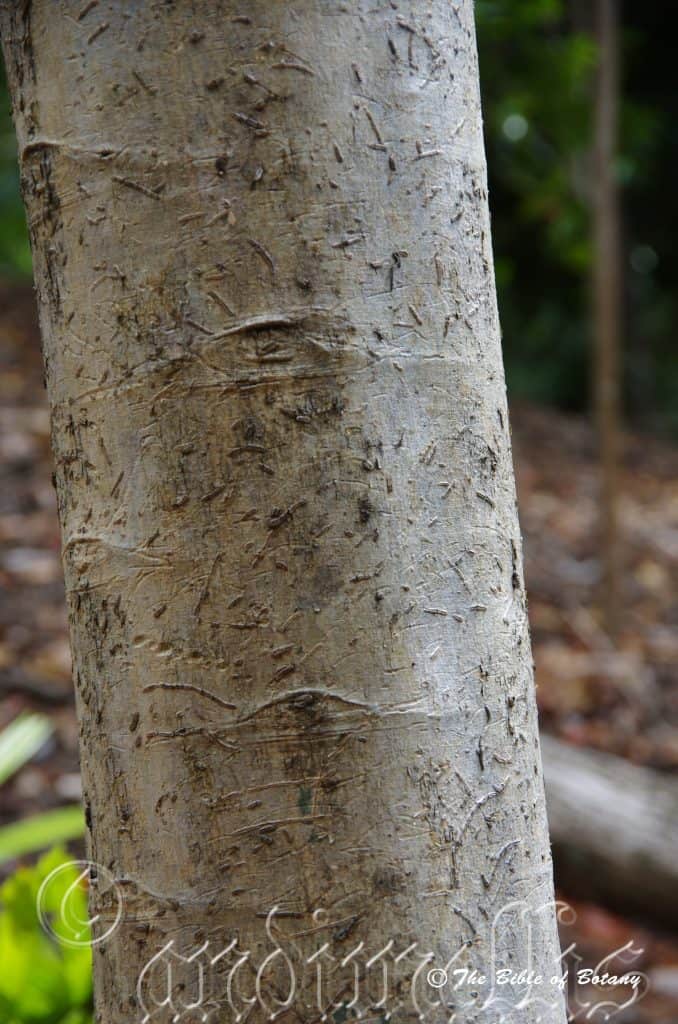
Mount Cootha Botanical Gardens Qld.

Mount Cootha Botanical Gardens Qld.
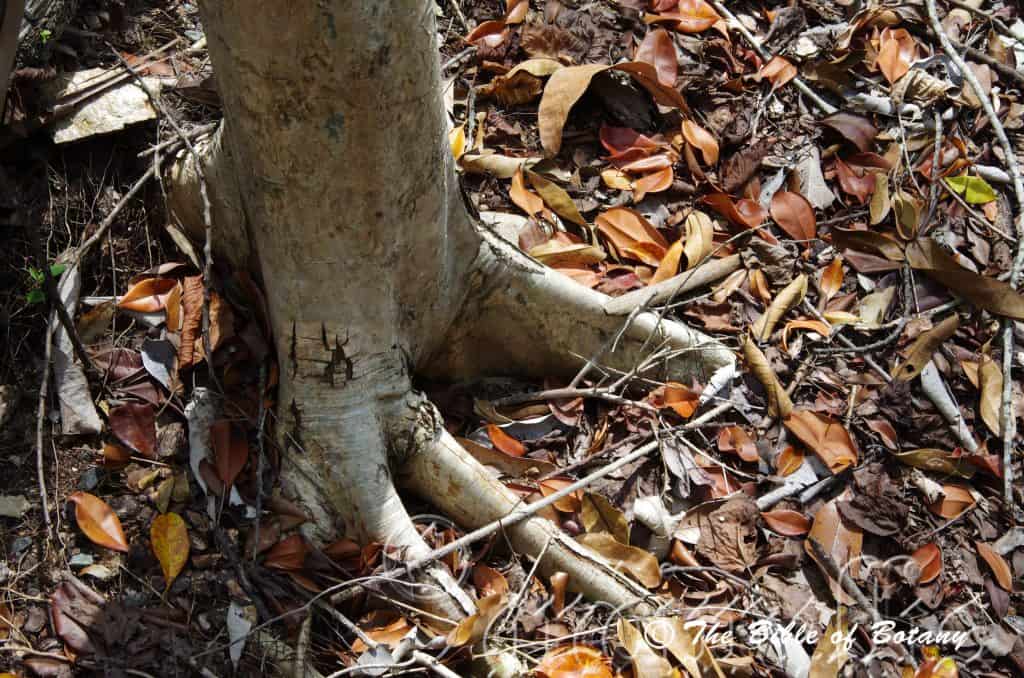
Mount Cootha Botanical Gardens Qld.

Mount Cootha Botanical Gardens Qld.
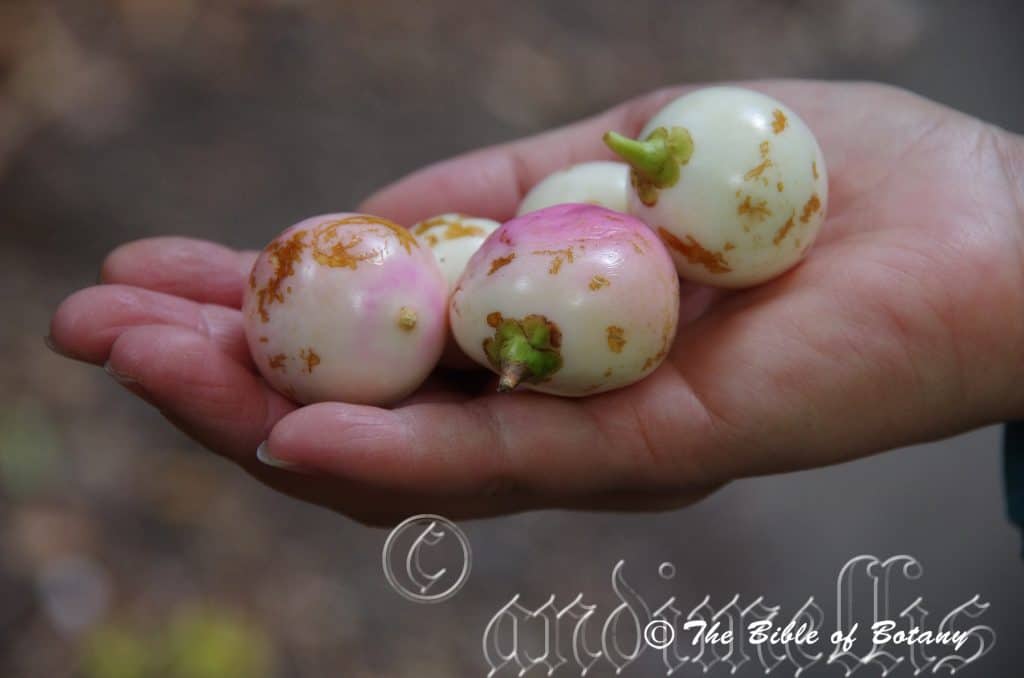
Mount Cootha Botanical Gardens Qld.
Syzygium buettnerianum
Classification:
Unranked: Eudicots
Class: Rosids
Order: Myrtales
Family: Myrtaceae
Subamily: Myrtoideae
Tribe: Syzygieae
Genus: From Súzugos, which is Ancient Greek or Syzygia, which is Latin for a pair or yoke together. It refers to leaves, which are joined together in pairs.
Specie: Is named in honour of For Professor Oscar. A. R. Büttner; 1858–1927, who was a German botanist and head of the research station in Togo from 1890–1891, later professor in Berlin.
Sub specie:
Common Name: New Guinea Satin Ash.
Distribution:
Syzygium buettnerianum is found south from the larger Torres Straight Islands to Yarraden west of Cape Melville in far north Queensland.
https://avh.ala.org.au/occurrences/search?taxa=Syzygium+buettnerianum#tab_mapView
Habitat Aspect Climate:
Syzygium buettnerianum prefer heavy shade to full sun. It grows adjacent to well-developed rainforests dry rainforests, gallery forests and littoral rainforests close to the beach at low altitudes. The altitude ranges from 5 meters ASL to 150meters ASL.
The temperatures range from minus 1 degree in August to 36 degrees in January.
The rainfalls range from lows of 1500mm to 3200mm average per annum.
Soil Requirements:
Syzygium buettnerianum prefers light sandy soils to gritty medium clays. The soils are derived from decomposed brown basalts, black basalts, better quality metamorphic rocks or sandstone. The soils pH ranges from 5pH to 7pH. It does not tolerate water logged soils. Non saline soils to moderately saline soils are tolerated.
Height & Spread:
Wild Plants: 20m to 50m by 12m to 20m
Characteristics:
Syzygium buettnerianum grows as a tall straight large tree with mid red-brown with pink patches and has flaky or papery sections on older trees. The boles grow from 1 meter in diameter at breast height but usually around 350mm in Australian trees. The bases of the trunks are strongly buttressed. The branchlets are pale grey to grey-brown and only becoming green near the apex where the new leaves are growing. The branchlets are glabrous.
The opposite, disjunct, ovate to elliptical leaves of Syzygium buettnerianum measure 70mm to 140mm in length by 30mm to 65mm in width. The bases are cuneate while the apexes are acuminate. The discolourous laminas are deep sea-green, dull and glabrous on the upper lamina while the lower lamina is paler. The leaf margins are entire while the lamina is recurved and strongly decurved near the apex. The mid veins are prominent on the lower lamina while the mid veins are depressed and clearly visible on the upper lamina. The lateral veins are finely prominent on the lower lamina and visible from the upper lamina. The petiole measures 4.5mm to 8mm in length.
Inflorescences of Syzygium buettnerianum are born on a panicle from the terminals or special terminal shoots. There are 160 to 280 flowers on an umbel which measures 100mm to 170mm in diameter. The grey, grey-brown to brown peduncles, rachises, pedunculates and pedicels are scaly to rough. The peduncles measure 50mm to 90mm in length by 4mm to 8mm in diameter, the rachises on the panicles measure 50mm to 90mm in length while the pedunculates measure 6mm to 10mm in length and the pedicels measure 1mm to 6mm in length.
The caducous bracts are grass-green. The pale creamy green tinged hypanthium tapers to the cream peduncle. The hypanthia measure 3mm to 5mm in length by 3mm to 3.5mm in diameter. The hypanthia apexes have undulating lobes which are glabrous, deep carmine-pink and measure 0.2mm in length. The petals are variable from deltoid to spathulate or orbicular and measure 1.5mm to 2.5mm in length. The white orbicular petals are glabrous and densely covered in fine oil glands.
The 50 exserted filaments are free for their entire length and form two dimorphic rings around the outer edge of the hypanthia inside the lobe. The outer filaments measure 5mm to 7mm in length while the inner filaments measure 2mm to 3.5mm in length. The filaments taper from the bases to the apexes are deep carmine-pink while the adnately fixed anthers are pale cream. The ovate anthers measure 0.6mm in length by 0.4mm to 0.6mm width.
The white style and stigma are glabrous while the ovary is lime-green. The styles taper from the base to the slender stigma and measure 3mm to 4.5mm in length. The pistil is centrally positioned in the lime-green disc which is surrounded by the elevated white hypanthia. Syzygium buettnerianum flowers appear from October through to December.
The fruits of Syzygium buettnerianum are depressed globular to sub globose berries. The berries are glabrous and measure 15mm to 20mm in length by 16mm to 20mm in diameter. The green berries turn white with a rose pink tinge to mid rose pink externally and pale creamy or white internally when ripe. The calyx lobes are persistent on the ripe fruit. The pericarp is crisp similar to a soft apple. The single depressed fleshy seed is spherical and measure 7mm to 15mm in length by 10mm to 15mm in diameter.
Wildlife:
Syzygium buettnerianum support native bees and nocturnal nectar eating mammals like the eastern sugar glider (Petaurus breviceps).
The fruits are juicy yet rather tarty to eat.
Cultivation:
Syzygium buettnerianum is a magnificent large tree that should be grown in association with other rainforest specie. It is ideal at the edge of a rain forest or deep in the center of the rainforest. They also make great park trees offering quick growth, and good shade. In cultivation they will grow from 12 meters to 18 meters in height by 10 meters to 15 meters in diameter when grown in the open or taller and narrower if grown closer together as a rainforest tree.
It grows exceptionally well on lighter soils where deep leaf litter keeps the soil cool and moisture at an even level. If these requirements are met they can cope with temperatures as low as 2 degrees and up to 36 degrees. It is moderately drought resistant once established in their climatic zones.
Add to the above, if it is given an adequate supply of water and a little native fertilizer on a regular basis the plants should respond with good flowering and fruit over a long period.
This is a beautiful trunked tree that has its place amongst other park trees with straight boles where the trunks are being featured. I would also be very tempted to use it as a bonsai tree as most Syzygium specie make good bonsai specimens.
Propagation:
Seeds: The seeds of Syzygium buettnerianum can be removed easily from the fruits.
Sow freshly treated seeds directly into a seed raising mix, keeping them moist not wet. Do not over water as the seeds will rot off before germination takes place. Place the trays in a cool shaded area with 50mm shade cloth in the bush house. When the seedlings are 20 to 25 mm tall, prick them out and plant them into 50mm native tubes using a good organic mix.
As the seedlings roots reach the bottom of the tubes plant them out into their permanent position. Do not delay.
The soils pH ranges from 5pH to 6pH. It does not tolerant of water logged soils however even moisture is important. Non saline soils to moderately saline soils are tolerated.
Fertilize using Seaweed, fish emulsion or organic chicken pellets soaked in water and apply the liquid on an alternate basis. Fertilize every 2 months until the plants are well established then on an annual basis in September or March to maintain health, vigour and better flowering.
Further Comments from Readers:
“Hi reader, it seems you use The Bible of Botany a lot. That’s great as we have great pleasure in bringing it to you! It’s a little awkward for us to ask, but our first aim is to purchase land approximately 1,600 hectares to link several parcels of N.P. into one at The Pinnacles NSW Australia, but we need your help. We’re not salespeople. We’re amateur botanists who have dedicated over 30 years to saving the environment in a practical way. We depend on donations to reach our goal. If you donate just $5, the price of your coffee this Sunday, We can help to keep the planet alive in a real way and continue to bring you regular updates and features on Australian plants all in one Botanical Bible. Any support is greatly appreciated. Thank you.”
In the spirit of reconciliation we acknowledge the Bundjalung, Gumbaynggirr and Yaegl and all aboriginal nations throughout Australia and their connections to land, sea and community. We pay our respect to their Elders past, present and future for the pleasures we have gained.

Mount Cootha Botanical Gardens Qld.
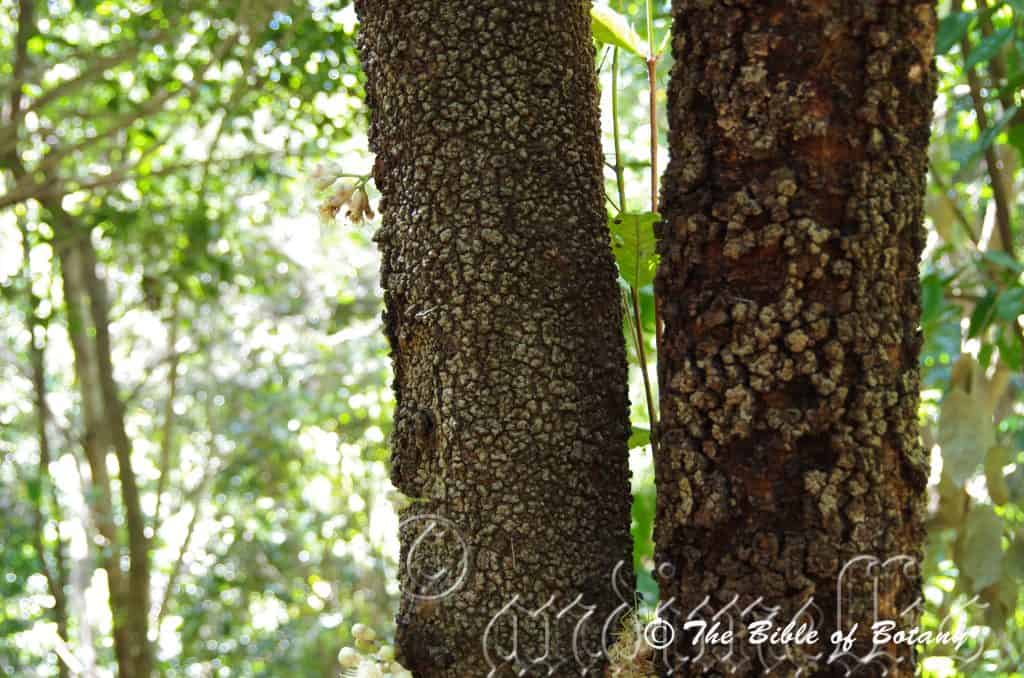
Mount Cootha Botanical Gardens Qld.
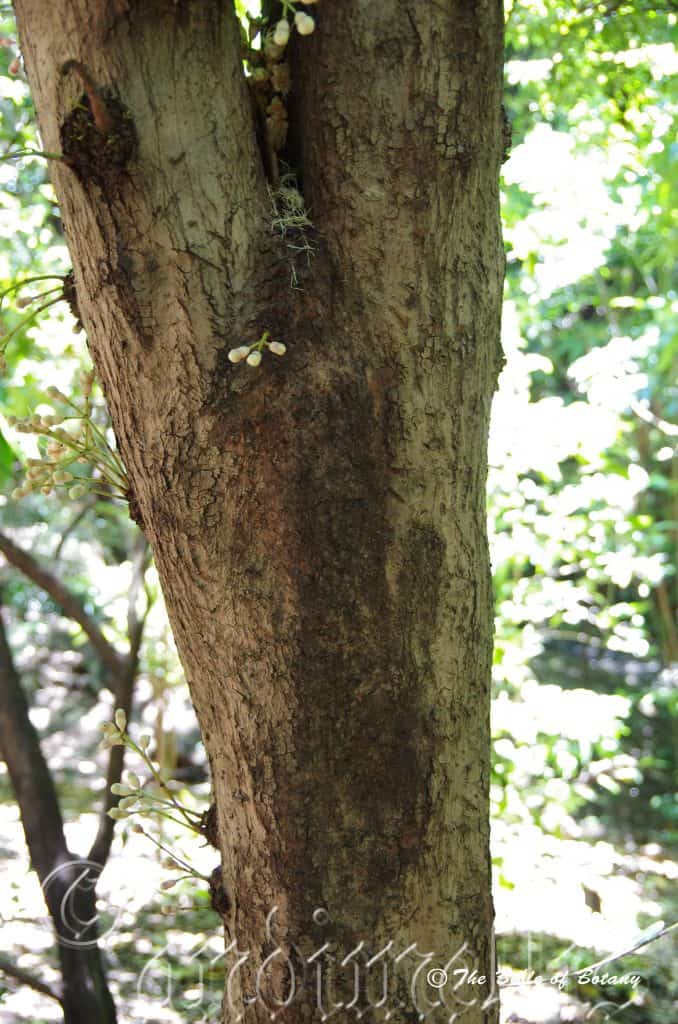
Mount Cootha Botanical Gardens Qld.

Mount Cootha Botanical Gardens Qld.

Mount Cootha Botanical Gardens Qld.
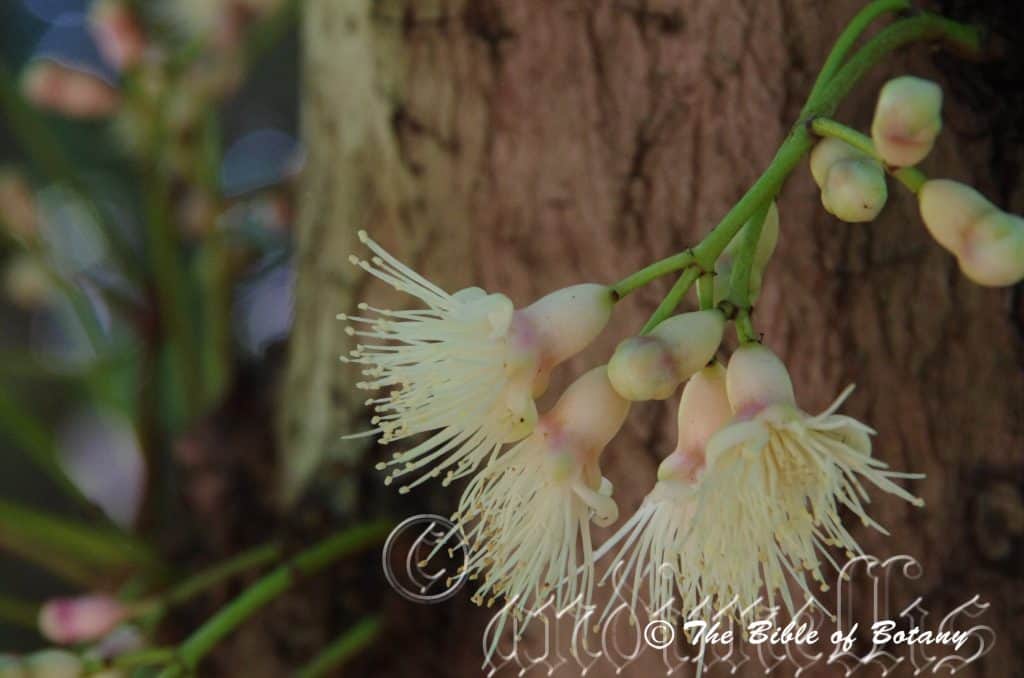
Mount Cootha Botanical Gardens Qld.
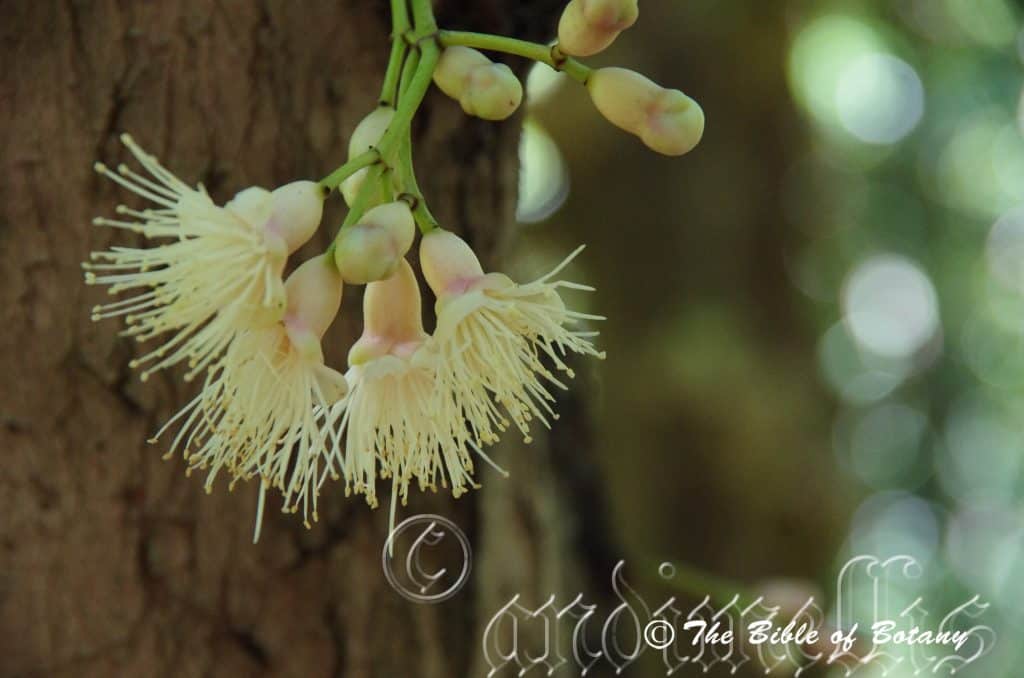
Mount Cootha Botanical Gardens Qld.
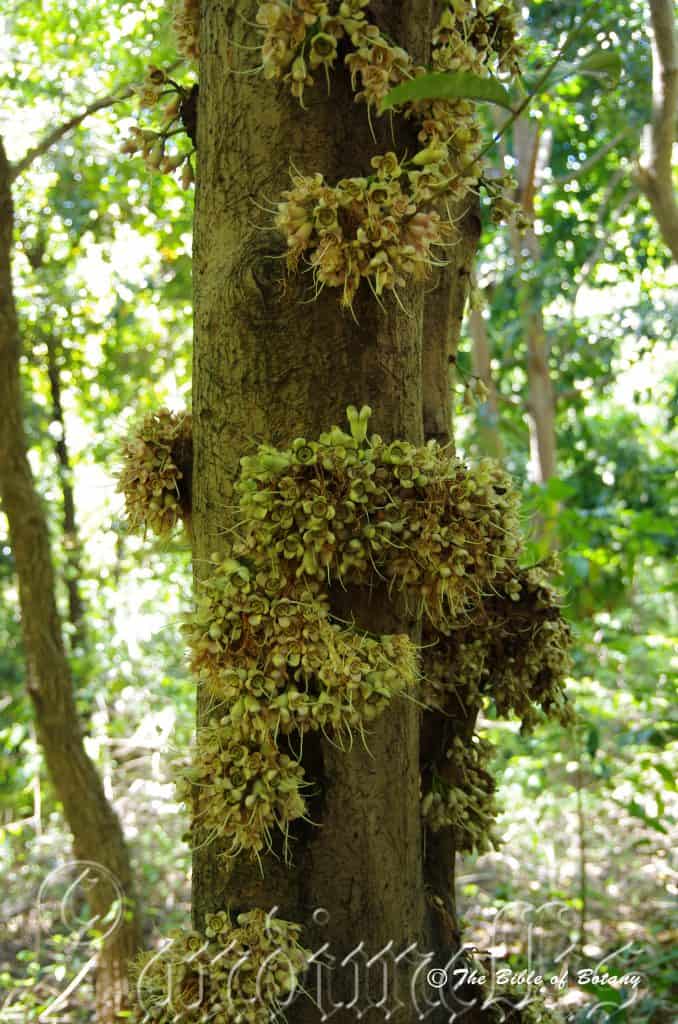
Mount Cootha Botanical Gardens Qld.
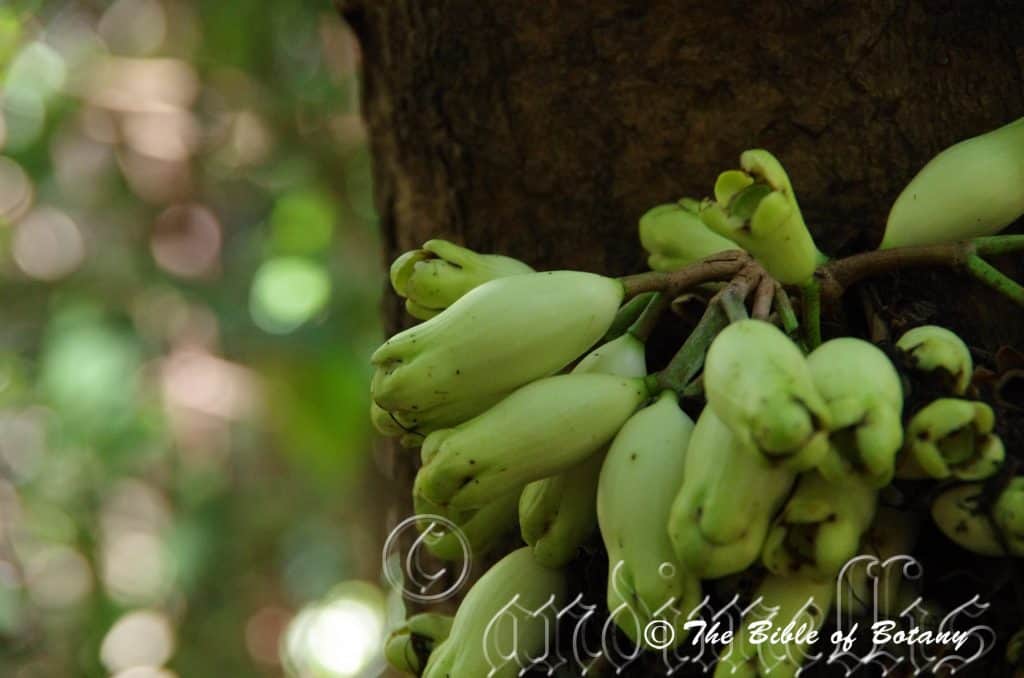
Mount Cootha Botanical Gardens Qld.
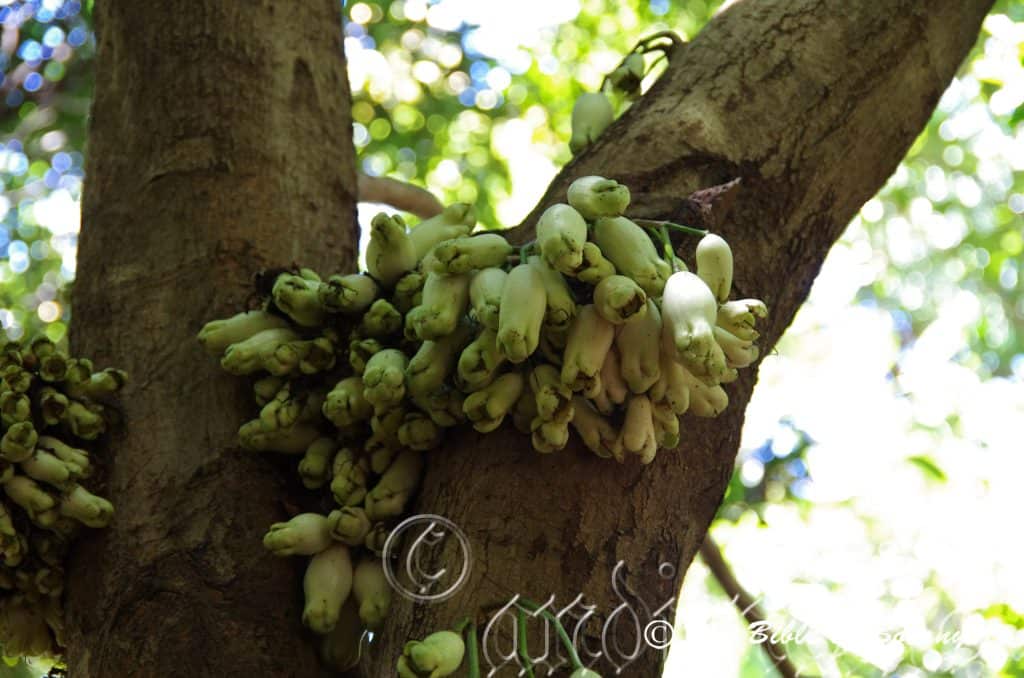
Mount Cootha Botanical Gardens Qld.
Syzygium cormiflorum
Classification:
Unranked: Eudicots
Class: Rosids
Order: Myrtales
Family: Myrtaceae
Subamily: Myrtoideae
Tribe: Syzygieae
Genus: From Súzugos, which is Ancient Greek or Syzygia, which is Latin for a pair or yoke together. It refers to leaves, which are joined together in pairs.
Specie: From Kormós, which is Ancient Greek for to shear off and Fl?ris, which is Latin for a flower or Fl?s, which is the Roman goddess for spring and flowers. It refers to tree trunks, which are bear of branches and are covered in bulbil like swellings where the flowers appear from.
Sub specie:
Common Name: Bumpy Satin Ash or White Apple.
Distribution:
Syzygium cormiflorum is found in a few disjunct localities mainly east of the Great Dividing Range from the Iron Range National Park to Crystal Nation Park west of Townsville in far north Queensland.
https://avh.ala.org.au/occurrences/search?taxa=Syzygium+cormiflorum#tab_mapView
Habitat Aspect Climate:
Syzygium cormiflorum prefers dense shade to full sun. It grows adjacent to moist rainforests, in dry rainforests, moist Eucalyptus forests gallery forests or riparian zones. The altitude ranges from 5 meters ASL to 1100 meters ASL.
The temperatures range from minus 1 degree in August to 36 degrees in January.
The rainfalls range from lows of 900mm to 3200mm average per annum.
Soil Requirements:
Syzygium cormiflorum prefers better quality sandy loams to medium clays. The soils are derived from decomposed brown basalts, black basalts or heavier sandstones. The soils pH ranges from 5pH to 6.5pH. It does not tolerant of water logged soils however even moisture is important. Non saline soils to moderately saline soils are tolerated.
Height & Spread:
Wild Plants: 20m to 30m by 10m to 12m.
Characteristics:
Syzygium cormiflorum grows as a medium rainforest tree with a short, straight, pale grey or pale brown with pale brown or pale grey blotched and fine longitudinal fissured trunk. The bark is hard and bumpy especially on the cauliferous forms and less so on the ramiflorously forms. The branches are pale grey and are only green where there are flushes of new leaves. The branchlets are glabrous.
The opposite, ovate, oblong-ovate or 0vate-elliptical leaves of Syzygium cormiflorum measure 60mm to 210mm in length by 25mm to 115mm in width. The bases are broadly cuneate to cuneate-rounded while the apex is asymmetrical, twisted 90 degrees and obtuse with an acuminate tip. The concolourous laminas are deep sea-green, semi glossy and glabrous. The new growth is bright pale pink to bright deep pink to deep reddish-pink. The leaf margins are entire, flat to recurve slightly from the midvein to the margins. The mid vein and main laterals are prominent on the upper laminas while the laminas are convex between the 6 to 12 pairs of lateral veins. The petioles are grooved on the upper lamina and measure 5mm to 10mm in length.
Inflorescences of Syzygium cormiflorum are born on panicles cauliforously or ramiflorously. The pale brown peduncles and mid green rachises, pedicellate and pedicels are glabrous. The peduncles measure 5mm to 13mm in length, the rachises measure 10mm to 90mm in length while the pedicellates measure 10mm to 30mm and the pedicels measure 5mm to 10mm in length. The pale creamy green with pink flushes calyxes and pale creamy green calyx lobes are erect and glabrous. The calyx tubes measure 7mm to 13mm in length by 9mm to 16mm in diameter across the hypanthia. The 4 orbicular calyx lobes are dimorphic in size, strongly concave and measure 5mm to 11mm in length. The 4 white petals are orbicular, densely covered in fine oil dots and measure 8mm to 15mm in length.
The 120 to 150 exserted filaments are free for their entire length and form two dimorphic rings around the outer edge of the hypanthia inside the lobe. The outer filaments measure 15mm to 30mm in length while the inner filaments measure 12mm to 22mm in length. The filaments taper sharply adjacent to the apexes are pure white while the dorsifixed anthers are cream to pale creamy yellow. The ovate anthers measure 1.1mm to 2.2mm in length by 0.6mm to 1.4mm width.
The white style and stigma are glabrous while the ovary is green. The pistil measures 18mm to 35mm in length and is longer than the stamens.
Syzygium cormiflorum flowers appear from September through to November but flowering has been recorded from late March particularly in the north and in favourable seasons.
The fruits of Syzygium cormiflorum are globose to obovoidal berries. The large berries are glabrous and measure 35mm to 65mm in length by 30mm to 60mm in diameter. The pale green capsules turn white externally and white internally when ripe. The calyx lobes are persistent on the ripe fruit. The single pale brown seeds are irregularly rounded, fleshy and are surrounded by a succulent pericarp.
Wildlife:
Syzygium cormiflorum supports native colony bees like Tetragonula carbonaria, many different native insects, all honey eating birds and mammals within its zone. It produces copious quantities of nectar. The flowers are also eaten by Cassowaries, Casuarius casuarius and flying foxes.
The fruits are eaten by fruitigrove birds including the Cassowary, Casuarius casuarius and mammals like bats including the grey headed Flying fox, Pteropus poliocephalus, possums like the common brush tail possum Trichosurus vulpecula, native rats like the white tail rat Uromys caudimaculatus, mice and tree kangaroo Dendrolagus lumholtzi.
Cultivation:
Syzygium cormiflorum is a magnificent small tree that should be grown in association with other rainforest specie. It is ideal at the edge of a rain forest or deep in the center of the rainforest. They also make great park trees offering quick growth in tropical, sub-tropical and warm temperate gardens. In cultivation they will grow much smaller than their wild cousins growing from 8 meters to 12 meters in height by 3 meters to 4 meters in diameter when grown in the open on average soils or taller if grown closer together as a rainforest tree.
It is relative slower growers in the open and may take 10 to 12 years to flower in cultivation and a further 4 to 6 years to give any sought of real display.
They grow better on lighter better quality soils that have been enriched with deep leaf litter and compost. This helps to keep the soil cool and moisture at an even level. If these requirements are met they can cope with temperatures as low as minus 3 degrees and up to 36 degrees. It is moderately drought resistant but prefer moist soils of optimum health and vigour.
It is great where a dwarf rainforest garden is required and can be grown amongst other dwarf rainforest trees and shrubs. Here they can be planted in small groups of 2 or 3 or as a standalone plant to create a lush look with other broad leaf plants. If it is surrounded by shorter plants with fine or large foliages or terrestrial ferns that are deep green or pale green then a year round contrast can be created with a strong accent in the center of the bed. Deep red or orange flowers will also create that dominate affect at the center giving height and strength to the bed especially when it is in flower or fruit. Make sure the trunk is exposed or the flowers and fruit will be lost amongst the foliage of the shrubs. Taller plants will also cause the plants to grow taller which will defeat the purpose of having them as the small rainforest feature tree.
Because of their slow growth and hardiness they would be ideal for bonsai collectors who are after something different with bold foliages.
Propagation:
Seeds: The seeds of Syzygium cormiflorum can be removed easily from the fruits.
Sow fresh seeds directly into a deep seed raising mix, keeping them moist not wet. Do not over water as the seeds will rot off before germination takes place. Place the trays in a cool shaded area with 50mm shade cloth in the bush house. When the seedlings are 50mm to 65mm tall, prick them out and plant them into 50mm native tubes using a good organic mix. Alternatively the seeds can be sown directly into the 50mm native tubes.
As the seedlings roots reach the bottom of the tubes plant them out into their permanent position. Do not delay.
Fertilize using Seaweed, fish emulsion or organic chicken pellets soaked in water and apply the liquid on an alternate basis. Fertilize every 2 months until the plants are well established then on an annual basis in September or March to maintain better health, vitality and flowering
Further Comments from Readers:
“Hi reader, it seems you use The Bible of Botany a lot. That’s great as we have great pleasure in bringing it to you! It’s a little awkward for us to ask, but our first aim is to purchase land approximately 1,600 hectares to link several parcels of N.P. into one at The Pinnacles NSW Australia, but we need your help. We’re not salespeople. We’re amateur botanists who have dedicated over 30 years to saving the environment in a practical way. We depend on donations to reach our goal. If you donate just $5, the price of your coffee this Sunday, We can help to keep the planet alive in a real way and continue to bring you regular updates and features on Australian plants all in one Botanical Bible. Any support is greatly appreciated. Thank you.”
In the spirit of reconciliation we acknowledge the Bundjalung, Gumbaynggirr and Yaegl and all aboriginal nations throughout Australia and their connections to land, sea and community. We pay our respect to their Elders past, present and future for the pleasures we have gained.
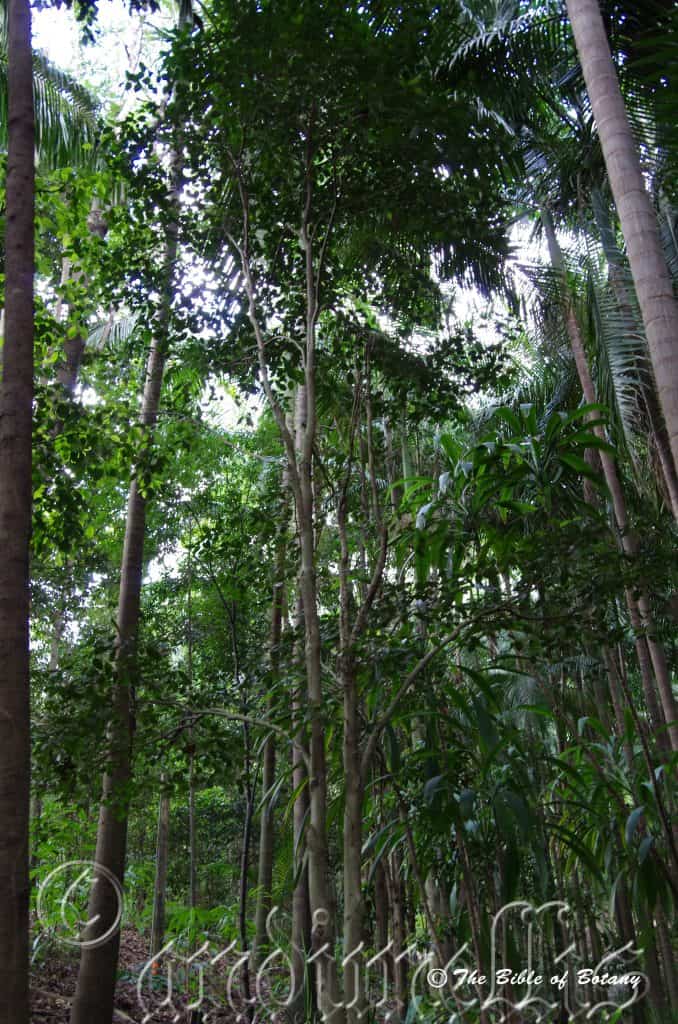
Mount Cootha Botanical Gardens Qld.
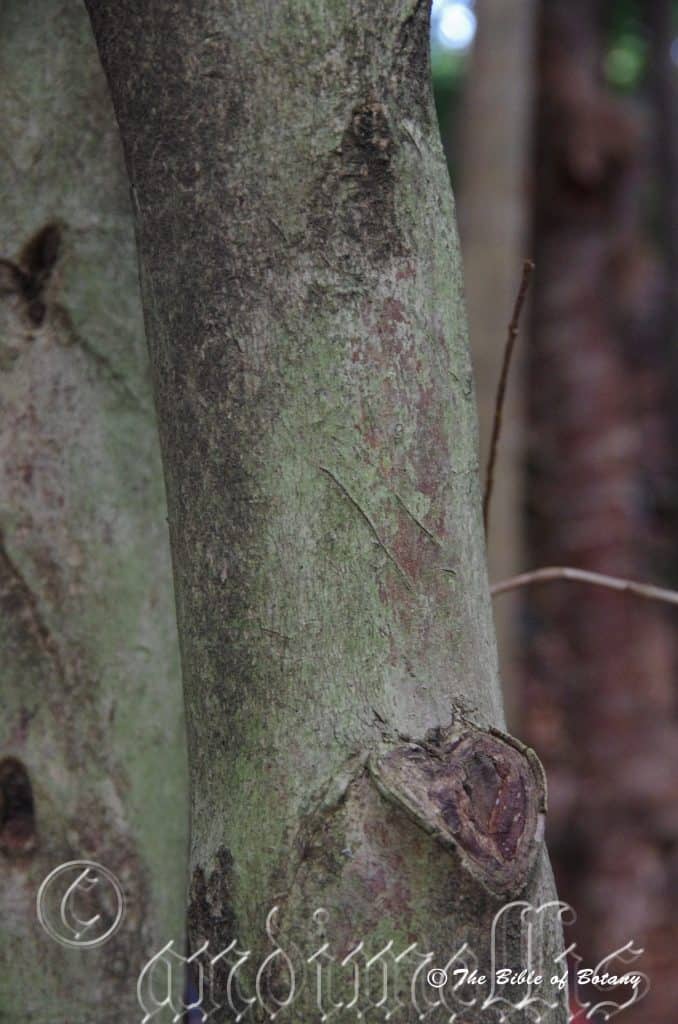
Mount Cootha Botanical Gardens Qld.

Seven Hills Qld.

Mount Cootha Botanical Gardens Qld.
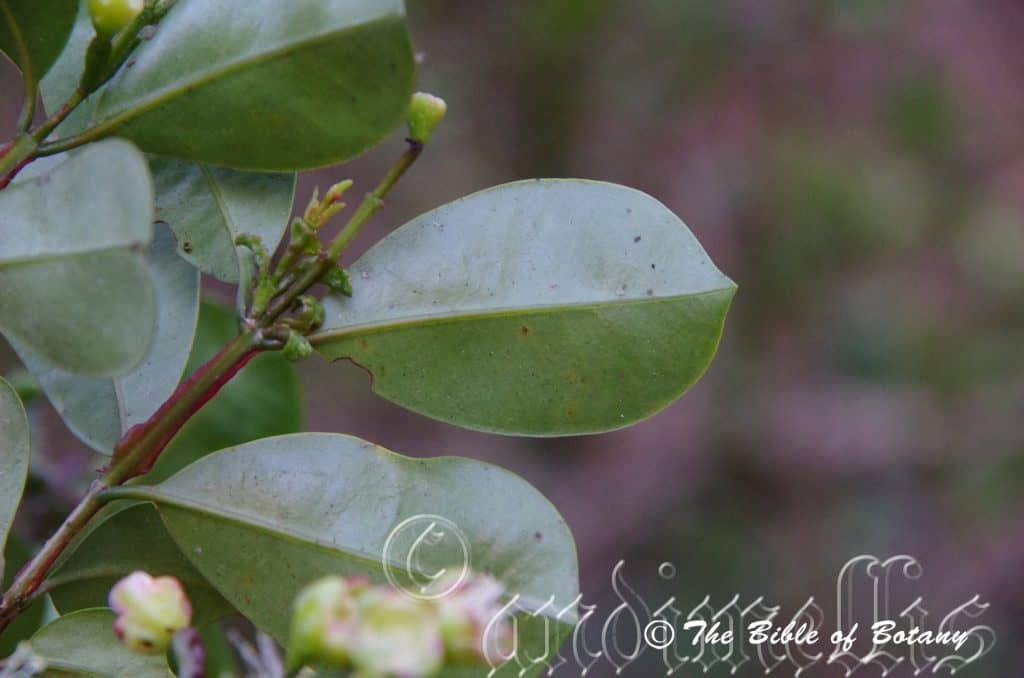
Seven Hills Qld.

Mount Cootha Botanical Gardens Qld.
Syzygium corynanthum
Classification:
Unranked: Eudicots
Class: Rosids
Order: Myrtales
Family: Myrtaceae
Subamily: Myrtoideae
Tribe: Syzygieae
Genus: From Súzugos, which is Ancient Greek or Syzygia, which is Latin for a pair or yoke together. It refers to leaves, which are joined together in pairs.
Specie: From Koryn, which is Greek for a club and ántha/ánthos, which are Ancient Greek for the male reproductive organ in a flower or the flower. It refers to the shape of the flower buds in some species.
Sub specie:
Common Name: Bumpy Satin Ash or White Apple.
Distribution:
Syzygium corynanthum is found in several scattered populations mainly on and east of the Great Dividing Range from the Iron Range National Park to the Macpherson Ranges National Park in Queensland with the exception of central Queensland where it is absent. In New South Wales it is found south to the Comboyne River.
https://avh.ala.org.au/occurrences/search?taxa=Syzygium+corynanthum#tab_mapView
Habitat Aspect Climate:
Syzygium corynanthum prefers dense shade to full sun. It grows adjacent to moist well developed rainforests verging on moist Eucalyptus forests, moist gallery forests or riparian zones within these forests. It is found growing at higher altitudes in the north and generally lower altitudes in the southern limits of its range. The altitude ranges from 400 meters ASL to 1100 meters ASL.
The temperatures range from minus 2 degree in August to 36 degrees in January.
The rainfalls range from lows of 900mm to 3200mm average per annum.
Soil Requirements:
Syzygium corynanthum prefers better quality sandy loams to medium clays. The soils are derived from decomposed brown basalts, black basalts or heavier sandstones. The soils pH ranges from 5pH to 6.5pH. It does not tolerant of water logged soils however even moisture is important. Non saline soils to moderately saline soils are tolerated.
Height & Spread:
Wild Plants: 20m to 30m by 10m to 12m.
Characteristics:
Syzygium corynanthum grows as a medium rainforest tree with a straight, pale brown with pale pinkish-brown and pinkish-grey blotches and fine irregular tessellated patches trunk. The bark is hard and bumpy especially once it starts flowering as it is somewhat ramiflorously in some plants. The base of the trunk is slightly to moderately flange. The branches are pale grey. The branchlets are mid green glabrous, square to square-terete in cross section and slightly winged.
The opposite, ovate, oblong-ovate or ovate-elliptical leaves of Syzygium corynanthum measure 40mm to 120mm in length by 25mm to 55mm in width. The petioles are grooved on the upper surface and measure 4mm to 8mm in length. The bases are broadly cuneate to shortly cuneate-attenuate while the apexes are acuminate. The discolourous laminas are deep sea-green, semi glossy and glabrous on the upper laminas while the lower laminas are much paler. The glossy new growth is bright auburn to tan. The laminas recurve upwards from the mid vein to the margins and decurve downwards close to the apex.
The leaf margins are entire. The mid vein is strongly prominent at the base and becomes slightly prominent at the apex while the 46 to 52 lateral veins are slightly prominent at the mid vein and become very faintly prominent near the margins. The mid vein is depressed and flattened on the upper surface while the lateral veins are at 80 degrees to 90 degrees to the mid vein.
The inflorescences are born on panicles in the leaf axils or at times tending to slightly ramiflorously. The pale yellow-brown to yellowish-green peduncles and rachises and pedicels are glabrous. The pedicels measure 1mm to 2mm in length. The caducous bracts are absent prior to anthesis. The hypanthium measures 5mm to 12mm in length by 3.5mm to 7mm diameter across the hypanthia. The 5 orbicular lobes are dimorphic, slightly concave and measure 1.5mm to 3mm in length while the margins are usually separating from near the top of the calyx at anthesis. The 5 white orbicular petals are densely covered in 50 or more, fine oil dots and measure 4mm to 6mm in length.
The 50 to 60 exserted filaments are free for their entire length and form two dimorphic rings around the outer edge of the hypanthia. The longer outer staminal filaments measure 4mm to 15 mm in length. The white filaments taper sharply below the cream to pale pastel anthers. The dorsifixed anthers measure 0.6mm to 1mm in length by 0.4mm to 0.7mm in width. There is a prominent terminal gland, on the back of the anther within the emarginate apex.
The white style and stigma are glabrous while the ovary is green. The pistil measures 8mm to 20mm in length and is always longer than the stamens. The ovules are in two distinct rows within each locule with 12 to15 ovules in each locule. Syzygium corynanthum flowers appear from April through to July.
The fruits of Syzygium corynanthum are pyriform berries. The large berries are glabrous and measure 11mm to 18mm in length by 12mm to 20mm in diameter. The calyx lobes are persistent in the strongly depressed apexes. The green berries turn deep red to deep carmine-red externally and white internally when ripe. The succulent pericarp is white. The solitary mid brown seed measures 6mm to 8mm in diameter.
Wildlife:
Syzygium corynanthum supports native bees, native insects, all honey eating birds and mammals within its zone. It produces copious quantities of nectar. The flowers are also eaten by flying foxes including the little flying fox, Pteropus scapulatus.
The fruits are eaten by fruitigrove birds including the blue face honey eater, Entomyzon cyanotis.
Cultivation:
Syzygium corynanthum is a magnificent medium tree that should be grown in association with other rainforest specie. It is ideal at the edge of a rain forest or deep in the center of the rainforest. It also makes a great park tree offering quick growth in tropical, sub-tropical and warm temperate gardens. In cultivation it grows much smaller than their wild cousins growing from 8 meters to 12 meters in height by 3 meters to 6 meters in diameter when grown in the open on average soils or taller if grown closer together as a rainforest tree.
It is a relative slower grower in the open and may take 10 to 12 years to flower in cultivation and a further 4 to 6 years to give any sought of real display.
It grows better on lighter better quality soils that have been enriched with deep leaf litter and compost. This helps to keep the soil cool and moisture at an even level. If these requirements are met they can cope with temperatures as low as minus 3 degrees and up to 38 degrees. It is moderately drought resistant but prefer locations that are frost free for optimum health and vigour.
It is great where a dwarf rainforest garden is required and can be grown amongst other dwarf rainforest trees and shrubs. Here it can be planted in small groups of 2 or 3 or as a standalone plant to create a lush look with other broad leaf plants. If it is surrounded by shorter plants with fine or large foliages or terrestrial ferns that are deep green or pale green then a year round contrast can be created with a strong accent in the center of the bed. Deep red or orange flowers will also create that dominate affect at the center giving height and strength to the bed especially when it is in flower or fruit. Make sure the trunk is exposed or the flowers and fruit will be lost amongst the foliage of the shrubs. Taller plants also cause the plants to grow taller which will defeat the purpose of having them as the small rainforest feature tree.
Because of its slow growth and hardiness it would probably make an ideal for bonsai collectors who are after something different with bold foliages.
Propagation:
Seeds: The seeds of Syzygium corynanthum can be removed easily from the fruits.
Sow fresh seeds directly into a deep seed raising mix, keeping them moist not wet. Do not over water as the seeds will rot off before germination takes place. Place the trays in a cool shaded area with 50mm shade cloth in the bush house. When the seedlings are 50mm to 65mm tall, prick them out and plant them into 50mm native tubes using a good organic mix. Alternatively the seeds can be sown directly into the 50mm native tubes.
As the seedlings roots reach the bottom of the tubes plant them out into their permanent position. Do not delay.
Fertilize using Seaweed, fish emulsion or organic chicken pellets soaked in water and apply the liquid on an alternate basis. Fertilize every 2 months until the plants are well established then on an annual basis in September or March to maintain better health, vitality and flowering.
Further Comments from Readers:
“Hi reader, it seems you use The Bible of Botany a lot. That’s great as we have great pleasure in bringing it to you! It’s a little awkward for us to ask, but our first aim is to purchase land approximately 1,600 hectares to link several parcels of N.P. into one at The Pinnacles NSW Australia, but we need your help. We’re not salespeople. We’re amateur botanists who have dedicated over 30 years to saving the environment in a practical way. We depend on donations to reach our goal. If you donate just $5, the price of your coffee this Sunday, We can help to keep the planet alive in a real way and continue to bring you regular updates and features on Australian plants all in one Botanical Bible. Any support is greatly appreciated. Thank you.”
In the spirit of reconciliation we acknowledge the Bundjalung, Gumbaynggirr and Yaegl and all aboriginal nations throughout Australia and their connections to land, sea and community. We pay our respect to their Elders past, present and future for the pleasures we have gained.
Syzygium crebrinerve
Classification:
Unranked: Eudicots
Class: Rosids
Order: Myrtales
Family: Myrtaceae
Subamily: Myrtoideae
Tribe: Syzygieae
Genus: From Súzugos, which is Ancient Greek or Syzygia, which is Latin for a pair or yoke together. It refers to leaves, which are joined together in pairs.
Specie: From Cr?berrimum, which is Latin for crowded or pressed together and Neuron, which is Ancient Greek or Nervus, which is Latin for a nerve. It refers to nerves on the leaves, which are rather dense.
Sub specie:
Common Name: Rose Satin Ash.
Distribution:
Syzygium crebrinerve is restricted to an area on and east of the Great Dividing Range south from Mary Cairncross Scenic Reserve, Blackall Range in south eastern coastal Queensland to Comboyne River in north eastern New South Wales. There is a disjunct population further north Bulburin State Forest near Miriam Vale.
https://avh.ala.org.au/occurrences/search?taxa=Syzygium+crebrinerve#tab_mapView
Habitat Aspect Climate:
Syzygium crebrinerve prefers dense shade to full sun. It grows in well developed, warm, moist low land rainforests or moist gallery rainforests. The altitude ranges from 10 meters ASL to 755 meters ASL.
The temperatures range from minus 1 degree in August to 36 degrees in January.
The rainfalls range from lows of 1100mm to 2000mm average per annum.
Soil Requirements:
Syzygium crebrinerve prefers better quality light clays to medium clays. The soils are usually derived from decomposed black basalts. The soils pH ranges from 5pH to 6pH. It does not tolerate water logged soils. Non saline soils to moderately saline soils are tolerated.
Height & Spread:
Wild Plants: 25m to 35m by 5m to 7m.
Characteristics:
Syzygium crebrinerve grows as a rather large tree with a prominent buttress. The pale brown to pinkish-brown bark is very flaky. The new growth stems are bright red pink to reddish-pink or purplish-pink and glabrous.
The opposite, lanceolate to elliptic leaves of Syzygium crebrinerve measure 50mm to 140mm in length by 15mm to 50mm in width. The reddish, glabrous petiole measures 4mm to 11mm in length. The bases are cuneate to slightly attenuate at the base while the apexes are acuminate. The discolourous laminas are deep green to sea-green, semi glossy and glabrous on the upper lamina while the lower lamina is much paler and dull. The new growth flushes are deep vivid pinks to maroon-pinks. The coriaceous laminas are flat and straight while the margins are entire. The mid vein is prominent on lower lamina and faintly visible on the upper lamina. The pinnate lateral veins are numerous, spaced evenly along the midvein, are close together and faint in fresh material and are more prominent in dried material. The intramarginal vein is distinct and very close to the margin. The oil glands are scattered, minute but very distinct.
Inflorescences of Syzygium crebrinerve are panicles born from the terminals or upper leaf axils. The reddish-maroon peduncles, rachises and pedicels are glabrous. The peduncles measure 3mm to 9mm in length, the rachises measure 25mm to 40mm in length while the pedicellates measure 10mm to 20mm and the pedicels measure 2mm to 6mm in length.
The pale green calyxes and calyx lobes are erect and glabrous. The 4 calyxes measure 2mm to 3mm in length. The 4 white petals are orbicular and measure 2mm to 4mm in length by 2.5mm to 3.5mm on diameter.
The white, filiform filaments for their entire length and measure 5m to 10m in length. The white style and stigma are glabrous while the hypanthia disc is pale green. The pistil measures 4mm to 8mm in length and slightly longer than the stamens. Syzygium cryptophlebum flowers appear from November to December.
Syzygium crebrinerve fruits are depressed-globose berries. The berries are glabrous and measure 12mm to 15mm in length by 15mm to 25mm in diameter. The green capsules turn purple to magenta externally and white internally when ripe. The pericarp is dry to succulent. The calyx lobes remain erect and are persistent on the ripe fruit surrounding the depressed hypanthia. The single reddish-brown, fleshy seed is spherical and smooth. The seeds measure 6mm to 7mm in length by 5mm to 7mm in diameter.
Confusing Species:
Syzygium crebrinerve’s lateral veins evenly spaced. The leaves are elliptical. The reddish-pink to red, obovoid to campanulate berries measure 15mm to 25mm in length by 12mm to 15mm in diameter. The fruits pulp is white. Trunk buttressed.
Syzygium australis’s lateral veins are very close together. The leaves are elliptical. The external pink, deep pink, carmine, scarlet-red or maroon-red fruits are white internally when ripe. The fruits are depressed globose berries that measure 9mm to 15mm in length by 15mm to 25mm in diameter. The fruits pulp is white. The seed is usually a single non polyembrionic.
Syzygium oleosum’s lateral veins widely spaced. Leaves narrow elliptical. The bluish, purple or magenta, globose to ovoid berries measure 10mm to 25mm in diameter. The fruits pulp is white.
Syzygium paniculata’s lateral veins are evenly spaced and divide well before the margin. The leaves are elliptical. The purple to magenta fruits are depressed globose berries that measure 10mm to 15mm in length by 15mm to 25mm in diameter. The fruits pulp is pink. The seed is usually polyembrionic.
Wildlife:
Syzygium crebrinerve support native bees along the coast. The fruits are also very attractive to flying foxes including the little Pteropus scapulatus, native marsupial mice and many larger fruitigrove birds like the blue face honeyeater, Entomyzon cyanotis.
Cultivation:
Syzygium crebrinerve is a magnificent small tree that should be grown in association with other rainforest specie. It is ideal at the edge of a rain forest or deep in the center of the rainforest. It also makes great park trees offering quick growth, and good shade. In cultivation they grow much smaller from 8 meters to 12 meters in height by 6 meters to 10 meters in diameter when grown in the open or taller and narrower if grown closer together as a rainforest tree.
It grows exceptionally well on lighter soils where deep leaf litter keeps the soil cool and moisture at an even level. If these requirements are met they can cope with temperatures as low as minus 5 degrees and up to 36 degrees as long as it is protected by other trees and the days are warm. It is moderately drought resistant in their climatic zones.
Add to the above, if it is given an adequate supply of water and a little native fertilizer on a regular basis the plants respond with good flowering and fruit over a long period.
Growth was slow in Nana Glen where severe frosts are experienced during the winter months but the days would always warm to 12 to 15 degrees. It reaches its full potential in just 20 years and flower from the seventh year from seed when they were 2.5 meters by 2 meters.
The flushes of new growth brighten the bush up and are worthwhile planting in small groups scattered throughout the bush for this quality alone.
The trees would make very great accent trees in front of low set commercial or industrial sheds where they will break up hard rigid architectural lines and give warmth and breadth to a building. In front of high rise buildings they give balance especially where they could be grown in curves meandering to the entry doors or for something different used from the front of the path and meander back to the far corners. The plants lend themselves beautifully if scattered randomly as the only plants on display.
Try using one in a court yard where the only other feature is a large rock, stump or formal or informal frog or fish pond. Next to such features their leaves, small flowers and colourful fruit are never overpowering but certainly noticed. I am surprised that they have never been used in commercial entrances and foyers to break the ice and give a feeling of business as usual but somehow make the business more relaxing.
Propagation:
Seeds: The seeds of Syzygium crebrinerve can be removed easily from the fruits.
Sow fresh seeds directly into a seed raising mix, keeping them moist not wet. Do not over water as the seeds will rot off before germination takes place. Place the trays in a cool shaded area with 50mm shade cloth in the bush house. When the seedlings are 40mm to 60mm tall, prick them out and plant them into 50mm native tubes using a good organic mix.
As the seedlings roots reach the bottom of the tubes plant them out into their permanent position. Do not delay.
The soils range from a PH of 5 to 6.It does not tolerant of water logged soils however even moisture is important. Non saline soils to moderately saline soils are tolerated.
Fertilize using Seaweed, fish emulsion or organic chicken pellets soaked in water and apply the liquid on an alternate basis. Fertilize every 2 months until the plants are well established then on an annual basis in September or March to maintain better health, vitality and flowering
Further Comments from Readers:
“Hi reader, it seems you use The Bible of Botany a lot. That’s great as we have great pleasure in bringing it to you! It’s a little awkward for us to ask, but our first aim is to purchase land approximately 1,600 hectares to link several parcels of N.P. into one at The Pinnacles NSW Australia, but we need your help. We’re not salespeople. We’re amateur botanists who have dedicated over 30 years to saving the environment in a practical way. We depend on donations to reach our goal. If you donate just $5, the price of your coffee this Sunday, We can help to keep the planet alive in a real way and continue to bring you regular updates and features on Australian plants all in one Botanical Bible. Any support is greatly appreciated. Thank you.”
In the spirit of reconciliation we acknowledge the Bundjalung, Gumbaynggirr and Yaegl and all aboriginal nations throughout Australia and their connections to land, sea and community. We pay our respect to their Elders past, present and future for the pleasures we have gained.
Syzygium cryptophlebium
Classification:
Unranked: Eudicots
Class: Rosids
Order: Myrtales
Family: Myrtaceae
Subamily: Myrtoideae
Tribe: Syzygieae
Genus: From Súzugos, which is Ancient Greek or Syzygia, which is Latin for a pair or yoke together. It refers to leaves, which are joined together in pairs.
Specie: From Krypto/Krypsis/Krypticos, which are Greek or Crypticus, which is Latin for hidden or concealed and Plebium which is Latin for a commoner or common person. It refers to plants, which are common but usually not conspicuous in their environments.
Sub specie:
Common Name: Plum Satin Ash or Red Water Gum.
Distribution:
Syzygium cryptophlebium is found in five disjunct populations 4 of which are east of the Great Dividing Range from the Iron Range National Park to the Eungella National Park in far north Queensland.
https://avh.ala.org.au/occurrences/search?taxa=Syzygium+cryptophlebium#tab_mapView
Habitat Aspect Climate:
Syzygium cryptophlebium prefers dense shade to full sun. It grows within well developed, moist low land and mountain rainforests or moist gallery rainforests. The altitude ranges from 5 meters ASL to 1500 meters ASL.
The temperatures range from 12 degree in August to 36 degrees in January.
The rainfalls range from lows of 1600mm to 3200mm average per annum.
Soil Requirements:
Syzygium cryptophlebium prefer to grow on better quality light clays to medium clays. The soils are usually derived from decomposed brown basalts, black basalts or sandstone. The soils pH ranges from 5pH to 6pH. It does not tolerate water logged soils however trees in riparian zones may experience periodic flooding for short periods. Non saline soils to moderately saline soils are tolerated.
Height & Spread:
Wild Plants: 8m to 30m by 5m to 7m.
Characteristics:
Syzygium cryptophlebium grows as a medium tree with a straight, pale grey, longitudinally fissured trunk and strongly buttressed on old trees. The bark is hard and corky. The branches are pale grey and only becoming pale green near the apex where the newer leaf growth occurs. The branchlets are glabrous.
The opposite, elliptical to lanceolate leaves of Syzygium cryptophlebium are asymmetrical and measure 55mm to 160mm in length by 15mm to 50mm in width. The bases are broadly cuneate-rounded to rounded while the apexes are broadly acute to broadly acuminate. The discolourous laminas are deep sea-green, semi glossy and glabrous on the upper lamina while the lower lamina is paler and dull. The new growth flushes are deep vivid pinks to maroon-pinks. The leaf margins are entire while the lamina is flat to slightly recurved, slightly decurved close to the apex and slightly undulating. The mid veins are prominent on lower laminas and faintly visible on the upper lamina. The petioles are deep olive green at times tinged purplish-black, channelled on the upper surface, bend upwards at 90 degrees from the stem and measures 3mm to 7mm in length.
Inflorescences of Syzygium cryptophlebium are born on panicles from the upper leaf axils. The pale brown peduncles and mid green rachises, pedicellates and pedicels are glabrous while the pedicels maybe creamy yellow or creamy green. The peduncles measure 3mm to 9mm in length, the rachises measure 25mm to 40mm in length while the pedicellates measure 10mm to 20mm and the pedicels measure 2mm to 6mm in length. The pale creamy or creamy yellow calyxes and calyx lobes are erect and glabrous. The calyx tubes measure 5mm to 8.5mm in length by 2mm to 4mm in width. The 4 orbicular calyx lobes and measure 1mm to 1.5mm in length by 2mm to 2.5mm in diameter. The 4 white petals are orbicular, densely covered in visible oil dots and measure 2mm to 3mm in length by 2.5mm to 3.5mm on diameter.
The 120 to 136 exserted filaments are free for their entire length and form two dimorphic rings around the outer edge of the hypanthia inside the lobes. The outer filaments measure 8mm to 12mm in length while the inner filaments measure 5mm to 8mm in length. The filaments taper sharply near the junction with the anthers, are pure white while the dorsifixed anthers are pure white. The ovate anthers measure 0.5mm to 0.7mm in length by 0.5mm to 0.7mm width.
The white style and stigma are glabrous while the hypanthia disc is pale yellow. The pistil measures 8.5mm to 12.5mm in length and slightly longer than the stamens. Syzygium cryptophlebium flowers appear from October through to December.
The fruits of Syzygium cryptophlebium are broadly ovoidal-globose berries. The berries are glabrous and measure 9.5mm to 14mm in length by 8mm to 12mm in diameter. The green capsules turn deep purple externally and white internally when ripe. The pericarp is succulent. The calyx lobes remain erect and are persistent on the ripe fruit surrounding the depressed hypanthia. The style is persistent on the semi ripe to ripe fruit. The single reddish-brown, fleshy seeds are spherical and rugose. They measure 6mm to 7mm in length by 5mm to 7mm in diameter.
Wildlife:
Syzygium cryptophlebium support native colony bees like Tetragonula carbonaria along the coast. It is a terrific sand stabilizer on the frontal dunes.
Cultivation:
Syzygium cryptophlebium is a magnificent small tree that should be grown in association with other rainforest specie. It is ideal at the edge of a rain forest or deep in the center of the rainforest. It also makes great park trees offering quick growth, and good shade. In cultivation they grow much smaller from 8 meters to 12 meters in height by 6 meters to 10 meters in diameter when grown in the open or taller and narrower if grown closer together as a rainforest tree.
It grows exceptionally well on lighter soils where deep leaf litter keeps the soil cool and moisture at an even level. If these requirements are met they can cope with temperatures as low as minus 5 degrees and up to 36 degrees as long as it is protected by other trees and the days are warm. It is moderately drought resistant in their climatic zones.
Add to the above, if it is given an adequate supply of water and a little native fertilizer on a regular basis the plants respond with good flowering and fruit over a long period.
Growth was slow in Nana Glen where severe frosts are experienced during the winter months but the days would always warm to 12 to 15 degrees. It reaches its full potential in just 20 years and flower from the seventh year from seed when they were 2.5 meters by 2 meters.
The flushes of new growth brighten the bush up and are worthwhile planting in small groups scattered throughout the bush for this quality alone.
The trees would make very great accent trees in front of low set commercial or industrial sheds where they will break up hard rigid architectural lines and give warmth and breadth to a building. In front of high rise buildings they give balance especially where they could be grown in curves meandering to the entry doors or for something different used from the front of the path and meander back to the far corners. The plants lend themselves beautifully if scattered randomly as the only plants on display.
Try using one in a court yard where the only other feature is a large rock, stump or formal or informal frog or fish pond. Next to such features their leaves, small flowers and colourful fruit are never overpowering but certainly noticed. I am surprised that they have never been used in commercial entrances and foyers to break the ice and give a feeling of business as usual but somehow make the business more relaxing.
Propagation:
Seeds: The seeds of Syzygium cryptophlebium can be removed easily from the fruits.
Sow fresh seeds directly into a seed raising mix, keeping them moist not wet. Do not over water as the seeds will rot off before germination takes place. Place the trays in a cool shaded area with 50mm shade cloth in the bush house. When the seedlings are 40mm to 60mm tall, prick them out and plant them into 50mm native tubes using a good organic mix.
As the seedlings roots reach the bottom of the tubes plant them out into their permanent position. Do not delay.
The soils range from a PH of 5 to 6.It does not tolerant of water logged soils however even moisture is important. Non saline soils to moderately saline soils are tolerated.
Fertilize using Seaweed, fish emulsion or organic chicken pellets soaked in water and apply the liquid on an alternate basis. Fertilize every 2 months until the plants are well established then on an annual basis in September or March to maintain better health, vitality and flowering
Further Comments from Readers:
“Hi reader, it seems you use The Bible of Botany a lot. That’s great as we have great pleasure in bringing it to you! It’s a little awkward for us to ask, but our first aim is to purchase land approximately 1,600 hectares to link several parcels of N.P. into one at The Pinnacles NSW Australia, but we need your help. We’re not salespeople. We’re amateur botanists who have dedicated over 30 years to saving the environment in a practical way. We depend on donations to reach our goal. If you donate just $5, the price of your coffee this Sunday, We can help to keep the planet alive in a real way and continue to bring you regular updates and features on Australian plants all in one Botanical Bible. Any support is greatly appreciated. Thank you.”
In the spirit of reconciliation we acknowledge the Bundjalung, Gumbaynggirr and Yaegl and all aboriginal nations throughout Australia and their connections to land, sea and community. We pay our respect to their Elders past, present and future for the pleasures we have gained.

Mount Cootha Botanic Gardens Qld.

Mount Cootha Botanic Gardens Qld.
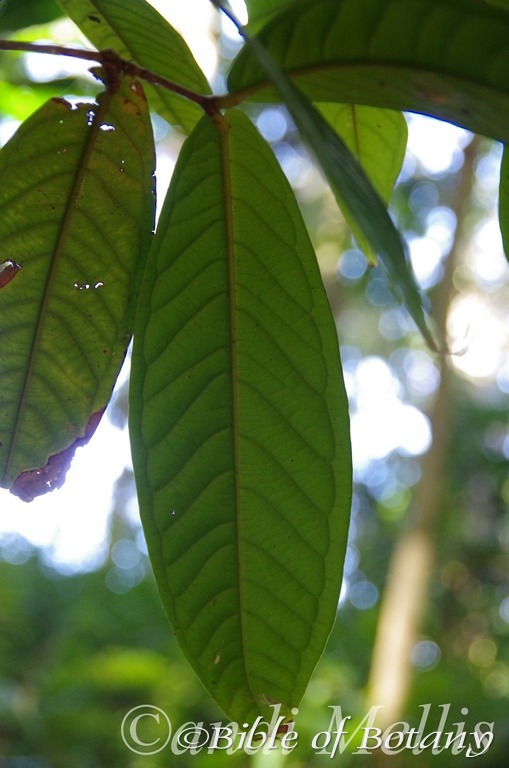
Mount Cootha Botanic Gardens Qld.

Mount Cootha Botanic Gardens Qld.

Mount Cootha Botanic Gardens Qld.

Mount Cootha Botanic Gardens Qld.
Syzygium erythrocalyx
Classification:
Unranked: Eudicots
Class: Rosids
Order: Myrtales
Family: Myrtaceae
Subamily: Myrtoideae
Tribe: Syzygieae
Genus: From Súzugos, which is Ancient Greek or Syzygia, which is Latin for a pair or yoke together. It refers to leaves, which are joined together in pairs.
Specie: From Erythros which is Ancient Greek for scarlet-red and Kalyx, which is Ancient Greek for a cup. It refers to calyxes, which are scarlet-red.
Sub specie:
Common Name: Scarlet Satin Ash, Bumpy Red Satin Ash, Black Ant House Tree or Veiny Satin Ash.
Distribution:
Syzygium erythrocalyx is found in a two disjunct localities east of the Great Dividing Range south from Cooktown to the Daintree National Park and from Cairns to Innisfail in far north Queensland.
https://avh.ala.org.au/occurrences/search?taxa=Syzygium+erythrocalyx#tab_mapView
Habitat Aspect Climate:
Syzygium erythrocalyx prefers dense shade to full sun. It grows within well developed, moist low land and mountain rainforests. The altitude ranges from 5 meters ASL to 700 meters ASL.
The temperatures range from 12 degree in August to 36 degrees in January.
The rainfalls range from lows of 1600mm to 3200mm average per annum.
Soil Requirements:
Syzygium erythrocalyx prefers better quality light clays to medium clays. The soils are usually derived from decomposed brown and black basalts, sandstones or metamorphic rocks. The soils pH ranges from 5pH to 6pH. It does not tolerate water logged soils however trees in riparian zones or gallery forests may experience periodic flooding for short periods. Non saline soils to moderately saline soils are tolerated.
Height & Spread:
Wild Plants: 25m to 35m by 12m to 16m.
Characteristics:
Syzygium erythrocalyx grows as a small tree with a straight, pale grey-brown finely longitudinally fissured trunk. The bark is hard and corky with bumps which are normally hollow and house small black ants, Iridomyrmex gilberti. These ants excrete a very unpleasant odour which is capable of burning the eyes and can cause rashes on the skin if accidently crushed. The branches are pale fawn-brown and become deep red to maroon or burgundy where the newer leaf growth occurs. The branchlets are papery or flaky becoming less so and speckled in red, maroon or burgundy as they approach the smaller branchlets.
The opposite, elliptical to lanceolate leaves of Syzygium erythrocalyx measure 120mm to 310mm in length by 55mm to 110mm in width. The petiole measures 2mm to 10mm in length. The bases are oblique cuneate to cuneate-rounded while the apex is broadly acute to broadly acuminate. The discolourous laminas are deep sea-green, dull and glabrous on the upper lamina while the lower lamina is paler and dull. The new growth is deep red-maroon to deep burgundy. The leaf margins are entire, while the laminas are flat to recurve more so near the base and decurve close to the apex. The mid vein and main lateral veins are deep red-maroon to burgundy and prominent on the lower laminas and are distinctly visible on the upper laminas.
Inflorescences of Syzygium erythrocalyx are born on short umbels, singularly, clusters or both and are ramiflorously, cauliforously, amongst the leaf axils or terminally. The peduncles and pedicels are mid deep red-maroon to deep burgundy. The peduncles measure 5mm to 10mm in length while the pedicels measure 6mm to 10mm in length. The pale creamy, creamy yellow or deep blood-red calyxes and calyx lobes are erect, concave and glabrous. The calyx tubes measure 13mm to 24mm in length by 11mm to 22mm in width. The 4 broad orbicular calyx lobes are lobed and measure 6mm to 10mm in length by 12mm to 24mm in width. The 4 white petals are orbicular, densely covered in visible oil dots and measure 13mm to 23mm in length by 15mm to 25mm on diameter.
The 170 to 220 exserted filaments are free for their entire length and form two dimorphic rings around the outer edge of the hypanthia inside the lobes. The outer filaments measure 25mm to 40mm in length while the inner filaments measure 15mm to 28mm in length. The filaments taper sharply to filament like near the junction with the anthers, are pure white to creamy yellow or creamy green while the dorsifixed anthers are pale creamy fawn to white. The ovate anthers measure 2.5mm to 3mm in length by 1mm to 1.5mm width.
The white, creamy yellow, or pale yellow to pale lemon-green style and stigma are glabrous while the hypanthia disc is pale yellow to pale yellow-green. The pistil measures 27mm to 45mm in length and slightly longer than the stamens. Syzygium erythrocalyx flowers appear from October through to December.
The fruits of Syzygium erythrocalyx are depressed ovoidal globose berries. The berries are glabrous and covered in white film and measure 40mm to 80mm in length by 50mm to 70mm in diameter. The green capsules turn deep purple-black to red or white externally and white internally and pink to deep pink adjacent to the rind and surrounding the seeds when ripe. The white fruit forms are mainly cauliferous and contain a single seed while the coloured fruit forms are mainly ramiflorously to terminally produced and usually contain more than one seed. The pericarp is succulent. The calyx lobes are persistent on the ripe fruit. The 1 to 4 brown seeds are roughly spherical, rugose and pale brown.
Wildlife:
Syzygium erythrocalyx support native bees and honeyeaters during the day and nectar eating bats and possums at night along the coast.
The bark is hard and corky with bumps, which are normally hollow and house small black ants, Iridomyrmex gilberti.
The large fruits are edible but rather sour.
Cultivation:
Syzygium erythrocalyx is a lovely medium size tree in cultivation that should be grown in association with other rainforest specie. It is ideal at the edge of a rain forest or deep in the center of the rainforest. They also make great park trees offering quick growth, and good shade. In cultivation they grow much smaller from 10 meters to 18 meters in height by 8 meters to 10 meters in diameter when grown in the open or taller and narrower if grown closer together as a rainforest tree.
It grows exceptionally well on lighter soils where deep leaf litter keeps the soil cool and moisture at an even level. If these requirements are met they can cope with temperatures as low as 2 degrees and up to 36 degrees as long as it is protected from the frosts by other trees and the days are warm. It is moderately drought resistant in their climatic zones.
Add to the above, if it is given an adequate supply of water and a little native fertilizer on a regular basis when young the plants respond with beautiful large flushes of brilliant coloured new growth.
The flushes of new growth brighten the bush up and are worthwhile planting in small groups scattered throughout the bush for this quality alone.
The trees would make tremendous accent trees in front of low set commercial or industrial sheds where they will break up hard rigid architectural lines and give warmth and breadth to a building. In front of high rise buildings they give balance especially where they could be grown in curves meandering to the entry doors or for something different used from the front of the path and meander back to the far corners. The plants lend themselves beautifully if scattered randomly as the only plants on display.
Propagation:
Seeds: The seeds of Syzygium erythrocalyx can be removed easily from the fruits.
Sow freshly treated seeds directly into a seed raising mix, keeping them moist not wet. Do not over water as the seeds will rot off before germination takes place. Place the trays in a cool shaded area with 50mm shade cloth in the bush house. When the seedlings are 20mm to 25mm tall, prick them out and plant them into 50mm native tubes using a good organic mix.
As the seedlings roots reach the bottom of the tubes plant them out into their permanent position. Do not delay.
Fertilize using Seaweed, fish emulsion or organic chicken pellets soaked in water and apply the liquid on an alternate basis. Fertilize every 2 months until the plants are well established then on an annual basis in September or March to maintain better health, vitality and flowering
Further Comments from Readers:
“Hi reader, it seems you use The Bible of Botany a lot. That’s great as we have great pleasure in bringing it to you! It’s a little awkward for us to ask, but our first aim is to purchase land approximately 1,600 hectares to link several parcels of N.P. into one at The Pinnacles NSW Australia, but we need your help. We’re not salespeople. We’re amateur botanists who have dedicated over 30 years to saving the environment in a practical way. We depend on donations to reach our goal. If you donate just $5, the price of your coffee this Sunday, We can help to keep the planet alive in a real way and continue to bring you regular updates and features on Australian plants all in one Botanical Bible. Any support is greatly appreciated. Thank you.”
In the spirit of reconciliation we acknowledge the Bundjalung, Gumbaynggirr and Yaegl and all aboriginal nations throughout Australia and their connections to land, sea and community. We pay our respect to their Elders past, present and future for the pleasures we have gained.
Syzygium erythrodoxum
Classification:
Unranked: Eudicots
Class: Rosids
Order: Myrtales
Family: Myrtaceae
Subamily: Myrtoideae
Tribe: Syzygieae
Genus: From Súzugos, which is Ancient Greek or Syzygia, which is Latin for a pair or yoke together. It refers to leaves, which are joined together in pairs.
Specie: From Erythros, which is Ancient Greek for scarlet-red and Doxum, which is Ancient Greek for contrary to what is expected. It refers to flowers, which are red to scarlet-red along with the sepals whereas most Syzygium species have white or cream flowers.
Sub specie:
Common Name: Red Satinash or Misty Satinash.
Distribution:
Syzygium erythrodoxum is found in two widely disjunct localities east of the Great Dividing Range from Cooktown to Proserpine, Tully and Rossville and from the Eungella National Park to Mackay far north Queensland.
https://avh.ala.org.au/occurrences/search?taxa=Syzygium+erythrodoxum#tab_mapView
Habitat Aspect Climate:
Syzygium erythrodoxum prefers dense shade to full sun. It grows within cool well developed, moist mountain rainforests or cool moist gallery rainforests in cool tropical areas. They grow as a single trunk small tree or as a multi trunked large shrub often as understory plants in openings along creeks and drainage lines within the forest. The altitude ranges from 610meters ASL to 1500 meters ASL.
The temperatures range from 12 degree in August to 36 degrees in January.
The rainfalls range from lows of 1600mm to 3200mm average per annum.
Soil Requirements:
Syzygium erythrodoxum prefers better quality light clays to medium clays. The soils are usually derived from decomposed brown and black basalts. The soils pH ranges from 5pH to 6pH. It does not tolerate water logged soils however trees in riparian zones or gallery forests may experience periodic flooding for short periods. Non saline soils to moderately saline soils are tolerated.
Height & Spread:
Wild Plants: 5m to 14m by 5m to 7m.
Characteristics:
The trunk and larger stems of Syzygium erythrodoxum are small, straight or crooked, deep grey to deep grey-brown. The bark is hard scabrous. The branchlets are deep grey-brown to mid purplish-brown and only becoming deep green near the apex where the newer leaf growth occurs.
The opposite, elliptical leaves of Syzygium erythrodoxum measure 55mm to 110mm in length by 15mm to 45mm in width. The bases are obliquely cuneate while the apexes are narrowly acute to narrowly acuminate. The discolourous laminas are deep sea-green, dull to semi glossy and glabrous on the upper lamina while the lower lamina is paler and dull. The new leaves are deep purple-pink to deep maroon red and glossy. The leaf margins are entire and decurve at the margins while the laminas are flat to recurved from the mid vein to the margins and the apexes are strongly decurve to 90 degrees. The mid veins are prominent on the lower lamina and are distinctly visible on the upper lamina. The petiole measures 5mm to 12mm in length.
Inflorescences of Syzygium erythrodoxum are born on racemes, from the upper leaf axils or terminally. The peduncles, racemes and pedicels are mid olive-green turning dull, deep blood-red. The peduncles measure 6mm to 10mm in length while the rachises measure 10mm to 18mm in length and the pedicels measure 4mm to 8mm in length.
The calyxes and calyx lobes are pale, dull, red to deep, dull, blood-red externally and creamy fawn to pale creamy brown internally. It is glabrous and divaricate. The calyx tubes measure 3mm to 6mm in length by 5mm to 9mm in diameter across the hypanthia. The 4 broadly triangular calyx lobes are concave with an acute apex and measure 5mm to 9mm in length by 5mm to 8mm in width. The 4 pale, dull red petals are orbicular, conchiform or spathulate and densely covered in fine oil dots and measure 5mm to 8mm in length by 3mm to 6mm on diameter.
The 90 to 160 exserted filaments are free for their entire length and form two dimorphic rings around the outer edge of the hypanthia inside the lobes. The outer filaments measure 15mm to 26mm in length while the inner filaments measure 12mm to 20mm in length. The filaments are dull blood-red to dull orange-red or dull scarlet-red while the dorsifixed anthers are pale cream to white. The ovate anthers measure 0.8mm to 1.2mm in length by 0.7mm to 0.9mm diameter.
The white, creamy yellow, or pale yellow to pale lemon-green style and stigma are glabrous while the hypanthia disc is pale yellow to pale yellow-green. The pistil measures 17mm to 29mm in length and are longer than the stamens. Syzygium erythrodoxum flowers appear from October through to December.
The fruits of Syzygium erythrodoxum are depressed, asymmetrical, and globose to obovoidal berries. The berries are glabrous and measure 20mm to 32mm and 30mm to 40mm in length on the two asymmetrical sides by 25mm to 40mm in diameter. The green capsules turn deep carmine pink externally and are pale pink to white internally when ripe. The calyx lobes are persistent on the ripe fruit and expand to 6mm to 10mm in length. The 1 or 2 pale brown seeds are flattened ellipsoidal and fleshy. The globular seeds measure 10mm to 20mm in diameter.
Wildlife:
Syzygium erythrodoxum’s flowers support native bees and honeyeaters during the day and nectar eating bats and possums at night along the coast.
The fruits are edible but I have not eaten the fruit so cannot describe or vouch for the quality and flavour.
Cultivation:
Syzygium erythrodoxum is a magnificent small tree or large shrub that should be grown in association with other rainforest specie. It is ideal at the edge of a rain forest or deep in the center of the rainforest. It also makes a great park tree offering quick growth, and good shade. In cultivation they grow much smaller from 5 meters to 8 meters in height by 4 meters to 6 meters in diameter when grown in the open or taller and narrower if grown closer together as a rainforest tree.
It grows exceptionally well on lighter soils where deep leaf litter keeps the soil cool and moisture at an even level. If these requirements are met they can cope with temperatures as low as 2 degrees and up to 36 degrees. If it is protected from the frosts by other trees and the days are warm lower temperatures may be acceptable. It is moderately drought resistant in their climatic zones.
This is a magnificent plant that should be more widely grown in southern Australian gardens.
The flushes of new growth brighten the bush up and are worthwhile planting in small groups scattered throughout the bush for this quality alone.
The trees would make tremendous accent trees in front of low set commercial or industrial sheds where they will break up hard rigid architectural lines and give warmth and breadth to a building. In front of high rise buildings they give balance especially where it could be grown in curves meandering to the entry doors or for something different used from the front of the path and meander back to the far corners. The plants lend themselves beautifully if scattered randomly as the only plants on display. Here to add variety they can be grow as single trunk trees and pruned as smaller multi stemmed shrubs.
The trees are susceptible to Psyllid or pimple gall especially when grow in a monoculture or where neighbours use chemical or nonspecific controls. Psyllids can make a tree look terrible, even ghastly when the black sugar mould entirely covers the trees. Control is best achieved by supporting the natural enemies of the many varieties of Psyllids.
Psyllaephagus sp. is small predatory wasps which feed exclusively on psyllids. The female adult wasp lays an egg into the psyllid nymph before the lerp becomes impenetrable to the wasp.
Other hunters of Psyllids include the beautiful Lacewing and ladybirds and their larvae also feed on the psyllid nymphs. Birds, particularly swallows, have been observed flying around badly affected trees when adult psyllids are numerous, and eat adult psyllids. I also suspect that thornbills and silver eyes to play a role in the control of most types of Psyllids as do the bell miners and noisy miner. Spiders which build their webs in trees account for a large number of adults and other small flying insects.
Propagation:
Seeds: The seeds ofSyzygium erythrodoxum can be removed easily from the fruits.
Sow fresh seeds directly into a seed raising mix, keeping them moist not wet. Do not over water as the seeds will rot off before germination takes place. Place the trays in a cool shaded area with 50mm shade cloth in the bush house. When the seedlings are 20mm to 25mm tall, prick them out and plant them into 50mm native tubes using a good organic mix.
As the seedlings roots reach the bottom of the tubes plant them out into their permanent position. Do not delay.
The soils pH ranges from 5pH to 6pH. It does not tolerate water logged soils however trees in riparian zones or gallery forests may experience periodic flooding for short periods. Non saline soils to moderately saline soils are tolerated.
Fertilize using Seaweed, fish emulsion or organic chicken pellets soaked in water and apply the liquid on an alternate basis. Fertilize every 2 months until the plants are well established then on an annual basis in September or March to maintain better health, vitality and flowering.
Further Comments from Readers:
“Hi reader, it seems you use The Bible of Botany a lot. That’s great as we have great pleasure in bringing it to you! It’s a little awkward for us to ask, but our first aim is to purchase land approximately 1,600 hectares to link several parcels of N.P. into one at The Pinnacles NSW Australia, but we need your help. We’re not salespeople. We’re amateur botanists who have dedicated over 30 years to saving the environment in a practical way. We depend on donations to reach our goal. If you donate just $5, the price of your coffee this Sunday, We can help to keep the planet alive in a real way and continue to bring you regular updates and features on Australian plants all in one Botanical Bible. Any support is greatly appreciated. Thank you.”
In the spirit of reconciliation we acknowledge the Bundjalung, Gumbaynggirr and Yaegl and all aboriginal nations throughout Australia and their connections to land, sea and community. We pay our respect to their Elders past, present and future for the pleasures we have gained.
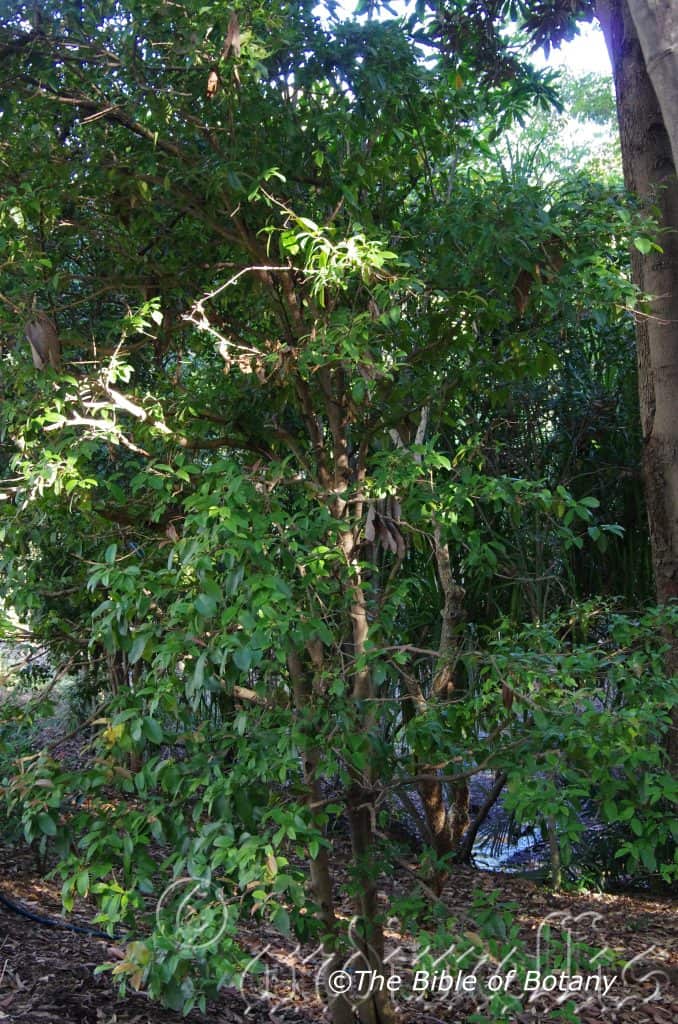
Mount Cootha Botanical Gardens Qld.
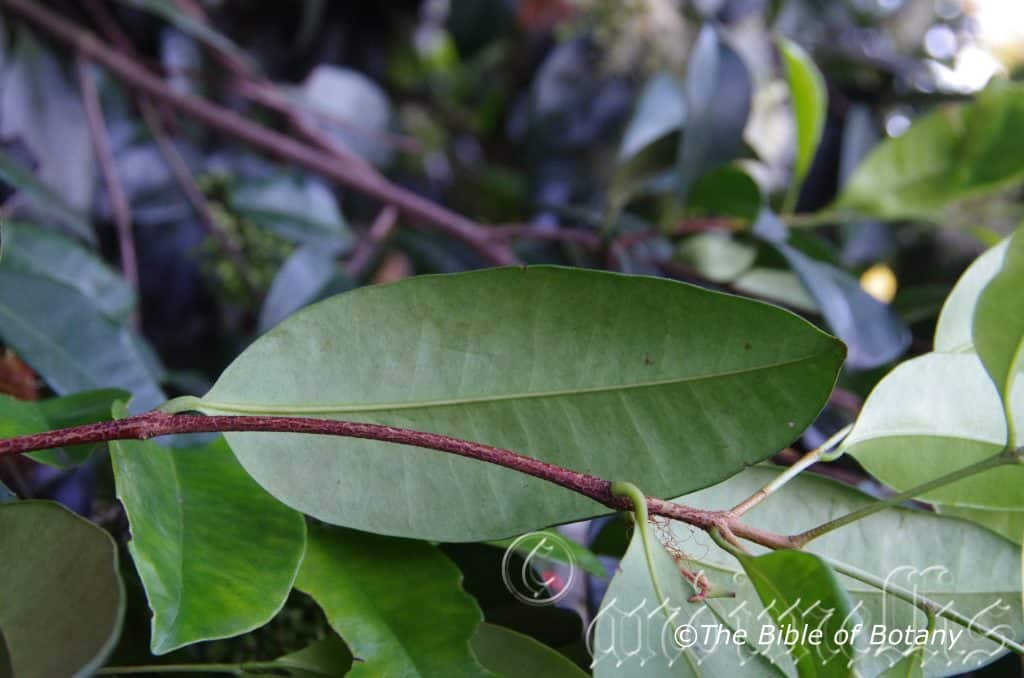
Mount Cootha Botanical Gardens Qld.

Mount Cootha Botanical Gardens Qld.
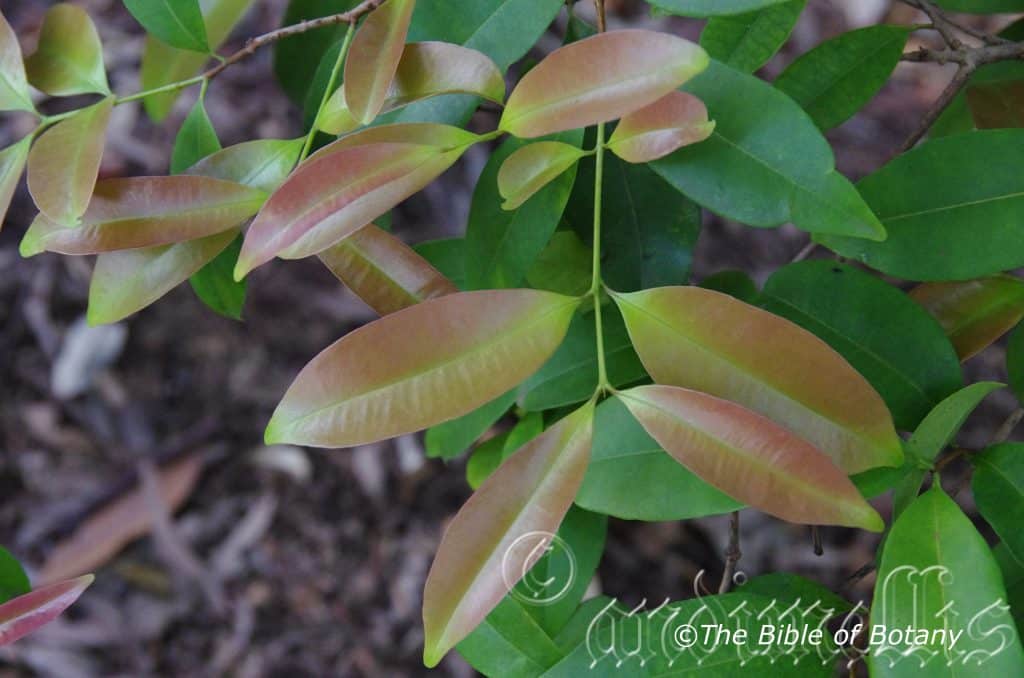
Mount Cootha Botanical Gardens Qld.
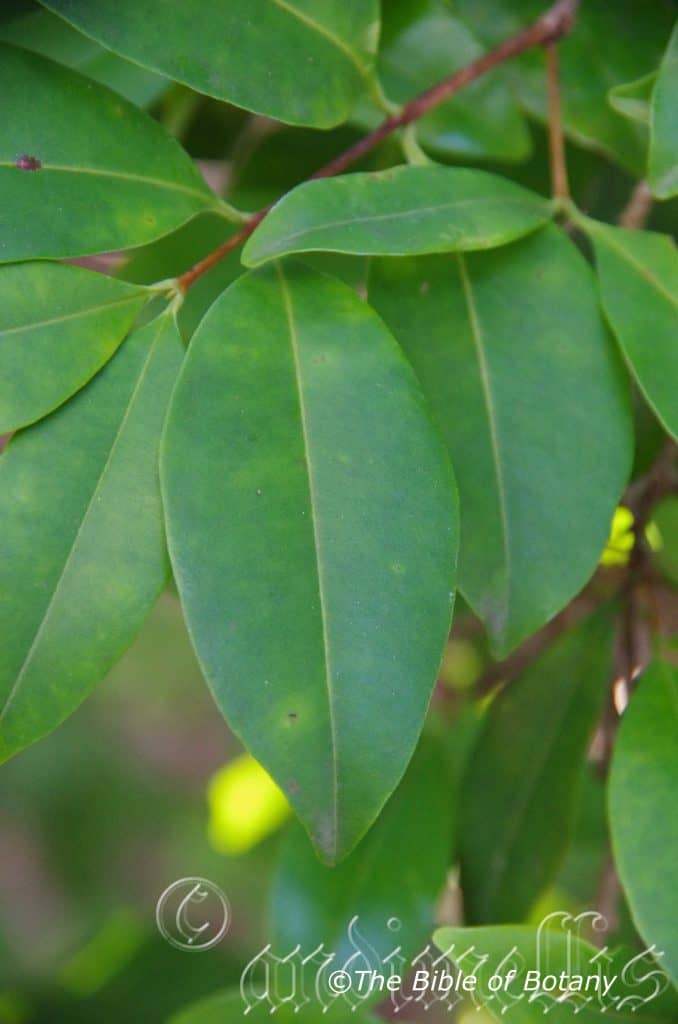
Mount Cootha Botanical Gardens Qld.
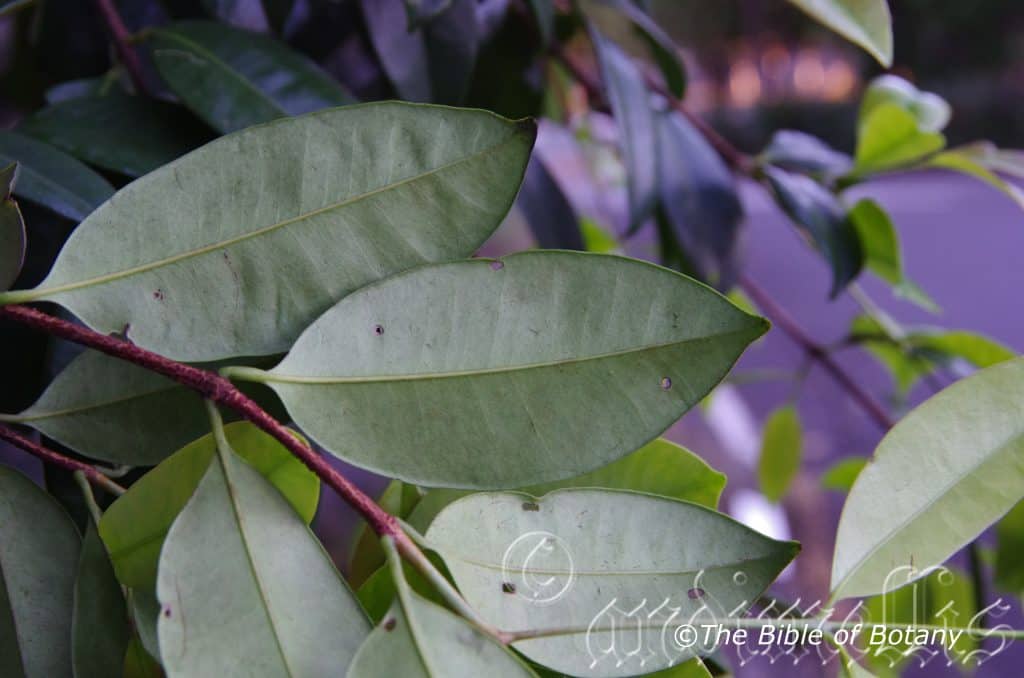
Mount Cootha Botanical Gardens Qld.
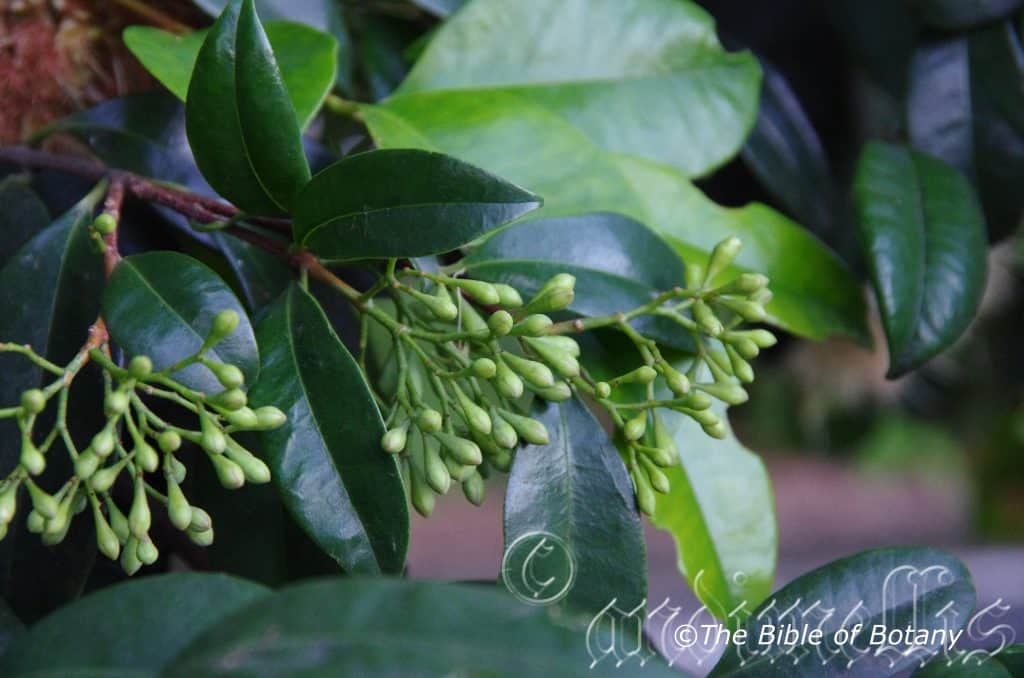
Mount Cootha Botanical Gardens Qld.

Mount Cootha Botanical Gardens Qld.
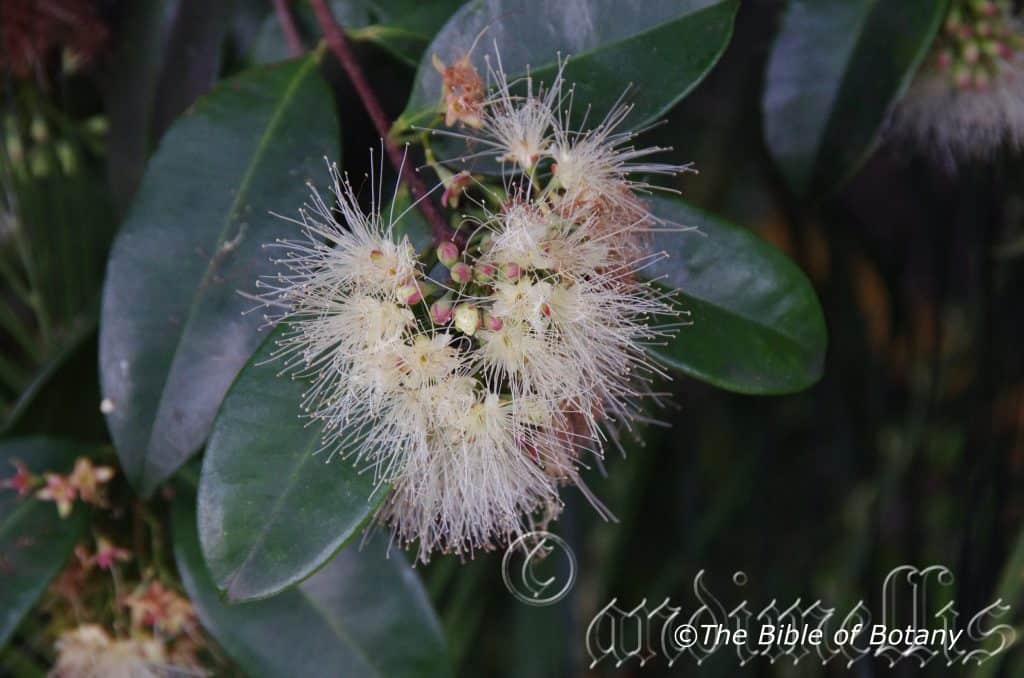
Mount Cootha Botanical Gardens Qld.
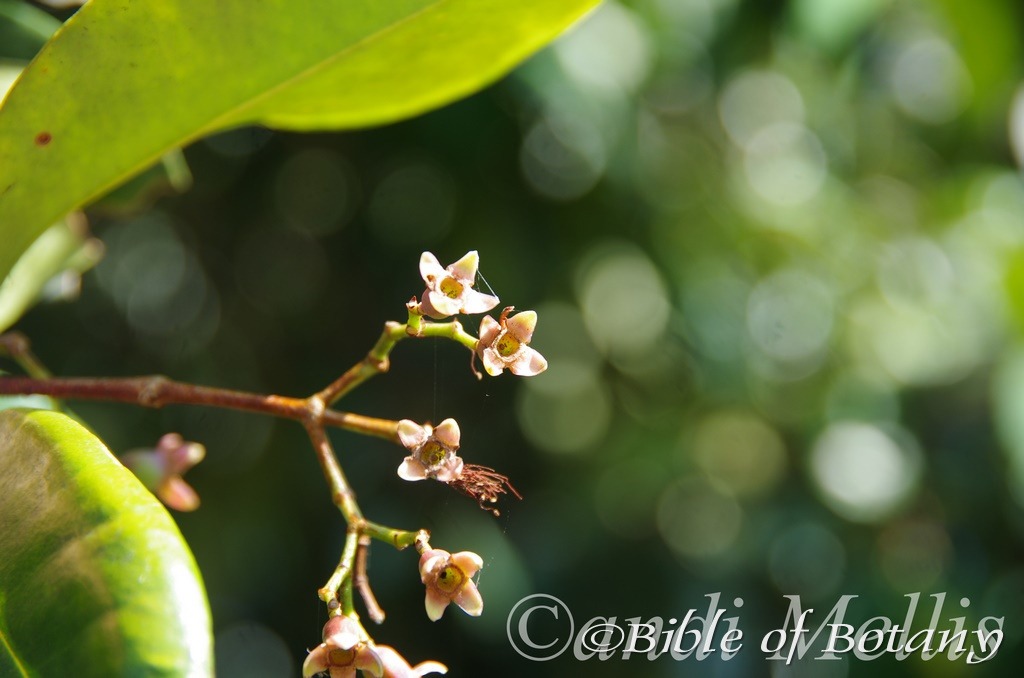
Mount Cootha Botanical Gardens Qld.
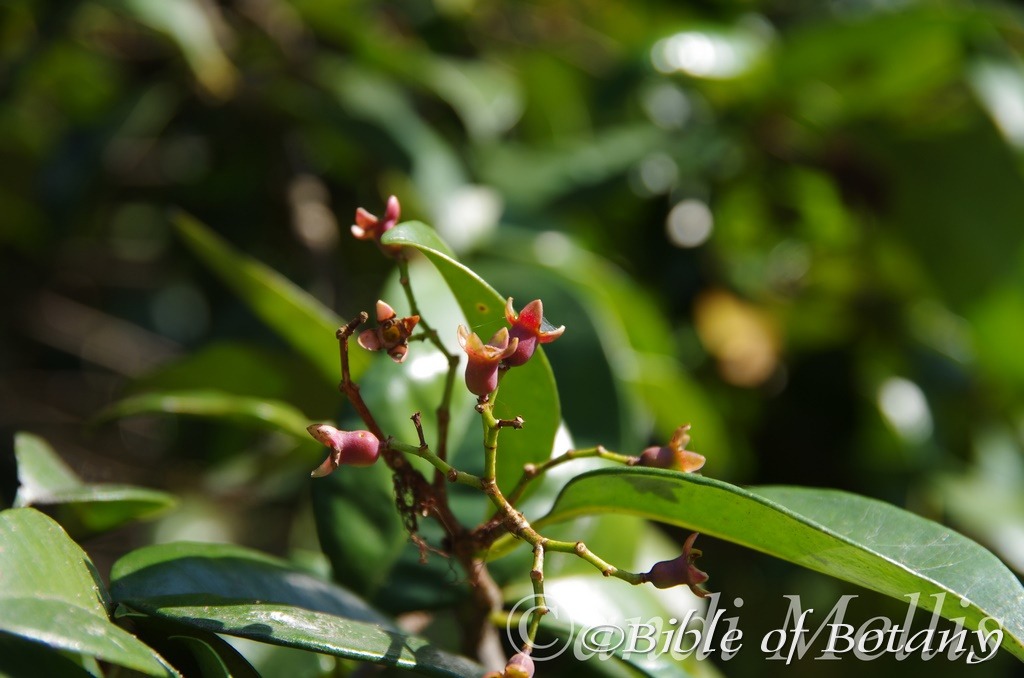
Mount Cootha Botanical Gardens Qld.

Mount Cootha Botanical Gardens Qld.
Syzygium fibrosum
Classification:
Unranked: Eudicots
Class: Rosids
Order: Myrtales
Family: Myrtaceae
Subamily: Myrtoideae
Tribe: Syzygieae
Genus: From Súzugos, which is Ancient Greek or Syzygia, which is Latin for a pair or yoke together. It refers to leaves, which are joined together in pairs.
Specie: From Fibratus, which is Latin for hair like streaks. It refers to the trunks of trees, which are more fibrous than other species in the genus.
Sub specie:
Common Name: Bamaga Satin Ash or Apricot Satin Ash.
Distribution:
Syzygium fibrosum is found east from Melville Bathurst Island in the west to Kakadu National Park and near Yirkala to Nhulunbuy in the Northern Territory.
In the east it is found south from the Torres Straight Islands to the Daintree National Park far north Queensland. It is found on and east of the Great Dividing Range.
https://avh.ala.org.au/occurrences/search?taxa=Syzygium+fibrosum#tab_mapView
Habitat Aspect Climate:
Syzygium fibrosum prefers dense shade to full sun. It grows adjacent to moist rainforests, in dry rainforests, drier seasonal rainforests or monsoonal vine forests. The altitude ranges from 5 meters ASL to 450 meters ASL.
The temperatures range from minus 2 degree in August to 36 degrees in January.
The rainfalls range from lows of 900mm to 3000mm average per annum.
Soil Requirements:
Syzygium fibrosum prefer to grow on light clays to heavy clays. The soils are derived from decomposed brown basalts, black basalts, shales, sandstones or granites. The soils pH ranges from 5pH to 6pH. It does not tolerate water logged soils however trees in riparian zones or gallery forests may experience periodic flooding for short periods. Non saline soils to moderately saline soils are tolerated.
Height & Spread:
Wild Plants: 4m to 6m by 3m to 5m.
Characteristics:
Syzygium fibrosum grows as a small, straight, pale grey-brown and longitudinally fissured. The bark is hard and corky. The branchlets are grey-brown and only becoming green near the apex where the newer leaf growth occurs. The branchlets are scabrous while the new growth is glabrous.
The opposite, ovate to broadly elliptical leaves of Syzygium fibrosum measure 63mm to 110mm in length by 30mm to 50mm in width. The bases are slightly oblique broadly cuneate to rounded while the apexes are broadly acuminate to caudate. The discolourous laminas are deep, sea-green, semi glossy and glabrous on the upper lamina while the lower lamina is paler and dull. The new leaves are deep maroon-red and glossy. The leaf margins are entire and recurved at the margins while the laminas are, flat to slightly recurve from the mid vein to the margins. The mid veins are prominent on the lower lamina and are depressed on the upper lamina. The deep sea-green petioles measure 4mm to 9mm in length.
Inflorescences of Syzygium fibrosum are born on short ramiflorously panicles, from the upper branches. The peduncles, racemes, pedunculates and pedicels are mid sea-green turning mid lime green near the calyxes. The peduncles measure 6mm to 10mm in length, the rachises measure 12mm to 22mm in length while the pedunculates measure 6mm to 10mm in length and the pedicels measure 1mm to 3mm in length.
The calyxes and calyx lobes are deep, glossy, blood-red to maroon-red externally and creamy yellow to yellow internally or lime-green externally and creamy white internally. It is glabrous and divaricate. The calyx tubes measure 4mm to 8mm in length by 3.5mm to 6mm in diameter across the hypanthia. The 4 broadly triangular calyx lobes are concave with a rounded-acute apex and measure 4mm to 6mm in length by 4mm to 6mm in width. The 4 white petals are orbicular, lanceolate or spathulate and covered in fine oil dots and measure 6mm to 8mm in length by 2.5mm to 3.5mm in diameter.
The 60 to 110 exserted filaments are free for their entire length and form two dimorphic rings around the outer edge of the hypanthia inside the lobes. The outer filaments measure 15mm to 26mm in length while the inner filaments measure 12mm to 20mm in length. The filaments are translucent white or yellow while the dorsifixed anthers are pale cream to white. The ovate anthers measure 1mm in length by 0.7mm diameter.
The white, creamy yellow, or pale yellow to pale lemon-green style and stigma are glabrous while the hypanthia disc is pale yellow to pale yellow-green. The pistil measures 18mm to 30mm in length and are longer than the stamens. Syzygium fibrosum flowers appear from October through to December.
The fruits of Syzygium fibrosum are globose to depressed globose berries. The berries are glabrous and covered in white film and measure 10mm to 16mm in length by 18mm to 22mm in diameter. The green capsules turn deep carmine-pink externally and pale pink to white internally when ripe. The calyx lobes are persistent on the ripe fruit, erect and are deep carmine-pink often tipped cream or yellow. The single pale fawn seeds are spherical and fleshy.
Wildlife:
Syzygium fibrosum support native bees like Tetragonula carbonaria and honeyeaters during the day and nectar eating bats and possums at night along the coast.
The fruits are edible but I have not had the pleasure of eating the fruit so I cannot describe or vouch for the quality and flavour. I believe the fruits are similar to Syzygium leuhmannii. If this is the case they would make excellent flavouring for ice cream, fillings for cakes and icings, chutneys and sauces. We have used Syzygium leuhmannii with Chilis for a lovely sweet sauce with some bite depending on the heat of the chili.
Cultivation:
Syzygium fibrosum is a beautiful small tree or large shrub that should be grown in association with other rainforest specie. It is ideal at the edge of a rain forest or deep in the center of the rainforest. It also makes great park tree offering quick growth, and good shade. In cultivation they grow from 3 meters to 4 meters in height by 3 meters to 4 meters in diameter when grown in the open or taller and narrower if grown closer together as a rainforest tree.
Itgrows exceptionally well on lighter better quality soils where deep leaf litter keeps the soil cool and moisture at an even level. If these requirements are met they can cope with temperatures as low as 2 degrees and up to 36 degrees. If it is protected from the frosts by other trees and the days are warm lower temperatures may be acceptable. It is moderately drought resistant in their climatic zones once established.
It should be more widely grown with in temperate areas of Australia and tried at least as far south as Melbourne or Adelaide where very mild frosts prevail. They have not gained widespread popularity but with the copious quantities of colour edible fruit really do warrant a place in most gardens. They suit small to large gardens where they can be pruned on an annual basis to increase bushiness and flowering.
It is ideal for hedges and screens in full sun or semi shaded areas. Because of their dense foliage and quick growth once established it could be used for topiary work or bonsai gardens.
The flushes of new growth brighten the bush up and are worthwhile planting in small groups scattered throughout the bush for this quality alone.
The trees would make tremendous accent trees in front of low set commercial or industrial sheds where they will break up hard rigid architectural lines and give warmth and breadth to a building. In front of high rise buildings they give balance especially where they could be grown in curves meandering to the entry doors or for something different used from the front of the path and meander back to the far corners. The plants lend themselves beautifully if scattered randomly as the only plants on display. Here to add variety they can be grow as single trunk trees and pruned as smaller multi stemmed shrubs.
This Syzygium has potential to be cultivated for its fruit and culinary dishes. Plants should be grown in rows similar to Syzygium leuhmannii in rows 6 meters apart with 6 meter centers.
The trees are susceptible to Psyllidor pimple gall especially when grow in a monoculture or where neighbours use chemical or nonspecific controls. Psyllids can make a tree look terrible, even ghastly when the black sugar mould entirely covers the trees. Control is best achieved by supporting the natural enemies of the many varieties of Psyllids.
Psyllaephagus specie is small predatory wasps which feed exclusively on psyllids. The female adult wasp lays an egg into the psyllid nymph before the lerp becomes impenetrable to the wasp.
Other hunters of Psyllids include the beautiful Green Lacewing Chrysoperla carnea, and ladybirds and their larvae also feed on the psyllid nymphs.
Birds, particularly swallows, have been observed flying around badly affected trees when adult psyllids are numerous, and eat adult psyllids. I also suspect that thornbills like the brown thornbill Acanthiza pusilla or the yellow thornbill Acanthiza nana and silver eyes Zosterops lateralis to play a role in the control of most types of Psyllids as do the bell miners and noisy miner. Spiders which build their webs in trees account for a large number of adults and other small flying insects.
Propagation:
Seeds: The seeds of Syzygium fibrosum can be removed easily from the fruits.
Sow fresh seeds directly into a seed raising mix, keeping them moist not wet. Do not over water as the seeds will rot off before germination takes place. Place the trays in a cool shaded area with 50mm shade cloth in the bush house. When the seedlings are 20mm to 50mm tall, prick them out and plant them into 50mm native tubes using a good organic mix.
As the seedlings roots reach the bottom of the tubes plant them out into their permanent position. Do not delay.
Fertilize using Seaweed, fish emulsion or organic chicken pellets soaked in water and apply the liquid on an alternate basis. Fertilize every 2 months until the plants are well established then on an annual basis in September or March to maintain better health, vitality and flowering.
Further Comments from Readers:
“Hi reader, it seems you use The Bible of Botany a lot. That’s great as we have great pleasure in bringing it to you! It’s a little awkward for us to ask, but our first aim is to purchase land approximately 1,600 hectares to link several parcels of N.P. into one at The Pinnacles NSW Australia, but we need your help. We’re not salespeople. We’re amateur botanists who have dedicated over 30 years to saving the environment in a practical way. We depend on donations to reach our goal. If you donate just $5, the price of your coffee this Sunday, We can help to keep the planet alive in a real way and continue to bring you regular updates and features on Australian plants all in one Botanical Bible. Any support is greatly appreciated. Thank you.”
In the spirit of reconciliation we acknowledge the Bundjalung, Gumbaynggirr and Yaegl and all aboriginal nations throughout Australia and their connections to land, sea and community. We pay our respect to their Elders past, present and future for the pleasures we have gained.
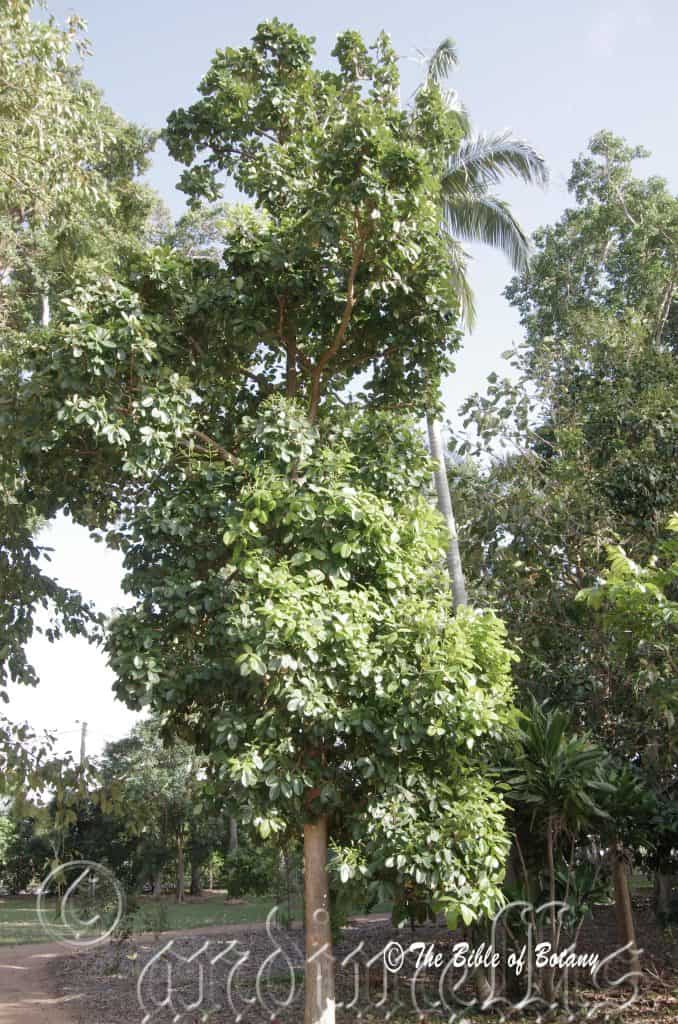
Anderson Botanic Gardens Townsville Qld.
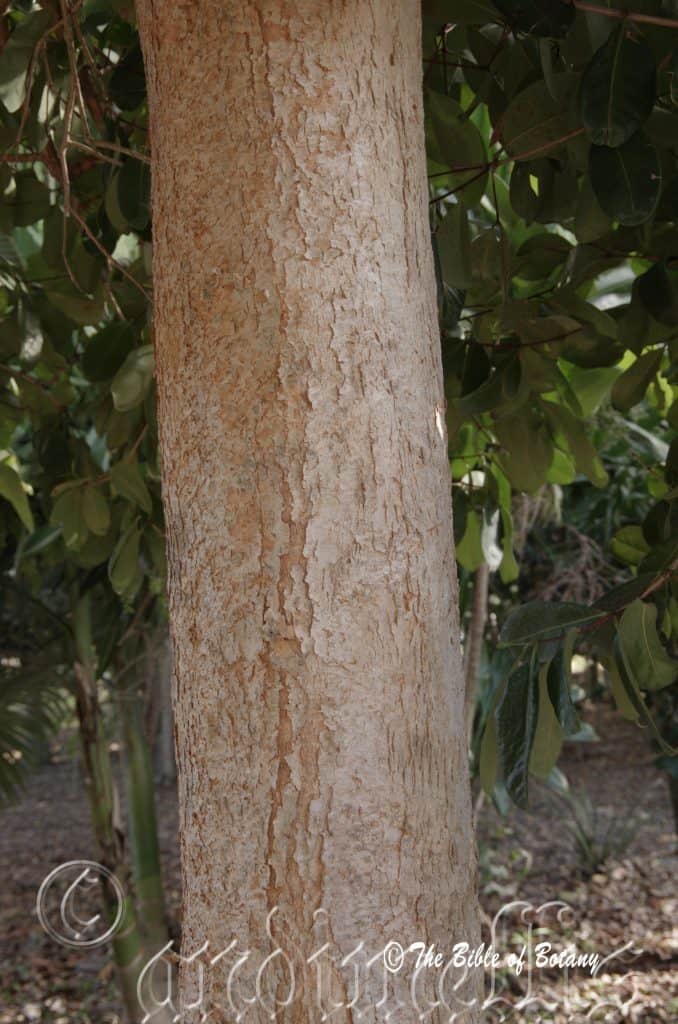
Trunk of Syzygium forte subsp. forte Anderson Botanic Gardens Townsville Qld.


Anderson Botanic Gardens Townsville Qld.
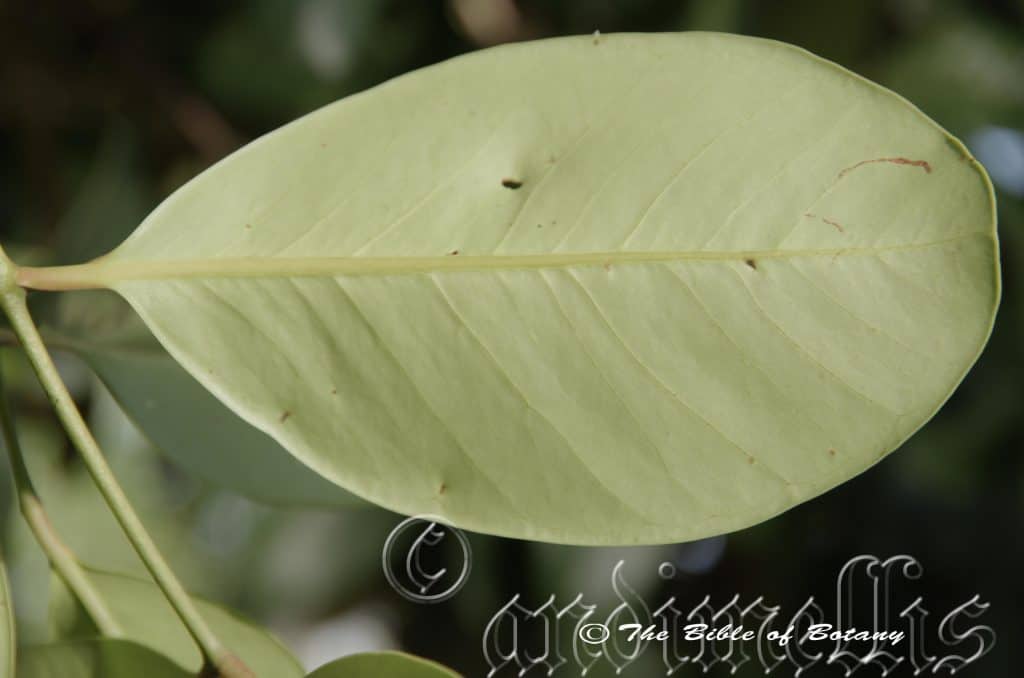
Anderson Botanic Gardens Townsville Qld.
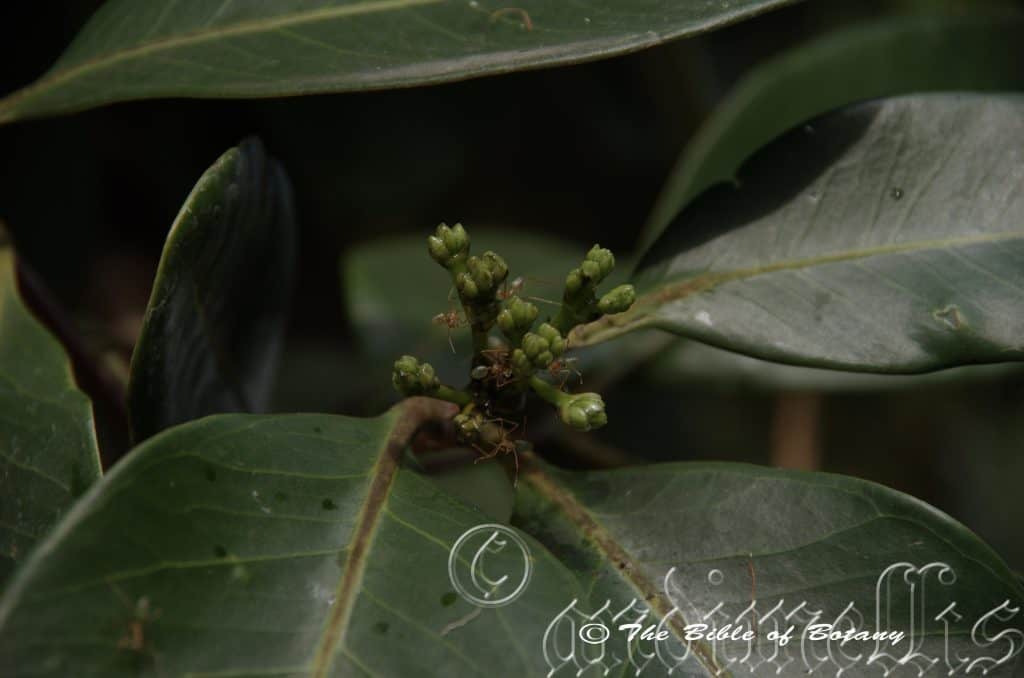
Anderson Botanic Gardens Townsville Qld.
Syzygium forte
Classification:
Unranked: Eudicots
Class: Rosids
Order: Myrtales
Family: Myrtaceae
Subamily: Myrtoideae
Tribe: Syzygieae
Genus: From Súzugos, which is Ancient Greek or Syzygia, which is Latin for a pair or yoke together. It refers to leaves, which are joined together in pairs.
Specie: Originally from Forctis then to Fortis, which are Old Latin for brave or strong and resilient. It refer to plants, which look strong and resilient in their habitats.
Sub specie: Syzygium forte subsp. forte. Originally from Forctis then to Fortis, which are Old Latin for brave or strong and resilient. It refer to plants, which look strong and resilient in their habitats.
Sub specie: Syzygium forte subsp. potamophilum. From Potam/Potamós, which is Ancient Greek for a river and Phílos, which is Ancient Greek for to be loved or loving. It refers to the plants, which have habitats along rivers especially backwaters and other wet environments.
Common Name: Watergum or Satinash or Brown Satinash or Flaky Barked Satinash or White Apple.
Distribution:
Syzygium forte subsp. forte is found east from Melville Island in the west to Kakadu National and near Yirkala in the east.
It is also found south from the Torres Straight Islands to Forest Beach near Ingham in far north Queensland.
Syzygium forte subsp. potamophilum is found in the Kimberley Ranges in north west, Western Australia and south from west Arnhem Land to the Roper River in the Northern Territory.
In the east it is found south from the Torres Strait Islands to Kirrama west of Cardwell in far north eastern Queensland.
https://avh.ala.org.au/occurrences/search?taxa=Syzygium+forte#tab_mapView
Habitat Aspect Climate:
Syzygium forte prefers dense shade to full sun. It grows adjacent to moist rainforests, in dry rainforests, drier seasonal rainforests, seasonal moist forests or monsoonal vine forests. The altitude ranges from 5 meters ASL to 200 meters ASL or to 450 meters ASL.
The temperatures range from minus 2 degree in August to 36 degrees in January.
The rainfalls range from lows of 900mm to 3000mm average per annum.
Soil Requirements:
Syzygium forte prefers light sandy clays to heavy clays. The soils are skeletal or deep. The soils are usually derived from decomposed brown and black basalts and better quality shale, sandstones or granites. The soils pH ranges from 5pH to 6pH. It does not tolerate water logged soils however trees in riparian zones or gallery forests may experience periodic flooding for short periods. Non saline soils to moderately saline soils are tolerated as are salt laden winds.
Height & Spread:
Wild Plants: 6m to 20m by 3m to 5m.
Characteristics:
Syzygium forte sub sp. forte grows as a medium tree with a straight trunk with yellowish, pale orangey-brown to pale pinkish-brown bark. The chartaceous bark is shed in small flaky patches similar to many Melaleuca. The larger branches bark is papery or flaky. The stems are glabrous and deep maroon-burgundy. The new growth is bright glossy green.
The opposite, oblong-ovate to ovate leaves of Syzygium forte subsp. forte measure 70mm to 140mm in length by 40mm to 90mm in width. The olive-green to olive-yellow petioles measure 7mm to 15mm in length. The bases are cuneate to broad cuneate while the apexes are obtuse to narrowing obtuse. The discolourous laminas are deep green to sea-green, semi glossy and glabrous on the upper laminas while the lower laminas are paler and dull. The laminas are gently recurve upwards from the mid vein to the margins and decurve sharply at the apex. The margins are entire, retrorse and maybe slightly undulating. The yellowish to yellowish-green mid vein is prominent on both laminas while the 16 to 30 pinnate lateral veins are faintly prominent on the upper laminas. The oil glands are visible with a lens or maybe barely visible to the naked eye.
Inflorescences of Syzygium forte subsp. forte are short panicles born from the terminals. The green bracts present or absent at anthesis. The peduncles, racemes and pedicels are mid green and glabrous. The peduncles measure 6mm to 10mm in length while the rachises measure 12mm to 22mm in length and the pedicels measure 6mm to 12mm in length.
The conical hypanthia are creamy-yellow and measure 6mm to 7mm in length by 8mm to 9mm in diameter. The calyx lobes are equal or with 1 longer than the other 3 are obtuse to broadly triangular. The lobes measure 1mm to 2mm in length. The orbicular petals are shortly clawed and measure 5mm to 7mm in length. There are 100 minute oil dots on each petal which are barely visible to the naked eye.
The white filaments are free for their entire length and form two dimorphic rings around the outer edge of the hypanthia inside the lobes. The outer filaments measure 9mm to 18mm in length. The white dorsifixed, ovate anthers measure 0.8mm to 1mm in length by 0.7mm diameter.
There is a dorsal gland near the apex of the anther. The style measures 8mm to 14mm in length and is shorter than the stamens. The flowers appear from October through to December.
Syzygium forte subsp. forte’s fruits are depressed globose to globose-ovoid berries. The berries are glabrous and measure 30mm to 40mm in length by 30mm to 40mm in diameter. The green capsules turn white to cream when ripe. The persistent calyx lobes curve over the edge of the 12mm to 14mm apical orifice and measure 2mm to 4mm on the ripe fruit. The single pale fawn seeds are spherical and fleshy.
The pericarp is dry but fleshy and coarsely granular close to the seed. The solitary seed is globular, slightly bilobed and measures 10mm to 25mmin diameter. The testa adheres to the pericarp and adheres slightly to the rugose surface of the cotyledons.
Syzygium forte subsp. potamophilum grow as a medium, straight tree with pink, reddish or pale reddish-brown bark. The chartaceous bark is shed in flaky patches similar to many Melaleuca often with hard patches. The larger branches tend to have harder patches. The leafy twigs are often reddish with the bark on older twigs being flaky or papery. The new growth is blue-green.
The opposite, elliptical of oblong-elliptical leaves of Syzygium forte subsp. potamophilum measure 77mm to 128mm in length by 25mm to 60mm in width. The olive-green to olive-yellow petioles measure 5mm to 16mm in length. The bases are cuneate while the apexes are acuminate. The discolourous laminas are mid bluish-green to deep bluish-green, dull and glabrous on the upper laminas while the lower laminas are paler. The laminas are flat and straight while the margins are entire slightly undulating. The yellowish to yellowish-green mid vein is slightly prominent on the upper lamina while the 54 to 64 pinnate lateral veins are slightly visible. The oil glands are visible with a hand lens or are barely visible to the naked eye.
The inflorescences of Syzygium forte subsp. potamophilum are born on short panicles, from the terminals or cauliforously on the smaller leafless branches. The caducous bracts are absent at anthesis. The peduncles, racemes, pedunculates and pedicels are bluish-green and glabrous. The peduncles measure 0mm to 25mm in length, the rachises measure 10mm to 20mm in length and the pedicels measure 5mm to 9mm in length.
The conical, hypanthium and lobes are pastel creamy-green and glabrous. The hypanthium measure 5mm to 9mm in length by 4mm to 8mm in diameter. The 4 broad obtuse lobes are concave with a rounded-acute apex and measure 0.5mm to 1mm in length. The 4 white petals are orbicular-spathulate and measure 8mm to 11mm in length by 6m to 8mm in diameter. The minute oil dots are visible and number 100 or more per petal.
The 60 to 110 filaments are free for their entire length and form two dimorphic rings around the outer edge of the hypanthia inside the lobes. The filaments are white to cream. The outer filaments measure 10mm to 15mm in length while the anthers measure 0.8mm to 0.9mm in length by 0.6mm in width. The basifixed anthers are longitudinally ribbed and have a terminal gland near the back of the anther close to the apex.
The ovules number 20 to 40 per locule. The style measures 11mm to 17mm in length. The flowers appear from October through to December.
Syzygium forte subsp. potamophilum’s fruits are depressed globular berries. The glabrous berries measure 16mm to 25mm in length by 27mm to 38mm in diameter. The green berries turn white to cream externally and white to cream internally when ripe. The calyx lobes are persistent and fold inwards on the ripe fruit. The pericarp is fleshy and like a dry watermelon in texture. The single pale fawn seed is spherical and measures 15mm to 20mm in diameter. The testa adheres to the pericarp and adheres slightly to the rugose surface of the cotyledons by means of granular horny intrusions.
Wildlife:
Syzygium forte support native bees and honeyeaters during the day and nectar eating bats and possums at night.
The fruits are edible with a similar flavour to loquats with a dash of nutmeg or cinnamon added. Some people have described it as having a slight ginger favourite nutmeg or cinnamon flavour is not surprising as this flavour is often associated with several of the Syzygium species. This may make them excellent flavouring for ice cream, apple pies, fillings for cakes and icings, chutneys and sauces.
Cultivation:
Syzygium forte is a beautiful small tree or large shrub that should be grown in association with other rainforest specie. It is ideal at the edge of a rain forest or deep in the center of the rainforest. It also makes a great park tree offering quick growth, and good shade. In cultivation it grows from 4 meters to 6 meters in height by 4 meters to 7 meters in diameter when grown in the open as a large shrub, from 9 meters to 15 meters in height by 4 meters to 6 meters in diameter when grown as a tree or taller and narrower if grown closer together as a rainforest specimen.
It grows exceptionally well on lighter better quality soils where deep leaf litter keeps the soil cool and moisture at an even level. If these requirements are met it can cope with temperatures as low as 2 degrees and up to 40 degrees. If it is protected from the frosts by other trees and the days are warm lower temperatures may be acceptable. It is moderately drought resistant in their climatic zones once established.
It should be more widely grown with in temperate areas of Australia and tried at least as far south as Melbourne or Adelaide where very mild frosts prevail. It has not gained widespread popularity but with the copious quantities of white edible fruits and beautiful bark, really does warrant persevering with and trying further south in marginal areas.
It is ideal as a large hedge or screen plant in full sun or semi shaded areas, because of their dense foliage and quick growth once established it could be used for topiary work or as a potted bonsai specimen.
The trees would make tremendous accent trees in front of low set commercial buildings, industrial sheds or low set school buildings where it breaks up hard rigid architectural lines and gives warmth and breadth to a building. In front of high rise buildings it gives balance especially where it can be grown in curves meandering to the entry doors or for something different used from the front of the path and meander back to the far corners.
Syzygium forte has potential to be cultivated for its fruit and culinary dishes. Plants should be grown in rows similar to Syzygium leuhmannii in rows 6 meters apart with 6 meter centers.
The trees are susceptible to Psyllid or pimple gall especially when grow in a monoculture or where neighbours use chemical or nonspecific controls. Psyllids can make a tree look terrible, even ghastly when the black sugar mould entirely covers the trees. Control is best achieved by supporting the natural enemies of the many varieties of Psyllids.
Psyllaephagus specie is small predatory wasps which feed exclusively on psyllids. The female adult wasp lays an egg into the psyllid nymph before the lerp becomes impenetrable to the wasp.
Other hunters of Psyllids include the beautiful Lacewing and ladybirds and their larvae also feed on the Psyllid nymphs. Birds, particularly swallows, have been observed flying around badly affected trees when adult Psyllids are numerous, and eat adult Psyllids. I also suspect that thornbills and silver eyes to play a role in the control of most types of Psyllids as do the bell miners and noisy miner. Spiders which build their webs in trees account for a large number of adults and other small flying insects.
Another problem facing potential farmers would be Grey Headed Flying Fox (Pteropus poliocephalus), theLittle Red Flying Fox (Pteropus scapulatus) and the beautiful little Sugar Gliders (Petaurus breviceps).
Propagation:
Seeds: The seeds of Syzygium forte can be removed easily from the fruits. The seeds need to be thoroughly washed prior to sowing.
Sow freshly washed seeds directly into a seed raising mix, keeping them moist not wet. Do not over water as the seeds will rot off before germination takes place. Place the trays in a cool shaded area with 50mm shade cloth in the bush house. When the seedlings are 20mm to 50mm tall, prick them out and plant them into 50mm native tubes using a good organic mix.
As the seedlings roots reach the bottom of the tubes plant them out into their permanent position. Do not delay.
Fertilize using Seaweed, fish emulsion or organic chicken pellets soaked in water and apply the liquid on an alternate basis. Fertilize every 2 months until the plants are well established then on an annual basis in September or March to maintain better health, vitality and flowering.
Further Comments from Readers:
“Hi reader, it seems you use The Bible of Botany a lot. That’s great as we have great pleasure in bringing it to you! It’s a little awkward for us to ask, but our first aim is to purchase land approximately 1,600 hectares to link several parcels of N.P. into one at The Pinnacles NSW Australia, but we need your help. We’re not salespeople. We’re amateur botanists who have dedicated over 30 years to saving the environment in a practical way. We depend on donations to reach our goal. If you donate just $5, the price of your coffee this Sunday, We can help to keep the planet alive in a real way and continue to bring you regular updates and features on Australian plants all in one Botanical Bible. Any support is greatly appreciated. Thank you.”
In the spirit of reconciliation we acknowledge the Bundjalung, Gumbaynggirr and Yaegl and all aboriginal nations throughout Australia and their connections to land, sea and community. We pay our respect to their Elders past, present and future for the pleasures we have gained.
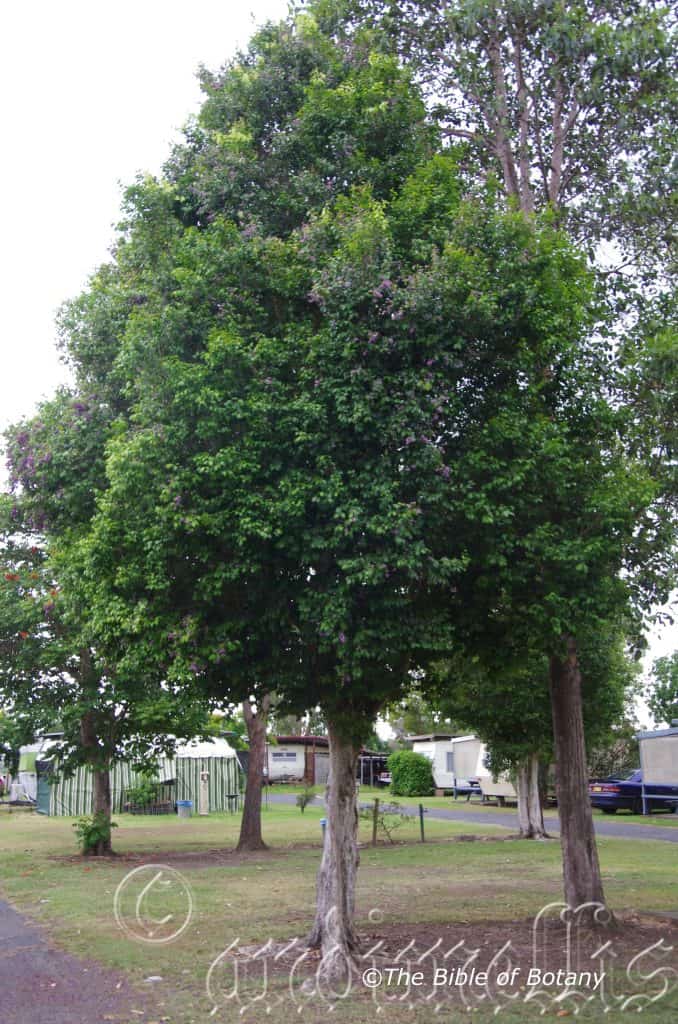
South Grafton NSW

North Haven NSW
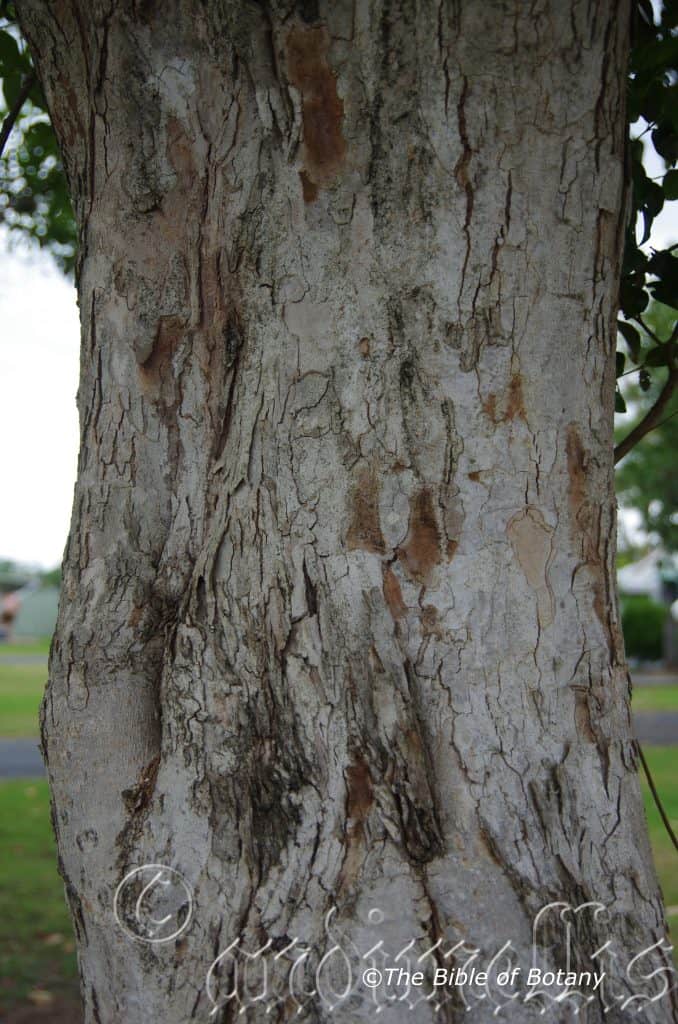
South Grafton NSW

South Grafton NSW
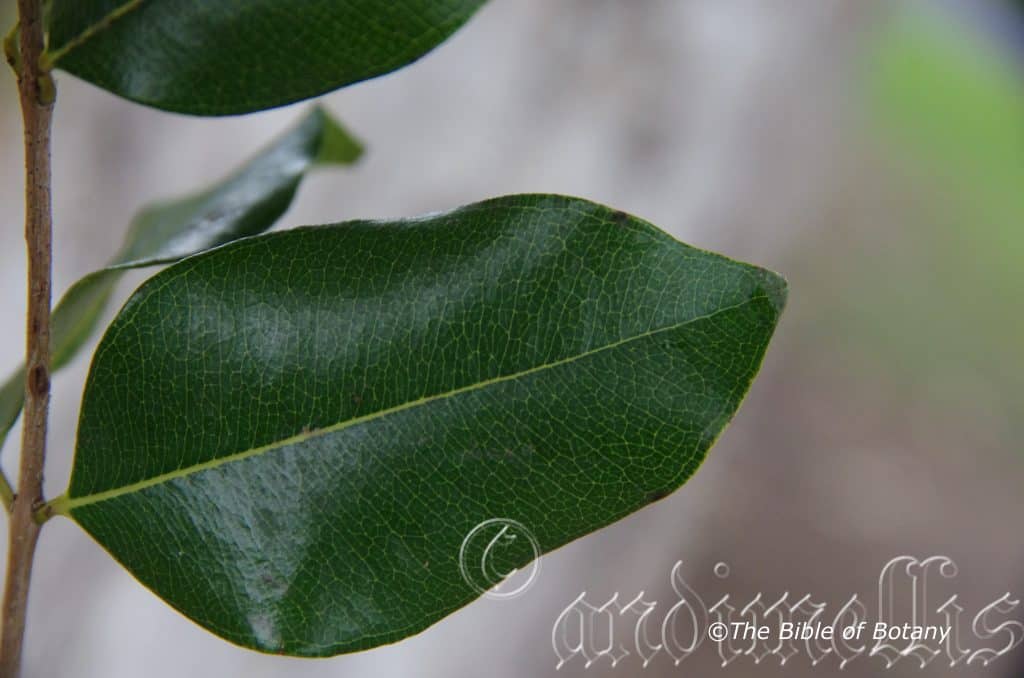
South Grafton NSW
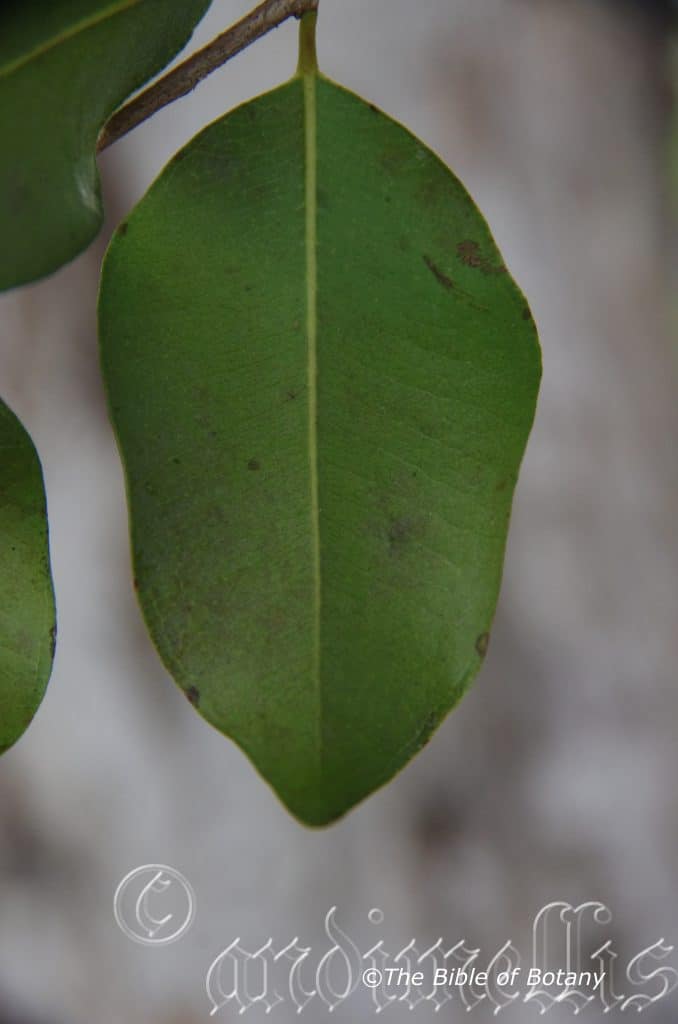
South Grafton NSW

South Grafton NSW
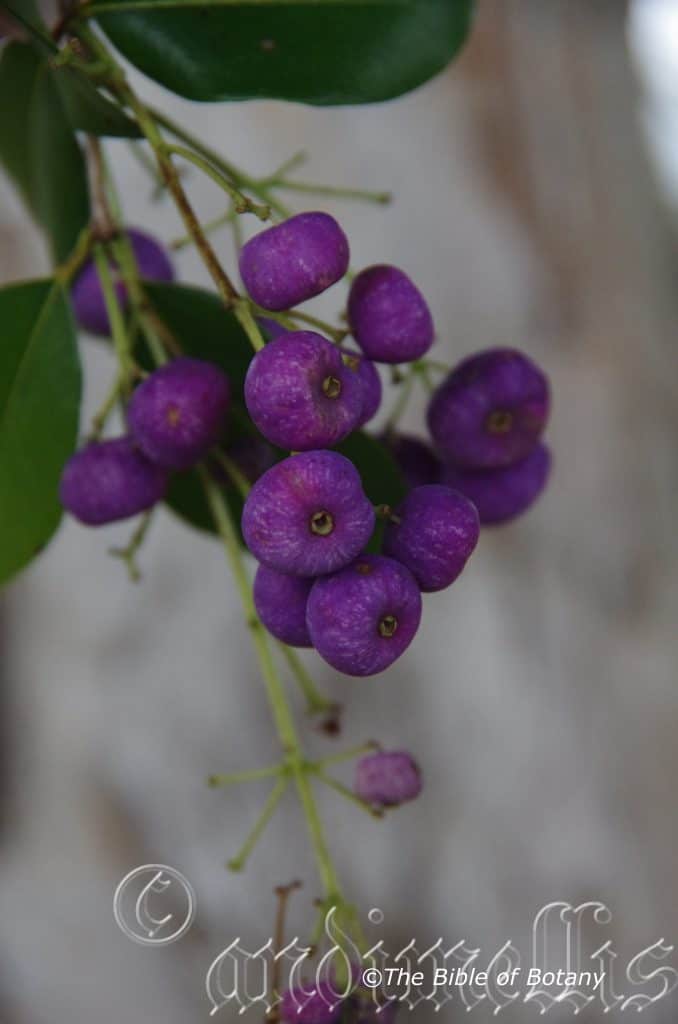
South Grafton NSW
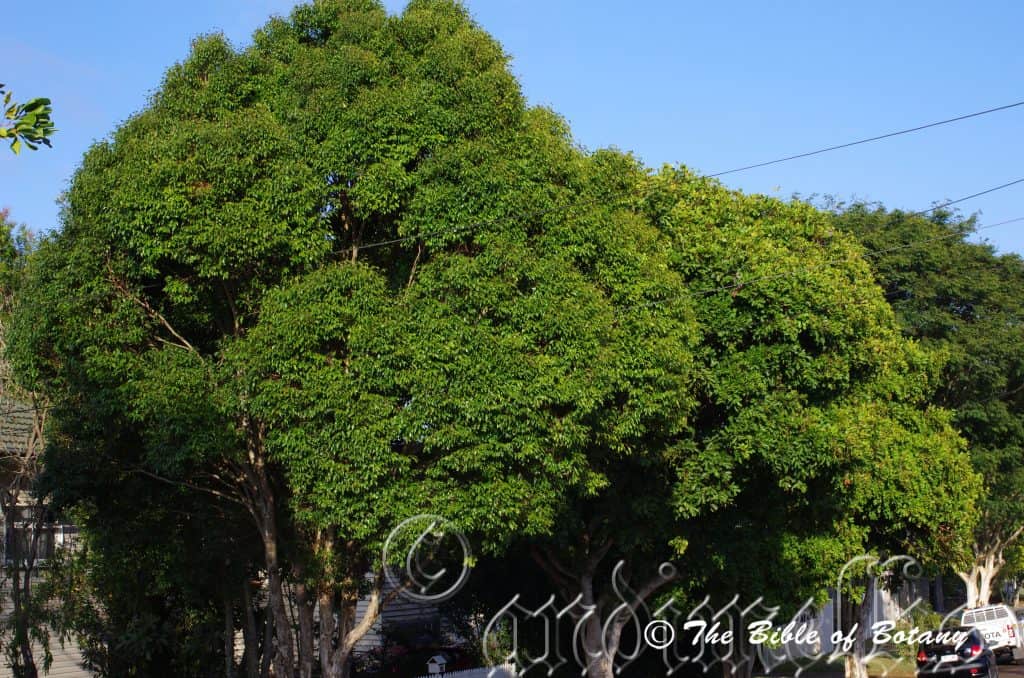
Norman Park Qld.
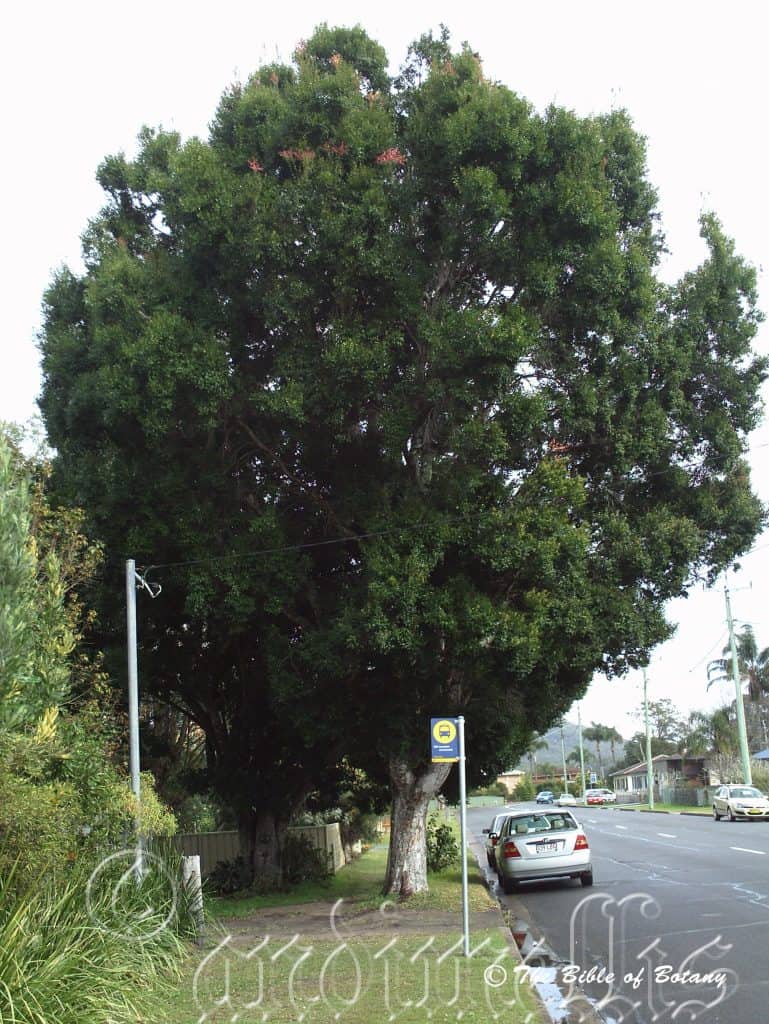
North Haven NSW
Syzygium francisii
Classification:
Unranked: Eudicots
Class: Rosids
Order: Myrtales
Family: Myrtaceae
Subamily: Myrtoideae
Tribe: Syzygieae
Genus: From Súzugos, which is Ancient Greek or Syzygia, which is Latin for a pair or yoke together. It refers to leaves, which are joined together in pairs.
Specie: Is named in honour of Francis but which Francis cannot be substantiated.
Sub specie:
Common Name: Giant Water Gum.
Distribution:
Syzygium francisii is found south from Maryborough, Burrum Heads and Agnes Waters in southern coastal Queensland to Seal Rocks in central coastal New South Wales. There is also an outlying population near Gosford in New South Wales and Proserpine in northern Queensland.
https://avh.ala.org.au/occurrences/search?taxa=Syzygium+francisii#tab_mapView
Habitat Aspect Climate:
Syzygium francisii prefers dense shade to full sun. It grows in or adjacent to warm, moist, well developed rainforests or warm, moist, littoral rainforests on river flats or alluvial plains. The altitude ranges from 15 meters ASL to 860 meters ASL.
The temperatures range from minus 2 degree in August to 36 degrees in January.
The rainfalls range from lows of 900mm to 2000mm average per annum.
Soil Requirements:
Syzygium francisii prefers medium clays to heavy clays. The soils are usually derived from decomposed brown and black basalts or alluvial river flats. The soils pH ranges from 4.5pH to 6.5pH. It does not tolerate water logged soils however trees in riparian zones or gallery forests may experience periodic flooding for short periods. Non saline soils to moderately saline soils are tolerated.
Height & Spread:
Wild Plants: 25m to 35m by 12m to 15m.
Characteristics:
Syzygium francisii grows as a large tree with a straight, pale brown to creamy fawn, flaky trunk. The bark is hard on the large buttresses which is produced on old trees. The smaller branches are pale brown. The branchlets are pale green often with reddish-brown markings and glabrous.
The opposite, ovate to broadly elliptical leaves of Syzygium francisii measure 40mm to 80mm in length by 15mm to 35mm in width. The base is cuneate while the apex is acute to acuminate. The discolourous laminas are deep grass-grass green to deep green, semi glossy and glabrous on the upper lamina while the lower lamina is paler and dull. The new growth is bright purple-pink. The leaf margins are entire, flat or slightly undulating while the margins recurve from the mid vein to the margins and decurve near the apex. The mid veins are slightly prominent on the lower lamina and are faintly visible on the upper lamina. The petiole measures 4mm to 9mm in length.
Inflorescences of Syzygium francisii are born on short panicles or umbels from the upper leaf axils or terminals. The peduncles, racemes, pedicellates and pedicels are mid green with some irregular purplish markings. The measurements are vary variable with the peduncles measuring 20mm to 60mm in length, the rachises measure 40mm to 100mm in length while the pedunculates measure 8mm to 25mm in length and the pedicels measure 1mm to 5mm in length.
The calyxes and calyx lobes are pale green to pale creamy yellow, semi glossy, externally and internally. It is glabrous and divaricate. The calyx tubes measure 6mm to 9mm in length by 5mm to 7mm in diameter across the hypanthia. The 4 broadly triangular calyx lobes are concave with a rounded-acute apex and measure 1mm to 2mm in length. The 4 white petals are orbicular, covered in fine oil dots and measure 2mm to 3mm in length by 2mm to 3mm in diameter.
The 60 to 110 exserted filaments are free for their entire length and form two dimorphic rings around the outer edge of the hypanthia inside the lobes. The outer filaments measure 4mm to 6.5mm in length while the inner filaments measure 3mm to 4mm in length. The filaments are white while the dorsifixed anthers are pale yellow to cream.
The white style and stigma are glabrous while the hypanthia disc is pale yellow to pale creamy yellow. The pistil measures 6mm to 8mm in length and are longer than the stamens. Syzygium francisii flowers appear from October through to January.
The fruits of Syzygium francisii are depressed globose berries. The berries are glabrous and measure 7mm to 13mm in length by 11mm to 21mm in diameter. The green capsules turn pale to deep carmine-purple externally and white internally when ripe. The calyx lobes are persistent on the ripe fruit and surround the concave apex. The base is also concaved around the pedicel. The single brown seeds are flattened ellipsoidal and fleshy. The seeds measure 5mm to 9mm in length by 6mm to 10mm in diameter.
Wildlife:
Syzygium francisii support native bees and honeyeaters along the coast during the day and possums and fruit eating bats at night. It is a terrific sand stabilizer on the back dunes in the littoral rainforests.
Cultivation:
Syzygium francisii is a beautiful large tree that must be given plenty of room to expand even in cultivation. Don’t be fooled or sucked into planting one on small suburban blocks because the neighbours have a beautiful one growing which has small leaves and beautiful flushes of purple several times a year. This is a big tree. It is suitable for growing in association with other rainforest specie. It is ideal at the edge of a rain forest or deep in the center of the rainforest garden. It also makes a tremendous park tree offering relatively quick growth in height before spreading to their maximum width where it gives good dense shade. In cultivation it grows from 15 meters to 20 meters in height by 18 meters to 26 meters in diameter when grown in the open or taller and narrower if grown closer together as a rainforest tree.
It grows exceptionally well on lighter better quality loams where deep leaf litter keeps the soil cool and moisture at an even level. If these requirements are met it can cope with temperatures as low as minus 2 degrees and up to 36 degrees. If it is protected from the frosts by other trees and the days are warm, lower temperatures may be acceptable. It requires a continuous supply of moisture throughout the year and can easily cope with seasonal inundations if planted in gullies or drainage lines.
It should be more widely grown with in temperate areas of Australia and tried at least as far south as Melbourne or Adelaide where very mild frosts prevail. It has not gained widespread popularity but with the copious quantities of colour fruit really do warrant a place in larger gardens.
The trees would make fabulous accent tree in front of low set commercial buildings, industrial sheds or school out buildings and classrooms where the room dictates a large tree. It breaks up hard rigid architectural lines and gives warmth to a building. In front of high rise buildings it gives balance especially where several plants can be grown in close proximity. The plants lend themselves beautifully if scattered randomly as the only plants on display.
The trees are susceptible to Psyllidae or pimple gall especially when grow in a monoculture or where neighbours use chemical or nonspecific controls. Psyllids can make a tree look terrible, even ghastly when the black sugar mould entirely covers the trees. Control is best achieved by supporting the natural enemies of the many varieties of Psyllids.
Psyllaephagus specie is small predatory wasps which feed exclusively on psyllids. The female adult wasp lays an egg into the Psyllid nymph before the lerp becomes impenetrable to the wasp.
Other hunters of Psyllids include the beautiful Lacewing and ladybirds and their larvae also feed on the Psyllid nymphs. Birds, particularly swallows, have been observed flying around badly affected trees when adult psyllids are numerous, and eat adult Psyllids. I also suspect that thornbills and silver eyes to play a role in the control of most types of Psyllids as do the bell miners and noisy miner. Spiders which build their webs in trees account for a large number of adults and other small flying insects.
Propagation:
Seeds: The seeds of Syzygium francisii can be removed easily from the fruits.
Sow fresh seeds directly into a seed raising mix, keeping them moist not wet. Do not over water as the seeds will rot off before germination takes place. Place the trays in a cool shaded area with 50mm shade cloth in the bush house. When the seedlings are 20mm to 25mm tall, prick them out and plant them into 50mm native tubes using a good organic mix.
As the seedlings roots reach the bottom of the tubes plant them out into their permanent position. Do not delay.
Fertilize using Seaweed, fish emulsion or organic chicken pellets soaked in water and apply the liquid on an alternate basis. Fertilize every 2 months until the plants are well established then on an annual basis in September or March to maintain better health, vitality and flowering.
Further Comments from Readers:
“Hi reader, it seems you use The Bible of Botany a lot. That’s great as we have great pleasure in bringing it to you! It’s a little awkward for us to ask, but our first aim is to purchase land approximately 1,600 hectares to link several parcels of N.P. into one at The Pinnacles NSW Australia, but we need your help. We’re not salespeople. We’re amateur botanists who have dedicated over 30 years to saving the environment in a practical way. We depend on donations to reach our goal. If you donate just $5, the price of your coffee this Sunday, We can help to keep the planet alive in a real way and continue to bring you regular updates and features on Australian plants all in one Botanical Bible. Any support is greatly appreciated. Thank you.”
In the spirit of reconciliation we acknowledge the Bundjalung, Gumbaynggirr and Yaegl and all aboriginal nations throughout Australia and their connections to land, sea and community. We pay our respect to their Elders past, present and future for the pleasures we have gained.
Syzygium hemilampra
Classification:
Unranked: Eudicots
Class: Rosids
Order: Myrtales
Family: Myrtaceae
Subamily: Myrtoideae
Tribe: Syzygieae
Genus: From Súzugos, which is Ancient Greek or Syzygia, which is Latin for a pair or yoke together. It refers to leaves, which are joined together in pairs.
Specie: From Hemi, which is Ancient Greek for half and Lampra which is Ancient Greek for shinning. It usually refers to leaves, which are semi glossy on the upper surface or at times the fruits having a slight sheen.
Sub specie:
Common Name: Broad Leaf Lilli Pilli.
Distribution:
Syzygium hemilampra is found south from the Torres Straight Islands in far north eastern Queensland to Iluka in northern coastal New South Wales.
It is also found on Melville and Bathurst Island and Gurig National Park in the Northern Territory.
https://avh.ala.org.au/occurrences/search?taxa=Syzygium+hemilampra#tab_mapView
Habitat:
Syzygium hemilampra prefer full sun, dense shade or dappled shade. It grows on gentle slopes or on alluvial river flats bordering well developed rainforests, wet Eucalyptus forests, riverine rainforests, gallery forests or littoral rainforests. The altitude ranges from 5 meters ASL in the south and 450 meters ASL to 1550 meters ASL in far north Queensland
The temperatures range from 2 degrees in July to 36 degrees in January.
The rainfalls range from lows of 750mm to an average of 3200mm annually.
Soil Requirements:
Syzygium hemilampra prefer better quality, deep, loams, light fatty clays to medium clays or light silts to heavy silts. The soils are usually derived from decomposed sandstones granites, brown basalts, black basalts, shales, metamorphic rocks or alluvial deposits on creek meanders. The soil’s pH ranges from 5.5pH to 7pH. It tolerates seasonal water logged soils. None saline soils to very saline soils are tolerated as are salt laden winds.
Height & Spread:
Wild Plants: 25m to 35m by 6m to 9m.
Characteristics:
Syzygium hemilampra grows as a tall slender tree or a large bushy shrub in more exposed situations. The tall, stout trunk is red-brown with a flaky bark that is usually covered in lichens on the upper trunk and large branches. The bases of large trees are slightly flanged. The branchlets are grey to creamy-grey and flaky while the juvenile branchlets are mid green and glabrous.
Syzygium hemilampra leaves are elliptical to broadly lanceolate. They measure 40mm to 130mm in length by 20mm to 50mm in width. The bases are broadly cuneate to cuneate-rounded while the apexes are bluntly acuminate. The discolourous laminas are deep green to deep sea-green, glabrous and semi glossy to glossy on the upper laminas while the lower laminas are paler or at times glaucous and dull. Juvenile leaves are pink, red, purple and glossy. The margins are entire while the laminas recurve slightly from the mid vein to the margins.
The mid veins are prominent on the lower laminas and clearly visible from the upper laminas. The intramarginal and lateral veins are distinct. The oil dots are very variable in size, distribution and quantity. The petioles are deep green, glabrous and measure 2mm to 10mm in length.
The inflorescence of Syzygium hemilampra flowers are panicles born from the terminals. There are 60 to 220 individual flowers on each panicle. The rachises, peduncles and petiolules are green to purplish–green or red and covered in very fine farinaceous lumps. The hypanthium and 4 sepals are green to purplish–green or red and glabrous. The 4 white petals are orbicular, irregular in shape and measure 1mm to 1.5mm in length. The 90 to 110 white stamens are the most attractive feature and measure 1.5mm to 2.5mm in length. The flowers appear from October through to November.
The fruits are a globose drupe. The white, cream, purple or white with carmine speckled drupes measure 8mm to 20mm in diameter. The drupes ripen during late March to early July. The 5mm to 9mm round seeds are pale brown.
Wildlife:
The fruits are eagerly sought after by all fruit eating birds both large and small. These include the Regent Bower Bird Sericulus chrysocephalus, and Satin Bower Birds Ptilonorhynchus violaceus, Lewin Honey Eater Meliphaga lewinii, Noisy Minor Manorina melanocephala and Brown Honeyeater Lichmera indistincta and fruit eating Pigeons to mention a few.
Native colony bees like Tetragonula carbonaria and beetles are attracted to the flowers while native mice and rats scavenge whatever fruit falls to the ground.
The Australian bush rat, Rattus fuscipes around our farm had large caches of seeds from this species around Nana Glen. Older cashes will see large numbers of seedlings growing in clumps indicating they maybe the agent for seed dispersal of the species.
The fruits were eaten by aborigines and have a typical loquat crossed eucalyptus flavour. It is rather dry and have a large seed.
Cultivation:
Syzygium hemilampra is a very useful medium size tree for Native rainforest gardens from temperate to tropical areas. It is slow to establish itself but with adequate moisture and native fertilizers is a steady grower. It grows into a dense bushy tree to about 9 meters to 15 meters in height by 9 meters to 12 meters in diameter when cultivated in an open position or much taller when grown in a rainforest situation. It is ideal for park like situations in large gardens where they develop a bushy crown and heavy shade below.
It is a beautiful tree with very showy cream flowers followed by colourful fruits in autumn. In temperate coastal or semi-arid Native gardens they can be used to add colour to the garden when in flower or with successive flushes of new growth which are produced 4 times a year.
It is particularly useful as coastal plantings where salt laden winds are a problem or as park trees due to their wide spread.
The trees would make very good accent trees in front of low set commercial or industrial sheds where they will break up hard rigid architectural lines and give warmth and breadth to a building. In front of high rise buildings they give balance especially where they could be grown in curves meandering to the entry doors or for something different used from the front of the path and meander back to the far corners with shrubs or flowers planted between the trees and the building and the trees and the nature strip.
Propagation:
Seeds: Fresh seeds can be sown directly into the seed raising mix. Cover the seeds with no more than a few millimetres of mix. Place fresh seed trays in a warm, semi shaded position keeping the mix moist not wet. Germination is rapid during the warmer months.
When the seedlings are 30mm to 60mm tall, prick them out and plant them into 50mm native tubes using a seed raising mix.
Once the seedlings reach 200mm to 250mm in height plant them out into their permanent position.
Further Comments from Readers:
“Hi reader, it seems you use The Bible of Botany a lot. That’s great as we have great pleasure in bringing it to you! It’s a little awkward for us to ask, but our first aim is to purchase land approximately 1,600 hectares to link several parcels of N.P. into one at The Pinnacles NSW Australia, but we need your help. We’re not salespeople. We’re amateur botanists who have dedicated over 30 years to saving the environment in a practical way. We depend on donations to reach our goal. If you donate just $5, the price of your coffee this Sunday, We can help to keep the planet alive in a real way and continue to bring you regular updates and features on Australian plants all in one Botanical Bible. Any support is greatly appreciated. Thank you.”
In the spirit of reconciliation we acknowledge the Bundjalung, Gumbaynggirr and Yaegl and all aboriginal nations throughout Australia and their connections to land, sea and community. We pay our respect to their Elders past, present and future for the pleasures we have gained.
Syzygium hodgkinsoniae
Classification:
Unranked: Eudicots
Class: Rosids
Order: Myrtales
Family: Myrtaceae
Subamily: Myrtoideae
Tribe: Syzygieae
Genus: From Súzugos, which is Ancient Greek or Syzygia, which is Latin for a pair or yoke together. It refers to leaves, which are joined together in pairs.
Specie: Is named in honour of Miss Mary/Maria Hodgkinson; 1824-1889, who was an English born Australian who was an avid collector of plants in northern New South Wales for Ferdinand Von Mueller.
Sub specie:
Common Name: Smooth Bark Rose Apple.
Distribution:
Syzygium hodgkinsoniae is restricted to a small area between Kin Kin in southern coastal Queensland and the Richmond River in far north eastern New South Wales on and east of the Great Dividing Range with a disjunct population further north at Bellenden Ker.
https://avh.ala.org.au/occurrences/search?taxa=Syzygium+hodgkinsoniae#tab_mapView
Habitat Aspect Climate:
Syzygium hodgkinsoniae prefers dense shade to full sun. It grows in warm, moist, well developed subtropical riverine rainforests or moist gallery forests. The altitude ranges from 20 meters ASL to 540 meters ASL.
The temperatures range from 2 degrees in August to 36 degrees in January.
The rainfalls range from lows of 1200mm to 3000mm average per annum.
Soil Requirements:
Syzygium hodgkinsoniae prefer to grow on rich light clays to medium clays or medium silts. The soils are usually derived from decomposed black basalts or alluvial deposits. The soils pH ranges from 5pH to 6pH. It does not tolerate water logged soils however prefers constant moisture throughout the year. Non saline soils to moderately saline soils are tolerated.
Height & Spread:
Wild Plants: 6m to 12m by 4m to 8m.
Characteristics:
Syzygium hodgkinsoniae grows as a small tree with slightly fibrous and flaky bark near the base and smooth on the upper sections. The trunk is brownish to brownish-grey and covered in paler patches of lichens. The terete stems are reddish-brown and glossy. The grass-green new growth is angulated and glabrous.
The opposite, broad-elliptic to ovate or obovate leaves measure 70mm to 150mm in length by 30mm to 60mm in width. The petiole measures 3mm to 10mm in length but are usually 6mm to 8 mm in length. The bases are broad cuneate almost rounded to cuneate while the apexes are acuminate. The discolourous laminas are deep grass-green to deep green, semi glossy and glabrous on the upper laminas while the lower laminas are paler and dull. The new growth is bright lime-green and glossy. The laminas are flat to slightly recurved from the mid vein to the margins and decurve strongly at the apex. The margins are entire and undulate. The mid vein is strongly prominent while the pinnate lateral veins are slightly prominent on the lower lamina and are faintly visible on the upper lamina. The lateral veins form loops well inside the margins while the intramarginal vein is irregular. The small oil glands are sparse and are barely visible to the naked eye on mature leaves.
The inflorescences are born on short loose cymes from the upper leaf axils and the terminals. The glabrous peduncles, racemes and pedicels are pale green with some irregular purplish markings. The peduncles measure 20mm to 45mm in length, the rachises measure 20mm to 50mm in length and the pedicels measure 15mm to 35mm in length.
The hypanthium is pale creamy-green with pinkish markings. The hypanthium tubes measure 6mm to 8mm in length by 7mm to 9mm in diameter. The 4 acuminate triangular lobes measure 1mm to 2mm in length. The 4 white petals are orbicular, covered in fine oil dots and measure 8mm to 10mm in length by 7mm to 9mm in width.
The 60 to 100 filaments are free for their entire length and form two dimorphic rings around the outer edge of the hypanthia inside the lobes. The outer filaments measure 20mm to 33mm in length. The filaments are white while the dorsifixed anthers are pale cream.
The erect white to pale cream style and stigma are glabrous. The pistil measures 20mm to 35mm in length. The rich honey scented flowers appear from February to May.
Syzygium hodgkinsoniae’s fruits are slightly depressed globose berries. The berries are glabrous and measure 15mm to 36mm in length by 15mm to 45mm in diameter. The green berries turn scarlet-red externally and white internally when ripe. The calyx lobes are persistent on the ripe fruit and erect around the sunken apex. The single fawn seeds measure 12mm to 25mm in length by 12mm to 25mm in diameter. The pericarp is fleshy and like a dry watermelon in texture. The testa adheres to the pericarp and adheres slightly to the rugose surface of the cotyledons by means of granular horny intrusions. The fruits ripen in November.
Wildlife:
Syzygium hodgkinsoniae support native colony bees like Tetragonula carbonaria and honeyeaters along the coast during the day and possums and fruit eating bats at night.
Cultivation:
Syzygium hodgkinsoniae is a beautiful small tree or large shrub that should be grown in association with other rainforest specie. It is ideal at the edge of a rain forest or deep in the center of the rainforest. It also makes a great park tree offering quick growth, and good shade. In cultivation it grows from 5 meters to 6 meters in height by 4 meters to 6 meters in diameter when grown in the open as a large shrub or from 9 meters to 12 meters in height by 4 meters to 6 meters in diameter when grown as a tree or taller and narrower if grown closer together as well spaced rainforest park specimen.
It grows exceptionally well on lighter better quality soils where deep leaf litter keeps the soil cool and moisture at an even level. If these requirements are met it can cope with temperatures as low as minus 2 degrees and up to 38 degrees once established. If it is protected from the frosts by other trees and the days are warm lower temperatures may be acceptable. It is moderately drought resistant in their climatic zones once established.
It should be more widely grown with in temperate areas of Australia and tried at least as far south as Melbourne or Adelaide where very mild frosts prevail. It has not gained widespread popularity but with the copious quantities of white edible fruits and beautiful bark, really does warrant persevering with and trying further south in marginal areas.
It is ideal as a large hedge or screen plant in full sun or semi shaded areas, because of their dense foliage and quick growth once established it could be used for topiary work or as a potted bonsai specimen.
The trees would make a fabulous accent tree in front of low set commercial buildings, industrial sheds or low set school buildings where it breaks up hard rigid architectural lines and gives warmth and breadth to a building. In front of high rise buildings it gives balance especially where it can be grown in curves meandering to the entry doors or for something different used from the front of the path and meander back to the far corners.
This Syzygium has potential to be cultivated for its fruit and culinary dishes. Plants should be grown in rows similar to Syzygium leuhmannii in rows 6 meters apart with 6 meter centers.
The trees are susceptible to Psyllidae or pimple gall especially when grow in a monoculture or where neighbours use chemical or nonspecific controls. Psyllids can make a tree look terrible, even ghastly when the black sugar mould entirely covers the trees. Control is best achieved by supporting the natural enemies of the many varieties of Psyllids.
Psyllaephagus sp. is small predatory wasps which feed exclusively on psyllids. The female adult wasp lays an egg into the psyllid nymph before the lerp becomes impenetrable to the wasp.
Other hunters of Psyllids include the beautiful Lacewing and ladybirds and their larvae also feed on the psyllid nymphs. Birds, particularly swallows, have been observed flying around badly affected trees when adult psyllids are numerous, and eat adult psyllids. I also suspect that thornbills and silver eyes to play a role in the control of most types of Psyllids as do the bell miners and noisy miner. Spiders which build their webs in trees account for a large number of adults and other small flying insects.
Propagation:
Seeds: The seeds of Syzygium hodgkinsoniae can be removed easily from the fruits.
Sow fresh seeds directly into a seed raising mix, keeping them moist not wet. Do not over water as the seeds will rot off before germination takes place. Place the trays in a cool shaded area with 50mm shade cloth in the bush house. When the seedlings are 20mm to 25mm tall, prick them out and plant them into 50mm native tubes using a good organic mix.
As the seedlings roots reach the bottom of the tubes plant them out into their permanent position. Do not delay.
Fertilize using Seaweed, fish emulsion or organic chicken pellets soaked in water and apply the liquid on an alternate basis. Fertilize every 2 months until the plants are well established then on an annual basis in September or March to maintain better health, vitality and flowering
Further Comments from Readers:
“Hi reader, it seems you use The Bible of Botany a lot. That’s great as we have great pleasure in bringing it to you! It’s a little awkward for us to ask, but our first aim is to purchase land approximately 1,600 hectares to link several parcels of N.P. into one at The Pinnacles NSW Australia, but we need your help. We’re not salespeople. We’re amateur botanists who have dedicated over 30 years to saving the environment in a practical way. We depend on donations to reach our goal. If you donate just $5, the price of your coffee this Sunday, We can help to keep the planet alive in a real way and continue to bring you regular updates and features on Australian plants all in one Botanical Bible. Any support is greatly appreciated. Thank you.”
In the spirit of reconciliation we acknowledge the Bundjalung, Gumbaynggirr and Yaegl and all aboriginal nations throughout Australia and their connections to land, sea and community. We pay our respect to their Elders past, present and future for the pleasures we have gained.
Syzygium ingens
Classification:
Unranked: Eudicots
Class: Rosids
Order: Myrtales
Family: Myrtaceae
Subamily: Myrtoideae
Tribe: Syzygieae
Genus: From Súzugos, which is Ancient Greek or Syzygia, which is Latin for a pair or yoke together. It refers to leaves, which are joined together in pairs.
Specie: From in or Un, which are Ancient Greek/Latin for not and Mégas, which is Ancient Greek or G?ns which is Latin for something that goes beyond what is natural for its kind. It refers to plants, which are generally more beautiful, taller or larger than other species in the genus.
Sub specie:
Common Name: Red Apple.
Distribution:
Syzygium ingens is found along the coast and adjacent ranges south from Kin in southern Queensland to Casino in far north eastern New South Wales.
https://avh.ala.org.au/occurrences/search?taxa=Syzygium+ingens#tab_mapView
Habitat:
Syzygium ingens prefer full sun to dense or dappled shade. It grows in well-developed sub-tropical rainforests, riverine rainforests or littoral rainforests. The altitude ranges from 5 meters ASL to 1300 meters ASL
The temperatures range from 2 degrees in July to 38 degrees in January.
The rainfalls range from lows of 950mm to an average of 2000mm annually.
Soil Requirements:
Syzygium ingens prefer better quality, deep, sandy loams, light fatty clays to medium clays. The soils are usually derived from decomposed brown basalts, black basalts, shales or metamorphic rocks. The soil’s pH ranges from 4.5pH to 6.5pH. It does not tolerate water logged soils. None saline soils to moderately saline soils are tolerated.
Height & Spread:
Wild Plants: 30m to 40m by 6m to 15m.
Characteristics:
Syzygium ingens’ trunk is tall and stout with a red-brown to grey-brown flaky bark that is usually covered in lichens on the upper trunk and large branches. The bases of large trees are flanged. Branchlets are glabrous, grey to creamy-grey and flaky while juvenile branchlets are pale green to mid green with a reddish tinge or reddish markings.
The leaves are narrowly elliptical to almost oblong. They measure 60mm to 180mm in length by 20mm to 50mm in width. The bases are attenuate while the apexes are acute. The discolourous laminas are deep green to deep sea-green, glabrous and semi glossy to glossy on the upper laminas while the lower laminas are paler and dull. Juvenile leaves are deep tan to deep fawn and glossy. The margins are entire while the laminas recurve from the mid vein to the margins.
The mid veins are prominent on the both laminas while the intramarginal and lateral veins are distinct. The minute oil dots are sparse. The petioles are mid green with a reddish tinge or reddish markings and are glabrous. They measure 2mm to 10mm in length.
The inflorescence are panicles born from the terminals. There are 10 to 20 individual flowers on each panicle. The rachises, peduncles and petiolules are green to purplish–green or red and glabrous. The hypanthium and 5 sepals are green to purplish–green or red and glabrous. The 5 white petals are oblong, and measure 1.2mm to 2.2mm in length.
The white stamens are the most attractive feature and measure 0.8mm to 1.2mm in length. The flowers appear from November through to December.
The fruits are a globose to ovoidal drupe. The deep pink to scarlet red drupes measure 25mm to 30mm in length by 15mm to 25mm in diameter. The drupes ripen during late February to early March.
The flattened round seeds are pale creamy brown and measure 11mm to 14mm.
Wildlife:
Syzygium ingens fruits are eagerly sought after by all fruit eating birds both large and small. These include the Regent Bower Bird Sericulus chrysocephalus, and Satin Bower Birds Ptilonorhynchus violaceus, Lewin Honey Eater Meliphaga lewinii, Noisy Minor Manorina melanocephala and Brown Honeyeater Lichmera indistincta and fruit eating Pigeons to mention a few.
Native colony bees like Tetragonula carbonaria and beetles are attracted to the flowers while native mice and rats scavenge whatever fruit falls to the ground.
The fruits were eaten by aborigines and have a typical loquat crossed eucalyptus flavour. It is rather dry and have a large seed.
Cultivation:
Syzygium ingens is a very useful medium size tree for Native rainforest gardens from temperate to tropical areas. It is slow to establish itself but with adequate moisture and native fertilizers is a steady grower. It grows into a dense bushy tree to about 1 meters to 15 meters in height by 9 meters to 15 meters in diameter when cultivated in an open position or much taller when grown in a rainforest situation. It is ideal for park like situations in large gardens where they develop a bushy crown and heavy shade below.
It is a beautiful tree with very showy cream flowers followed by scarlet fruits in mid-autumn. In temperate coastal or semi-arid Native gardens they can be used to add colour to the garden when in flower or with successive flushes of new growth which are produced 4 times a year.
It is particularly useful as coastal plantings where salt laden winds are a problem or as park trees due to their wide spread.
The trees would make very good accent trees in front of low set commercial or industrial sheds where they will break up hard rigid architectural lines and give warmth and breadth to a building. In front of high rise buildings they give balance especially where they could be grown in curves meandering to the entry doors or for something different used from the front of the path and meander back to the far corners with shrubs or flowers planted between the trees and the building and the trees and the nature strip.
Propagation:
Seeds: Sow fresh seeds directly into the seed raising mix. Cover the seeds with no more than a few millimetres of mix. Place fresh seed trays in a warm, semi shaded position keeping the mix moist not wet. Germination is rapid during the warmer months.
When the seedlings are 30mm to 60mm tall, prick them out and plant them into 50mm native tubes using a seed raising mix.
Once the seedlings reach 200mm to 250mm in height plant them out into their permanent position.
Fertilize using Seaweed, fish emulsion or organic chicken pellets soaked in water on an alternate basis. Fertilize every two months until the plants are established then twice annually in early September to March to maintain health, vitality and better flowering and better quality fruit.
Further Comments from Readers:
“Hi reader, it seems you use The Bible of Botany a lot. That’s great as we have great pleasure in bringing it to you! It’s a little awkward for us to ask, but our first aim is to purchase land approximately 1,600 hectares to link several parcels of N.P. into one at The Pinnacles NSW Australia, but we need your help. We’re not salespeople. We’re amateur botanists who have dedicated over 30 years to saving the environment in a practical way. We depend on donations to reach our goal. If you donate just $5, the price of your coffee this Sunday, We can help to keep the planet alive in a real way and continue to bring you regular updates and features on Australian plants all in one Botanical Bible. Any support is greatly appreciated. Thank you.”
In the spirit of reconciliation we acknowledge the Bundjalung, Gumbaynggirr and Yaegl and all aboriginal nations throughout Australia and their connections to land, sea and community. We pay our respect to their Elders past, present and future for the pleasures we have gained.
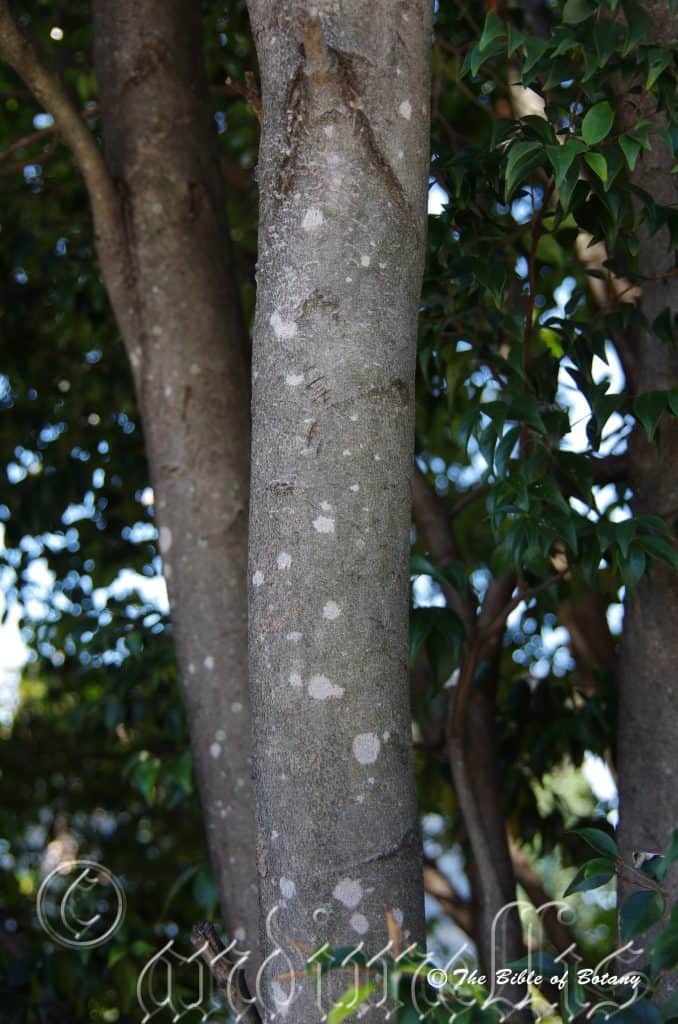
South Bank Brisbane Qld.
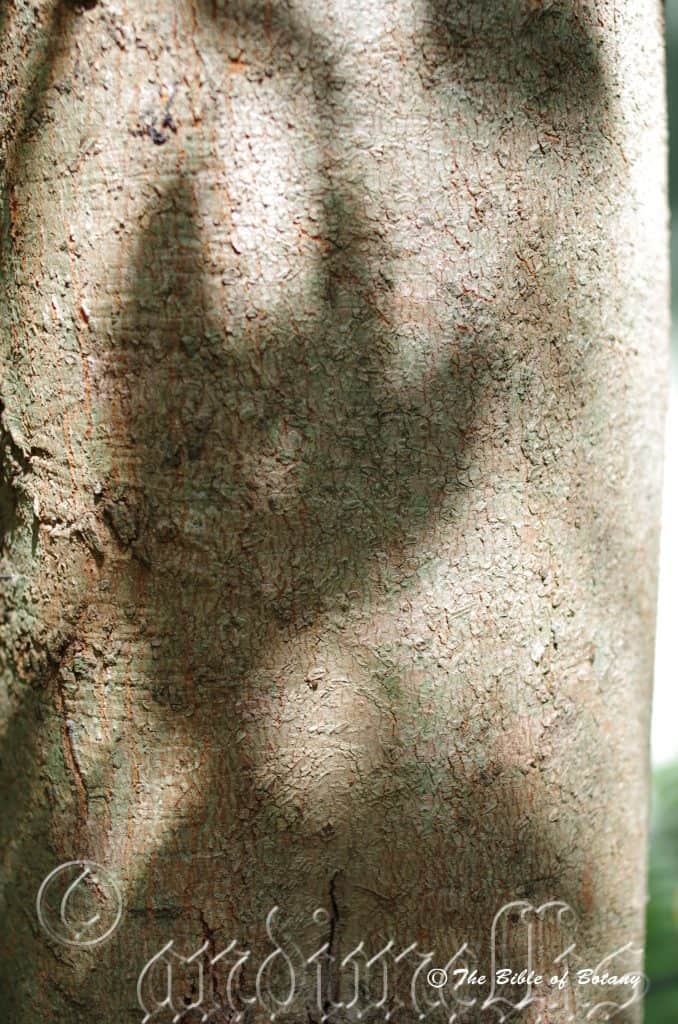
Grange Qld.
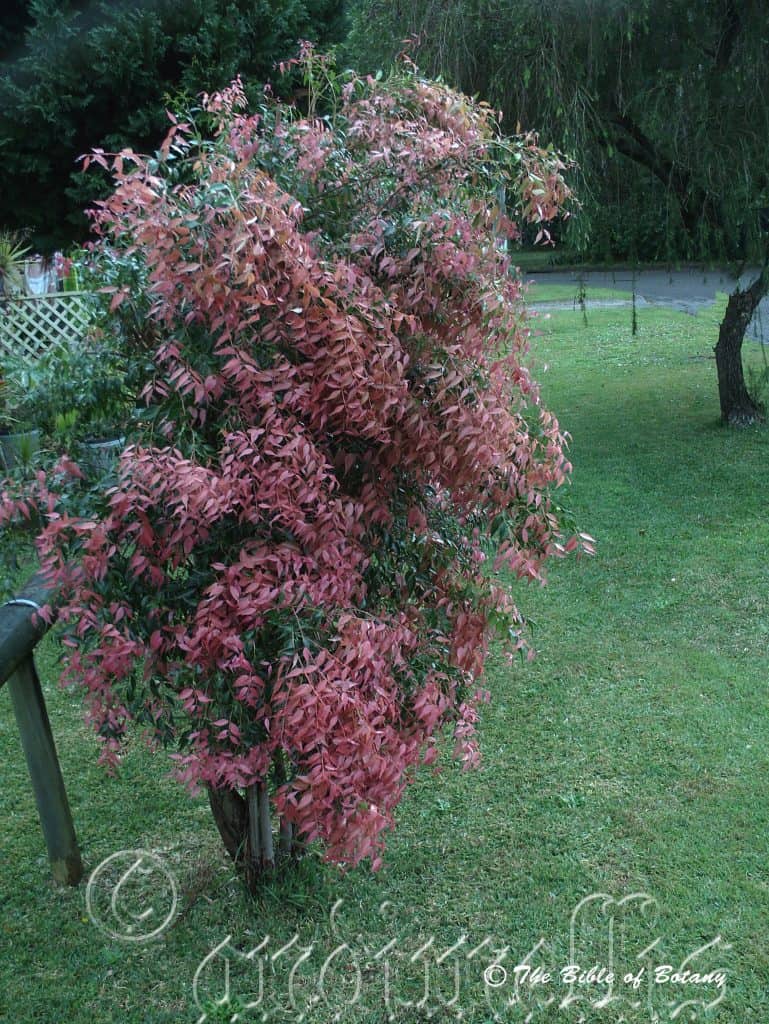
North Haven NSW
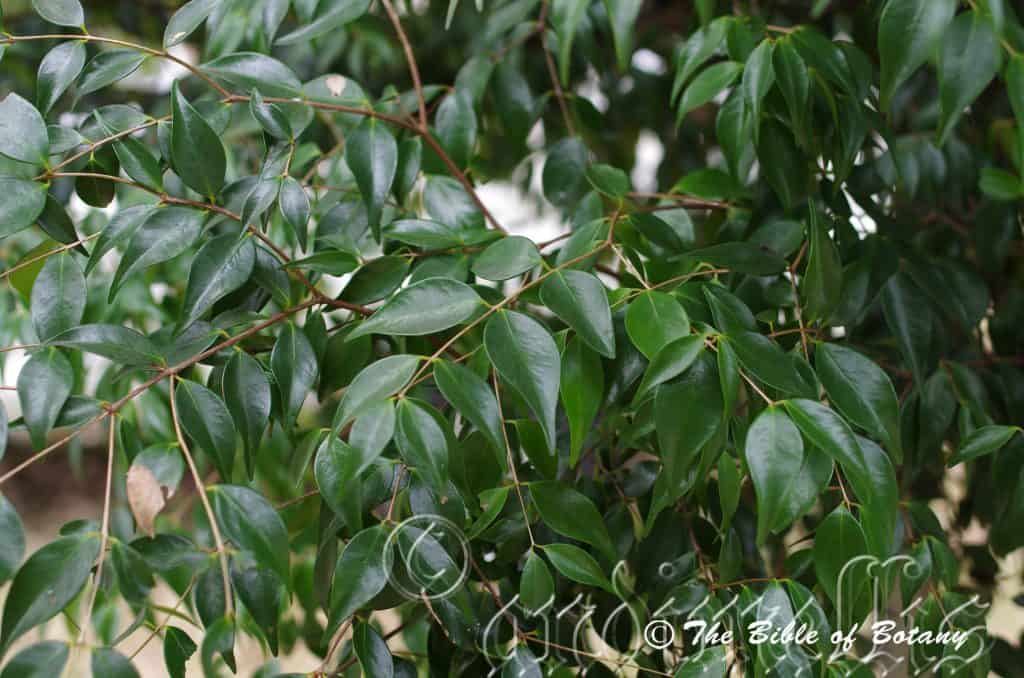
Kedron Qld.

South Bank Brisbane Qld.
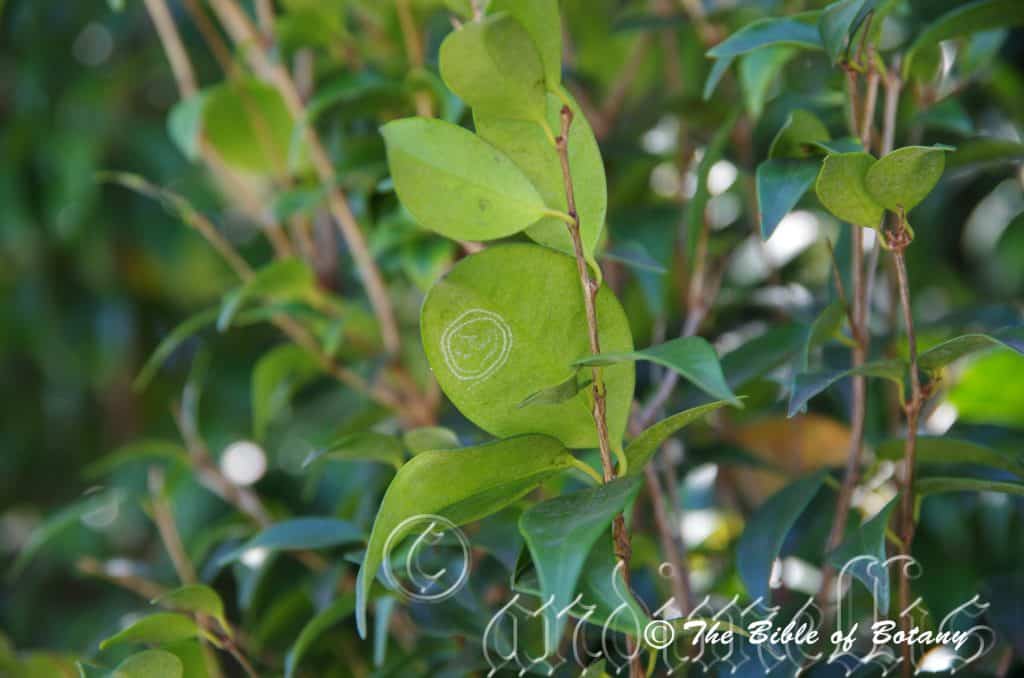
South Bank Brisbane Qld.
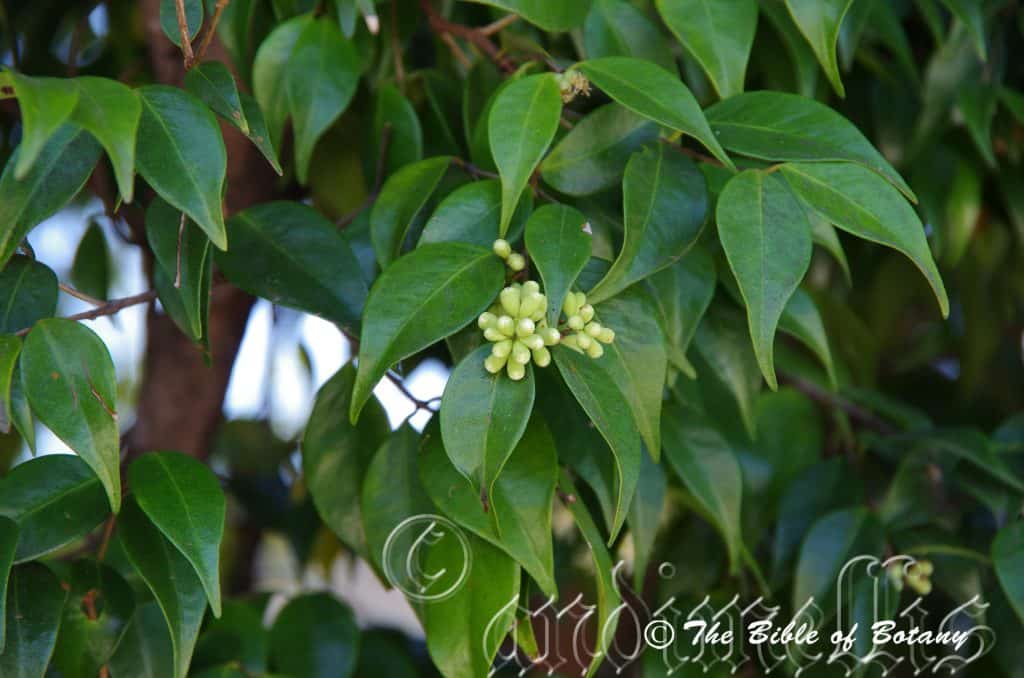
South Bank Brisbane Qld.

South Bank Brisbane Qld.

South Bank Brisbane Qld.

South Bank Brisbane Qld.

Author’s Garden The Pinnacles NSW

Seven Hills Qld.
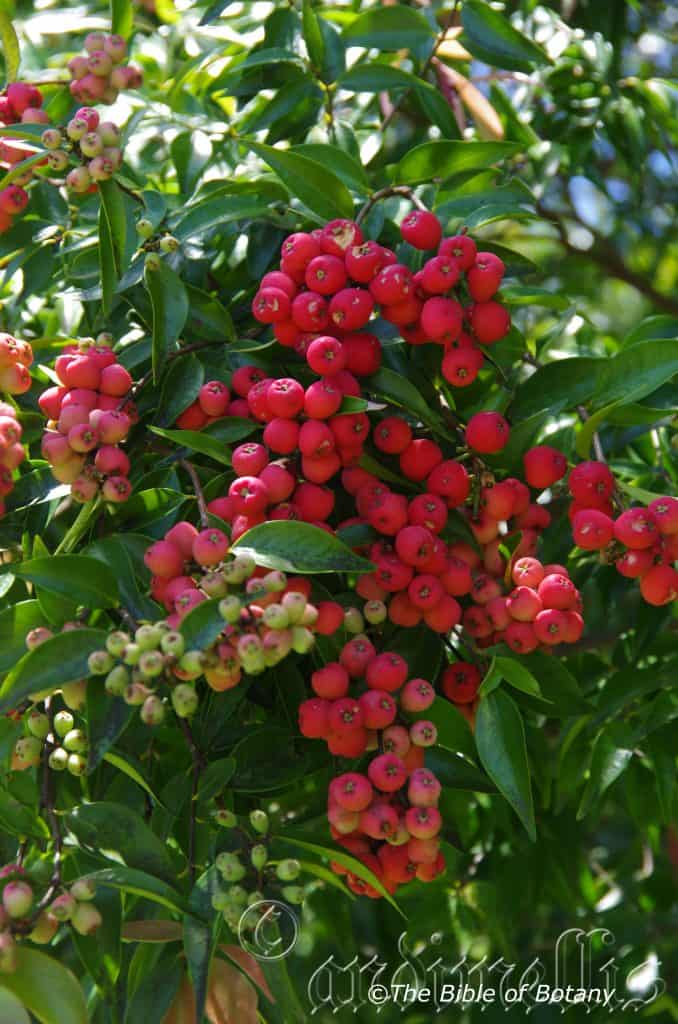
Author’s Garden The Pinnacles NSW
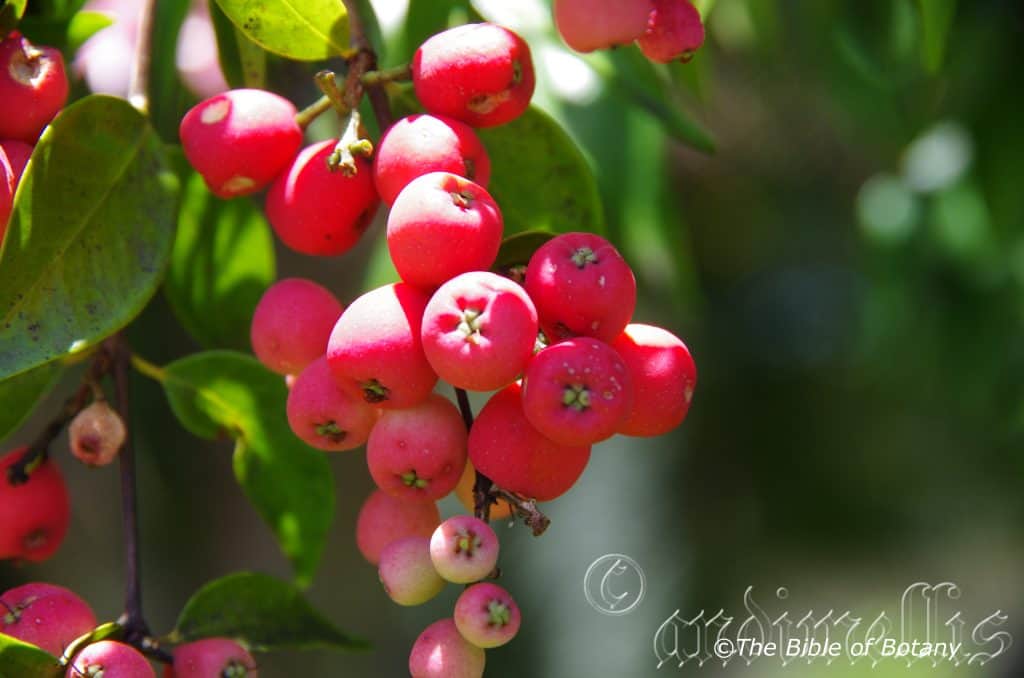
Author’s Garden The Pinnacles NSW

Norman Park Qld.
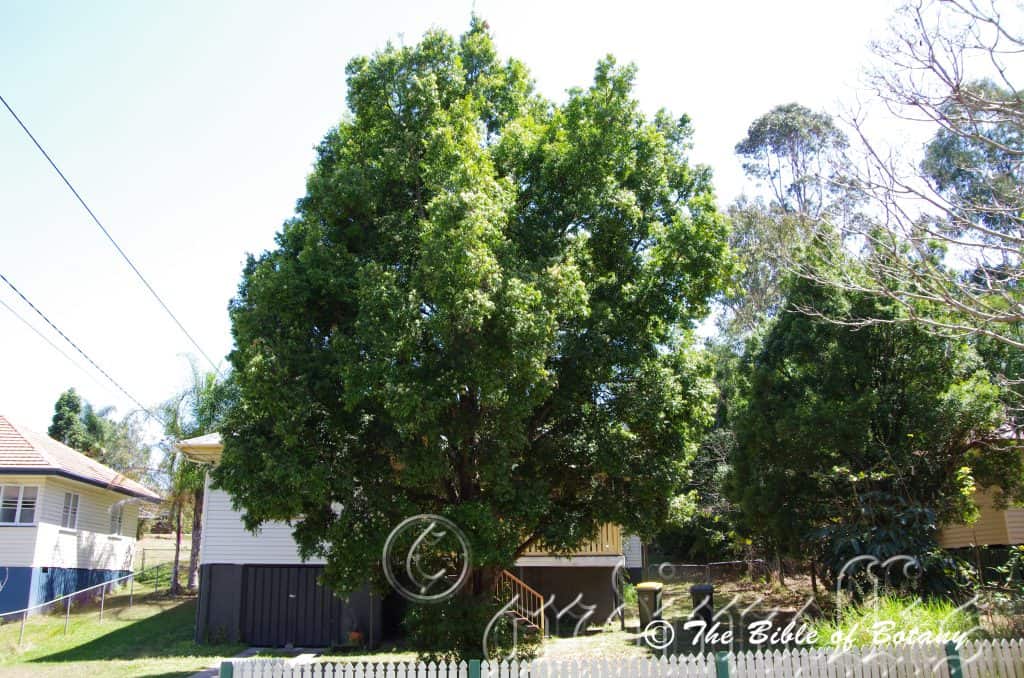
Morningside Qld.
Syzygium luehmannii
Classification:
Unranked: Eudicots
Class: Rosids
Order: Myrtales
Family: Myrtaceae
Subamily: Myrtoideae
Tribe: Syzygieae
Genus: From Súzugos, which is Ancient Greek or Syzygia, which is Latin for a pair or yoke together. It refers to leaves, which are joined together in pairs.
Specie: Is named in honour of Johann Georg Luehmann; 1843-1904, who was director of the Melbourne Botanic Gardens and herbarium.
Sub specie:
Common Name: Small Leaf Lillypilly or Riberry.
In the Gumbaynggirr language it is known as Jijimam.
Distribution:
Syzygium luehmannii is found in a several disjunct populations east of the Great Dividing Range from Cape Grafton and Cape Melville in far north Queensland to Kempsey in central coastal New South Wales.
https://avh.ala.org.au/occurrences/search?taxa=Syzygium+luehmannii#tab_mapView
Habitat Aspect Climate:
Syzygium luehmannii prefers dense shade to full sun. It grows adjacent to warm, moist sub-tropical rainforests, cool, moist tropical rainforests or most littoral rainforests. The altitude ranges from 5meters ASL to 1500 meters ASL.
The temperatures range from minus 2 degree in August to 36 degrees in January.
The rainfalls range from lows of 900mm to 3200mm average per annum.
Soil Requirements:
Syzygium luehmannii prefers light clays to heavy clays. The soils are usually derived from decomposed brown and black basalts or better quality alluvial flats. The soils pH ranges from 5pH to 6pH. It does not tolerate water logged soils however trees in riparian zones or gallery forests may experience periodic flooding for short periods. Non saline soils to moderately saline soils are tolerated.
Height & Spread:
Wild Plants: 25m to 35m by 12m to 16m
Characteristics:
The trunk of Syzygium luehmannii is tall, straight, pale reddish-brown to reddish-grey with large pale creamy fawn or pale creamy brown papery patches especially evident on larger trees. The bark is hard and corky. The branches are pale grey and only becoming pale green near the apex where the newer leaf growth occurs. The branchlets are glabrous.
The opposite, ovate to lanceolate leaves of Syzygium luehmannii measure 25mm to 75mm in length by 12mm to 30mm in width. The bases are round-cuneate rounded while the apexes are long acuminate. The discolourous laminas are deep sea- green, semi glossy and glabrous on the upper lamina while the lower lamina is paler and dull. The new growth is bright purple-pink and smothers the tree in 2 or 3 flushes a year. The leaf margins are entire, flat or slightly undulating while the margins recurve slightly from the mid vein to the margins. The mid veins are slightly prominent on the lower lamina and are faintly visible on the upper lamina. The petiole measures 2mm to 6mm in length.
Inflorescences of Syzygium luehmannii are born on short panicles or cymes from the upper leaf axils or terminals. The peduncles, racemes, pedicellates and pedicels are pale creamy green to pale creamy yellow. The measurements are vary variable with the peduncles measuring 2mm to 6mm in length, the rachises measure 4mm to 12mm in length while the pedunculates measure 4mm to 9mm in length and the pedicels measure 0.5mm to 1mm in length.
The calyxes and calyx lobes are pale creamy green to pale creamy yellow, semi glossy, externally and internally. The calyx tube is almost columular densely covered in fine tuberculate lumps. The calyx tubes measure 3.5mm to 5mm in length by 2.5mm to 3.5mm in diameter across the hypanthia. The 4 orbicular calyx lobes are concave. The lobes are covered in tuberculate lumps externally, glabrous internally and measure 1mm to 1.5mm in length by 2mm to 2.5mm in width. The 4 white petals are orbicular to ovate, covered in fine oil dots and measure 1.5mm to 3mm in length by 2mm to 3mm in diameter.
The 60 to 110 filaments are free for their entire length and form two dimorphic rings around the outer edge of the hypanthia inside the lobes. The outer filaments measure 4mm to 6.5mm in length while the inner filaments measure 3mm to 4mm in length. The filaments are white while the dorsifixed anthers are pastel yellow and measure 0.3mm to 0.5mm in length by 0.3mm to 0.4mm in width.
The white style and stigma are glabrous while the hypanthia disc is pale yellow to pale creamy yellow. The pistil measures 6.5mm to 9mm in length and are always longer than the stamens. Syzygium luehmannii flowers appear from October through to November.
The fruits of Syzygium luehmannii are pyriform to obovoidal berries. The berries are glabrous and measure 9mm to 12mm in length by 7mm to 11mm in diameter. The green capsules turn bright orange-pink externally and pastel pink to white internally when ripe. The calyx lobes are persistent on the ripe fruit. The single pale brown seeds are ovoidal, fleshy and measure 2.5mm to 5mm in diameter. The fruits ripen from late December through to early February.
Wildlife:
Syzygium luehmannii support native bees along the coast. It is a terrific sand stabilizer on the frontal dunes.
The fruits are edible and have a similar taste to apples or pears with a strong clove flavour. This is more apparent when the seeds are being cooked with the fruit. I have not been successful at producing a good jam from this fruit though many people rave about it. Sauces and chutneys are great from this fruit adding interest and flavour to a Bar B Que or even a vegetarian salad. The fruits can be stewed and used with ice cream or mixed with fresh fruit salads or anywhere, where cloves are required. For something unusual make syrup and use it as milk flavouring in drinks. The fruits freeze well and last in the freezer maintaining colour and flavour for at least 10 months so you can have the fruits for the whole year.
Cultivation:
Syzygium luehmannii is a beautiful small tree or large shrub that should be grown in association with other rainforest specie. It is ideal at the edge of a rain forest or deep in the center of the rainforest. It also makes a great park tree offering quick growth, and good shade. In cultivation it grows from 10 meters to 14 meters in height by 6 meters to 15 meters in diameter when grown in the open or taller and narrower if grown closer together as a rainforest tree.
Soil moisture, quality and temperatures will ultimately determine the final shape and size of the mature trees. Plant it away from buildings and services as they can grow to a fairly large tree.
It grows exceptionally well on lighter better quality soils where deep leaf litter keeps the soil cool and moisture at an even level. If these requirements are met it can cope with temperatures as low as minus 2 degrees and up to 36 degrees. If it is protected from the frosts by other trees and the days are warm lower temperatures may be acceptable. It is moderately drought resistant in their climatic zones once established.
It should be more widely grown with in temperate areas of Australia and tried at least as far south as Melbourne or Adelaide where very mild frosts prevail. They have gained widespread popularity for their beautiful foliage but with the copious quantities of colourful edible fruit really do warrant a place in most gardens. It suits medium to large gardens where they can be pruned on an annual basis or more regularly to increase bushiness and flowering or even to maintain them as a large shrub.
It is ideal for hedges and screens in full sun or semi shaded areas.
The flushes of new growth brighten the bush up and are worthwhile planting in small groups scattered throughout the bush for this quality alone.
The trees would make tremendous accent trees in front of low set commercial or industrial sheds where it breaks up hard rigid architectural lines and give warmth and breadth to a building. In front of high rise buildings it gives balance especially where it can be grown in curves meandering to the entry doors or for something different used from the front of the path and meander back to the far corners. The plants lend themselves beautifully if scattered randomly as the only plants on display. Here to add variety they can be grow as single trunk trees and pruned as smaller multi stemmed shrubs.
It can be maintained with heavy pruning as a standalone topiary piece of art or espalier art on a fence or wall. It is also an ideal tree for bonsai work being fast to recover give good colour and easy to work.
This Syzygium has potential to be cultivated for its fruit and culinary dishes. Plants should be grown in rows 6 meters apart with 6 meter centers. Annual pruning would be necessary to maintain the trees at a height where the fruit can be harvested. The trees are prolific fruiters with several plants on the market now that produce small quantities of seed. Good trees at 4 meters by 3 meters will produce 30 to 40 kilograms of fresh fruit a year when supplied our natural fertilizer regime. Trees must be protected from frosts as frosts are detrimental to fruit quantity but not quality.
The trees are susceptible to Psyllidae or pimple gall especially when grow in a monoculture or where neighbours use chemical or nonspecific controls. Psyllids can make a tree look terrible, even ghastly when the black sugar mould entirely covers the trees. Control is best achieved by supporting the natural enemies of the many varieties of Psyllids.
Psyllaephagus specie is small predatory wasps which feed exclusively on psyllids. The female adult wasp lays an egg into the psyllid nymph before the lerp becomes impenetrable to the wasp.
Other hunters of Psyllids include the beautiful Lacewing and ladybirds and their larvae also feed on the psyllid nymphs. Birds, particularly swallows, have been observed flying around badly affected trees when adult psyllids are numerous, and eat adult psyllids. I also suspect that thornbills and silver eyes to play a role in the control of most types of Psyllids as do the bell miners and noisy miner. Spiders which build their webs in trees account for a large number of adults and other small flying insects.
Propagation:
Seeds: The seeds of Syzygium luehmannii can be removed easily from the fruits.
Sow fresh seeds directly into a seed raising mix, keeping them moist not wet. Do not over water as the seeds will rot off before germination takes place. Place the trays in a cool shaded area with 50mm shade cloth in the bush house. When the seedlings are 20mm to 25mm tall, prick them out and plant them into 50mm native tubes using a good organic mix.
As the seedlings roots reach the bottom of the tubes plant them out into their permanent position. Do not delay.
Fertilize using Seaweed, fish emulsion or organic chicken pellets soaked in water and apply the liquid on an alternate basis. Fertilize every 2 months until the plants are well established then on an annual basis in September or March to maintain health, vigour and better flowering.
Further Comments from Readers:
“Hi reader, it seems you use The Bible of Botany a lot. That’s great as we have great pleasure in bringing it to you! It’s a little awkward for us to ask, but our first aim is to purchase land approximately 1,600 hectares to link several parcels of N.P. into one at The Pinnacles NSW Australia, but we need your help. We’re not salespeople. We’re amateur botanists who have dedicated over 30 years to saving the environment in a practical way. We depend on donations to reach our goal. If you donate just $5, the price of your coffee this Sunday, We can help to keep the planet alive in a real way and continue to bring you regular updates and features on Australian plants all in one Botanical Bible. Any support is greatly appreciated. Thank you.”
In the spirit of reconciliation we acknowledge the Bundjalung, Gumbaynggirr and Yaegl and all aboriginal nations throughout Australia and their connections to land, sea and community. We pay our respect to their Elders past, present and future for the pleasures we have gained.

Townsville Qld.
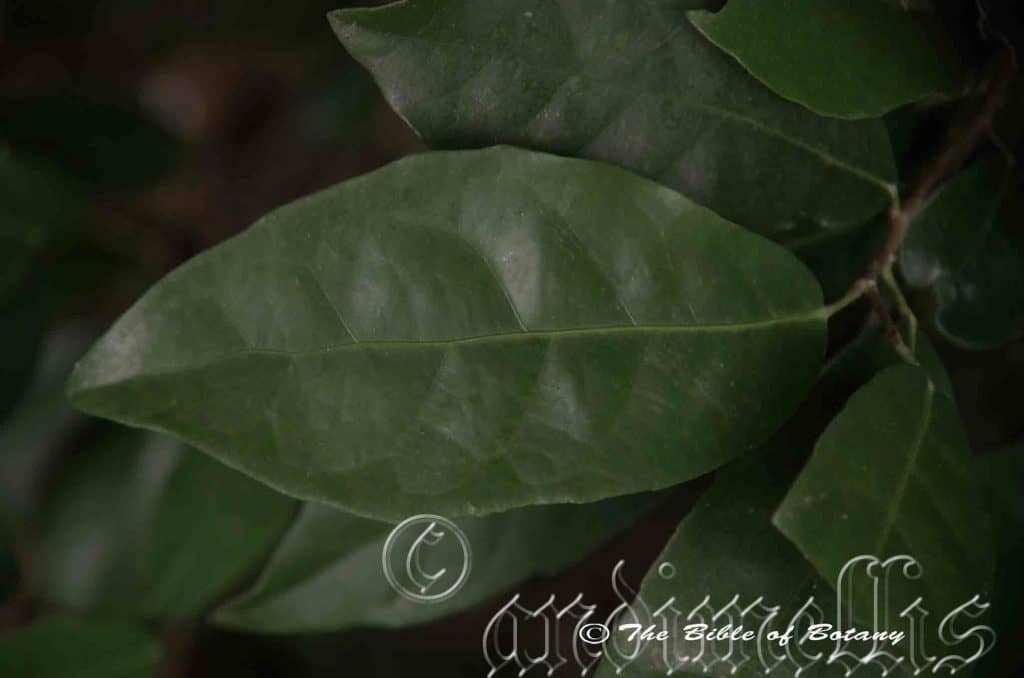
Townsville Qld.
Syzygium malaccense
Classification:
Unranked: Eudicots
Class: Rosids
Order: Myrtales
Family: Myrtaceae
Subamily: Myrtoideae
Tribe: Syzygieae
Genus: From Súzugos, which is Ancient Greek or Syzygia, which is Latin for a pair or yoke together. It refers to leaves, which are joined together in pairs.
Specie: From Malacca, which is Latin for the region around Sumatra and south eastern portion of Asia and Anum/Ensis, which is Latin for to originate from. It refers to plants, which were first discovered in the eastern portion of South Eastern Asia.
Sub specie:
Common Name: Malay Apple.
Distribution:
Syzygium malaccense is found in 4 disjunct populations from the Torres Straight Islands and Cape York Peninsular and south from the Iron Range National Park to west of Cape Grafton and from Cooktown to Cairns in far north Queensland. It is found east of the Great Dividing Range.
It is also found in the Bismarck Archipelago, Cambodia, Laos, Malaya, Myanmar, New Guinea, Papua, Solomon Islands, Thailand, Vanuatu and Vietnam.
https://avh.ala.org.au/occurrences/search?taxa=Syzygium+malaccense#tab_mapView
Habitat Aspect Climate:
Syzygium malaccense prefers dense shade to full sun. It grows in and adjacent to warm, dry temperate rainforests or warm gallery rainforests close to the coast. The altitude ranges from 2 meters ASL to 110 meters ASL.
The temperatures range from 10 degree in August to 36 degrees in January.
The rainfalls range from lows of 1600mm to 3200mm average per annum.
Soil Requirements:
Syzygium malaccense prefers sandy loams and peaty sands through to medium clays. The soils are usually derived from decomposed brown basalts, black basalts, podsolic soils, granites or at times accumulated beach sands. The soils pH ranges from 5pH to 6.5pH. It does not tolerate water logged soils however trees in riparian zones or gallery forests may experience periodic flooding for short periods. Non saline soils to moderately saline soils are tolerated.
Height & Spread:
Wild Plants: 9m to 18m by 6m to 8m.
Characteristics:
Syzygium malaccense grows as a small to medium trees with straight, grey, rough, scabrous trunk. The bark is hard and somewhat flaky on the branches. The branchlets are pale grey, scabrous and only becoming pale green near the apex where the newer leaf growth occurs.
The opposite, ovate to elliptical leaves of Syzygium malaccense measure 110mm to 150mm in length by 40mm to 70mm in width. The bases are broad cuneate while the apexes are acute to acuminate and twisted. The discolourous laminas are deep green, semi glossy and glabrous on the upper lamina while the lower lamina is paler and dull. The new growth is pale auburn-green and glossy. The leaf margins are entire, flat and curve downwards near the apex. The mid veins are strongly prominent and main laterals are slightly prominent on the lower laminas while the main vein is distinctly visible and depressed near the base and flush on the apex half. The lateral veins are faintly visible on the upper lamina. The petioles measure 8mm to 15mm in length.
Inflorescences of Syzygium malaccense are born on short panicles or cymes from the lower leaf axils or are ramiflorously. The peduncles are brown and scabrous while the racemes, pedicellates and pedicels are green. The peduncles measure 10mm to 18mm in length, the rachises measure 18mm to 30mm in length while the pedunculates measure 15mm to 30mm in length and the pedicels measure 6mm to 9mm in length.
The calyxes and calyx lobes are pale creamy green to pale creamy yellow to pale creamy green, dull, externally and internally. The conical calyx tube is glabrous. The calyx tubes measure 6mm to 9mm in length by 4mm to 8mm in diameter across the hypanthia. The 4 erect dimorphic, orbicular calyx lobes are concave and measure 2mm to 4mm in length. The 4 rarely white, pale pink to deep carmine-pink petals are orbicular to ovate, and deeply concave. The petals are densely covered in fine oil dots and measure 6mm to 9mm in length by 6mm to 9mm in diameter.
The 96 to 126 exserted filaments are free for their entire length and form two dimorphic rings around the outer edge of the hypanthia inside the lobes. The outer filaments measure 12mm to 20mm in length while the inner filaments measure 6mm to 12mm in length. The filaments are rarely white, pale pink to deep carmine-pink while the dorsifixed anthers are white to cream and measure 1mm to 1.4mm in length by 0.8mm to 1.2mm in width.
The white, pale pink to deep carmine-pink style and stigma are glabrous while the hypanthia disc is pale pink to pastel creamy yellow-pink. The pistil measures 18mm to 25mm in length and are always longer than the stamens. Syzygium malaccense flowers appear from September through to March in two or three main flushes.
The fruits of Syzygium malaccense are pyriform drupes and ripen about 60 days after flowering. The large berries are glabrous and measure 27mm to 38mm in length by 18mm to 26mm in diameter. The green berries turn scarlet red externally and white internally when ripe. The calyx lobes are persistent on the ripe fruit. The pericarp is succulent. The single pale brown seeds are spherical and fleshy.
Wildlife:
Syzygium malaccense’s flowers support native colony bees like Tetragonula carbonaria and nectar eating birds.
The fruits are eaten by many native birds, possums and Flying foxes.
The fruits are edible and have a taste reminiscent of pears with a watermelon texture. The fresh fruits have a good shelf life and are grown in China, Malaysia, Vietnam and Thailand commercially for the fresh fruit market.
Cultivation:
Syzygium malaccense is a beautiful small tree that should be grown in association with other rainforest specie. It is ideal at the edge of a rain forest or deep in the center of the rainforest. It also makes a great park tree offering quick growth, and good shade. In cultivation it grows from 8 meters to 12 meters in height by 8 meters to 12 meters in diameter when grown in the open or taller and narrower if grown closer together as a rainforest tree.
Soil moisture, quality and temperatures will ultimately determine the final shape and size of the mature trees. Plant them away from buildings and services as they can have a fairly large spread.
It grows exceptionally well on medium better quality soils where deep leaf litter keeps the soil cool and moisture at an even level. If these requirements are met it can cope with temperatures as low as 2 degrees and up to 36 degrees. If it is protected from the frosts by other trees and the days are warm lower temperatures may be acceptable. It is moderately drought resistant in their climatic zones once established.
It should be more widely grown with in temperate areas of Australia and tried at least as far south as Coffs Harbour in frost free areas. They have not gained widespread popularity but with the copious quantities of large, glossy, red colourful edible fruit they really do warrant a place in most gardens. It suits medium to large gardens where they can be pruned on an annual basis or more regularly to increase bushiness and flowering or even to maintain them as a large shrub.
It is ideal for hedges and screens in full sun or semi shaded areas.
The flushes of new growth brighten the bush up and are worthwhile planting in small groups scattered throughout the bush for this quality alone.
The trees would make tremendous accent trees in front of low set commercial, industrial sheds or school buildings where it breaks up hard rigid architectural lines and give warmth and breadth to a building. In front of high rise buildings they give balance especially where they could be grown in curves meandering to the entry doors or for something different used from the front of the path and meander back to the far corners. The plants lend themselves beautifully if scattered randomly as the only plants on display. Here to add variety they can be grow as single trunk trees and pruned as smaller multi stemmed shrubs.
It can be maintained with heavy pruning as a standalone topiary piece of art or espalier art on a fence or wall. It is also ideal trees for bonsai work being fast to recover give good colour and easy to work.
The trees are occasionally attacked by Psyllidae or pimple gall especially when grow in a monoculture or where neighbours use chemical or nonspecific controls. Psyllids can make a tree look terrible, even ghastly when the black sugar mould entirely covers the trees. Control is best achieved by supporting the natural enemies of the many varieties of Psyllids.
Psyllaephagus specie is small predatory wasps which feed exclusively on psyllids. The female adult wasp lays an egg into the psyllid nymph before the lerp becomes impenetrable to the wasp. Other hunters of Psyllids include the beautiful Lacewing and ladybirds and their larvae also feed on the psyllid nymphs. Birds, particularly swallows, have been observed flying around badly affected trees when adult psyllids are numerous, and eat adult psyllids. I also suspect that thornbills and silver eyes to play a role in the control of most types of Psyllids as do the bell miners and noisy miner. Spiders which build their webs in trees account for a large number of adults and other small flying insects.
This Syzygium has potential to be cultivated for its fruit and culinary dishes. Plants should be grown in rows 10 meters apart with 12 meter centers. Annual pruning would be necessary to maintain the trees at a height where the fruit can be harvested. The trees are prolific fruiters with several plants on the market now that produce small quantities of seed. Good trees at 8 meters by 10 meters will produce 60 to 70 kilograms of fresh fruit a year when supplied our natural fertilizer regime. Trees must be protected from frosts and these will be detrimental to fruit quantity but not quality. At present prices in China (20.04.2014) the fruits are selling for 92 yuan or about $12.00 to $13.00 a kilogram for organically certified fruit and about $5.50 to $6.00 for chemically produced fruits. Townsville farmers would find it worthwhile investing in trees for the local or export market. At the 2014 organic price (equivalent) at the farm gate of around $5.00+ a kilogram that is approximately $300 to $350 dollars a tree. The trees are low maintenance require low fertilizer input however good soil moisture is an absolute necessity for good production. The downside would be harvesting the fruit on taller well shaped trees. Fruit eaters like the Grey Headed Flying Fox (Pteropus poliocephalus), theLittle red flying fox, Pteropus scapulatus and the beautiful little Sugar Glider, Petaurus breviceps).
Propagation:
Seeds: The seeds of Syzygium malaccense can be removed easily from the fruits.
Sow the seeds directly into a seed raising mix, keeping them moist not wet. Do not over water as the seeds will rot off before germination takes place. Place the trays in a cool shaded area with 50mm shade cloth in the bush house. When the seedlings are 20mm to 25mm tall, prick them out and plant them into 50mm native tubes using a good organic mix.
As the seedlings roots reach the bottom of the tubes plant them out into their permanent position. Do not delay.
Fertilize using Seaweed, fish emulsion or organic chicken pellets soaked in water and apply the liquid on an alternate basis. Fertilize every 2 months until the plants are well established then on an annual basis in September or March to maintain health, vigour and better flowering.
Further Comments from Readers:
“Hi reader, it seems you use The Bible of Botany a lot. That’s great as we have great pleasure in bringing it to you! It’s a little awkward for us to ask, but our first aim is to purchase land approximately 1,600 hectares to link several parcels of N.P. into one at The Pinnacles NSW Australia, but we need your help. We’re not salespeople. We’re amateur botanists who have dedicated over 30 years to saving the environment in a practical way. We depend on donations to reach our goal. If you donate just $5, the price of your coffee this Sunday, We can help to keep the planet alive in a real way and continue to bring you regular updates and features on Australian plants all in one Botanical Bible. Any support is greatly appreciated. Thank you.”
In the spirit of reconciliation we acknowledge the Bundjalung, Gumbaynggirr and Yaegl and all aboriginal nations throughout Australia and their connections to land, sea and community. We pay our respect to their Elders past, present and future for the pleasures we have gained.
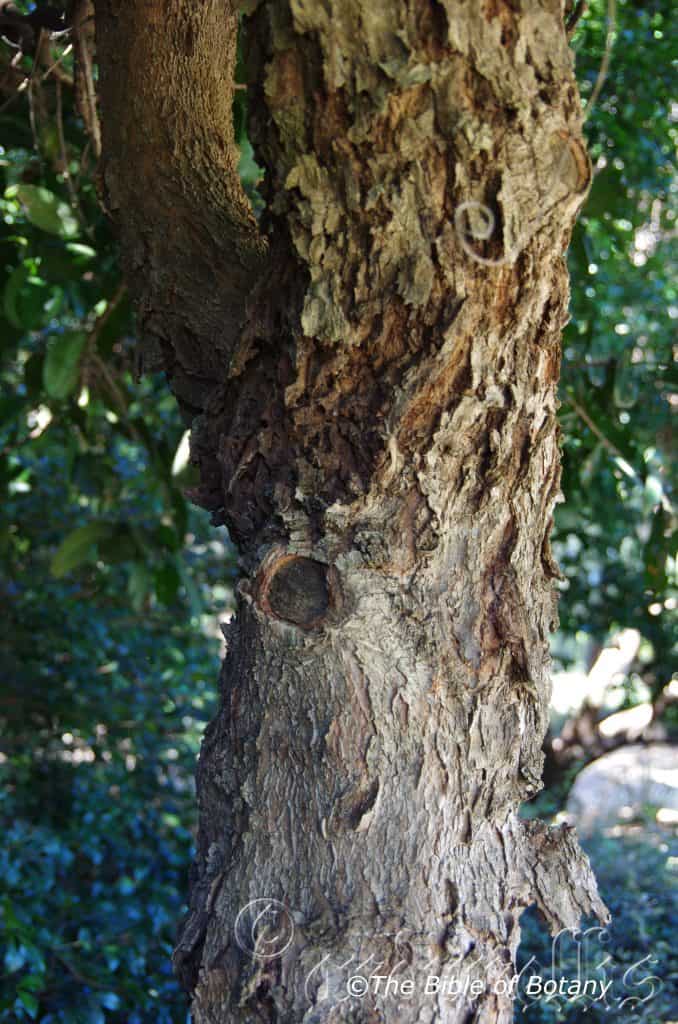
Rosser Gardens Benowa Qld.
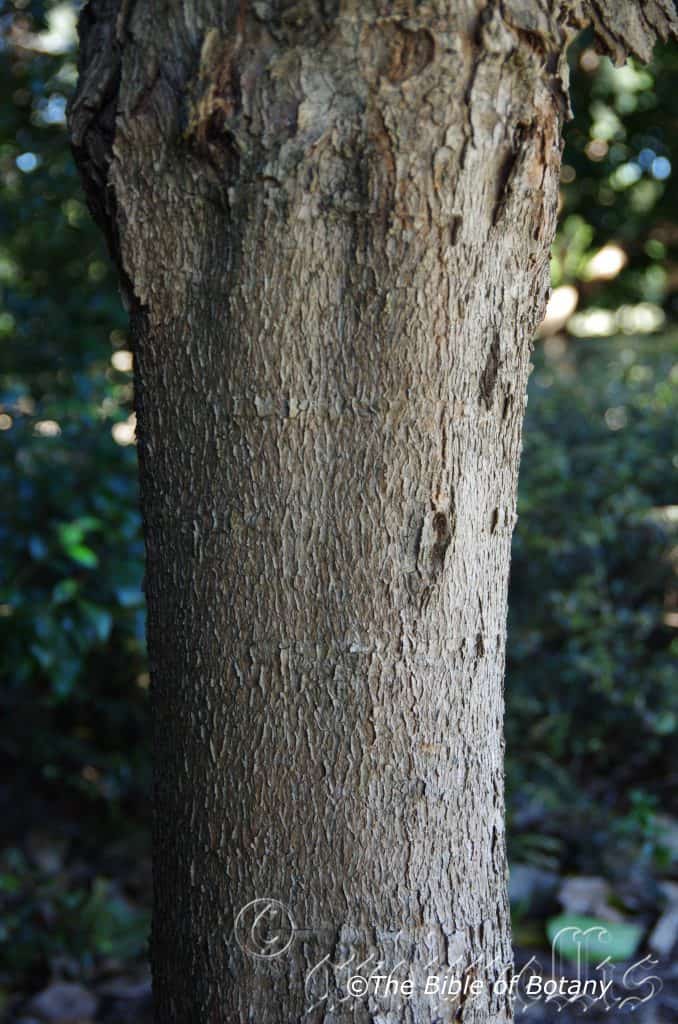
Rosser Gardens Benowa Qld.

Mount Nebo Qld.
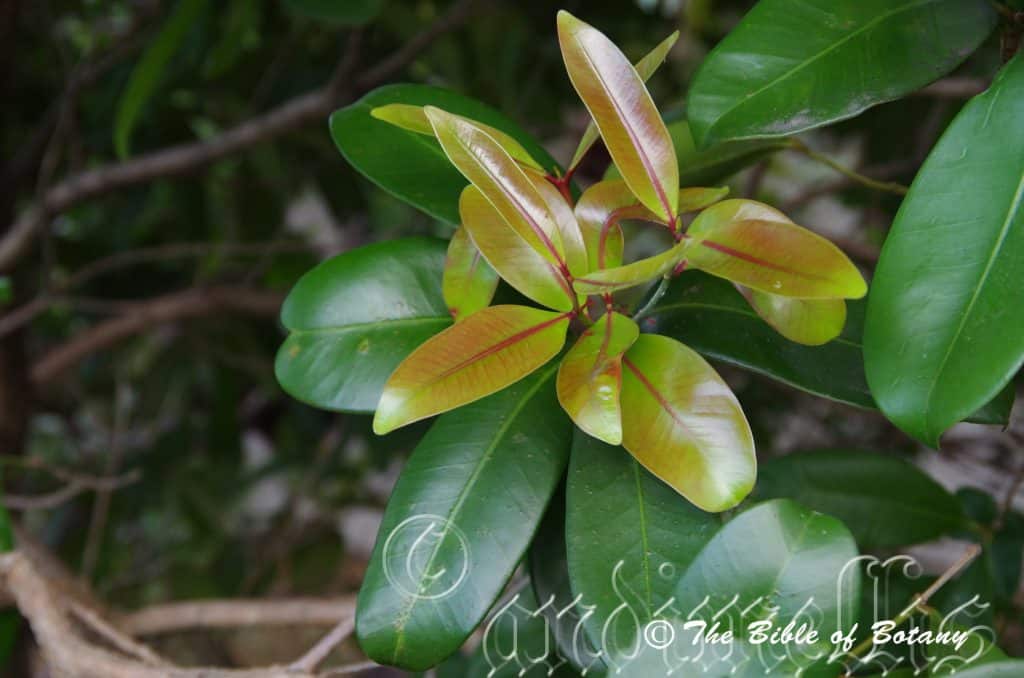
Rosser Gardens Benowa Qld.

Rosser Gardens Benowa Qld.

Rosser Gardens Benowa Qld.

Rosser Gardens Benowa Qld.
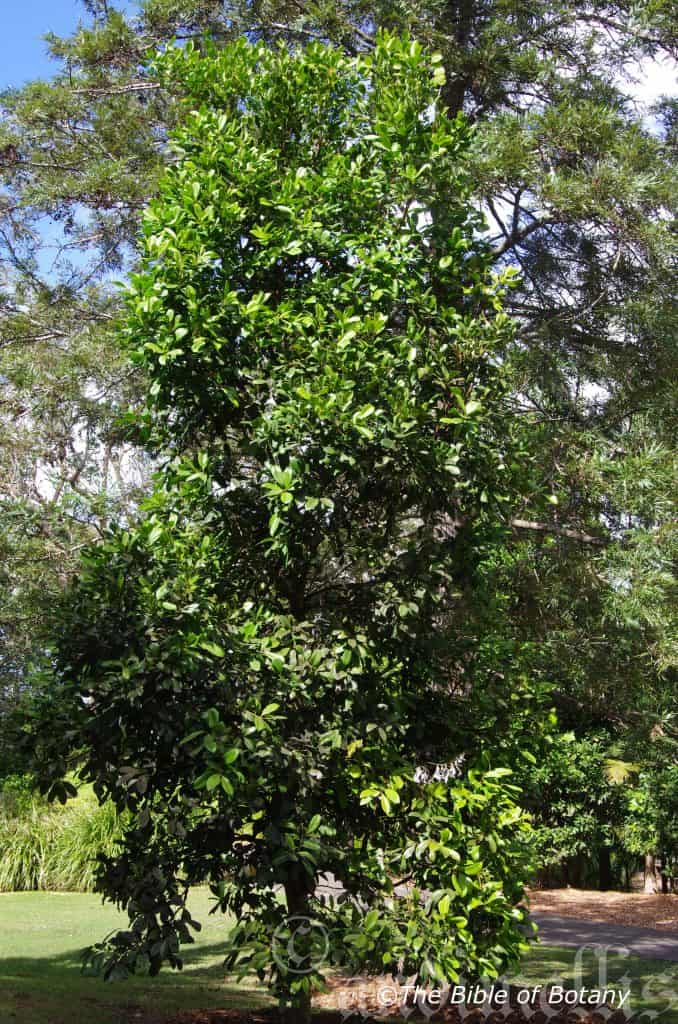
Rosser Gardens Benowa Qld.
Syzygium moorei
Classification:
Unranked: Eudicots
Class: Rosids
Order: Myrtales
Family: Myrtaceae
Subamily: Myrtoideae
Tribe: Syzygieae
Genus: From Súzugos, which is Ancient Greek or Syzygia, which is Latin for a pair or yoke together. It refers to leaves, which are joined together in pairs.
Specie: Is named in honour of Moore but which Moore cannot be substantiated.
Sub specie:
Common Name: Coolamon, Rose Apple or Durobby.
Distribution:
Syzygium moorei is restricted to a small area between the Currumbin Valley in south eastern Queensland and the Richmond River in northern New South Wales.
https://avh.ala.org.au/occurrences/search?taxa=Syzygium+moorei#tab_mapView
Habitat Aspect Climate:
Syzygium moorei prefers dense shade to light partial shade or at times filtered sun light. It grows adjacent to warm, moist, lowland subtropical rainforests especially on river flats or alluvial deposits. The altitude ranges from 12 meters ASL to 30 meters ASL.
The temperatures range from minus 1 degree in August to 34 degrees in January.
The rainfalls range from lows of 1200mm to 2000mm average per annum.
Soil Requirements:
Syzygium moorei prefers better quality light clays to medium clays. The soils are usually derived from decomposed brown basalts, black basalts or shale. The soils pH ranges from 5pH to 6pH. It does not tolerate water logged soils however trees in riparian zones or gallery forests may experience periodic flooding for short periods. Non saline soils to moderately saline soils are tolerated.
Height & Spread:
Wild Plants: 25m to 40m by 12m to 16m.
Characteristics:
Syzygium moorei grows as a tall large tree with a straight, pale grey to mid grey, rough tessellated bark. The branches are pale grey and tessellated to flaky. The branchlets are pale grey glabrous becoming pale green close to where the leaf growth occurs.
The opposite, oblong, broadly elliptical or obovate leaves of Syzygium moorei are thickly coriaceous and measure 90mm to 160mm in length by 35mm to 80mm in width. The bases are broad cuneate, tapering to being attenuate while the apexes are obtuse or shortly acuminate. The discolourous laminas are glossy grass-green, and glabrous on the upper lamina while the lower lamina is slightly paler and dull. The new leaves are glossy bright lime green. The leaf margins are entire while the laminas are flat recurve slightly from the mid vein to the margins and decurve near the apex. The mid veins are strongly prominent on the lower laminas especially near the base becoming less so as they approach the apex. The petiole measures 2mm to 10mm in length.
Inflorescences of Syzygium moorei are born on panicles from the lower leaf axils, ramiflorously and occasionally cauliforously from the upper trunk. The peduncles are brown and scabrous while the racemes, pedicellates and pedicels are green and glabrous. The peduncles measure 5mm to 10mm in length, the rachises measure 12mm to 20mm in length while the pedunculates measure 8mm to 12mm in length and the pedicels measure 2mm to 4mm in length. Often there is a secondary pedunculate which also measures 8mm to 12mm in length.
The calyxes and calyx lobes are pale creamy yellow tinged crimson, dull, externally and internally. The broad campanulate calyx tube is glabrous. The calyx tubes measure 6mm to 9mm in length by 4mm to 7mm in diameter across the hypanthia. The 4 erect orbicular calyx lobes measure 0.5mm to less than 1mm in length. The 4 pale pink to deep carmine-pink petals are orbicular to ovate, and deeply concave. The petals are densely covered in fine oil dots and measure 3mm to 5.5mm in length by 3mm to 5mm in diameter.
The 66 to 110 exserted filaments are free for their entire length and form two dimorphic rings around the outer edge of the hypanthia inside the lobes. The outer filaments measure 8mm to 16mm in length while the inner filaments measure 5mm to 9mm in length. The filaments are pale pink to deep carmine-pink while the dorsifixed anthers are white and measure 0.6mm to 0.8mm in length by 0.6mm to 0.8mm in width.
The pale pink to deep carmine-pink style and stigma are glabrous while the hypanthia disc is pale pink to pastel creamy yellow-pink. The pistil measures 8mm to 16mm in length and are as long as the longest stamens. Syzygium moorei flowers appear from November through to March.
The fruits of Syzygium moorei are spherical berries. The large berries are glabrous and measure 20mm to 30mm in length by 35mm to 50mm in diameter. The green capsules turn white to creamy white or very pale creamy green externally and white internally when ripe. The calyx lobes are persistent on the ripe fruit. The single off white to pale creamy fawn seeds are flattened ellipsoidal and fleshy. The seeds measure 11mm to 18mm in length by 18mm to 25mm in diameter.
Wildlife:
Syzygium moorei support native bees, insects and birds during the day and possums and flying foxes at night. The fruits were a very important food source for possums, flying foxes, native marsupials and are also devoured by rainbow lorikeets and the sulphur crested and black cockatoos.
The fruits are edible and have a sweet, acid flavour reminiscent of loquats with a slight after taste of eucalyptus. The fruits would be worthwhile experimenting with in the kitchen if large enough quantities can be secured.
Cultivation:
Syzygium moorei is a beautiful large spreading tree that should be grown in association with other rainforest specie. It is ideal at the edge of a rain forest or deep in the center of the rainforest. They also make great park trees offering quick growth, and good shade. In cultivation it grows from 10 meters to 15 meters in height by 10 meters to 15 meters in diameter when grown in the open or taller and narrower if grown closer together as a rainforest tree. They often grow tall and narrow in the early years before starting to spread.
Soil moisture, quality and temperatures will ultimately determine the final shape and size of the mature trees. Plant it away from buildings and services as they have a fairly large spread so would only be suitable for large to very large gardens.
It grows exceptionally well on medium better quality, deep loams prevail and where deep leaf litter keeps the soil cool and moisture at an even level. If these requirements are met it can cope with temperatures as low as 3 degrees and up to 36 degrees. If it is protected from the frosts by other trees and the days are warm lower temperatures may be acceptable. It prefers year round moisture even when established.
It should be more widely grown with in temperate areas of Australia and tried at least as far south as Melbourne and Adelaide where only light frosts prevail or to north eastern Queensland in cooler mountainous areas. It has not gained widespread popularity but with the copious quantities of large, white edible fruit they really do warrant a place in most gardens.
The trees would make tremendous accent trees in front of low set commercial, industrial sheds or school buildings where it breaks up hard rigid architectural lines and give warmth and breadth to a building. In front of high rise buildings it gives balance especially where they could be grown in curves meandering to the entry doors or for something different used from the front of the path and meander back to the far corners. The plants lend themselves beautifully if scattered randomly as the only plants on display. Here to add variety they can be grow as single trunk trees and pruned as smaller multi stemmed shrubs.
It is also an ideal tree for bonsai work being fast to recover give good colour and easy to work.
This Syzygium has potential to be cultivated for its fruit and culinary dishes. Plants should be grown in rows 20 meters apart with 20 meter centers.
The trees are occasionally attacked by Psyllidae or pimple gall especially when grow in a monoculture or where neighbours use chemical or nonspecific controls. Psyllids can make a tree look terrible, even ghastly when the black sugar mould entirely covers the trees. Control is best achieved by supporting the natural enemies of the many varieties of Psyllids.
Psyllaephagus specie is small predatory wasps which feed exclusively on psyllids. The female adult wasp lays an egg into the psyllid nymph before the lerp becomes impenetrable to the wasp. Other hunters of Psyllids include the beautiful Lacewing and ladybirds and their larvae also feed on the psyllid nymphs. Birds, particularly swallows, have been observed flying around badly affected trees when adult psyllids are numerous, and eat adult psyllids. I also suspect that thornbills and silver eyes to play a role in the control of most types of Psyllids as do the bell miners and noisy miner. Spiders which build their webs in trees account for a large number of adults and other small flying insects.
Propagation:
Seeds: The seeds of Syzygium moorei can be removed easily from the fruits.
Sow fresh seeds directly into a seed raising mix, keeping them moist not wet. Do not over water as the seeds will rot off before germination takes place. Place the trays in a cool shaded area with 50mm shade cloth in the bush house. When the seedlings are 20mm to 25mm tall, prick them out and plant them into 50mm native tubes using a good organic mix.
As the seedlings roots reach the bottom of the tubes plant them out into their permanent position. Do not delay.
Fertilize using Seaweed, fish emulsion or organic chicken pellets soaked in water and apply the liquid on an alternate basis. Fertilize every 2 months until the plants are well established then on an annual basis in September or March to maintain better health, vitality and flowering.
Further Comments from Readers:
“Hi reader, it seems you use The Bible of Botany a lot. That’s great as we have great pleasure in bringing it to you! It’s a little awkward for us to ask, but our first aim is to purchase land approximately 1,600 hectares to link several parcels of N.P. into one at The Pinnacles NSW Australia, but we need your help. We’re not salespeople. We’re amateur botanists who have dedicated over 30 years to saving the environment in a practical way. We depend on donations to reach our goal. If you donate just $5, the price of your coffee this Sunday, We can help to keep the planet alive in a real way and continue to bring you regular updates and features on Australian plants all in one Botanical Bible. Any support is greatly appreciated. Thank you.”
In the spirit of reconciliation we acknowledge the Bundjalung, Gumbaynggirr and Yaegl and all aboriginal nations throughout Australia and their connections to land, sea and community. We pay our respect to their Elders past, present and future for the pleasures we have gained.
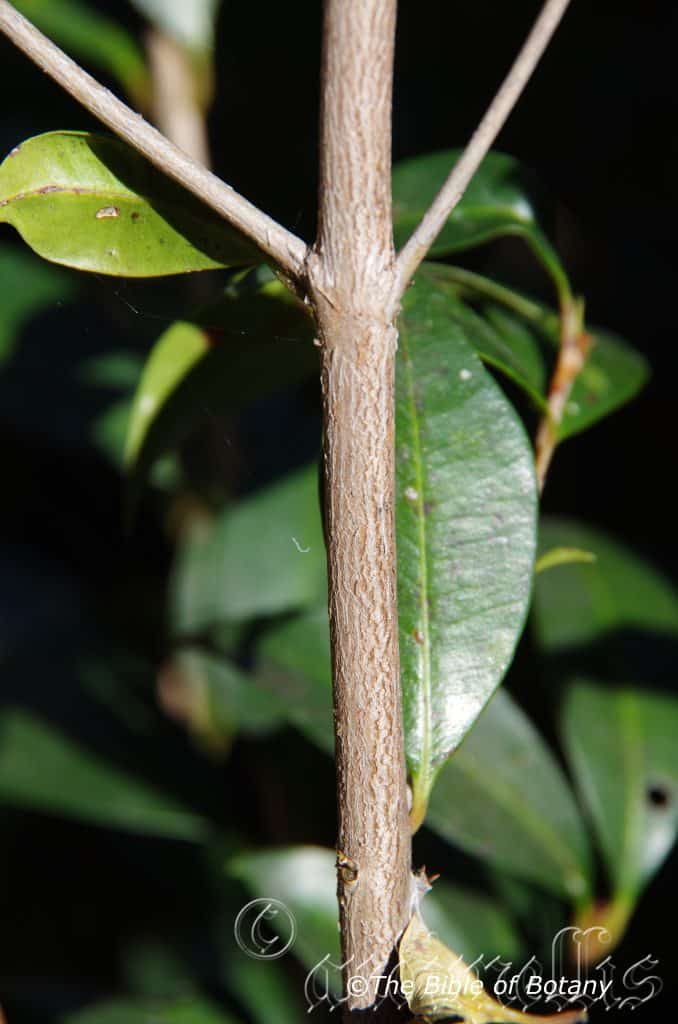
Rosser Gardens Benowa Qld.

Rosser Gardens Benowa Qld.
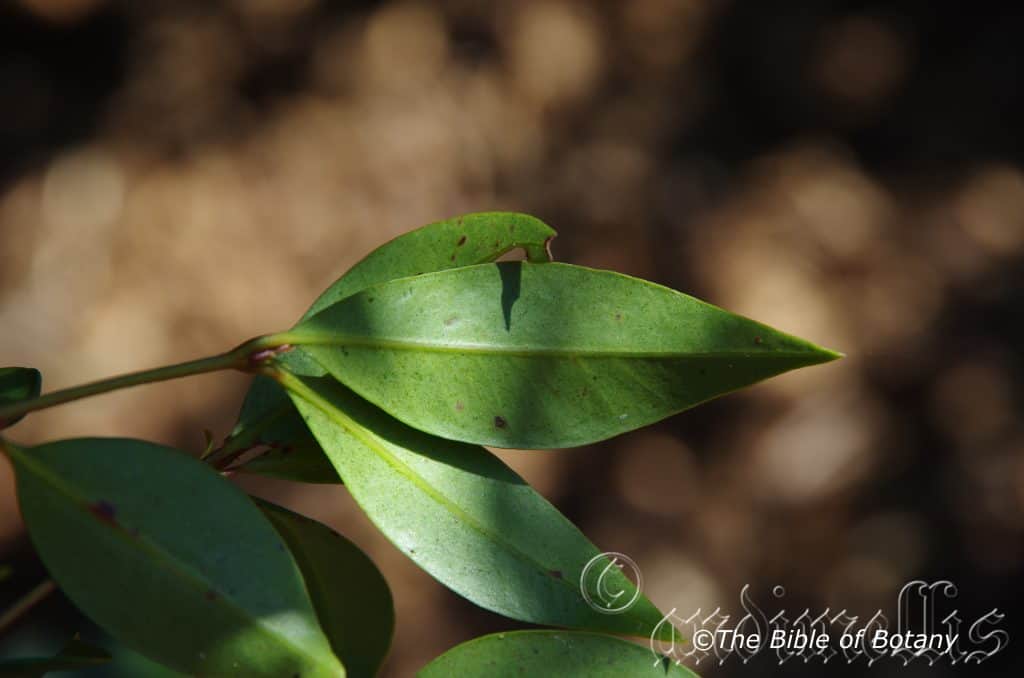
Rosser Gardens Benowa Qld.
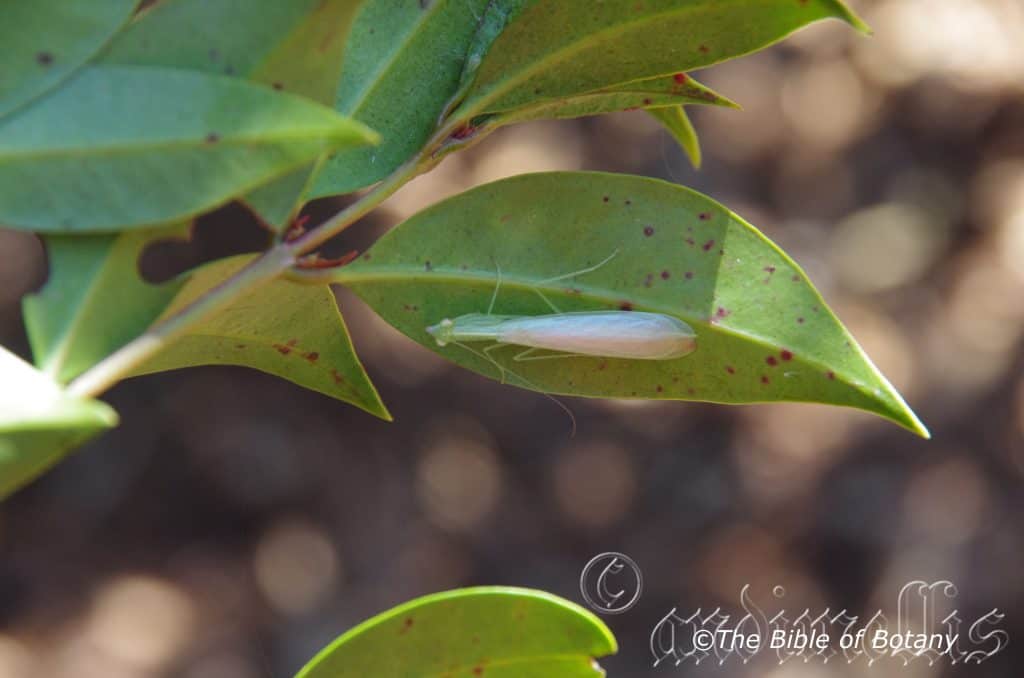
Rosser Gardens Benowa Qld.
Syzygium oleosum
Classification:
Unranked: Eudicots
Class: Rosids
Order: Myrtales
Family: Myrtaceae
Subamily: Myrtoideae
Tribe: Syzygieae
Genus: From Súzugos, which is Ancient Greek or Syzygia, which is Latin for a pair or yoke together. It refers to leaves, which are joined together in pairs.
Specie: From Olea, which is Latin for olive (oil). It refers to the overall appearance of the trees, which resemble the olive trees of Mediterranean Europe.
Sub specie:
Common Name: Blue Lillypilly or Blue Cherry or Magenta LillyPilly.
The Aboriginal Gumbaynggirr clan know it as Jijimam.
Distribution:
Syzygium oleosum is found on and east of the Great Dividing Range from north of Cooktown in far north Queensland to Port Kembla in central, coastal New South Wales.
https://avh.ala.org.au/occurrences/search?taxa=Syzygium+oleosum#tab_mapView
Habitat Aspect Climate:
Syzygium oleosum prefers dense shade to full sun. It grows in and adjacent to warm, moist temperate rainforests, warm, moist subtropical rainforests, cool, moist tropical rainforests, gallery forests or moist littoral rainforests. The altitude ranges from 5 meters ASL to 1200 meters ASL.
The temperatures range from minus 2 degree in August to 36 degrees in January.
The rainfalls range from lows of 900mm to 3200mm average per annum.
Soil Requirements:
Syzygium oleosum prefers sandy loams, peaty sands through to medium clays. The soils are usually derived from decomposed brown basaltsblack basalts, better quality shales, sandstones granite or accumulated peaty beach sands behind the frontal dunes. The soils range from a PH of 5pH to 6pH. It does not tolerate water logged soils however trees in riparian zones may experience periodic flooding for short periods and those in coastal littoral zones may experience rising water tables during the wet seasons. Non saline soils to moderately saline soils are tolerated.
Height & Spread:
Wild Plants: 4m to 12m by 2m to 6m.
Characteristics:
Syzygium oleosum grows as a small tree with a straight, pale grey-brown trunk and flaky to almost tessellated bark. The bark is hard but spongy. The branches are pale grey and only becoming green near the apex where the newer leaf growth occurs. The branchlets are glabrous.
The opposite, broadly elliptical to elliptical or lanceolate leaves measure 30mm to 110mm in length by 10mm to 40mm in width. The bases are cuneate to round-cuneate while the apexes are acuminate to long acuminate. The discolourous laminas are deep sea-green, semi glossy and glabrous on the upper lamina while the lower lamina is paler and dull. The new growth flushes are deep auburns or deep burgundy. The leaf margins are entire, flat or slightly undulating while the lamina is flat to slightly recurved and decurve as it approaches the apex. The mid veins are prominent on lower laminas and faintly visible on the upper lamina being depressed. The petioles are deep sea-green at times tinged purplish-black, channelled on the upper surface and measures 3mm to 10mm in length.
The inflorescences are born on panicles from the upper leaf axils. The pale reddish-brown, pale yellow and red or grass-green peduncles, rachises, pedicellates and pedicels are glabrous while the pedicels. The peduncles measure 30mm to 55mm in length, the rachises measure 20mm to 50mm in length while the pedicellates measure 30mm to 50mm and the pedicels measure 1mm to 3.5mm in length.
The pale cream, creamy red, creamy orange, creamy yellow, pale green or a combination of the colours calyxes and calyx lobes are covered in very fine tuberculate lumps. The calyx tubes measure 3mm to 6mm in length by 2mm to 4.5mm in width. The 4 erect, deltoid calyx lobes are concave and measure 1.5mm to 2mm in length by 1.5mm to 2mm in width. The 4 white petals are orbicular, densely covered in visible oil dots and measure 2.5mm to 3.5mm in length by 2.5mm to 3.5mm on diameter.
The 60 to 96 exserted filaments are free for their entire length and form two dimorphic rings around the outer edge of the hypanthia inside the lobes. The outer filaments measure 10mm to 18mm in length while the inner filaments measure 6mm to 10mm in length. The filaments are pure white while the dorsifixed anthers are cream. The ovate anthers measure 0.5mm to 0.7mm in length by 0.4mm to 0.5mm width.
The white style and stigma are glabrous while the hypanthia disc is pale creamy yellow to pale creamy pink. The pistil measures 12mm to 22mm in length and are slightly longer than the stamens. Syzygium oleosum is not as prolific in bloom,,when compared to many of the other Syzygium however the flowers appear for 10 months of the year from mid-November through to mid-August.
The fruits of Syzygium oleosum are broadly ovoidal to globose berries. The berries are glabrous and measure 9.5mm to 25mm in length by 10mm to 16mm in diameter. The green berries turn deep purple-blue to magenta pink externally and white internally when ripe. The pericarp is succulent. The calyx lobes remain erect and are persistent on the ripe fruit partially covering the depressed disc of the hypanthia. The style is persistent on the semi ripe fruit. The single magenta-pink to pale fawn, fleshy seeds are orbicular and glabrous. They measure 6mm to 7mm in length by 5mm to 8.5mm in diameter.
Confusing Species:
Syzygium oleosum’s lateral veins widely spaced. Leaves narrow elliptical. The bluish, purple or magenta, globose to ovoid berries measure 8mm to 15mm in length by 10mm to 25mm in diameter. The fruits pulp is white.
Syzygium australis’s lateral veins are very close together. The leaves are elliptical. The external pink, deep pink, carmine, scarlet-red or maroon-red fruits are white internally when ripe. The fruits are depressed globose berries that measure 9mm to 15mm in length by 15mm to 25mm in diameter. The fruits pulp is white. The seed is usually a single non polyembrionic.
Syzygium crebrinerve’s lateral veins evenly spaced. The leaves are elliptical. The reddish-pink to red, obovoid to campanulate berries measure 12mm to 15mm in length by 15mm to 25mm in diameter. The fruits pulp is white. Trunk buttressed.
Syzygium paniculata’s lateral veins are evenly spaced and divide well before the margin. The leaves are elliptical. The purple to magenta fruits are depressed globose berries that measure 10mm to 15mm in length by 15mm to 25mm in diameter. The fruits pulp is pink. The seed is usually polyembrionic.
Wildlife:
Syzygium oleosum support native bees and a myriad of other insects along the coast. Various honeyeaters attend the flowers while insectivorous birds seek out the many insects. Honeyeaters also use the flowers as a store for protein feeding on insects when they have nestlings to feed. It is a terrific sand stabilizer on the back dunes.
Syzygium oleosum’s edible fruits are reminiscent of apples with the texture of water melon. They appear to have a good supply of pectin or at least the plants from around Woolli to Moonie beach have proven themselves to avail this quality. The fruits make good jams, jellies, chutneys and flavouring.
Cultivation:
Syzygium oleosum is a magnificent small tree it should be grown in association with other rainforest specie. It is ideal at the edge of a rain forest or deep in the center of the rainforest. It also makes a great park tree offering quick growth, and good shade for medium gardens and parks in warm frost free temperate to cool tropical zones. In cultivation it grows from 3 meters to 6 meters in height by 4 meters to 5 meters in diameter when grown in the open or taller and narrower if grown closer together as a rainforest tree.
It grows exceptionally well on deeper, lighter soils where deep leaf litter keeps the soil cool and moisture at an even level. If these requirements are met they can cope with temperatures as low as minus 5 degrees once established and up to 36 degrees as long as it is protected by other trees and the days are warm. Our trees suffered burnt leaves and tips, recovering very slowly when temperatures reached minus 5 degrees even with surrounding trees offering protection from the frosts. It is moderately drought resistant in their climatic zones.
Add to the above, if it is given an adequate supply of water and a little native fertilizer on a regular basis the plants respond with good flowering and better quality fruit over the 10 months.
The flushes of new growth brighten the bush up and are worthwhile planting in small groups scattered throughout the bush for this quality alone.
It can be tipped pruned or pruned hard which makes them a great selection for hedges and windrows close to the coast where cattle are not grazing.
The trees would make very great accent trees in front of low set commercial, industrial sheds or schools where they will break up hard rigid architectural lines and give warmth and breadth to a building. In front of high rise buildings they give balance especially where they could be grown in curves meandering to the entry doors or for something different used from the front of the path and meander back to the far corners. The plants lend themselves beautifully if scattered randomly as the only plants on display particularly when a mixture of tree forms and shrubs are used.
Try using one in a court yard where the only other feature is a large rock, stump or formal or informal frog or fish pond. Next to such features their leaves, small flowers and colourful fruit are never overpowering but certainly noticed. I am surprised that they have never been used in commercial entrances and foyers to break the ice and give a feeling of business as usual but somehow make the business more relaxing.
Like all Syzygium they make great bonsai plants and this one can also back up for topiary work.
The trees are occasionally heavily infested with Psyllidae or pimple gall especially when grow in a monoculture or where neighbours use chemical or nonspecific controls. Our plants at Nana Glen only ever had the odd Psyllidae on them probably because of the surrounding bush and the fact that we encouraged a balance on the farm and refused to engage in chemical warfare. Psyllids can make a tree look terrible, even ghastly when the black sugar mould entirely covers the trees. Control is best achieved by supporting the natural enemies of the many varieties of Psyllids.
Psyllaephagus specie is small predatory wasps which feed exclusively on psyllids. The female adult wasp lays an egg into the psyllid nymph before the lerp becomes impenetrable to the wasp.
Other hunters of Psyllids include the beautiful Lacewing and ladybirds and their larvae also feed on the psyllid nymphs. Birds, particularly swallows, have been observed flying around badly affected trees when adult psyllids are numerous, and eat adult psyllids. I also suspect that thornbills and silver eyes to play a role in the control of most types of Psyllids as do the bell miners and noisy miner. Spiders which build their webs in trees account for a large number of adults and other small flying insects.
Propagation:
Seeds: The seeds of Syzygium oleosum can be removed easily from the fruits.
Sow fresh seeds directly into a seed raising mix, keeping them moist not wet. Do not over water as the seeds will rot off before germination takes place. Place the trays in a cool shaded area with 50mm shade cloth in the bush house. When the seedlings are 40mm to 60mm tall, prick them out and plant them into 50mm native tubes using a good organic mix.
As the seedlings roots reach the bottom of the tubes plant them out into their permanent position. Do not delay.
Fertilize using Seaweed, fish emulsion or organic chicken pellets soaked in water and apply the liquid on an alternate basis. Fertilize every 2 months until the plants are well established then on an annual basis in September or March to maintain better health, vitality and flowering
Further Comments from Readers:
“Hi reader, it seems you use The Bible of Botany a lot. That’s great as we have great pleasure in bringing it to you! It’s a little awkward for us to ask, but our first aim is to purchase land approximately 1,600 hectares to link several parcels of N.P. into one at The Pinnacles NSW Australia, but we need your help. We’re not salespeople. We’re amateur botanists who have dedicated over 30 years to saving the environment in a practical way. We depend on donations to reach our goal. If you donate just $5, the price of your coffee this Sunday, We can help to keep the planet alive in a real way and continue to bring you regular updates and features on Australian plants all in one Botanical Bible. Any support is greatly appreciated. Thank you.”
In the spirit of reconciliation we acknowledge the Bundjalung, Gumbaynggirr and Yaegl and all aboriginal nations throughout Australia and their connections to land, sea and community. We pay our respect to their Elders past, present and future for the pleasures we have gained.
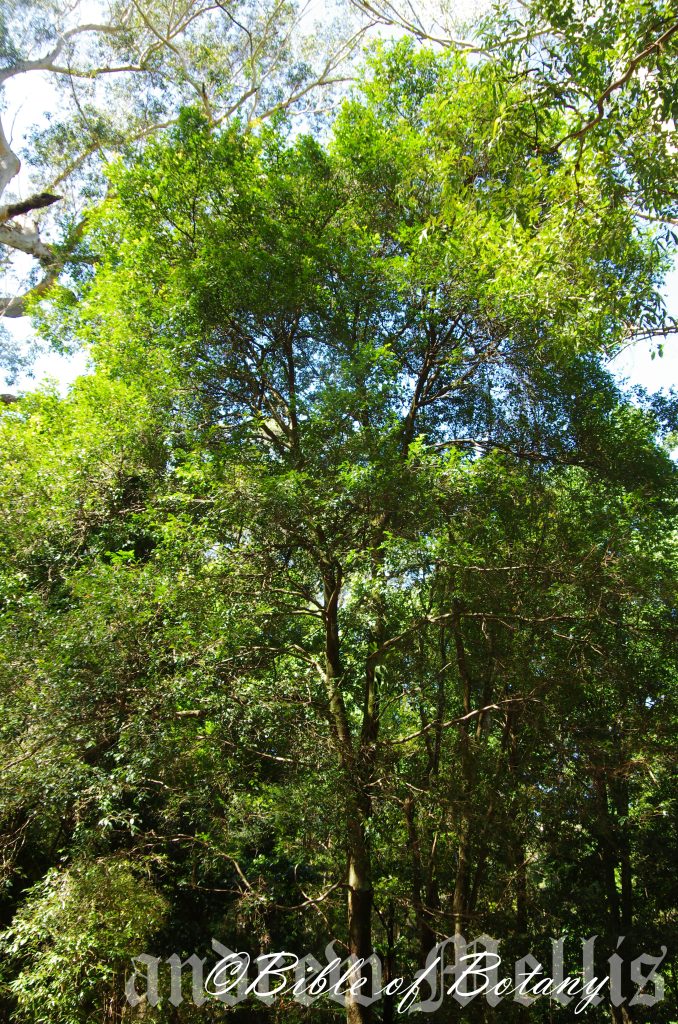
NCBG Coffs Harbour NSW

Kungala NSW
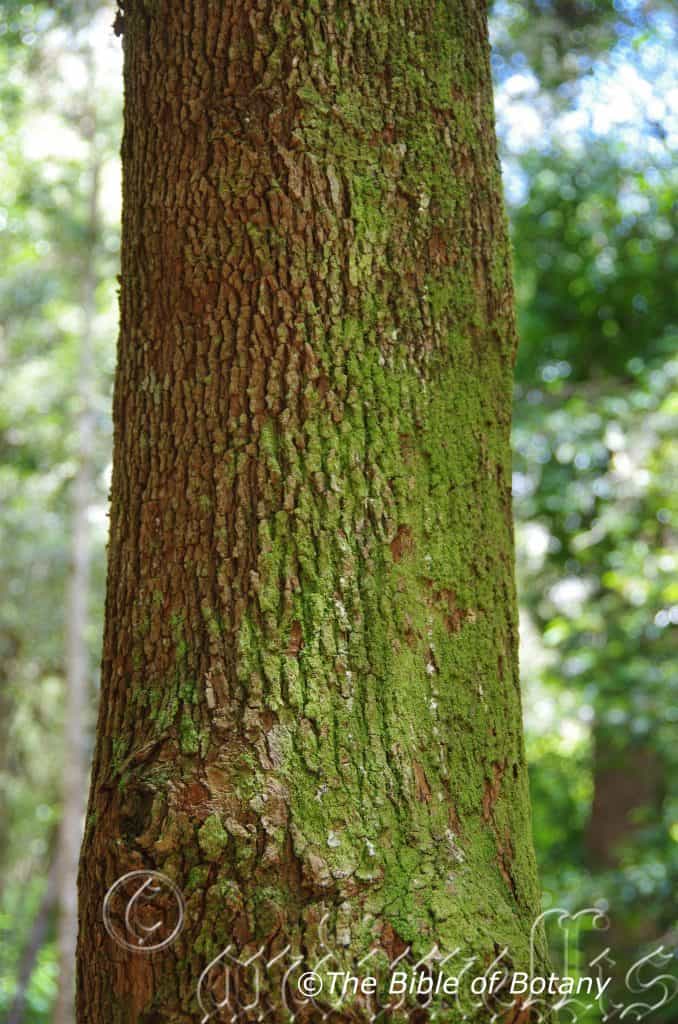
NCBG Coffs Harbour NSW
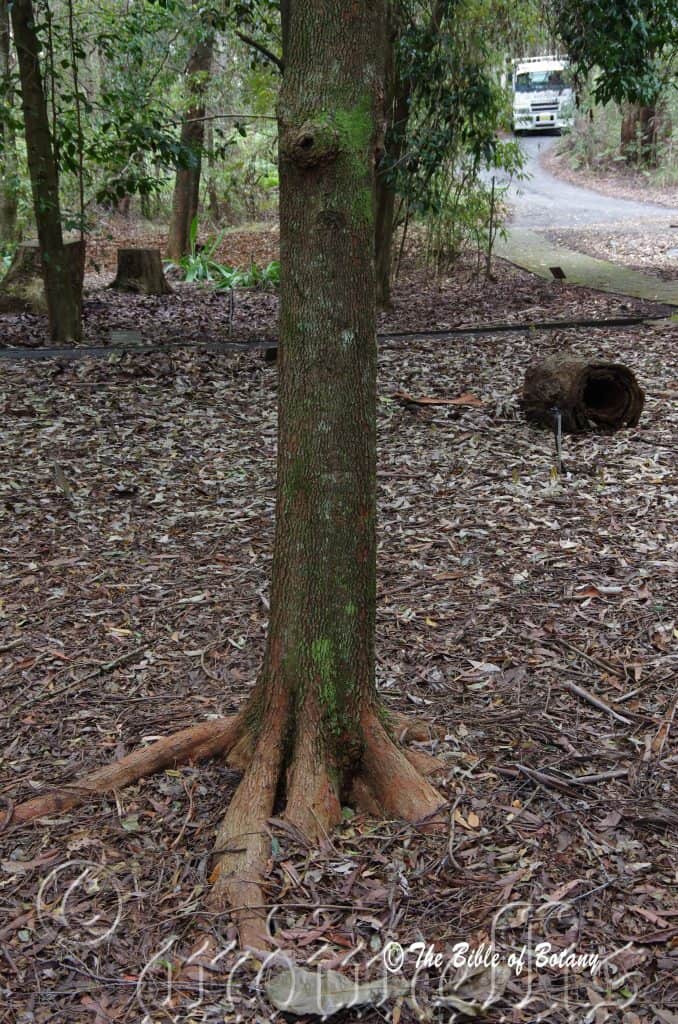
NCBG Coffs Harbour NSW

Juvenile foliage Aurthor’s Garden The Pinnacles NSW
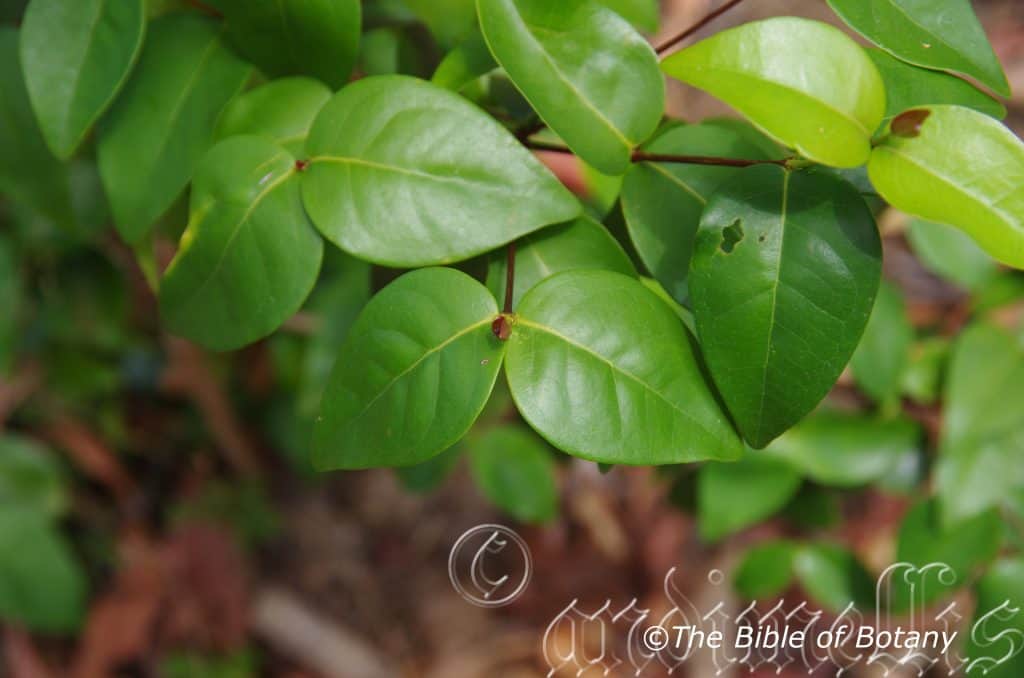
Juvenile foliage Aurthor’s Garden The Pinnacles NSW
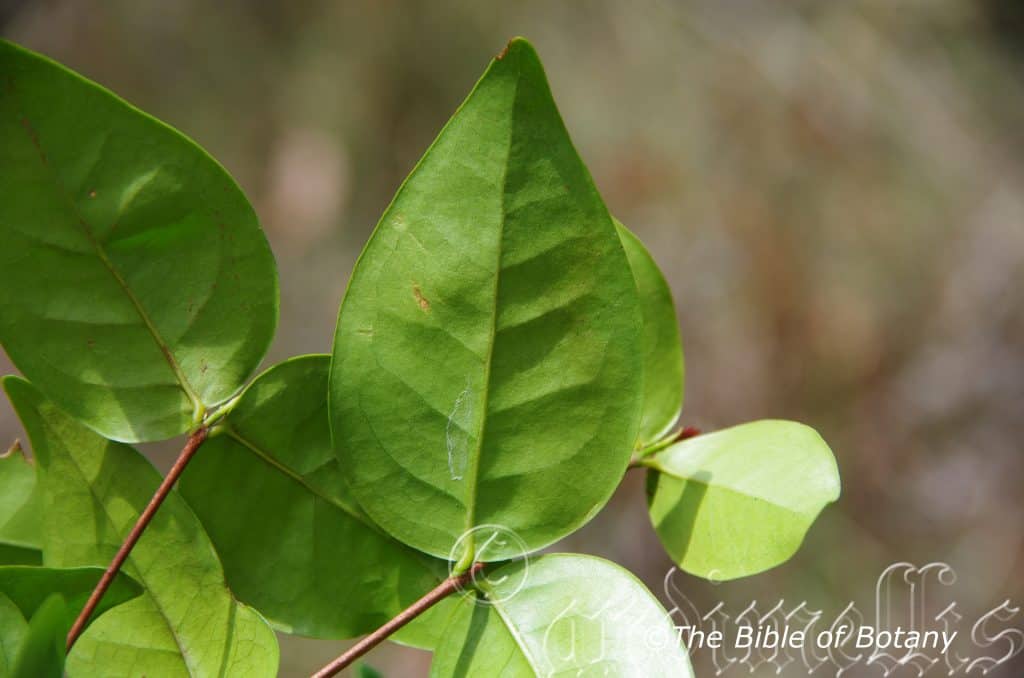
Juvenile foliage Aurthor’s Garden The Pinnacles NSW
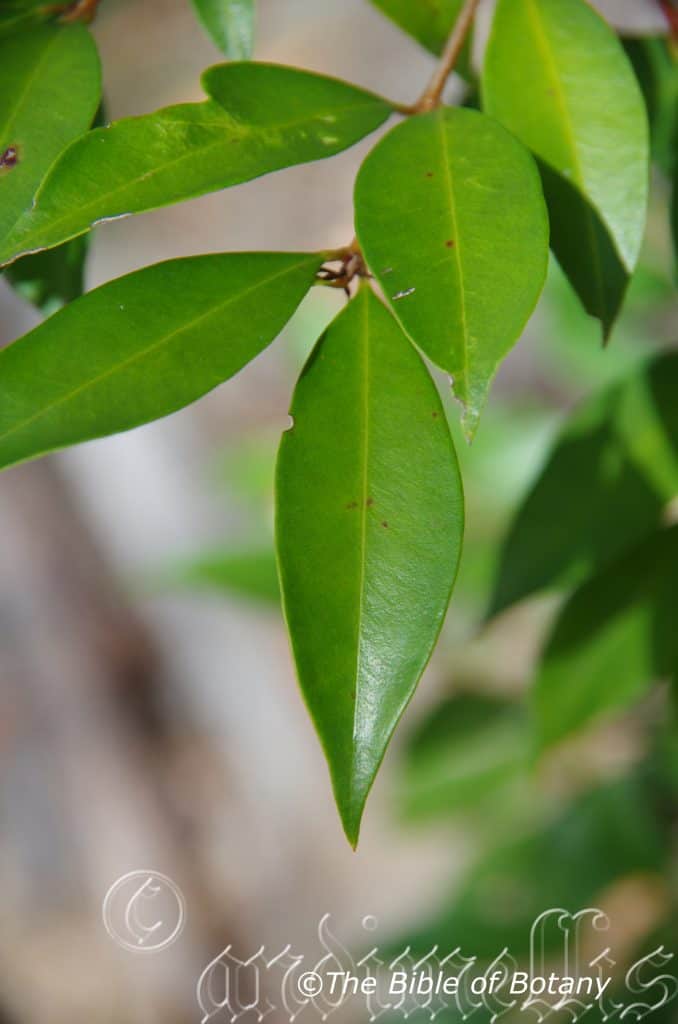
Mature foliage Aurthor’s Garden The Pinnacles NSW

Mature foliage Aurthor’s Garden The Pinnacles NSW
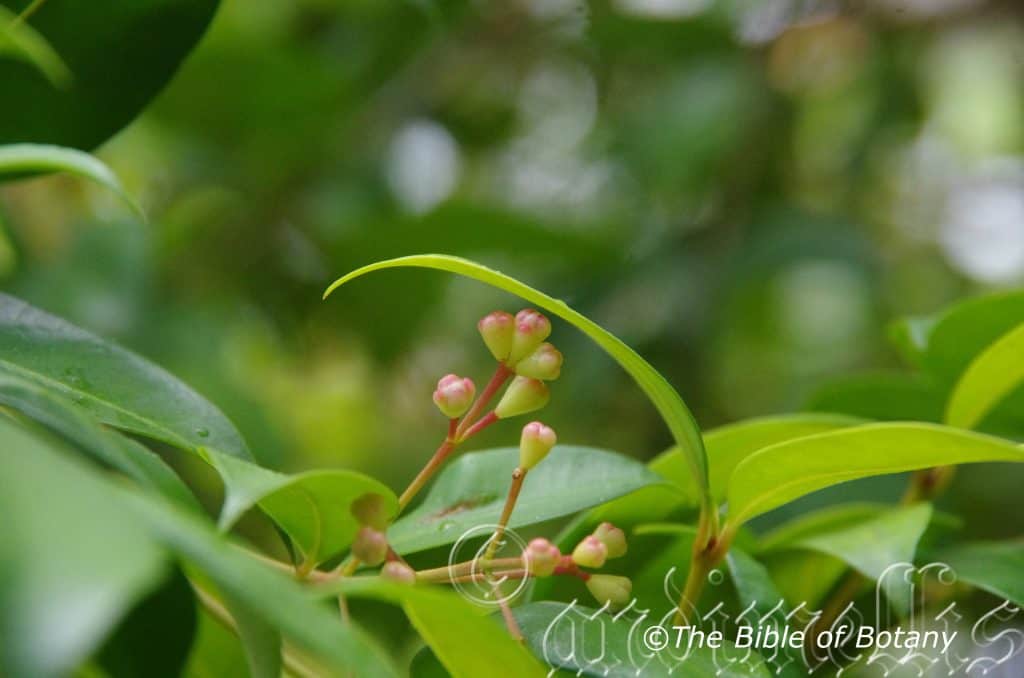
Aurthor’s Garden The Pinnacles NSW

Aurthor’s Garden The Pinnacles NSW
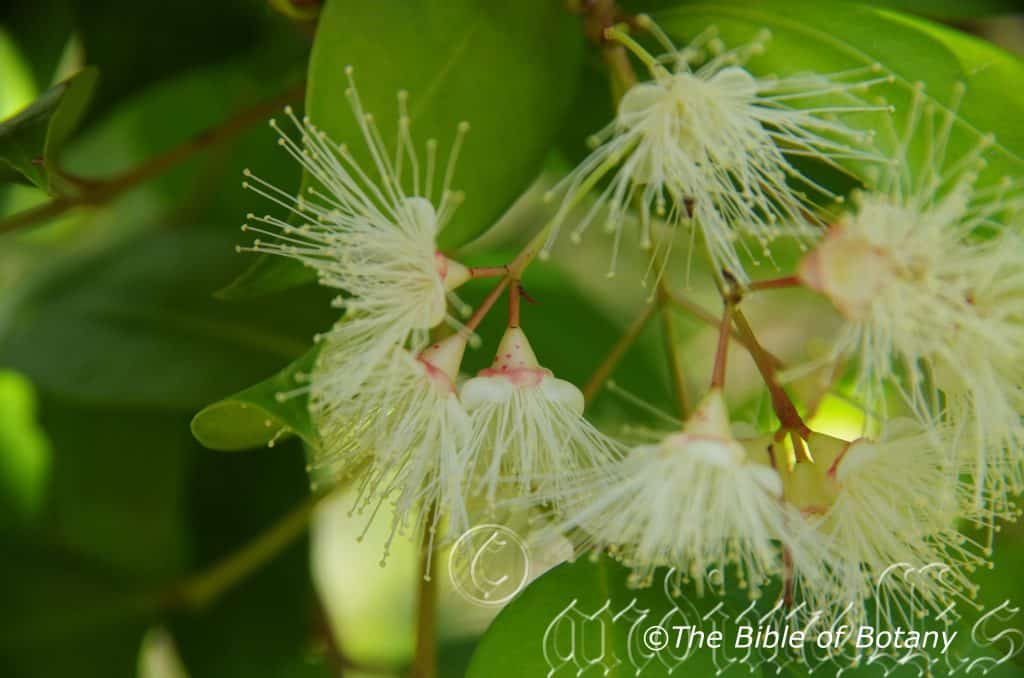
Aurthor’s Garden The Pinnacles NSW
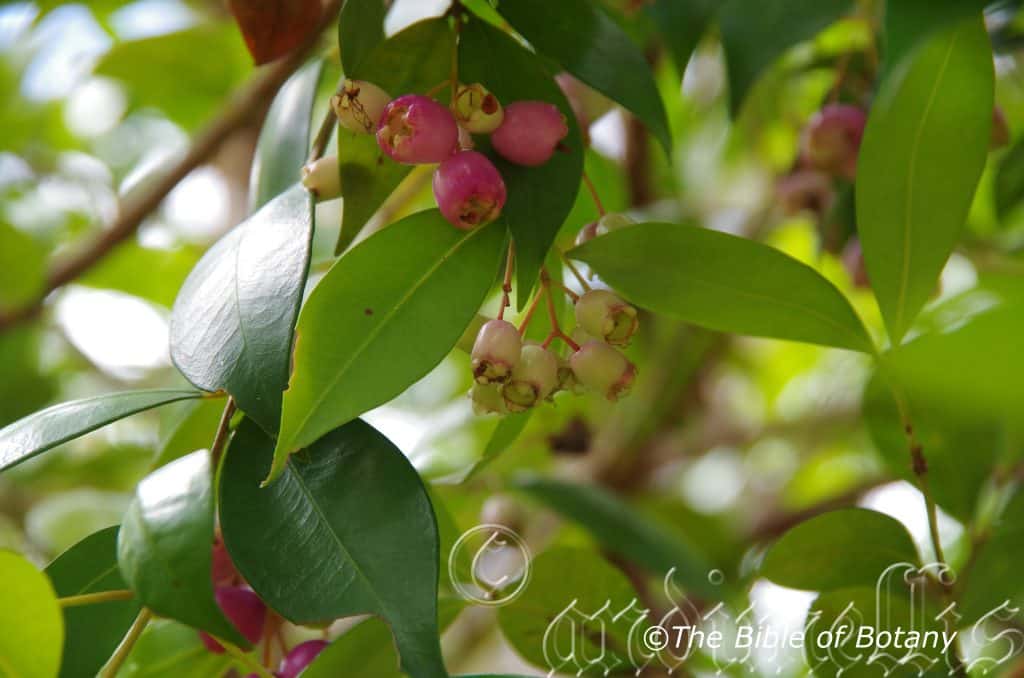
Aurthor’s Garden The Pinnacles NSW
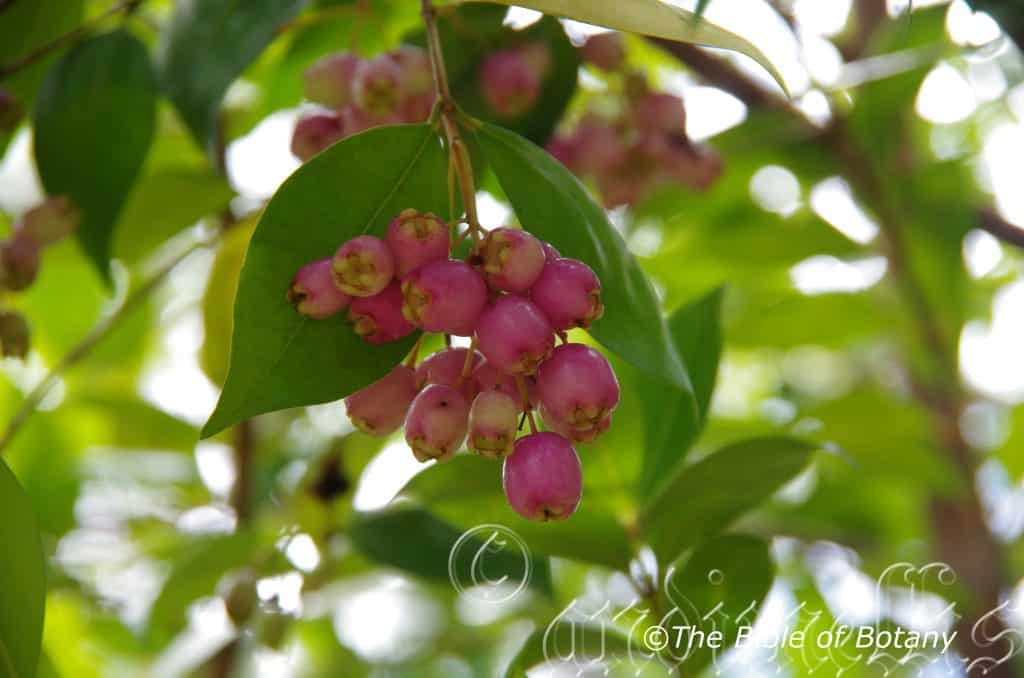
Aurthor’s Garden The Pinnacles NSW
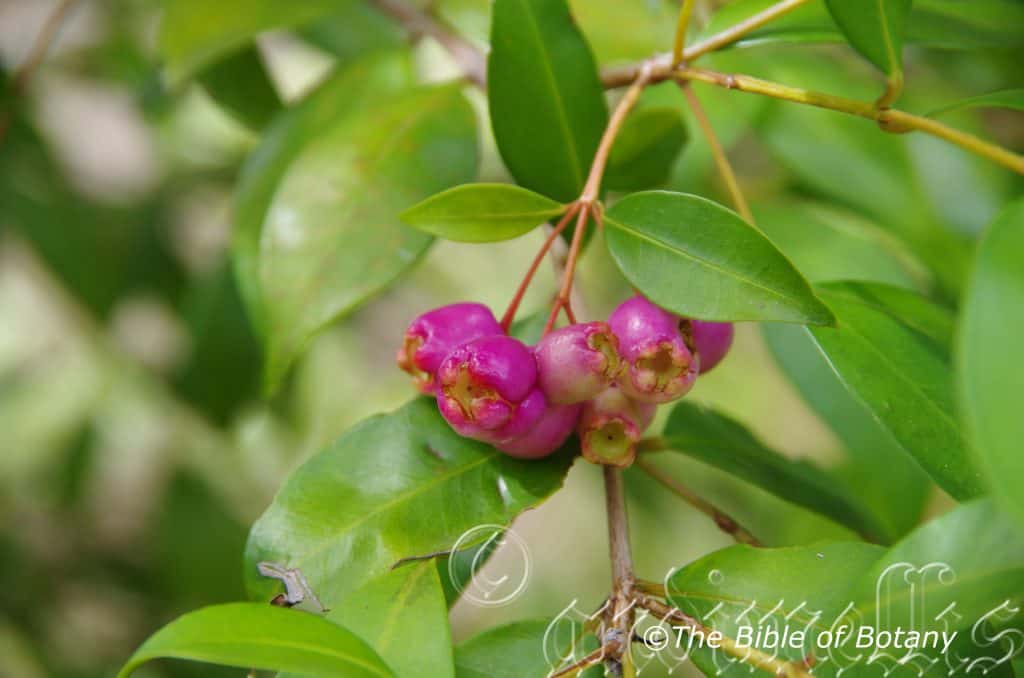
Aurthor’s Garden The Pinnacles NSW

Aurthor’s Garden The Pinnacles NSW
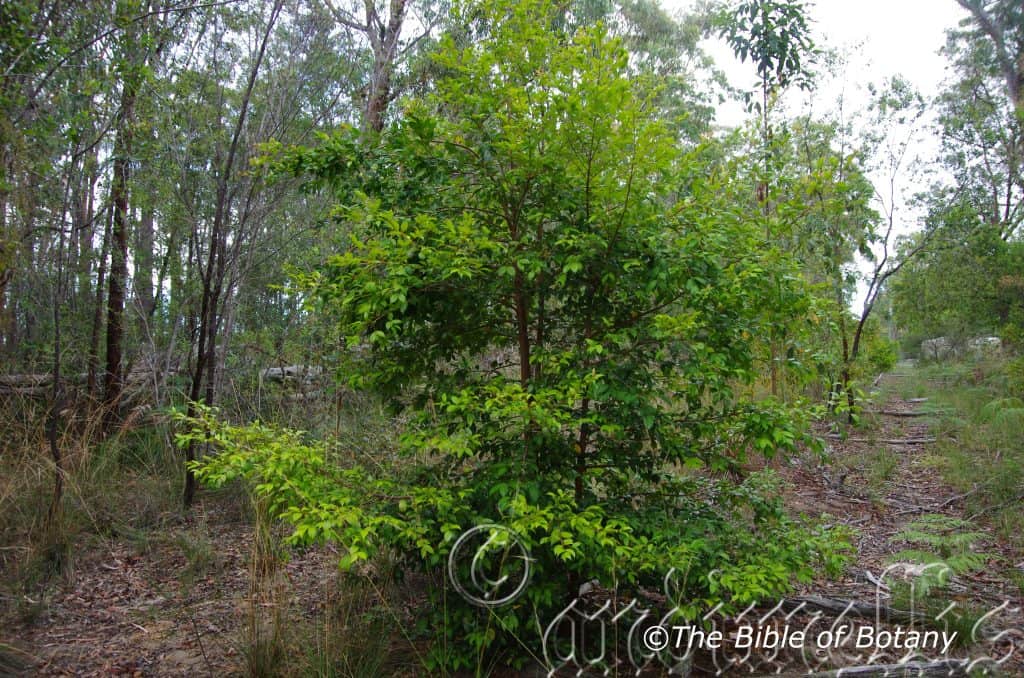
Author’s Garden The Pinnacles NSW
Syzygium paniculatum
Classification:
Unranked: Eudicots
Class: Rosids
Order: Myrtales
Family: Myrtaceae
Subamily: Myrtoideae
Tribe: Syzygieae
Genus: From Súzugos, which is Ancient Greek or Syzygia, which is Latin for a pair or yoke together. It refers to leaves, which are joined together in pairs.
Specie: From Panos, which is Ancient Greek or P?nicula, which is Latin for a flower head. It refers to many flowers, which are arranged in a compact head.
Sub specie:
Common Name: Bush Cherry or Magenta Cherry.
The Aboriginal Gumbaynggirr clan know it as Jijimam.
Distribution:
Syzygium paniculatum is found east of the Great Dividing Range south from Bulladella to Jervis Bay in the south to in central coastal New South Wales.
https://avh.ala.org.au/occurrences/search?taxa=Syzygium+paniculatum#tab_mapView
Habitat Aspect Climate:
Syzygium paniculatum prefers light shade to full sun. It grows in and adjacent to warm, moist sub-tropical rainforests or warm, moist littoral rainforests. The altitude ranges from 2 meters ASL to 420 meters ASL.
The temperatures range from minus 2 degree in August to 36 degrees in February.
The rainfalls range from lows of 800mm to 1600mm average per annum.
Soil Requirements:
Syzygium paniculatum prefers sandy loams, peaty sands to light sandy loams. The soils are usually derived from decomposed sandstones or accumulated peaty beach sands. The soils pH ranges from 5pH to 6pH. It does not tolerate water logged soils however trees in riparian zones may experience periodic flooding for short periods or those in coastal littoral zones may experience seasonally rising water tables. Non saline soils to very saline soils are tolerated.
Height & Spread:
Wild Plants: 8m to 15m by 4m to 6m.
Characteristics:
Syzygium paniculatum grows as a tall tree with a straight, pale grey-brown, flaky to almost tessellated bark. The bark is hard but slightly spongy on the surface. The branches are pale grey and glabrous. The stems are green near the apex where the newer leaves occur. The branchlets are glabrous.
The opposite, elliptical, lanceolate to obovate leaves of Syzygium paniculatum measure 45mm to 100mm in length by 15mm to 30mm in width. The base is cuneate to round-cuneate while the apexes are acuminate. The discolourous laminas are deep sea-green, semi glossy to glossy and glabrous on the upper lamina while the lower lamina is paler and dull. The new growth flushes are deep auburns or deep burgundy. The leaf margins are entire, flat while the lamina is flat to slightly recurved or decurved from the mid vein to the margins and decurve as it approaches the apex. The mid veins are prominent on lower laminas and faintly visible on the upper lamina being depressed. The lateral veins are slightly prominent on the lower lamina and are not visible from the upper lamina. The petioles are deep sea-green at times tinged purplish-black, channelled on the upper surface and measures 1mm to 6mm in length.
Inflorescences of Syzygium paniculatum are born on panicles or cymes from the upper leaf axils or terminals. There are 3 to 7 flowers on an umbel which measures 20mm to 70mm in diameter. The grass-green peduncles, rachises and pedicels are glabrous. The peduncles measure 10mm to 22mm in length by 1mm in diameter while the rachises on the compound umbels measure 10mm to 20mm in length and the pedicels measure 1mm to 10mm in length.
The caducous bracts are grass-green. The pale green tinged red or purple cream calyx and the 4 obtuse, slightly dimorphic, divaricate calyx lobes are glabrous. The calyx tubes measure 4mm to 7mm in length by 3mm to 7mm in diameter while the longer lobes measure 2.5mm to 4mm in length and the shorter lobes measure 2mm to 3.5mm in length.
The white orbicular petals are glabrous and densely covered in fine oil glands. They petals measure 4mm to 5mm in length by 3.5mm to 5mm in diameter.
The 60 to 96 dimorphic, exserted filaments are free for their entire length. The longer filaments measure 12mm to 15mm in length while the shorter filaments measure 8mm to 15mm in length. The filiform filaments are white and while the anthers are pale cream. The ovate, adnate anthers measure 0.6mm in length by 0.4mm to 0.6mm width.
The white style and stigma are glabrous while the ovary is green. The styles taper from the base to the slender stigma and measure 7mm to 24mm in length. The pistil always exceeds the length of the stamens. Syzygium oleosum is not a prolific bloomer compared to other Syzygium however the flowers appear for 10 months of the year from mid-November through to mid-August.
The fruits of Syzygium paniculatum are broadly ovoidal to globose berries. The berries are glabrous and measure 16mm to 28mm in length by 15mm to 25mm in diameter. The green berries turn deep purple-blue to magenta pink externally and white or pale magenta-pink and white internally when ripe. The pericarp is succulent. The calyx lobes remain erect and are persistent on the ripe fruit partially covering the depressed disc of the hypanthia. The style is persistent on the semi ripe fruit. The single magenta-pink to pale fawn, fleshy seeds are polyembyonic, spherical and glabrous. They measure 6mm to 7mm in length by 5mm to 8.5mm in diameter.
Confusing Species:
Syzygium paniculata’s lateral veins are evenly spaced and divide well before the margin. The leaves are elliptical. The purple to magenta fruits are depressed globose berries that measure 10mm to 15mm in length by 15mm to 25mm in diameter. The fruits pulp is pink. The seed is usually polyembrionic.
Syzygium australis’s lateral veins are very close together. The leaves are elliptical. The external pink, deep pink, carmine, scarlet-red or maroon-red fruits are white internally when ripe. The fruits are depressed globose berries that measure 9mm to 15mm in length by 15mm to 25mm in diameter. The seed is usually a single non polyembrionic.
Syzygium crebrinerve’s lateral veins evenly spaced. The leaves are elliptical. The reddish-pink to red, obovoid to campanulate berries measure 12mm to 15mm in length by 15mm to 25mm in diameter. The fruits pulp is white. Trunk buttressed.
Syzygium oleosum’s lateral veins widely spaced. Leaves narrow elliptical. The bluish, purple or magenta, globose to ovoid berries measure 8mm to 15mm in length by 10mm to 25mm in diameter. The fruits pulp is white.
Wildlife:
Syzygium paniculatum support native bees and a myriad of other insects along the coast. Various honeyeaters attend the flowers while insectivorous birds seek out the many insects. Honeyeaters also use the flowers as a store for protein feeding on insects when they have nestlings to feed. It is a terrific sand stabilizer on the back dunes.
Syzygium paniculatum’s edible fruits are reminiscent of apples with the texture of water melon. They appear to have a good supply of pectin or at least the plants from around Wooli to Moonie beach have proven themselves to avail this quality. The fruits make good jams, jellies, chutneys and flavourings.
Cultivation:
Syzygium paniculatum and Syzygium australe are very similar but there are several aspects which differ. The first is that the seeds which are polyembyonic, second the fruits are usually pinkish internally where as Syzygium australe are white internally, thirdly the trees are much taller and finally there are usually more than 7 flowers on a panicle or cyme.
Syzygium paniculatum is a magnificent small tree that should be grown in association with other rainforest specie. It is ideal at the edge of a rain forest or deep in the center of the rainforest. It also makes a great park tree offering quick growth, and good shade for small gardens and parks in warm frost free temperate to cool tropical zones. In cultivation it grows from 3 meters to 6 meters in height by 4 meters to 5 meters in diameter when grown in the open or taller and narrower if grown closer together as a rainforest tree.
It grows exceptionally well on deeper, lighter soils where deep leaf litter keeps the soil cool and moisture at an even level. If these requirements are met it can cope with temperatures as low as minus 5 degrees and up to 36 degrees as long as it is protected by other trees and the days are warm. The trees suffered burnt leaves and tips, recovering very slowly when temperatures reached minus 5 degrees even with surrounding trees offering protection from frosts. It is moderately drought resistant in their climatic zones.
Add to the above, if it is given an adequate supply of water and a little native fertilizer on a regular basis the plants respond with good flowering and better quality fruit over the 10 months.
The flushes of new growth brighten the bush up and are worthwhile planting in small groups scattered throughout the bush for this quality alone.
It can be tipped pruned or pruned hard which makes them a great selection for hedges and windrows close to the coast where cattle are not grazing.
The trees would make very great accent trees in front of low set commercial, industrial sheds or schools where it breaks up hard rigid architectural lines and give warmth and breadth to a building. In front of high rise buildings they give balance especially where they could be grown in curves meandering to the entry doors or for something different used from the front of the path and meander back to the far corners. The plants lend themselves beautifully if scattered randomly as the only plants on display particularly when a mixture of tree forms and shrubs are used.
Try using one in a court yard where the only other feature is a large rock, stump or formal or informal frog or fish pond. Next to such features their leaves, small flowers and colourful fruit are never overpowering but certainly noticed. I am surprised that they have never been used in commercial entrances and foyers to break the ice and give a feeling of business as usual but somehow make the business more relaxing.
Like all Syzygium specie it makes a great bonsai plant and this one can also back up for topiary work.
The trees are occasionally heavily infested with Psyllidae or pimple gall especially when grow in a monoculture or where neighbours use chemical or nonspecific controls. Our plants at Nana Glen only ever had the odd Psyllidae on them probably because of the surrounding bush and the fact that we encouraged a balance on the farm and refused to engage in chemical warfare. Psyllids can make a tree look terrible, even ghastly when the black sugar mould entirely covers the trees. Control is best achieved by supporting the natural enemies of the many varieties of Psyllids.
Psyllaephagus specie is small predatory wasps which feed exclusively on psyllids. The female adult wasp lays an egg into the psyllid nymph before the lerp becomes impenetrable to the wasp.
Other hunters of Psyllids include the beautiful Lacewing and ladybirds and their larvae also feed on the psyllid nymphs. Birds, particularly swallows, have been observed flying around badly affected trees when adult psyllids are numerous, and eat adult psyllids. I also suspect that thornbills and silver eyes to play a role in the control of most types of Psyllids as do the bell miners and noisy miner. Spiders which build their webs in trees account for a large number of adults and other small flying insects.
Propagation:
Seeds: The seeds of Syzygium paniculatum can be removed easily from the fruits.
Sow fresh seeds directly into a seed raising mix, keeping them moist not wet. Do not over water as the seeds will rot off before germination takes place. Place the trays in a cool shaded area with 50mm shade cloth in the bush house. When the seedlings are 40mm to 60mm tall, prick them out and plant them into 50mm native tubes using a good organic mix.
As the seedlings roots reach the bottom of the tubes plant them out into their permanent position. Do not delay.
Fertilize using Seaweed, fish emulsion or organic chicken pellets soaked in water and apply the liquid on an alternate basis. Fertilize every 2 months until the plants are well established then on an annual basis in September or March to maintain better health, vitality and flowering
Further Comments from Readers:
“Hi reader, it seems you use The Bible of Botany a lot. That’s great as we have great pleasure in bringing it to you! It’s a little awkward for us to ask, but our first aim is to purchase land approximately 1,600 hectares to link several parcels of N.P. into one at The Pinnacles NSW Australia, but we need your help. We’re not salespeople. We’re amateur botanists who have dedicated over 30 years to saving the environment in a practical way. We depend on donations to reach our goal. If you donate just $5, the price of your coffee this Sunday, We can help to keep the planet alive in a real way and continue to bring you regular updates and features on Australian plants all in one Botanical Bible. Any support is greatly appreciated. Thank you.”
In the spirit of reconciliation we acknowledge the Bundjalung, Gumbaynggirr and Yaegl and all aboriginal nations throughout Australia and their connections to land, sea and community. We pay our respect to their Elders past, present and future for the pleasures we have gained.

Mount Cootha Botanic Gardens Qld.

Mount Cootha Botanic Gardens Qld.

Mount Cootha Botanic Gardens Qld.
Syzygium papyraceum
Classification:
Unranked: Eudicots
Class: Rosids
Order: Myrtales
Family: Myrtaceae
Subamily: Myrtoideae
Tribe: Syzygieae
Genus: From Súzugos, which is Ancient Greek or Syzygia, which is Latin for a pair or yoke together. It refers to leaves, which are joined together in pairs.
Specie: From Pápy?ros, which is Latin for thin, flimsy and dry. It refers to the petals, leaves or bark, which are like paper.
Sub specie:
Common Name: Bush Cherry or Magenta Cherry.
The Aboriginal Gumbaynggirr clan know it as Jijimam.
Distribution:
Syzygium papyraceum is found east on and east of the Great Dividing Range south from Davies Creek to Bowling Green Bay National Park in far north eastern Queensland.
Habitat Aspect Climate:
Syzygium papyraceum prefers light shade to full sun. It grows in and adjacent to warm, moist tropical rainforests. The altitude ranges from 200 meters ASL to 800 meters ASL.
The temperatures range from 5 degree in August to 34 degrees in February.
The rainfalls range from lows of 1800mm to 3000mm average per annum.
Soil Requirements:
Syzygium papyraceum prefers better quality loams. The soils are usually derived from decomposed red or black basalts. The soils pH ranges from 5pH to 7pH. It does not tolerate water logged soils. Non saline soils to slightly saline soils are tolerated.
Height & Spread:
Wild Plants: 15m to 20m but has been recorded at 35m by 6m to 10m.
Characteristics:
Syzygium papyraceum grows as a tall tree with a straight, deep reddish-brown, flaky bark. The bark is papery on the surface. The branchlets are pale grey and flaky soon becoming deep reddish-brown. The trunks are strongly buttressed at the base.
The opposite, elliptical, broad lanceolate to obovate leaves of Syzygium papyraceum measure 65mm to 105mm in length by 25mm to 50mm in width. The base is round, while the apexes are somewhat obtuse with a very pronounced acuminate tip. The slightly discolourous laminas are mid to deep green, semi glossy to glossy and glabrous on the upper lamina while the lower lamina is slightly paler. The new growth flushes are deep auburns or deep burgundy. The leaf margins are entire, flat while the lamina is flat to slightly recurved from the mid vein to the margins and recurve slightly as it approaches the apex. The mid vein is prominent on lower the lamina and depressed on the upper lamina. The lateral veins are slightly prominent on the lower lamina and barely visible from the upper lamina. The terete petioles are mid to deep sea-green and measures 6mm to 10mm in length. Oil dots are quite numerous and visible with a lens or just visible to the naked eye.
Inflorescences of Syzygium papyraceum are born on panicles from the upper leaf axils or terminals. There are 5 to 9 flowers on an umbel which measures 20mm to 70mm in diameter. The grass-green terete peduncle measures 30mm to 60mm in length, while the pedicels measure 2mm to 4mm in length.
The caducous, grass green bracts are dehisce by anthesis. The pale yellow-green hypanthium/calyx tube is 4 angled and measure 5mm to 8mm in length by 4mm to 9mm in diameter. The orbicular ovate calyx lobes dehisce shortly after anthesis and measure 6mm to 7mm in length. The pink orbicular petals are glabrous and densely covered in fine oil glands. They petals measure 4mm to 7mm in diameter.
The bright pink, mauve or purple staminal filaments measure 5mm to 10mm in length, while the pale yellow basifixed anthers measure 0.8mm in length by 0.7mm in width.
The pale yellow style and stigma are glabrous while the ovary is yellow. The styles taper from the base to the slender stigma and measure 4mm to 6mm in length. There are 15 to 24 ovules per locule wich are level with the staminal disk at anthesis. The flowers have a distinct citronella scent and appear from September to November.
The fruits of Syzygium papyraceum are broadly ovoidal to globose berries. The berries are glabrous and measure 25mm to 30mm in length by 20mm to 25mm in diameter. The green berries turn deep purple-blue to magenta pink externally and white or pale magenta-pink internally when ripe. The pericarp is succulent. The calyx lobes are persistent or non persistant on the ripe. The single seed is polyembyonic, spherical and glabrous. They measure 12mm to 15mm in diameter.
Wildlife:
Syzygium papyraceum support native bees and a myriad of other insects. It would be reasonable to assume that diurinal native marsupials and birds attend the flowers. The fruits are probably eaten by native rats, possums tree kangaroos and Cassuawaries.
Cultivation:
Syzygium papyraceum is a magnificent small tree that can be grown in association with other rainforest specie. It is ideal at the edge of a rain forest or deep in the center of the rainforest. It also makes a great park tree offering quick growth and good shade for medium size to large gardens and parks in warm frost free temperate to cool tropical zones. In cultivation it grows from 10 meters to 15 meters in height by 8 meters to 10 meters in diameter when grown in the open or taller and narrower if grown closer together as a rainforest tree.
It grows exceptionally well on deeper, lighter soils where deep leaf litter keeps the soil cool and moisture at an even level. If these requirements are met it can cope with temperatures as low as 3 degrees as long as it is protected by other trees and the days are warm.
Add to the above, if it is given an adequate supply of water and a little native fertilizer on a regular basis the plants respond with good flowering and better quality fruit.
Like all Syzygium specie it makes a great bonsai plant and this one can also back up for topiary work.
The trees are occasionally heavily infested with Psyllidae or pimple gall especially when grow in a monoculture or where neighbours use chemical or nonspecific controls. Psyllids can make a tree look terrible, even ghastly when the black sugar mould entirely covers the trees. Control is best achieved by supporting the natural enemies of the many varieties of Psyllids.
Psyllaephagus species are small predatory wasps which feed exclusively on psyllids. The female adult wasp lays an egg into the psyllid nymph before the lerp becomes impenetrable to the wasp.
Other hunters of Psyllids include the beautiful Lacewing and ladybirds and their larvae also feed on the psyllid nymphs. Birds, particularly swallows, have been observed flying around badly affected trees when adult psyllids are numerous, and eat adult psyllids. I also suspect that thornbills and silver eyes to play a role in the control of most types of Psyllids as do the bell miners and noisy miner. Spiders which build their webs in trees account for a large number of adults and other small flying insects.
Propagation:
Seeds: The seeds of Syzygium papyraceum can be removed easily from the fruits.
Sow fresh seeds directly into a seed raising mix, keeping them moist not wet. Do not over water as the seeds will rot off before germination takes place. Place the trays in a cool shaded area with 50% shade cloth in the bush house. When the seedlings are 40mm to 60mm tall, prick them out and plant them into 50mm native tubes using a good organic mix.
As the seedlings roots reach the bottom of the tubes plant them out into their permanent position. Do not delay.
Fertilize using Seaweed, fish emulsion or organic chicken pellets soaked in water and apply the liquid on an alternate basis. Fertilize every 2 months until the plants are well established then on an annual basis in September or March to maintain better health, vitality and flowering
Further Comments from Readers:
“Hi reader, it seems you use The Bible of Botany a lot. That’s great as we have great pleasure in bringing it to you! It’s a little awkward for us to ask, but our first aim is to purchase land approximately 1,600 hectares to link several parcels of N.P. into one at The Pinnacles NSW Australia, but we need your help. We’re not salespeople. We’re amateur botanists who have dedicated over 30 years to saving the environment in a practical way. We depend on donations to reach our goal. If you donate just $5, the price of your coffee this Sunday, We can help to keep the planet alive in a real way and continue to bring you regular updates and features on Australian plants all in one Botanical Bible. Any support is greatly appreciated. Thank you.”
In the spirit of reconciliation we acknowledge the Bundjalung, Gumbaynggirr and Yaegl and all aboriginal nations throughout Australia and their connections to land, sea and community. We pay our respect to their Elders past, present and future for the pleasures we have gained.
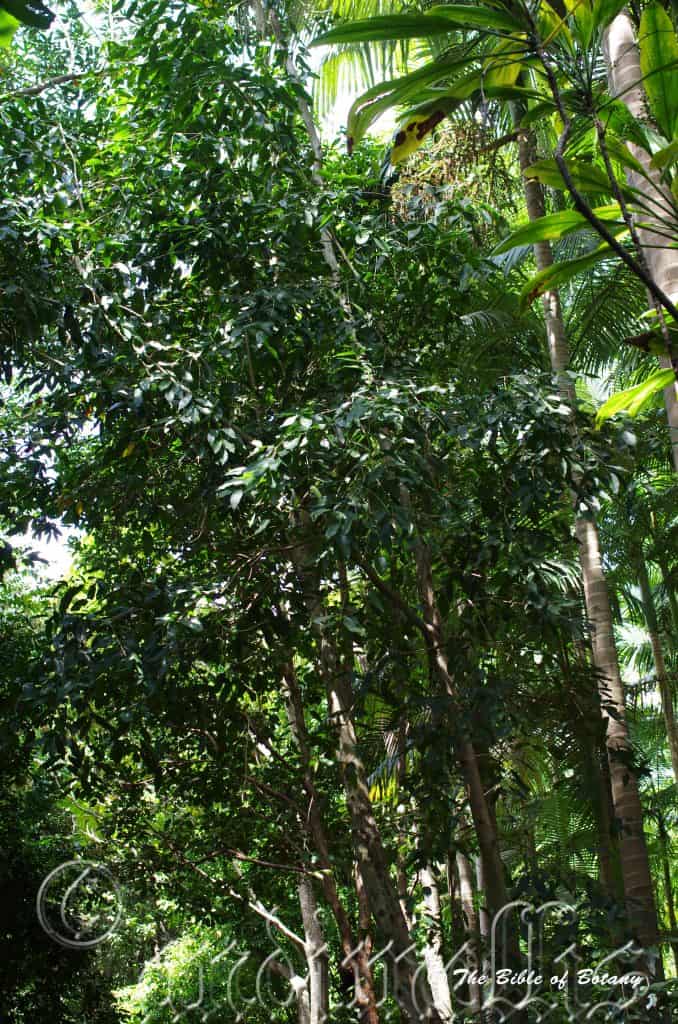
Mount Cootha Botanical Gardens Qld.

Anderson Botanic Gardens Townsville Qld.
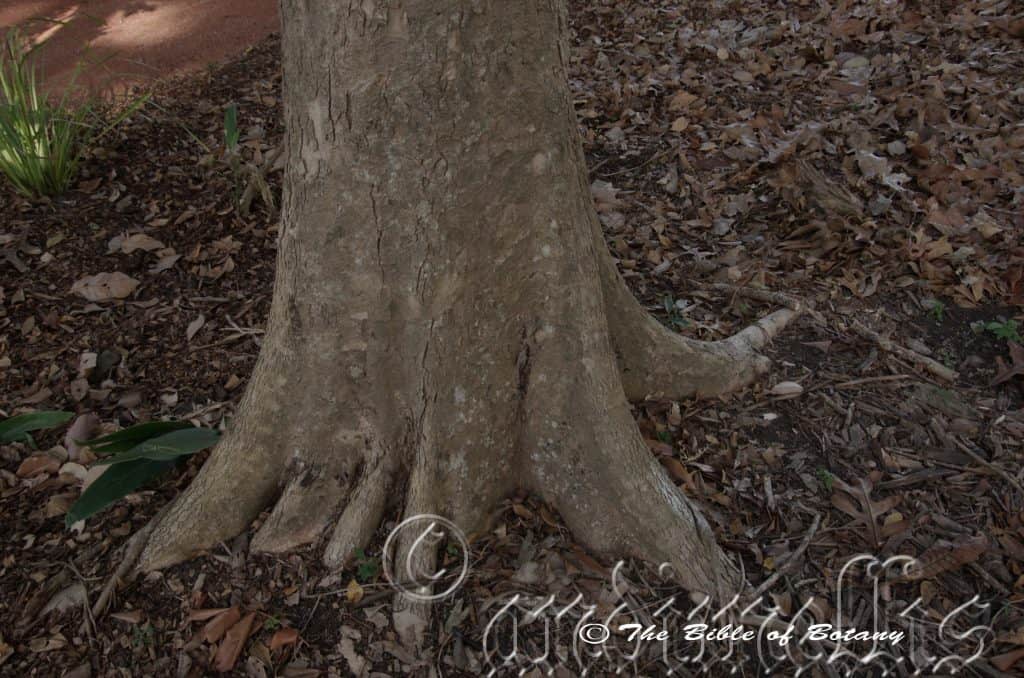
Anderson Botanic Gardens Townsville Qld.
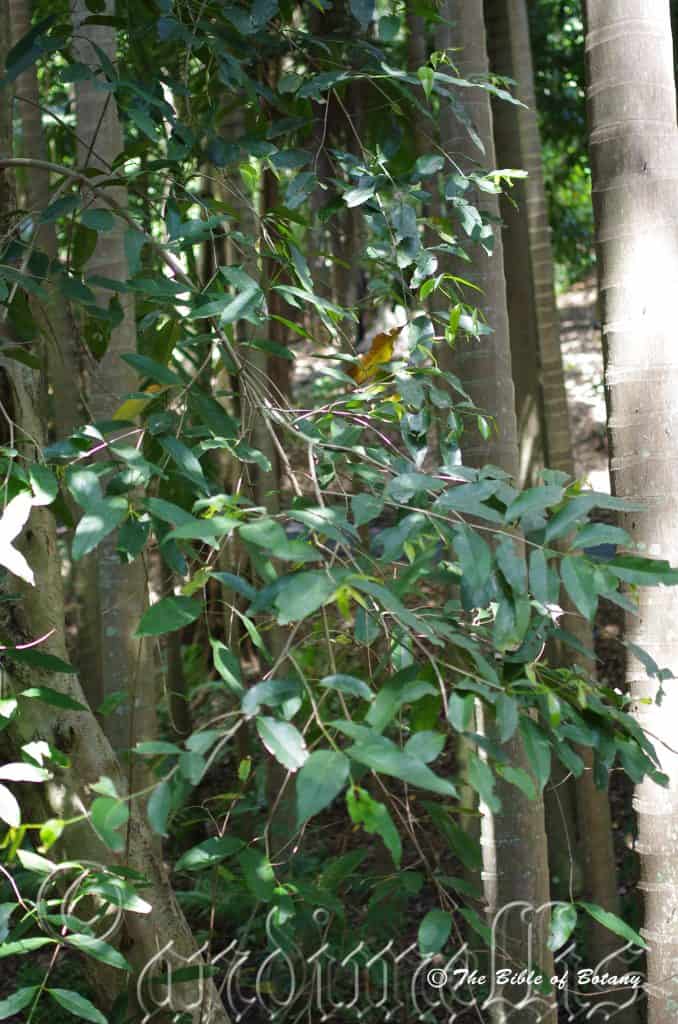
Mount Cootha Botanical Gardens Qld.

Mount Cootha Botanical Gardens Qld.
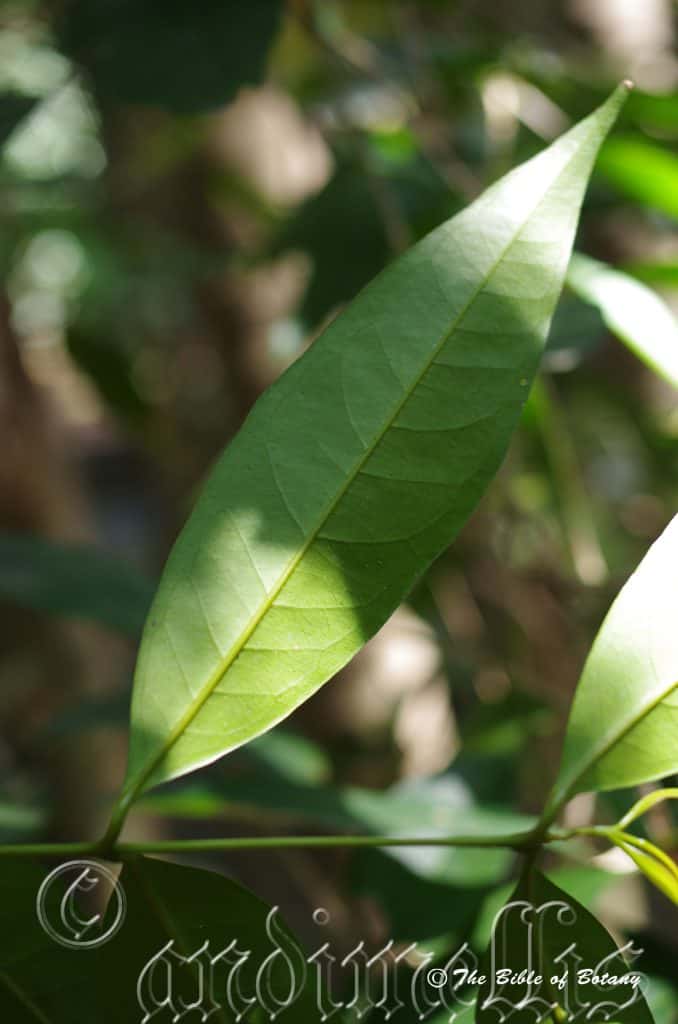
Mount Cootha Botanical Gardens Qld.
Syzygium tierneyanum
Classification:
Unranked: Eudicots
Class: Rosids
Order: Myrtales
Family: Myrtaceae
Subamily: Myrtoideae
Tribe: Syzygieae
Genus: From Súzugos, which is Ancient Greek or Syzygia, which is Latin for a pair or yoke together. It refers to leaves, which are joined together in pairs.
Specie: From Tierney which is unknown but probably a local dialect vernacular for the name of the tree and Anum/Ensis, which is Latin for to originate from. It refers to plants, which were first discovered at Tierney or are restricted to the district of Tierney.
Sub specie:
Common Name: Bamaga Satinash or River Cherry.
Distribution:
Syzygium tierneyanum is found south from Papua New Guinea, the Torres Straight Islands and the tip of Cape York Peninsular south to Little Crystal Creek in Paluma National Park in far north Queensland. It is found on and east of the Great Dividing Range and the off shore Islands.
https://avh.ala.org.au/occurrences/search?taxa=Syzygium+tierneyanum#tab_mapView
Habitat Aspect Climate:
Syzygium tierneyanum prefers dense shade to full sun. It grows in and adjacent to moist tropical rainforests, in moist tropical rainforests, moist Eucalyptus forests or gallery forests especially in riparian zones. It usually grows as a rheophyte, growing in areas where creeks, streams and rivers are exposed to swift flowing currents on a regular basis. The altitude ranges from 5meters ASL to 450meters ASL.
The temperatures range from minus 2 degree in August to 36 degrees in January.
The rainfalls range from lows of 900mm to 3000mm average per annum.
Soil Requirements:
Syzygium tierneyanum prefers light clays to heavy clays. The soils are derived from decomposed brown and black basalts and better quality granites. The soils pH ranges from 5pH to 6pH. It does not tolerate water logged soils however trees in riparian zones or gallery forests may experience periodic flooding for short periods. Non saline soils to moderately saline soils are tolerated.
Height & Spread:
Wild Plants: 10m to 12m by 6m to 8m.
Characteristics:
Syzygium tierneyanum grows as a medium tree with a straight or twisted, pale grey to pale fawn, longitudinally flaky trunk. The bark is hard and somewhat papery on older trees. The branches are pale fawn-grey, rough and covered in flaky patches and strips. The branchlets are lime-green to grass-green, near the apex where the newer leaves occur. The branchlets are glabrous.
The opposite, ovate to elliptical leaves of Syzygium tierneyanum measure 90mm to 185mm in length by 30mm to 70mm in width. The bases are broad cuneate while the apexes are long acuminate. The discolourous laminas are deep sea-green, semi glossy and glabrous on the upper lamina while the lower lamina is paler and dull. The new growth is pale green and semi glossy. The leaf margins are entire, flat and slightly undulating. The mid vein and main laterals are slightly prominent on the lower laminas and faintly visible on the upper lamina. The petiole measures 5mm to 10mm in length.
Inflorescences of Syzygium tierneyanum are born on panicles from the lower leaf axils or are ramiflorously. There are 5 to 11 flowers on a panicle which measures 20mm to 70mm in diameter. The grass-green peduncles, rachises, pedunculates and pedicels are glabrous and are swollen at each of the axils. The peduncles measure 6mm to 12mm in length by 1mm in diameter, the rachises measure 25mm to 35mm in length while the pedunculates measure 5mm to 15mm in length and the pedicels measure 5mm to 10mm in length. The pedicel is also swollen at 1mm to 2mm below the base of the calyx.
The caducous bracts are grass-green. The creamy yellow calyx and the 4 obtuse, erect calyx lobes are glabrous. The calyx tubes measure 5mm to 10mm in length by 4mm to 6mm in diameter across the hypanthia. The dimorphic, concave, hemi-spherical calyx lobes measure 3mm to 3.5mm in length while the shorter lobes measure 2.5mm to 3mm in length.
The 4 white orbicular petals are glabrous and densely covered in minute oil glands. They petals measure 5.5mm to 9mm in length by 5.5mm to 9mm in diameter.
The 100 to 140 dimorphic, exserted filaments are free for their entire length. The longer filaments measure 15mm to 20mm in length while the shorter filaments measure 8mm to 14mm in length. The filaments are white and while the anthers are pale fawn. The anthers are ovate, dorsifixed and measure 0.8mm to 1.2mm in length by 0.7mm to 1mm in width.
The pale green style and stigma are glabrous while the ovary is green. The styles taper from the base to the slender stigma and measure 15mm to 22mm in length. The pistils exceeded the length of the stamens. Syzygium tierneyanum flowers appear from late November through to late January.
The fruits of Syzygium tierneyanum are variable, globose to obovoidal or depressed spherical berries. The berries are glabrous and measure 16mm to 24mm in length by 16mm to 24mm in diameter. The green capsules turn glossy, bright scarlet red or at times white externally and white internally when ripe. The fruits are finely marked in a resinous pattern. The calyx lobes are persistent on the ripe fruit remaining erect or partially covering the depressed hypanthia. The single purple-brown seeds are spherical and fleshy.
Wildlife:
Syzygium tierneyanum supports a wide range of native fauna. The CSIRO has observed and listed 45 native birds, butterflies, moths, bees, beetles and bats foraging over the flowers. Honey eaters, fruitigrove birds like cat birds, bower birds and bats also visit the trees for the fruits.
Fallen fruits are eaten by Cassowaries and native rodents.
Cultivation:
Syzygium tierneyanum is a beautiful small tree that should be grown in association with other rainforest specie. It is ideal at the edge of a rain forest or deep in the center of the rainforest. They also make great park trees offering quick growth, and good shade for small gardens and parks in warm frost free temperate to cool tropical zones. In cultivation it grows from 6 meters to 9 meters in height by 6 meters to 9 meters in diameter when grown in the open or taller and narrower if grown closer together as a rainforest tree.
It grows exceptionally well on deeper, better quality light sandy clays to medium clay soils where deep leaf litter keeps the soil cool and moisture at an even level. If these requirements are met it can cope with temperatures as low as minus 5 degrees and up to 38 degrees as long as it is protected from frosts by other trees and the days are warm. The trees at Nana Glen never suffered tip burn but were very slow to commence growing each spring when temperatures reached minus 5 degrees even with the protection of surrounding trees. It is moderately drought resistant surviving rainfalls as low as 850mm in drought years even as a young tree. It did however take the tree nearly 10 years before good growth was seen and this followed the 10 to 11 year warm, wet cycle. At this stage it never looked back.
Add to the above, if it is given an adequate supply of water and a little native fertilizer on a regular basis the plants respond with good flowering and better quality fruit over several months.
The trees would make great accent trees in front of low set commercial, industrial sheds or schools where it breaks up hard rigid architectural lines and give warmth and breadth to a building. In front of high rise buildings they give balance especially where they could be grown in curves meandering to the entry doors or for something different planted from the front of the path and meander back to the far corners. The plants lend themselves beautifully if scattered randomly particularly if smaller narrower forms of Syzygium are used which have brilliant coloured foliages.
Like all Syzygium they make great bonsai plants.
Propagation:
Seeds: The seeds of Syzygium tierneyanum can be removed easily from the fruits.
Sow fresh seeds directly into a seed raising mix, keeping them moist not wet. Do not over water as the seeds will rot off before germination takes place. Place the trays in a cool shaded area with 50mm shade cloth in the bush house. When the seedlings are 20mm to 25mm tall, prick them out and plant them into 50mm native tubes using a good organic mix.
As the seedlings roots reach the bottom of the tubes plant them out into their permanent position. Do not delay.
Fertilize using Seaweed, fish emulsion or organic chicken pellets soaked in water and apply the liquid on an alternate basis. Fertilize every 2 months until the plants are well established then on an annual basis in September or March to maintain health, vigour and better flowering.
Further Comments from Readers:
“Hi reader, it seems you use The Bible of Botany a lot. That’s great as we have great pleasure in bringing it to you! It’s a little awkward for us to ask, but our first aim is to purchase land approximately 1,600 hectares to link several parcels of N.P. into one at The Pinnacles NSW Australia, but we need your help. We’re not salespeople. We’re amateur botanists who have dedicated over 30 years to saving the environment in a practical way. We depend on donations to reach our goal. If you donate just $5, the price of your coffee this Sunday, We can help to keep the planet alive in a real way and continue to bring you regular updates and features on Australian plants all in one Botanical Bible. Any support is greatly appreciated. Thank you.”
In the spirit of reconciliation we acknowledge the Bundjalung, Gumbaynggirr and Yaegl and all aboriginal nations throughout Australia and their connections to land, sea and community. We pay our respect to their Elders past, present and future for the pleasures we have gained.

Norman Park Qld.
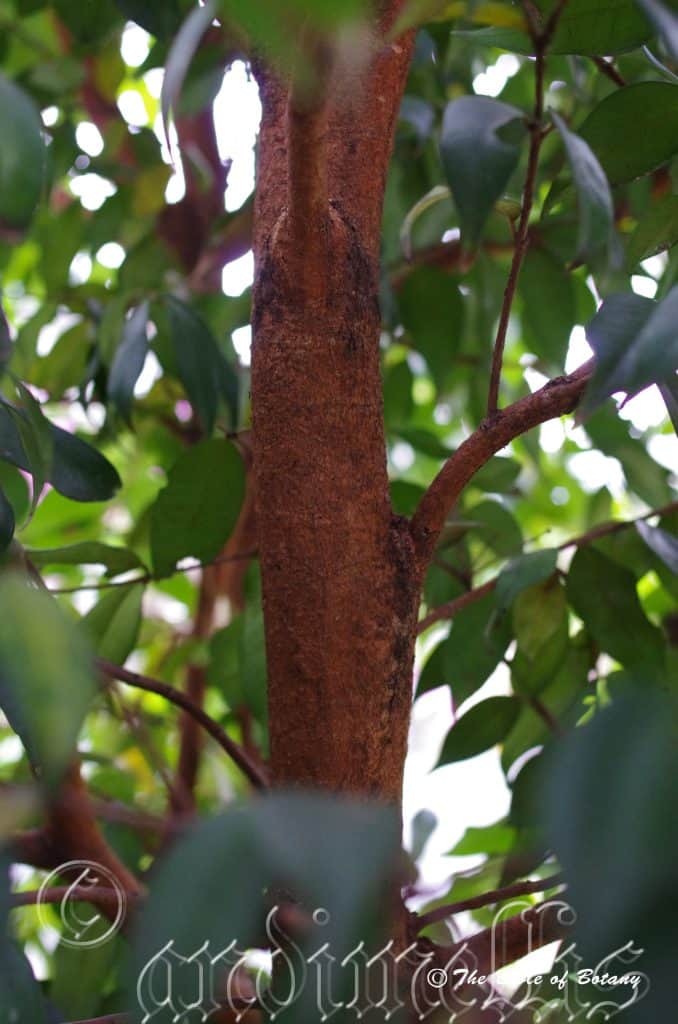
Cooparoo Qld.
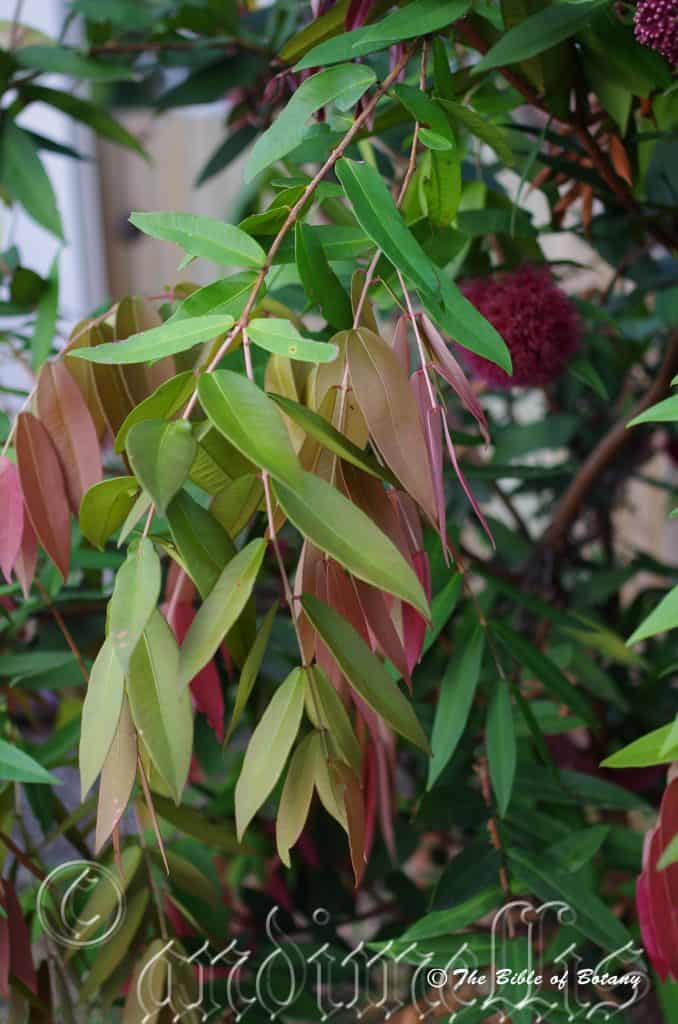
Greening Australia Norman Park Qld.

Greening Australia Norman Park Qld.
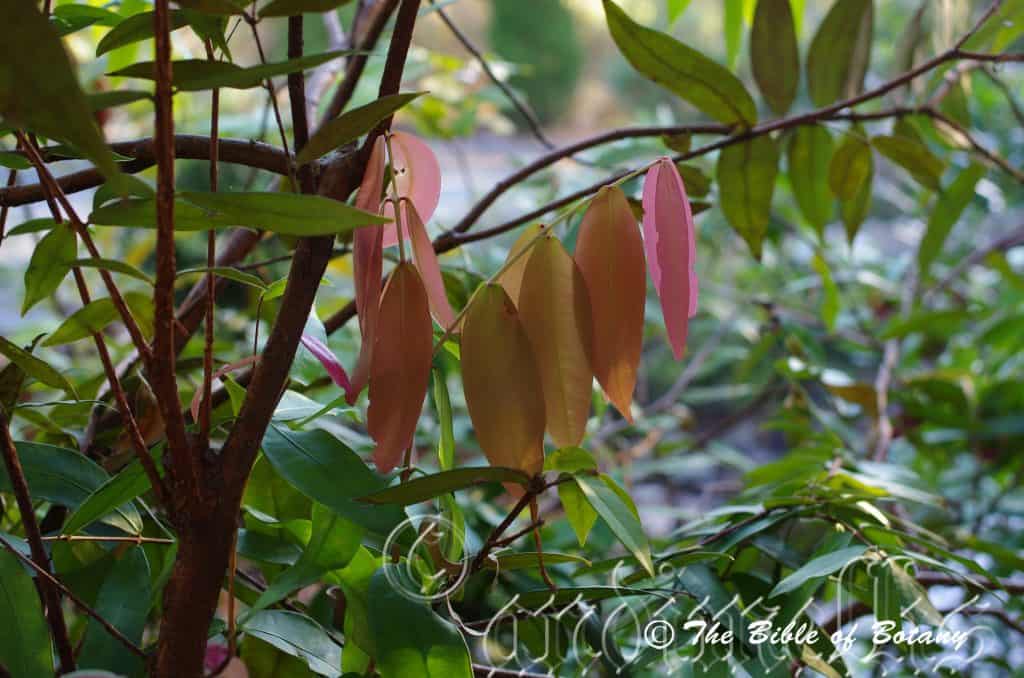
Greening Australia Norman Park Qld.
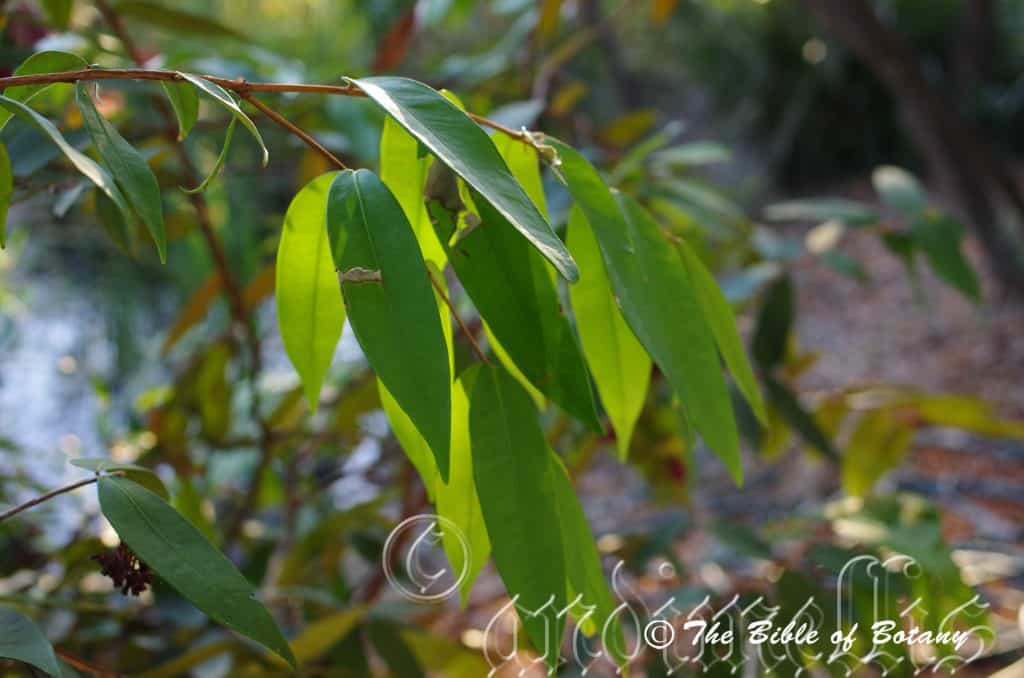
Greening Australia Norman Park Qld.
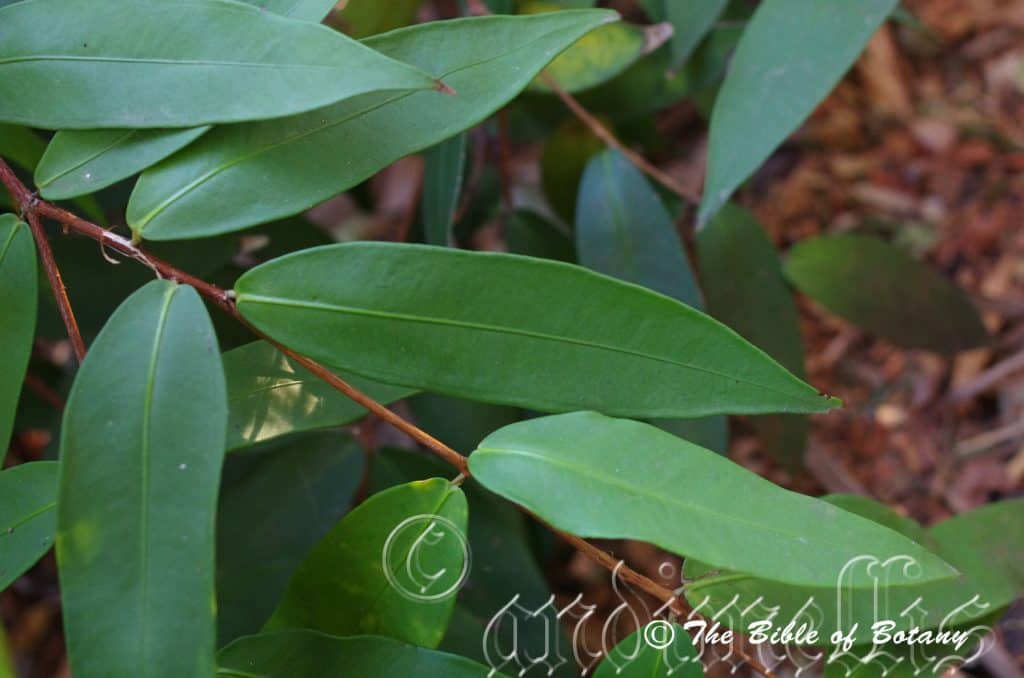
Greening Australia Norman Park Qld.

Greening Australia Norman Park Qld.
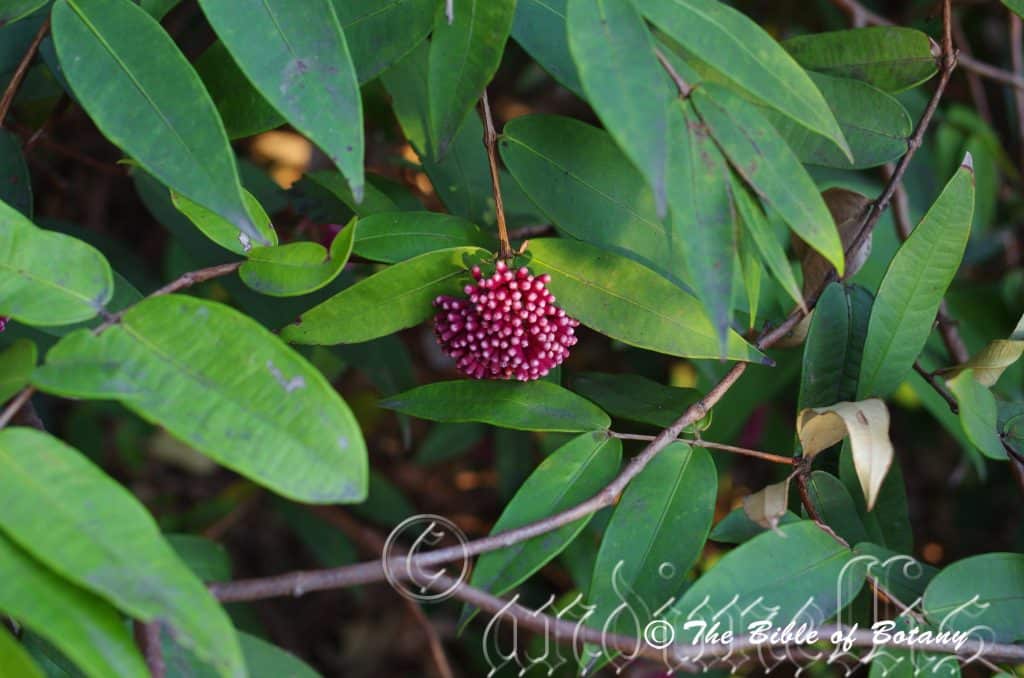
Greening Australia Norman Park Qld.

Norman Park Qld.

Norman Park Qld.
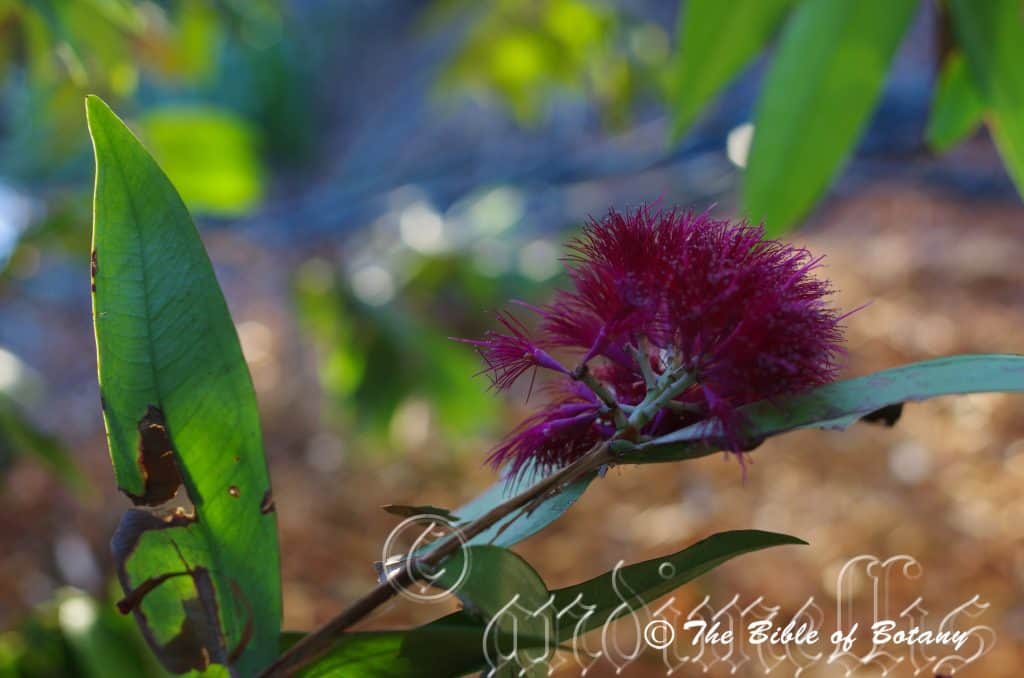
Greening Australia Norman Park Qld.
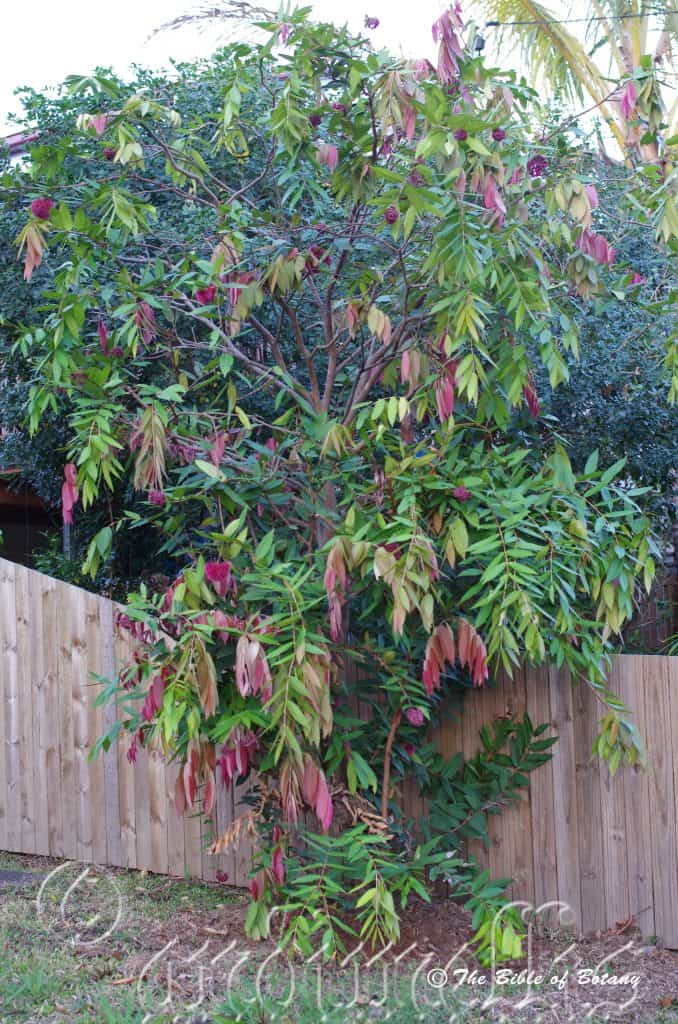
Norman Park Qld.
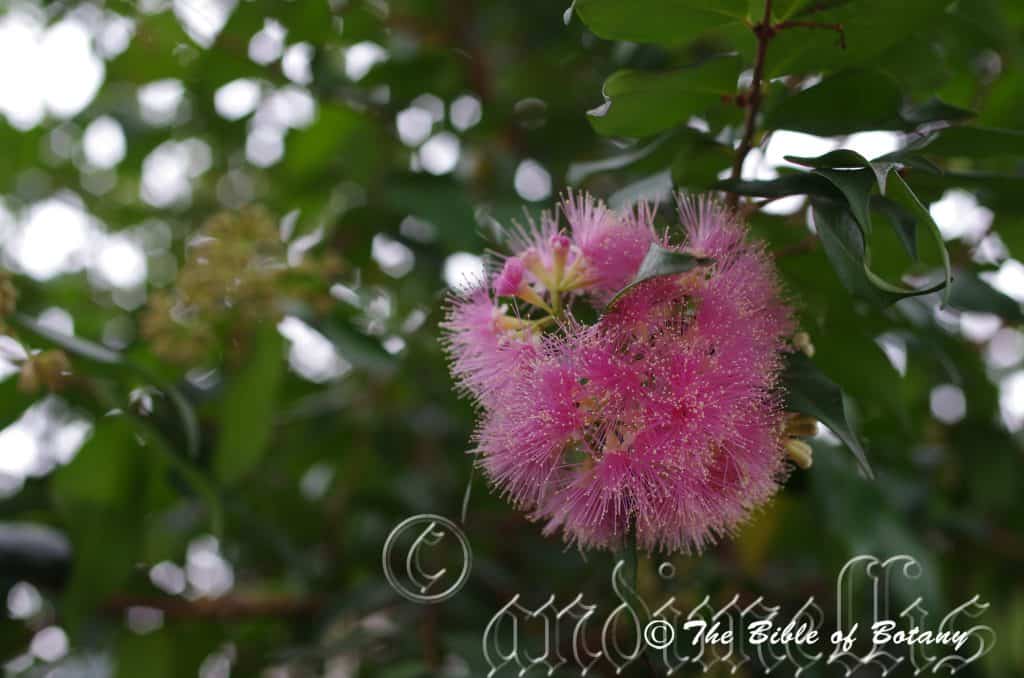
Cooparoo Qld.
Syzygium wilsonii
Classification:
Unranked: Eudicots
Class: Rosids
Order: Myrtales
Family: Myrtaceae
Subamily: Myrtoideae
Tribe: Syzygieae
Genus: From Súzugos, which is Ancient Greek or Syzygia, which is Latin for a pair or yoke together. It refers to leaves, which are joined together in pairs.
Specie: Is named in honour of Thomas Braidwood Wilson; 1792-1843, who was a Scottish born Australian who was a surgeon, explorer and collector of plants especially seeds.
Sub specie: Syzygium wilsonii subsp. epigaeum. From Epi, which is Ancient Greek for upon, above or over and Geios, which is Ancient Greek for earth or soil. It refers to where the cotyledon leaves are raised vertical above the soil surface.
Sub specie: Syzygium wilsonii subsp. wilsonii. Is named in honour of Thomas Braidwood Wilson; 1792-1843, who was a Scottish born Australian who was a surgeon, explorer and collector of plants especially seeds.
Common Name: Pom Pom Bush.
Distribution:
Syzygium wilsonii subsp. epigaeum is found south west of Cairns on Mount Saunders to Innisfail in far north Queensland.
Syzygium wilsonii subsp. wilsonii is found south from Cairns to Ingham in far north Queensland.
https://avh.ala.org.au/occurrences/search?taxa=Syzygium+wilsonii#tab_mapView
Habitat Aspect Climate:
Syzygium wilsonii prefers dense shade to full sun preferring partial shade. It grows in moist rainforests, dry rainforests, moist Eucalyptus forests, gallery forests or riparian zones. The altitude for Syzygium wilsonii subsp. Wilsonii ranges from 5 meters ASL to 900 meters ASL.
The altitude for Syzygium wilsonii subsp. epigaeum ranges from 620 meters ASL to 720 meters ASL.
The temperatures range from minus 2 degree in August to 36 degrees in January.
The rainfalls range from lows of 1100mm to 3000mm average per annum.
Soil Requirements:
Syzygium wilsonii prefers better quality light gritty clays to medium clays. The soils are usually derived from decomposed brown basalts, black basalts or shale. The soils pH ranges from 5pH to 6.5pH. It does not tolerate water logged soils however trees in riparian zones or gallery forests may experience periodic flooding for short periods. Non saline soils to moderately saline soils are tolerated.
Height & Spread:
Wild Plants:
Syzygium wilsonii sub sp. epigaeum 6m to 9m by 3m to 5m.
Syzygium wilsonii sub sp. wilsonii 2m to 5m by 3m to 4m.
Characteristics:
Syzygium wilsonii grows as a large shrub or small tree with short, straight, red-brown to reddish longitudinal flaky bark. The branches are red-brown to red-fawn and only becoming pale green near the apex where the newer leaf growth occurs. The branchlets are glabrous.
The opposite, oblong leaves of Syzygium wilsonii subsp. wilsonii are thick and leathery and measure 85mm to 185mm in length by 22mm to 55mm in width. The bases are broad rounded to cordate while the apexes are acuminate. The discolourous laminas are deep sea-green, dull and glabrous on the upper lamina while the lower lamina is paler. The new growth is vivid pink to purple or maroon. The leaf margins are entire and flat. The mid vein is slightly prominent on both laminas while the lateral veins are slightly prominent on the lower lamina and faintly visible on the upper lamina. The petiole measures 2mm to 6mm in length.
Inflorescences of Syzygium wilsonii subsp. wilsonii are born on a compound corymb from the upper leaf axils or terminals. There are 60 to 100 flowers on the ovoidal corymbs which measure 75mm to 11mm in length by 75mm to 110mm in diameter. The grass-green peduncles, rachises, pedunculates and pedicels are glabrous. The peduncles measure 4mm to 8mm in length by 2mm to 3mm in diameter, the rachises measure 35mm to 55mm in length while the pedunculates measure 5mm to 10mm in length and the pedicels measure 7mm to 13mm in length.
The caducous bracts are grass-green. The pale pink to pale purple calyx and the 4 obtuse, erect calyx lobes are glabrous. The long conical calyx tubes measure 7mm to 13.5mm in length by 3mm to 4.5mm in diameter across the hypanthia. The hemi-spherical calyx lobes measure 1mm to 1.5mm in length.
The 4 pale pink to purple orbicular petals are glabrous and densely covered in small oil glands. They petals measure 2.5mm to 3mm in length by 2.5mm to 3mm in diameter.
The 100 to 140 dimorphic, exserted filaments are free for their entire length. The longer filaments measure 16mm to 26mm in length while the shorter filaments measure 10mm to 14mm in length. The filaments are deep burgundy-pink while the anthers are white. The anthers are ovate, dorsifixed and measure 0.8mm to 0.9mm in length by 0.5mm to 0.7mm in width.
The deep pink to purple style and stigma are glabrous while the ovary is green. The styles taper from the base to the slender stigma and measure 24mm to 34mm in length. The pistils exceeded the length of the stamens. Syzygium wilsonii flowers appear from December through to March.
The fruits of Syzygium wilsonii subsp. wilsonii are broadly pyriform-globose berries. The berries are glabrous and measure 10mm to 16mm in length by 9mm to 15mm in diameter. The green capsules turn white to cream externally and white internally when ripe. The pericarp is succulent. The calyx lobes are persistent on the ripe fruit partially covering the concave hypanthia. The style is persistent on the semi ripe to ripe fruits. The single reddish-brown, fleshy seeds are spherical and rugose. They measure 5mm to 9mm in length by 5mm to 7mm in diameter.
The opposite, oblong leaves of Syzygium wilsonii subsp. epigaeum are thick and leathery and measure 70mm to 195mm in length by 20mm to 60mm in width. The base is broad rounded to cordate while the apex is acuminate. The discolourous laminas are deep sea-green, dull and glabrous on the upper lamina while the lower lamina is paler. The new growth is vivid pink, red or maroon. The leaf margins are entire and flat. The mid vein is slightly prominent on both laminas while the lateral veins are slightly prominent on the lower lamina and faintly visible on the upper lamina. The petiole measures 2mm to 7mm in length.
Inflorescences of Syzygium wilsonii subsp. epigaeum are born on a compound corymb from the upper leaf axils or terminals. There are 70 to 100 flowers on the corymbs which measure 80mm to 120mm in length 65mm to 95mm in diameter. The grass-green peduncles, rachises, pedunculates and pedicels are glabrous and are swollen at each of the axils. The peduncles measure 6mm to 10mm in length by 2mm to 3mm in diameter, the rachises measure 40mm to 65mm in length while the pedunculates measure 8mm to 12mm in length and the pedicels measure 7mm to 13mm in length.
The caducous bracts are grass-green. The pale pink to pale purple calyx and the 4 obtuse, erect calyx lobes are glabrous. The depressed cylindrical calyx tubes measure 7mm to 13.5mm in length by 3.5mm to 4.5mm in width and 2.5mm to 3.5mm in depth across the hypanthia. The hemispherical calyx lobes measure 1.5mm to 2.5mm in length.
The 4 pale pink to purple orbicular petals are glabrous and densely covered in small oil glands. They petals measure 2.5mm to 3mm in length by 2.5mm to 3mm in diameter
The 100 to 140 dimorphic, exserted filaments are free for their entire length. The longer filaments measure 12mm to 18mm in length while the shorter filaments measure 10mm to 15mm in length. The filaments are deep burgundy-pink while the anthers are white. The anthers are ovate, dorsifixed and measure 0.6mm to 0.8mm in length by 0.3mm to 0.5mm in width.
The pale green style and stigma are glabrous while the ovary is green. The styles taper from the base to the slender stigma and measure 12mm to 19mm in length. The pistils exceeded the length of the stamens. Syzygium cryptophlebium flowers appear from late December through to late March.
The fruits of Syzygium wilsonii subsp. epigaeum are broadly pyriform-globose berries. The berries are glabrous and measure 13mm to 20mm in length by 9mm to 16mm in diameter. The green capsules turn white to cream externally and white internally when ripe. The pericarp is succulent. The calyx lobes are persistent on the ripe fruit partially covering the concave hypanthia. The style is persistent on the semi ripe to ripe fruits. The single reddish-brown, fleshy seeds are spherical and rugose. They measure 7.5mm to 8.5mm in diameter.
Wildlife:
Syzygium wilsonii support myriad of native insects including the native bees like Tetragonula carbonaria.
The fruits are eaten by honeyeaters, Bower Birds, Cat Birds Ailuroedus crassirostris and the CassowaryCasuarius casuarius.
Cultivation:
Syzygium wilsonii is a magnificent small tree or large shrub that should be grown in association with other rainforest specie. It is ideal at the edge of a rain forest or deep in the center of the rainforest as an under shrub. It also makes a great park tree offering quick growth, and good shade. In cultivation Syzygium wilsonii subsp. epigaeum grows from 5 meters to 6 meters in height by 3 meters to 4 meters in diameter while Syzygium wilsonii subsp. wilsonii grows 2.5 meters to 3.5 meters in height by 3 meters to 4 meters in diameter when grown in the open or taller and narrower if grown closer together as a rainforest tree.
It grows exceptionally well on light clays to medium clay soils provided a deep layer of leaf litter is supplied to keep the soil cool and the moisture at an even level. If these requirements are met it can cope with temperatures as low as minus 5 degrees and up to 36 degrees as long as it is protected by other trees and the days are warm. It is moderately drought resistant in their climatic zones and coped with a local drought without extra water of 900mm of rain in the early 1990’s when they were only 4 years old.
Add to the above, if it is given an adequate supply of water and a little native fertilizer on a regular basis the plants respond with good flowering and fruit over a long period.
Growth was slow initially at Nana Glen where severe frosts are experienced during the winter months with minimums to minus 5 and where day time temperatures always warm to 12 to 15 degrees. It was protected from frosts and reached its full potential in just 15 years and flowered from the sixth year from seed. It reached 3 meters in height by 5 meters in diameter.
The flushes of new growth brighten the bush up and are worthwhile planting in small groups or scattered throughout the bush for this quality alone.
The trees would make very great accent trees in front of low set commercial, industrial sheds or schools which face the south or east where it is in the shade for several hours a day. Here it breaks up hard rigid architectural lines and give warmth and breadth to a building. In front of taller buildings they give balance especially where they could be grown in curves meandering to or away from the entry doors. For something very different try using them with taller, fine, golden leaf plants. Melaleuca bracteata revolution gold would make a great contrast in year round colour whether it is in flower or not.
The plants lend themselves beautifully if scattered randomly as the only plants in a plot using some as trees and others as shrubs.
Try using one in a court yard where the only other feature is a large rock, stump or formal or informal frog or fish pond. Next to such features their leaves, small flowers and colourful fruit are never overpowering but certainly noticed. I am surprised that they have never been used in commercial entrances and foyers to break the ice and give a feeling of business as usual but somehow make the business more relaxing.
It occasionally suffers from black soot when planted in areas where a lot of chemicals are used and nature is not allowed to develop a balance.
Syzygium wilsonii would make an excellent bonsai specimen.
Propagation:
Seeds: The seeds of Syzygium wilsonii can be removed easily from the fruits.
Sow fresh seeds directly into a seed raising mix, keeping them moist not wet. Do not over water as the seeds will rot off before germination takes place. Place the trays in a cool shaded area with 50mm shade cloth in the bush house. When the seedlings are 40mm to 60mm tall, prick them out and plant them into 50mm native tubes using a good organic mix.
As the seedlings roots reach the bottom of the tubes plant them out into their permanent position. Do not delay as this large shrub will suffer some set back.
Fertilize using Seaweed, fish emulsion or organic chicken pellets soaked in water and apply the liquid on an alternate basis. Fertilize every 2 months until the plants are well established then on an annual basis in September or March to maintain health, vigour and better flowering.
Further Comments from Readers:
“Hi reader, it seems you use The Bible of Botany a lot. That’s great as we have great pleasure in bringing it to you! It’s a little awkward for us to ask, but our first aim is to purchase land approximately 1,600 hectares to link several parcels of N.P. into one at The Pinnacles NSW Australia, but we need your help. We’re not salespeople. We’re amateur botanists who have dedicated over 30 years to saving the environment in a practical way. We depend on donations to reach our goal. If you donate just $5, the price of your coffee this Sunday, We can help to keep the planet alive in a real way and continue to bring you regular updates and features on Australian plants all in one Botanical Bible. Any support is greatly appreciated. Thank you.”
In the spirit of reconciliation we acknowledge the Bundjalung, Gumbaynggirr and Yaegl and all aboriginal nations throughout Australia and their connections to land, sea and community. We pay our respect to their Elders past, present and future for the pleasures we have gained.